Blog
26 June 2024
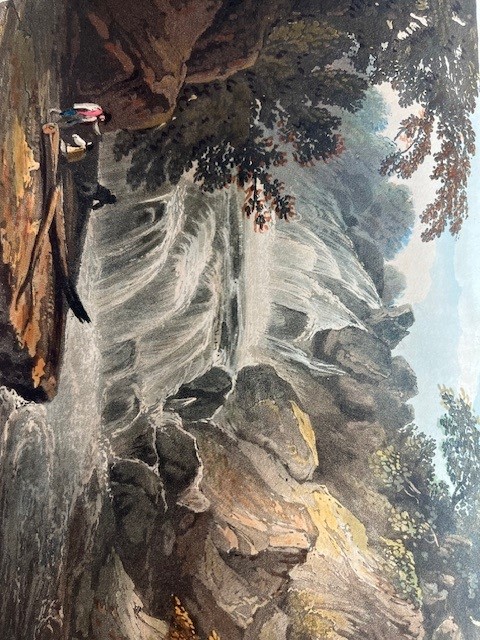
Compton, North Cambrian Mountains (1820 edn), ‘Rhaiadyr Y Wennol, Caernarvonshire’
Emmanuel’s collection of nineteenth-century illustrated books – containing numerous Romantic depictions of what was perceived as picturesque landscape from around the world – includes so many representations of waterfalls as to prompt questions about what our forebears saw in these remarkable natural features. In cultures across the world, waterfalls hold cultural and spiritual significance. To take one example among many: in Shinto tradition in Japan waterfalls are held to be sacred and cleansing.
For searchers for the picturesque in Britain, waterfalls were part of those wild uplands that excited their admiration for rugged scenery and sublime perspectives of great height and distance. Waterfalls gave rise to feelings of awe and apprehension of something greater than ourselves. Accounts of travels to wild Wales featured many depictions of famous waterfalls, which had often long been held to be sites of mystery and magic in local folklore. Thomas Compton’s The North Cambrian Mountains (1817, 1820) includes some striking depictions that attempt to convey the sheer volume and force of waterfalls plunging through landscapes.
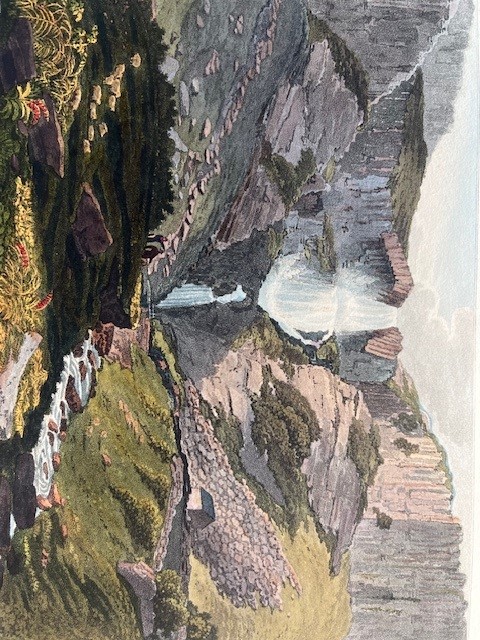
Compton, North Cambrian Mountains (1817 edn), ‘Pistyll Rhaiadyr’, Montgomeryshire’
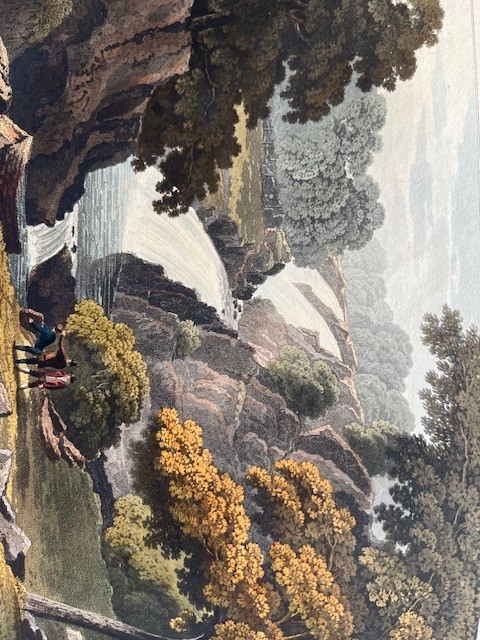
‘Rhaiadyr Du, Merionethshire’
Alongside such Romantic images, it is interesting to compare Classical Chinese painting, where waterfalls are a symbol of impermanence: the waterfall continues yet is never the same, implicitly contrasted with the changelessness of the rocks that surround and interrupt the water’s fall.
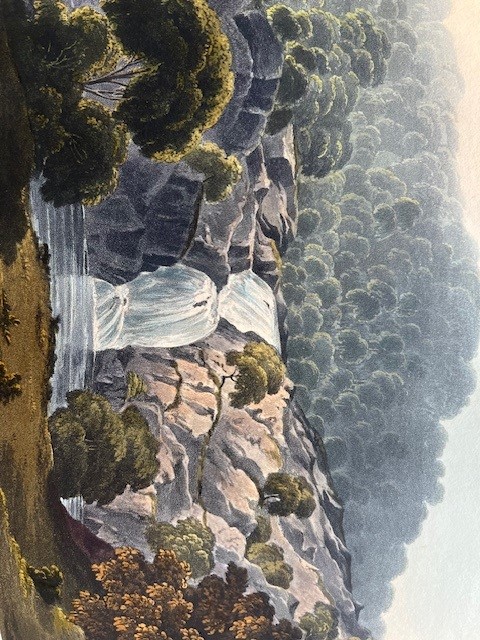
‘Pystyll Y Cain, Merionethshire’
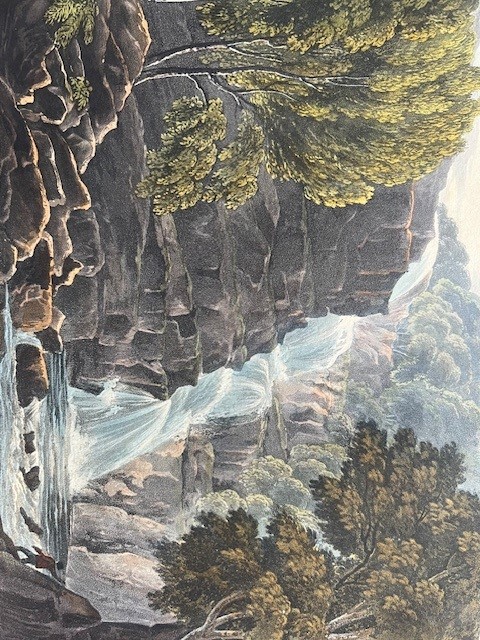
‘Rhaiadyr Y Mawddach, Merionethshire’
In this way, the waterfall represents a persistence of form, notwithstanding a constant change of content. The cool and misty colours in Brian Broughton’s Six Picturesque Views in North Wales (1801) well convey this defining presence and energy in the waterfalls and cascades that he depicts.
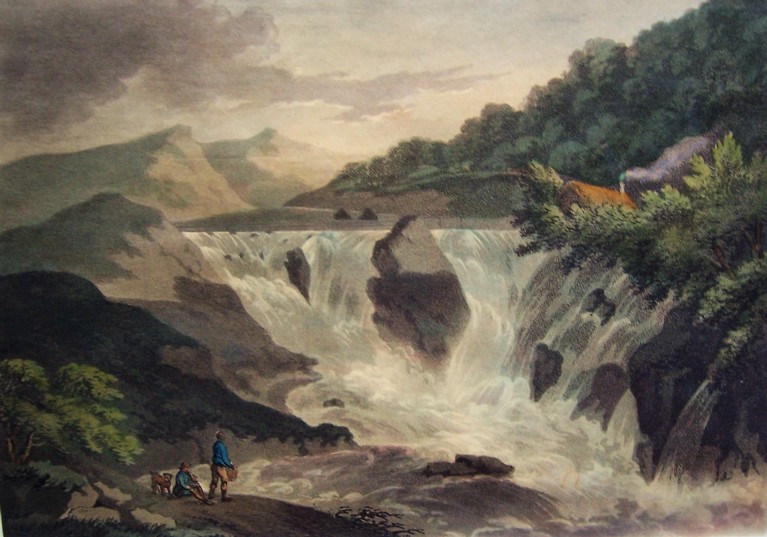
Broughton, Six Picturesque Views (1801)
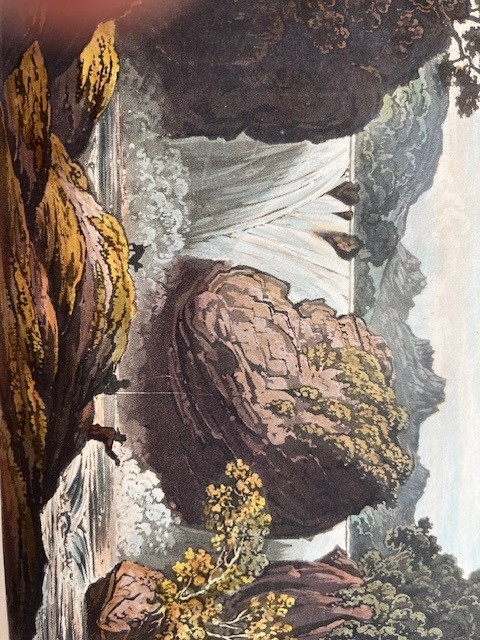
T. H. Fielding, The English Lakes (1821), ‘Skelwith Force’
The many published accounts of tours to the Lake District that poured forth in this period also included frequent illustrations of waterfalls, as in T. H. Fielding’s
A Picturesque Tour of the English Lakes (1821), of which Emmanuel holds three different editions. The essence of such images is the impression of an unstoppable torrent, dashing against rocks, defining its location yet always in flux.
To depict water falling dramatically from a great height is a recurrent challenge to artists, particularly well met in the dramatic uncoloured lithographs in Harry Longueville Jones’s Scenery of the Snowdonian Mountains (1829), where each lithograph bears the imprint of C Hullmandel, the inventor of lithography.
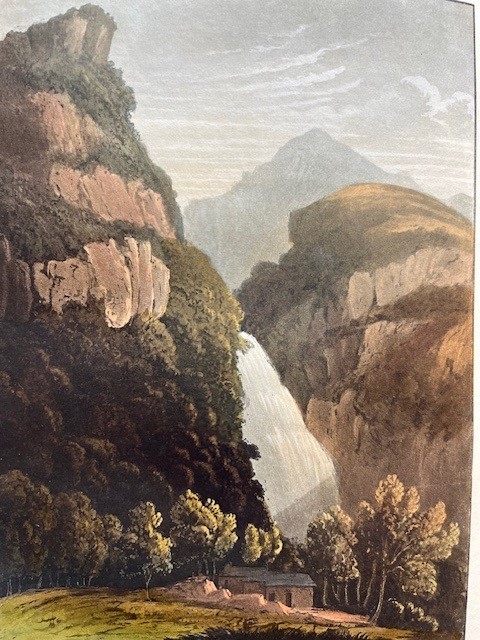
English Lakes, ‘Lowdore Fall’
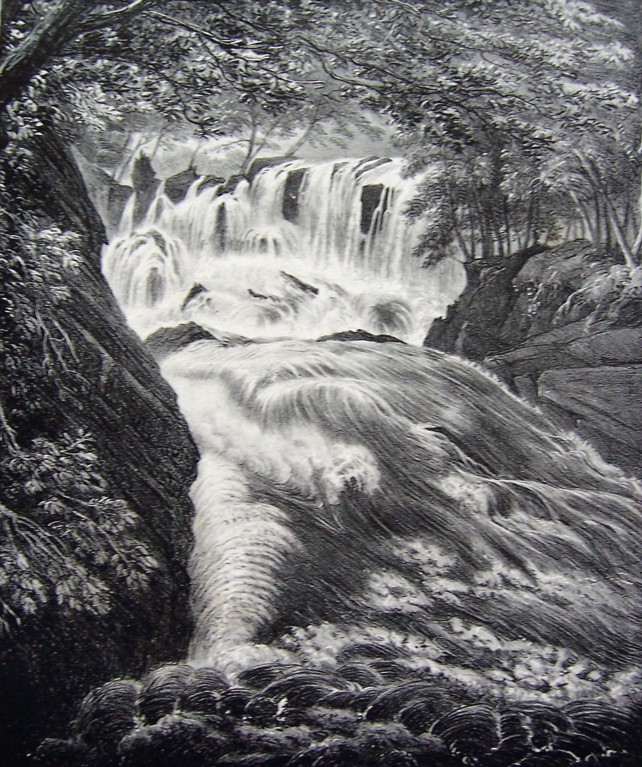
Jones, Snowdonian Mountains
A fascination with depicting waterfalls in Britain is carried with them by artists recording the picturesque in landscapes much further afield, as in James Hakewill’s now-rare A Picturesque Tour of the Island of Jamaica (1825).
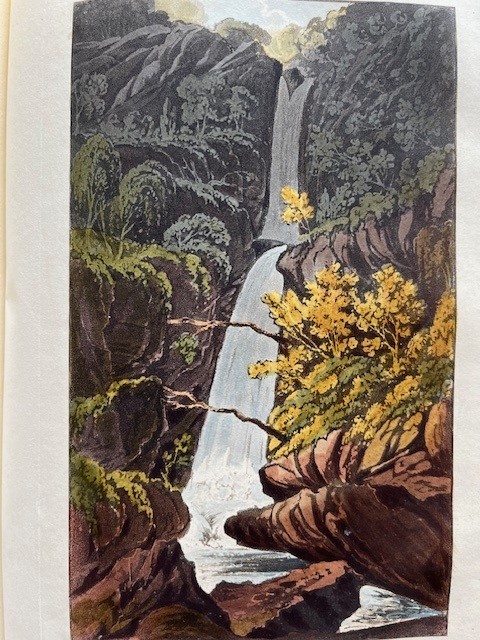
English Lakes, ‘Stockgill Force’
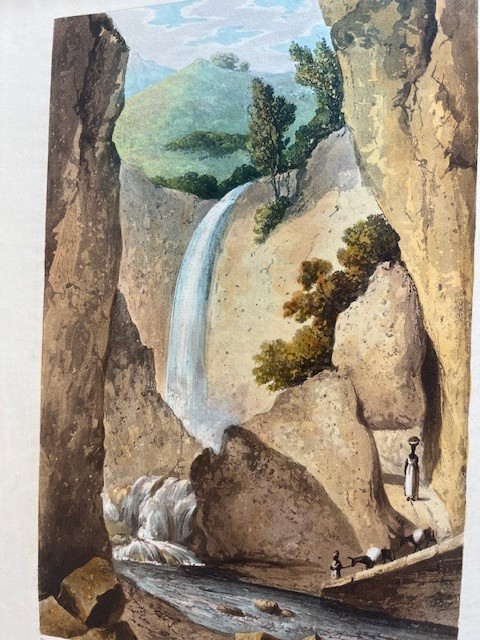
Hakewill, Jamaica (1825), ‘Cascade on the Windward Road’ (seven miles from Kingston)
It is striking that a late example of a hand-coloured book, William Cullen Byant’s Picturesque America, or The Land We Live In (New York, 1874) features a waterfall as the design of its frontispiece (the small figure of the artist is seated on the right side, depicting the cataract ‘en plein air’).
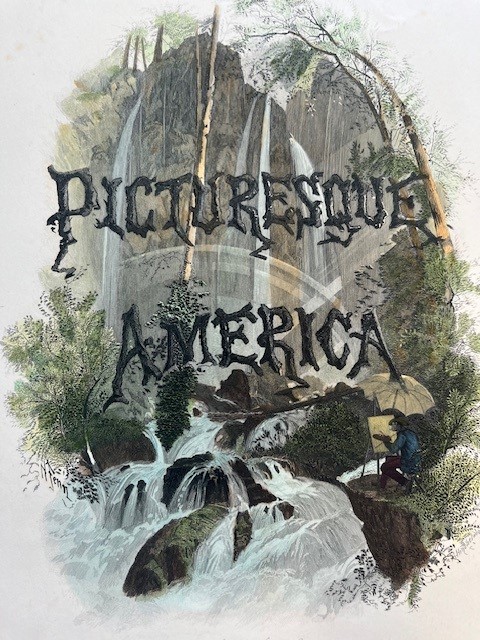
Bryant, Picturesque America (1877), title page, ‘Cascade in Virginia’
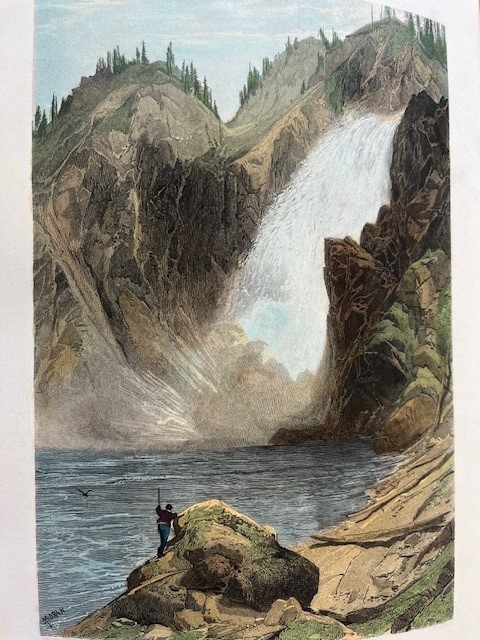
Picturesque America, ‘The Upper Yellowstone Falls’
Bryant’s book includes many accounts of waterfalls, which are mentioned on the title page among the defining features of ‘Picturesque America’.
The staggering immensity of falling waters in the hand-coloured images of Thomas Baines’s The Victoria Falls (1865) are a match for the awesome proportions of the Niagara Falls in the opening image that precedes all others in Bryant’s Picturesque America.
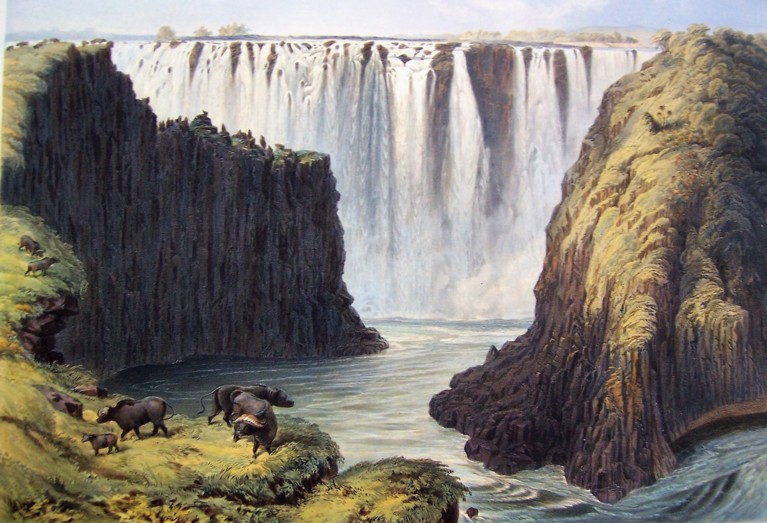
Baines, Victoria Falls
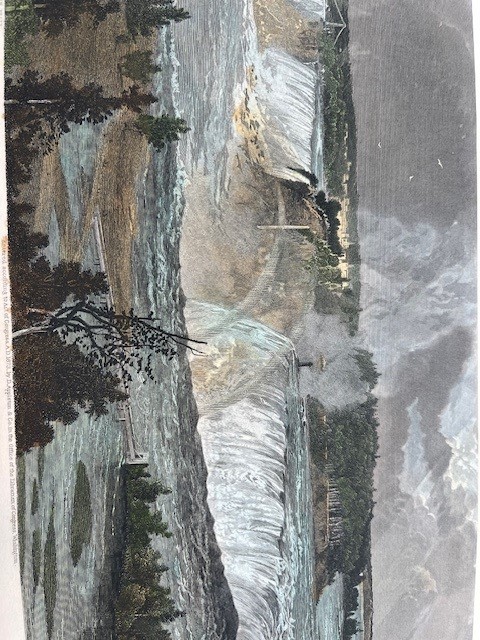
Picturesque America, frontispiece, ‘Niagara’
Artists of images fixed on the page must convey the constant motion of unstoppable forces. They must assume that vision will summon up sound: that viewers will also hear in their inward ear the characteristic music of waterfalls, from tinkle and splash to awe-inspiring roar.
Barry Windeatt, Keeper of Rare Books
26 June 2024
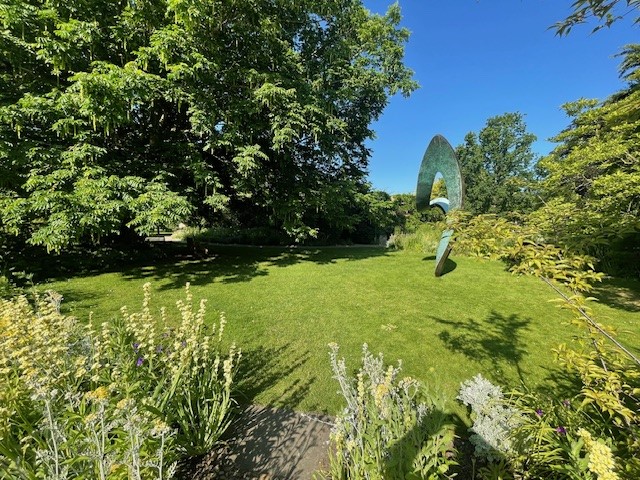
At last, the good weather has arrived. The endless weeks of rain and wind, together with the grey skies, are hopefully behind us, as we cling on to what now feels like summer. The Garden Department’s busiest times are hopefully just over the horizon too.
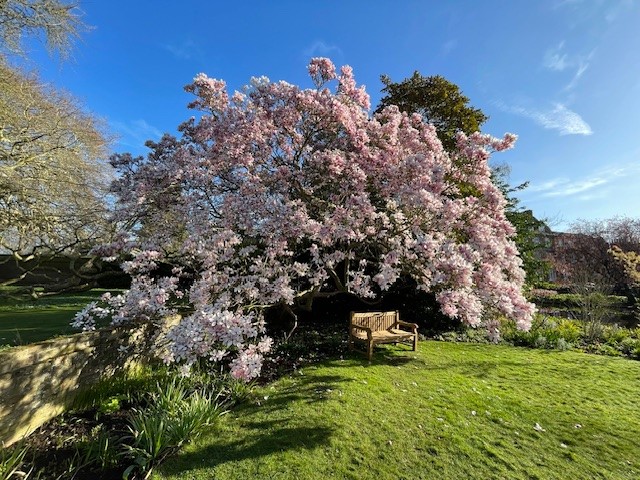
It can be a relentless few weeks, preparing for garden parties, May Ball preparations (and repairs) and graduations. Yes, the work is hard and the hours long. It is a time, however, to showcase the gardens to as many eyes as possible. I have received many fine comments about the beauty of the gardens this year. Of course, I am very grateful, but this is a team effort made up of many pairs of hands, both past and present. It has been a challenging growing season because of the weather but, I must admit, the gardens look splendid.
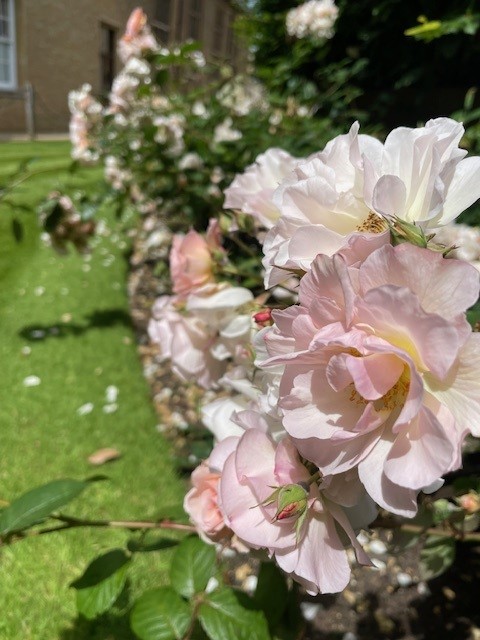
I was working on this last Sunday, watering our plants (the sides that most people don’t see behind the scenes), and the peaceful nature of the site was at its best. Many students had gone home, and the gardens were still vibrant. The birds were my company and my morning’s soundtrack was enough to keep me enthused as I worked the weekend. This is the time I enjoy most in the gardens at Emmanuel. It almost feels like it’s my own garden at times like this. Just me, nature and the gardens. For those that are left here on site for the summer, please do enjoy the gardens in these quieter times. It is so good for one’s own mental health.

Mental health and gardening are always at the forefront of my thinking. Last week we had a soft launch of the new Emmanuel College Community Gardens. Although the project is not quite complete, it was nice to get together to celebrate our achievements so far. This will be a good stress reliever when the project reaches its final stages. It will give students, staff and Fellows a space within the college grounds that they can take ownership of. A place that they can nurture. A place that they can decide what to grow (and keep). A place that is non-hierarchical and a place to come together. A place to learn (through successes or failures). A place to contemplate. A place to share.

The community gardens will continue to be built over the remainder of the summer and will be fully functional from next academic year. There will be more correspondence over the next few weeks and months but please do get in contact with me with any questions you may have.
The rest of the summer will be made up of garden tours, continued maintenance and, later in the summer, we will turn our attention to recruiting the next cohort of training vacancies in the Garden Department. Emily will finish her one-year placement in September, and we are busy prepping Izzie for her end point assessments of the Cambridge University Apprenticeship in July. Izzie will remain with the Garden Department until December, drawing and ending her two-year placement. We also continue to support Danny Dudd with his work experience whilst studying his T Levels in Horticulture at Shuttleworth College.
Investing in the future of the next generation of gardeners is essential, giving career builders the next step in a fruitful (no pun intended!) career.
Best wishes.
Brendon Sims, Head Gardener
26 June 2024
D is for … Doves
.jpg)
Our archives contain a series of title deeds recording the changes in ownership of the college site between 1545 (a few years after it had ceased to house the Dominican monastic order) and 1584, when Emmanuel College was founded. All these documents, in their recital of the premises’ appurtenances, include a reference to a dove-house. This building, of uncertain location, continued in use after 1584 as it served an important function: the provision of fresh meat throughout the year. The first reference to it in the college accounts is dated 1594, when 28s 7d was spent on ‘New tiling, lathing, and mending the duffhouse’. These renovations lasted a couple of decades, but thereafter the building required regular maintenance. In 1614 the college laid out 16s 10d on ‘Tyling, claying & mending the duvhouse’, and minor repairs were needed in 1621, 1628 and 1633. We know the building had fenestration, for in 1630 a shilling was spent on ‘2 new latices for the pigeon-house’ and in 1635 the ‘glasse’ had to be mended. Substantial improvements were required in 1636, when a builder named Rively and his labourer were paid 19s 6d for ‘9 dayes worke about the dovehouse’, and yet more repairs were carried out by the same builder two years later. Following the outbreak of the English Civil War, student numbers at Emmanuel shrank drastically and the dove-house was evidently abandoned, for it is not mentioned after 1638. In the late-nineteenth century a dovecote was set up in Chapman’s Garden, which at that date was only accessible via the set of Arthur Chapman, Fellow of Emmanuel from 1862 until his death in 1913. Populated with white fantails, Chapman’s picturesque dovecote features in several late-Victorian and Edwardian photographs.
D is for … Dr Who
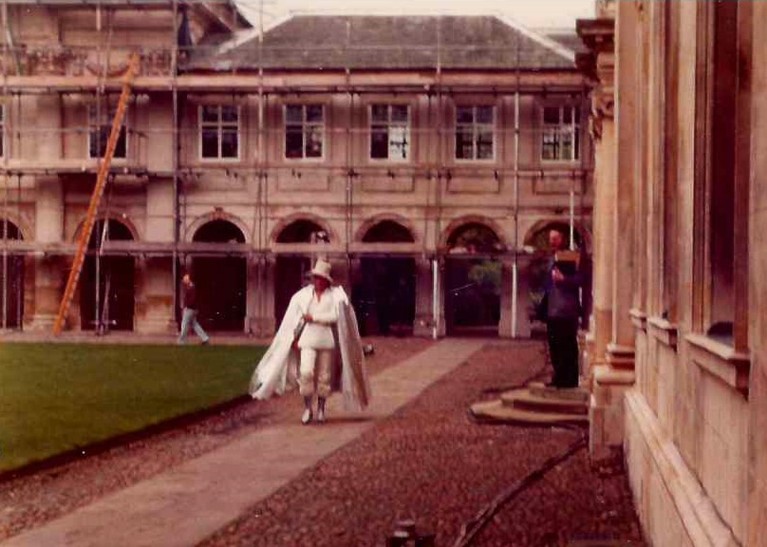
On Wednesday 17th October 1979, Emmanuel was briefly transmogrified into St Cedd’s College, Cambridge, an institution harbouring an incognito Time Lord named Professor Chronotis. This scenario sprang from the fertile imagination of the well-known sci-fi writer and Cambridge graduate Douglas Adams, who was at that time script editor for the Dr Who show. The 1979-80 college Magazine records, under Gifts and Bequests: ‘B.B.C. TV kindly donated £100 to the College following their successful filming of a Dr Who episode on College premises’. Unfortunately, no paperwork survives in the archives to indicate why, or how, Emmanuel was selected as a suitable location. The filming took place in Front and New Courts (exteriors only). The photograph reproduced above has been provided by Dr Alan Baker, Senior Tutor in 1979, who can be seen standing on the steps to C staircase. The Emmanuel students’ newsletter, under the headline ‘Dr Why?’, noted the ‘production of another epic Dr Who episode in the College grounds’, but queried why P3 had been selected as the Professor’s room, concluding: ‘Perhaps it was the rumour about frequent sightings of “alien” life forms and the strange knocking noises in the night’. Alas, many years were to pass before Emmanuel’s moment of glory was seen by the paying public, as a technicians’ strike prevented this particular Dr Who serial (‘Shada’), from being finished. Such footage as existed was eventually released on VHS, followed by, in 2017, a DVD version in which the missing sections had been completed using animation, dialogue being dubbed by the original cast. When the DVD was played to an audience in the Queen’s Building a few years ago, the advent of the ‘baddie’, clad in silver lamé and billowing white satin, provoked howls of laughter from undergraduates and nostalgic smiles from anyone ancient enough to remember the 1970s.
Amanda Goode, College Archivist
29 May 2024
The weather has continued to play havoc with the gardens in the last month. The wet weather continues, and the growing season is rapid. It seems like a period when we are chasing our own tails a bit. No sooner have we completed maintaining an area within college, it grows as your back is turned.
The last few weeks have been tricky. The quiet period for exams stops us doing exactly what we want to do in a time when the growing season keeps us on our toes the most. The good thing about the wet weather is at least we have not had to rush around watering the plants, trying to keep them alive.

The team has been stretched this year trying to complete some small projects, such as the landscaping for the swimming pool and the Community Garden. This has meant that it is all hands on deck at this time.
As gardeners, we must remind ourselves to enjoy the gardens too. We have been delighted with the planting beds around the new buildings this year. They have really started to establish themselves nicely and look as if the plants have been there for a while. It is exciting to see the plants fill out and give us such a good show. It is always a relief when this works, rather than just being an imagined idea.
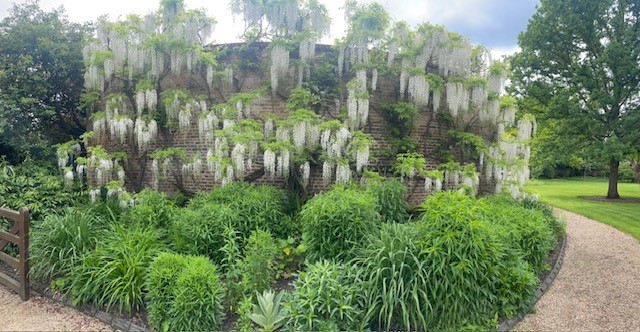
The tennis courts on the Paddock have remained popular and it is nice to see so many people enjoying the gardens when the sun occasionally comes out.
The Community Garden building will continue after the quite period ends, and we will work at this across the remainder of the summer, so that the students can take full advantage from next academic year. It is an exciting prospect and I hope that the areas get some good use soon enough. There will be a trial for some hot composting bins in this area. This will give the students the opportunity to dispose of food waste such as vegetable peelings to be turned into compost. We have also installed water butts for rainwater harvesting, so we are looking at a greener approach to sustainable gardening.
It is also the time of year for starting to fill the borders from our own nurseries from the Garden Department. We do spend a lot of time and effort across the year taking cuttings and growing items from seed. It is great to be able to use our own plants to produce more. This cuts down on extra plastic use for pots, air miles for distances the plants must travel, and time taken to collect the plants off site. We use our own compost produced here in college to pot on the plants, so sustainably we feel we are heading in the right direction.
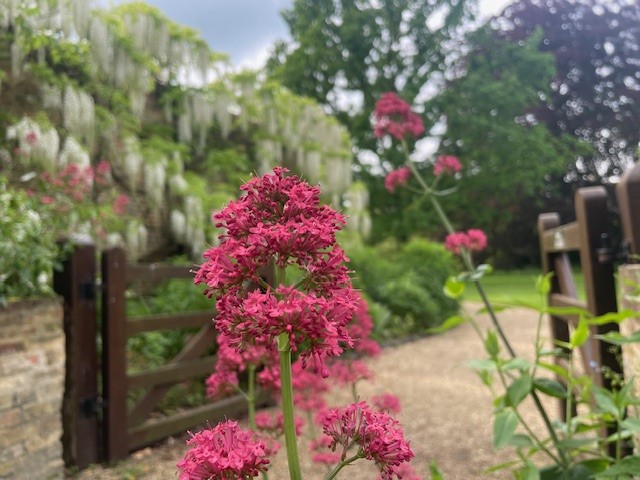
The meadows also look fantastic. The wildflowers are starting to really grow well, and we should get an excellent display this year. Some of the wildflowers in North Court have grown as a result from us harvesting the wildflower seeds from the bales of hay, donated to us from King’s College. Each bale of hay contains around 1.5kg of wildflower seed. This is another example of how working collegiately can benefit us all.
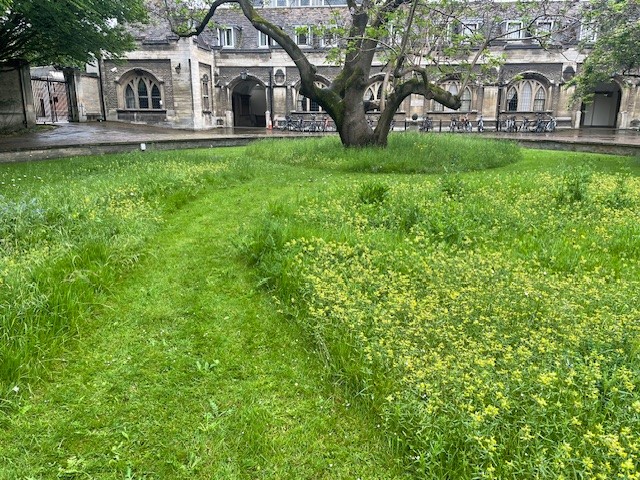
All we need now is some sunshine.
Best wishes.
Brendon Sims, Head Gardener
29 May 2024
C is for … Chaderton
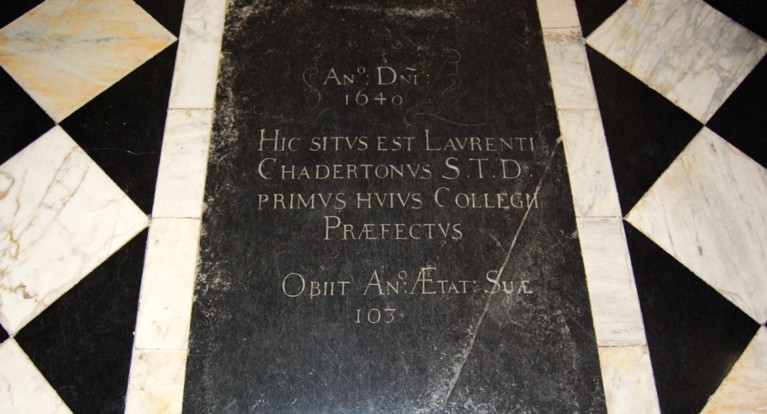
Laurence Chaderton, the first Master of Emmanuel, was a most remarkable man. His father Thomas, a minor landowner from Oldham, was a Roman Catholic, who cut off his son with the proverbial shilling when the young man embraced the Protestant faith. By the time Laurence became Master here, in 1584, he was one of the most renowned preachers of his day, possessing a ‘wonderful zeal for winning souls’. On one occasion, after a two-hour sermon, his enthralled congregation were said to have begged: ‘for God’s sake sir, go on!’. Sir Walter Mildmay thought so highly of him that his founding of Emmanuel College was contingent on Chaderton’s accepting the mastership. This he did, despite having received an offer of a more lucrative ecclesiastical appointment, and for 38 years he administered the college with ‘fidelity, prudence, and industry’. Even after relinquishing the mastership in 1622, when he was in his eighties, he continued to play an active role in college affairs. Widely respected and loved for his ‘active and fearless, and yet kindly and liberal’ spirit, Chaderton was sought out by many distinguished visitors to Cambridge, including King James I & VI and his son, Prince Charles. The King went further, by appointing him one of the authors of the 1611 Authorised Version of the Bible; he helped translate the section from 1 Chronicles to the Song of Solomon. Chaderton died in November 1640, at the great age of either 101 or 104 (he gave differing accounts of his year of birth, but either way his tombstone inscription is incorrect). According to his daughter, Elizabeth, he remained astonishingly robust until suffering the fall that brought on his death. He was buried in the original college chapel, and re-interred in the new one after its consecration in 1677.
C is for … Chalice
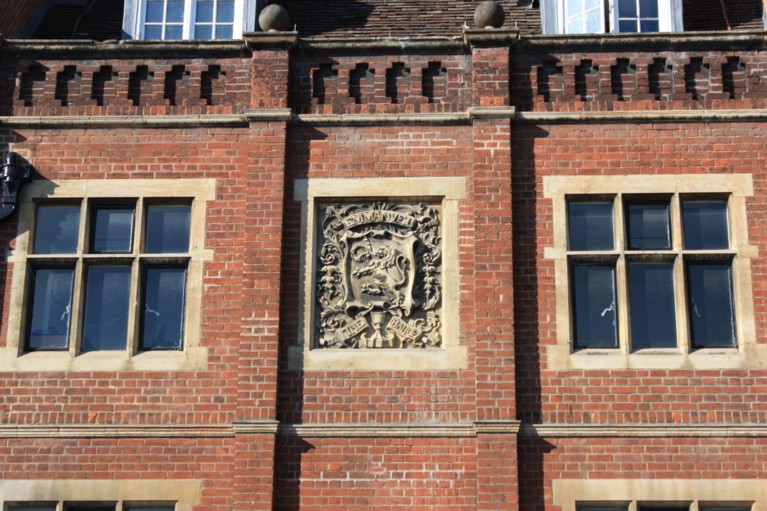
Above the shop frontage of 21 St Andrew’s Street, Cambridge, directly opposite the junction with Emmanuel Street, a fine sculpted stone panel can be seen. It shows our college coat of arms, with the name ‘Emmanuel’ above and a carving of a goblet below, along with the words ‘The Chalice’. This tenement came to Emmanuel in 1585, one of several similar gifts and bequests bestowed upon the new college by generous benefactors. Most of these donors were what we would now call Puritans, who approved of the college’s founding ethos, but this was not the case with the owner of the Chalice. It was bequeathed to the college by Henry Harvey, Doctor of Laws, Master of Trinity Hall, Canon of Ely, and a prominent University man. In negotiating the political upheavals of the mid-sixteenth century, Harvey’s religious views embraced a degree of flexibility that the Vicar of Bray might have admired. As it seems unlikely, however, that he was ever a genuinely enthusiastic Puritan, his bequest of the Chalice to Emmanuel College would seem to be a mark of his personal regard for either Sir Walter Mildmay or Laurence Chaderton. All that can be said for certain, though, is that Doctor Harvey had helped with the complex legal procedures attaching to Mildmay’s acquisition of the college site in 1584. The title deeds to 21 St Andrew’s Street are held in our archives. They date back to 1295, but the earliest document in which the tenement is named ‘Chalice’ is a conveyance of 1578, which calls it a ‘messuage or ynne called the Challyce’. Later converted to a mixture of residential and retail occupancy, the property was completely rebuilt in 1895.
Amanda Goode, College Archivist
1 May 2024
B is for … Boathouse
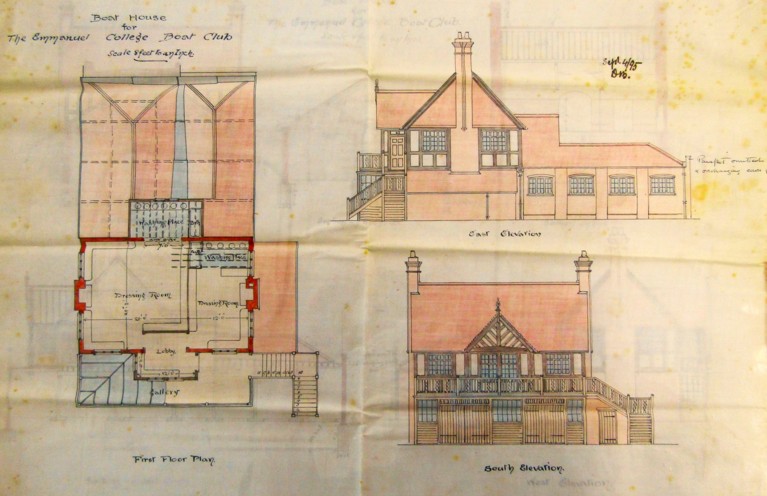
The Emmanuel Boat Club, formed in 1827, did not acquire its own premises until the 1890s. Until then it had ‘cheerfully suffered the inconvenience’ of sharing Foster’s boat house with other colleges, but in 1894 a riverside site was acquired, upon which stood a dilapidated boathouse and several ramshackle cottages. In the 1895 college Magazine, readers were informed that: ‘The plot secured by the College and granted for the use of the Boat Club is situated just below the Cutter Ferry’. An appeal was launched to raise £1200, the estimated cost of constructing a new boathouse. The architects were Marshall and Vickers of Bedford Square, London, who produced ‘an effective design’. A year later the Boat Club was able to report that ‘it was with great pleasure that we got into our new boat house at the beginning of this term [Michaelmas 1896]; we need not describe it, as by this time there are very few who have not seen it’. Thanks were expressed to the ‘many old members of the boat club who have responded so heartily to the appeal’. The boathouse underwent a ‘splendid’ extension and refurbishment’ in 1994 under the aegis of the Master, Lord St John of Fawsley. The 1896 half-timbered frontage was retained, however, and the new sections were designed ‘to complement in form and materials the original boathouse…’. According to Lord St John, the building’s ‘blue and white exterior has become one of the dominating sights of the river’.
B is for … Bowls
The first Master of the college, Laurence Chaderton, was said by his biographer William Dillingham, writing in Latin, to have enjoyed pila utraque, but it is impossible to know whether this last phrase refers to bowls, or some other ball game(s). Bowls was certainly played at Emmanuel from its earliest days, if the antiquary John Aubrey can be relied upon. In his most well-known work, Brief Lives, he relates that the famous Elizabethan theologian Lancelot Andrews caught Emmanuel’s ‘zealous Preachers’ playing bowls in the Fellows’ garden on the Sabbath. Bowling was a notorious betting game, which explains Aubrey’s dismissal of the Emmanuel Fellows as ‘hippocrites’. Playing bowls on Sundays would, in fact, be banned by a Royal Declaration of 1618. The game never went out of fashion at Emmanuel, however, and is still played in the Fellows’ Garden. The college has a fine collection of woods, dating back to the late eighteenth century. A few of these quaint old bowls (‘mince-pie’ being a formerly popular shape) bear the initials or name of their original owners, e.g. ‘Blackall’ (Samuel, Fellow 1794-1812) and ‘RTC’ (Robert Towerson Cory, Master 1797-1835). The Parlour wager books record many bets made among the Fellows about bowling. On 20 May 1800, Richard Brassey, a fellow commoner student, lost the following bet: Todd v. Brassey - Blackall with three bowls will beat Brassey & Rogers two games out of three. N.B. By. & Rs. have the jack every lead. (Todd’s evidence - Blackall played one game & won it, Brassey refused to play any more.)
Amanda Goode, College Archivist
1 May 2024
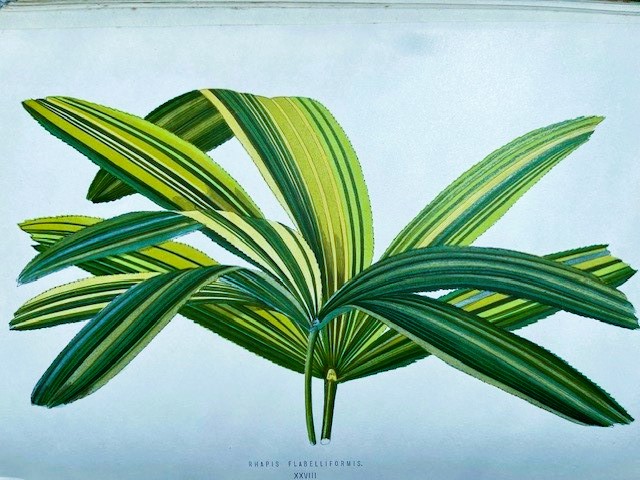
New and Rare Beautiful-Leaved Plants (1870), ‘Rhapis flabelliformis’
In this country we like to think of ourselves as a nation of gardeners – by which we mean all those who busily and lovingly tend their town and suburban gardens, which are mostly modest in extent. But one, now largely forgotten, Victorian journalist and writer on horticulture had a key role in laying the foundations for this cult of small-scale ‘do-it-yourself’ gardening, and some of his many works are in Emmanuel’s collection of illustrated books.
James Shirley Hibberd (1825-1890) was born in Stepney, son of a sea-captain who had served under Nelson; he was apprenticed to a bookseller but moved into horticultural journalism, publishing as ‘Shirley Hibberd’. As he struggled to grow flowers, fruit and vegetables in his garden in Stoke Newington, despite the polluted, soot-laden London air, Shirley Hibberd noticed that the horticultural press of the day was directed at country house owners, their head gardeners, and the nursery men who supplied them. These professional garden writers ignored the possibility of gardening in towns and suburbs. By contrast, Shirley Hibberd saw gardening as open to all, and lambasted the Royal Horticultural Society for taking no account of the working-class amateur gardener. Shirley Hibberd saw a gap in the market for advice and self-help publications for amateur gardeners wanting to make something of their small urban gardens.
For this market Shirley Hibberd produced a stream of books and started three gardening magazines, including Amateur Gardening in 1884, which is still being published today. Titles included Rustic Adornments for Homes of Taste, The Rose Book, The Amateur’s Flower Garden. His The Fern Garden (1869) was particularly successful, promoting the Victorian predilection for these graceful plants. Other popular works included The Amateur’s Green House and Conservatory and Field Flowers, a month by month guide to the blooming of wild flowers.
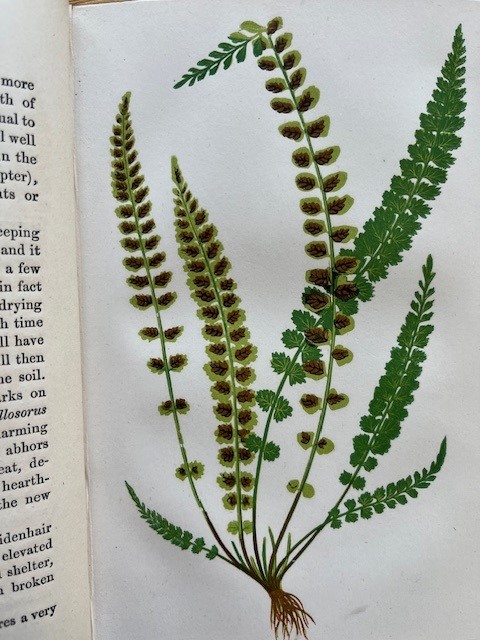 The Fern Garden (1869), ‘Asplenium viride’
The Fern Garden (1869), ‘Asplenium viride’
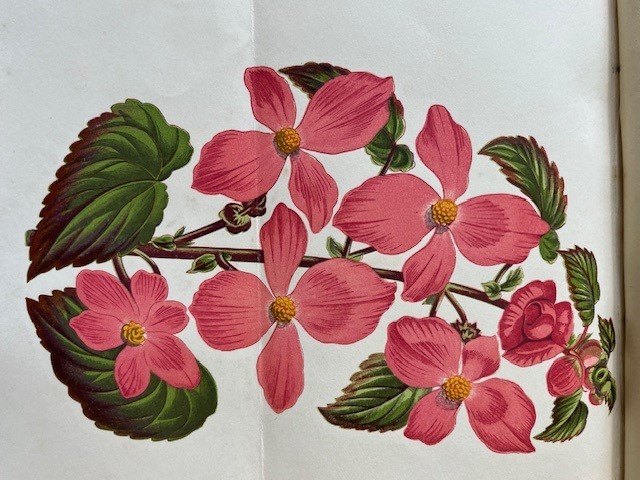
The Amateur Greenhouse (1880), ‘Begonia diversifolia’
Being self-taught himself, and unimpressed by experts, Shirley Hibberd was a natural at writing for amateur gardeners, soon becoming a household name and a leader of fashionable taste in the modest garden. Anticipating today’s TV gardeners, Shirley Hibberd drew on trial and error in the renovation of his own Stoke Newington garden to demonstrate for readers the creation of a rockery or a fern garden, or how to secure a succession of colour, or a succession of fresh fruit and vegetables in times before refrigeration. His advice was practical: for his amateur readership he did not recommend the Victorian craze for ‘carpet’ bedding of massed annuals – it was too expensive and labour-intensive – instead preferring herbaceous perennials and shrubs.
In several of his most striking publications Shirley Hibberd emphasized the beauty of foliage in its own right, although he saw gardens as essentially artificial creations and (unlike the inane modern fad) he had no wish to recreate a meadow inside a garden. His The Ivy: Its History, Uses and Characteristics (1872) was among the first to make a study of ivy and promote its beauty for garden use. Like other of his books, the binding and illustration aimed to match the beauty perceived in the subject.
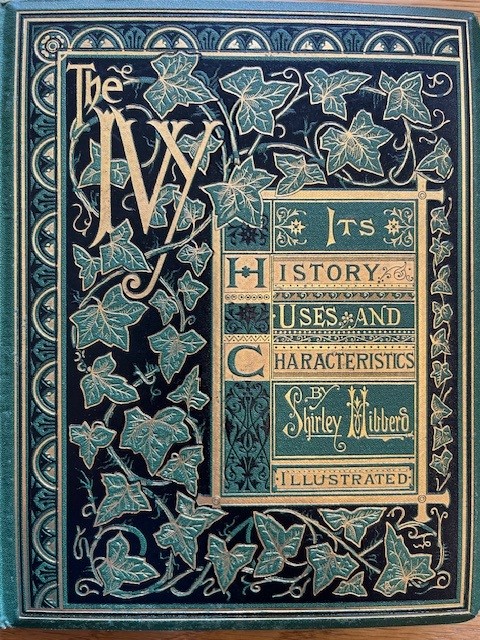 The exquisite binding of ‘The Ivy’ (1872), and the title-page, showing an ivy-covered Conway Castle
The exquisite binding of ‘The Ivy’ (1872), and the title-page, showing an ivy-covered Conway Castle
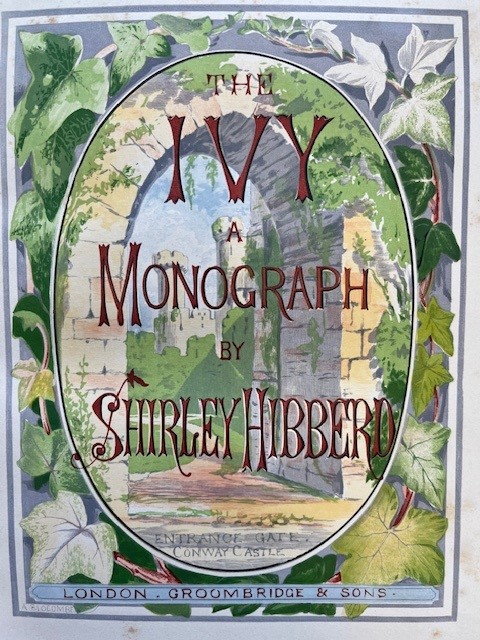
Shirley Hibberd had himself collected 200 varieties of ivy.
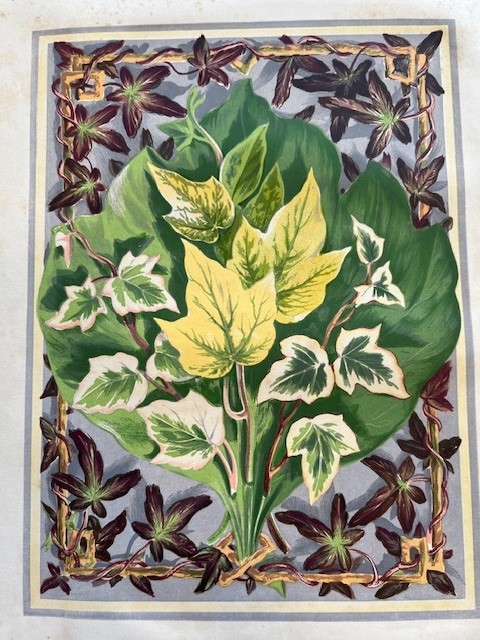 The Ivy: Frontispiece showing five varieties of ivy, and a plate showing six further varieties
The Ivy: Frontispiece showing five varieties of ivy, and a plate showing six further varieties
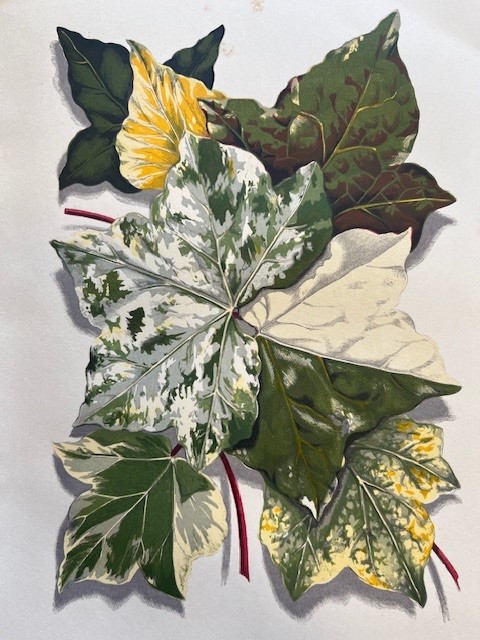
In his study of New and Rare Beautiful-Leaved Plants (1870) the 54 striking coloured plates do justice to their subject.
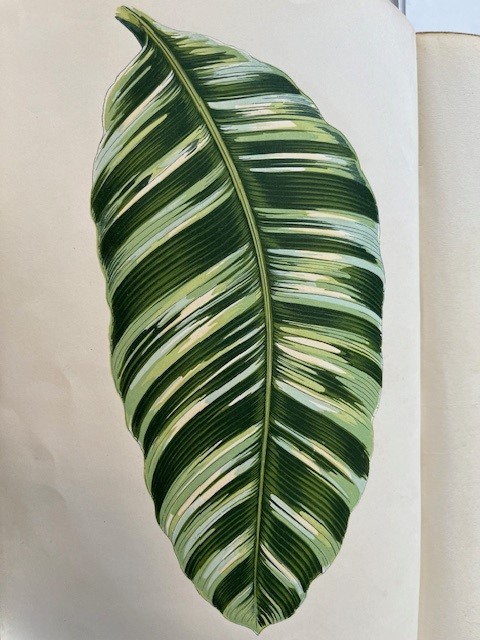 Beautiful-Leaved Plants (1870), ‘Musa vittata’ and ‘Maranta illustris’
Beautiful-Leaved Plants (1870), ‘Musa vittata’ and ‘Maranta illustris’
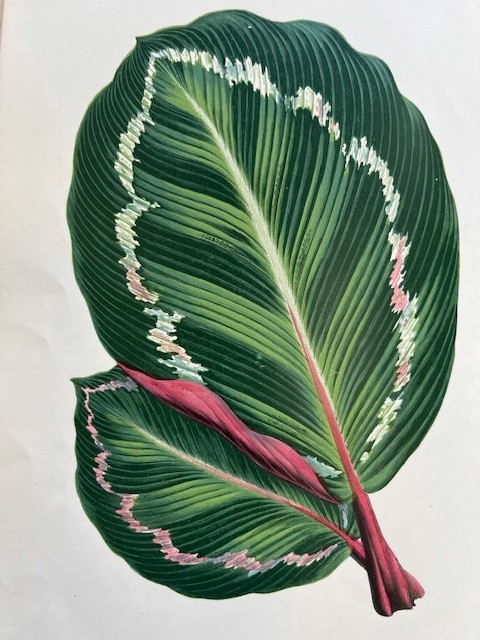
Their purpose is to inform and encourage the amateur gardener to experiment with new foliage effects in the urban garden.
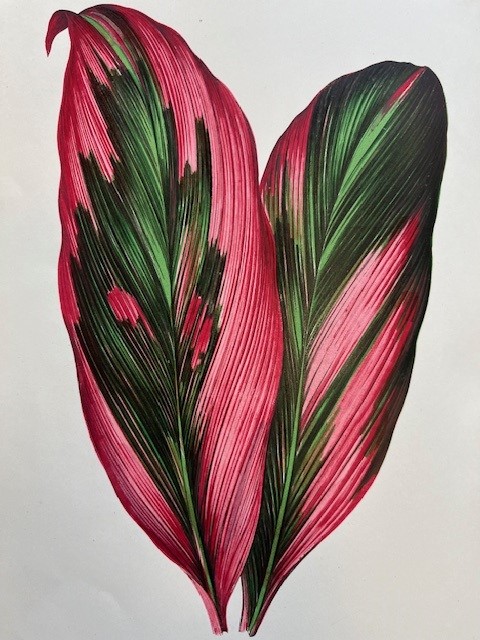 Beautiful-Leaved Plants, ‘Draecena terminalis’ and ‘Alocasia lowii’
Beautiful-Leaved Plants, ‘Draecena terminalis’ and ‘Alocasia lowii’
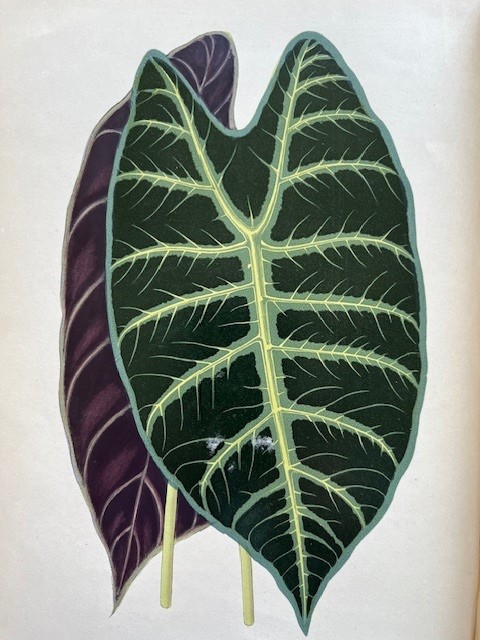
In some of his enthusiasms Shirley Hibberd anticipates the present: he advocated a green belt around London; he fretted over the survival of wild flowers; he kept bees; he advocated systems whereby each household collected rainwater for domestic water supply; for a while he espoused vegetarianism (but lapsed). Apart from one surviving small park that he designed at Islington Green, all of Shirley Hibberd’s London gardens have been built over, but his legacy is the continuing and absorbing cult of amateur gardening in the modest plots gardened by most people.
Barry Windeatt, Keeper of Rare Books
30 April 2024
As I write this latest edition of my blog, the sun is shining and there is not a cloud in the sky. This feels like a welcome relief from the months and months of grey, wet weather that the Garden Department has had to endure. Reports say that there has not been a full dry week since September 2023. I can quite believe this. It has been the wettest period in my 35 years plus career. Let’s hope for a better late spring and summer.
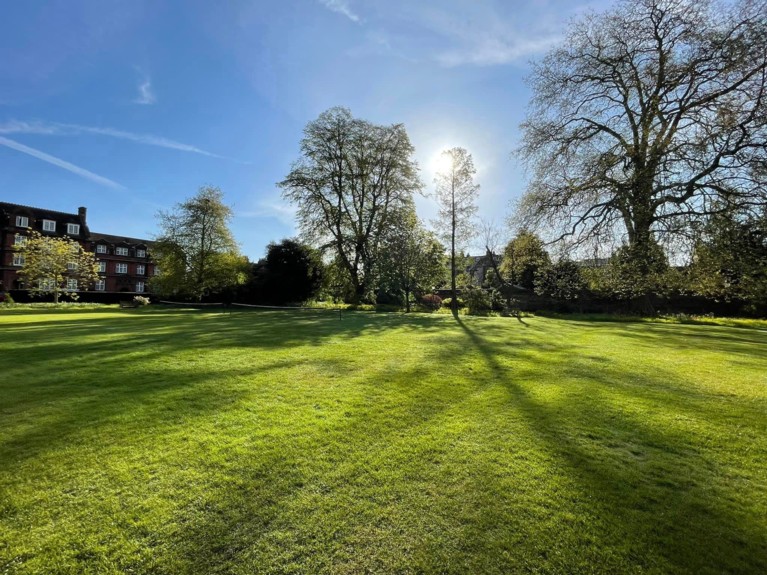
The Garden Department has been extremely busy this year, more than ever. We have been trying to juggle several projects and still maintain the beautiful grounds that we are blessed to work in.
One of the largest projects that we are undertaking is the building of the new College Community Garden. These are being built at the rear gardens of Park Terrace, the idea being that this will become a non-hierarchical space to build a community of gardeners. The long-standing health benefits are widely reported and should help those that are wishing to undertake a gentle pastime to include growing vegetables and cut flowers.

The gardens will be available, within time, to the Emmanuel community, whether students, staff or Research Fellows staying with us. There will be a selection of raised beds along with composting solutions to help with food waste.

It is unfortunate that we must delay the building of this garden while the quiet period is on, along with the exams. We hope to have a soft launch towards the end of May, when some of the work will be complete. We will continue to build over the summer and should be up and running fully at the start of the new academic year.
We have also marked out two tennis courts on the Paddock. This sees the return of tennis to the Paddock after a break of at least four years due to building works. I have put only two courts up, specifically with the intention of an area to play a little light social tennis. They are to be used as a facility to relieve such pressures of exam stress and encourage students to get out of their rooms and take a short break. If serious tennis is required, then we have some fantastic facilities at the college sports ground on Wilberforce Road. Tennis bookings will soon be available to book via the college CASC booking system.

The rest of the gardens are really starting to come alive. The vegetation around the pond is growing fast, the mini meadows at the front gardens of Park Terrace are thriving, the spring meadows on the Paddock have been magnificent and the lawns are looking lush and green. Warmer weather is forecast this week so please get out and enjoy the gardens whenever you can.
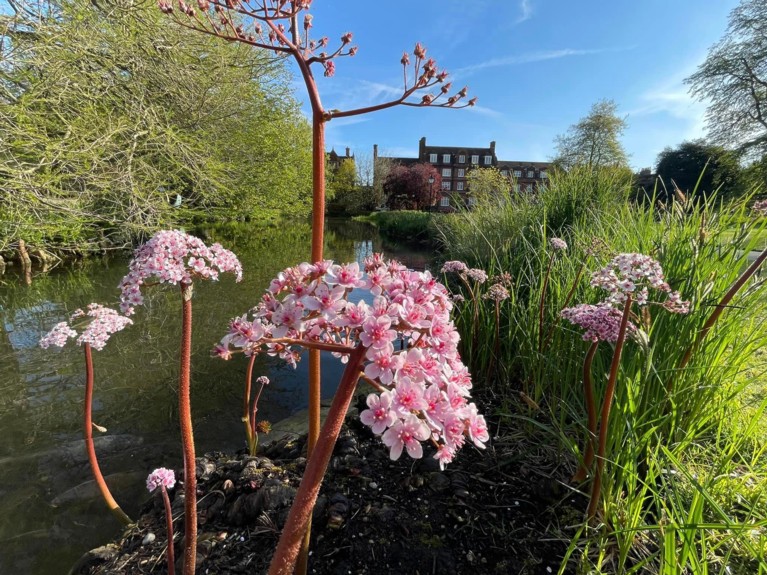
We have been busy in the greenhouse growing plenty of seeds to be planted out later into the borders. The window boxes in Front Court will return in May too.
Kind regards.
Brendon Sims, Head Gardener
26 March 2024
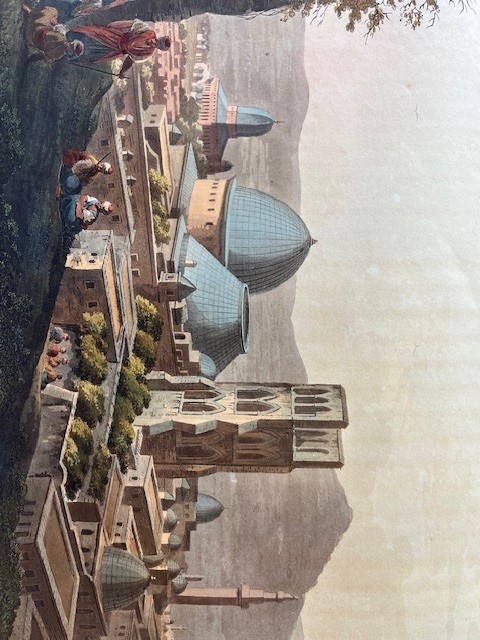
Mayer, ‘Views’: Jerusalem, with the Church of the Holy Sepulchre
In Holy Week, thoughts turn to the Holy Land, and never more so than this year. Emmanuel’s collection of illustrated travel books from the late eighteenth and earlier nineteenth centuries contain only limited images of the area, which was just becoming an object of curiosity to more intrepid spirits, interested in travelling wider than Europe in search of the picturesque. The splendid exception is Views in Egypt, Palestine, and other parts of the Ottoman Empire (1804) by Luigi Mayer (1755-1803). Italian-born, of German ancestry, Mayer was commissioned by Sir Robert Ainslie Bt, British Ambassador to the Ottoman Empire (1776-1792), to record landmarks and landscapes throughout the Ottoman possessions. (Ainslie presented Mayer’s original paintings to the British Museum).
As the nineteenth century wore on, advances in communications and much improved opportunities for tourism resulted in an enormous increase in the numbers visiting the Holy Land. A special interest of Mayer’s ‘views’ is that they record some of the sites famous from Biblical accounts as they still were before this onslaught. Mayer presents the Holy Places in a picturesque dilapidation, as they had apparently remained during the long centuries of the Ottoman Empire’s decline.
Mayer’s street scenes in Jerusalem can thus appeal to the age’s much wider taste for the melancholy inspired by the prospect of ruins, as well as recording the current state of places mentioned in the Bible’s narrative of events in Holy Week.
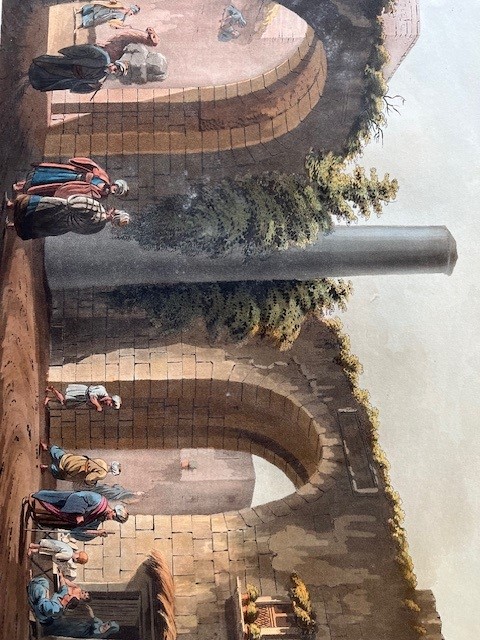
Pillar to which was affixed the sentence passed on Our Saviour
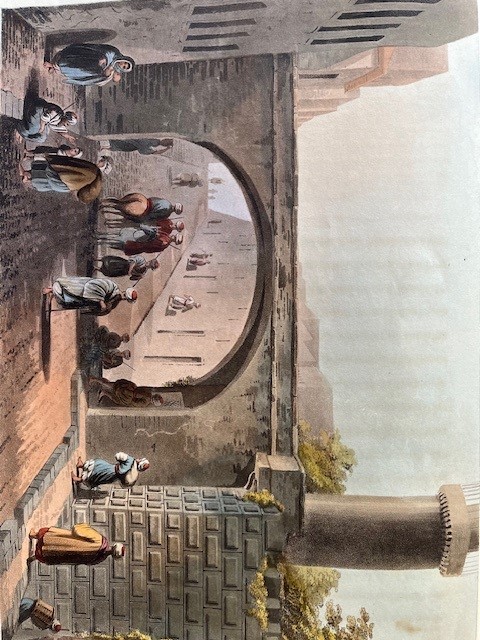
Remains of a Tower on Mount Zion
For Christian pilgrims to Jerusalem the most important site has always been the Church of the Holy Sepulchre, built over the site of Christ’s crucifixion on Mount Calvary. Inside the Church, pilgrims visited the site of the cross and the sepulchre, as well as the places where, it was believed, Christ was nailed to the cross and where his body was later anointed by Joseph of Arimathea and Nicodemus. Mayer’s views catch the gloom of these interiors, lit by candles.
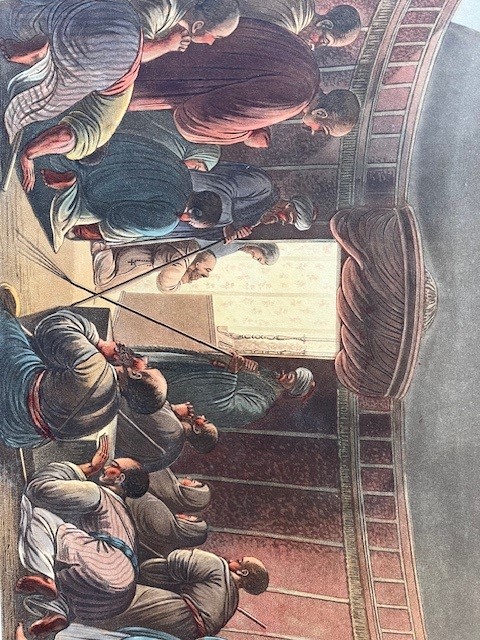
Entrance of the Chapel of the Holy Sepulchre
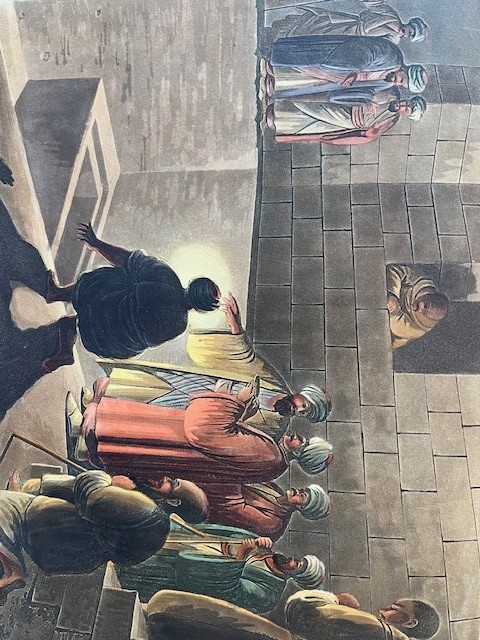
Tomb of Joseph of Arimathea
This is also so of the reputed sepulchre of the Virgin Mary near the Garden of Gethsemane, over which a church had been erected by St Helena, mother of the Emperor Constantine. Pilgrims descended into the subterranean church to where the Virgin’s tomb stood in a chapel hewn out of the rock. Her tomb was venerated by local Muslims, who helped defray the cost of the eighteen lamps kept constantly burning in front of the Virgin’s tomb. Here, as in the Church of the Holy Sepulchre, only the thresholds of the most sacred shrines are depicted.
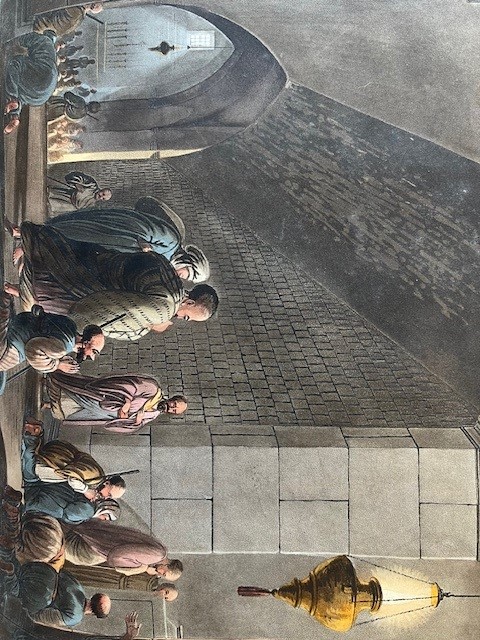
Tomb of the Virgin Mary
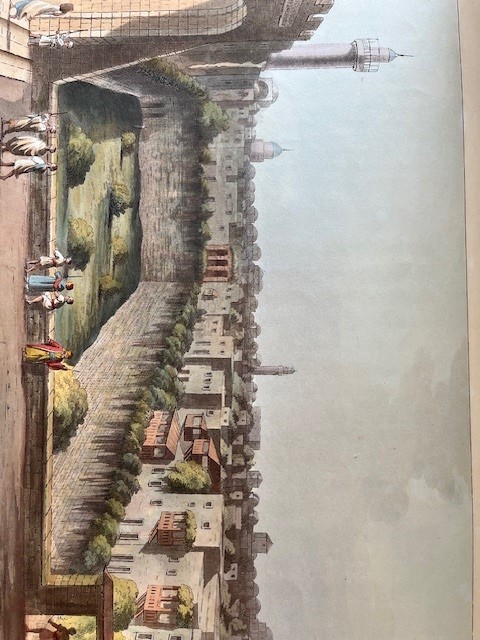
The Pool of Bethesda, Jerusalem
Much less frequented was the Pool of Bethesda in Jerusalem, where Jesus bid a paralysed man ‘Rise, take up thy bed and walk’ and so he did (John 5: 8-9). At what was believed to be the site in Mayer’s day any springs of water had dried up and the site was overgrown.
At Bethany was the home of the sisters Martha and Mary, whose brother Lazarus Christ raised from the dead after four days (John 11: 1-45), a miracle that prefigured his own resurrection. Mayer also illustrates some subterranean tombs at Bethany, by implication the site of the miracle.
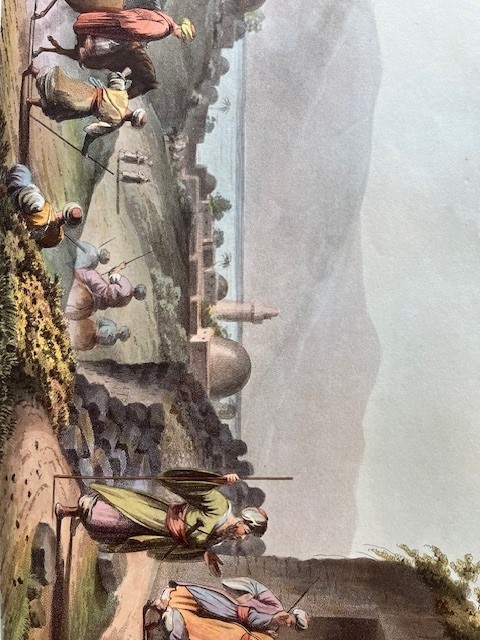
The Village of Bethany and the Dead Sea
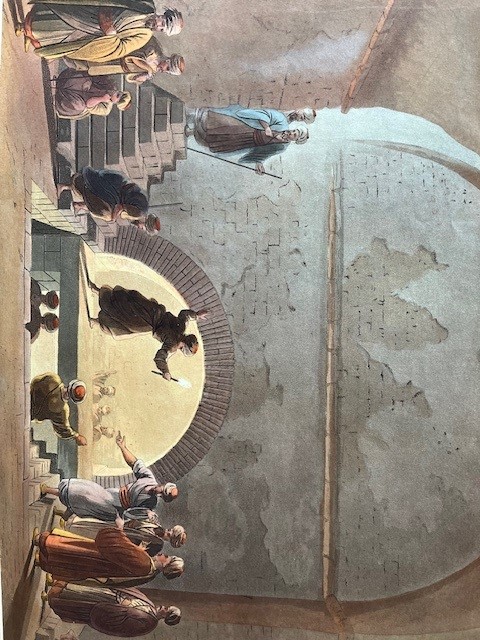
Sepulchral Chamber near Bethany
Also illustrated are scenes at Bethlehem, where a church had been built over the supposed site of Jesus’ birth. There was a subterranean chapel of the Nativity, with a further chamber exhibiting the manger, along with a handy shelf upon which the Three Wise Men were believed to have deposited their gifts. A nearby cave contained a vault ‘where they say’ were buried the Holy Innocents, the children murdered by Herod. Also to be seen was the grotto ‘in which they report’ St Jerome remained for fifty years – rather understandably since he twice translated the Bible into Latin there.
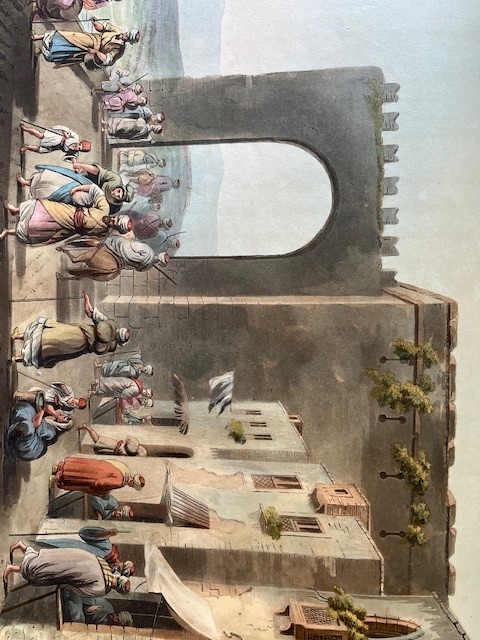
Principal Street of Bethlehem
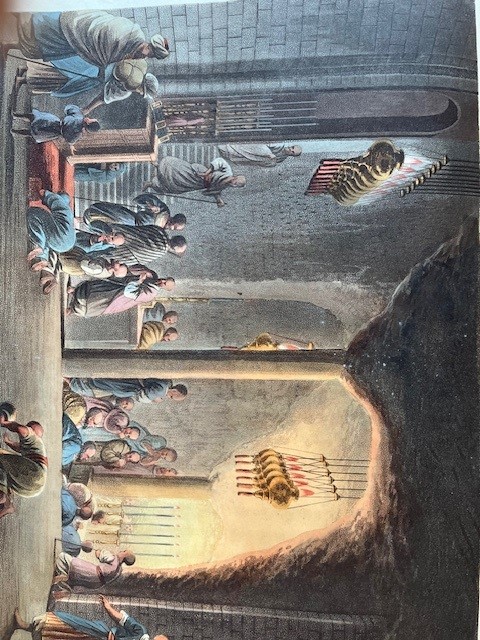
Subterranean Church of Bethlehem
As Mayer travels around sketching and painting, he also records ruins, reputedly from Old Testament times, in states of picturesque decay, such as the tomb that Absolom had reportedly built for himself, or the supposed tomb of Rachel, the wife of Jacob, although in his accompanying commentary Mayer sniffs that she was certainly never buried in a building so relatively modern.
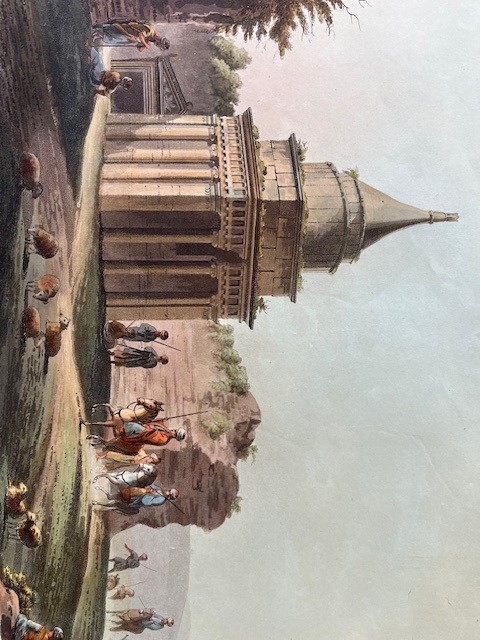
Sepulchre of Absolom
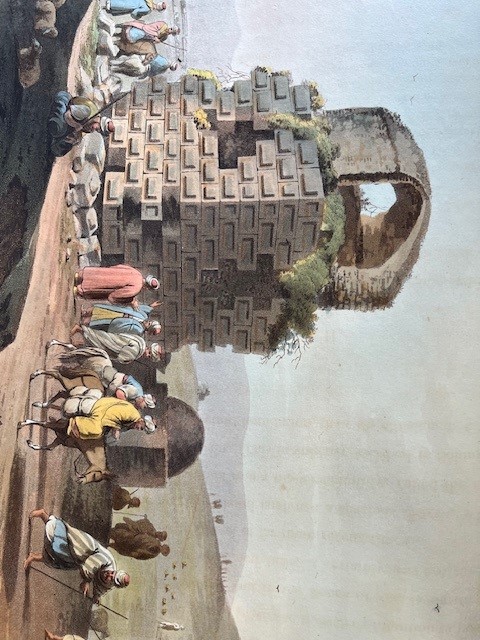
Sepulchre of Rachel
In Mayer’s record of the picturesque, stones are tumbled and vegetation sprouts from ruins. Outside, vistas recede, while in dim interiors gleam spots of light in a religious glow. It is an intriguing snapshot through western eyes of places familiar from the Old and New Testaments at the end of the eighteenth century.
Barry Windeatt, Keeper of Rare Books
26 March 2024
As I write this blog entry, it is a beautiful Spring morning. The sun is shining and there is not a cloud in sight. The morning is fresh, but the sunlight lifts the soul. The apricity of the sun against your face seems to make a job in gardening worthwhile.

This has not, however, been the case for the whole month that has preceded it. We have been battling the cold, grey skies and the plentiful rain. It certainly has been a challenge. Hopefully the weather will start to improve with a spell of dry weather forecast.
In the College gardens we have been busy all the same. March has been the time for many of the seasonal tasks, including pruning the shrubs grown for their winter stems, hard pruning of the buddleias, mulching of the beds and keeping on top of the early growth of grass.
The team have also been busy repairing damaged areas around the swimming pool. The grounds had been messed up a little from the construction work to the pool. It was a good opportunity to put things right.
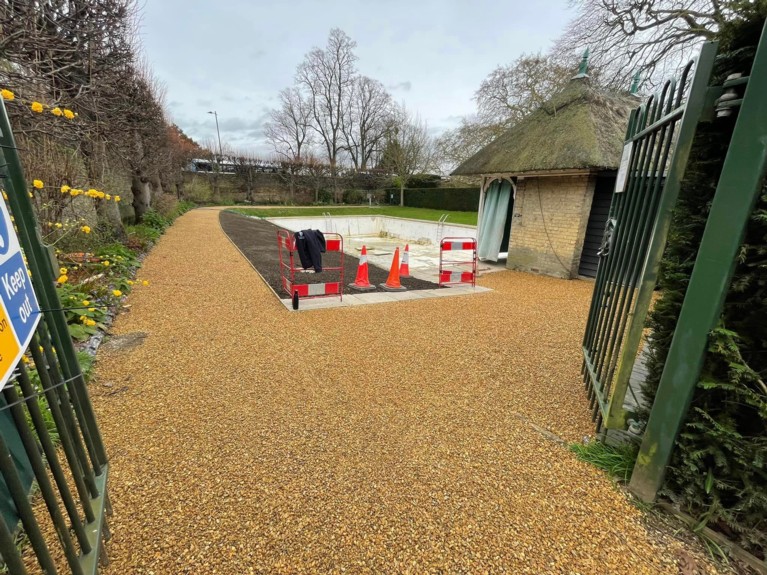
We replaced some of the wooden path edges, laid some additional paving and graded some topsoil ready for grass seeding. Finally, we top dressed the gravel paths to bring the project together. The pool still must be relined when the weather improves but the areas surrounding it at least now look neater.
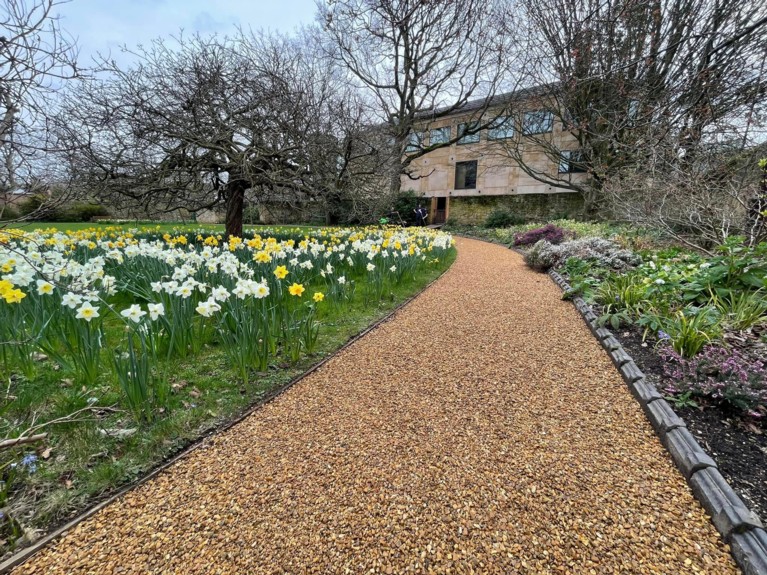
Around the grounds, the spring bulbs are in full effect, the Paddock is being framed by the daffodils and the successional bulbs under the oriental plane tree in the Fellows' Garden look amazing.
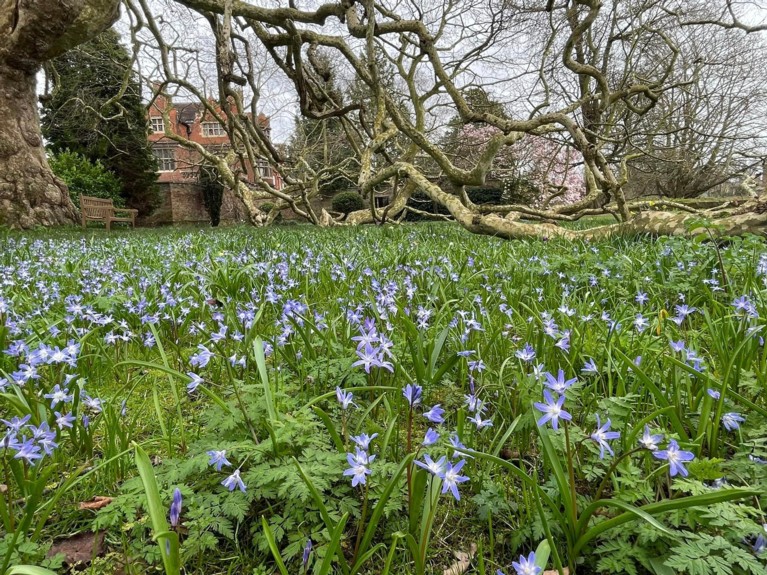
The magnolia in the Jester Garden is looking its striking best at present.
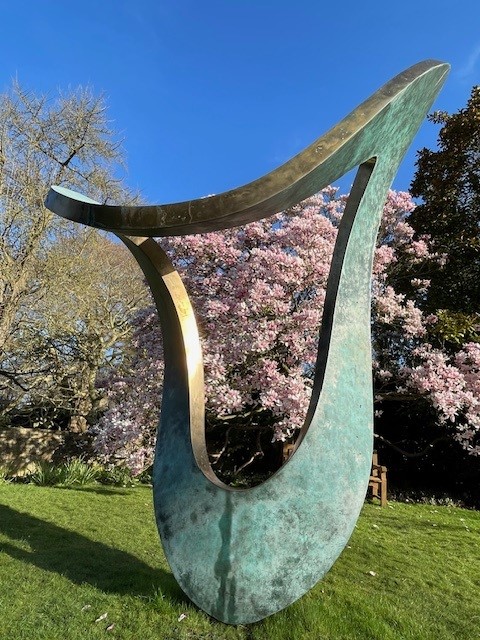
It’s well worth a look before the magnificent pale, pink flowers drop due to a heavy frost or a stormy night.
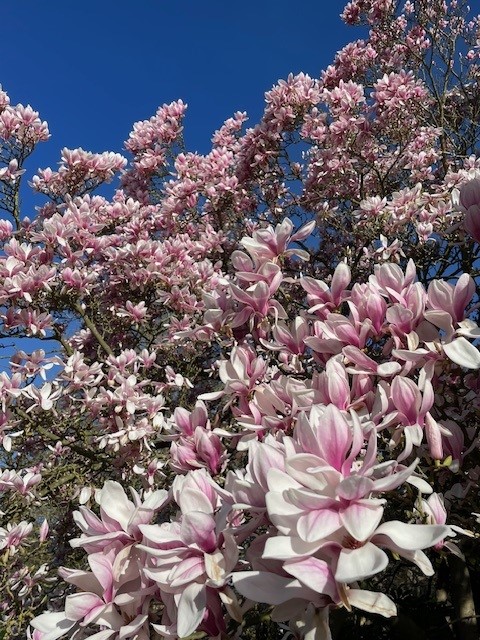
Earlier this month, I was delighted to welcome former alumnus and celebrity gardener, Charles Dowding, back to the College. I had arranged for Charles to spend a day and an evening with us, passing on his vast experience of his now world famous ‘no-dig’ philosophy.
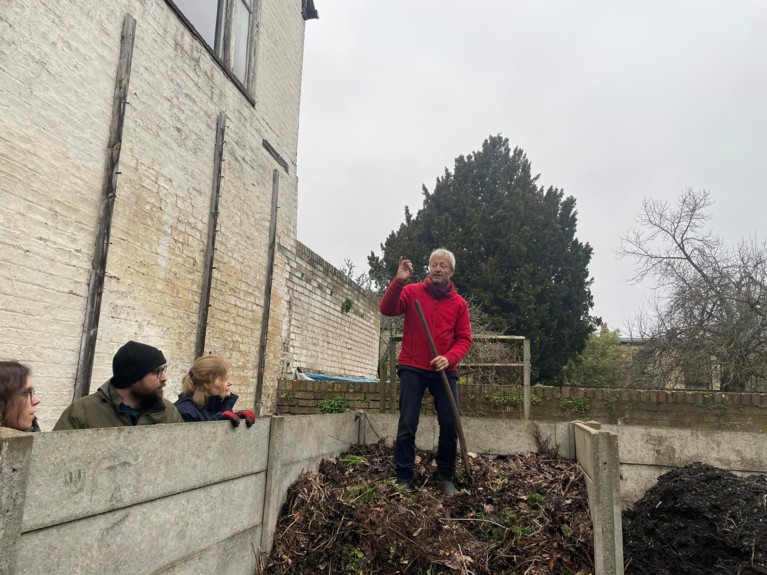
Charles gave us a masterclass practical demonstration in the afternoon and valuable advice on our existing compost systems. For the masterclass, we were joined by many of the other colleges' Garden Departments. It was great to share this experience with many in our university garden community.
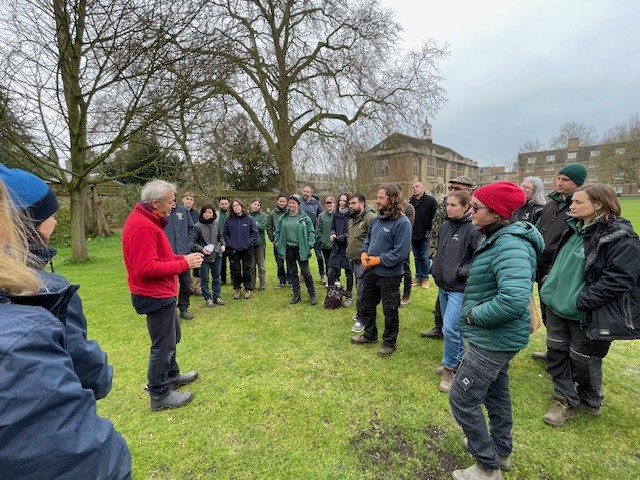
In the evening, Charles gave a talk to a packed audience in the Queen's Building Lecture Theatre. It was great to be part of this event and the feedback from the audience was very well received.
I had the pleasure of dining with Charles at High Table in the evening and it was another chance to pick his brains. Altogether a fantastic experience for the Garden Department.
Best wishes.
Brendon Sims, Head Gardener
26 March 2024
A is for … Acorn
The Founder of Emmanuel, Sir Walter Mildmay, liked to talk of his college as an acorn, ‘which, when it becomes an oake, God alone knows what will be the fruit thereof’.
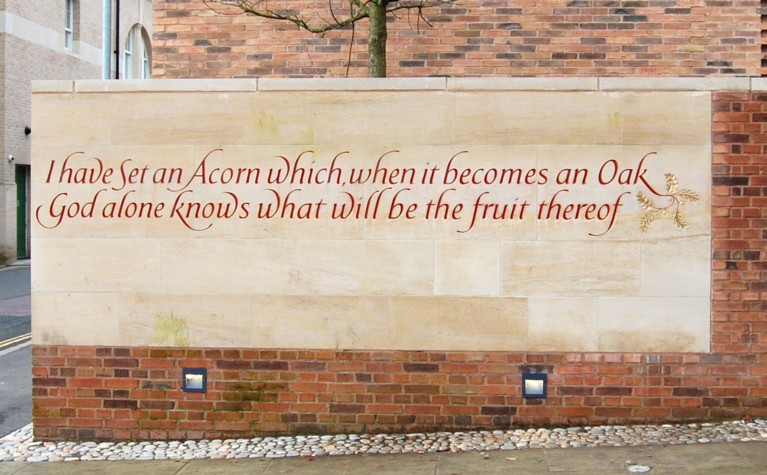
Quoting this remark many years later, William Dillingham, Master of Emmanuel 1653-62, added that Mildmay’s acorn had indeed grown into an oak, ‘whose topmost branch adorns and revives the primacy of our Church’. This was a reference to the elevation of William Sancroft, a graduate and former master of Emmanuel, to the office of Archbishop of Canterbury in 1677. Acorn imagery can be seen on the bindings of both the college’s original copy of the founding statutes, and on the Founder’s personal copy.
.jpg)
Acorn motifs have also been used in the college’s newest building, Young’s Court, which opened in the summer of 2023. A beautiful carving of Sir Walter’s ‘acorn’ remark can be seen on the wall adjoining the entrance to the court, while a transparent plaque inside Fiona’s, the new college café and Hub, displays an ingenious representation of an acorn, made up of the names of donors who supported the Young’s Court building appeal.
A is for … Apethorpe
Like most Tudor self-made men, Sir Walter Mildmay converted his wealth into real estate at the earliest opportunity, purchasing Apethorpe (pronounced ‘Appthorpe’) manor house in Northamptonshire in 1551.
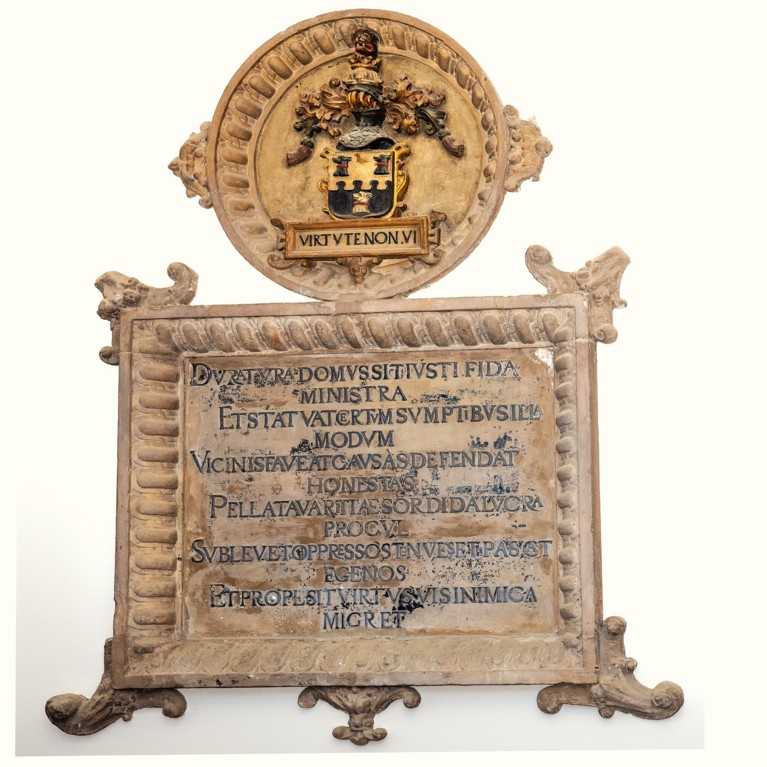
Sir William Cecil owned a nearby estate, where he was later to erect the gargantuan Burghley House. It was undoubtedly serendipitous for Sir Walter to be such a close neighbour of Cecil, who was to serve as Elizabeth I’s principal minister for almost her entire reign. There was, nevertheless, genuine friendship between the two men, who shared a common religious and political outlook. Apethorpe remained in the hands of Mildmay’s descendants until 1904. The costs of upkeep forced its sale after the Second World War, and it became an educational establishment. The contents were sold off, and Emmanuel College was able to buy several pieces of furniture in 1948, including the ‘Founder’s table’, now in the gallery.
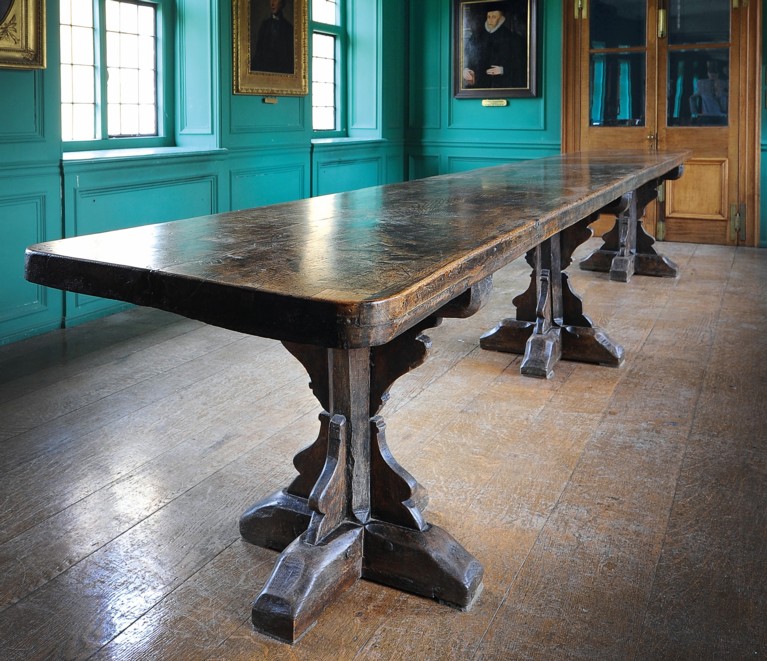
A year later the new owners of the Hall gave the college the inscribed tablet, topped with a roundel showing the Mildmay coat of arms, that Sir Walter had set up over the fireplace in the great hall in 1562. It now overlooks the main staircase in the college library.
Amanda Goode, College Archivist
28 February 2024
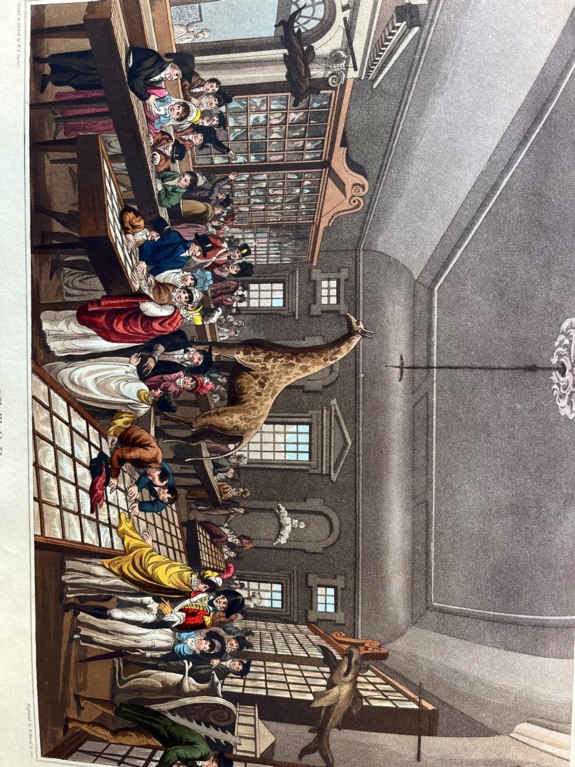
A curious public inspects the curiosities in the museum at Trinity College Dublin; W. B. Taylor, History of the University of Dublin (1819)
Emma Connects has just passed its one hundredth edition since it was created in order to reach out to Emmanuel members during the isolation, and perhaps loneliness, of the first lockdown. Soon it will be four years since the first Rare Book blog appeared in April 2020, describing a book published in 1665, the year of the Great Plague, that recommended ‘It is advisable that all needless Concourses of People be prohibited …’ This is the sixty-fourth of these Rare Book blogs since that beginning, although they have barely scratched the surface of the College’s rare book collections. The positive outcome of what began prompted by adversity is that the interest and beauty of Emmanuel’s illustrated books – many now quite fragile to handle – can be appreciated by a much wider readership than ever before.
What never ceases to impress is the sheer energy of curiosity represented by those who created these books and those who collected them. Two books written by intrepid women make this point. The title page of Narrative of a Residence at Tripoli in Africa (1816) gives the author as Richard Tully, but the introduction at once acknowledges that the memoir is that of his sister, recalling experiences from thirty years earlier, when Tully was the British Consul at Tripoli, and his young daughters grew up speaking Arabic and on terms of close friendship with the family of the Bashaw, or ruler, of Tripoli.
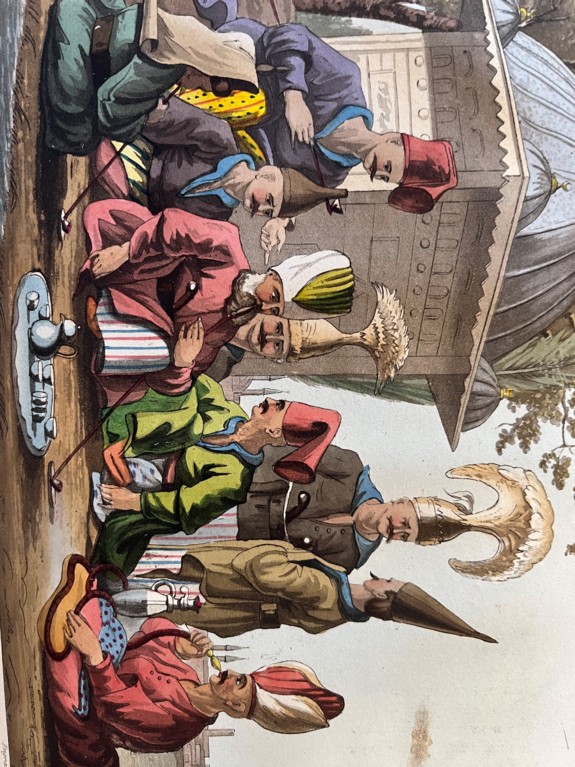
Miss Tully, Narrative of a Residence at Tripoli: Officers of the Grand Seraglio Regaling
Fanny Parks published extensive journals of her time and travels in India as the wife of a British official in Wanderings of a Pilgrim in Search of the Picturesque, during four-and-twenty years in the East (1850), but in a self-effacing gesture her name appears on the otherwise-English title page only in Urdu script. She is a sympathetic admirer of Indian culture and customs, sometimes allowing herself to criticize such English ways as the legal position of married women.
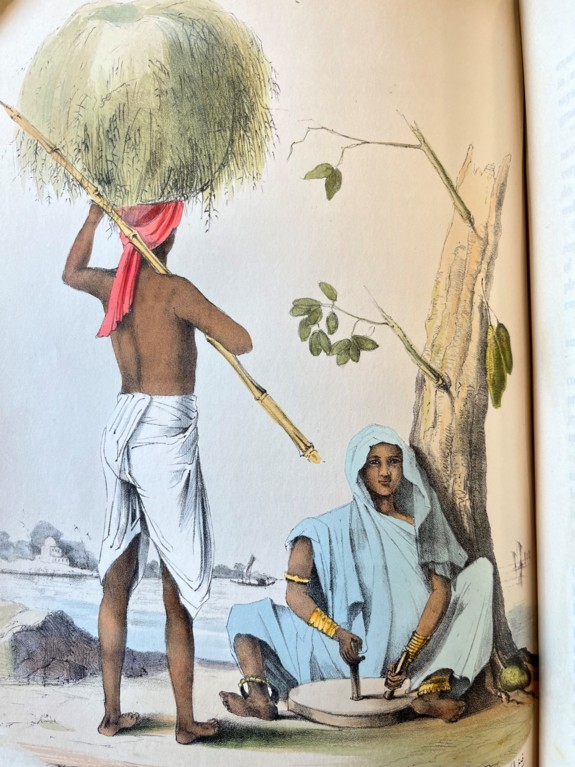
Fanny Parks, Wanderings of a Pilgrim: Grass-Cutter and Gram-Grinder; A Bengali Woman
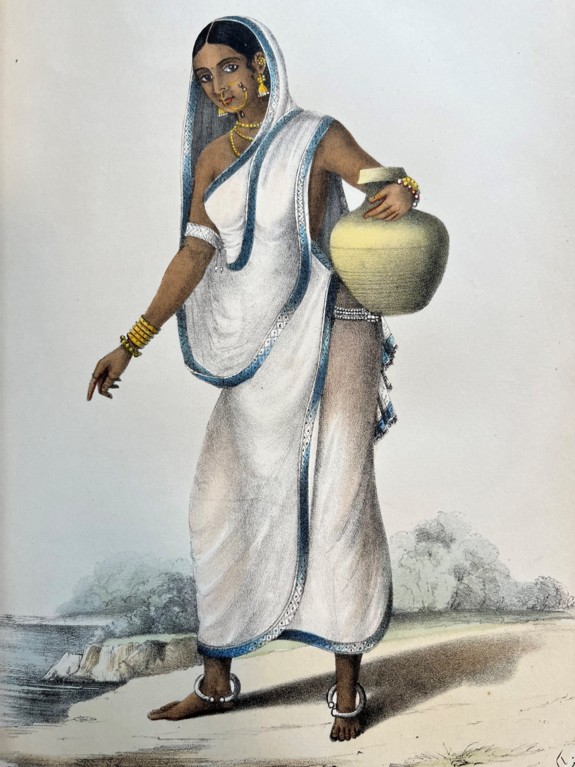
Thomas McKenney and James Hall’s, History of the Indian Tribes of North America (Philadelphia, 1848-50) was based on portraits commissioned by McKenney of Native Americans who came to Washington to negotiate treaties. McKenney was Superintendent of Indian Trade and hoped to preserve ‘whatever of the aboriginal man can be rescued from the destruction which awaits his race’. With the advantage of hindsight, it is hard not to see that doomed dignity in the solemn composure of these portraits.
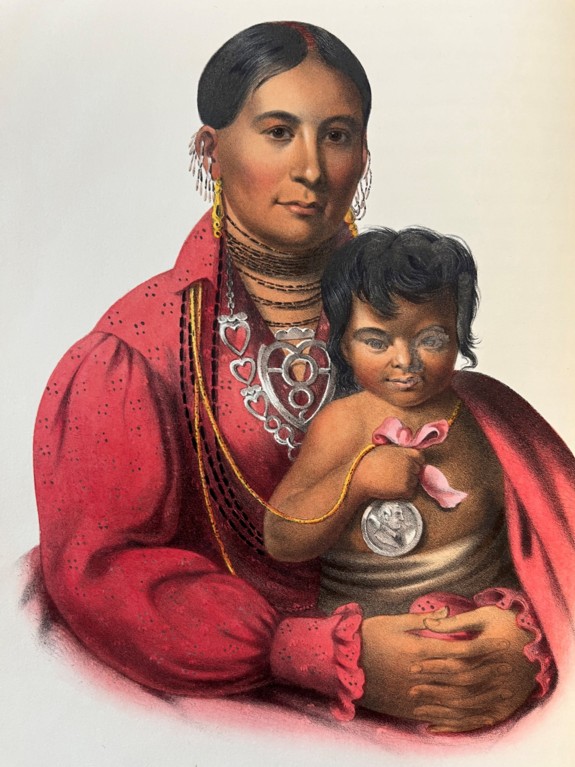
McKenney and Hall, History of the Indian Tribes: An Osage Woman; A Chippewey Chief
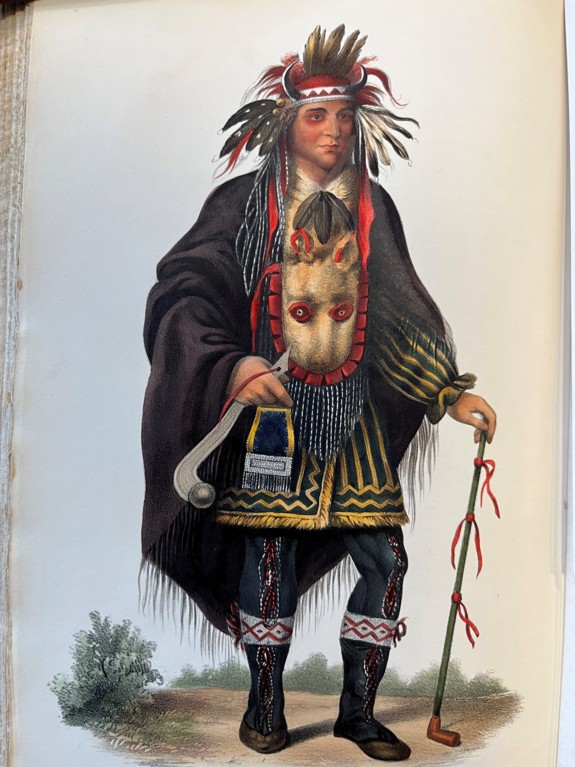
But the customs and costumes of countries much closer to home might prompt just as much curiosity. Both A Sporting Tour through France (1805) by Colonel Thornton and Sketches in Flanders and Holland (1816) by Robert Hills find space, in books largely devoted to views of landscape and architecture, to include studies of figures in local costume in the Low Countries or engaged in their trades on the streets of Paris.
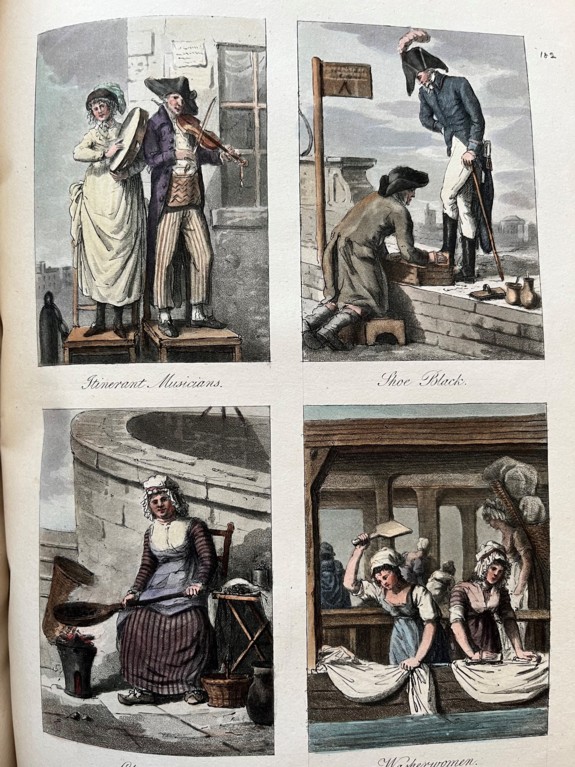
Thornton, A Sporting Tour: (clockwise) Itinerant Musicians, Shoe Black, Washerwomen, Hot Chestnut Seller
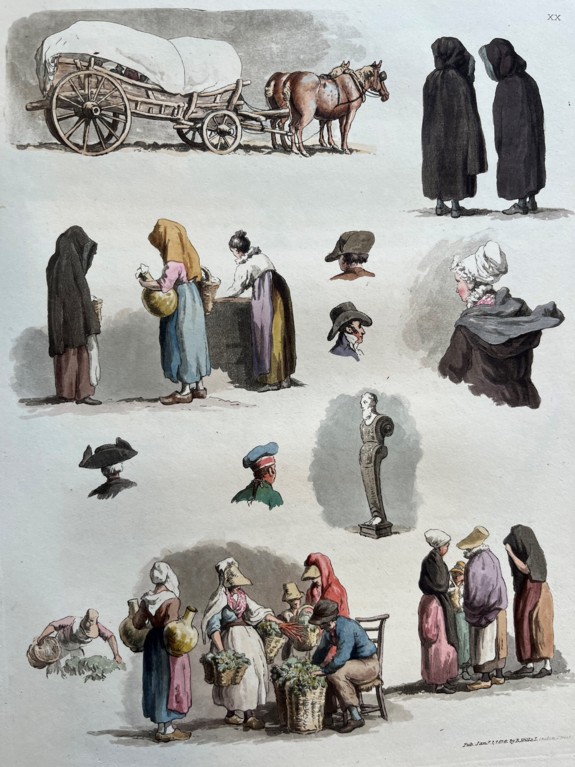
Hills, Sketches in Flanders
There are also a wealth of illustrated books presenting a wry, serio-comic take on the life of the well-to-do, which often includes a spell at university (more usually Oxford than Cambridge), where comic misdemeanours can be illustrated, as in this plate drawn and engraved by Robert Cruikshank, showing an undergraduate hoisting a ‘fair nun of St Clement’s’ up to his room in a basket, only to succeed in dropping her on to a passing proctor. (He is sent down).
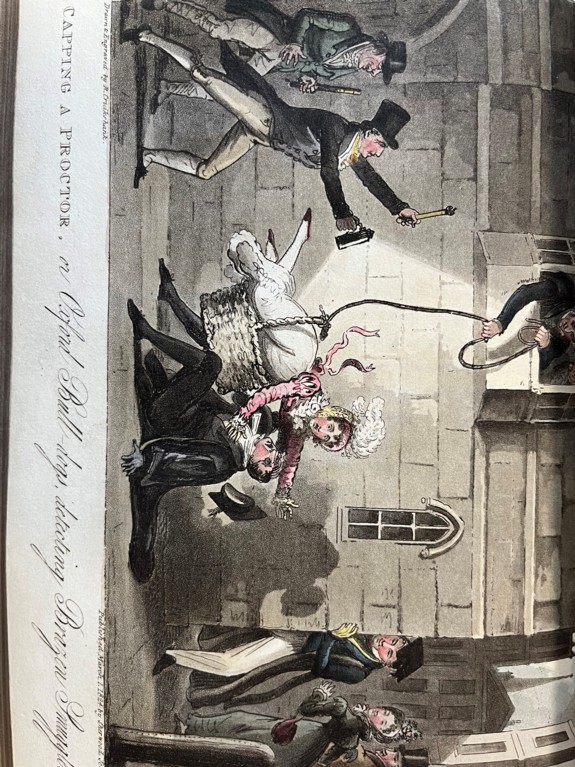
William Westmacott, English Spy: ‘Oxford Bull-Dogs detecting brazen smuggling’
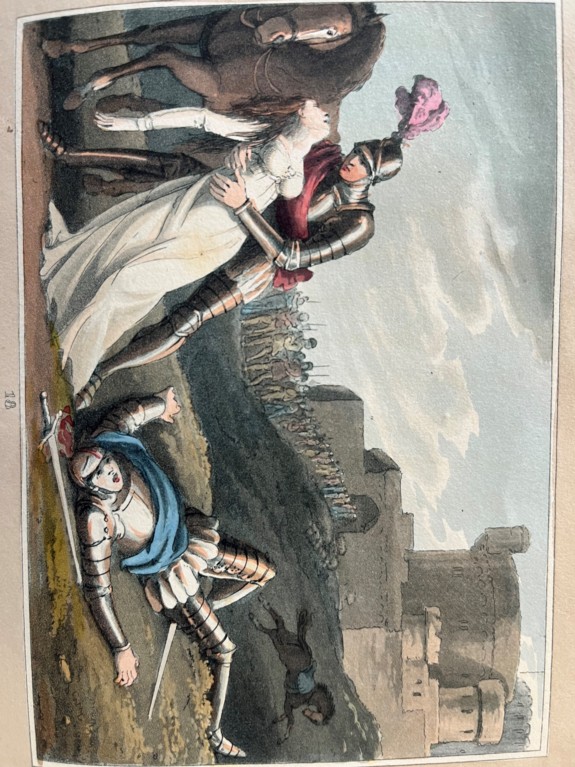
W. Sams, The Tournament
Such illustrations perhaps appeal both to the curiosity of those who haven’t been to college and to the nostalgia of those who have. A new nostalgia is also stirring for a re-imagined version of a ‘Gothick’ medieval past where valiant knights rescue swooning damsels from unwelcome oppressors, as in the illustrations to a truly dreadful book-length poem, The Tournament, or, Days of Chivalry (1823).
Another spur to curiosity for illustrated books probably lay in how so many of the early readers of such illustrated books – both men and women – will themselves have been taught to draw and paint as part of a polite education. Many of the flower books in the College’s collection present both a coloured and uncoloured version of each flower, with the latter available to be coloured by the owner.
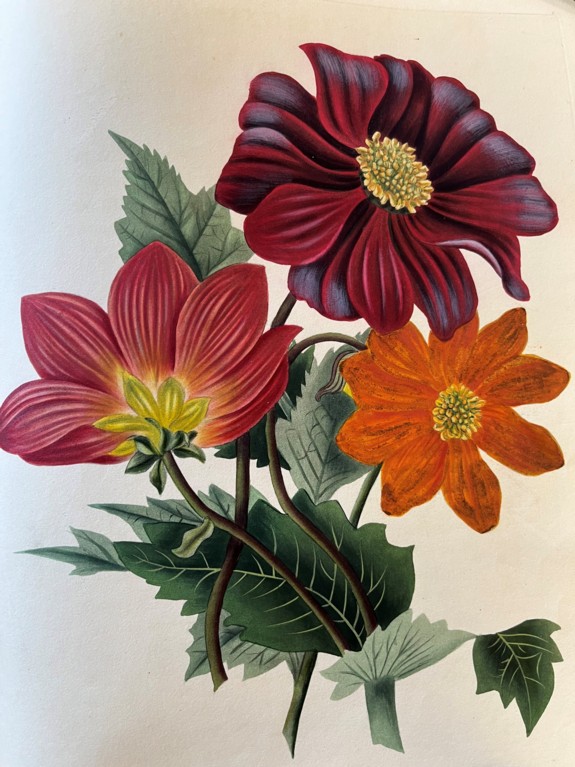
Miss J. Smith, Studies of Flowers from Nature: ‘Dahlia’ coloured and uncoloured versions
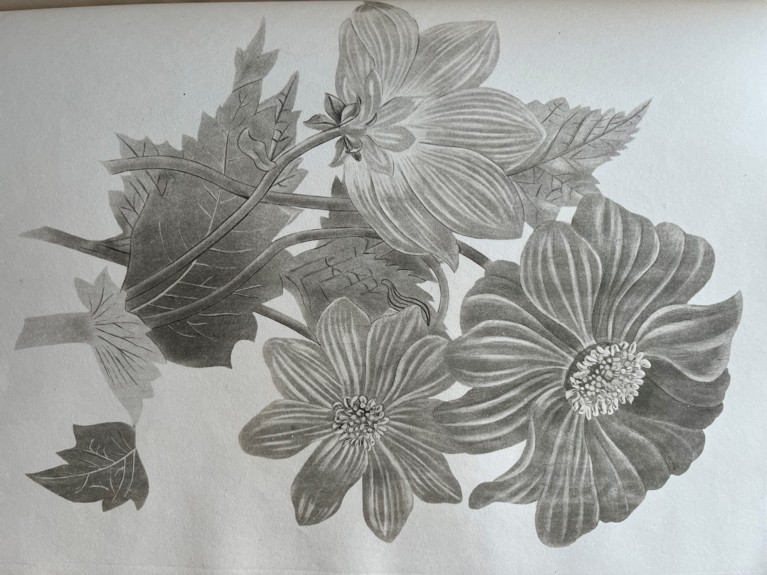
Such books are directed at purchasers who may well have had a trained eye for painting in water colours every sort of subject from flora and fauna, but especially flowers and birds.
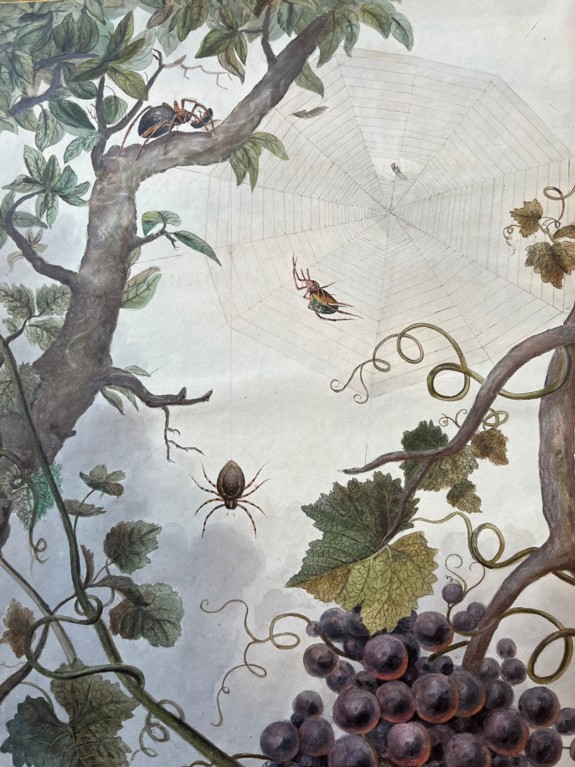
Thomas Martyn, Aranei; or A Natural History of Spiders (1793), frontispiece
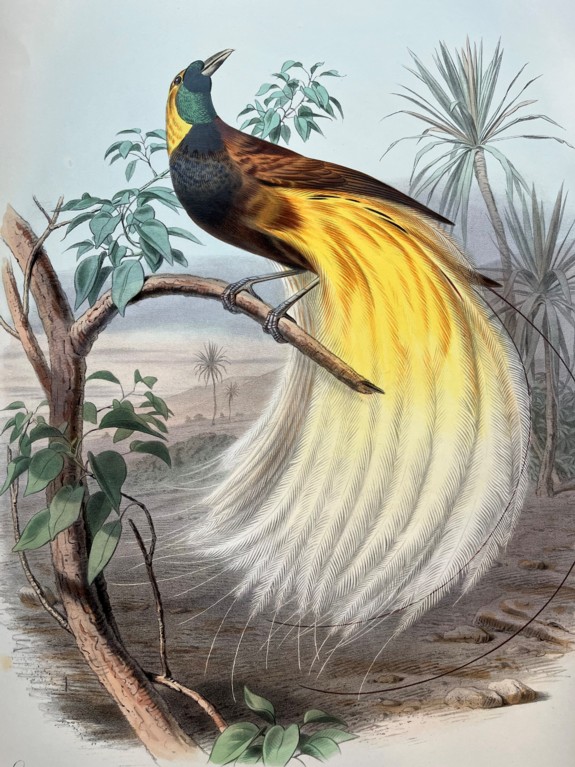
Edouard Travies, Les Oiseaux: scenes varies, etudes a l’aquarelle (1857): Bird of paradise
Curiosity goes along with innovation in the superb illustrations of clansmen in their tartans in McIan’s The Clans of the Scottish Highlands, 2 vols. (1845-57).
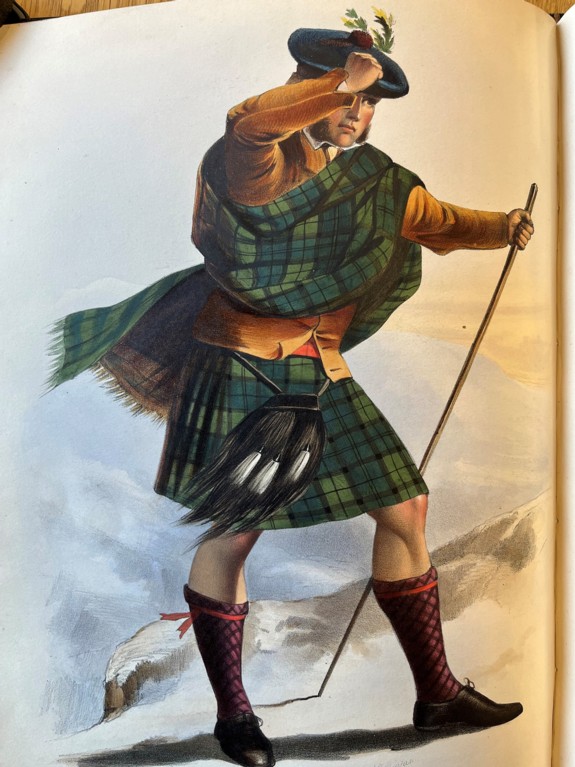
R.R. McIan, Clans of the Scottish Highlands: ‘Sutherland’, and Frontispiece to Volume 2
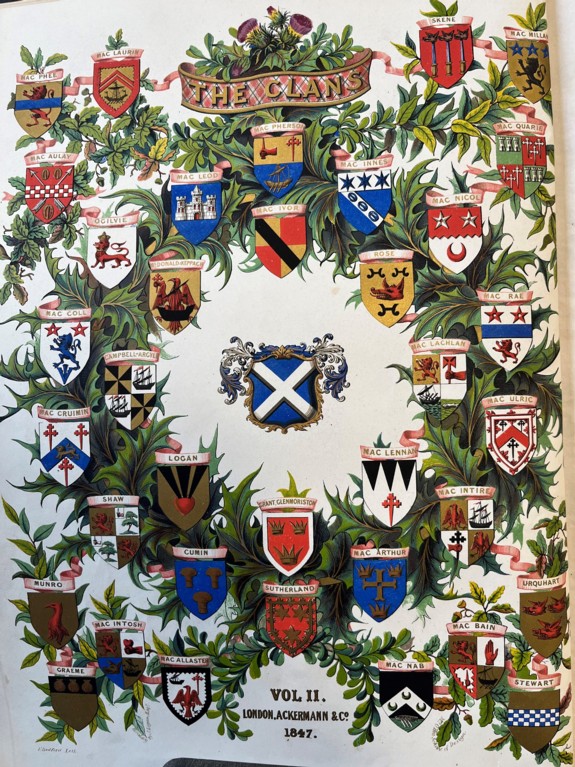
For although the pictures of clansmen are hand-coloured lithographs, the two magnificent heraldic title pages are successful early examples of colour printing. ‘Printed in colors’ (sic) it says modestly in very small type at the foot of the page, but this is part of a transition to a whole new future in the production of illustrated books.
Barry Windeatt, Keeper of Rare Books
28 February 2024
February has almost gone. Most of it was disrupted by the rain again, with just the odd exception in the form of a sunny break in the clouds. I think 2023 and the start of 2024 is one of the dampest gardening seasons that I can remember in 30+ years of gardening. For some, it has been a welcome spell compared with the previous seasons’ long hot spell. I suppose that, as a gardener, you must be careful what you wish for. On the plus side, the temperatures have been on the mild side. There have been good signs of early spring growth. We have even had to make an early start to our grass cutting schedule as the grass has put on significant growth.
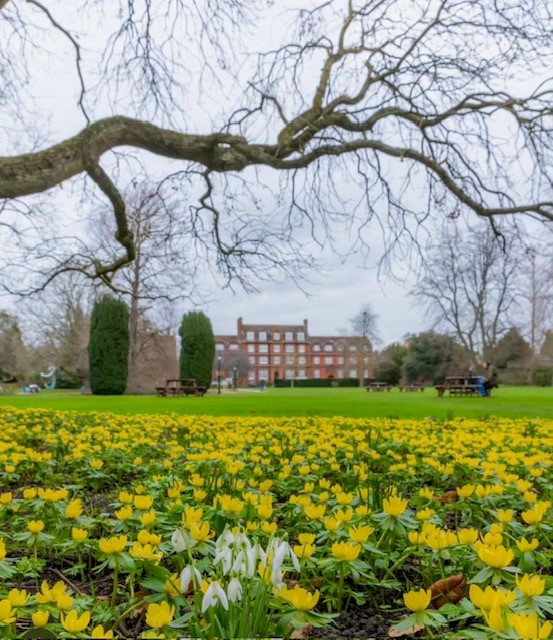
February is always a busy month in the Emmanuel gardens. It is the phase where we are preparing for the coming seasons ahead. We have been busy maintaining all the college benches during the wet spells. Every year there seem to be more benches to maintain as, unfortunately, the number of memorials has not slowed down.
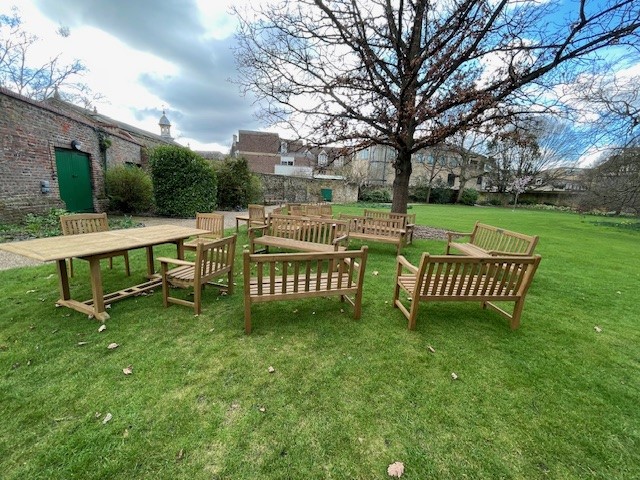
It is also time to start repairing some of the many pathways throughout college as they get worn and damaged through the winter periods. The Garden Team have been busy making a start on these repairs.
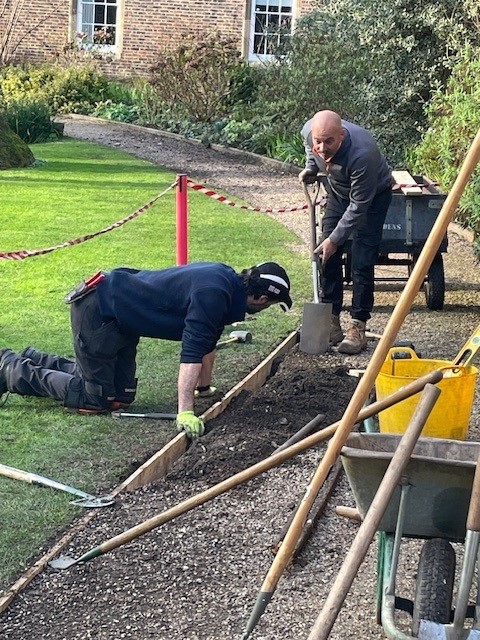
This task has been made a little easier this year due to the garden department’s latest addition. The department welcomes Martin Place to join our fantastic team. Martin joins us as our Landscape Gardener and has brought with him his 25+ years of invaluable experience. Prior to joining Emmanuel, Martin had been proprietor of Saunders Landscapes, which had an excellent reputation in the industry. We will tap into Martin’s skills to help upscale the rest of the garden staff.
Martin will be very busy in the next few months as we have lots of exciting projects on the horizon. I am delighted to announce that, after many months of hard work and an untimely delay, we have eventually had confirmation of the funding required for the Emmanuel College Community Garden. We will be shortly making a start on the building of this, with hopefully some of it being ready to use this year.
We are also busy trying to re-landscape the swimming pool area after several months of construction left the grounds in a bit of a mess.

Over the next few months, the Gardening Department will be collaborating much more with the college sports ground. I am keen to work with our excellent Groundsman, Mark Robinson, in a closer partnership, which I think will benefit both the sports ground and Emmanuel gardens. I am keen for college sport to return to its pre-Covid days and will be working with Mark to ensure we are heading in the right direction.
The Emmanuel gardens themselves are starting to wake up. The earliest signs of spring bulbs are poking through. It always gives us gardeners a sign of hope for warmer days to come.
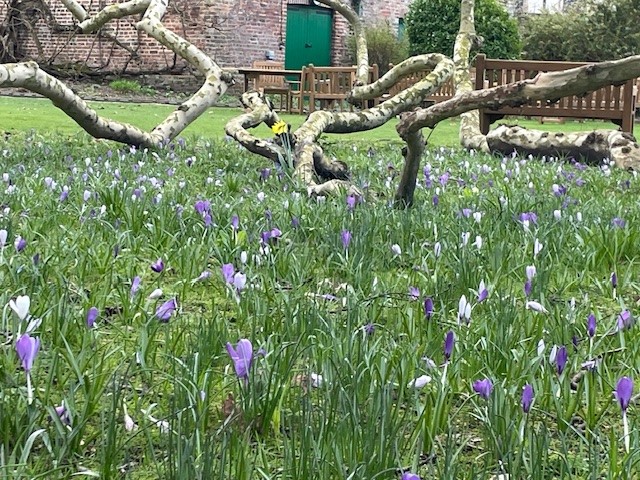
In March (on Monday 11th), we are delighted to welcome Charles Dowding back to his old college to give us a Masterclass and an evening talk regarding his now famous ‘No Dig’ philosophy. It’s not every day a celebrity horticulturist comes to Emmanuel, so the department are very excited. There are just a few spaces left if you want to join us. Booking is through Emma Experience and Daniel McKay.
Best wishes.
Brendon Sims, Head Gardener
28 February 2024
The London Overground map is undergoing a revamp. Its wandering orange lines will be replaced by new colours and names denoting the six segments that make up the system. The route between Stratford and Clapham Junction/Richmond has been designated the ‘Mildmay Line’, sparking considerable interest among Emma Members.
The route’s name commemorates the Mildmay Mission Hospital, founded in 1877. Since 1988, it has been a specialist centre for patients with HIV. The hospital was one of many charitable organisations set up by Canon William Pennefather and his wife Catherine, who lived in an area of Newington Green known locally as the Mildmay estate. This quarter had been developed for housing in the mid-nineteenth century, and the ubiquity of ‘Mildmay’ in the resulting nomenclature – Street, Road, Avenue, Grove, Park – is a sure indication that the land had formerly belonged to a family of that name.
Henry Mildmay’s signature in the college admission book; Thomas Mildmay, admitted on the same day, was his cousin
Henry Mildmay, born c.1594, was a grandson of Emmanuel’s Founder, Sir Walter Mildmay. Admitted to Emmanuel in 1610, he continued to take an interest in college affairs after graduating. In 1627, for example, he opposed the royal mandate suspending the unpopular De mora statute that forced Emmanuel Fellows to leave after ten years and become beneficed clergymen. Henry offered to present the college with ‘five or six’ benefices to which its Fellows could be appointed, on condition that the suspension was revoked. The King agreed, but cannily insisted that the college got the benefices first. Henry failed to deliver.
Knighted in 1617, Sir Henry was MP for Maldon from 1621 and held several important official posts, including Master of the King’s Jewel House. His rapacity regarding the perks of office was notorious. Originally a royalist, he switched allegiance during the Civil War and attended Charles I’s trial, although he stopped short of signing the King’s death warrant. He was nevertheless sentenced to life imprisonment at the Restoration; his estates were forfeit, and he was exiled to Tangiers, where he died in 1668. Given his cupidity, Sir Henry had naturally sought a wealthy bride. The lucky lady was Anne, daughter and co-heiress, with her sister Margaret, of William Halliday, a vastly wealthy London alderman. Henry enlisted the help of the King, no less, to coerce the girl’s suspicious father into permitting the betrothal, which took place in 1619.
William Halliday had a house and copyhold estate in the village of Newington Green, and it was this property that became known as the Mildmay estate. Exactly when the Mildmays acquired full possession of the land is unclear. Sources state variously that it was after Halliday’s death (1624), or his widow’s death (1646), or Anne Halliday’s death (1657). The estate had presumably been divided between the sisters, as Margaret Halliday bequeathed her Newington copyholds to her nephew, Henry Mildmay junior, in 1673.
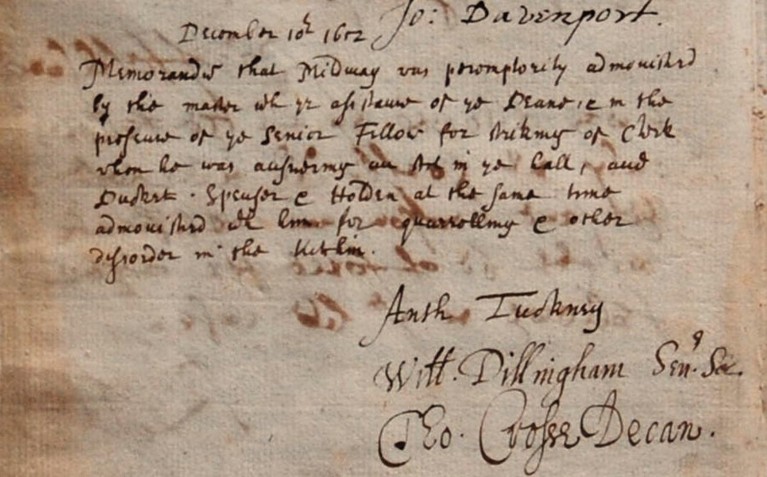
Henry Mildmay junior’s admonition for ‘striking of Clerk’ (either John Clarke or Samuel Clarke, sizars)
Henry junior followed his father to Emmanuel, being admitted in 1651. The apple may not have fallen far from the tree, as he was ‘admonished’ in December 1652 for hitting another student (the only founder’s kin to receive this formal censure) and was later accused by his elder brother William of having cheated him out of his inheritance. The Mildmay estate in Newington remained in the hands of Henry junior’s descendants until its sale in the late 1850s.
Surviving documentation suggests that, against all the odds, the marriage between Sir Henry Mildmay and his ‘so good a wife’ Anne Halliday was a happy one. Parents to six children, they founded their own ‘Mildmay line’, and gave their name to a little corner of north London. Something to ponder when rattling between Dalston Kingsland and Canonbury…
Amanda Goode, College Archivist
31 January 2024
January has come around fast and the Christmas holidays seem a distant memory. On returning to work, we had to pick up where we left off and the first job back always means recycling the Christmas trees. The season’s unfavourable weather also continued with what has seemed like one named storm after another, after another and another. The Garden Department longs for some spring-like days and some apricity from the winter sun.
Unfortunately, just before Christmas, the department had to say goodbye and good luck to one of our staff members, Andrew Luetchford. We wish Andrew the best and thank him for all his hard work, but also look forward to recruiting and welcoming someone new. Watch this space.
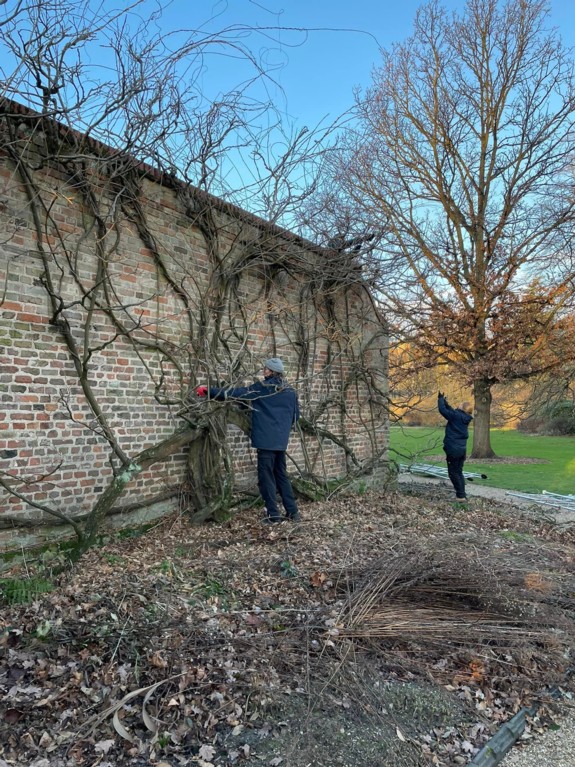
The myth that gardeners are not busy in the gardens at this time of year could not be further from the truth. There are multiple tasks that need completing in the winter months – a long list of pruning schedules that roll out almost until the spring. It is a time for pruning and tying in the climbers, such as wisteria and climbing roses, and with the help of the Maintenance Department, we added brand new climbing supports to our new buildings. The supports look great and will give good support to the climbing plants on those buildings to help soften the landscape.
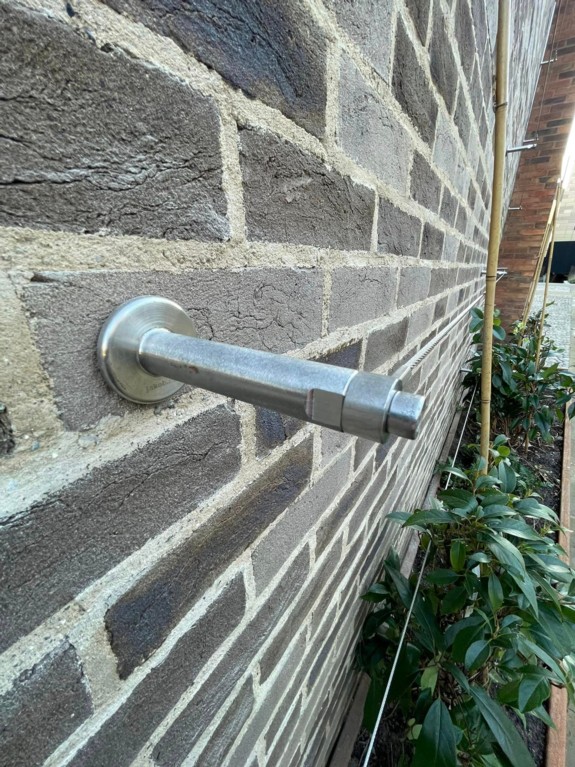
When the sun does shine in the winter, it enhances the beautiful fragrances from some of our winter shrubs. Some of the highlights come from the winter border in the Fellows’ Garden. The colours and fragrances at this time of year can be wonderful, including the Chimonanthus praecox (Wintersweet), Hamamelis (Witch hazel) and the winter flowering Viburnums (Viburnum x bodnantense). The smell from the Sarcococcas (Sweet box or Christmas box) can be heavenly as you brush past them.
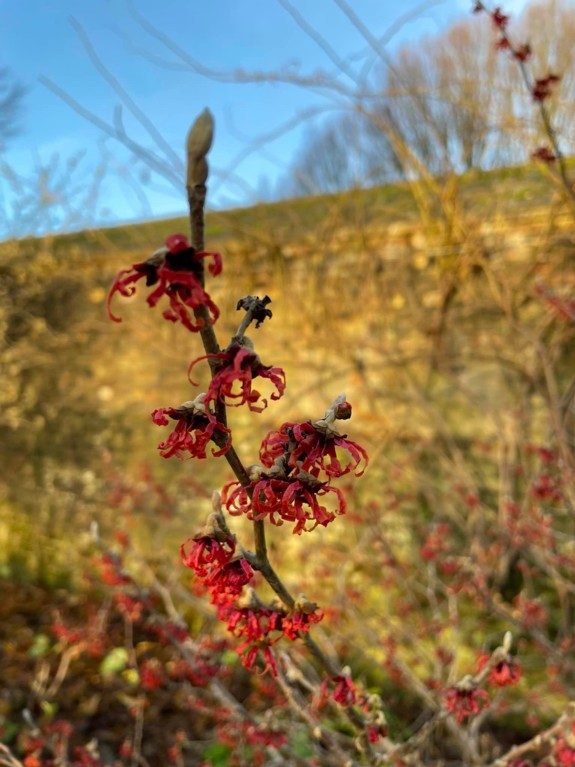
It is also a time to start to work our way through preparing the herbaceous borders. The foliage is left as long as possible to provide some winter protection for the insects, but there must be a systematic plan as we go forward to manage the borders. A comprehensive approach through mass and void analysis helps determine which plants we need to be split and divided through the season, and if indeed any replacements are required.
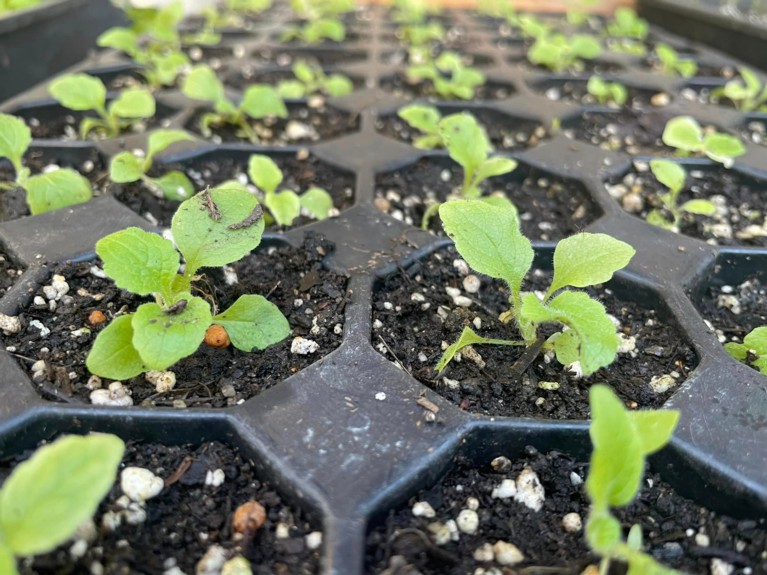
Once the borders are managed then mulching can begin to take place and adding a rich organic matter to the borders will help replace spent nutrients, lock in moisture and help with weed suppressing as the soil temperatures rise. This is a good practice annually and most of the mulch will come from our home-grown compost.
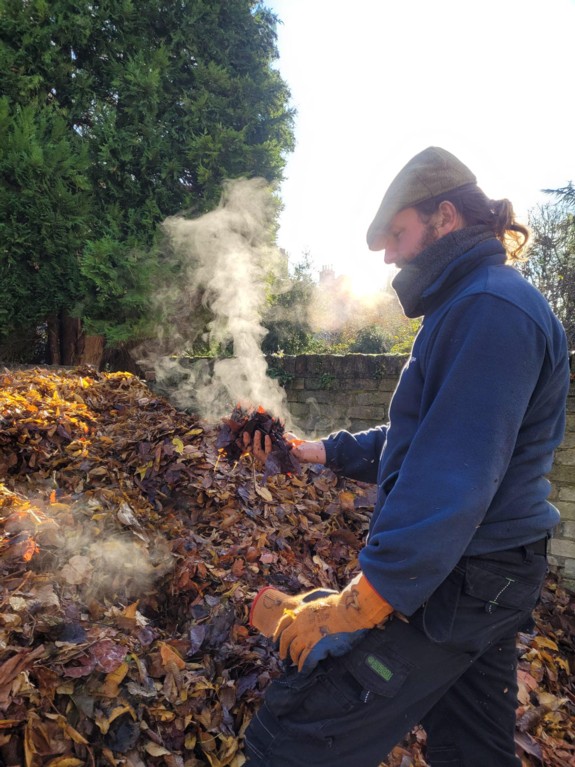
Something to look forward to this year is the college spending some time with celebrity gardener Charles Dowding. Charles is an Emma alumnus and is infamous for his ‘no dig’ theories. Charles will be visiting the college on 11th March and giving a talk in the Queen’s Theatre – this is something that has got the Garden Department very excited. Look out for more information about this shortly.
Best wishes.
Brendon Sims, Head Gardener
31 January 2024
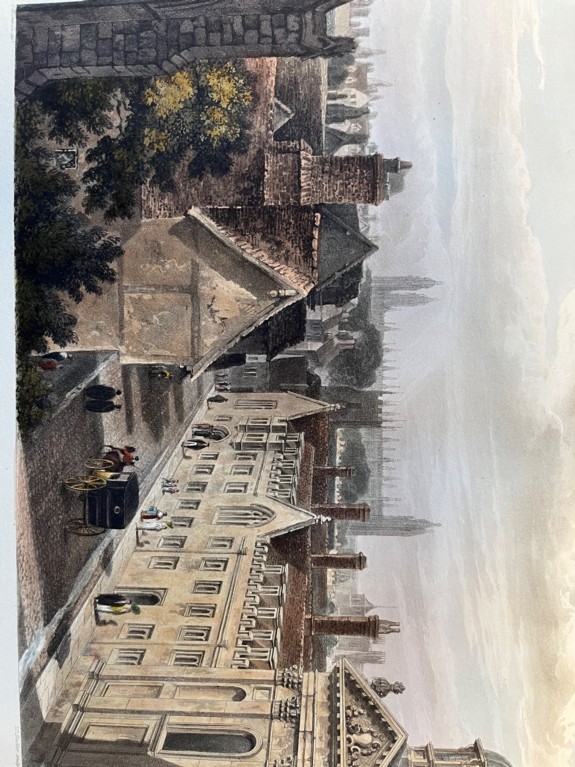
R. Ackermann, History of the University of Cambridge (1815), ‘Pembroke Hall etc., from a window at Peterhouse’
Visitors viewing the richly illustrated books in Emmanuel’s Graham Watson Collection often wonder why such a flowering of hand-coloured books and prints occurs in Britain at this time, roughly the first three decades of the nineteenth century. Breakthroughs in the technical processes of aquatint and lithography are the key contributing factor. But another major influence was the entrepreneurial genius of Rudolph Ackermann (1764-1834), a passionately Anglophile German immigrant publisher. His publication of a series of lavishly illustrated histories of Oxford, of Cambridge, and of historic public schools, were shrewdly pitched to appeal to an elite market among their alumni, but they were also so beautiful that they continue to shape perceptions of those places.
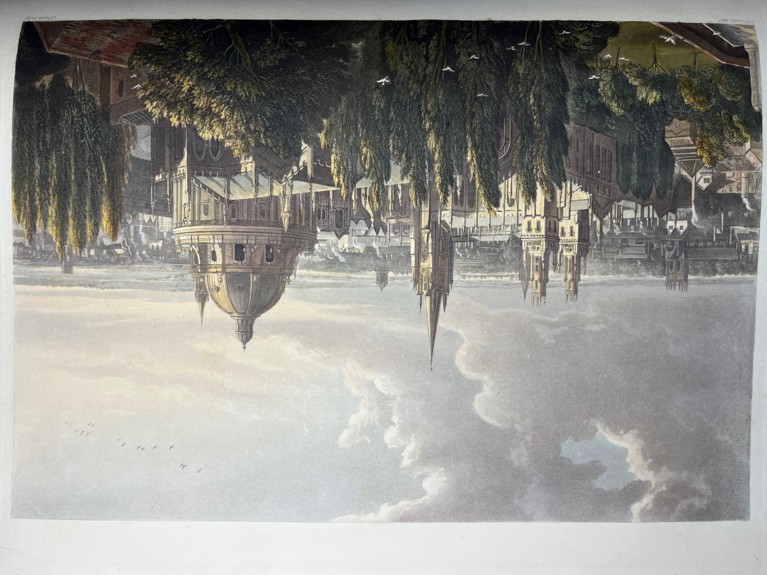
R. Ackermann, History of the University of Oxford (1814), ‘View of Oxford, taken from New College Tower’
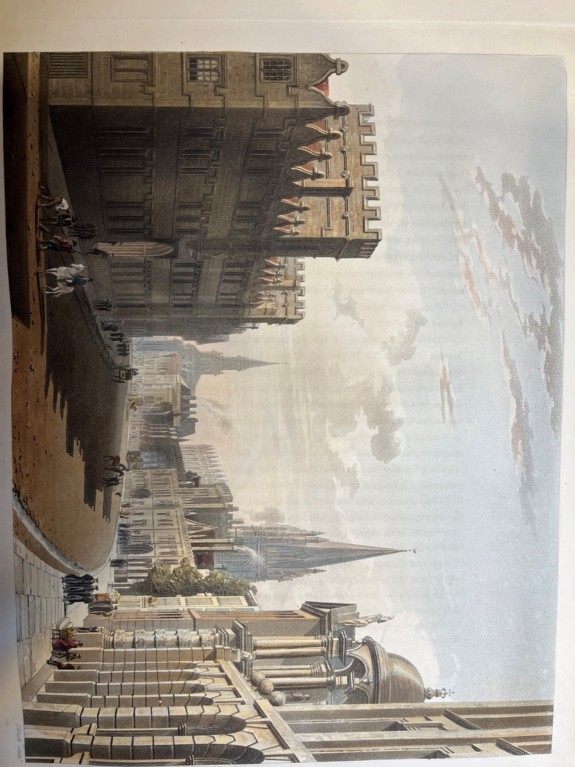
‘Oxford, High Street, Looking West’
After an early career as a coach-builder and designer in Germany, Ackermann arrived in London in 1787, initially to pursue the same business. But by 1797 Ackermann had opened ‘The Repository of Arts’, a shop in the Strand famous in its day for pictures, prints, illustrated books, as well as paper, paints and artists’ materials aimed at the burgeoning market of amateur artists. These elegant premises became a fashionable haunt for those who wanted to be seen to have sophisticated tastes, not only in art but in fashion and décor. Tea and lectures were available. From 1809 Ackerman published a monthly magazine, The Repository of Arts, Literature, Commerce, Manufactures, Fashion and Politics, full of articles and illustrations of fashion, furniture and social news. During its twenty-year run, The Repository published over 1400 hand-coloured plates. The fashion plates, sometimes with dress-making patterns, were immensely influential on women readers.
From publishing prints there was a logic in Ackermann’s move into publishing illustrated books, such as his sumptuous three-volume Microcosm of London (1808-1810), containing 104 hand-coloured aquatints, with outside and inside scenes of London landmarks and institutions. The plates are often revealing of current social practices, such as visitors to an exhibition of watercolours, or a ‘speech day’ event at the Blue Coat School, where two scholars – known as ‘Grecians’ and destined for Oxford or Cambridge – were required to recite orations ‘in praise of this institution, one in Latin and the other in English’.
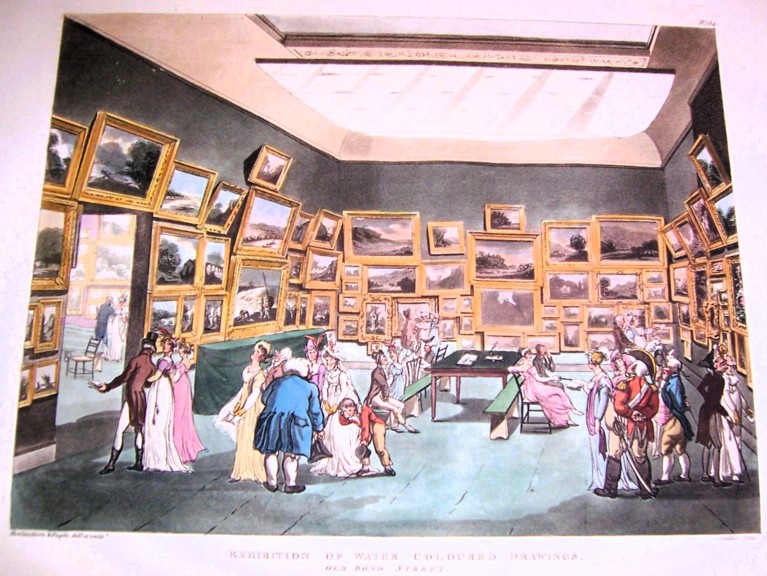
Microcosm of London (1808-1810), ‘Exhibition of the Society of Painters in Water Colour, Old Bond Street’
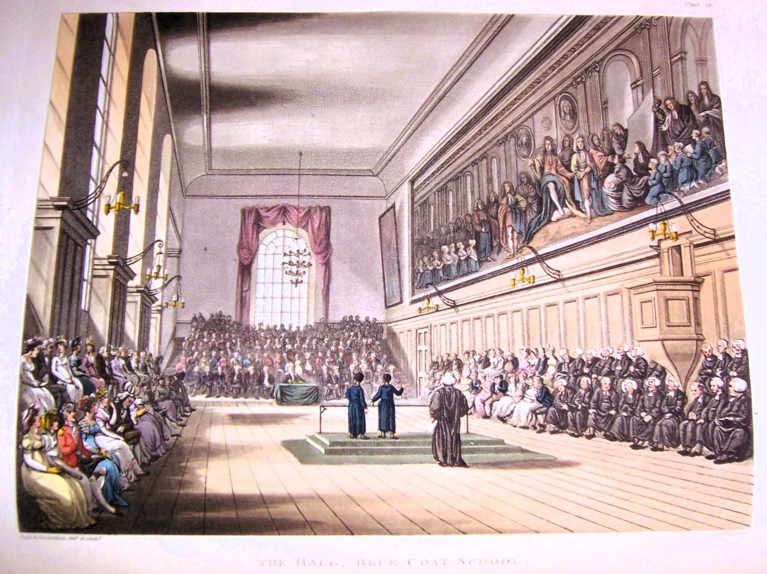
Microcosm, ‘The Great Hall, The Blue Coat School’
Like the Microcosm of London, Ackermann’s history of the public schools has a profusion of plates highlighting picturesque views of ancient buildings, so it is valuable that just one plate for each school actually provides a record of the educational process in these institutions, and a surprising one to modern eyes in terms of ‘class size’.
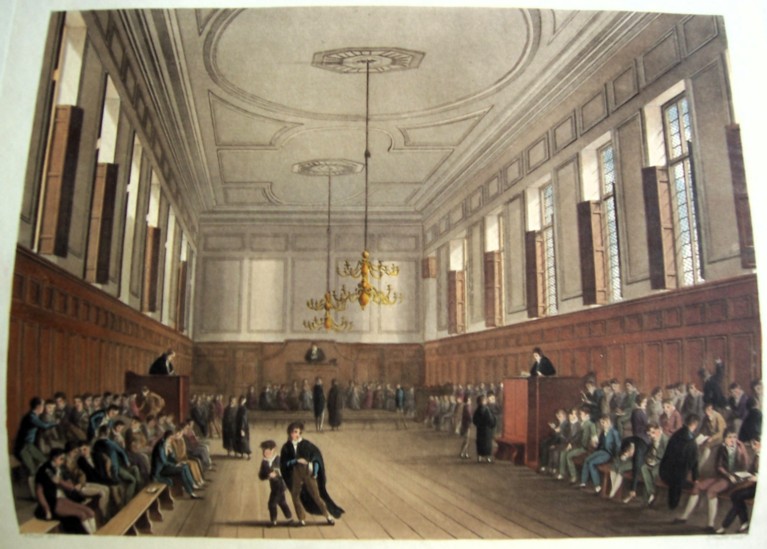
History of the Colleges of Winchester etc. (1816), ‘Eton College, School Hall’
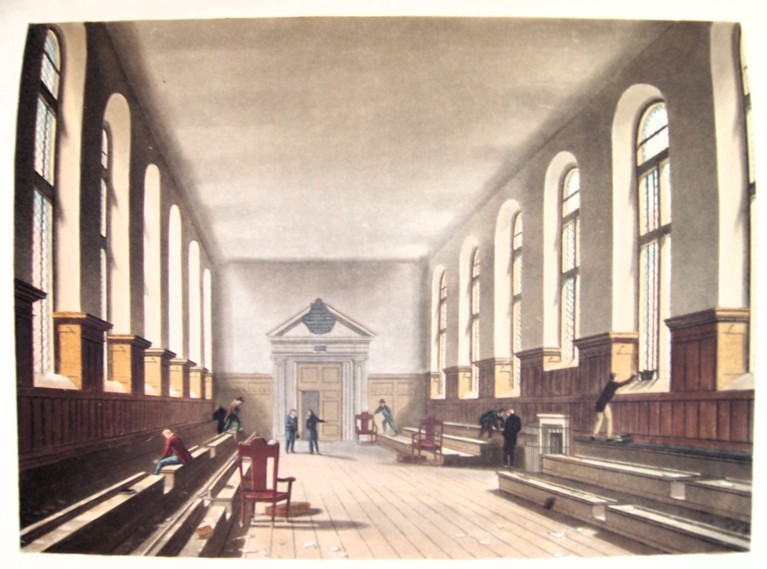
‘The Merchant Taylors’ School Room’
In each of the schools, the plates show instruction of large groups of pupils by a number of teachers taking place within one very large, hall-like room. The competing noise must have been both a distraction and perhaps a training in concentration.
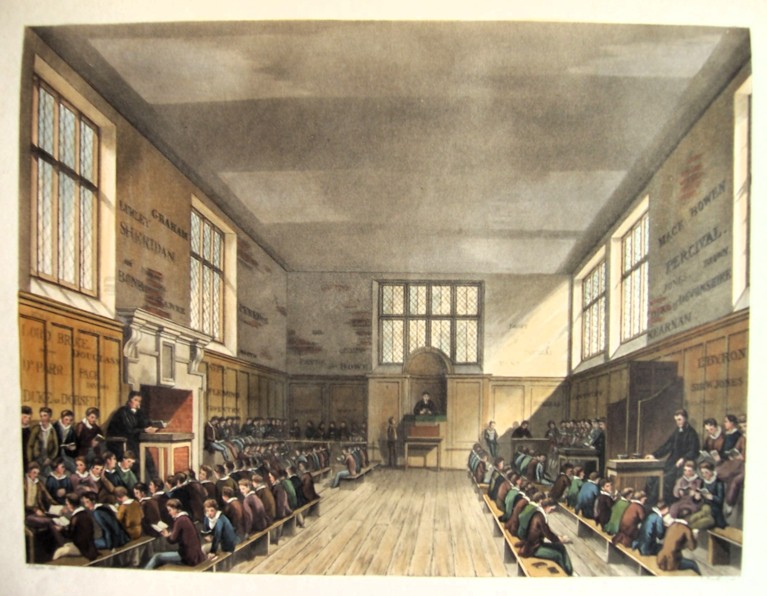
‘Harrow School Room’
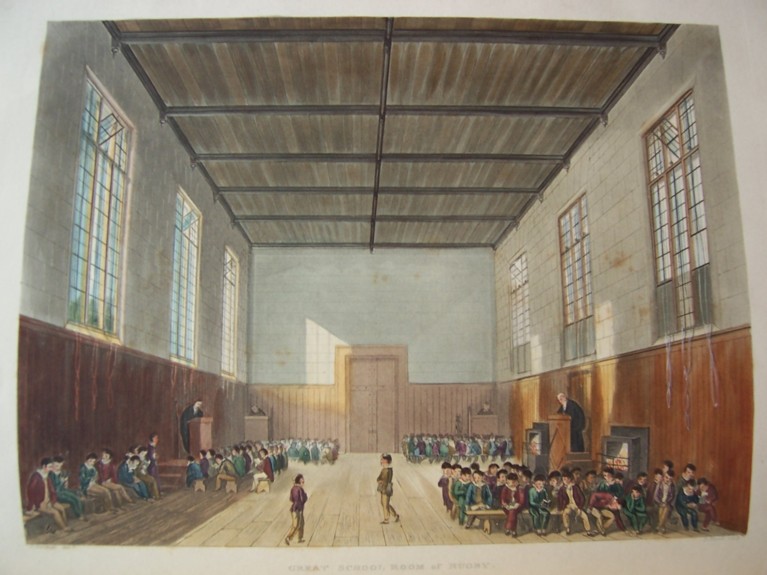
History of Rugby School (1816), ‘Great School Room’
With a sixth sense for trends, Ackermann also catered to the fashionable taste for appreciation of picturesque scenery, and for books that allowed the armchair traveller to view landscapes with picturesque qualities and their inhabitants (including the clans of the Highlands). He published armchair tours of the picturesque beauties of the Rhine, and the Seine, and the coast of Ireland.
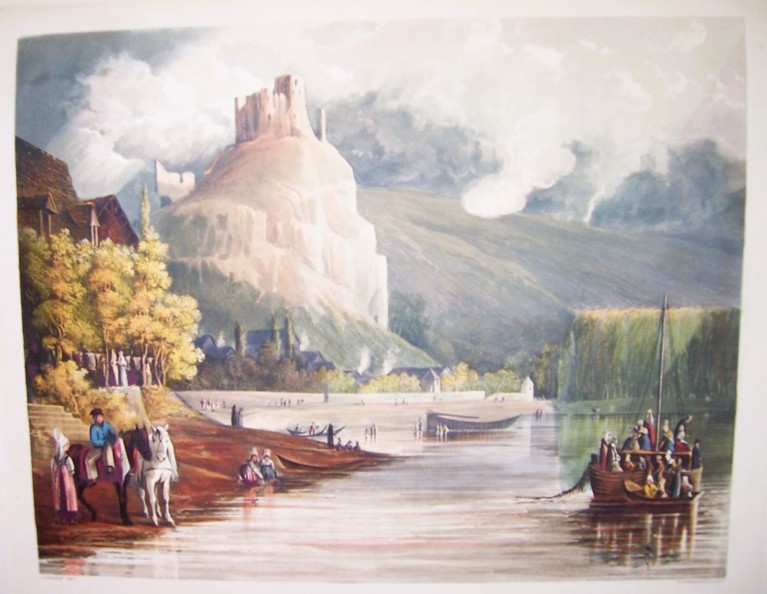
A Picturesque Tour of the Seine (1821), ‘Andeli’
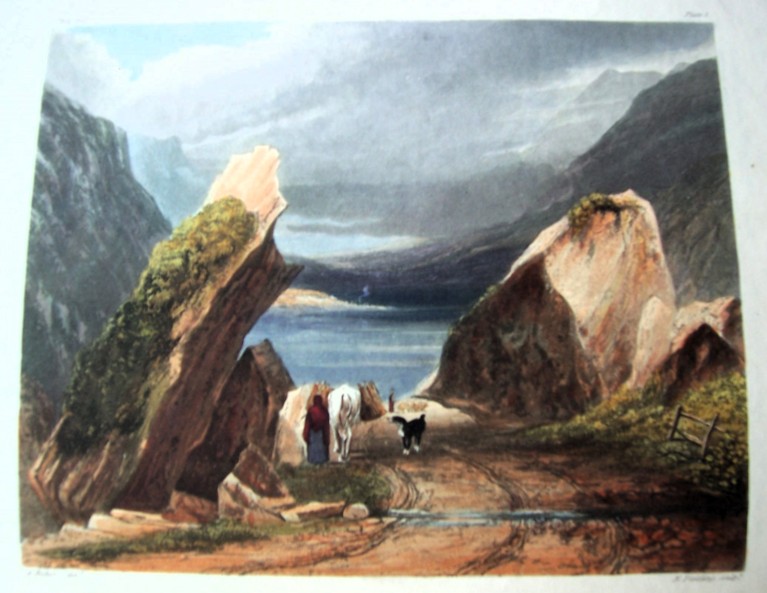
Illustrations of the Landscape and Coastal Scenery of Ireland (1835), ‘Gap of Dunloe, Killarney’
Further afield, Ackerman published a picturesque tour of the Ganges, and a history of Madeira with delightfully quirky illustrations.
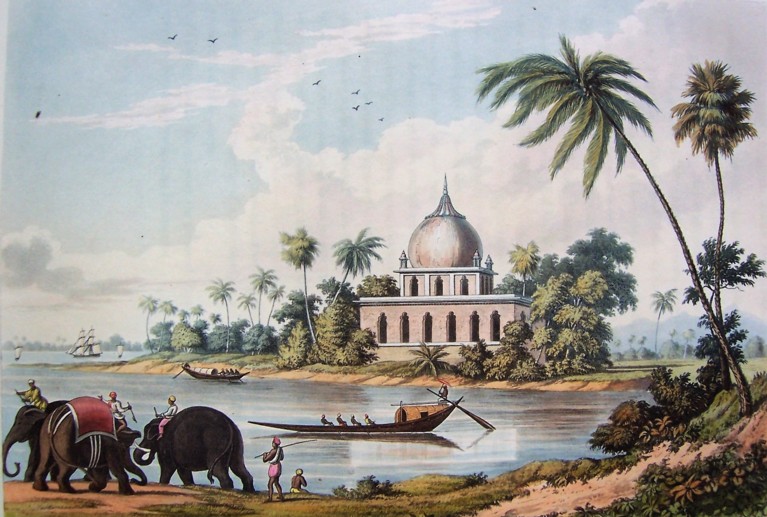
A Picturesque Tour along the Rivers Ganges and Jumna (1824)
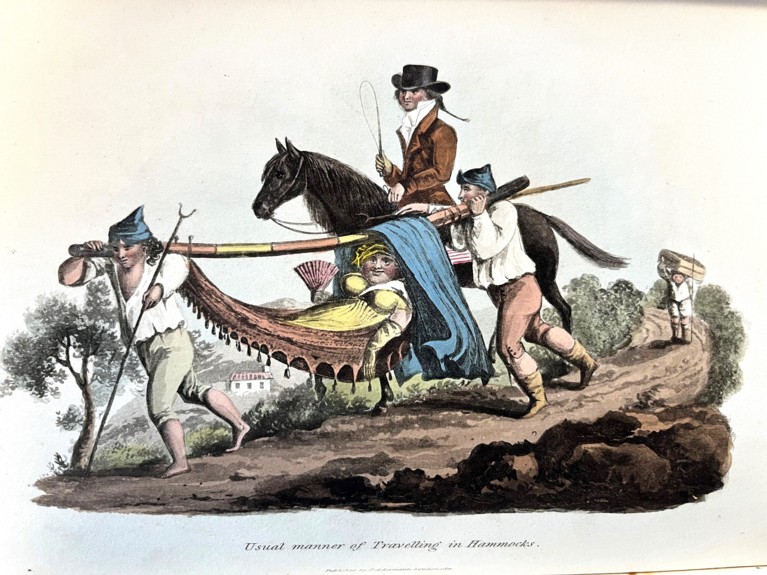
A History of Madeira (1821), Getting about on Madeira by Hammock-Mobile
In none of these books were the texts written, or the illustrations drawn, engraved or coloured by Ackerman himself, but he employed the best artists and engravers of the day. This included publishing the cutting political and satirical caricatures of Thomas Rowlandson, as well as the more fastidious genius of Augustus Pugin, whose book of idiosyncratic designs for furniture in the ‘Gothick’ taste was published by Ackermann. Always the innovator, Ackermann’s shop on the Strand was illuminated by gas lighting, on which Ackermann published a book, and his own promotion of gas lighting furthered its wider acceptance at the time.
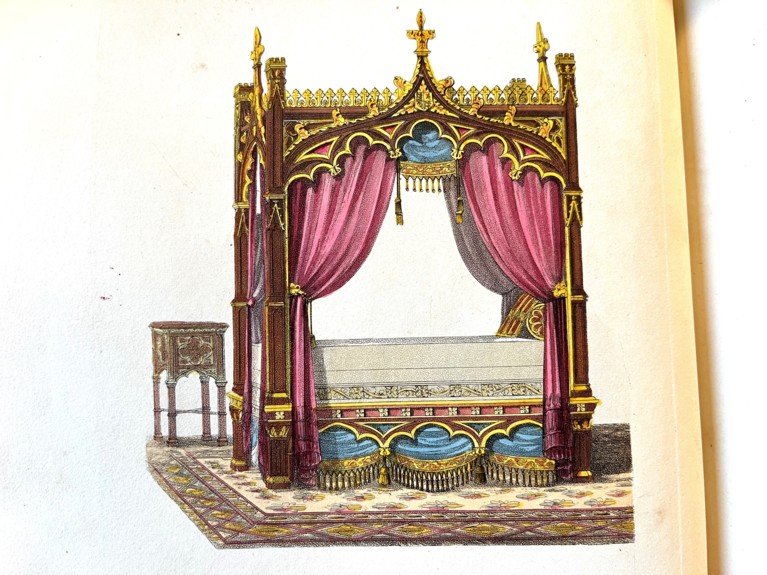
Augustus Pugin, Gothic Furniture, ‘Gothic Bed’
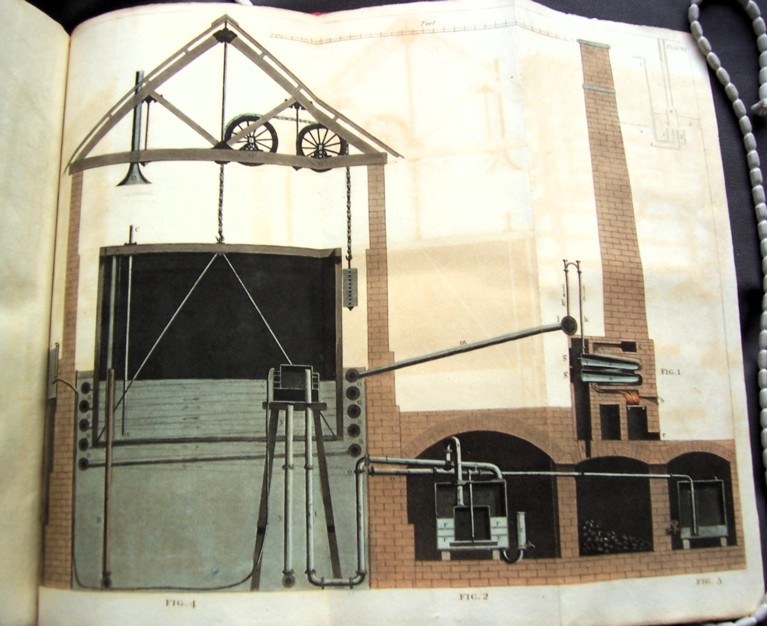
F. Accum, A Practical Treatise on Gas-Lighting (1816), illustrating gas-lighting machinery
He expanded into Latin America, where he supported the liberation movements, and published 100 books in Spanish (but this proved unprofitable and he burned his fingers). Perhaps akin to an obsession with cars in modern times, Ackermann’s engagement with carriage design never left him: in one year he designed both the carriage in which the Pope rode to Napoleon’s self-coronation as Emperor, and the elaborate hearse and the emblems on the coffin for the state funeral of Admiral Lord Nelson. With his inventiveness, his eye for design, and his sheer flair for business, Ackermann may be seen as a pioneer of modern publishing and illustration – and the fruits of that can be seen in the illustrated books in Emmanuel’s Graham Watson Collection that Ackermann and others published.
Barry Windeatt, Keeper of Rare Books
Images: Clare Chippindale
31 January 2024
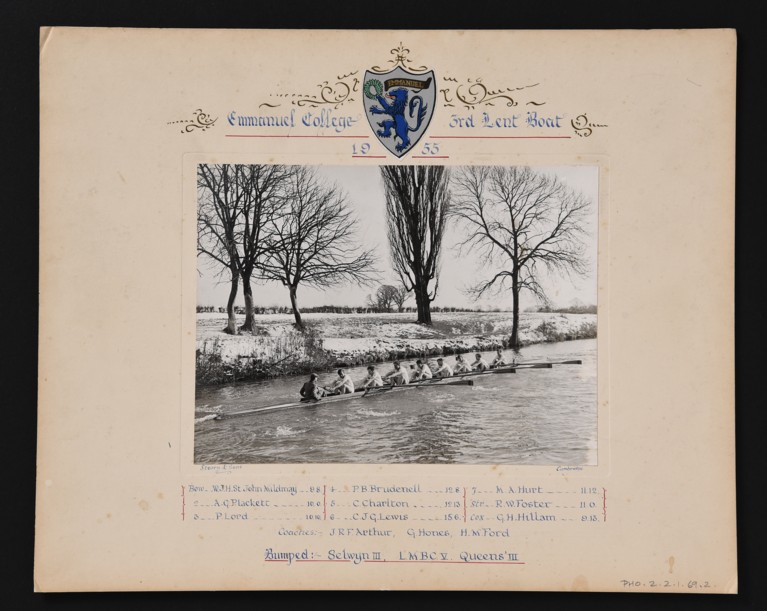 A snowy scene on the Cam in 1955, featuring the Emmanuel 3rd Boat
A snowy scene on the Cam in 1955, featuring the Emmanuel 3rd Boat
The recent blog featuring a photo of the Paddock after the Whitsun snowfall of 1891, prompted John Harding to recall the even more unseasonal snowstorm that swept over Cambridge in the first week of June, 1976. This event was fixed in his memory as he was due to perform in outdoor theatricals at Clare College. It was a case of ‘the show must go on’, despite the perishing cold and consequent meagre (but not, as the cast had hoped, completely non-existent) audiences.
For Cambridge students, snow and ice caused only the usual problems before the mid-nineteenth century: travel difficulties and the risk of catching chills. Once sport became a feature of student life, however, a new dimension of anxiety was born. The Emmanuel College Magazine, which began in 1889, contains annual reports from the Emma sporting clubs, many of them lamenting the effects of icy weather. In Lent Term 1898, for instance, rain and sleet blighted an athletics club fixture involving Hertford College, Oxford, and a similar competition against Brasenose in 1906 had to be cancelled altogether ‘owing to snow’.
Rowing was perhaps the sport most vulnerable to severe winter weather. The Emmanuel boat club report for Lent Term 1895 informed readers that after the Cam had frozen in early February, no rowing was possible for a ‘full fortnight’ and the bumps were subsequently cancelled. The weather in Lent Term 1910 was equally frigid, as noted in the diary of Winthrop Bell, a graduate student from Nova Scotia, who rowed in the college’s 2nd boat. He paints a vivid picture of the miseries, and in his case, dangerous consequences, of winter boating. In late January the oars were ‘frozen’ and there was ‘Ice on river – solid below Ditton’. The weather continued ‘wretched’, and in February Winthrop developed pleurisy. After having several pints of fluid drained from his lungs, a ‘rather nasty job’, he quit Cambridge on medical advice, and transferred to a German university.
.jpg) Skating on the Paddock pond, January 1926
Skating on the Paddock pond, January 1926
The silver lining of sub-zero temperatures, of course, is that ice-skating becomes possible. A photo showing skaters on the Paddock pond in January 1926 would give a modern health & safety officer a conniption, as Emmanuel’s resident pair of swans (who no doubt took a dim view of the proceedings) can be seen swimming on open water near the pond outfall, an indication that the ice was not very thick. Another patch of slushy water is visible against the northern bank, with sweepers standing perilously close. The ‘severe frost’ that produced these conditions prevented any rowing practice and curtailed the Emmanuel golf club’s activities, as noted in the Magazine. A cold snap in 1942 resulted in stretches of water at the Milton sewage works freezing solid. This attracted many keen skaters, including Charles Gimingham, a first year-Nat Sci student at Emmanuel, who recorded in his diary for 17 January: ‘…grand piece of ice…hundreds of people - but room for them all. Major crisis when one’s skates heel slipped and I bust a bolt fitting it - But half hour experimentation on the bank fixed it and the rest was grand.’
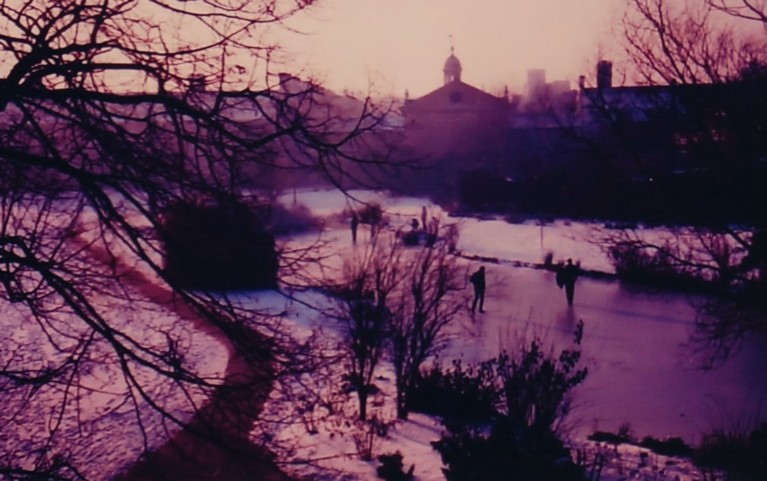 Ice on the pond, 1981-2, © Sarah Gill
Ice on the pond, 1981-2, © Sarah Gill
A spell of bad weather towards the end of Michaelmas Term 1980 forced the boat club crews to row during ‘blizzards’ while competing in the Clare Novices. The winter of 1981-82 was much worse, and it is very surprising that the sporting clubs’ reports in the Magazine make no mention of the prolonged snowy and icy conditions. An atmospheric photograph taken that winter by Sarah Gill (née Doole), shows several people skating, or at any rate shuffling, on the frozen Paddock pond at dusk.
Amanda Goode, College Archivist
20 December 2023
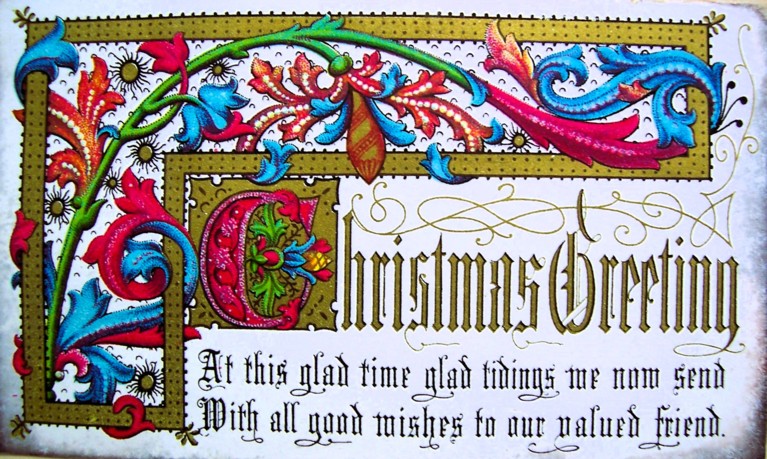
In some fascinating Victorian scrap-books kindly presented to Emmanuel Library by Hugh Pearson (matric. 1987) there are mementos of travels in the form of prints of stately homes (Chatsworth, Goodwood, Lowther, Trentham) and of various foreign resorts (in France, Italy, the Rhine) that have been carefully stuck on to the album pages. There is also a collection of recipes that rather implies the compiler’s single-minded devotion to the traditional British pudding and its tastes and ingredients (with never a mention of chocolate). And there are Christmas and New Year cards, probably from the 1870s onwards, arranged and fastened on the scrapbook pages. All these cards are modest in size (often 10 x 8 cms), on a single flimsy piece of paper: they are not folded cards that stand up. There was a fashion for these greetings to be surrounded by paper borders pierced and patterned to resemble lace.
The familiar iconography of Christmas is already established here. There are snowscapes bristling with holly and holly berries, and robins are ubiquitous and unavoidable.
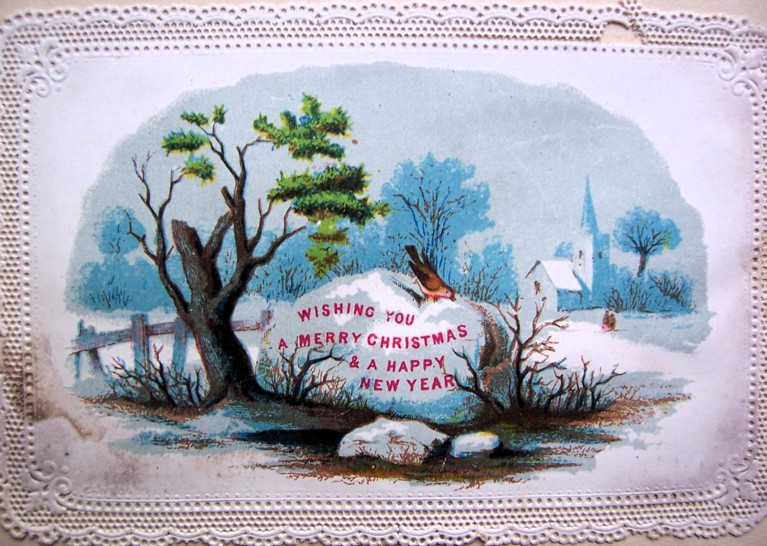
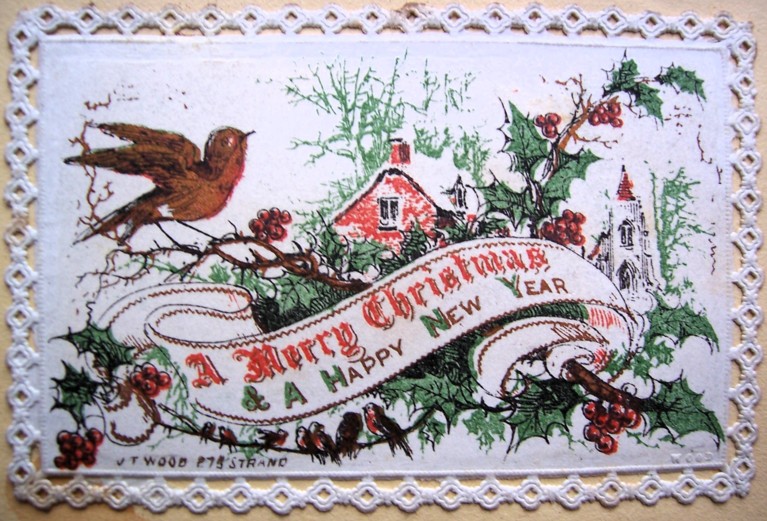
So much of this is still going strong today, and it is usually claimed that it was the Prince Consort who, by introducing various German Christmas customs into the Royal Family’s Christmas, thereby caused those customs to become fashionable, imitated, and duly established in the British Christmas. Those readers of this Victorian scrapbook who enjoyed looking back over the collection of past Christmas cards might also enjoy the ‘Prince Albert Pudding’ for which the album supplies a recipe. Note that, like many of the pudding recipes compiled in the scrapbook, this does entail a serious amount of boiling.
Prince Albert Pudding
½lb (half a pound) of flour; ½lb of butter; beat up well ½lb of loaf sugar sifted, ½lb of raisins chopped fine, 5 eggs, the whites whipped to a stiff froth, a little candied lemon peel.
Steam it 3 hours. Served up with custard sauce.
Some of the Christmas and New Year cards largely consist of some lines of rhymed seasonal greetings, with the text displayed in an ornamental border. The greetings tend to the earnest and uneffusive.
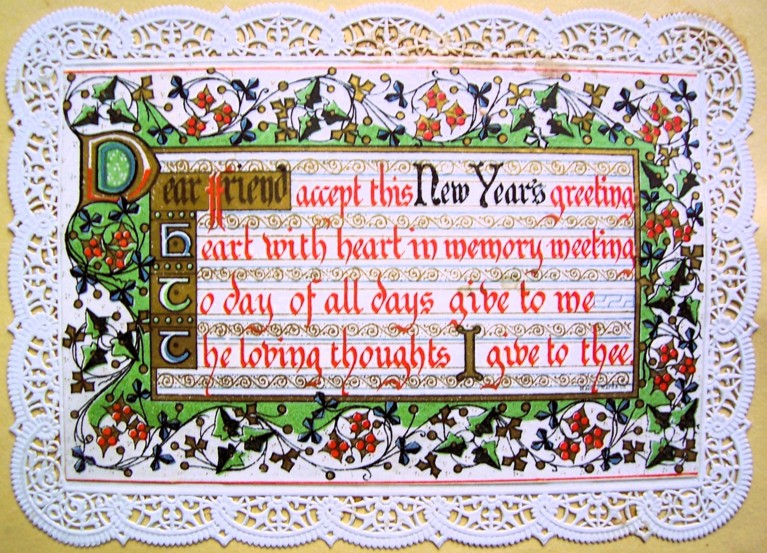
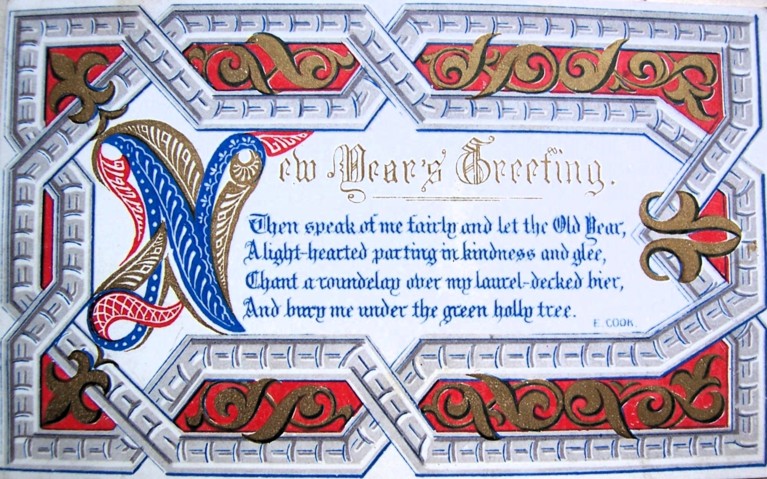
Those high-minded Victorians who sent and appreciated receiving such greetings cards might also appreciate the sobering implications of ‘Half-Pay Pudding’, for which the scrapbook’s recipe rules out all light nonsense but the essentials.
Half-Pay Pudding
¼lb of raisins, ¼lb of currants, ¼lb of chopped suet, ¼lb of flour, ¼lb of breadcrumbs, ¼lb of sugar. Pinch of salt. Without eggs. Boil for 4 hours.
Many cards feature a lift-up flap, where part of the design is hinged to lift up and reveal a Christmas or New Year greeting printed underneath.
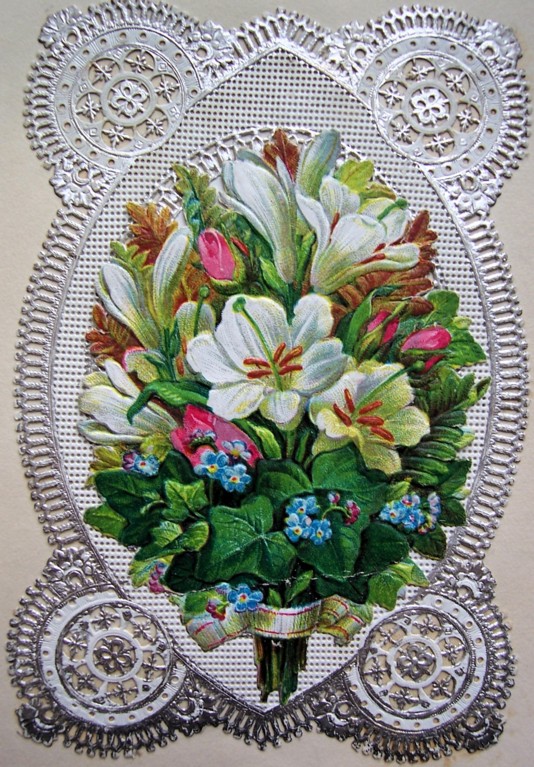
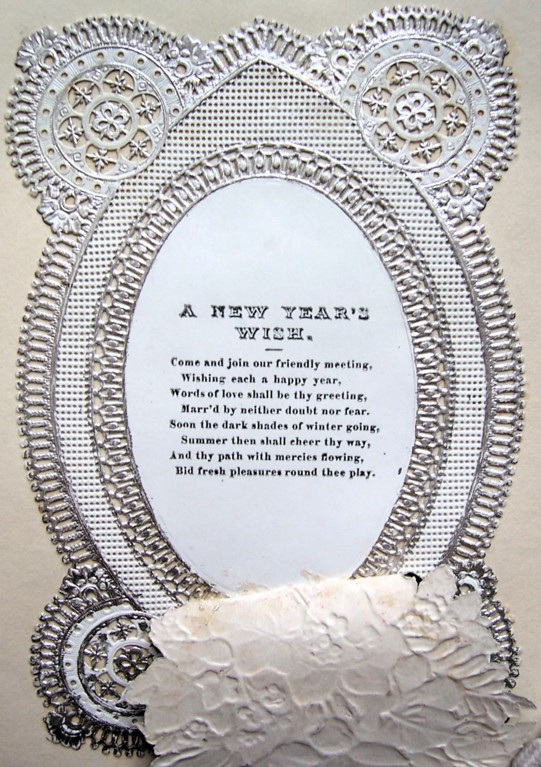
But at least in the selection preserved by this scrapbook, references to the Christian significance of Christmas are understated or absent altogether, and this example is an exception.
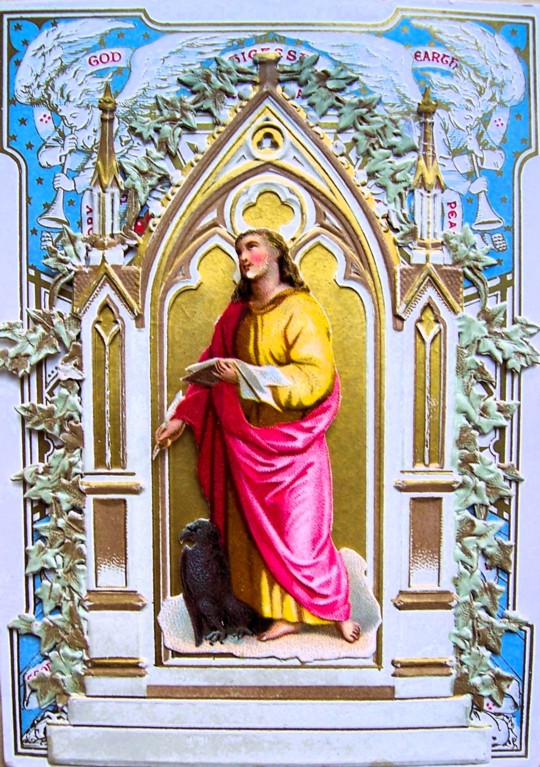
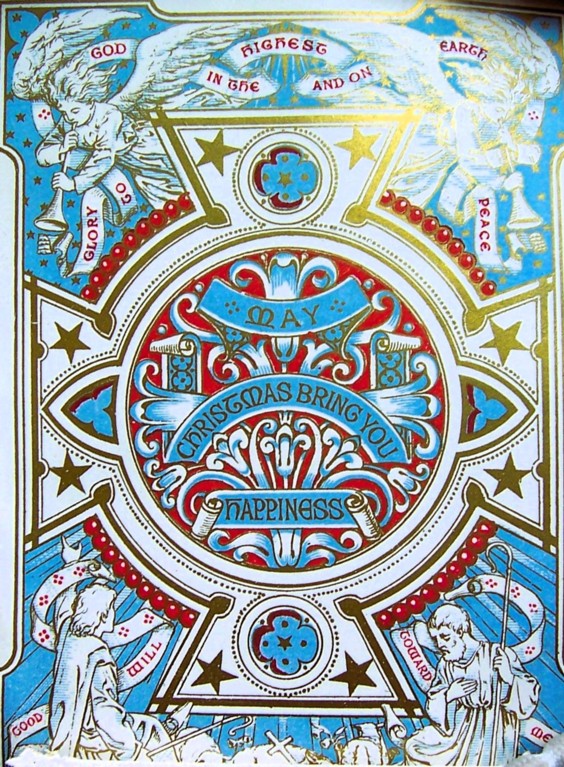
The figure of the evangelist, holding book and quill, lifts up to reveal underneath an intricate design of text and ornament, where the Gospel text of the message from the angels (above) to the shepherds (below) appears in red text on ribbons woven clockwise into the design. The makers of this scrapbook who also preserved a recipe for ‘Paradise Pudding’ seem intent on catering to a more material experience of heavenly sweetness.
Paradise Pudding
Six oz (ounces) of breadcrumbs, six oz of sugar, six oz of currants, six apples grated, six oz of butter beaten to a cream, six eggs, a little lemon peel chopped, and nutmeg.
Boil in a shape, 3 hours. Serve with wine sauce.
As with Christmas cards today, depictions of wintry scenes on Victorian cards are implicitly celebrating Christmas as a refuge and respite from mid-winter cold, as in this sentimental snow-scene of small children warming themselves around a rustic’s blazing fire – a flap is hinged to lift up and reveal a Christmas greeting underneath.
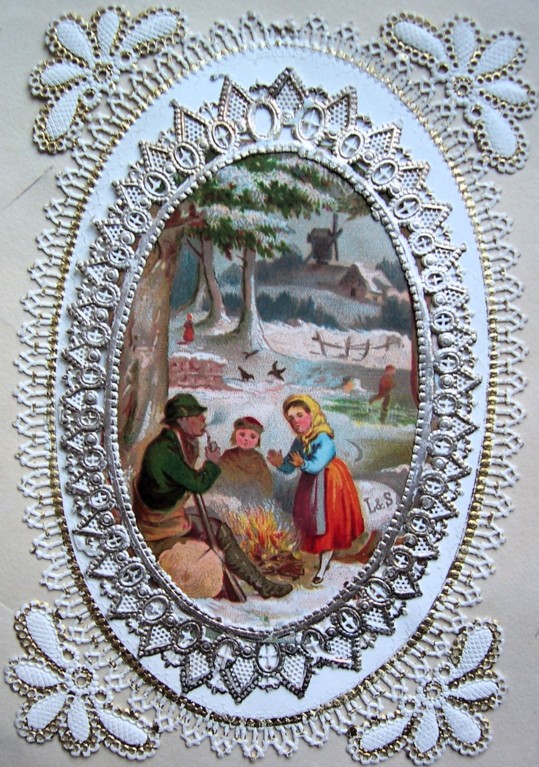

Feasting at mid-winter on rich foods was a traditional defiance of the time of least light, most gloom, and dismal cold. The scrapbook includes no fewer than three different recipes for Christmas pudding, attributed to Mrs Bond, Mrs Fendall, and Mrs Sutton.
Mrs Sutton’s Christmas Pudding 1879
Chop very fine, 1½lb of suet, 2lb of raisins, 1lb of currants; 1lb of flour; ½lb of mixed peel; ½lb of moist sugar; ¼lb of breadcrumbs; 2 Captain biscuits grated; 1 rind of lemon grated; 1 tablespoon of mixed spice; 1 teaspoon of salt; 6 eggs. Mix with ½ pint of milk and a large glass of brandy. Boil for 6 hours.
There are predictably different twists on ingredients and quantities, with Mrs Fendall adding sultanas, chopped apples, orange peel, chopped almonds and making it two glasses of brandy as well as one of sherry. The recipes also differ over their recommended boiling times, which range between five and eight hours.
One curious aspect to us of these Victorian greeting cards is that there are almost as many New Year cards as Christmas cards in the collection – whereas sending a separate New Year card has become rather unusual – and that so many of the cards are not ‘Christmassy’ at all but feature posies of flowers.
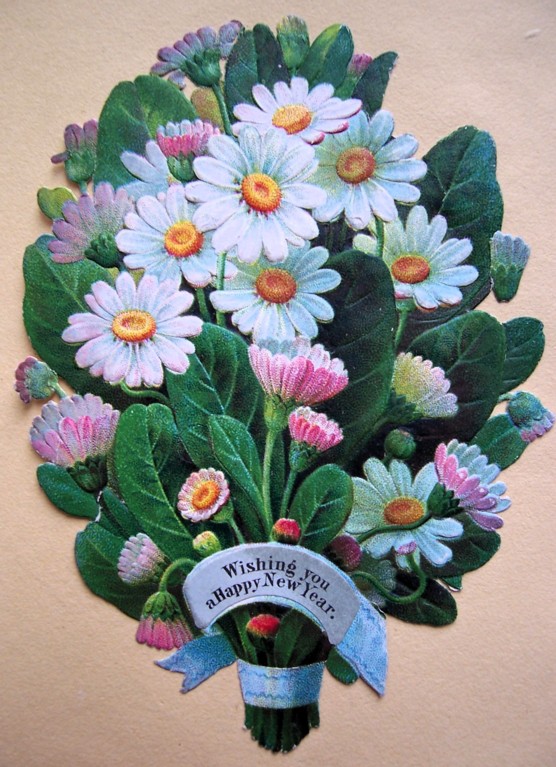
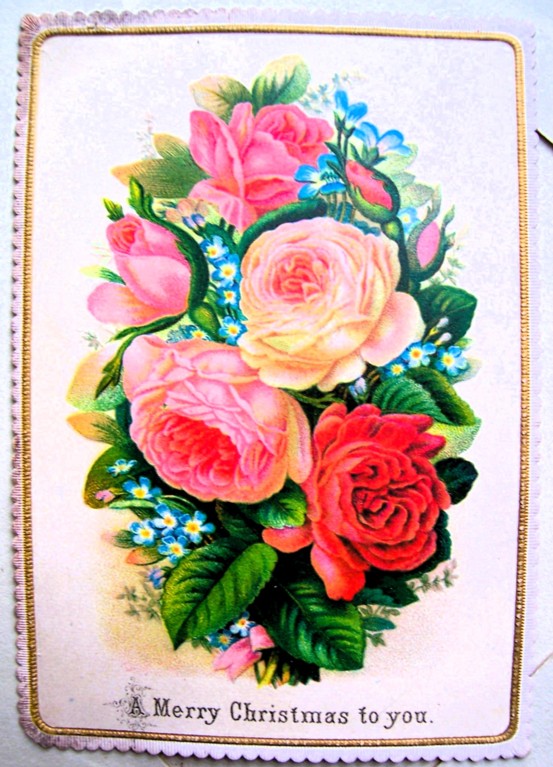
But there was a whole language of meanings expressed through flowers and depictions of flowers, a language now barely remembered. The readers of this scrapbook who enjoyed the sweet confection of ‘Princess Louise Pudding’ would not have been aware of the venturesome extramarital love-life of Queen Victoria’s artist daughter, Princess Louise.
Princess Louise Pudding
1 pint of milk poured over ½ pint of grated bread, the rind of a lemon grated; 3 oz of sugar; the yolks of 2 eggs well beaten. Mix all well & bake in a pie dish for ¾ of an hour, then cover the top with a thin layer of jam. Whisk the whites of the eggs to a stiff froth with 3 oz of powdered loaf sugar, and the juice of ½ the lemon, and put over the jam. Bake 5 minutes.
But they evidently enjoyed the scrapbook page where a rose on a hinged flap lifts up to reveal the ringleted sweetheart underneath.
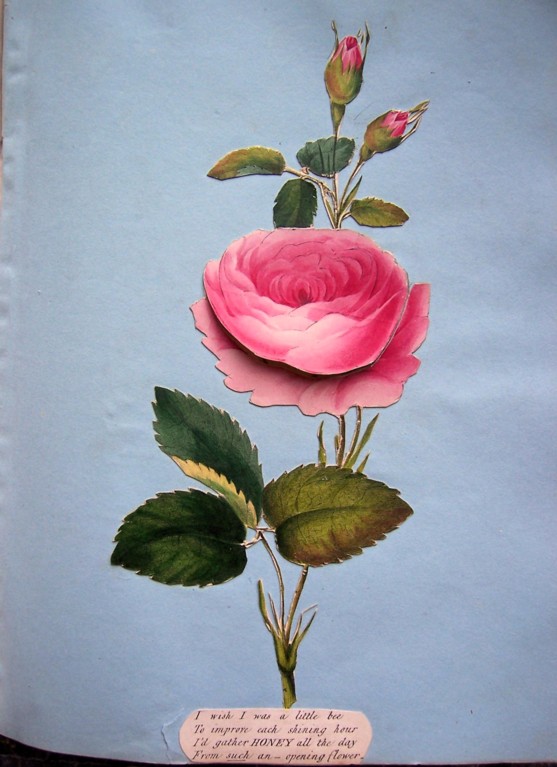
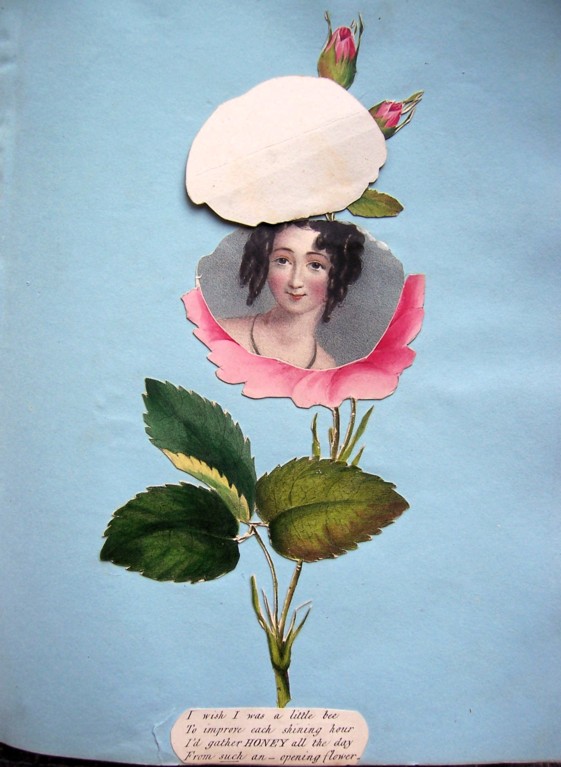
The verse below reads: I wish I were a little bee, | To improve each shining hour. | I’d gather HONEY all the day | From such an … opening flower’.
A merry Christmas and a happy new year to all our readers! Very best wishes also to Dr Helen Carron, who has produced all the images for these blogs since their inception during the first lockdown, and who retires this month as College Librarian after 26 years of devoted service to the College Library and to generations of its student users.
Barry Windeatt, Keeper of Rare Books
20 December 2023
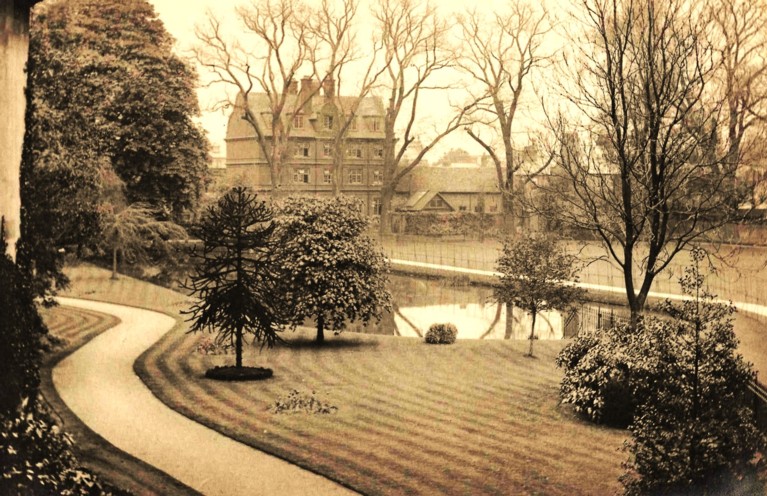 View of the College Gardens, 1891
View of the College Gardens, 1891
This intriguing photograph, showing the Paddock under a fairly substantial dusting of snow, bears a one-word endorsement: ‘1891’. It might be supposed, then, that it was taken either in the very cold January of that year, or else in early March, when many parts of England suffered exceptionally severe blizzards. On closer inspection, it is apparent that the photo must date from much later in the year.
For one thing, the striped lawn indicates very recent mowing, which is not a normal feature of winter or early spring horticulture. For another, several circular beds of flowering tulips are visible. The deciduous tree to the left of the pond, moreover, is in full leaf, accompanied by what looks like blossom. A 1937 tree-plan of the college grounds identifies it as a horse chestnut, which normally flowers in May. True, the elms in front of the Hostel are still bare, but that tree comes into leaf rather late.
Meteorological records show that after an extremely warm spell in early May 1891, a sudden and dramatic change in the weather pattern resulted in snow and hailstorms afflicting much of the country on the 17th of that month (Whit Sunday). On the following day, eastern England experienced a particularly heavy fall of snow, some parts of Norfolk having as much as seven inches. A thaw set in within a day or two, so it can be safely assumed that this snowy photo of the Paddock was taken during the Whitsun weekend. The college sporting clubs’ reports in the 1891 Magazine make no mention of the mid-May snowfall, doubtless because of its brevity, but they do record that no rowing or football had been possible for much of January, ‘owing to the long spell of frost’.
The ‘Whitsun’ photographer may well have been Alfred Rose, Emmanuel’s Bursar, who was an enthusiastic amateur snapper. His plate-glass negatives, which are an invaluable visual record of the late-Victorian and Edwardian college, are preserved in the college archives. The photo is evidence that the freak Whitsuntide weather had taken Emmanuel’s residents by surprise, as many of the Hostel windows are wide open. Incidentally, the building adjoining the Hostel was the remaining portion of the straggling range of stables and outbuildings, including a coach house, that had for many years run along the college’s eastern boundary. The single-storey gabled projection is marked as ‘Engine’ on a plan of the college dated 1885, so it was presumably a boiler house; a coal yard was situated nearby. This building and the rest of the outhouses were all demolished in 1893, when the Hostel was extended.
It is interesting to note the steep drop of the ornate iron palings into the western end of the pond. Unlike the railings that ran along the Front Slips, they were not sacrificed to the war effort in the 1940s but remained in situ for another decade. The high fencing beside the path on the right of the pond is probably designed to deflect tennis balls, as the southern part of the Paddock was always marked out for lawn tennis in Easter Term. The protection provided by the fence was no doubt appreciated by the pair of swans that were the pond’s most important residents. The small white shape that can be seen near the pond outfall may be one of these birds. The monkey-puzzle tree, near the chapel, although appearing to be a youngish specimen in 1891, does not appear on the 1937 tree-plan, and the horse-chestnut tree, mentioned earlier, was felled in 1952. The fate of the elms needs no elaboration.
Amanda Goode, College Archivist
30 November 2023
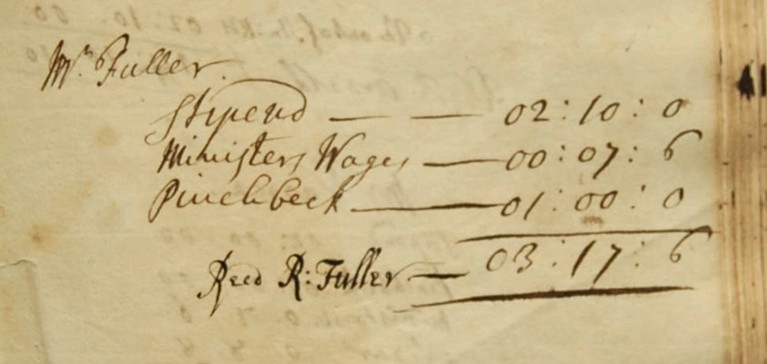
Robert Fuller signs for his final salary payment, October 1727
Emmanuel is almost unique among Cambridge colleges in having in its archives a disciplinary, or ‘admonition’ book, dating from the earliest days of the college. Most of the miscreants who feature in it are students, but two entries involve a college Fellow, the Revd Robert Fuller.
A native of King’s Lynn, Fuller was a graduate and, from 1719, Fellow of Emmanuel. He was ordained four years later. The first intimation of his contrariness is an entry in the admonition book dated 24th August 1725: Mr Fuller, Sen[ior] Fellow, & Dean of the College was Admonish’d by the Master in the presence of all the Fellows then in College for great offences that he was guilty of’. While it is startling to see a formal censure being applied to a member of the fellowship, the fact that Fuller was also dean does not exacerbate the scandal, as the office was held in annual rotation by Fellows who were in holy orders.
What might Fuller’s unspecified offences have been? He was frequently absent from college, as the exeat book attests, although his trips were generally of short duration. In the early years of his fellowship he preached regularly at Holy Communion services in Emmanuel’s chapel, but ceased to do so in May 1725 - doubtless evidence of a deteriorating situation. In February 1726, six months after Fuller’s first admonition, the college passed an order that ‘whoever misses his turn of visiting as appointed by the Dean shall forfeit the sum of five shillings to be deducted out of his stipend… and applied to the use of the Poors Bag’. Two months later, Fuller was fined under the terms of this somewhat opaque order.
Matters finally came to a head on 11 November 1726, when Fuller was summoned to ‘appear before the Master & Senior Fellows & Dean, and the Master proceeded to Admonish him for his irregular behavior & notorious neglect of duty. Upon this Admonition, he behav’d himself in a very insolent outrageous manner: & upon the Master’s testimony that he admonished him according to the direction of the statutes; he reply’d A fart for your Admonition & used other contemptuous language’.
Following this unedifying scene, Fuller appears to have gone out of residence almost immediately. The college statutes laid down that a Fellow could be deprived of his office after two (unheeded) admonitions, but in the event Fuller jumped before he could be pushed. A curt entry in the exeat book records that in June 1727 his name was ‘cut out’, a marginal note adding: ‘Marry’d June 11th 1727’. As Fellowships were forfeited upon marriage, Fuller’s college career was thus abruptly terminated. He returned to Emmanuel to collect his final instalment of wages at the Michaelmas 1727 audit, and doubtless never set foot in the place again.
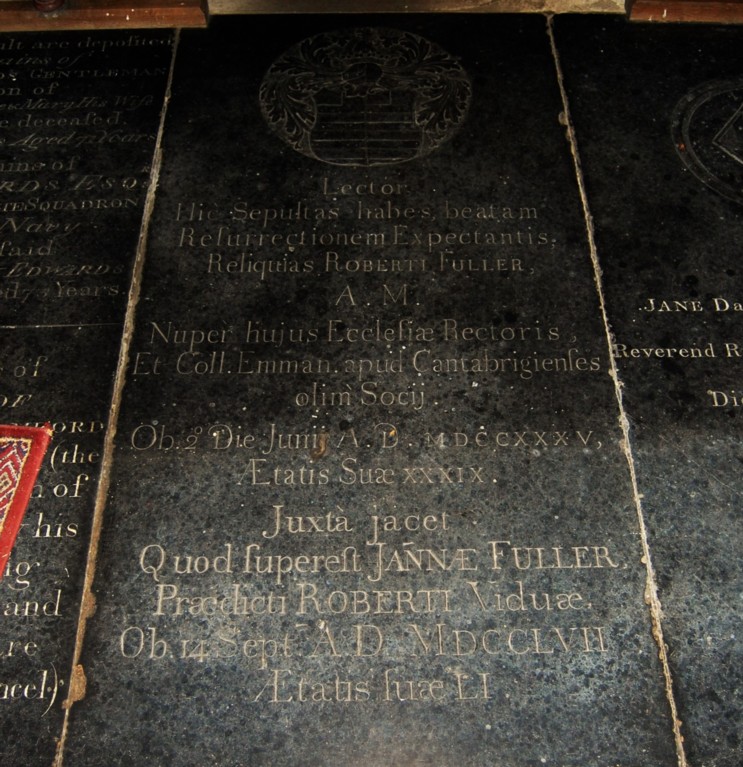 Robert Fuller’s armigerous gravestone
Robert Fuller’s armigerous gravestone
What Fuller did for the next few years is unknown, but in June 1732 he was appointed Rector of Water Newton, Huntingdonshire. He died there some three years later, aged 39, and was buried in the chancel of the church. His gravestone records that he was formerly a Fellow of Emmanuel. Jane, his widow, shares his grave, and their daughter and ‘heiress’ Jane, who died in 1805, lies next to them. There are also nearby memorials to two other probable daughters of Robert and Jane: Easter Fuller (d.1759) and Mary Edwards, nee Fuller (d. 1801). It is to be hoped that the Revd Robert conducted himself in a more seemly fashion at Water Newton than was the case at Emmanuel – although it would be fascinating to know his side of the story!
Amanda Goode, College Archivist
30 November 2023
The garden team have endured an extremely wet and mild autumn so far. The mild temperatures have meant that the leaves are still hanging on the trees, meaning that the team are playing catch-up this year.
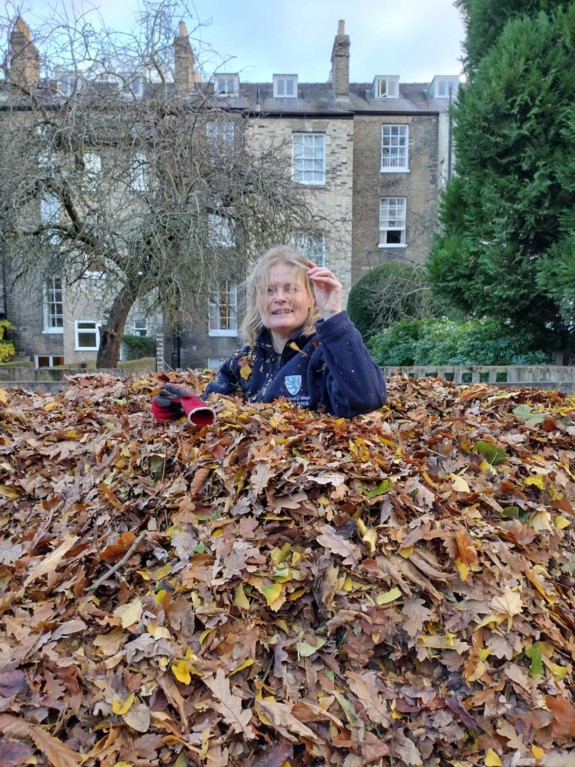
Leaf clearing is always the biggest task of the year for the team; it usually takes about three months of solid clearing to get the job done. Many leaves that we collect are then composted on site. The ability to be able to compost debris is a fantastic way of gardening sustainably. The more we compost on site means the less we must pay to be taken off site. The more composting we do, the less compost we must buy later.
The garden team can produce our own blend of compost to be used in the greenhouse for growing our plants and seedlings. We can also produce enough compost to dig back into the borders and to use as a mulch to feed our trees with. In turn, this reduces the need for artificial fertilisers and gives us a much more organic approach to gardening. Are the months of hard work worth it? We think so.
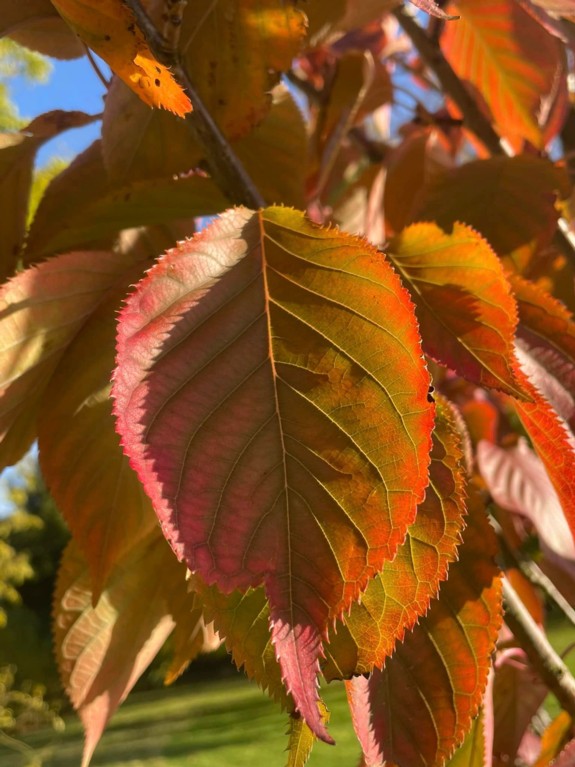
The beauty, though, of working in the gardens at this time of year is the wonderful autumn colours of the leaves. On a clear and sunny day, the leaf colours pop. The ginkgo tree in the Fellows’ Garden gives off a wonderful golden hue in the late afternoon sunshine. This is something that I can see daily from my office daily. What a treat!
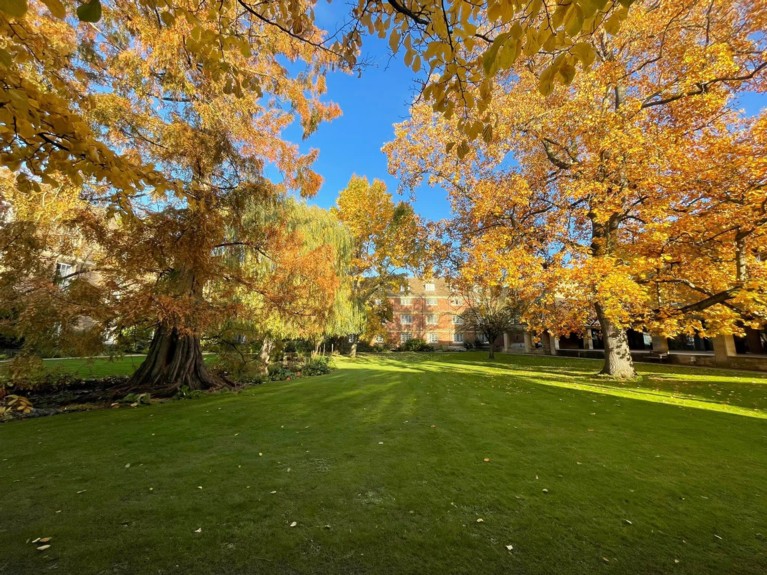
Other areas of beauty include Chapman’s Garden. The colours from the Dawn Redwood, the tulip tree and the sweet gum tree looked magnificent. The Oriental plane tree in the Fellows’ Garden is always the last to fall. We will still be clearing the leaves on that right up to Christmas, and maybe beyond.
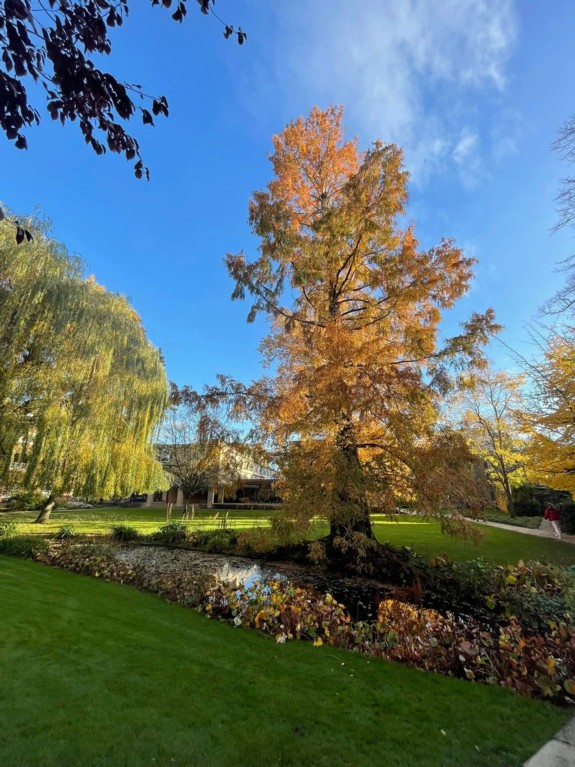
The Head Groundsman at the sports ground, along with myself, took delivery of a new piece of machinery recently. The college purchased a new Verti drainer to enable us to aerate all the college grounds and lawns. This should help improve the drainage and allow for better grass root growth in general. This is something that will hopefully help us return tennis to the paddock in the future.
Other jobs over the past month have included bulb planting, with additional shrub planting under the walnut tree by the library entrance. As a result of less traffic in the library car park, we were able to plant extra plants to tidy the area, hopefully without being driven over. This was the case in the past and hopefully the plants can correctly establish this time around.
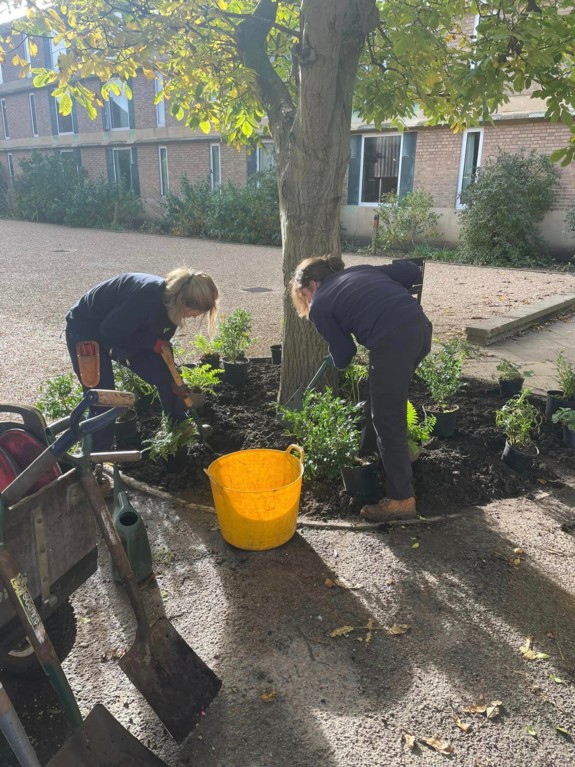
The main project on my mind now, though, is drawing up some plans for the proposed Community Garden at the rear gardens in Park Terrace. We are very much at the early stage of this project, which will enable students, Fellows and staff the opportunity to have a space to garden within the grounds for general well-being. Watch this space for more details in 2024.

Best wishes.
Brendon Sims, Head Gardener
1 November 2023
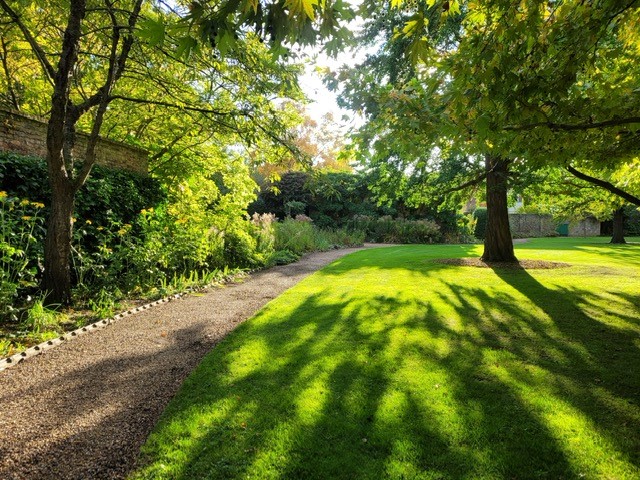
October came and went in a flash. Although technically autumn, the temperatures remain mild compared with the average temperatures for this time of year. October also saw some significant rainfall. Although it wasn’t a consistently wet month, the rainfall, when it did come, was extreme.
It has felt that the gardening calendar year has been having a go at redressing the balance from the drought year of 2022. The grass (and weeds) has continued to grow and the window boxes that were put out in May continue to flourish with the bright pink flowers. It has been a funny year but a welcome one.
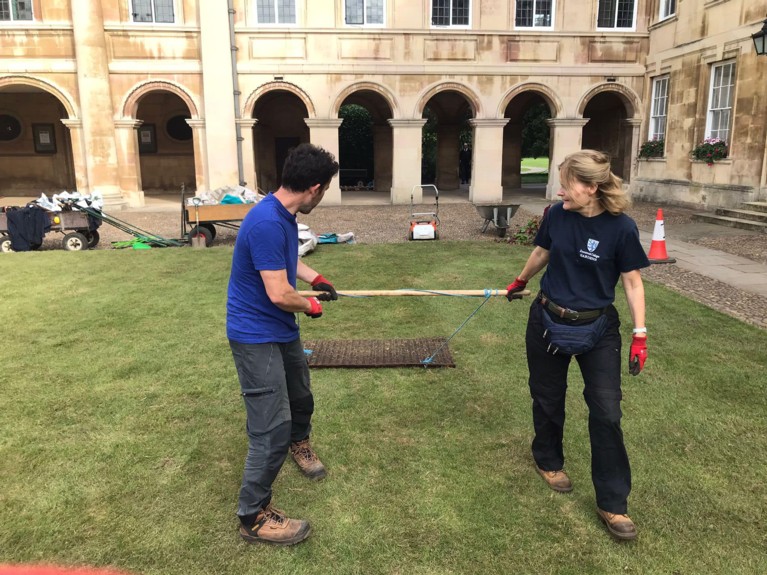
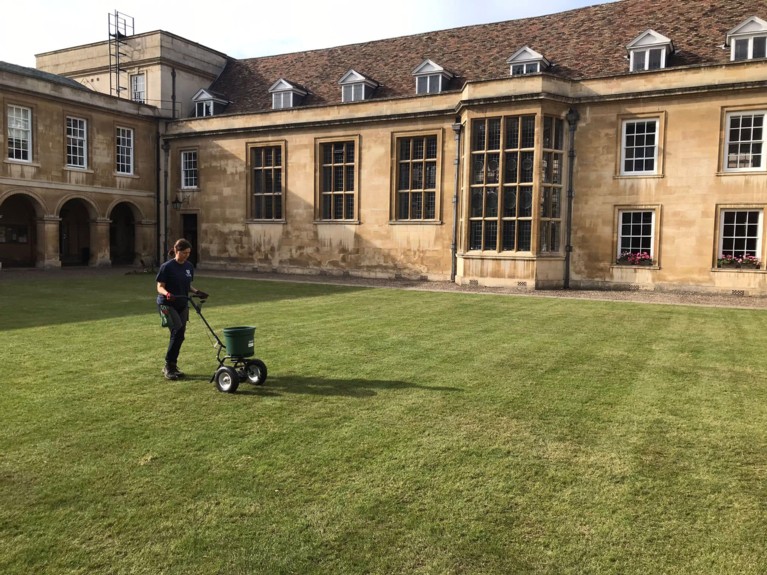
October is a time when it is perfect for major lawn renovation. This month sees the Front Court lawn undertake some needed TLC. It is the month that the whole team ascend the Front Court lawn to scarify, top dress, aerate and re-seed the lawn. I am always amazed at how much thatch (dead and living material that lies between the soil and the top level of the grass shoots) is removed from the lawn. A scarifying machine is passed over the lawn to remove the thatch in multiple directions and rakes out several cubic meters of debris. The process allows for better drainage. The team also aerates the lawn to relieve compaction from the summer months before top dressing with a sand/loam mix. The top dressing is distributed and levelled before the final task is to overseed.
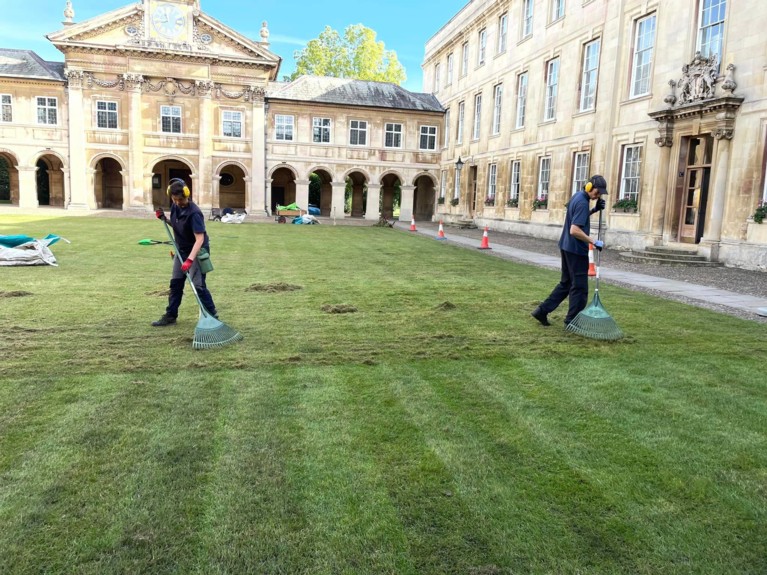
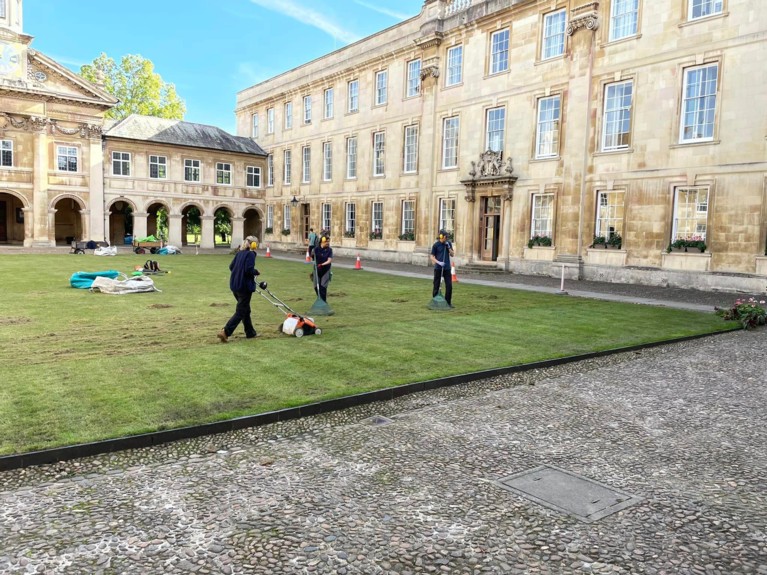
The final appearance always looks extremely harsh, but the lawns soon bounce back to good health. It will need a few weeks to recover before we add organic fertiliser to help carry the lawn through the harsh winter months until the spring, when the grass will start racing away again.
October has also seen the department busy bulb planting for the spring bulbs. Most of our efforts have taken place on the new build planting beds. Front Court lawn quadrants have seen the amaranthus and geraniums replaced by the new tulip bulbs for the spring - we will be excited to see the results of our labour then.
September and October have also seen the Garden Team prepare the wildflower meadows for the spring. Extra yellow rattle and wildflower seeds have been sown in the Park Terrace meadows and the North Court meadows. Yellow rattle needs a period of harsh and cold weather to help with germination. The yellow rattle helps reduce the grass dominance and creates more space for other wildflowers to develop.
Our usual job of leaf clearing in October has been somewhat delayed this year. Due to the mild weather, the trees have been very happy to hold onto their leaves. The significant leaf drops tend to come after a heavy frost but, so far this year, we have only seen a one-night frost. Please spare a thought for our gardeners during this time of leafing season. We have many more weeks and months ahead of us, tirelessly repeating the monotonous task which is extremely hard work. Please give the team a smile and thank them if you see them. They will all appreciate a welcome comment.
This will be our task for the next few months ahead, although we do have some additional planting to look forward to (mainly in the new build areas) and, of course, some more bulb planting.
Best wishes.
Brendon Sims, Head Gardener
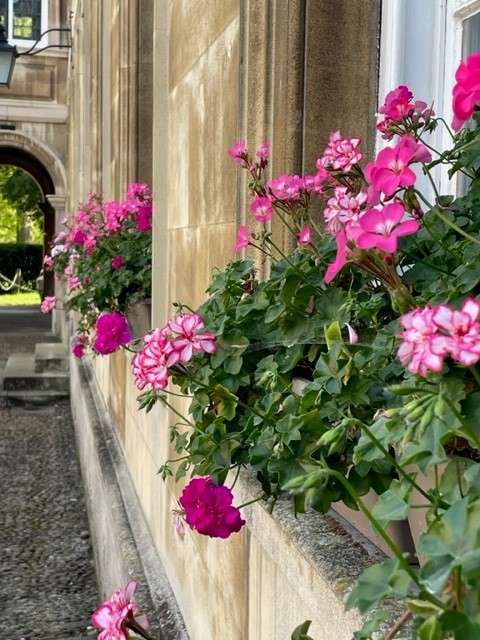
1 November 2023
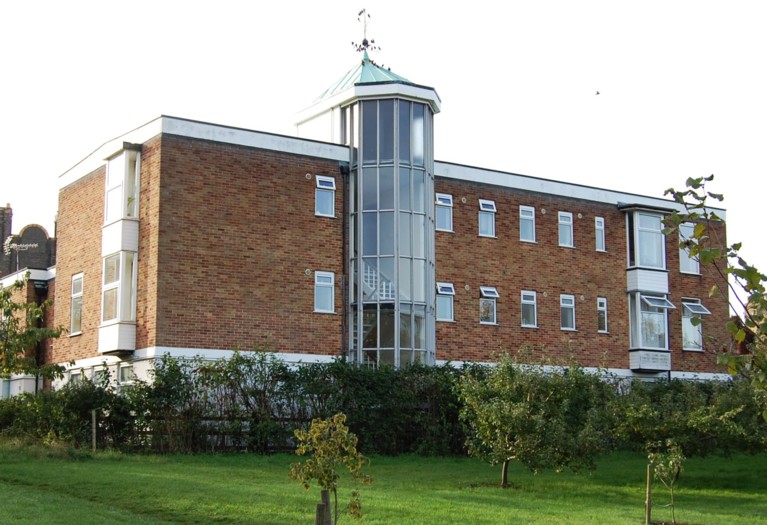
Barnwell Hostel, from Midsummer Common
This year marks the 70th anniversary of the college’s acquisition of Barnwell Hostel. Purchased rather hurriedly as a stop-gap measure to help meet the college’s urgent need for more student accommodation, it turned out to be an excellent long-term investment.
At the end of 1952, the college learned that 43 Newmarket Road, a recently-vacated nurses’ hostel, was for sale. Erected in about 1907 on land owned by Jesus College, the property comprised a three-storey, ten-bedroom house, set in a large garden. The surveyor’s report commissioned by Emmanuel suggested that while the hostel was structurally sound, its ‘rather bleak nature, together with its situation, do not make it very attractive for normal residential or hotel use’; in other words, it might be got cheaply. The sale went through in June 1953 and the first Emmanuel students (all Freshmen) were installed at the beginning of Michaelmas Term. A married couple occupied the Warden’s flat as caretakers.
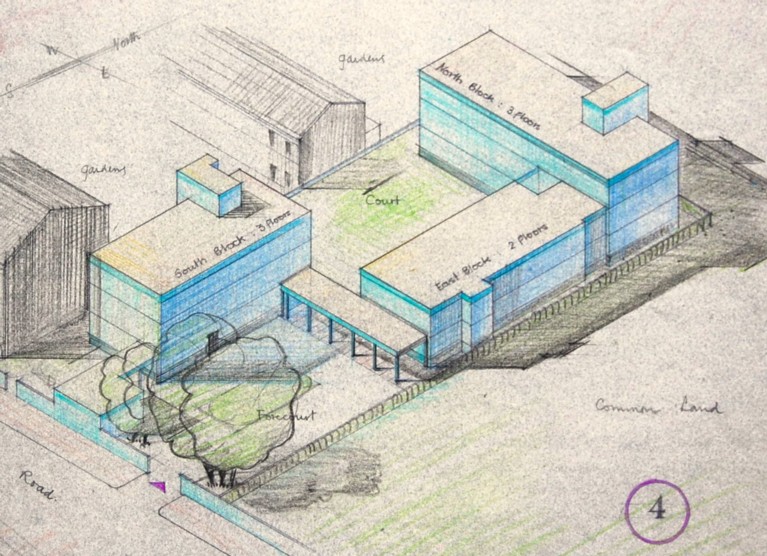
Richard Tyler’s unadopted design for Barnwell Hostel, 1959
It was soon realised that the site offered considerable potential for further development, and in 1959 the college engaged Bird & Tyler, architects, to design a new complex. Richard Tyler’s initial drawings, which envisaged the demolition of the Edwardian house and the creation of a three-sided court, were presumably in accord with his original brief. The college soon decided, however, that the existing building should be retained, so only the proposed L-shaped block was erected.
Tyler expounded his designs in the 1961/62 college Magazine: ‘As one comes into ‘A’ staircase one looks straight over Midsummer Common to the river through the tall bay window which runs from ground to roof…Staircase C also has a tall window running up two storeys, so that those who are young enough to bound up the first flight of stairs can enjoy the sensation of continuing into space beyond it’. Eschewing ‘pallid and off-white schemes’, Tyler chose natural wood fittings and ‘strong, clear colours’. The furnishings, which were ‘unaggressively up to date, designed for hard wear and the minimum display of dirt’, included flecked woollen upholstery and plaid curtains ‘where red merges into copper and green into blue’. Six extra-long beds were provided with Boat Club members in mind!
Not everyone shared the architect’s enthusiasm for the new block. A nearby resident complained bitterly to the Bursar of his shock at finding ‘a large building of no architectural merits at the bottom of one’s garden’. His principal grievance, however, was the severe impairment of his ITV signal. The college’s polite-but-firm response was that things would probably improve when the scaffolding was removed, but that, in any event, it had fulfilled all the council’s planning conditions.
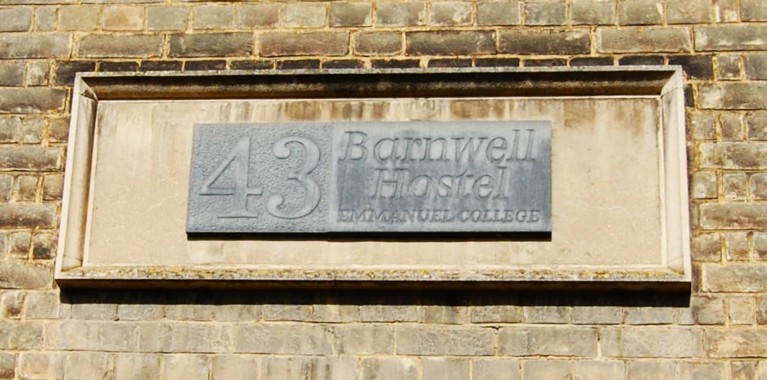
Barnwell’s name plate
Cupola and weather vane
In November 1960, the college’s governing body agreed that 43 Newmarket Road and the new block were to be collectively known as ‘Barnwell Hostel’. John Reddaway, Fellow and later Bursar of Emmanuel, suggested that Will Carter, an acclaimed Cambridge craftsman, be engaged to carve a name plate for the Hostel’s boundary wall. After this ‘beautiful slate slab’ was vandalised in 1963, it was affixed, following restoration, to the south elevation of the Edwardian building, at a height which would be ‘out of reach to the smaller hooligans’.
In recent decades, the former caretaker’s flat has been reserved for married graduates, but it was only in 2013 that the entire hostel became a ‘graduate colony’. Given Barnwell’s peaceful ambience and semi-pastoral location, it is not surprising that the accommodation is rated highly by students. Although the building’s design is primarily functional, the panoramic staircase windows and eye-catching copper cupola (surmounted by a weather vane sporting the Emma lion) undoubtedly add a touch of distinction.
Amanda Goode, College Archivist
1 November 2023
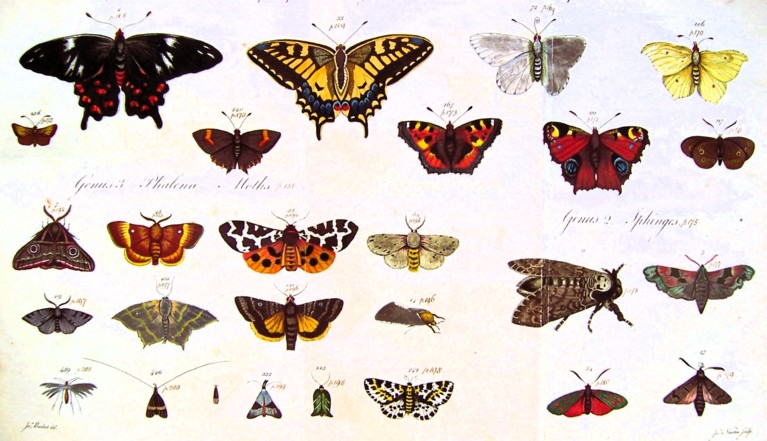
James Barbut, Les Genres des Insectes de Linne (London, 1781)
Now that we’ve said goodbye to the sight of butterflies for another year, the colour-plate images of their beauty in eighteenth- and nineteenth-century illustrated books – such as those in Emmanuel’s Library – are a potent reminder of their significance for so many past collectors and artists, and for those skilful individuals who managed to be both naturalists and artists. Across many cultures, the butterfly’s emergence from the chrysalis, and its ultimate derivation from a caterpillar, has symbolised transformation and rebirth, the triumph of spirit over the material and, in Christian tradition, the hope of resurrection. Yet there is always a painful sense too that the butterfly’s exquisite beauty is so evanescent.
Even the selection of illustrated books about insects in Emmanuel’s collection can represent the passionate interest, even ruinous obsession, of what we would now describe as amateur collectors of insect specimens. The earliest in our collection is Eleazer Albin (d. 1742?), possibly a German immigrant but by 1708 living in Piccadilly with his family. Initially a teacher of painting in watercolours, he became fascinated by natural history and published illustrated books on English insects, birds, and ‘spiders and other curious insects’. Albin prided himself on drawing specimens from life: his A Natural History of English Insects (1720) is ‘curiously engraven from the life: and (for those who desire it) exactly coloured by the author’. Albin’s illustrations of caterpillars munching on their favourite plants, attended by the moths that they become, are both elegant and skilful.
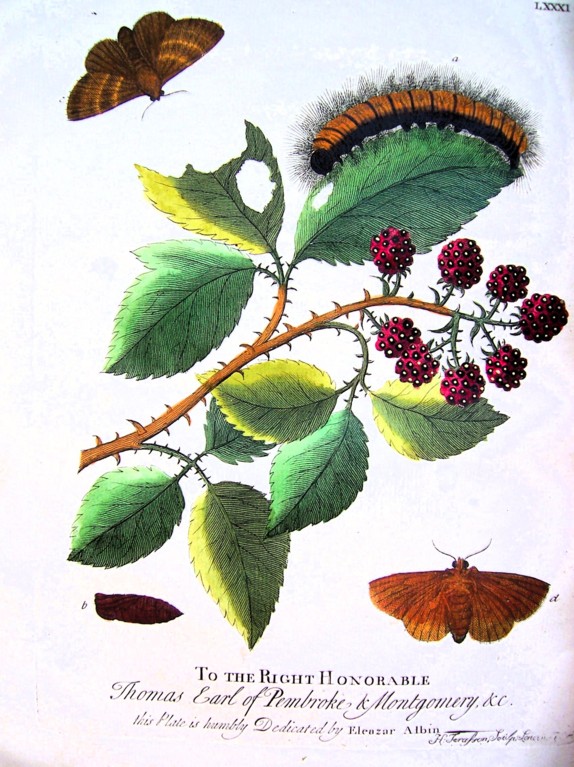
Eleazer Albin, A Natural History of English Insects (1720)
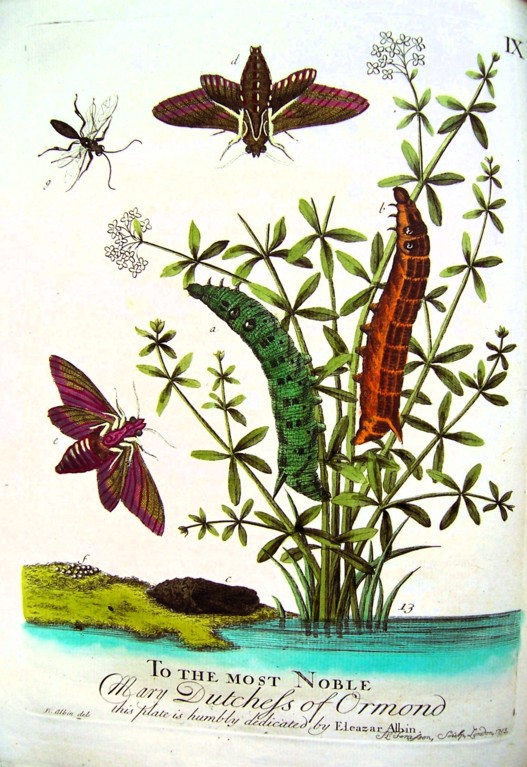
The text observes that the caterpillars who feed on the marsh plant fall off so often that they have developed a powerful backstroke to get them back to the plant stem. Albin acknowledges the participation of his daughter Elizabeth in drawing and painting for his A Natural History of Birds (1731-8), and appeals to fellow enthusiasts for more specimens: ‘Gentlemen … send any curious birds to Eleazar, near the Dog and Duck in Tottenham Court Road ... '
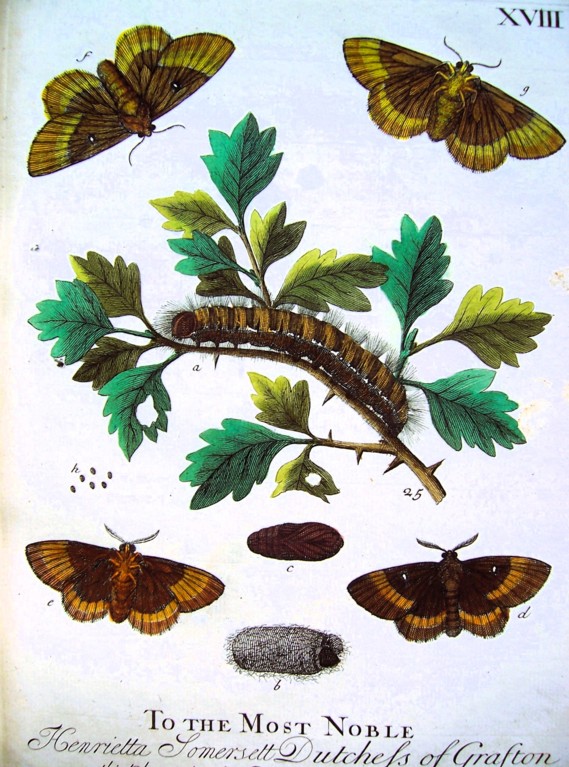 Albin, English Insects
Albin, English Insects
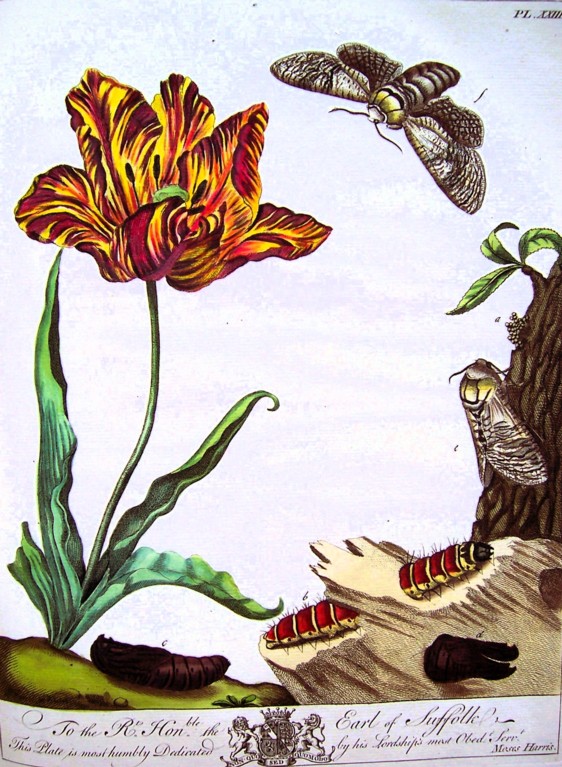
Moses Harris, The Aurelian (1766)
Another who combined skills as an artist and engraver with interest in natural history was Moses Harris, whose The Aurelian: or Natural History of English Insects appeared in 1766. Some of his illustrations are very accurately observed, and evidently coloured by Harris or under his close supervision. Stemming from his work as a colourist, Harris also propounded a system of colours through his ‘colour wheels’ that demonstrated how a range of colours may be made from red, yellow and blue.
The Cork-born Edward Donovan (1768-1837) rarely ventured outside London, yet he published on insects from across the world. Donovan was both artist and engraver, and (with a team of employees) also a colourist – as well as an ardent student of the natural world. As well as a sixteen-volume Natural History of British Insects (1792-1813), he published An Epitome of the Natural History of the Insects of China (1798).
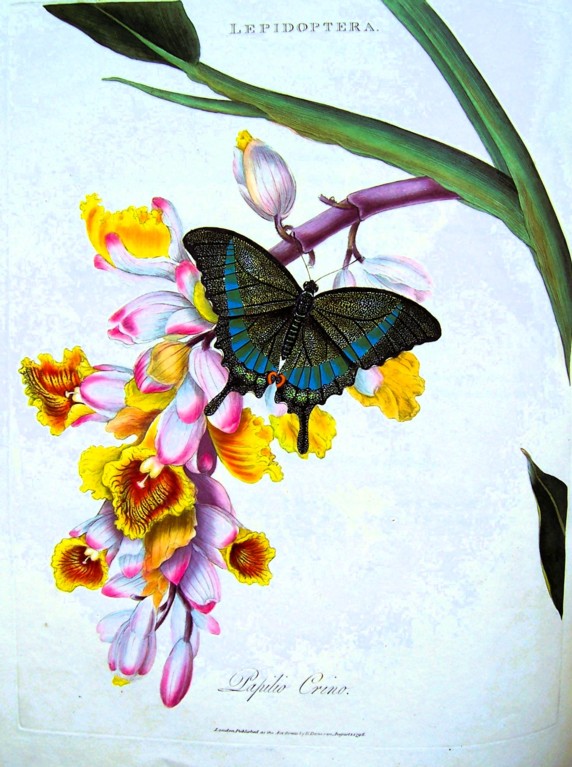
Edward Donovan, Insects of China (1798), ‘Papilio Hyparete’, ‘Found near Canton’
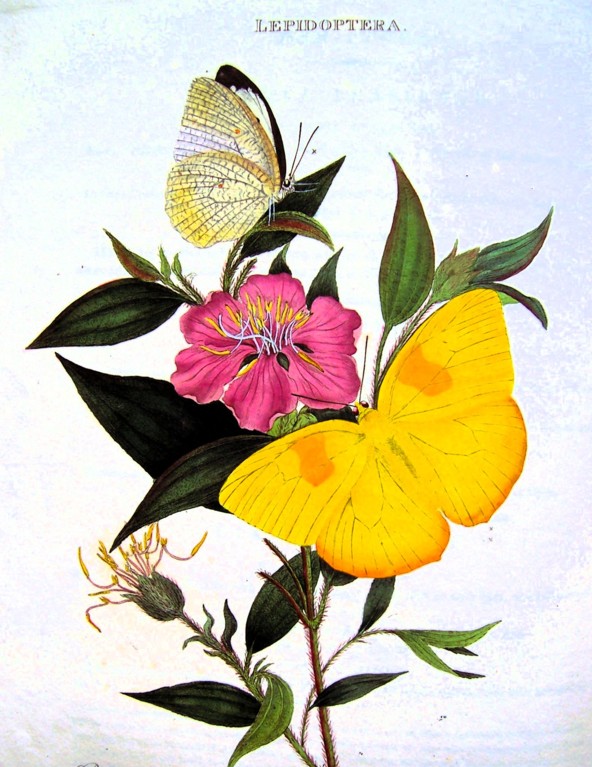
Donovan, Insects of China, ‘Papilio Pryanthe’, ‘Papilio Philea’
Donovan also produced the first book on The Insects of India and the Islands in the Indian Seas (1800) and was the first to deal with the insects of Australia in his Insects of New Holland (1805).
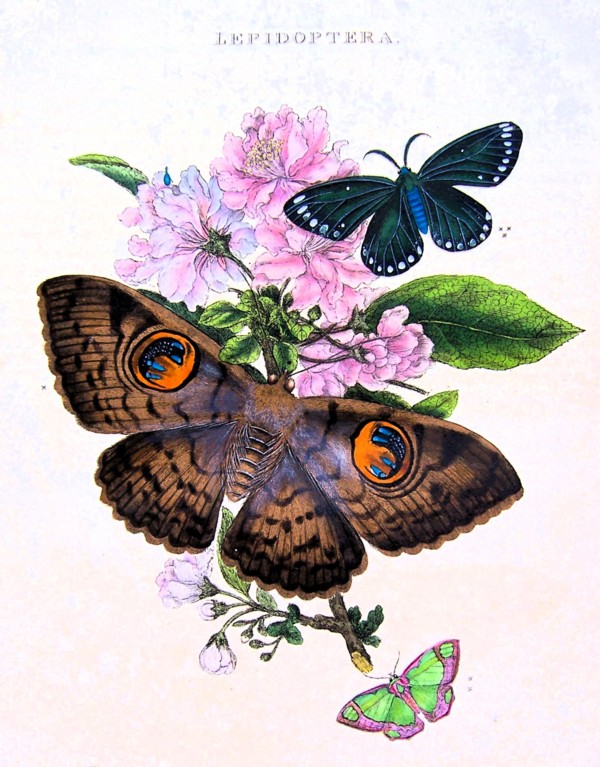
Donovan, Insects of China, ‘Phalaena Bubo … Zonaria … Pagaria’
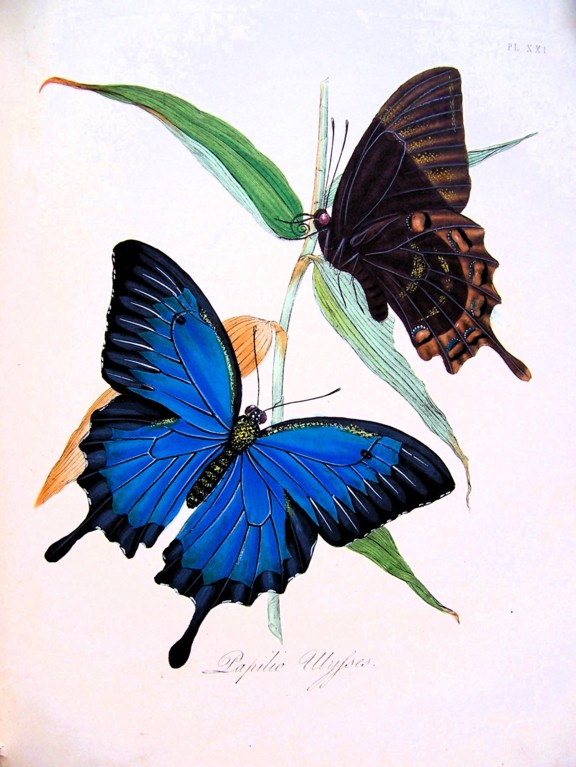
Donovan, Insects of India and Adjacent Islands (1800), ‘Papilio Ulysses’, ‘Dutch Spice Islands’ [Indonesia]
So how did Donovan do all this from his home in London? He was an avid collector and purchaser of specimens brought back by travellers – so much so that he even started his own Museum and Institute of Natural History, open to the public on payment of one shilling and displaying hundreds of cases of his specimens. Alas, the venture did not pay off, and Donovan’s pursuit of costly purchases of specimens so impoverished him that he eventually died penniless, leaving his large family destitute.
More successful in worldly terms was John Westwood (1805-1893), whose earlier amateur interests in both insects and in illustration later led to his becoming one of the first entomologists with an academic position at Oxford.
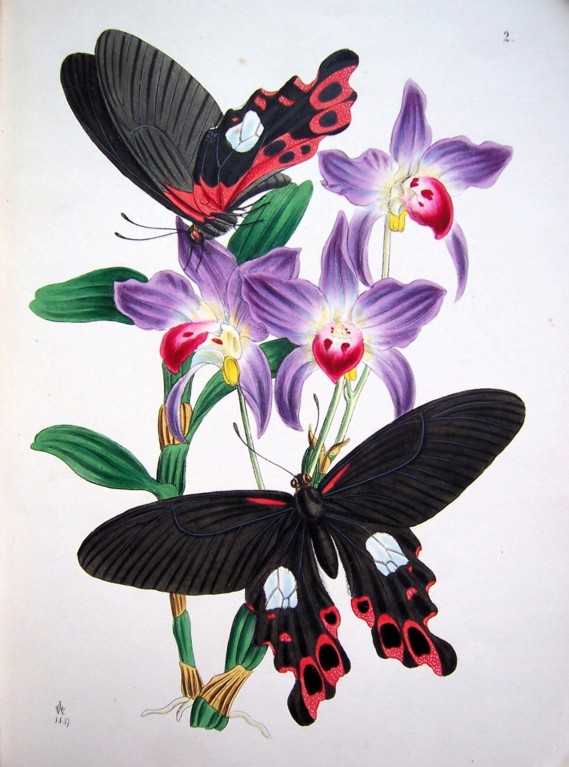
John Westwood, Oriental Entomology, ‘Papilio Icarius’, ‘Assam’; Butterflies ‘From the Torres Straits Islands’
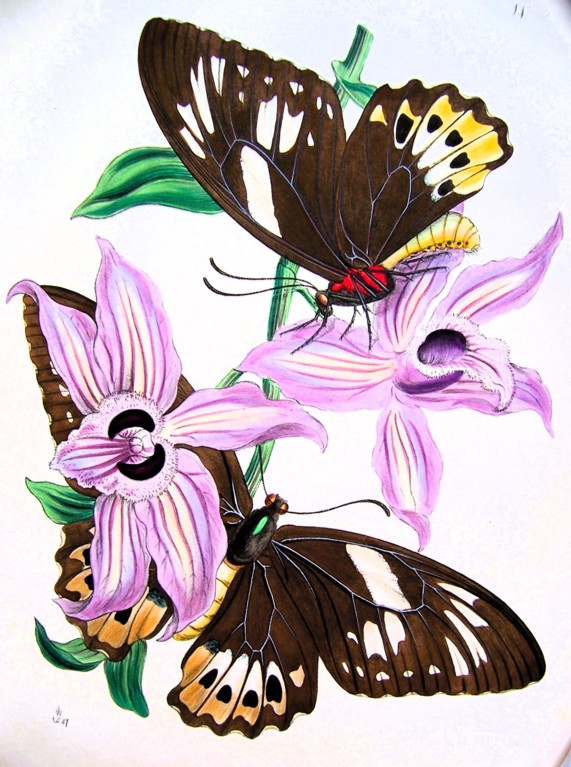
But again, these splendid illustrations to his Cabinet of Oriental Entomology (1848) – ‘being a selection of some of the rarer and more beautiful species of insects, native of India and the Adjacent Islands' – are based on specimens in the collections of other naturalists.
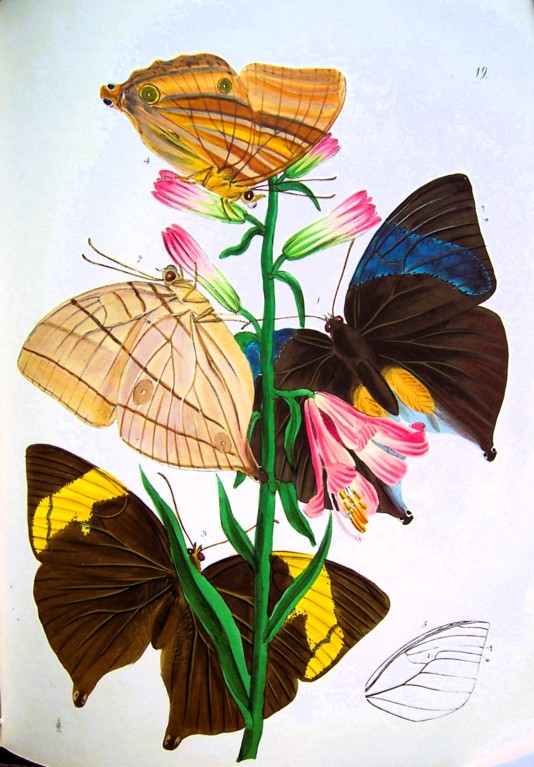
Westwood, Oriental Entomology, Butterflies from modern-day Bangladesh
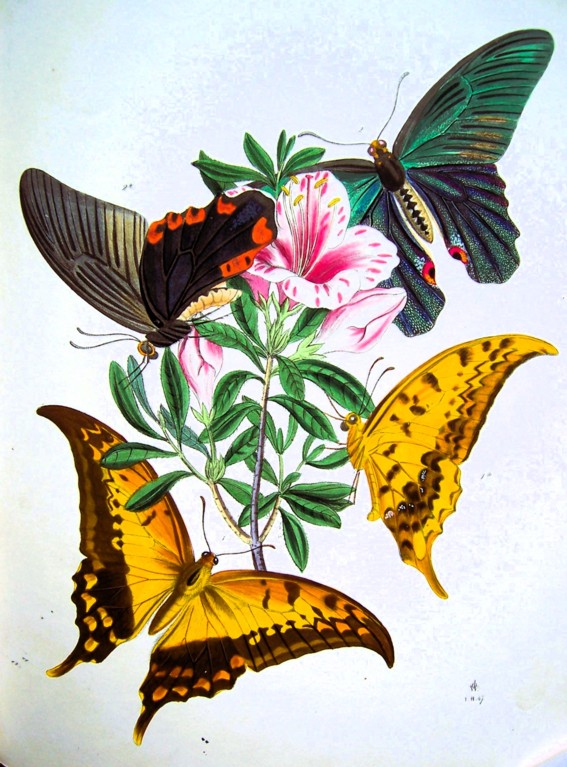
This was a collaborative fraternity of students of natural history, and Westwood collaborated with Edward Doubleday (1810-1849) on his Genera of Diurnal Lepidoptera (1846-50).
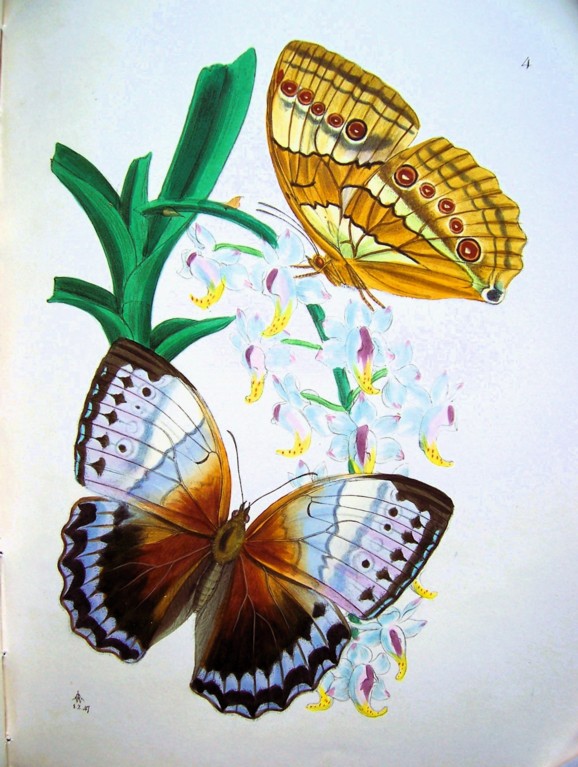
Westwood, Oriental Entomology, Butterflies found in the Himalayas
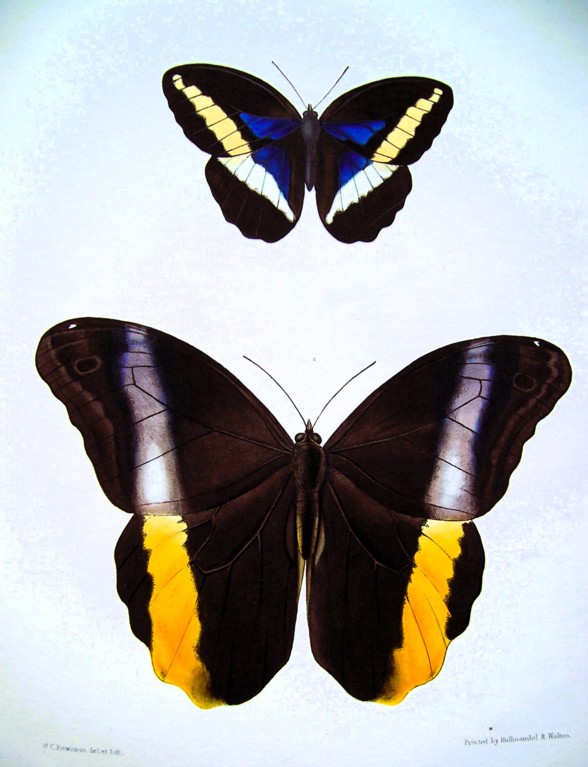
Edward Doubleday, Diurnal Lepidoptera, ‘Pavonia Rusina, Pavonia Ajax’
‘He had a butterfly mind’ is one of the less positive associations of butterflies, hardly shared by the extraordinary application of these various artists who were also students of natural history. Their lasting accomplishment in recording their butterflies is a kind of defiance of the evanescence of their subject.
Barry Windeatt, Keeper of Rare Books
Images by Helen Carron, College Librarian
5 October 2023
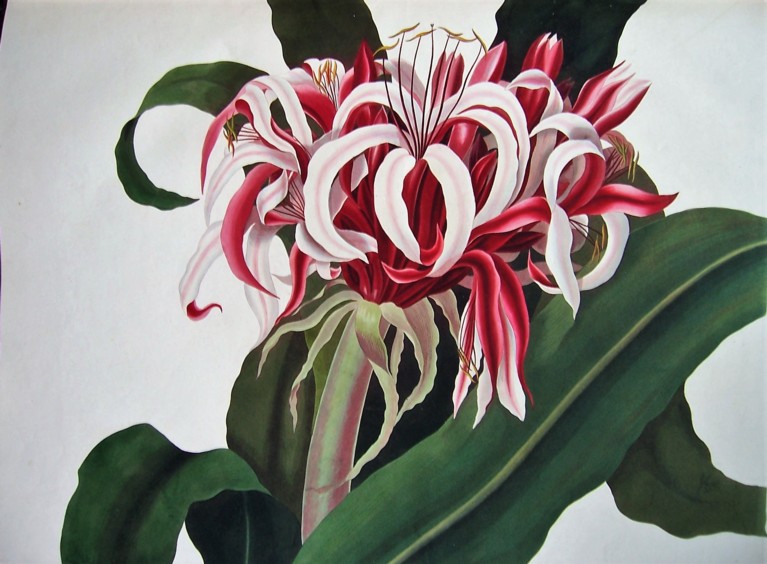
Mrs Edward Bury, A Selection of Hexandrian Plants (1834), ‘Crinum augustum’. Bury was the artist but Robert Havell engraved and coloured the plates.
In any collection of nineteenth-century illustrated books such as Emmanuel is fortunate to possess, there will be ‘flower books’. A significant number of such books of botanical illustration are the work of largely unsung women artists, who display extraordinary painterly skills – as well as a reverent attention to nature – in so patiently recording their observations of plants and flowers. Often published anonymously and frequently sidelined, their work quietly advances a wider knowledge of botany, enlisting beauty in the greater understanding of nature (and in many cases also educating their readers in how to paint the same flowers and foliage for themselves).
The stunningly large and brilliantly coloured lilies of Priscilla Bury’s Hexandrian Plants (1834) reflect contemporary excitement among plant collectors at such exotic new plant imports blooming in their hothouses in and around Liverpool in the 1830s. At much the same time, the Irish botanical artist Catherine Teresa Cookson (of whom little is otherwise known) catered to such a taste for exotic flora in her Flowers drawn and painted after nature in India (c.1835).
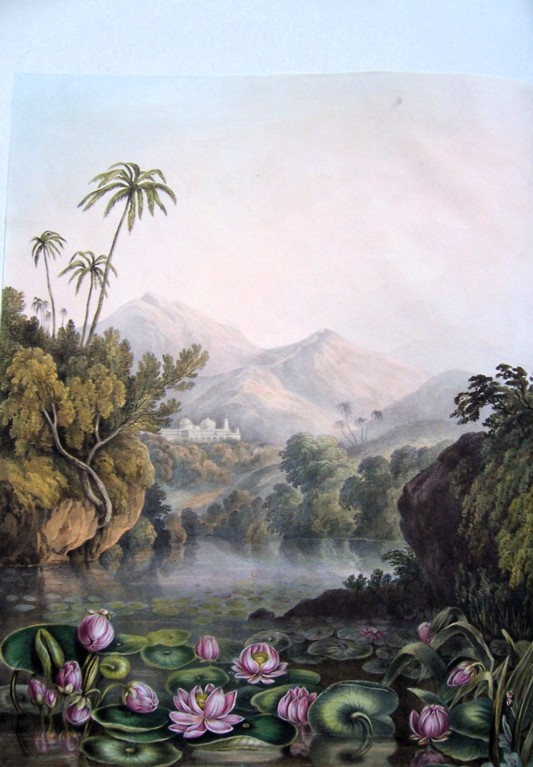
Catherine Teresa Cookson, Flowers drawn … in India (c.1835), ‘A View taken in INDIA, of the LOTUS growing in water’
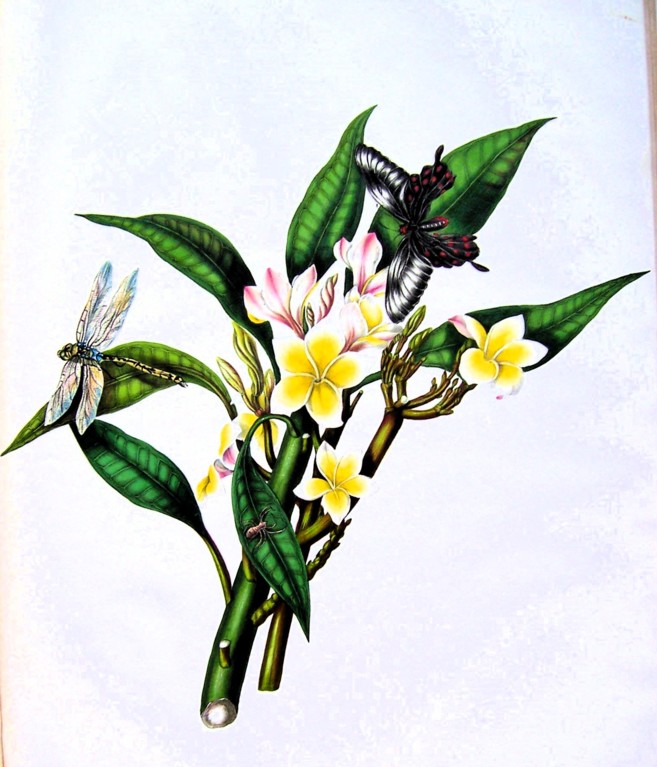
Cookson, ‘The White Plumieria’
But the impetus to teach a book’s users how to undertake botanical illustration for themselves will tend necessarily to focus on more accessible flora. The splendid illustrations in Studies of Flowers from Nature (1818-1820) by ‘Miss Smith’ are accompanied on the facing page by helpful instructions on the particular paint colours to be used in copying the image. A second set of flowers drawn only in outline is also included for colouring in. Like a number of other female botanical illustrators, Miss Smith dedicates her book to a female patron, George III’s daughter Princess Elizabeth, herself an accomplished artist. Miss Smith has never been identified but may have been a teacher in a girls’ boarding school near Doncaster.
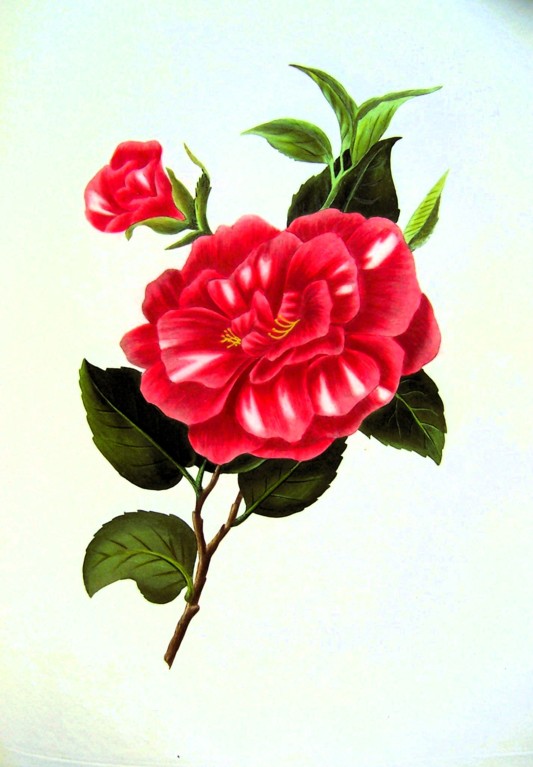
Miss Smith, Studies of Flowers from nature (1818-1820), ‘Camellia’
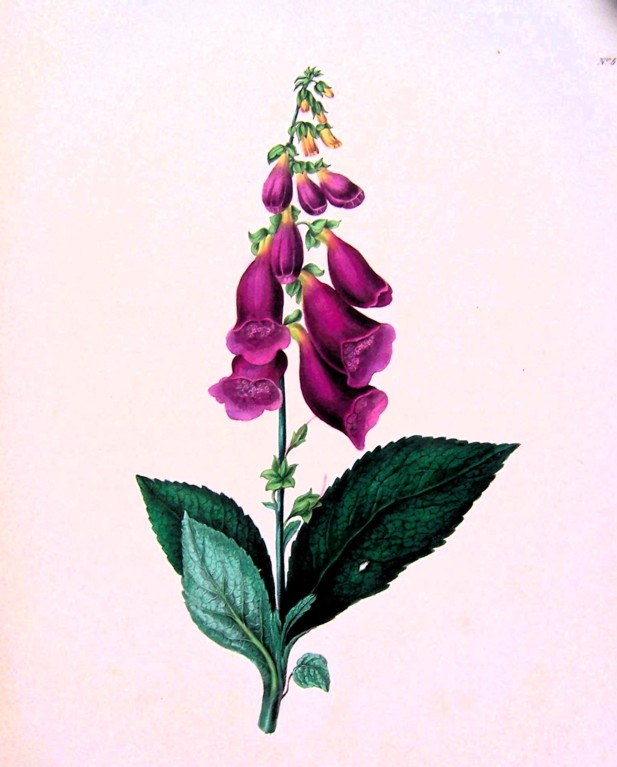
Anne Everard, Flowers from Nature (1835), ‘Purple foxglove’
Anne Everard’s Flowers from Nature … with Instructions for Copying (1835) also accompanies its thirteen hand-coloured lithographed plates with precise directions. For the purple foxglove: ‘Damp the paper with warm water and shade the corollas with a mixture of Prussian Blue and Lake; put a wash of carmine over them, and when nearly dry another of cobalt …’ (and so on for another eight lines of print).
Some women artists left their drawing and painting to be engraved or lithographed by men, as with Margaret Lace Roscoe’s Floral Illustrations of the Seasons (1831), ‘From Drawings by Mrs Edward Roscoe’.
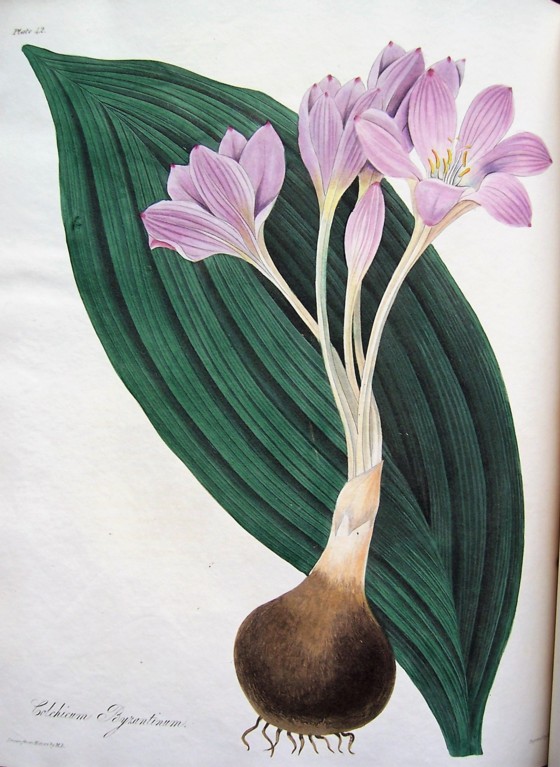
Margaret Roscoe, Floral Illustrations of the Seasons (1831), ‘Colchicum byzantinum’
But other women artists engaged in, and hence controlled, the whole process themselves, as is shown by two illustrated books themed around the flowers that are mentioned by celebrated poets. In her The Flowers of Milton (1846) Jane Elizabeth Giraud is building on the success of her The Flowers of Shakespeare a year before.
Her method was to draw the originals, then have them lithographed, and finally hand-colour the lithographs herself.
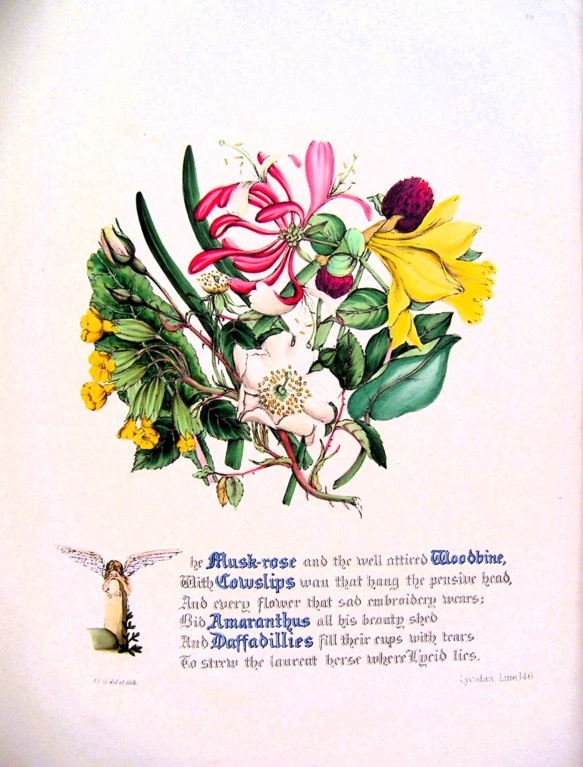
Jane Elizabeth Giraud, The Flowers of Milton (1846), illustrating lines from Milton’s ‘Lycidas’ that mention the musk rose, woodbine, cowslip and daffodil
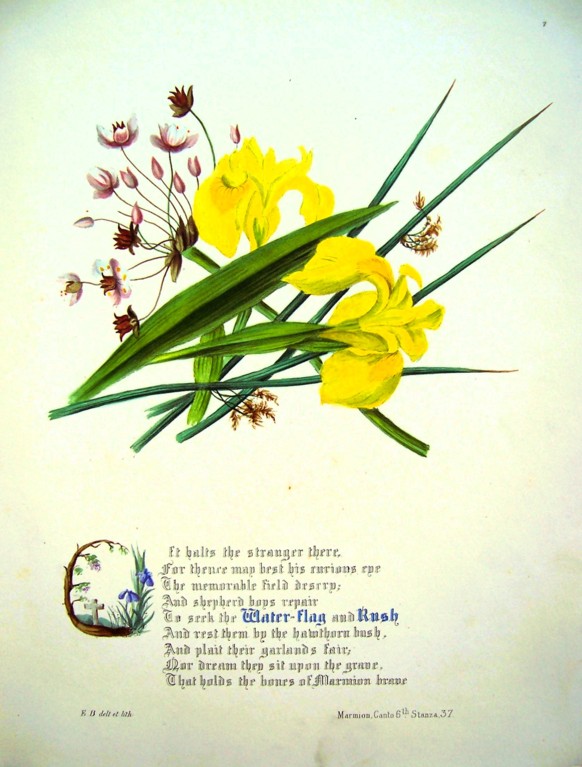
Elizabeth Bartlett, The Flowers of Scott (1852), illustrating lines from Sir Walter Scott’s ‘Marmion’ mentioning the water flag and rush
In Elizabeth Bartlett’s The Flowers of Scott (1852), thirty-five lithographic plates illustrate flowers that occur in the poems of Sir Walter Scott, and Barlett indicates on each plate that she has both drawn and lithographed them (‘E.B. delt. et lith.’).
Anonymous publication by women artists is well exemplified by Ten Lithographic Coloured Flowers by a Lady (Edinburgh, 1826-1832). This is actually forty fine plates published in four sets of ten. The list of subscribers – headed by the Duchess of Hamilton and the Lord Provost of Edinburgh – is entirely Scottish, but the ‘Lady’ artist remains anonymous to this day.
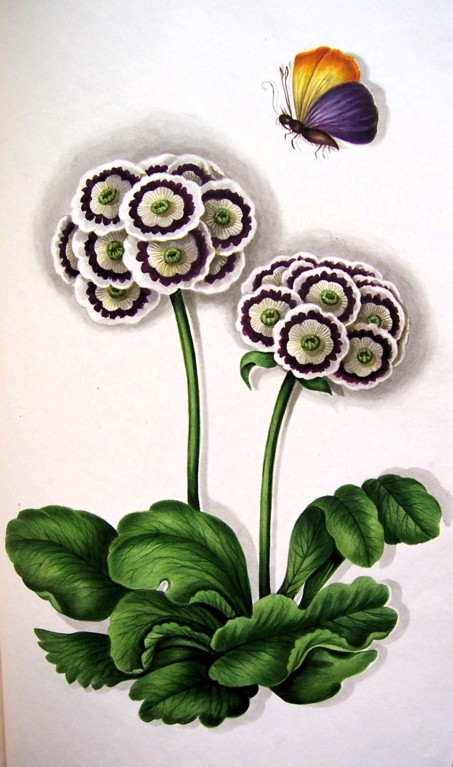
Ten Lithographic Coloured Flowers by a Lady (1826-32), ‘Primula auricula’
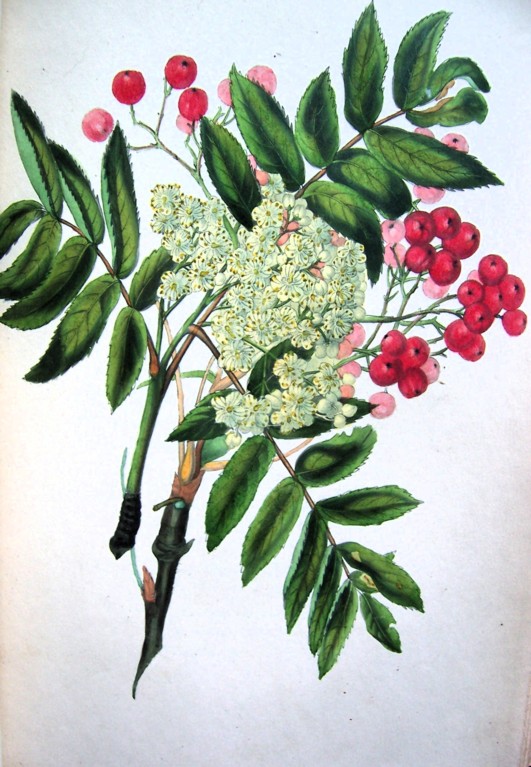
Rebecca Hey, The Spirit of the Woods (1837), ‘Mountain Ash’
In Rebecca Hey’s The Spirit of the Woods (1837) the title page makes no mention of Mrs Hey by name, although the preface refers to its author as female. There are 26 hand-coloured plates, presenting what is one of the early encyclopaedias of wild trees. Her earlier The Moral of Flowers (1833) acknowledged that the drawing and engraving had been done by men, but here are emphasized ‘the drawings for the illustration of the work, which the author herself has ventured to execute from nature and which she trusts will be found botanically correct’.
A prolific woman author and illustrator on botanical subjects was Jane Loudon (1807-1858), although before she started on that career she had already published, aged only 20, a novel that is sometimes seen as a pioneer and precursor of science fiction: The Mummy! A Tale of the Twenty-Second Century (1827). (Reader, it’s a reincarnation of the Pharoah Cheops, not a dystopian matriarchy). Having reviewed The Mummy! John Claudius Loudon, the celebrated (and much older) Scottish garden designer, horticulturalist and author sought out the author of The Mummy! and they married six months later. Spotting a gap in the market for accessible books about how to garden, Jane Loudon’s books were illustrated with her own botanical paintings, which show a strong feeling for both colour and detailed botanical record.
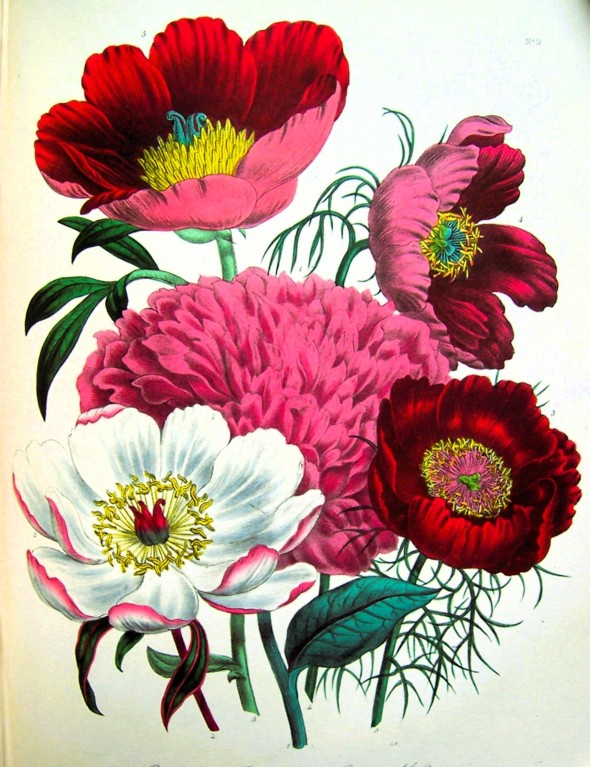
Jane Webb Loudon, The Ladies Flower Garden of Ornamental Perennials (1846), ‘Peonies’. Loudon’s page layouts modelled on a bouquet were imitated and influential on décor.
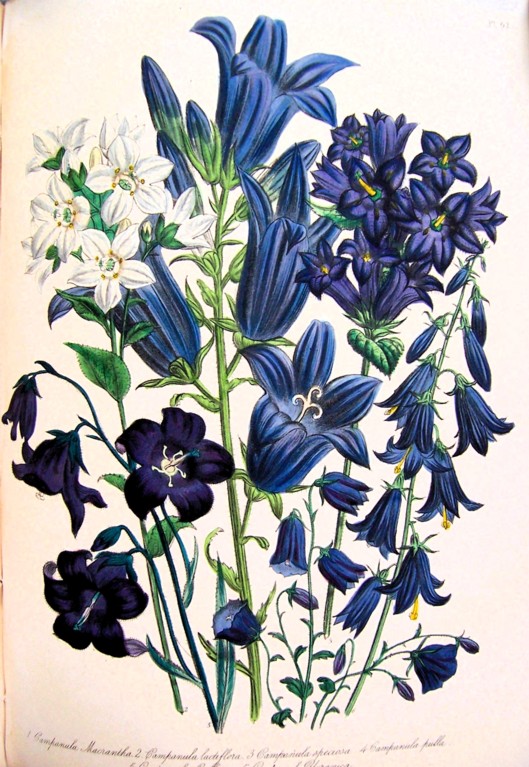
Ladies Flower Garden, ‘Campanula’
These gardening books, directed at female readers, empowered countless women to take possession of their worlds through the creating of their own gardens, inspired by the information and the compelling illustrations in Mrs Loudon’s books. Eleven such books were published, and she also founded The Ladies Magazine of Gardening in 1842.
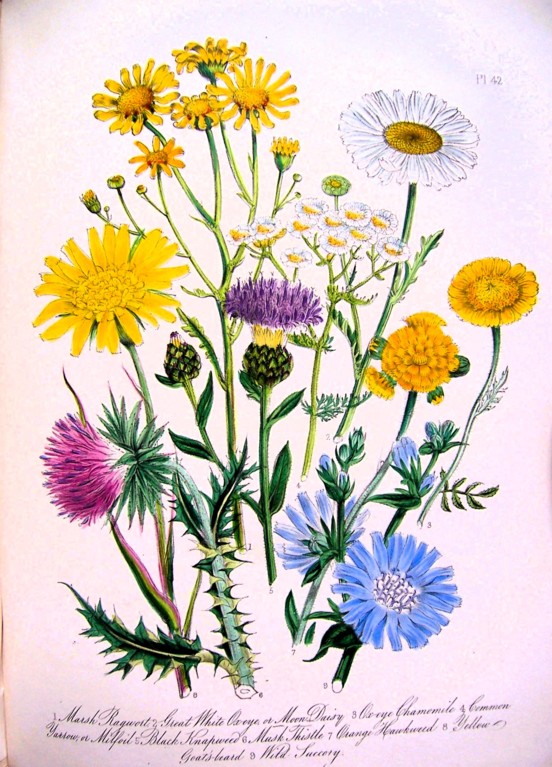
Jane Webb Loudon, British Wild Flowers (1847), a selection including ragwort, chamomile, yarrow, knapweed, musk thistle, hawkweed, succory
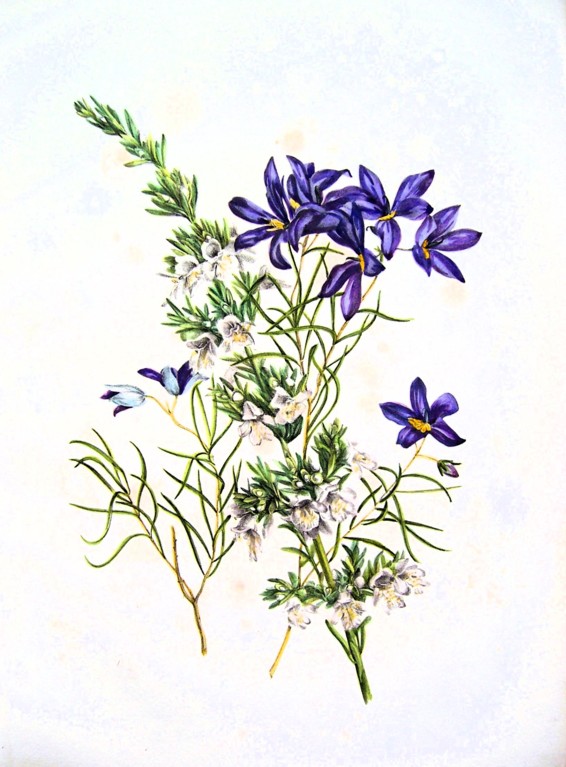
Fanny Elizabeth de Mole, Wild Flowers of South Australia (Adelaide, 1861), ‘Westringia rosmarinifolius and Cheiranthera linearis’
Jane Loudon’s sheer productivity in her life of only fifty years is astonishing, while in a much shorter life Fanny Elizabeth de Mole (1835-1866) produced the first book recording the flora of the South Australia colony. Her line drawings were sent to England for lithographing and the plates then returned to Australia, so that Fanny could colour by hand the one hundred copies each containing twenty plates.
‘Man … cometh up, and is cut down, like a flower’, in the words of the funeral service in the Book of Common Prayer. Part of the fascination of these books is that they preserve enduringly the beauty of flowers that so soon will have faded and represent the skilled life’s work of many undervalued women artists.
Barry Windeatt, Keeper of Rare Books
Images by Helen Carron, College Librarian
4 October 2023
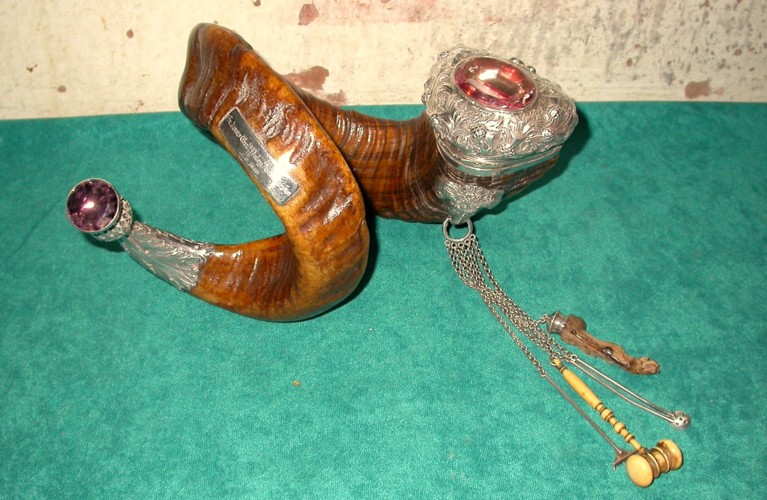
Ram’s horn snuff mull, given to Emmanuel in 1856
Emmanuel has for some time been officially a ‘smoke-free site’. Anyone wishing to enjoy a crafty ciggie is therefore obliged to skulk outside the college gates. Yet for nearly four centuries, smoking within the precinct was not just tolerated, but practically encouraged.
An early Emmanuel enthusiast for the weed was Elias Travers. Appointed Fellow in 1609, he had tutorial responsibility for a student named Thomas Knyvett, who was admitted in 1611, aged 16. When Thomas’s grandmother received a tip-off that her pet tutor indulged in the vice of pipe-smoking, she immediately threatened to send her grandson to another college. Travers did not want to lose Lady Knyvett’s generous, if demanding, patronage, so he gritted his teeth and replied: ‘if the Tabacco I have sometimes taken be a just grievance to any, I desire them to know that if the forbearance or utter avoidance of it will give them content, I shall quickly quite ridd myself of it…’. Whether or not Travers genuinely intended to abjure the pernicious habit, his renunciation was enough to placate Lady Knyvett, who let Thomas remain at Emmanuel.
It was not long before smoking became an integral part of Emmanuel’s society. From 1710, and probably earlier, tobacco was supplied gratis to the fellowship on high days and holidays, as well as at the annual audit. College orders of the 1720s required the steward and dean to provide the Parlour with ten quarts of red wine and half a pound of tobacco on the day of their election. This obligation proved predictably unpopular, and the orders were quashed in 1747. Certain standards were maintained: partaking of snuff during dinner in Hall, for example, was forbidden by a ruling of 1782, any Fellows transgressing being fined one bottle of wine ‘for every pinch’.
The Parlour wager books record several bets involving tobacco, including whether its smoke could ‘take fire’, the likely interval between using snuff and sneezing, the probability of an ounce of tobacco filling five pipes, and how many (if any) bishops smoked. A truly bizarre wager between Henry Homer and William Meeke in 1783, was whether ‘Homer’s Mare smoakes a pipe backwards better than Meeke forwards’.
A variety of smoking accoutrements were procured for Parlour use, including tobacco boxes, spitting trays, and, in 1766, two gross of ‘Glaz’d Tobacco pipes’. A ‘Polished Tobacco pot & rais’d cover’, engraved with the college arms, was commissioned in 1784 - but mysteriously vanished from the Parlour cupboard in 1800. Later acquisitions included a ‘handsome’ gift in 1798 of a ‘canister of prime snuff’, a bejewelled ram’s horn snuff-mull given in 1856 by William Paley Anderson (one of the younger Fellows), and, in the last century, silver cigarette boxes, ashtrays and matchbox cases, all of which are now rapidly acquiring curio status.
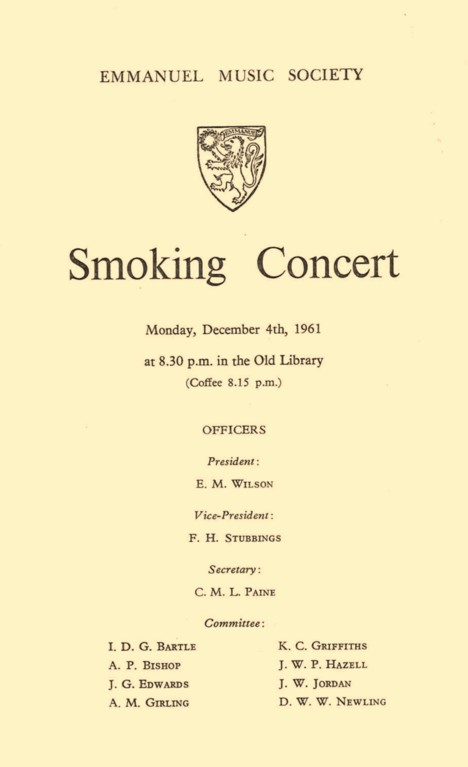
Smoking Concert programme, 1961
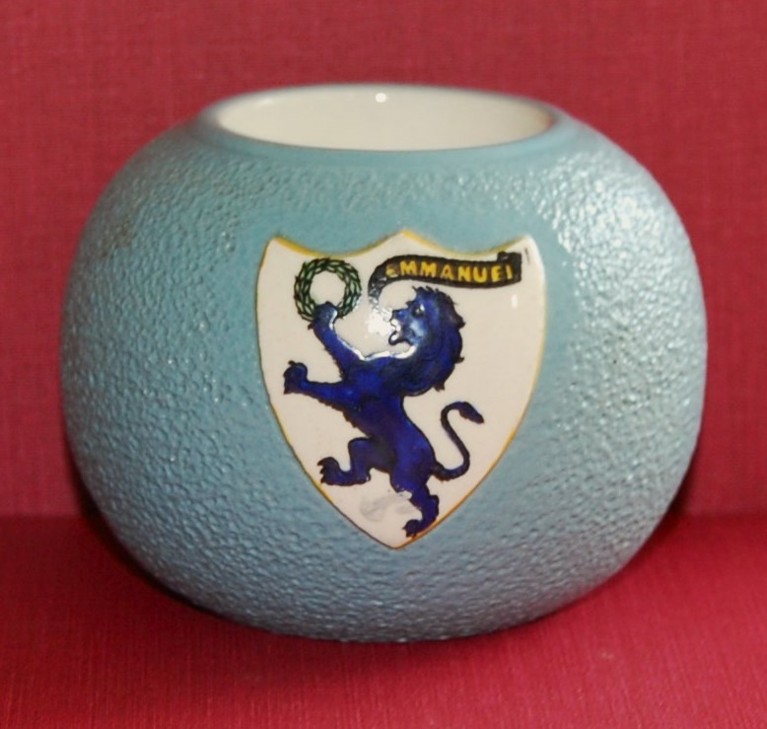
Matchpot with Emma crest
Undergraduates seem always to have been at liberty to smoke, hence the need for the University authorities to threaten students with expulsion if they did so anywhere near the tobacco-hating King James I and VI, during his December 1624 visit to Cambridge. By the nineteenth century Cambridge shopkeepers were supplying a plethora of mass-produced tobacco jars, ashtrays, cigarette cases and Carlton Ware matchpots, which students could customize by having their college’s coat of arms added. A popular form of undergraduate entertainment was the so-called ‘Smoking Concert’, traditionally confined to male audiences. Emmanuel’s Musical Society hosted many such events, but the last of these fuggy recitals was held on 12 March 1962. Just a few days earlier, the Royal College of Physicians had published its groundbreaking report on the health risks of smoking. Change was in the air…
Amanda Goode, College Archivist
3 October 2023
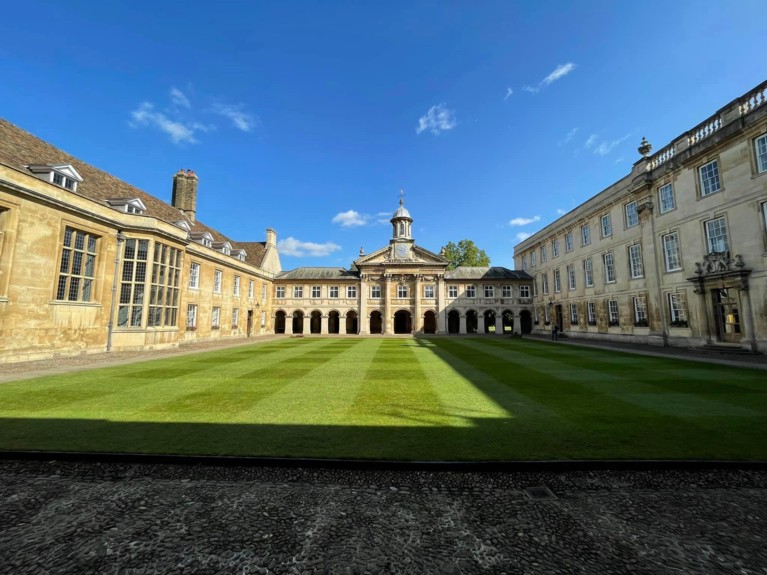
Welcome back to the news from the gardens. I welcome all the new freshers, fellows and post-docs to the blog. It is my intention to keep you all updated with the comings and goings from the department, the successes and the disappointments, the good, the bad and the ugly.
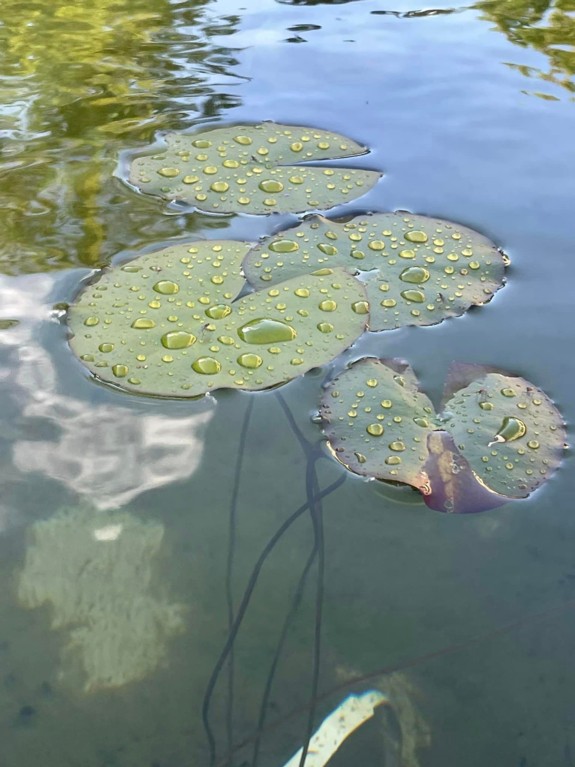
The department has been stretched as always since the last blog. It has been a very busy growing year in general. This is the complete opposite to one year ago when the department had witnessed a very challenging year due to the extreme hot weather and the droughts. This last calendar year has been kinder to us. The temperatures, although mild, have not been blisteringly hot. We have had ample rain and warm temperatures, these themselves having added challenges. This year, the plants and lawns (and weeds) have seen phenomenal growth. It has been hard to keep up this year. Hedges have required cutting more frequently, lawns being tendered twice as often, climbing plants being trimmed with regularity that we have not seen in many years.
The department itself is in a healthy position, though. We do have our regular staff but also one full-time apprentice on the Cambridge Colleges Apprenticeship Scheme and a part-time student, retraining in horticultural from the WFGA.
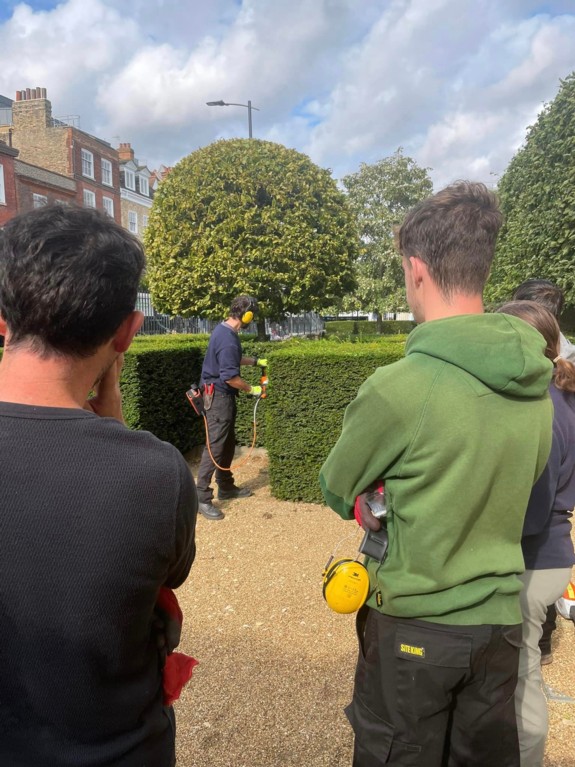
It was a pleasure last week to welcome some of the apprentices to the Emmanuel College gardens for some training. The students took part in a machinery workshop that discussed the pros, cons, and legislation within the world of horticultural machinery. It was a chance for me and our more experienced gardeners to pass on their knowledge. This is an essential phase of learning and hopefully the students will go on to achieve good things in the future, remembering the positive day at Emmanuel.
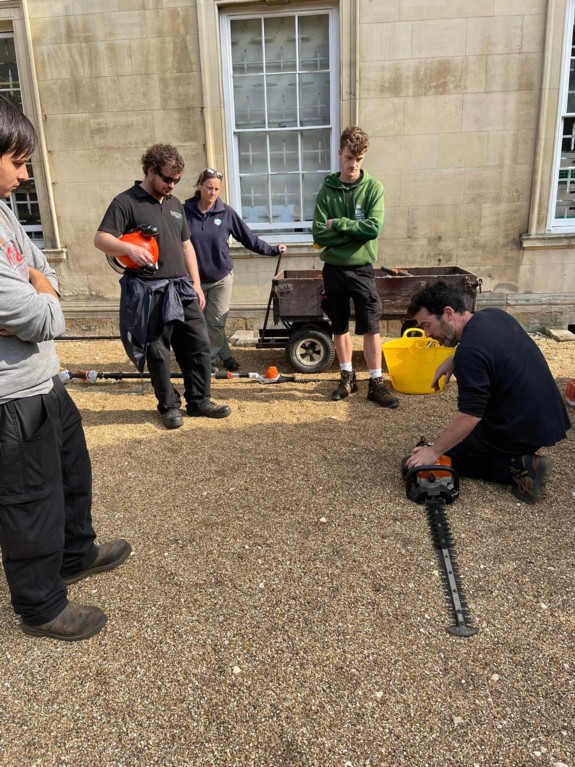
Apart from the regular high-quality work that my team provide for the gardens, occasionally we do have to deal with the unexpected. After a particularly stormy weekend in September, a Monday morning greeted us with an unusual task. In the Fellows’ Garden, there was some storm damage. This is not unusual, but what was unusual was that the tree in question had appeared to have been struck by lightning. The tree in question was the King’s Mulberry Tree in the Fellows’ Garden. There were large scorch marks on a very large branch and a smell of burning. The large branch had then fallen and broken some other branches on the way down, causing significant damage. It took the garden team a while to clear all the debris but hopefully no further damage to the tree’s structure will occur.
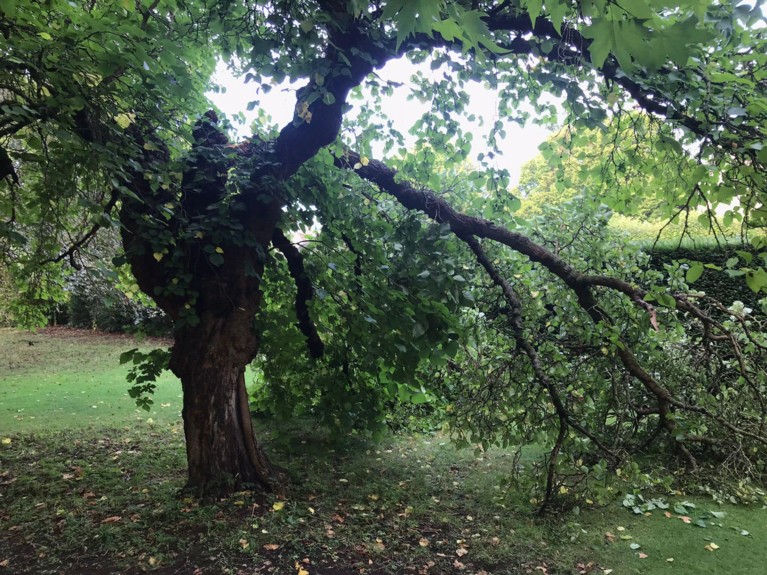
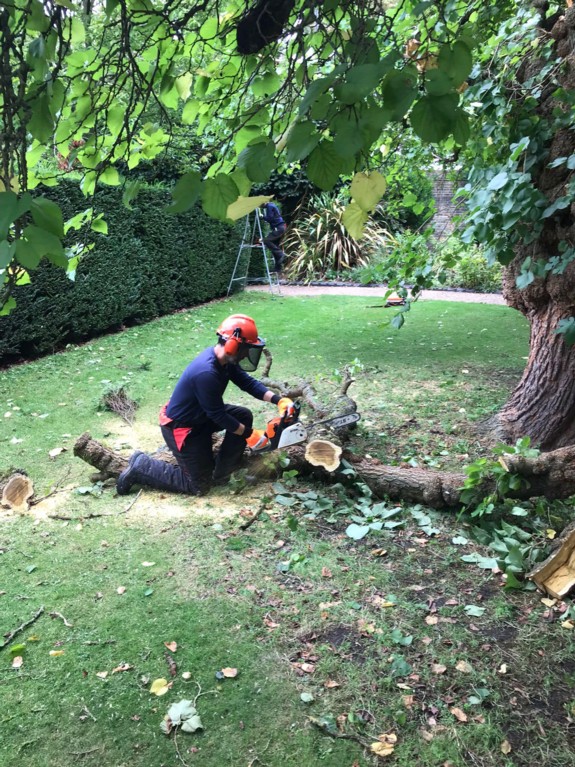
Looking forward to future works in the garden, the team will carry out the following tasks:
- renovation to front court lawn;
- bulb planting in the new landscape beds;
- renovation from building works in the swimming pool;
- planting of hedging to replace dying hedging from box moth caterpillar damage.
We look forward to sharing our progress with you in future garden blogs.
Best wishes.
Brendon Sims, Head Gardener
7 September 2023
Islands.
They’ve always fascinated me. Crucibles of humankind (the inhabited ones, anyway) walled in by the oceans, each with its own unique stamp of culture, moulded by its own history of colonisation, topography, climate and natural resources – and by the tyranny of isolation. Which is why, I suppose, the veterinary science degree from Cambridge steered me into a career – latterly, at least – on the UK Overseas Territories of the South Atlantic. My own path illustrates the hugely diverse application of this degree: not at all confined to treating fluffy bunnies and spaying cats but rather encompassing a vast array of possibilities. As a student, I could never have envisaged how vast.
Since 2004 (apart from a one-year foray working for an NGO in Turkey, fighting the cruelly disfiguring disease leishmaniasis in war-torn Syria), I’ve been grafting on these captivating islands, as scattered as they are different.
The Falklands: a grand archipelago, a swathe of sea-girt islands down in subantarctic waters that boast rich fisheries, abundant wildlife and more sheep than the eye can take in.
Tristan da Cunha: the remotest island settlement in the world, a crofting-type community of some 250 hardy souls perched on the brim of a recently active volcano, their livelihoods dependent on harvesting the abundant crayfish that swarm in the undersea kelp forests like armies of ants.
Ascension: an equatorial military base once nicknamed ‘The Cinder’ because of its brutish volcanic landscapes, and yet home to colourful land crabs and nesting sea turtles, and with a lush central peak – the first example of terraforming.
And tropical St Helena: the former darling of the East India Company, once the most impregnably fortified place in the world and crammed with built heritage, dramatic scenery and endemic species, all set in a pristine sea teeming with life.
Here, I have the immense privilege of looking after the world’s oldest known living land animal, my namesake Jonathan, a Seychelles giant tortoise who is close to entering his third century.
On each set of islands, the work has not only involved the standard application of practical skills, but everything else that touches upon the abilities of a vet: from bees, fisheries, biosecurity and seabirds through to legislation, welfare, public health and tourism. Not a whisker of time is lost to boredom.
And now, an interesting byproduct. On the back of some documentaries I had made with the BBC, I was approached by a renowned literary agent to write a book, which is now published by Duckworth. We’ve called it Vet at the End of the Earth. It’s packed with local characters, island colour and, of course, stories about my great love, the animals. I’ve fashioned it to entertain and uplift, to plant a smile on the lips and draw the occasional tear, whether the reader happens to be warming their toes by the fireside in a cosy armchair with a steaming cup of tea or topping up their tan in a deckchair on a broiling costa with an ice-clanking sangria.
If you would like to come on the journey around the islands with me – and, in a way, you’ve already started – you’ll find it in all the best high-street and online bookshops, including Waterstones, Amazon and Bookshop.org. I hope you’ll find the experience nearly as rewarding and eye-opening as I did, beyond my wildest student imaginings!
Duckworth Books will publish Jonathan Hollins' memoir Vet at the End of the Earth on 5th October 2023.
6 September 2023
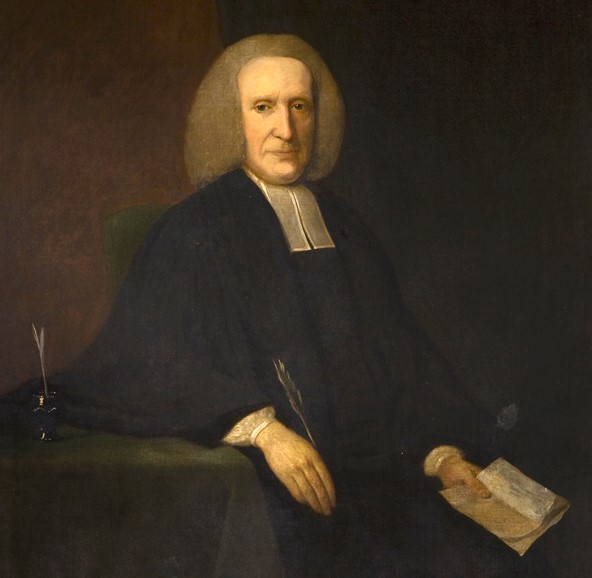
Dr William Richardson
Almost every biographical source for Dr William Richardson, Master of Emmanuel 1735-1775, states that he is buried in the college chapel. There are good reasons to question this assertion.
Recent sources are doubtless quoting the relevant entry in Venn’s Alumni Cantabrigienses, published in the 1920s. The authors of this listing of Cambridge University men appear to have taken the information about Richardson from the Dictionary of National Biography, compiled in the late nineteenth century. The DNB had, in turn, relied on Nichols’s Literary Anecdotes. The earliest edition of this work, published in 1782, stated: ‘[Richardson] died March 14, 1775, and was buried in the same vault with his wife, under the litany desk in the chapel of his College’. The principal authors of Literary Anecdotes were William Bowyer (died 1777) and his assistant, and later successor, John Nichols. Bowyer had been up at Cambridge at the same time as Richardson and may have known him then, or perhaps later, when they were members of the Royal Society of Antiquaries.
Given that the passage about Richardson was written relatively soon after his death, it ought, in theory, to be trustworthy. Yet the fact remains that nothing has been found in the college archives to corroborate the burial of either Richardson or his wife in Emmanuel’s chapel (no payments to gravediggers, for instance). Their deaths are recorded in the church registers of the parish of St Andrew the Great, which state that ‘Mrs Ann Richardson’ was buried on 27 March 1759, and ‘Dr Richardson Mr of Eml Coll’ on 19 March 1775. In neither case is there any suggestion that the interment was at Emmanuel, rather than at St Andrew’s. This may well be a significant omission, as the parish records usually (but admittedly not invariably) note such things.
Another source of doubt is the absence of any memorial to Dr Richardson in the chapel. It is difficult to believe that the college did not mark his grave by (at the very least) incising his initials into a floor tile, as it was to do for several other masters. It seems equally unlikely that Richardson had, for sixteen years, similarly failed to indicate his wife’s burial spot. If there ever was an engraved tile it soon disappeared, for the Richardsons are not mentioned in Cooper’s Memorials of Cambridge (published 1861), which recorded all the monumental inscriptions at Emmanuel. During the chapel restoration works of 2003-4, a brick-lined burial vault was discovered abutting the east wall. This appeared to contain only one (collapsed) coffin, so cannot be the Richardsons’ grave. It is almost certainly the tomb of John Breton, Master 1665-1676, whose corpse was transferred in 1677 from the old chapel to the new, as recorded in the college archives.
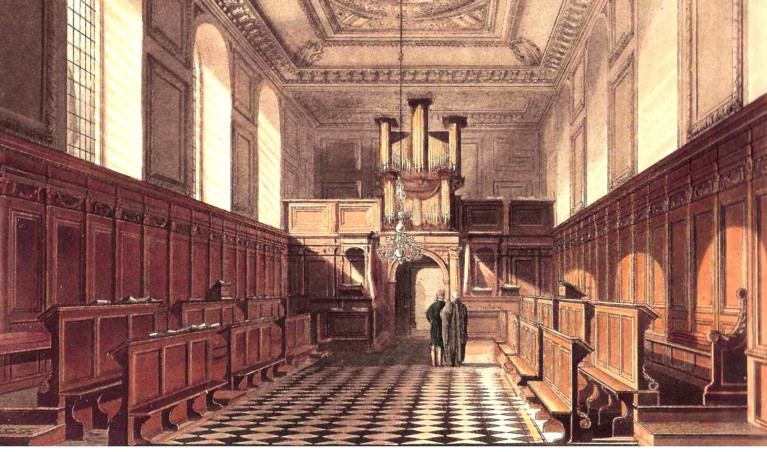
Emmanuel Chapel, 1814. Do the Richardsons lie beneath the marble tiles?
If Ann Richardson was indeed buried in Emmanuel’s chapel, it would have been the first instance of a non-collegiate person (and a woman, to boot) being afforded such an honour, and therefore seems inherently unlikely. The moveable litany desk, beneath which the Richardsons are said to lie, would have been placed in the nave, probably about halfway down. During the 2003-4 works all the marble floor tiles in that area were lifted, without revealing any evidence of a grave. The only way to test conclusively the claim made in Literary Anecdotes would be to excavate the entire floor of the chapel, which is clearly out of the question, at least for such a purpose. As things stand, all that can be said is that while the Richardsons may be buried in Emmanuel’s chapel, the weight of circumstantial evidence is against it.
Amanda Goode, College Archivist
6 September 2023
Autumn is officially here. We are having a few cooler mornings now and the leaves are just thinking about starting to fall. The late summer winds are bringing the first few leaves down and giving us a nod of things to come. As I write this report, the weather has turned warm again and will resort back to summer for one more week.
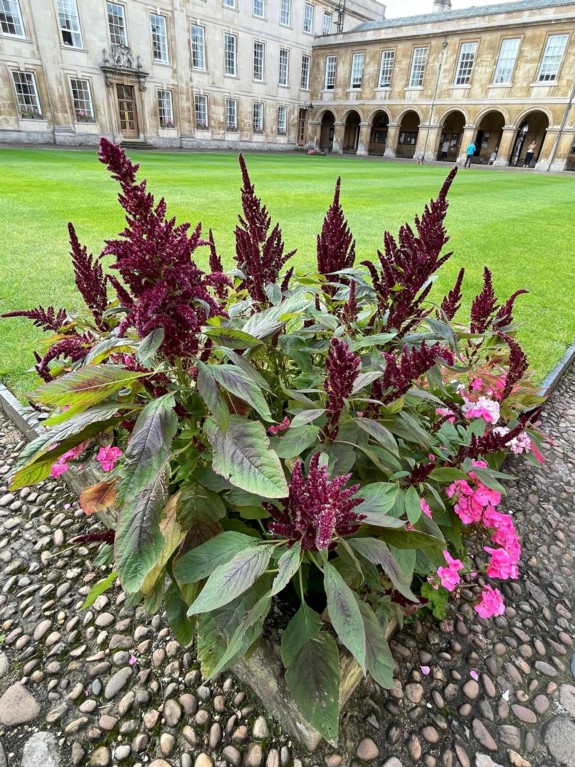
In the last few weeks, the Garden Department has been involved with some inter-collegiate work at King’s College. The now famous large wildflower meadows were due their annual cut-down. This is an event that sees many of the other Cambridge college departments involved. The meadows are cut by traditional methods using a horse-drawn scythe. The meadow hay sits to allow some seed to drop before the horses use another vintage agricultural implement to place the hay into rows. Traditionally, the hay would then be collected on the Haywain. The modern method used now is that the hay is baled using a baling machine.
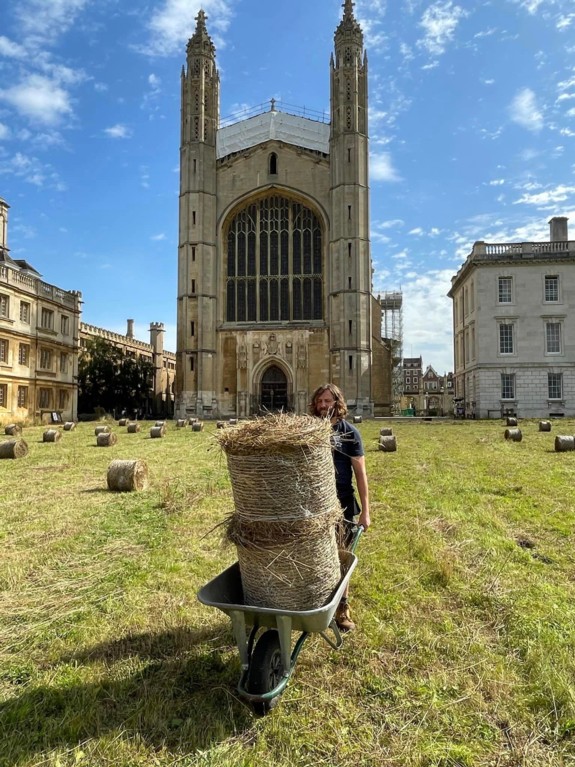
At King’s College, it is estimated that each hay bale contains 1.2kg of wildflower seed. As a reward for being involved with the project at King’s College, Emmanuel has secured four of the hay bales. We can use these hay bales as part of the meadow management in the Emmanuel wildflower meadows.
Recently, we trialled using traditional methods on our own meadows. Two of our gardeners recently attended a scything course. They brought back from the course plenty of enthusiasm and much newly gained knowledge. The meadows at North Court were cut using a traditional Austrian scythe.
This week, we intend to spread out the King’s College hay bales to allow the seed to disperse naturally. With the current cost of wildflower seed being at an all-time high, we calculate that, by using these bales, not only do we share the biodiverse plants that will grow but also save in the region of £1000.
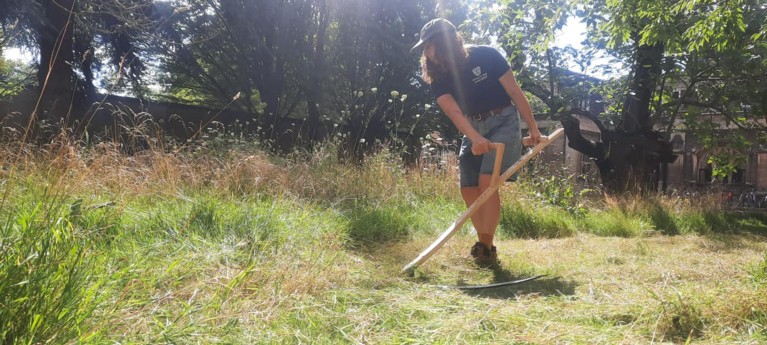
The seeds will fall and mix with our own seeds and that means that the meadow will become sustainable going forward.
The Garden Department has been stretched this year as the growing season has been accelerated by the wet weather. This has shown the plants to be lush and full of growth but has also kept us busy with general plant growth and lots of weeds. The hedges have needed additional trims this year and the grass has needed additional cuts. This is in total contrast to the last growing season. This time last year, we were getting another completely drought-stricken season. It has been nice to enjoy the cooler, damper weather this year.
We look forward now to all the beauty that September will bring. During this month, our latest recruit to the Garden Department, Emily McMullen, will start her period of one year’s training as part of the WFGA training scheme. As excited as we are about Emily’s introduction, it was sad to see Kate Cook finish her year with us. I would like to thank her on behalf of the team for all her hard work and for being a brilliant team member. We wish her well with the next stage of her horticultural journey.
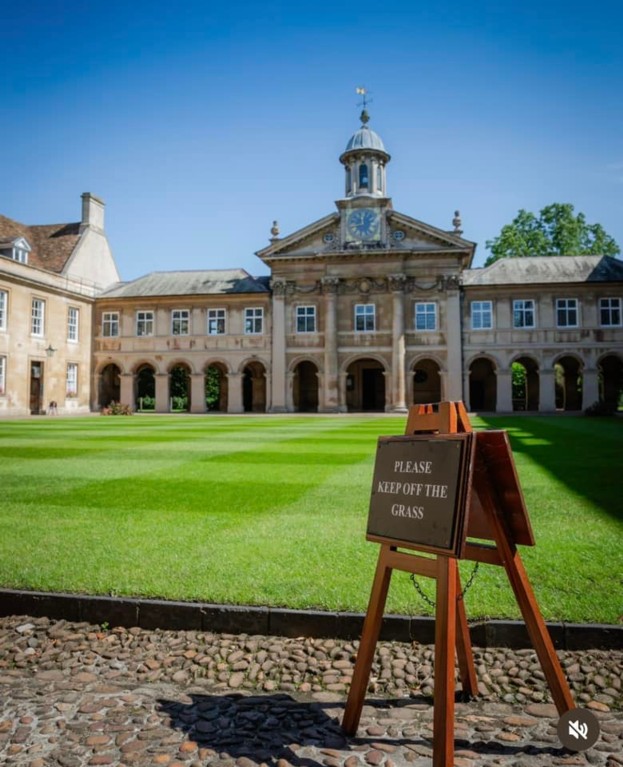
Best wishes.
Brendon Sims (Head Gardener)
6 September 2023
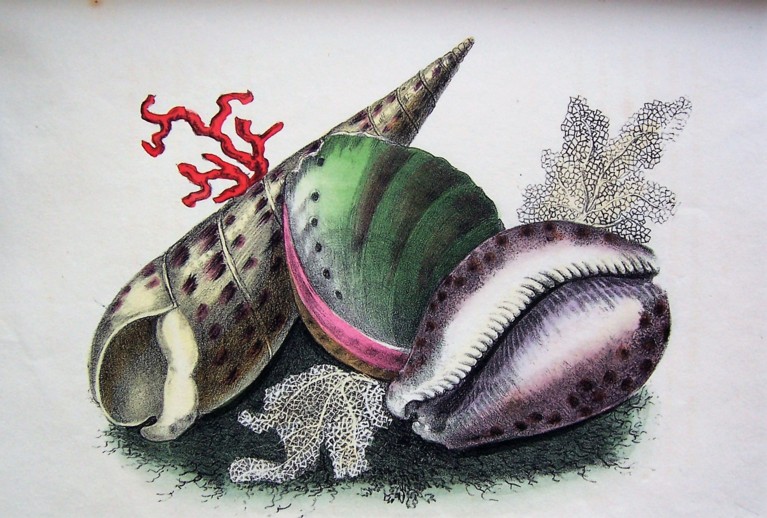
Nathaniel Whittock, The Art of Drawing and Colouring, from Nature, Flowers, Fruit, and Shells (1829)
Before summer memories fade of feeling sand between the toes – and while buckets and spades, the insect repellent and the windbreak are still not stowed away in their long winter storage – it may be the moment to look at the volumes in Emmanuel’s collection of colour-plate books that reflect the British craze for sea shells: for collecting and studying them, but also for displaying them and including them in decorative schemes, both in the garden and in the home.
A fashion for shell grottos and shell houses in gardens (their interiors decorated with shells) was long lasting, and several hundred are thought to survive, although many are in fragile condition. In 1624 James I had a shell grotto under the Banqueting House in Whitehall, but the splendid shell houses at Woburn Abbey (1626) and Skipton Castle (1627) are among the few seventeenth-century examples to survive. The poet Alexander Pope had a grotto with shells in his garden at Twickenham, while later the swirly patterns in many shell forms fitted curiously well with the taste for rococo decoration. Later again, the Misses Parminter, two well-travelled spinster cousins who built the extraordinary A La Ronde House near Exmouth (now a National Trust property), created a gallery decorated with shells that they had collected. Many a house boasted a cabinet displaying a shell collection.
In part the colour-plate books of the late eighteenth and early nineteenth centuries reflect the taste for amateur scientific enquiries pursued by private individuals. Some of the books devote themselves rather grandly to the study of ‘conchology’, a science of shells.
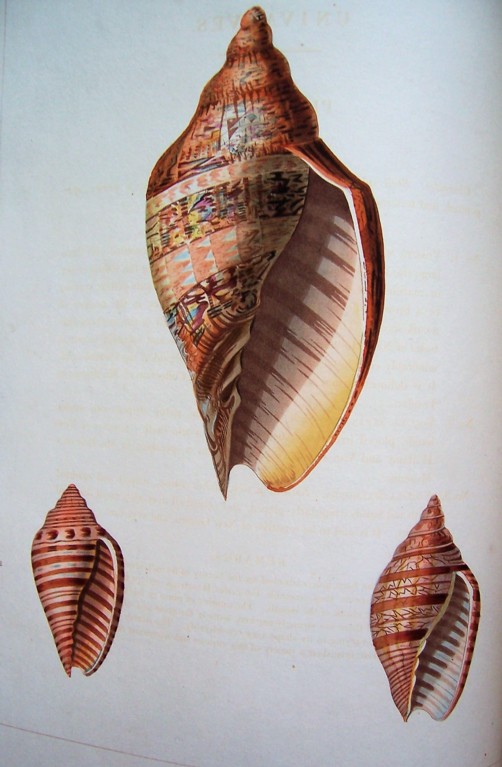
George Perry, Conchology, or The Natural History of Shells (1811). ‘Illustrated by Coloured Engravings Executed from the Natural Specimens and Including the Latest Discoveries’
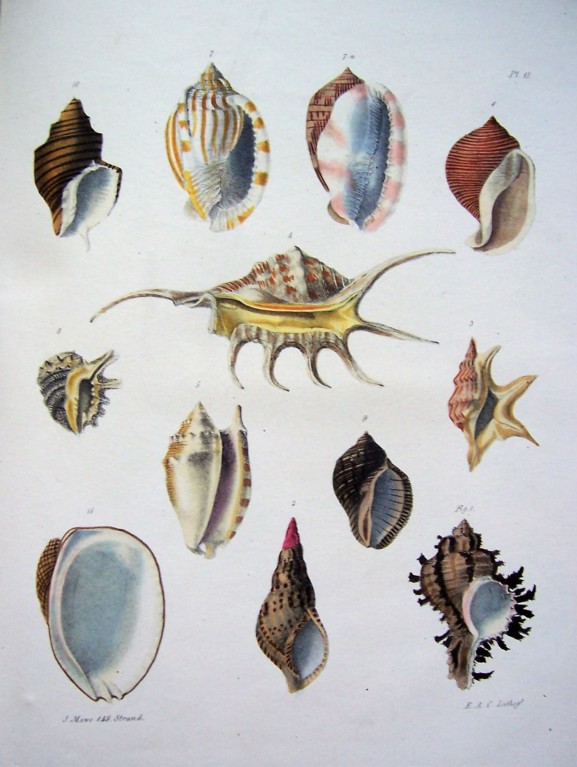
Edmund Crouch, An Illustrated Introduction to Lamarck’s Conchology (1827)
Specimens are grouped on the page for illustration according to their species in the new system promoted by Linnaeus.
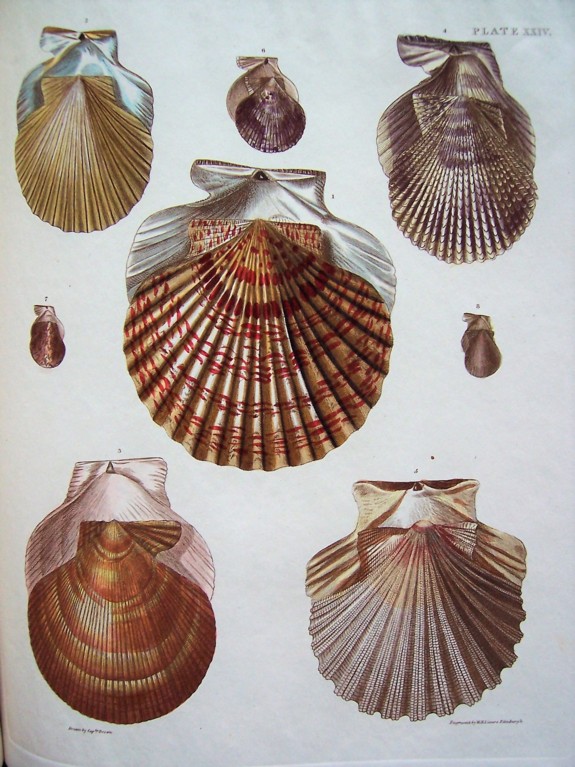
Illustrations of the Recent Conchology of Great Britain and Ireland, Drawn and Coloured from Nature by Captain Thomas Brown (1844)
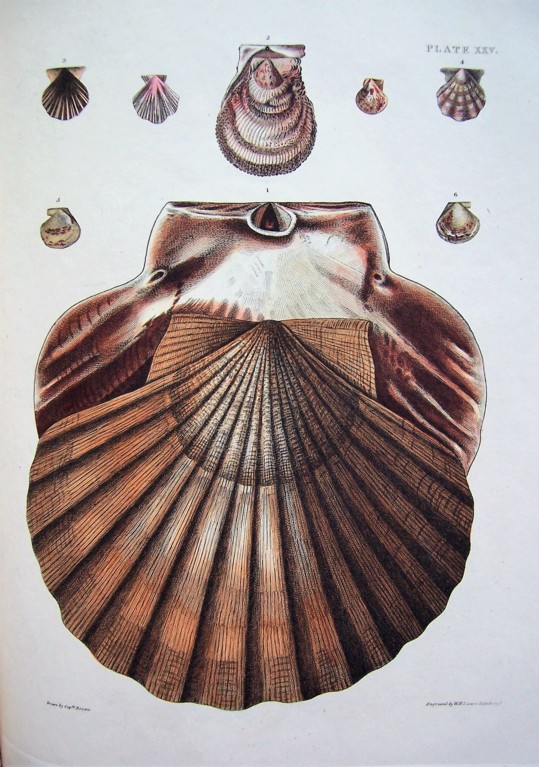
Brown, Illustrations
Each shell is drawn and coloured with a care that comes from meticulous observation.
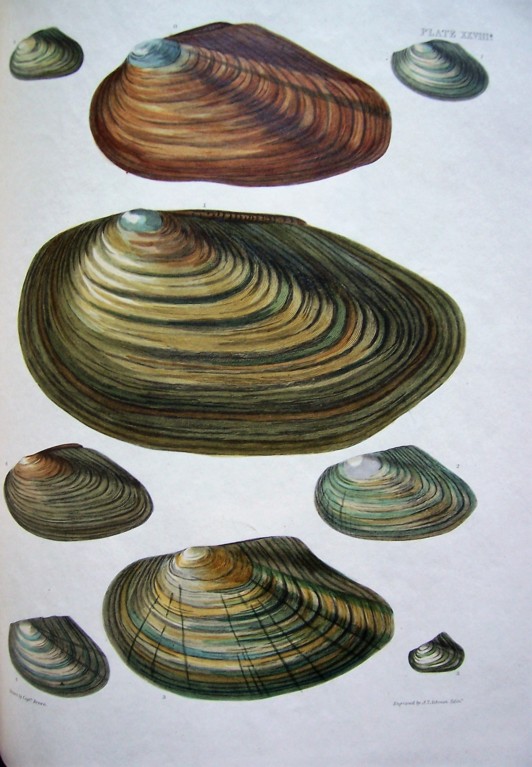
Brown, Illustrations
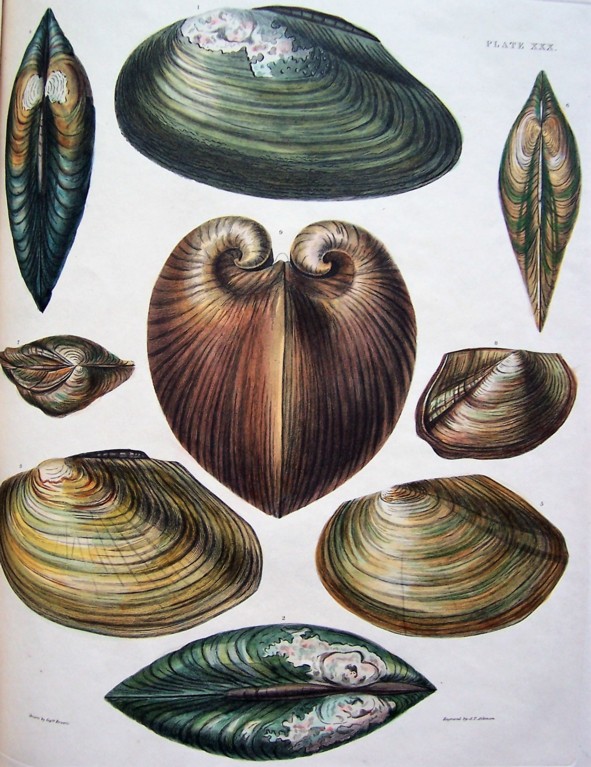
Brown, Illustrations
Yet the intricacy of surface, pattern and colour recorded by such close scientific observation goes along with a keen aesthetic appreciation of the sheer beauty of objects that any interested beachcomber might find scattered on the sea shore, perhaps still bathed with the transient glistening of sea water.
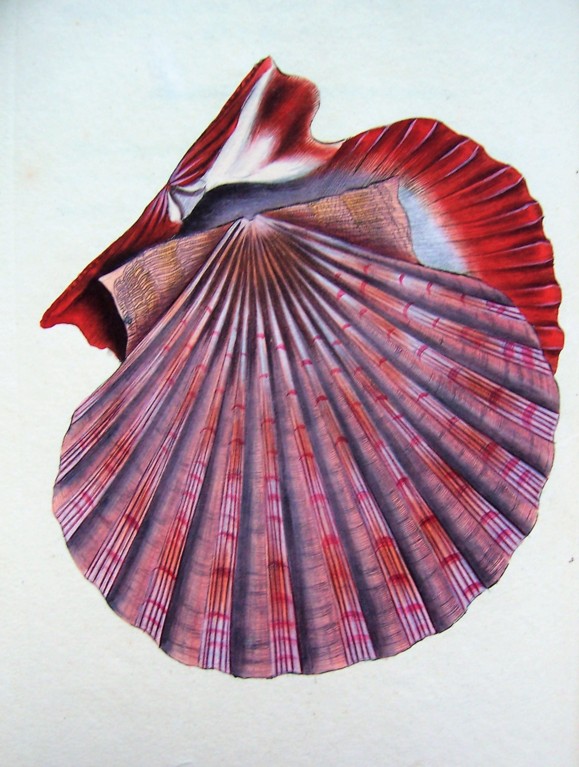
E. Donovan, The Natural History of British Shells, 5 vols (1799). ‘Including Figures and Descriptions of all the Species hitherto discovered
In Great Britain, Systematically Arranged in the Linnean Manner’
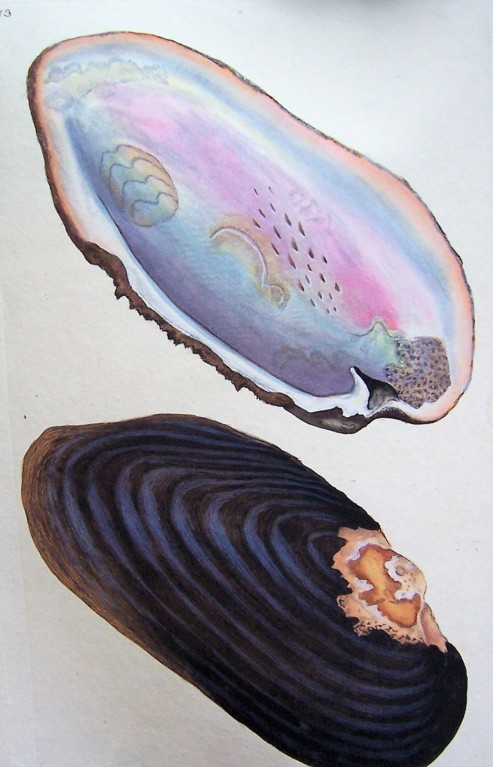
Donovan, Natural History
So, in some of the many colour-plate books of this period that set out to tutor the amateur artist, shells are included along with flowers and fruit as subjects for the water-colourist. In this guide, the same simple composition of shells is included in both uncoloured and coloured form.
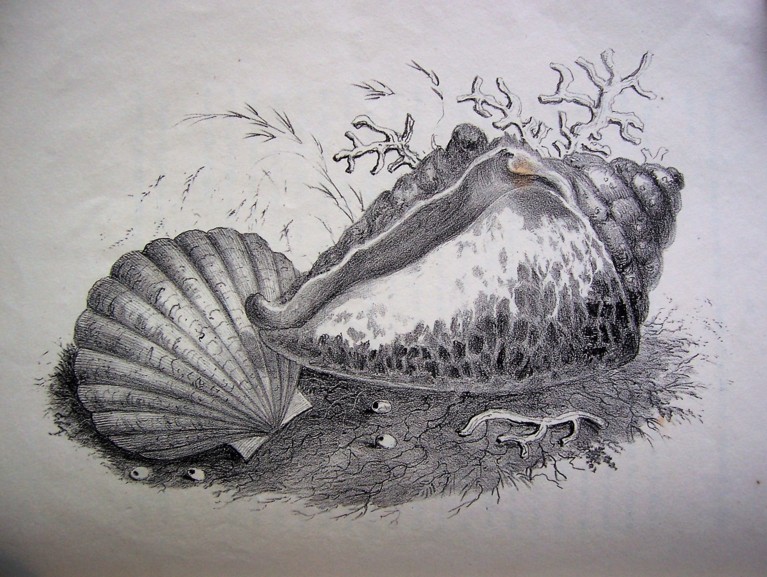
Whittock, Art of Drawing … Shells, ‘With Plain and Coloured Drawings’
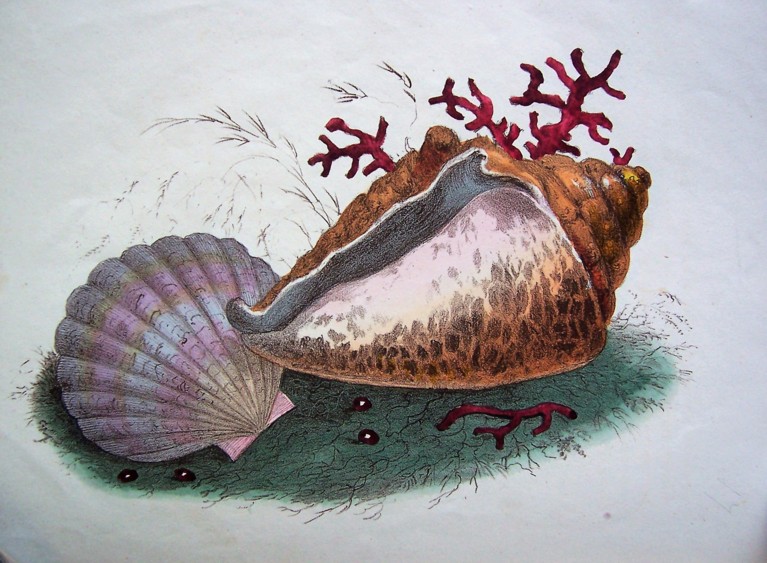
Whittock, Art of Drawing … Shells
The accompanying text provides precise instructions on which named colours from the paint box to apply in order to achieve the effect of the coloured example. Although it was not their intention, these guides for budding artists, with their before-and-after examples, illustrate how colour-plate books themselves were created in layers, where the black-and-white, initially-printed composition, with its shading and hatching, is then coloured by the water-colourist, as in these loving records of collected shells.
Barry Windeatt, Keeper of Rare Books
Images by Helen Carron, College Librarian
2 August 2023
Menu cards for the 1937 dinner at Exeter (left) and the 1938 dinner at Emma (right), with a photo of Professor Richard Dawkins and a note sent from him to Emmanuel’s Bursar
The legendary rivalry between the universities of Oxford and Cambridge is, in truth, a friendly one. A good example of the cordial relationship between the two places is the college twinning scheme, established between the World Wars.
Some of the couplings were between colleges sharing a common factor, such as a benefactor, a founding ethos, or, in the case of Jesus, Corpus Christi and Magdalen(e), a name. Emmanuel was not among the first tranche of pairings, but this was not due to indifference on our part. In March 1937 our Master, Dr Thomas Hele, wrote to the Rector of Exeter College, Dr Robert Marett, to ask whether his college would be willing ‘to enter into the same sort of arrangement with Emmanuel College as already exists between some twelve Oxford and twelve Cambridge Colleges. Professor Dawkins has told me that Exeter College considered this matter in general terms some time ago, and then decided not to proceed further. Perhaps this decision was not final.’ Indeed it was not, for Exeter’s governing body now decided ‘unanimously and enthusiastically’ that the invitation to link with Emmanuel be ‘cordially accepted.’
Although Exeter, founded in 1314, was a much older institution than Emmanuel, the colleges shared one important characteristic: both had been established for the express purpose of producing erudite clergymen. It appears, however, that neither institution was aware of this at the time of their pairing. Dr Hele stated frankly in his invitation that Emmanuel and Exeter could not ‘claim any sort of common ancestry’, and as he implied, the crucial link in 1937 was Professor Richard McGillivray Dawkins. A classicist, Dawkins graduated from Emmanuel in 1901 and was appointed a Fellow three years later. Said to have been the embodiment of the eccentric don of fiction, Dawkins later became Director of the British School of Archaeology in Athens. In 1922 he was simultaneously made a Fellow of Exeter College and an Honorary Fellow of Emmanuel, and it was unquestionably his good offices that brought about the union between his two colleges, even if it took longer than he and Emmanuel had hoped.
Once the Emmanuel-Exeter association had been formally ratified, fraternisation could commence. In early October 1937 a party of Emmanuel Fellows was ‘most hospitably received’ at Exeter. They enjoyed a splendid dinner and were presented with a silver-gilt cup. The atmosphere was informal, the Rector having stipulated black tie rather than ‘full war-paint’. Emmanuel, in turn, invited the Exeter fellowship to a dinner planned for 10 January 1938, but postponed until March, so that Dr Marett could recover from being ‘plastered’ with shot by a young rabbit-hunting friend. Emmanuel emulated Exeter’s generosity by presenting the guests with a silver caudle cup during the dinner, and the Sub-Rector of Exeter, in his letter of thanks for this ‘magnificent gift’, reported that ‘even our Fellows’ Butler, who hates silver as much as a good librarian hates books, is entranced by our new cup…’
In July 1938, Dr Hele attended a Gaudy at Exeter, and a fortnight later a party of Emmanuel staff had a day trip to Oxford, where they met their Exeter counterparts and took them on at bowls, cricket and tennis. Since then, regular contact, involving both senior and junior members, has been maintained between the two colleges. Student socialising reached such a pitch after the Second World War, in fact, that Exeter’s exasperated Sub-Dean asked the Emma authorities to help enforce a crackdown on the number of sporting jollies being arranged. Minor hiccoughs aside, though, the ‘sisterhood’ scheme has brought much benefit and enjoyment to both colleges. Floreat!
Amanda Goode (College Archivist)
2 August 2023
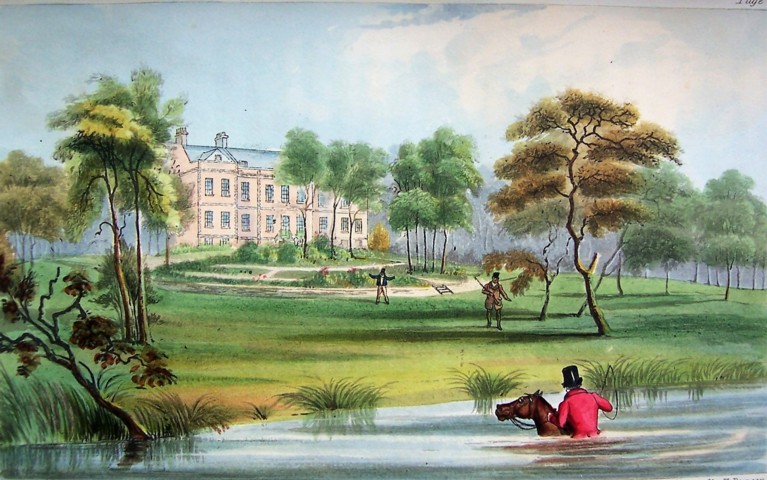
After a day’s hunting, John Mytton takes a shortcut home, straight across the lake (Life of John Mytton, 1837)
Behind the concept of eccentricity is the notion that normalcy and conventionality are at and of a centre, from which the eccentric diverges outside. In Emmanuel’s collection of colour-plate books are a group illustrating the lives of various fictional (male) types, including the squire, the nobleman, the actor, and the sportsman. These lives depict the enjoyably exaggerated but essentially expected characteristics of the bluff squire, the improvident nobleman and so forth.
The Old English Squire (1821) by John Careless views its ‘Jovial Gay Fox Hunter, Bold, Frank and Free’ in a satirical light. Cartoonish faces are coarse-featured and bodies lumpy and graceless, as the dim squire clumsily tries to ape his betters and follow fashion, including going up to Oxford and splitting the seat of his trousers while shooting.
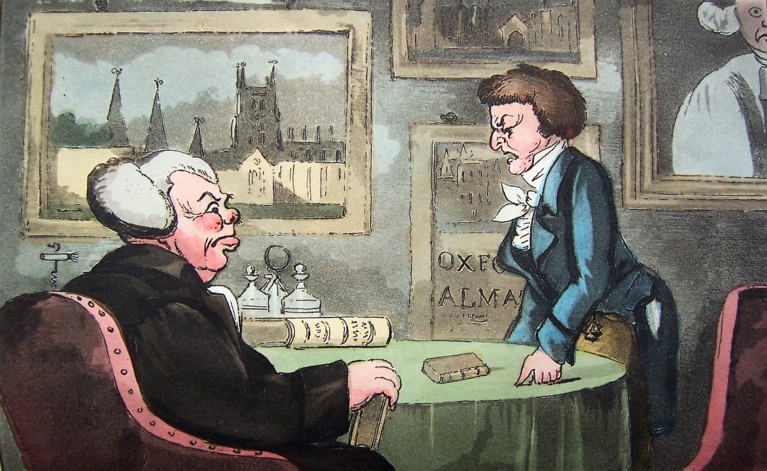
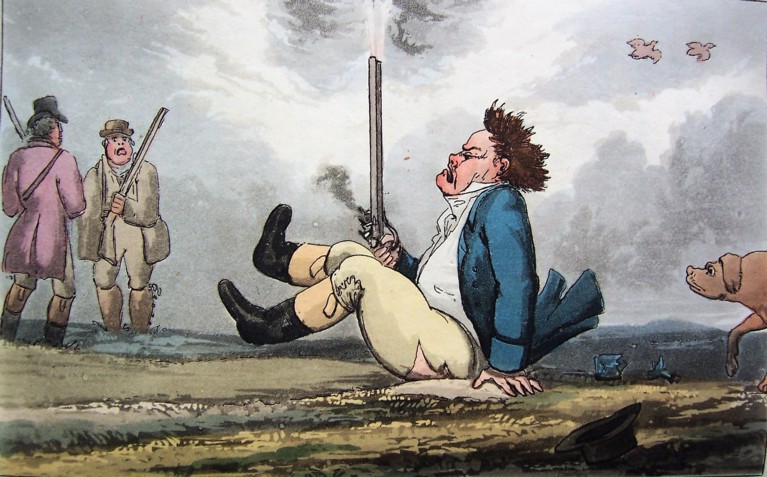
‘Crammed at College by his Tutor for a Degree’ and ‘Meets with a Small Accident’ (both from Old English Squire)
At the other extreme is the chilly elegance of George Dawes’ The Life of a Nobleman (1825), which in three pamphlet picture-books of illustrations charts the decline of a wealthy young nobleman, through plates showing betting at the races, a gambling house, a ‘night house’ or brothel, signing a loan agreement with a (obviously Jewish) money-lender, a duel, and a sickbed.
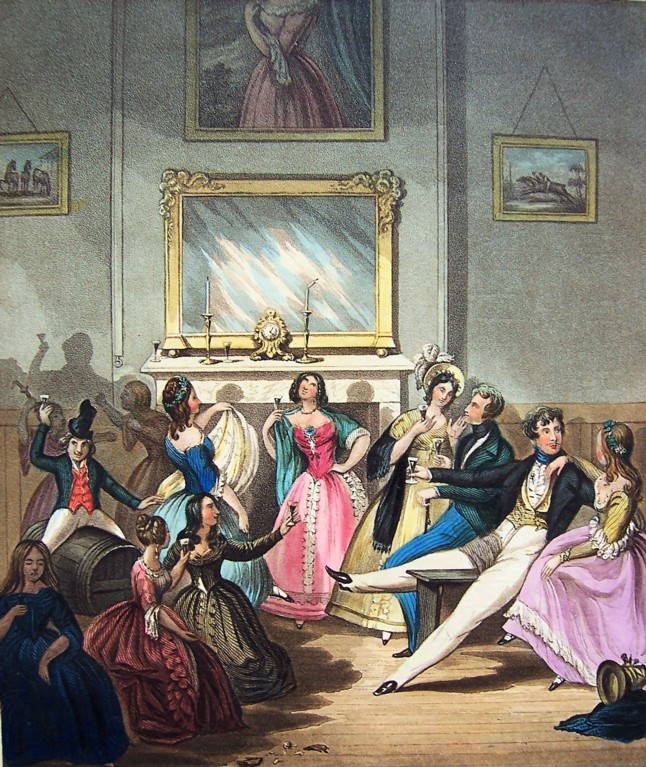
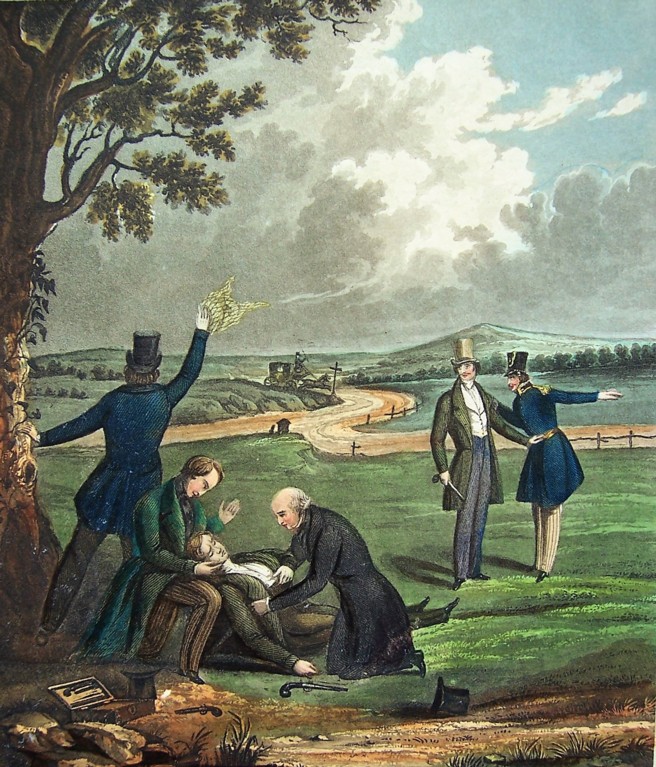
‘The Night House’ and ‘The Duel’ (both from Life of a Nobleman)
What was this book for? Perhaps useful to leave out for perusal by one’s wayward son and heir.
Pierce Egan’s The Life of an Actor (1825) can be realistic, as when depicting the actor manager fixating on his script, oblivious of his tattered shirt and of his hard-pressed wife trying to get the washing dry in a rented room.
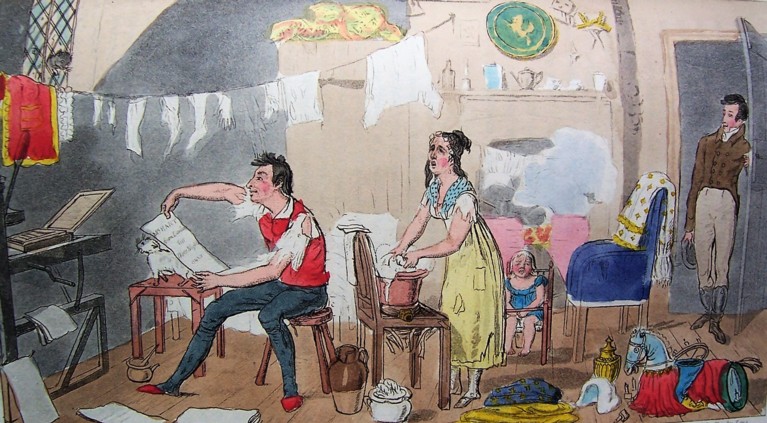
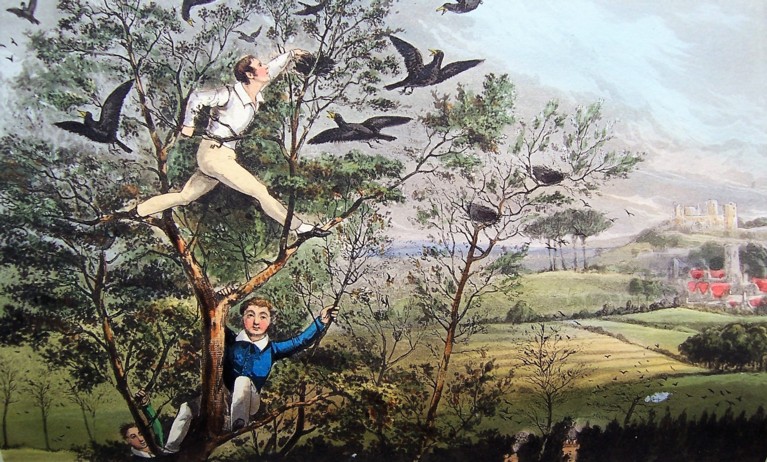
‘The Apartment of an Itinerant Manager’ (Life of an Actor) and ‘Taking Eggs from Rooks’ Nests’ (Life of a Sportsman)
The Life of a Sportsman (1842) is a beautifully illustrated account by ‘Nimrod’, the pseudonym of C. J. Apperley, a celebrity sports journalist of the day. But since most of the sport illustrated is fox-hunting – which may run the risk of offending you, dear reader – a plate showing bird-nesting from rooks’ nests is selected here.
Nimrod chronicles altogether more extreme enthusiasms in his account of a real-life celebrity eccentric, Memoirs of the Life of John Mytton Esq … Eccentric and Extravagant Exploits (1837). Mytton was only two when he inherited estates in Shropshire and Wales. Expelled from Westminster (for fighting a master) and from Harrow, he then terrorized a series of private tutors, leaving a horse in the bedroom of one. Reputedly Mytton took 2,000 bottles of port to sustain him when he went up to Trinity College, Cambridge, vowing to read only the Racing Calendar and the Stud Book. It was a brief stay.
Mytton courted self-destruction, invited and positively enjoyed accidents, played outrageous pranks, and paid no more attention to cross-roads and corners than he did to creditors. He hunted in only the thinnest clothes, hunted wild fowl through snow in his shirt, and once hunted ducks over the ice while stark naked. While driving someone in a gig (a fast light vehicle) and learning that his companion had never been in a gig that overturned, he deliberately overturned the gig (‘What a damn slow fellow you must have been all your life’).
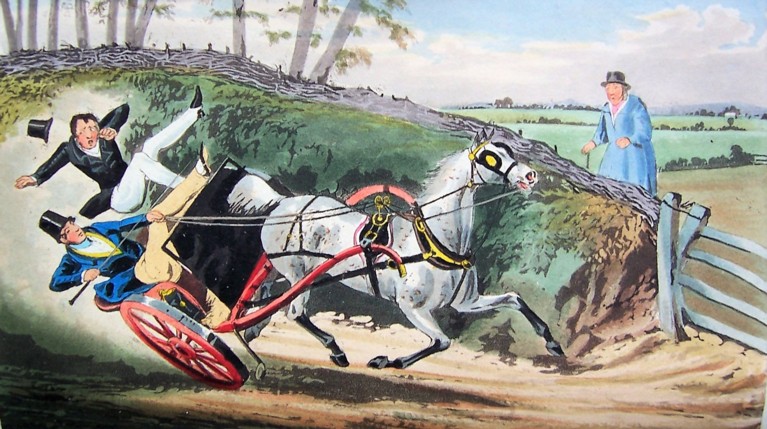
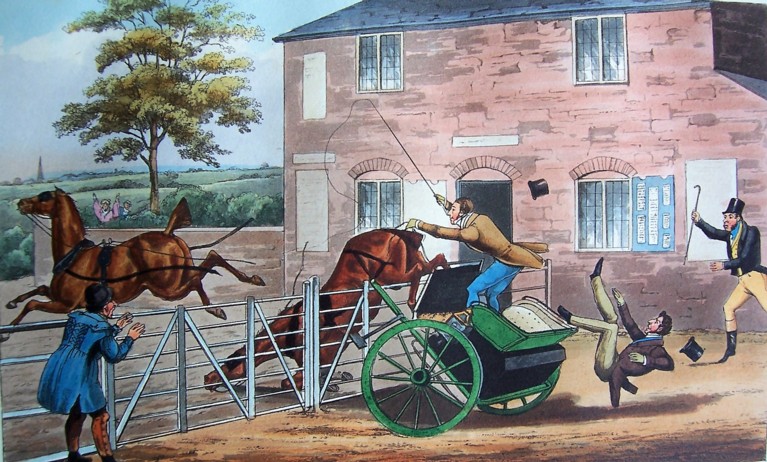
‘What? Never upset in a gig?’ and 'I wonder whether he is a good timber jumper!’ (both from Life of Mytton)
When driving horses tandem (one in front of the other) he tried to make them jump a closed turnpike gate – with predictable mayhem as the result.
Mytton once rode into his own dining room astride and spurring his pet bear (which bit him viciously in return). He also plunged into the Severn and swam across.
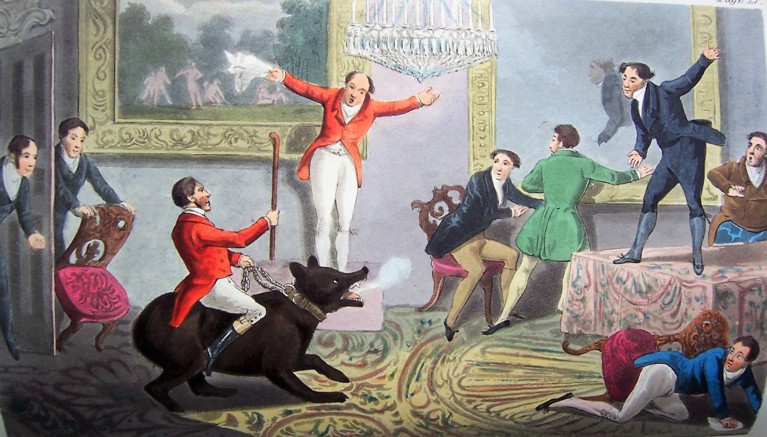
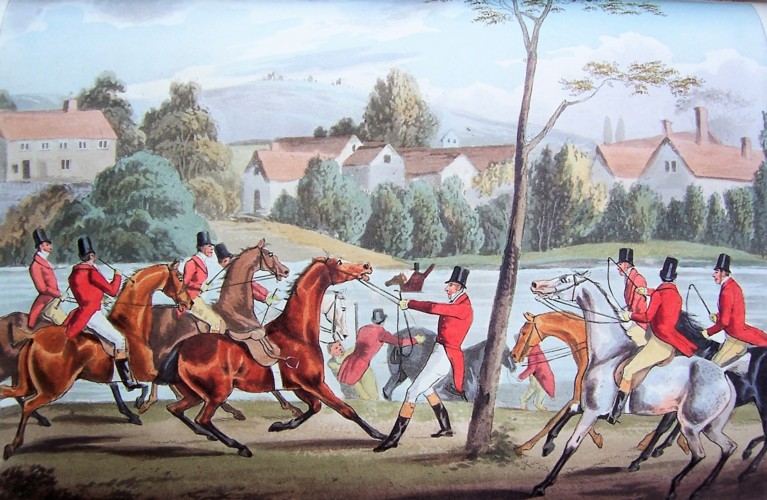
‘A New Hunter! Tally Ho!’ and ‘He that calls himself a sportsman, let him follow me’ (both from Life of Mytton)
In order to win a bet, he rode his horse up the grand staircase of a hotel in Leamington Spa and then horse and rider leaped from a balcony into the street below. His favourite horse Bayonet had the run of the house and would lie down in front of the fire with Mytton, who declared he did not believe in a heaven from which animals were excluded. Mytton’s first wife died after two years; his second ran away after ten years.
‘A perfect stranger to the science of economy’, Mytton disdained managing money and was open-handedly generous, probably running through a fortune of £20,000,000 in today’s money. Several thousand pounds once blew out of his carriage window as he drove back from the races. He spent around £750,000 in today’s money handing out banknotes to voters in order to be elected MP for Shrewsbury in 1819, but found the House of Commons too boring to stay for more than thirty minutes. He thought nothing of driving home at night across country rather than by the roads, and, when plagued by a persistent hiccup, Mytton madly decided to ‘frighten it away’ by setting light to his nightshirt. The hiccup stopped, but Mytton was badly burned.
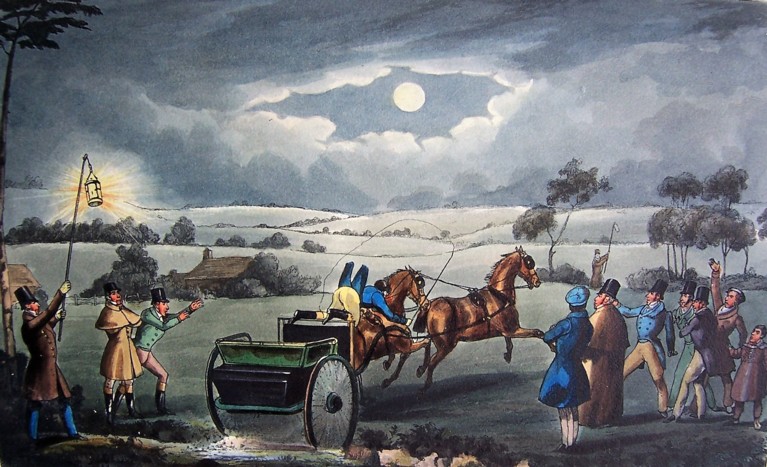
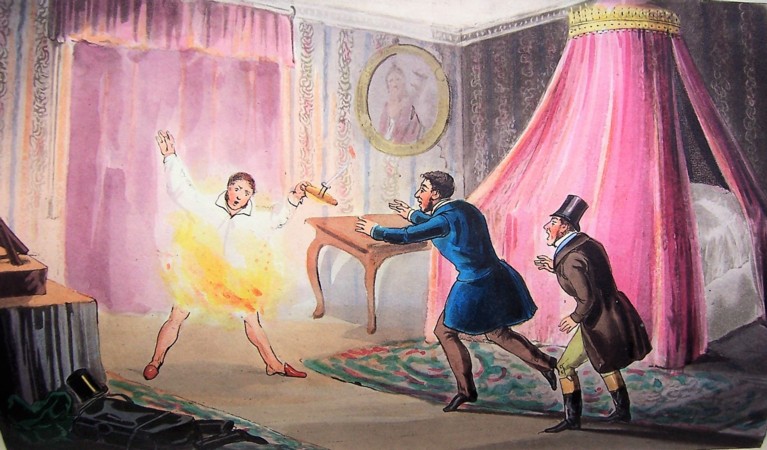
‘How to cross a country comfortably after dinner’ and ‘Damn this hiccup!’ (both from Life of Mytton)
Mytton looms large as ‘this half-mad, hunting hunted creature’ in the pioneering study The English Eccentrics (1933) by the poet Dame Edith Sitwell (herself a considerable eccentric in her day). Yet ninety years later a more serious diagnosis than eccentricity might seem more appropriate today. Mytton died of delirium tremens aged 38 in the King’s Bench debtors’ prison in Southwark, having lost everything but his friends. Depending on reports, two or three thousand people attended his funeral. Streets, roads, a pub, a hotel, and a 72-mile bridleway through beautiful countryside are named after him in Shropshire.
Barry Windeatt (Keeper of Rare Books)
Images by Helen Carron (College Librarian)
2 August 2023
As I am writing this blog entry, the rain continues to pour down. Be careful what you wish for. This time last year, the gardens were brown and frazzled. Skip forward twelve months and the gardens are green and lush. At a time when most people really want warm and sunny weather for weddings and garden parties, the temperatures have been down and we have just seen the wettest July on record.
This has been a help and a hindrance to the Garden Department. It has generally meant less watering, which is always a good thing. The downside to the wet and mild weather is the fact that everything grows twice as fast. This has resulted in the department chasing our tails this year. This should be a time when the gardens slow down a bit – fewer grass cuts, a little less hedge trimming and generally a lot less weeding.
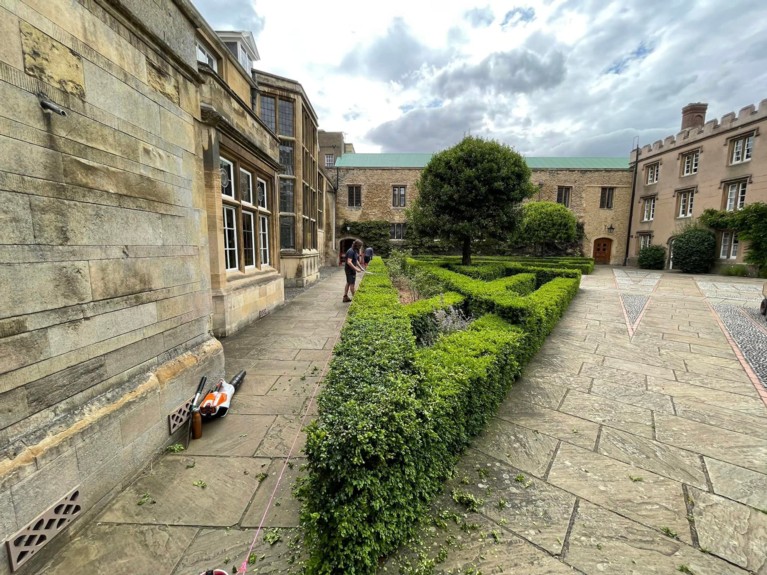
The last few months, though, have been even busier than the norm as well. We managed to get the landscape planting done in time for the Emma enables celebration (just). This was a huge effort from all the team as the delays to the building project had seriously held us back. I think the finished project is a huge improvement from the empty planting beds. It really softens the architecture, as beautiful as that is.

July has also seen some well-needed tree work done to the more mature trees. This was to remove the deadwood and will enable to keep visitors safe from the risk of falling branches. The most notable work was done on Emmanuel’s great oriental plane tree. A large amount of dead wood was removed. Work was also carried out in North Court, Park Terrace, Chapman’s Garden and in the bike sheds.
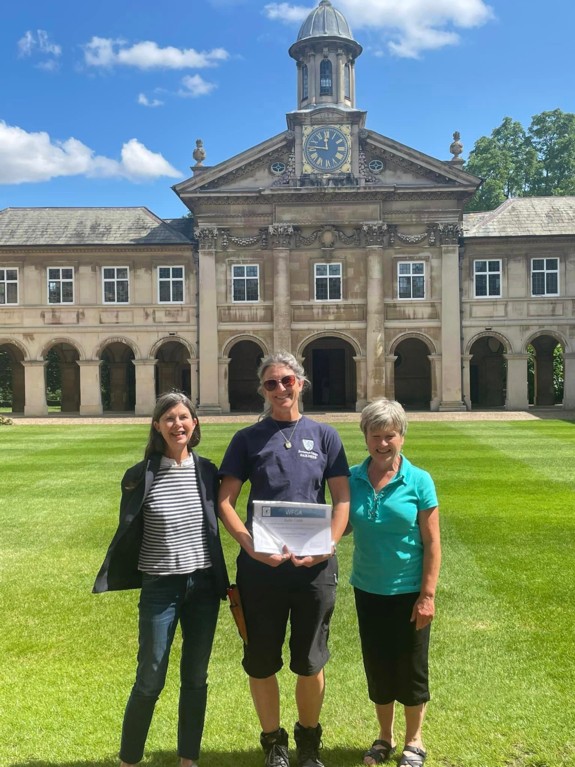
August sees the departure of one of our staff. Kate Cook has completed her one-year WFGA placement with us. Kate has been a huge help this year. Her attitude was always first class as she completed her course. The team will miss Kate and wish her luck in the future. We have selected this year’s WFGA candidate, and she will start in September. More news on that to follow in another edition.
Best wishes.
Brendon Sims (Head Gardener)
5 July 2023
June has been and gone in a flash. It has been a very busy period for the Garden Department. We have had many of the college calendar events to prepare for, and in what turned out to be the hottest June on record.
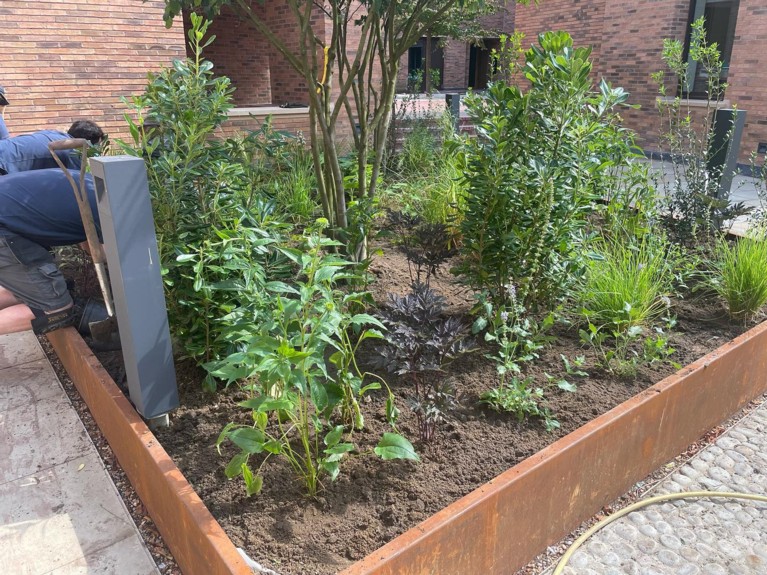
The gardens are looking full and in flower at the moment, which has been a hard thing to achieve, but generally I am pleased with the results. We are a little behind on the tasks from where I would like to be at this moment in time but there is nothing we cannot sort out. We have been busy spinning many plates and have just about been able to keep them spinning.
The month saw the June Event Ball, which involved a large event tent on the front court lawn. Only 48 hours later the final of the Cupper’s Croquet was played on the Front Court lawn. This was a huge undertaking to prepare the lawns for these events and I am immensely proud of the Garden Department for making this happen.
Then we had to prepare the Front Court for Graduation - a tight turnaround but just about achieved. We achieved all this whilst pushing for the new build landscaping to be resolved. We finally got the answers we were hoping for and, with delays of around six months, we were able to commence the landscaping. The delays were beyond the control of the college but hopefully we are now making progress as we head towards our next target, which is the preparation for the 'Emma enables' event on 8th July.
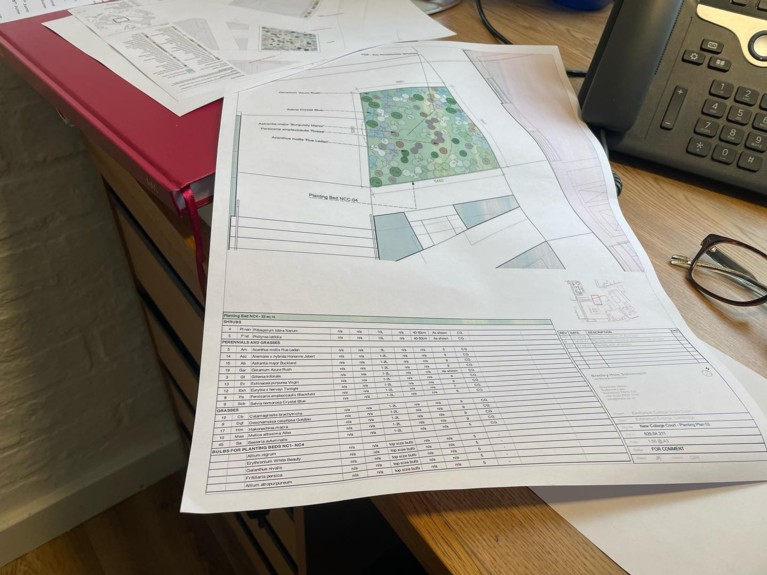
In other works, around the garden, we started cutting down the spring meadows around the college. Although these meadows looked tired, the colours from the bulbs and annual wildflowers looked great this year. It is essential to leave at least six weeks after flowering to cut these meadows down but that falls in the exam period. We were happy to get them done in the end and now look forward to next spring's display. This task also clears under the plane tree in the Fellows' Garden.
Some notable highlights this year in the spring meadows included the return of the bee orchids. A beautiful sight to see, and still quite rare.
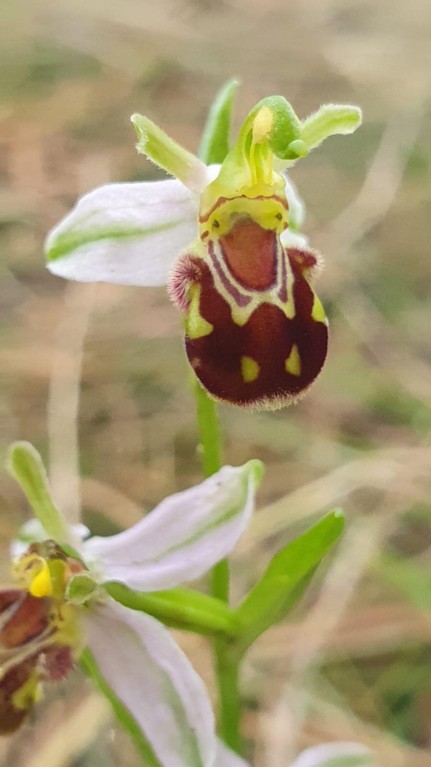
In other department news, we had Izzie Hare and Douglas Day complete their pesticide license training. Although the use of chemical spraying is something I discourage, it is still required by law to hold a license to apply. I have made a commitment to reducing all spraying within the college, but it is good to know that we will be looking to keep people safe when we do spray.

The summer college meadows in North Court continue to thrive and many insects and pollinators are seen in these areas. Biodiversity is a key agenda within the college and I am pleased we are contributing so well with our objectives. This year, with the help of students, we had sightings of hedgehogs and also built yet another insect hotel as positive achievable things to increase biodiversity.
All in all, a busy but proactive spell within the gardens. Well done, Garden Team!
Best wishes.
Brendon Sims (Head Gardener)
4 July 2023
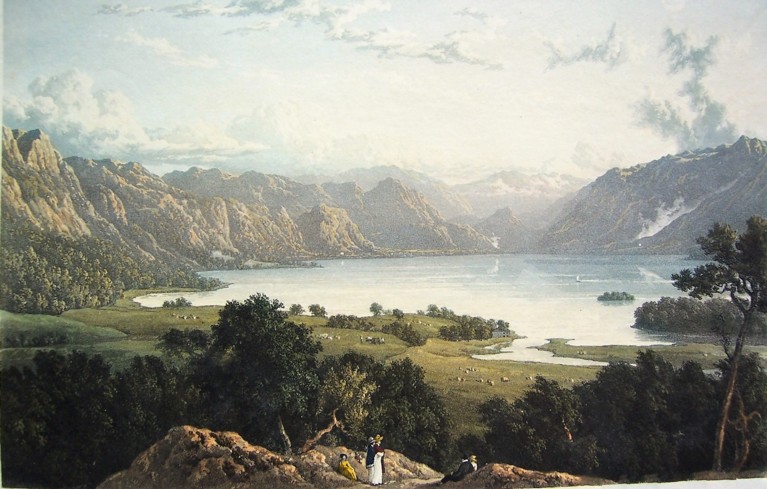
‘Keswick Lake (i.e. Derwentwater) from the north side of Castlelet’; William Westall, Views of the Lake and of the Vale of Keswick (1820)
Of all English scenery, that of the Lake District enjoys a unique esteem and, thanks to Graham Watson’s own love of the Lakes, the collection of illustrated books that he presented to Emmanuel includes a remarkable concentration of books recording the beauties of the Lakes, as well as a comprehensive range of guidebooks from the nineteenth and twentieth centuries. In what follows, the focus is on the depiction of the Lakes in the earlier years of Lakeland tourism, when the new process of aquatint enabled armchair travellers to savour scenes of natural beauty presented with fresh accuracy and sensitivity to colour, light and shade.
Writing before 1727, Daniel Defoe – author of Robinson Crusoe – could dismiss Westmorland as ‘a country eminent for being the wildest, most barren and frightful of any that I have passed over in England, or even in Wales itself’, and such had long been the general view of those ‘wild places’ of the island of Great Britain that are nowadays so treasured and protected. But a growing fashion for admiring picturesque scenery became within a short time the universal vision of the educated classes and changed perceptions of the Lake District for good. From the 1750s tourists visited the Lakes to enjoy the scenery, seeing their journeys as progress through a succession of pictures. As a tourist, one had to stand in the right place, or ‘station’, to attain the best view, and guides to such stations soon proliferated, blithely plagiarizing from each other – fifteen in the last quarter of the eighteenth century alone. A cult was born.
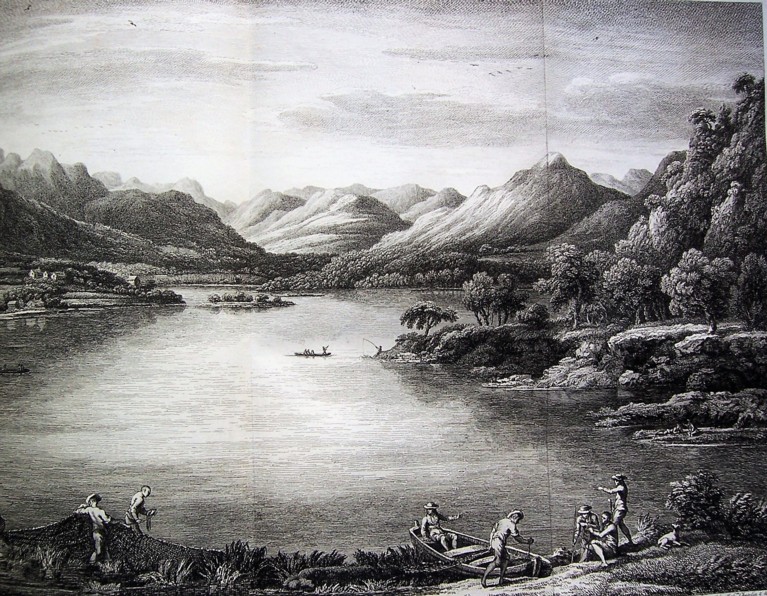
‘A View of the Head of Ulswater towards Patterdale’; William Bellers, Eight Views of the Lakes in Cumberland (drawn in the 1750s, republished 1774)
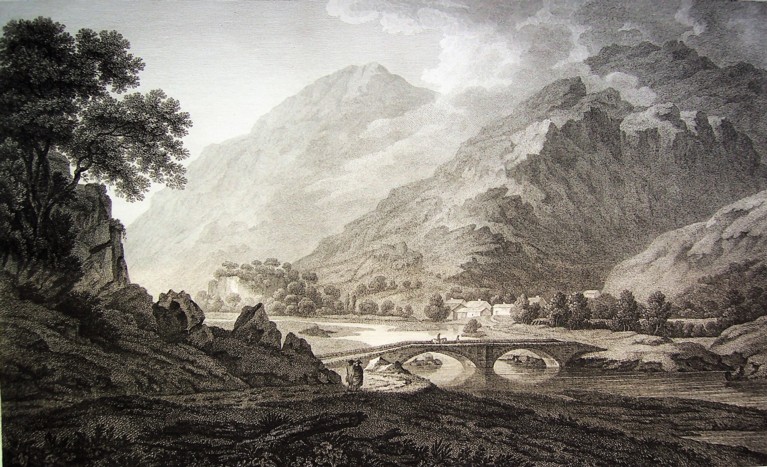
‘The Grange in Borrowdale’; Joseph Farington, Views of the Lakes (1789)
Early depictions of the Lakes were made by William Bellers in the 1750s, in awareness of picturesque conventions of seventeenth-century landscape painting in Italy. One of the earliest illustrated books about the Lakes is Joseph Farington’s uncoloured Views of the Lakes (1789), with descriptive text probably by Wordsworth’s uncle William Cookson. Farington’s views are notably typographically accurate, with no tweaking to appear more picturesque and were made from copper plates etched and engraved in the conventional way. One early exercise depicting the Lakes in aquatint is Select Views of the Lakes (1792), published in Liverpool by Peter Holland, a Liverpool artist about whom little is known. Also atmospheric are John ‘Warwick’ Smith’s Views of the Lakes (1791-5).
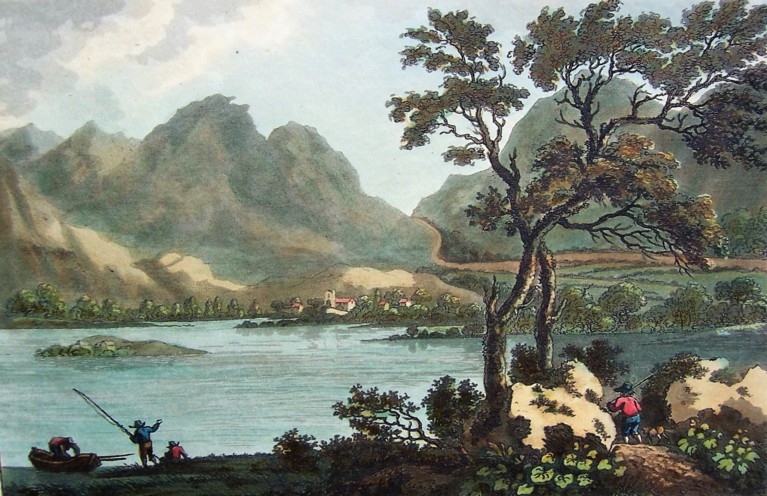
Peter Holland, Select Views of the Lakes (1792)
‘Rydal Water’; John ‘Warwick’ Smith, Views of the Lakes (1794-5)
Three ambitious colour-plate books on the Lake District, illustrated with aquatints, appeared within three years. William Westall was both artist and engraver for Views of the Lake and of the Vale of Keswick (1820), with text by the poet Robert Southey. (Keswick was an early centre and focus of the Lakeland cult). Westall’s attempts to convey distance, and how colour fades away eerily at twilight, are fine examples of what might be achieved in aquatint during its heyday.
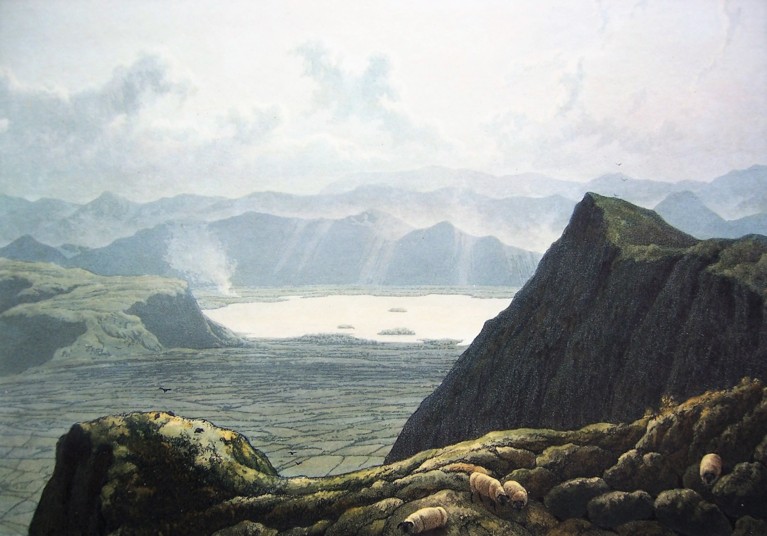
Westall, Views: ‘Keswick Lake from Saddleback’
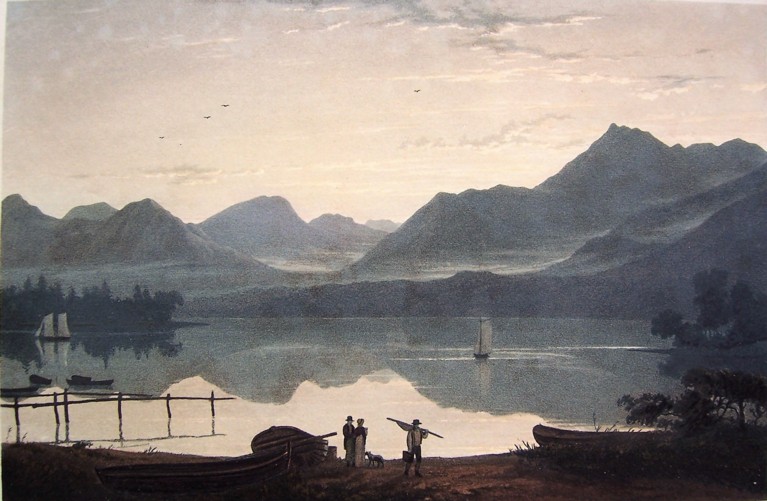
Westall, Views: Keswick Lake from the east side, at twilight
The two other books were T. H. A. Fielding’s A Picturesque Tour of the English Lakes (1821) and his Cumberland, Westmoreland and Lancashire Illustrated (1822).
Like Westall, Fielding was his own engraver, worked largely if not exclusively from his own drawings, and probably wrote the accompanying descriptive text himself.
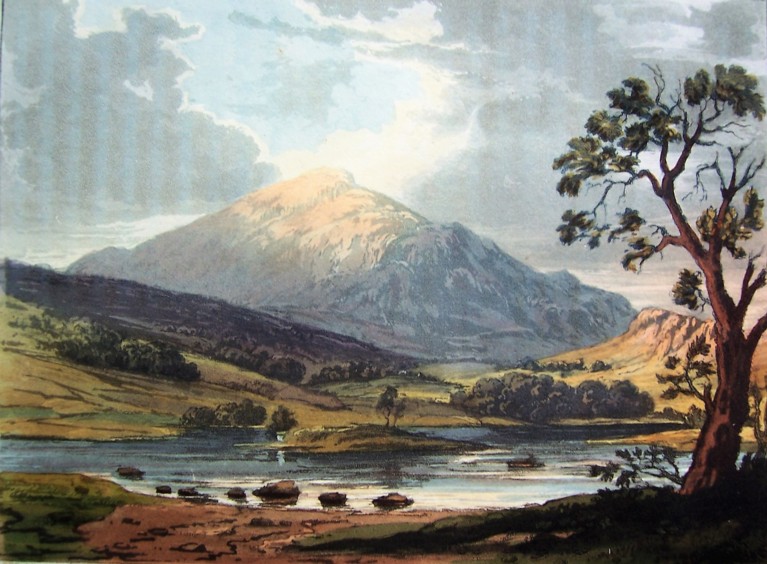
‘Grasmere’; T. H. A. Fielding, A Picturesque Tour (1821)
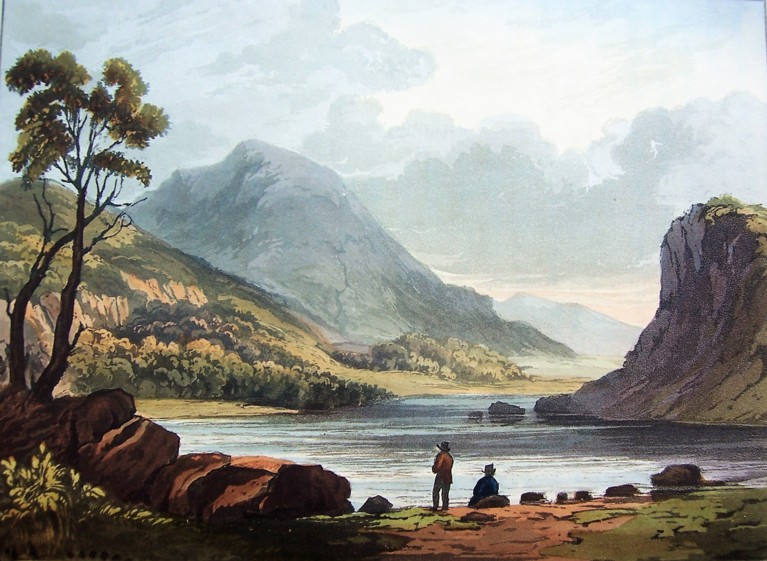
‘Wyburn Water and Helvellyn’; Fielding, Picturesque Tour
And like any artists working in the Lake District, both Fielding and Westall necessarily developed an eye for depicting impending rain.
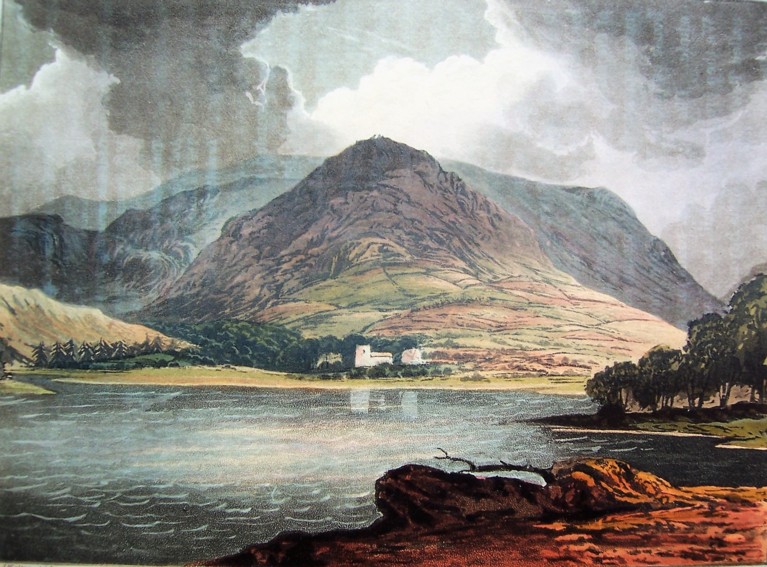
‘Grasmere Church and Helm Crag’; Fielding, Picturesque Tour
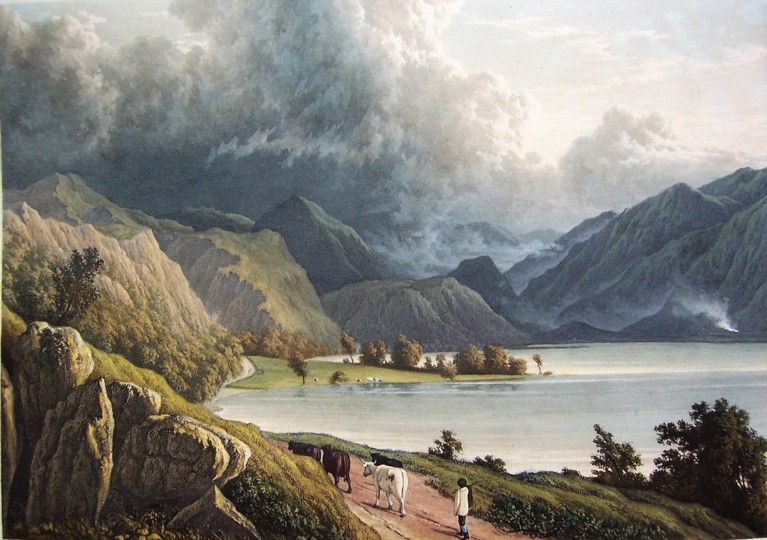
Westall, Views: ‘Keswick Lake from Barrow Common’
As we look at these depictions, it is helpful to recall that while the views may appear timeless, the experience of tourism could be focussed differently in different times. Not least because many modern routes in the Lake District did not yet exist, early tourism was different to what it became. Tourists largely stuck to the valleys and would ride more than walk. For a while the fells remained unroamed and the mountains unclimbed. One early fad of the picturesque was the enjoyment of ‘echo tourism’, savouring the sound effects of echoes artificially created. At Ullswater the Duke of Portland had a barge with six cannons, so as to enjoy the reverberations rolling through the valley, and the sounds of French horn, bassoon and clarinet heard across the water of the Lakes were also sought out by tourists, long before pursuit of the echo gave way to pursuit of the eco.
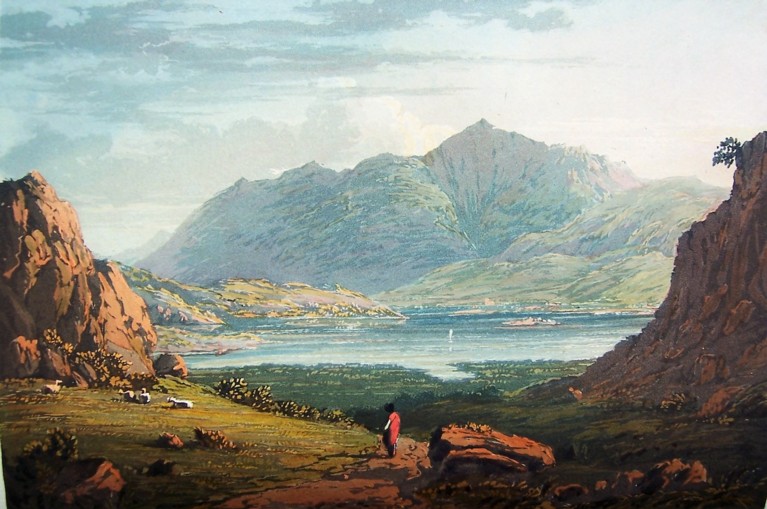
‘Skiddaw over Derwent Water’; Fielding, Cumberland … Illustrated (1822)
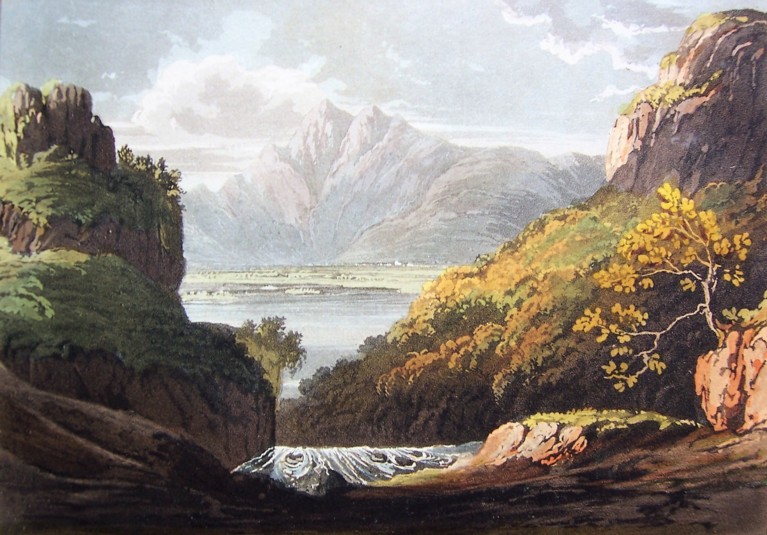
‘Skiddaw, from the Head of Lowdore Fall’; Fielding, Picturesque Tour
Such was the fashion for accounts of the Lakes that anything mentioned in print might suffer problems of unsought celebrity. In his A Fortnight’s Ramble to the Lakes (1792) Joseph Budworth glowingly described the beauty of Mary Robinson, fifteen-year-old daughter of the landlord of the Fish Inn in Buttermere – and she promptly became a tourist attraction. Uneasy at the bother he’d caused, Budworth then published an account (rather ironically in The Gentleman’s Magazine) of how he had revisited Buttermere and informed Mary: ‘You are not so handsome as you promised to be; and I have long wished by conversation like this to do away what mischief the flattering character I gave of you may expose you to.’ Too late, alas – before this was published, poor Mary married someone passing himself off as ‘The Hon. Alexander Hope’, actually John Hatfield, a notorious imposter and bigamist, who would be hanged for forgery at Carlisle in 1803. The tragedy of ‘The Maid of Buttermere’ was endlessly recounted, becoming a novel and a melodrama on the London stage. In Italy it would surely have become a bel canto opera.
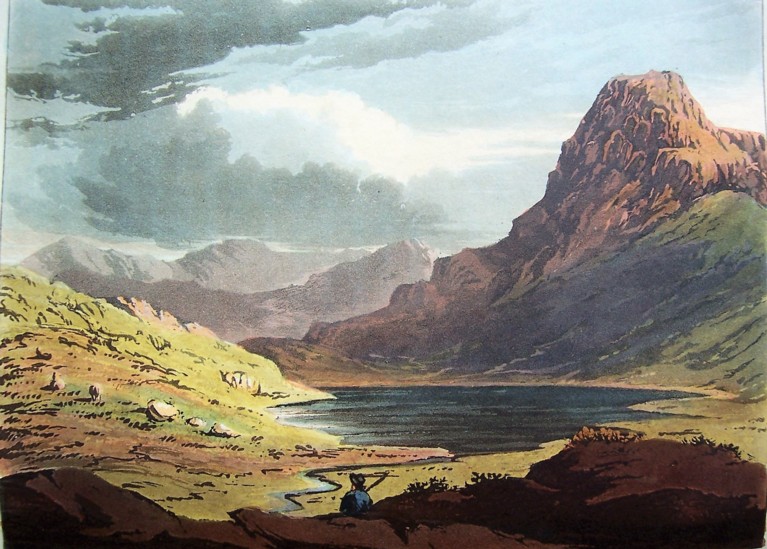
‘Stickle Tarn near the top of Langdale Pikes’; Fielding, Picturesque Tour
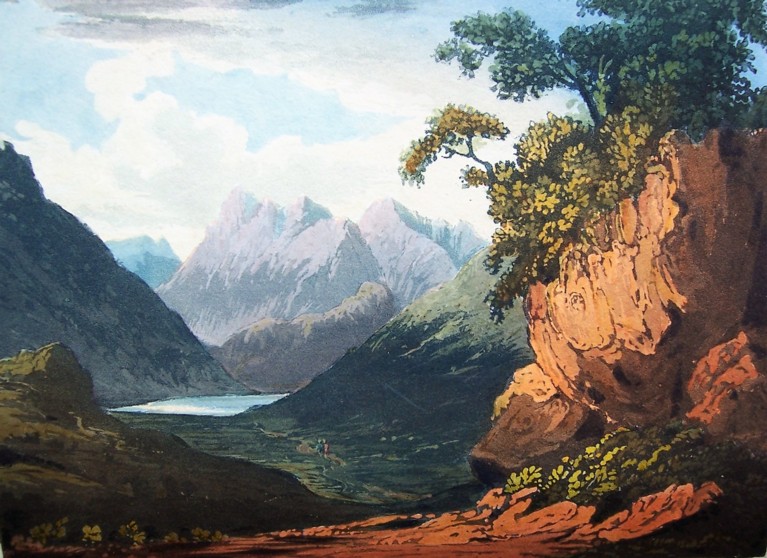
‘Blea Tarn’; Fielding, Cumberland … Illustrated
After 1830, engraving on steel rather than copper enabled the proliferation of images of the Lakes, and numerous guidebooks would be regularly produced.
If you are planning to visit Emmanuel this Saturday, 8 July, you may be interested to know that Dr Helen Carron has curated an exhibition of Lake District books which are on show in the Graham Watson Room and the Library Atrium.
Barry Windeatt (Keeper of Rare Books)
Images by Helen Carron (College Librarian)
7 June 2023
June has arrived fast. The weather has teased some sunshine but, this year, the consistency expected just has not been there. The garden borders are very full and green but the sunlight levels have been only a third of what is usual. At some point, this will catch up but what it does mean is that the flowers are late appearing. The plants' health is good, which is a result of lots of early rain, but the beds have benefited from the added nutrition of compost.
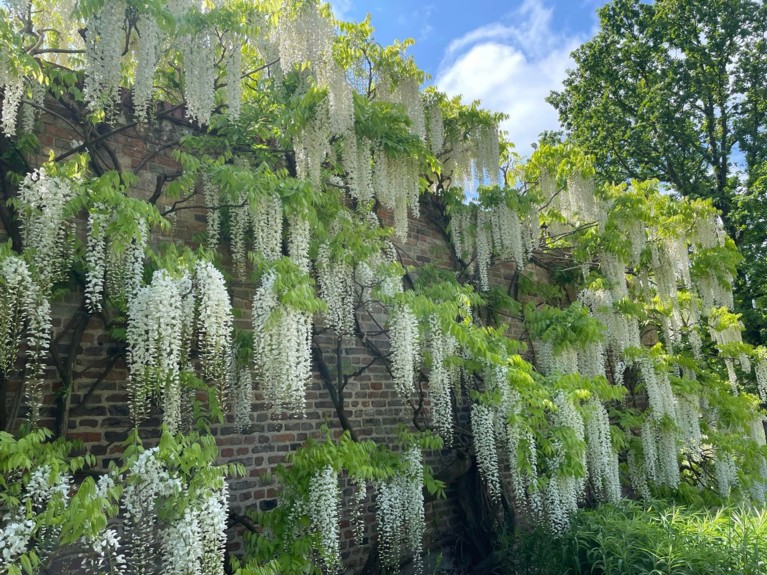
It is this time of year that the Garden Department asks for some patience. It is extremely hard to get the gardens immaculate during the quiet period for exams. It often means that we can only make noise for about one hour per day. There is lots of juggling around jobs and some things that we would normally manage sometimes have to be left. It is, however, a very peaceful environment and I encourage as many students as possible who are studying hard for exams, and staff, to take full advantage of the tranquil environment. There is lots of science to suggest that being in a natural green environment can significantly reduce stress levels.
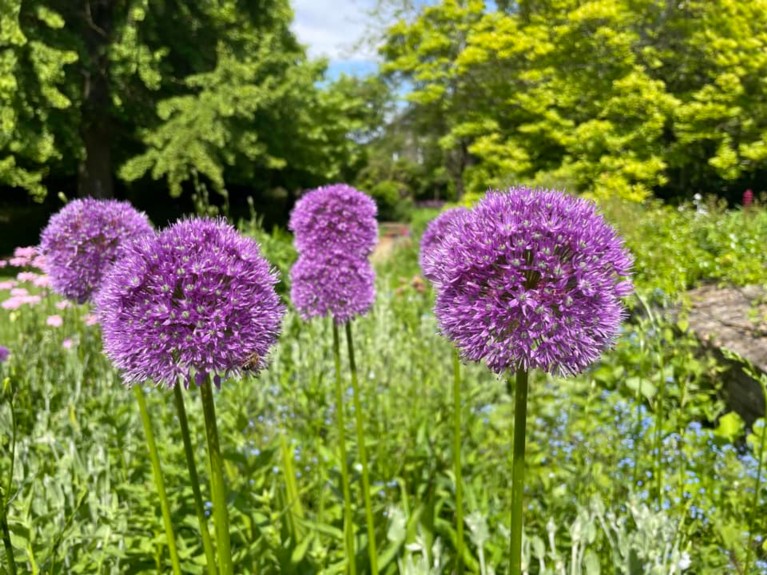
The meadows in North Court are beginning to flourish and will continue to improve as the summer progresses. In an area that formerly was just another closely cut piece of lawn, wildflowers now add colour. The real reason that the meadows were introduced, though, is to increase biodiversity and increase the volume of insects, bees, butterflies, and other invertebrates. In a recent study on King’s College Meadow, it was proven that its wildflower meadow attracted three times the volume of visiting insects against an area of normally managed grass. It was also proven that, on average, the average size of insect was larger. It is so important to enable these insects and pollinators to thrive in such an urban environment as where Emmanuel College is located. The general level of insects across the world is in serious decline. This is just another example of how Emma enables.
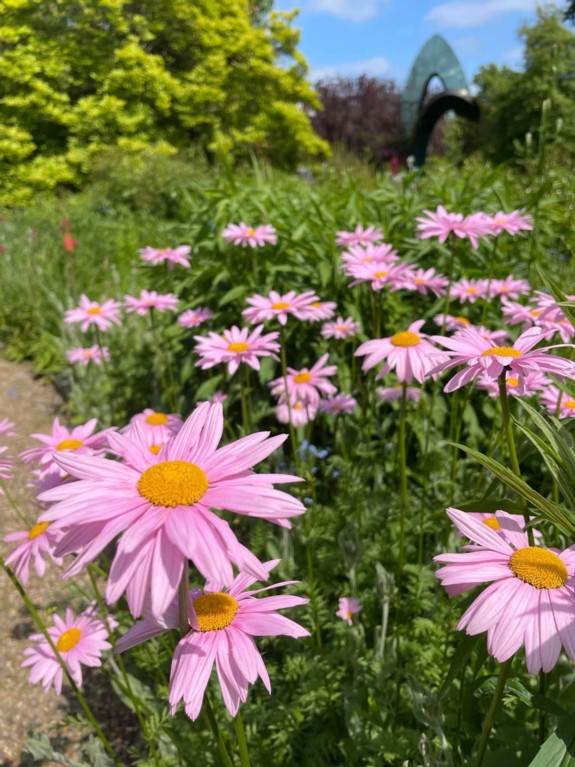
The same can be said of the flora on the wildflower meadow strips in the front gardens of Park Terrace. The small patches of grass are now bursting with wildflowers and create the perfect urban green corridor to link with the wildflower meadows of Parker's Piece. It is important to highlight the significant value these urban green corridors can provide. To some people, it may appear to be an unmanaged collection of areas. Please have patience and understanding with what we are trying to achieve, as these areas take more management than regular mown areas.
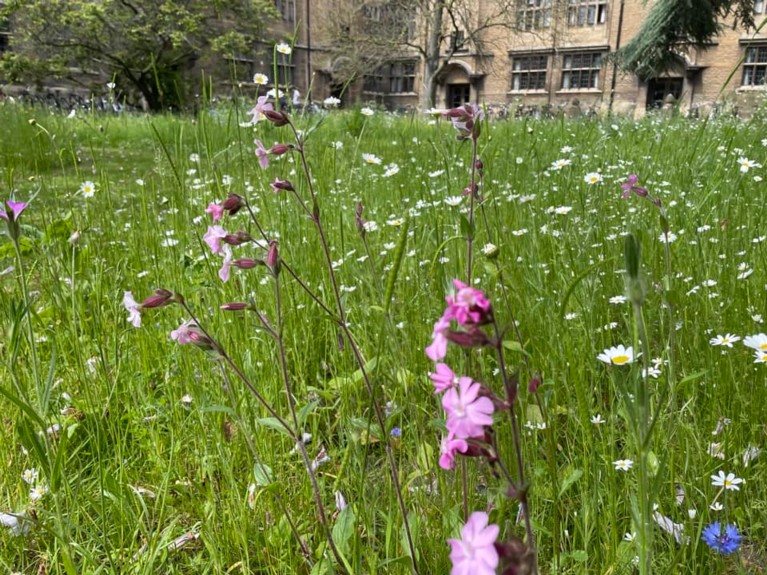
In other news, we are working hard behind the scenes to solve the problems of the landscaping beds. The Garden Management Team regularly meets with engineers and building surveyors to solve the issues. This is a frustrating time for the Garden Department as we are desperate to plant and finish the landscaping that the wonderful buildings deserve. Hopefully we will have some answers soon and we can progress.
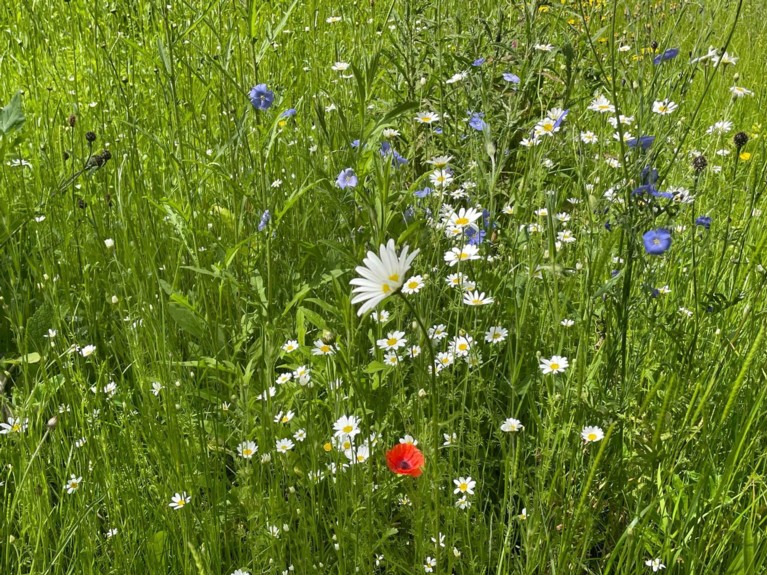
The college is also looking at ways to introduce a Community Garden. This could help with the stress that we mentioned earlier. Others issues that we are looking into also include increasing our approach to becoming a more sustainable college. With many good things already in place, it is always worth seeing how we can do things better - a commitment that we in the Garden Department have been trying to implement to the best of our ability.
Best wishes.
Brendon Sims, Head Gardener
7 June 2023
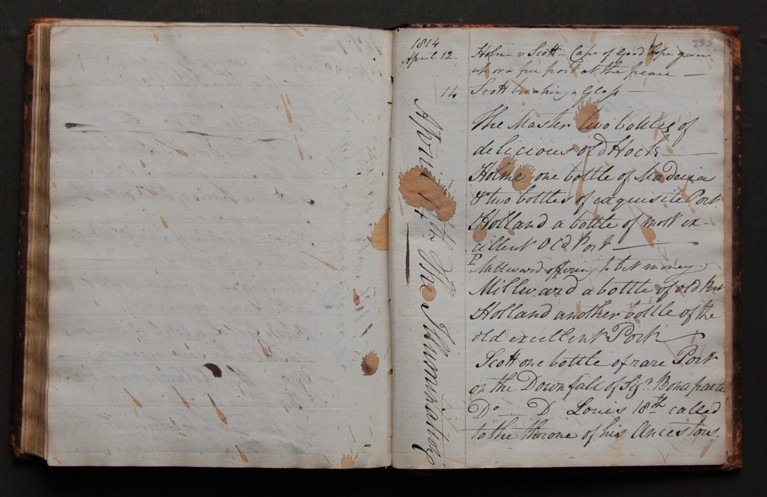
Parlour Wager Book, 14th April 1814
Emmanuel’s parlour wager books record the bets made between the Master, the Fellows, and fellow commoner students. They also note important national celebrations, which the parlour usually saluted with a selection of fine and fortified wines. On 18 June 1835 the Revd James Bunch, a Fellow of Emmanuel, gave the parlour ‘a bottle to commemorate the glorious battle of Waterloo’. This was on the 20th anniversary of the momentous military encounter that ended the Napoleonic Wars. Curiously, though, the wager book covering the summer of 1815 contains not a single word about the battle.
An explanation for this strange silence can, perhaps, be found in entries made the previous year. The pages covering 6-14th April 1814 are quite unlike any others in that volume. Indeed, they radiate an almost palpable excitement, with their extra-large handwriting and jubilant marginal annotations. The first entry reads, breathlessly: ‘Pemberton two bottles of London Particular Madeira & one bottle of Old Port to congratulate the World on the Allies having intered Paris’. A misspelling could be forgiven under such circumstances, and the perpendicular marginal note explaining the cause of the celebrations is positively incoherent: ‘April 6th 1814 Paris entered March 31 and taken on March 30’. (The Battle of Paris, 30-31 March, had been followed by Napoleon’s surrender to the Allies on 6 April.) Pemberton’s vinous contribution was emulated by other members of the parlour, who celebrated ‘the Downfall of Sigr Bonaparte’ with a total of 26 bottles, including a ‘Magnum bohum of Old Port’ (Henry Holland), ‘two bottles of prime Bourdeaux Claret’ (James Mainwaring), and ‘a bottle of La Fite’ (Pemberton, again).
A week later it was party time once more, when the Master, Dr Cory, gave two bottles of ‘delicious old Hock’, and the Fellows contributed another nine bottles of port and madeira. The marginal note on this page of the wager book, ‘April 14th The Illumination’, records the fact that this was a day of national victory celebrations, with spectacular light-shows being put on in London. The entire page is bespattered with what look suspiciously like red wine stains. More toasting marked the formal ‘Proclamation of Peace’ on 27 June, when the parlour enjoyed four bottles of hock, madeira and port, and Pemberton came up trumps again with two bottles of ‘exquisite Carbo’. William Pemberton, University Registrary and an Emmanuel Fellow since 1796, was a convivial member of the parlour who contributed countless bottles during his 20-year fellowship. He is commemorated on a plaque in the chapel cloisters.
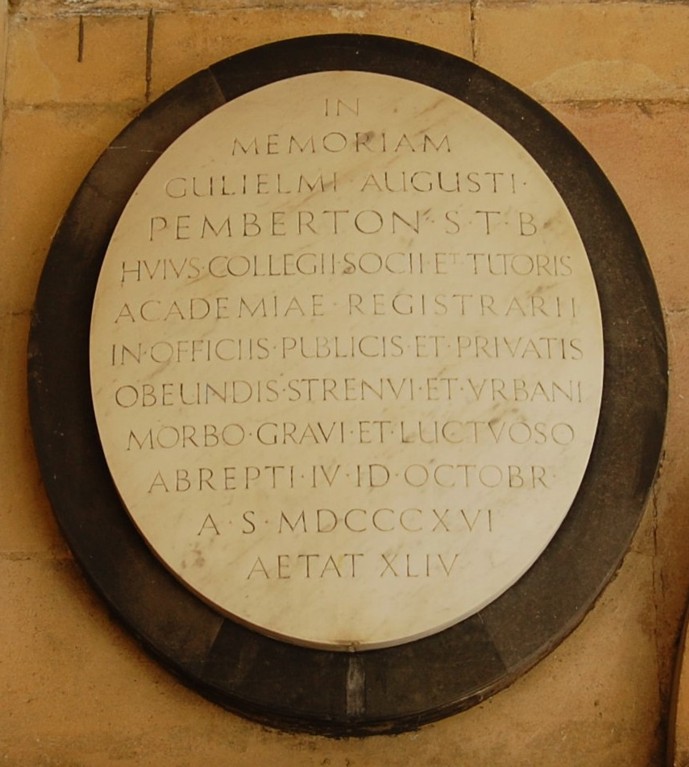
William Pemberton's Memorial at Emmanuel
Napoleon was banished to the island of Elba after the Battle of Paris. The sequel is well known; on 26 February 1815 he sailed for France and on 20 March entered Paris with an army. The shock and fear this turn of events caused across Europe is difficult to overstate, yet Emmanuel’s wager books are almost silent on the subject. On 13 March Pemberton made an over-optimistic bet that Buonaparte would be ‘either a prisoner or out of France in six weeks’, but there is no other mention of the political situation until autumn, several months after Napoleon had been defeated at Waterloo and dispatched to his final exile on St Helena. One can only imagine that after the wildly excessive rejoicings of the previous year, the Fellows were in no mood for another bacchanal. There may also have been a lurking fear that Napoleon could pull off the same trick twice. Whatever the reasons, the parlour seems to have been a model of sobriety throughout the national celebrations in the summer of 1815.
Amanda Goode, College Archivist
10 May 2023
The months are speeding on, and I cannot quite believe that we are in May already. It has been a month so far that has not seen too much sun and been extremely wet along with it. The plants are a little late flowering this year compared with other years, in particular the Wisterias throughout the college. They will catch up but just need a little more prolonged sunshine. On the plus side, everywhere looks very lush and green.
For the last few weeks, the garden team have concentrated their efforts on the main college site. It needed to look immaculate as we welcomed the prestige horticultural community through our doors at Emmanuel. It was with great pleasure that on 6th May (the same day as the Coronation), Emmanuel College hosted one of the most important events in the horticultural calendar. The Grand Final of the Young Horticulturist of the Year Competition attracts the highest level of young talent, all testing their horticultural knowledge to the maximum under tense conditions to try and win the title of Young Horticulturist of the Year and to win £2500 of travel bursaries to travel the world and further their horticultural knowledge even further.
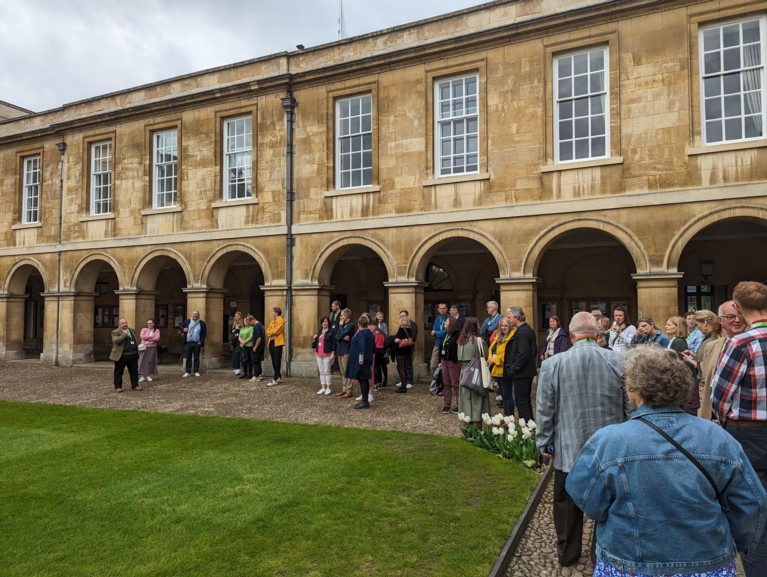
Above: Visitors arrive for the Grand Final
This is a competition that Emmanuel has had recent success in before, with Emma staff being in the final both regionally and nationally. The securing of the Grand Final was something I was very pleased we could do. It was twelve months in the planning and lots and lots of hard work, with emails and logistics as the contestants who represented their regions came from all over the British Isles. Many thanks to the College board for allowing us to hold such a prestigious competition here but also many thanks to Conference manager Harriet Carey and her team for all the hard work.
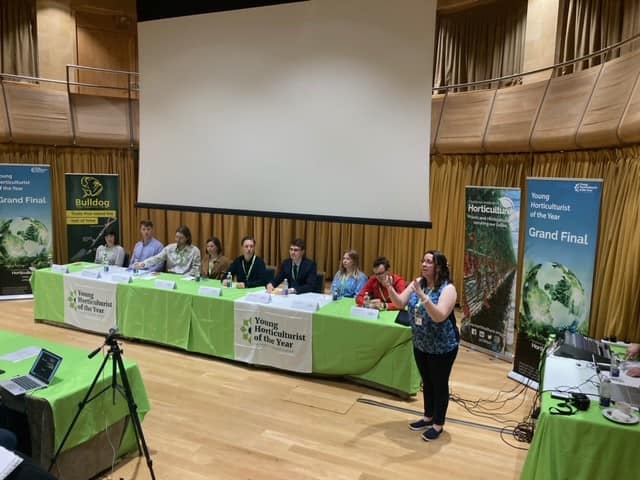
Above: The event is introduced
The event was very successful and received many great plaudits from some highly respected horticultural leaders within the profession. The grounds wowed the visitors and certainly spread the positive word about how great the college is and its beautiful surrounding buildings, with people in awe of its history.
As for the competition itself, it was a close-run final with the eventual winner, Lewis Barrett, representing the South East Region. Lewis currently works at the Royal Botanic Gardens in Kew and only won by three points on the day. Emmanuel College's former employee and Eastern region representative, Jon Strauss, finished in a respectable sixth position. This is still a huge achievement, and we are still very proud of Jon. Other contestants representing the other regions came from establishments such as the Botanical gardens in Scotland and Ireland.

Above: Lewis Barrett, 2023 Winner
As host, I had the task of being Question Master. This certainly tested my horticultural knowledge too as the audience was filled with lecturers, Botanic Garden curators, Horticultural journalists and authors, Head Gardeners and Horticultural Consultants. I think overall we did Emmanuel College proud and certainly have put Emmanuel College on the horticultural map, even more than it already is.
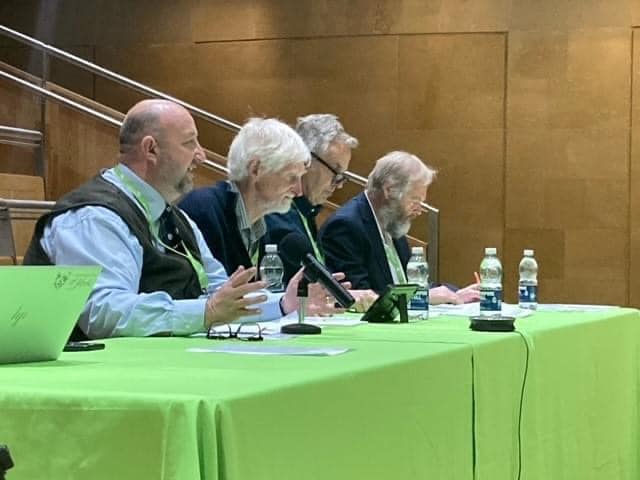
Above: The Head Gardener assumes the role of Question Master
As part of the day, Assistant Head Gardener, Theo Giasemidis, and I gave tours of the gardens, with our Master, Doug Chalmers, also chatting to the delegates and visitors.
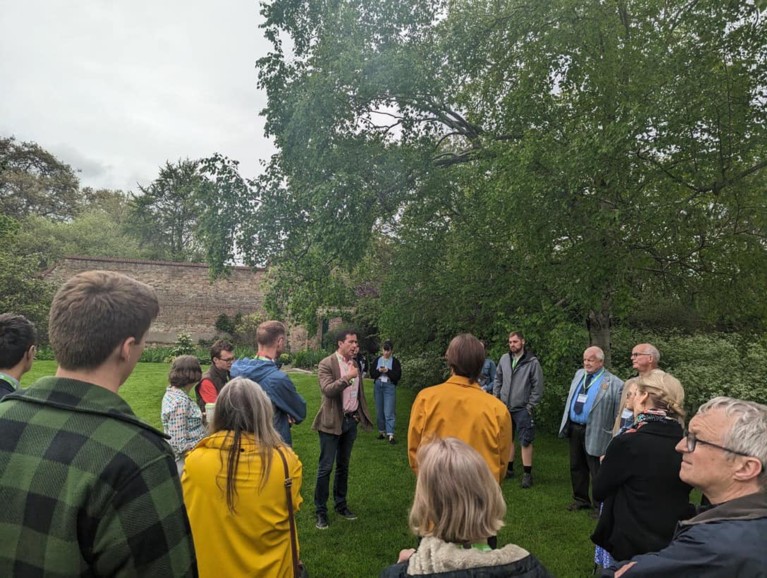
Above: Visitors are given a tour of the gardens
The rest of May looks busy as we catch up on the offsite properties and turn our attention to preparing the grounds for the Emma May Ball event and graduation. We are just praying for some sunshine.
Best wishes.
Brendon Sims, Head Gardener
10 May 2023
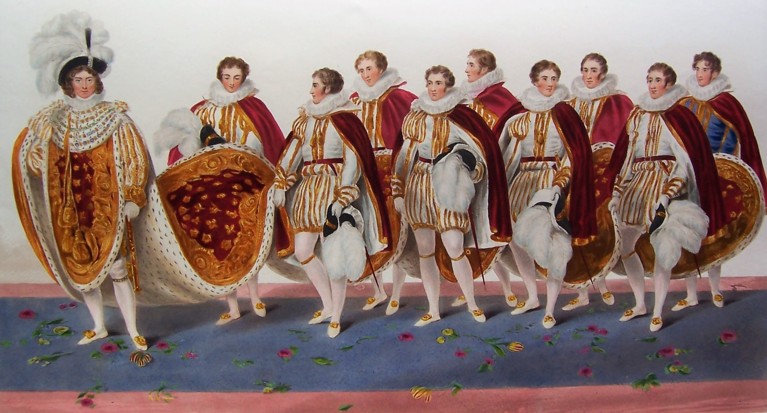
Nayler, ‘Coronation of … George IV’: The King with his train borne by eight eldest sons of peers, supervised by the Master of the Robes. This elaborate train later suffered the indignity of ending up at Madame Tussauds, but was presented back to George V and used at coronations since 1911
Emmanuel Library’s special collections include books commemorating two of the most splendid coronations: those of Charles II in 1661 and of George IV in 1821. Not unlike Charles III’s coronation in 2023, those of George IV and of Edward VII (in 1902), took place after gaps of six decades since the previous coronation, allowing for significant reinvention.
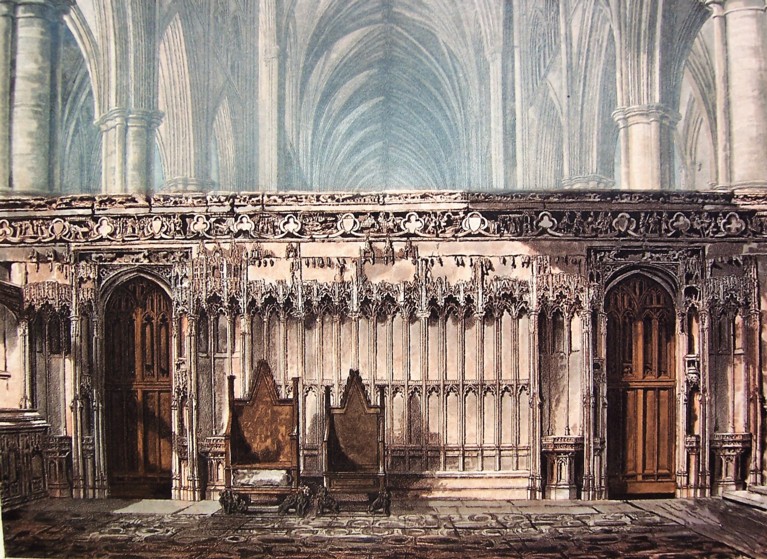
St Edward’s Chair, with the Stone of Scone, as it was in 1812, when it had been unused for over 50 years since George III’s coronation in 1761 (Rudolph Ackermann, ‘History of Westminster Abbey’)
Following the restoration of the monarchy in 1660, there was special moment in Charles II’s coronation as the new beginning of a re-established order. An enormous procession from the Tower of London to Whitehall on the day before the coronation was a carefully staged spectacle, projecting the restored King as magnificent yet accessible. Thousands of officials of the Royal Household and most of the nobility took five hours to process along the five-mile route, with the King bringing up the rear. The Entertainment of His Most Excellent Majestie Charles II, in His Passage through the City of London to His Coronation (1662) devotes ten pages to recording the participants in this great cavalcade. Its account of the coronation day also depicts the procession on foot from Westminster Hall to Westminster Abbey, which was long a part of the ceremonial (until it was dropped for William IV’s cut-price coronation in 1831 and never revived).
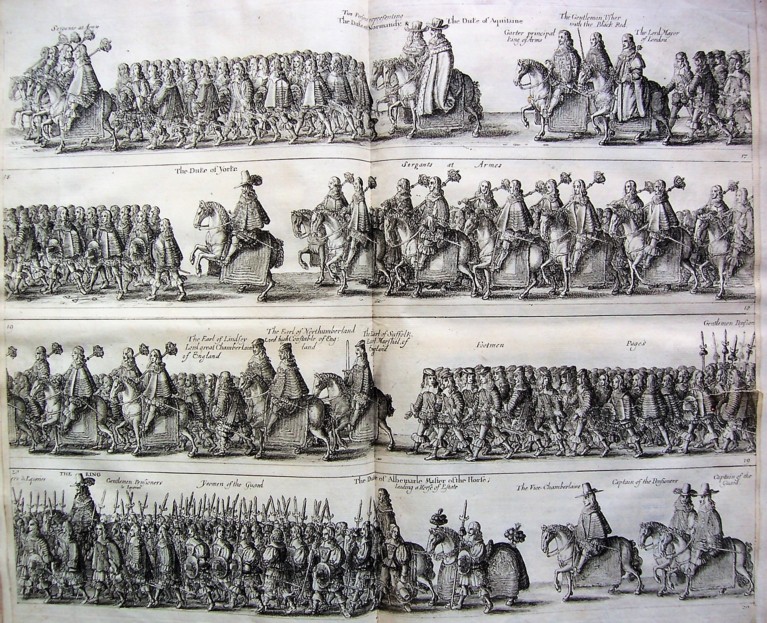
John Ogilby, ‘The Entertainment’, Procession through the City of London (Charles II can be seen on the left in the bottom line of the cavalcade)
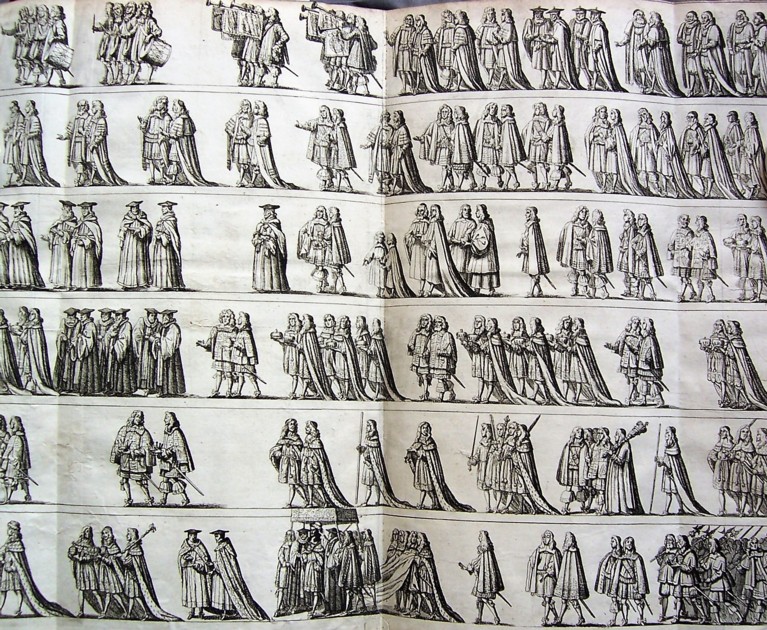
Ogilby, ‘Entertainment’, Procession between Westminster Hall and Westminster Abbey (Charles II, beneath a canopy, in the bottom line)
Charles II’s route through London was marked by four triumphal arches (paid for the City of London). Each arch was nearly one hundred feet high, made of wood and decorated with mottoes and emblems. The four arches represented monarchy, naval power, concord and plenty, and pageants were presented at each arch to the King, who took a close interest in how his coronation was recorded for posterity in this book.
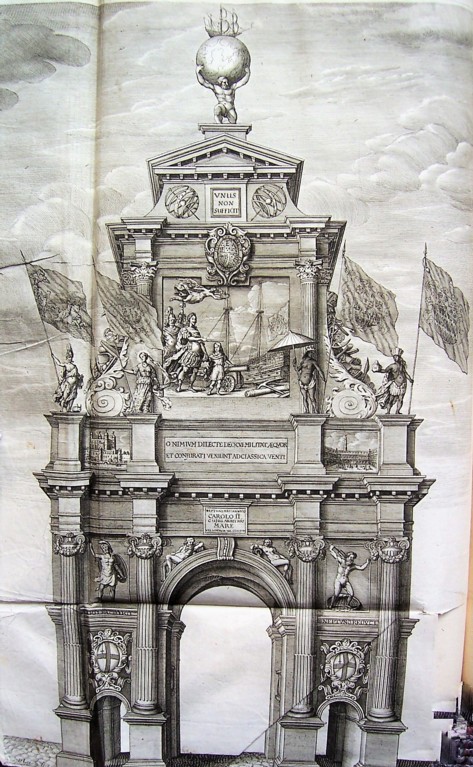
Ogilby, ‘Entertainment’, the Triumphal Arches of Naval Power and of Plenty (above and below)
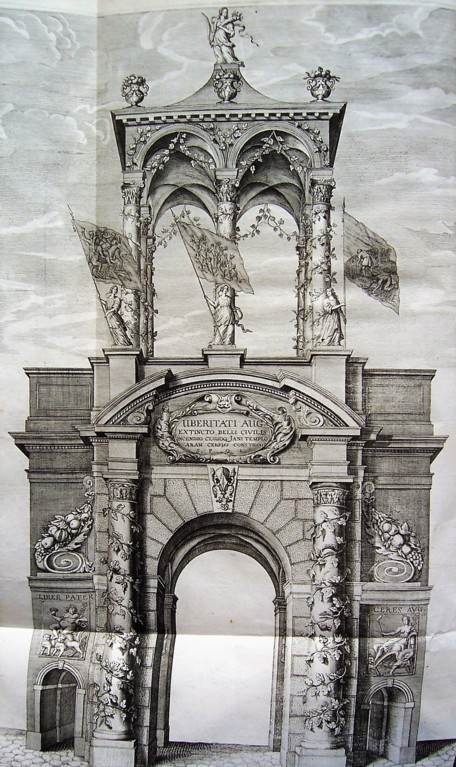
Since the Cromwellian regime had sold off the ancient regalia to be melted down – including St Edward’s Crown that had supposedly survived from Anglo-Saxon times – new regalia were made for Charles II’s coronation, augmenting the sense of this occasion as a reinstitution.
Reports of many subsequent coronations so often mention what went awry on the day as to suggest that most were seriously under-rehearsed by later standards. Yet the core of the service remained constant ever since St Dunstan, as Archbishop, had devised the coronation of King Edgar at Bath in 973 AD. First, the new monarch is presented to and acclaimed by the people. The monarch swears an oath, is anointed, invested with regalia, crowned, and receives homage. The consort is then anointed and crowned.
George IV’s coronation remains by far the most extravagantly expensive – the spendthrift king aiming to outdo Napoleon’s coronation as Emperor – although it is now chiefly remembered for the fracas when his estranged queen, Caroline of Brunswick, tried in vain to enter the Abbey during the ceremony. The lavish scenes find a fitting record in Sir George Nayler’s huge book, The Coronation of … King George the Fourth (1823-1837), of which Emmanuel’s Graham Watson Collection holds a magnificent copy, the plates enriched with gold and silver.
Proceedings commence with the presentation of the regalia to the King in Westminster Hall.
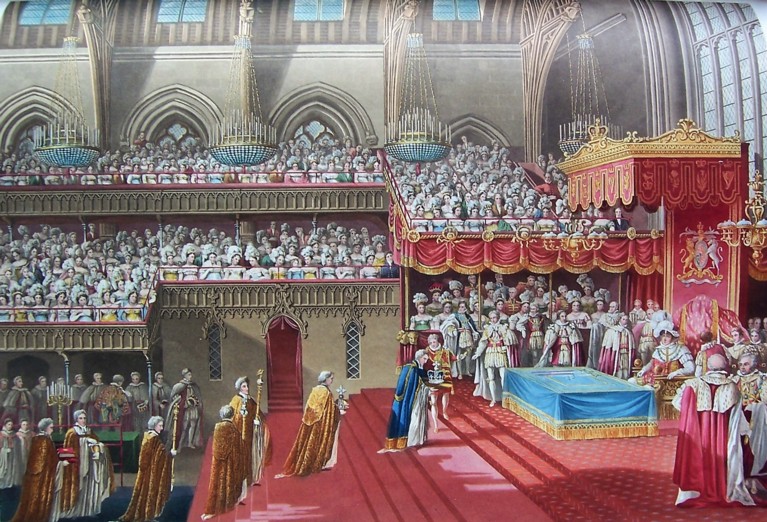
The Dean and Prebendaries of Westminster bear the regalia to the King in Westminster Hall (Nayler, ‘Coronation’)
After this an immense procession of officials and peers forms up to transfer the regalia to the Abbey, preceded by the King’s Herb Woman and her six Herb Maidens strewing flowers.
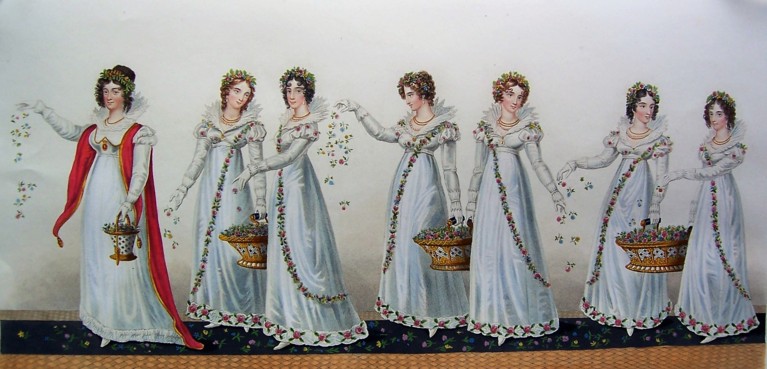
The King’s Herb Woman with her Six Maids, strewing the way with flowers (Nayler, ‘Coronation’)
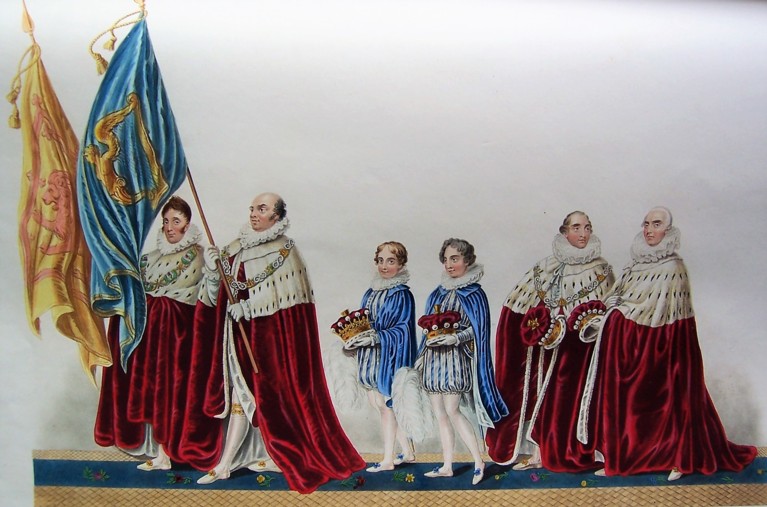
The standards of Ireland and Scotland being borne to Westminster Hall by Lord Beresford and the Earl of Lauderdale (Nayler, ‘Coronation’)
St Dunstan would still have recognized the key elements in the proceedings in the Abbey as George IV is crowned.
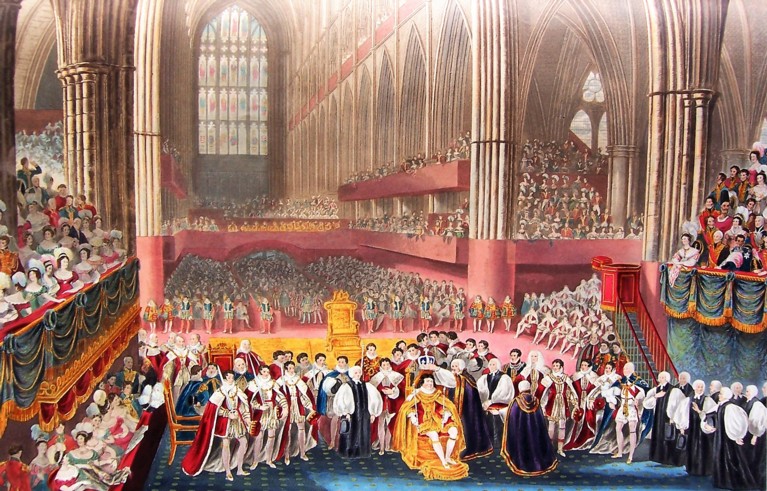
The Crowning of George IV’ (Nayler, ‘Coronation’)
There follows the swearing of homage, the moment illustrated being the joint homage of the King’s brothers.
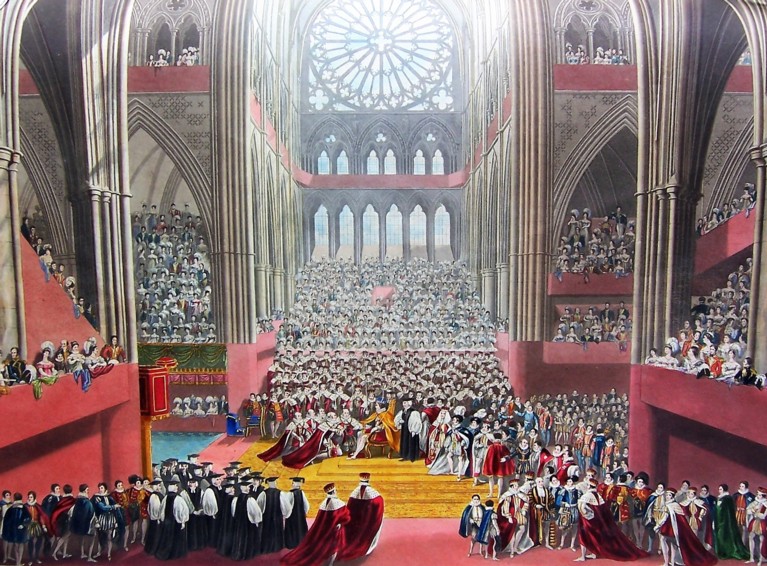
The Homage (Nayler, ‘Coronation’)
Two further plates depict the banquet in Westminster Hall that followed coronations. Perhaps strangely to our ideas, these too had a large paying audience on temporary scaffolds of raked seating. But the banquets were almost as much entertainment as the coronation.
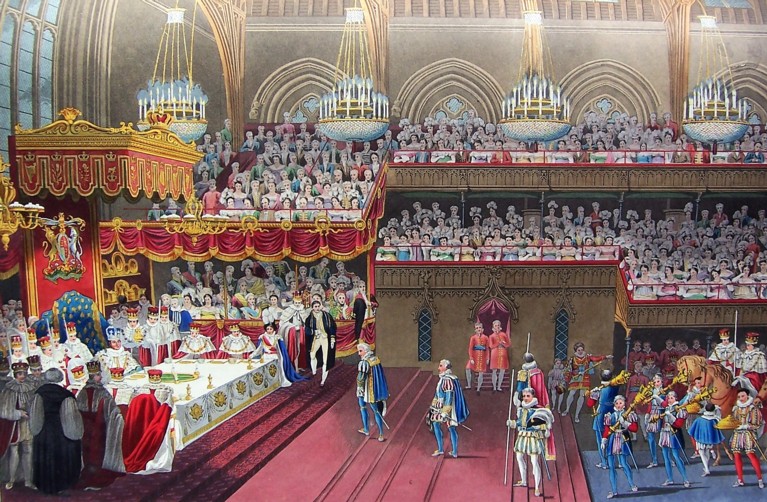
The Coronation Banquet of George IV (Nayler, ‘Coronation’) (above and below)
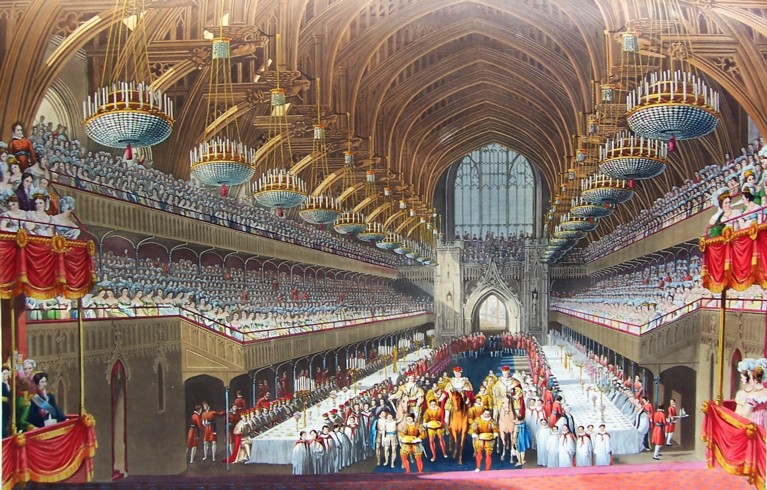
The three officers of state – the Earl Marshall, the Lord High Steward and the Lord High Constable (the Duke of Wellington) – rode the full length of the Hall on horseback to escort the serving of courses.
And the King’s Champion rode into the Hall during the banquet to a flourish of trumpets, attired in armour, crowned with plumes of ostrich feathers, and flanked by the Earl Marshall and the Iron Duke, also on horseback. Three times – upon entering, halfway up the Hall, and in front of the dais – the Champion threw down the gauntlet (literally) and challenged to fight any who disputed the King’s right to the throne. At the close, the ravenous occupants of the scaffolds fell upon the leftovers and made off with any fittings they could carry.
Including the prior procession and the banquet, Georgian coronations required the king and queen to be present continuously for some twelve hours and were both ramshackle and exhausting. William IV tried in vain to abolish coronations altogether, and, although thwarted in this, insisted on a low-key event for himself. No more was heard of a King’s Champion, and Victoria’s coronation lasted a mere five hours.
By the time of Victoria’s death, the model for her successor’s coronation was not Victoria’s long-past coronation but the grand public ceremonial and vast procession celebrating her 1897 Diamond Jubilee. The four twentieth-century coronations (in 1902, 1911, 1937 and 1953) – progressively better organized and with ambitious programmes of music – sought to project an image of the country past and present, placing new emphasis on engaging with a wider public. Yet the heart of the ancient rite in the monarch’s anointing and taking of the sacraments remains so personal to that individual, as well as of public significance, that there are still misgivings about broadcasting this. Emmanuel is fortunate to have a replica of the Bible, in its gorgeous mid-century binding, upon which Elizabeth II swore the oath that she kept for the rest of her long life.
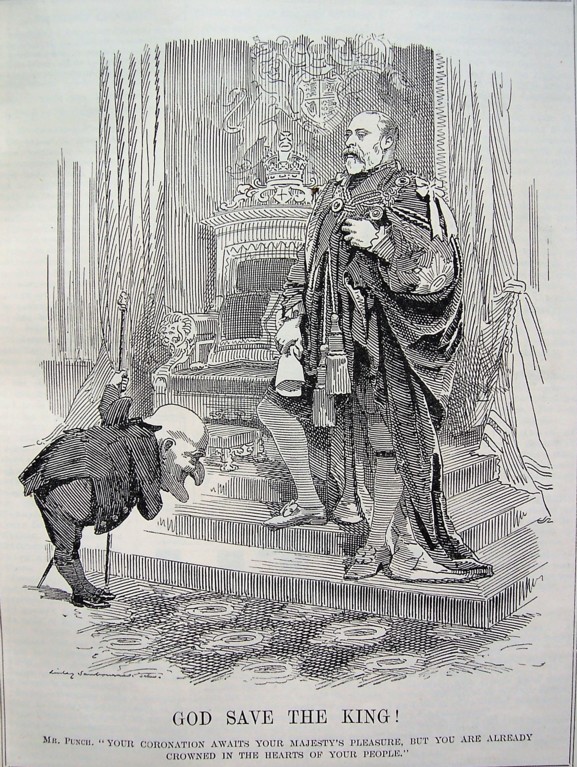
Mr Punch: ‘Your coronation awaits Your Majesty’s Pleasure, but you are already crowned in the hearts of your people’ (‘Illustrated London News’, 6 February 1901)
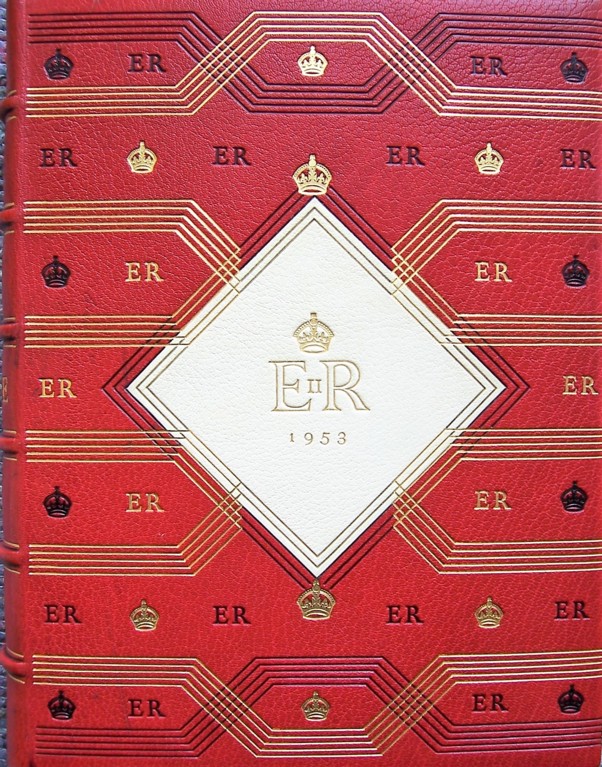
No 22 of 25 copies of the Bible, on the first of which Elizabeth II swore the oath at her coronation on 2 June 1953. Bound by Sangorski and Sutcliffe, to a design by the artist and illustrator, Lynton Lamb (Graham Watson Collection)
Barry Windeatt, Keeper of Rare Books
Images by Helen Carron, College Librarian
10 May 2023
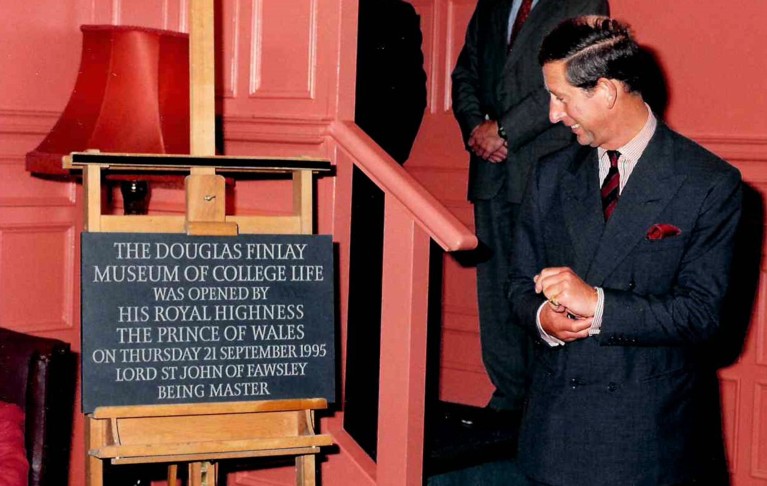 The Opening of the College Museum
The Opening of the College Museum
During Lord St John of Fawsley’s five-year term as Master of Emmanuel in the 1990s, a succession of royal visitors, including Queen Elizabeth II and Prince Philip, considerably enlivened the normal college routine. In September 1995 the then Prince of Wales, now HM King Charles III, paid his first and (to date) only visit to Emmanuel College.
Unlike most of the other royal visits to the college, which had involved months of planning, this one had to be arranged in double-quick time. In his invitation, sent out on 24th August, Lord St John reminded Prince Charles that he had long wanted to invite him to Emmanuel, and therefore hoped that he would agree to open the new museum of college life and history in Old Court. ‘The room is potentially a really very beautiful room but it had become grottsville filled with rexine armchairs and television sets and laughably called a reading room...An old member, Derek Finlay, is very kindly providing the funds for the museum in memory of his brother Douglas Finlay, who was killed in a flying accident’. Douglas, who was admitted to Emmanuel in 1941, completed his degree after wartime service with the RAF and incarceration as a POW in Stalag Luft III. He died in 1948, shortly after graduating.
As an additional lure, the Master told Prince Charles that he would also very much like to show him the Queen’s Building, ‘which was opened by Her Majesty in April and is really a magnificent example of contemporary architecture’. The Prince responded positively to the invitation, but had only one free evening in the foreseeable future. As Lord St John recalled in the college Magazine, ‘it’s imprudent to cavil about a royal offer’, and so the proffered date of 21st September was accepted. The news had the effect of a ‘bombshell’ when it was announced to the rest of the college, because the fitting-out of the museum had not, in truth, progressed beyond the planning stage.
The newly designated Curator, Dr (later Professor) Barrie Rickards, instantly rose to the challenge, supported by the ‘heroic’ Clerk of Works, Tony Smith, ‘who had to forget about holidays, and substitute sleepless nights instead’. The Maintenance Department went into overdrive, and in the space of a month had completed all the requisite ‘demolition, reflooring, electrical work, carpentry, building, painting and decorating, and security installation’. The Curator then hastily filled the new display cabinets with suitable exhibits. The room’s bold colour scheme had been chosen by the Master, but it was decided, at the last minute, that the shade of paint used on the panelling was ‘not quite right’. With only hours to spare, a different tint was applied, to the accompaniment, one imagines, of some smothered oaths.
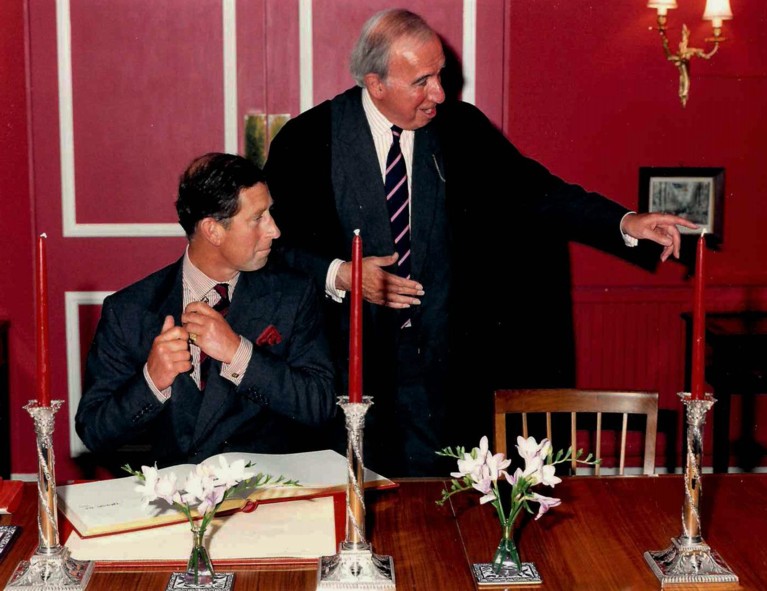
Signing the Visitors' Book, the Master in Attendance
In the end, all went smoothly. Prince Charles arrived in the early evening and opened the new museum in time-honoured tradition by unveiling a plaque, the ceremony being witnessed by the Finlay family, senior college members, and such student representation as could be mustered in September. The party then moved on to the Queen’s Building, where HRH was able to view a model of the building and discuss its design with the architects, Sir Michael and Lady (Patty) Hopkins. This was followed by a cocktail-and-canapé reception, at which a larger number of guests was present. According to the Master, ‘The Prince circulated splendidly and talked to everyone, fortified by a dry martini made to his own recipe’. Before leaving, Prince Charles paused to sign the visitors’ book (with his own trusty fountain pen) and, to quote Lord St John, ‘So ended a memorable day’.
Amanda Goode, College Archivist
20 April 2023
It feels as though spring has arrived at Emmanuel College. Although there still has been heavy rain (and large volumes of it too), there have been some brighter breaks in the weather. The plants are certainly shooting up (along with the weeds), the trees are beginning to leaf up and the early blossom has arrived. There is definitely a sense that the weather is on the up.
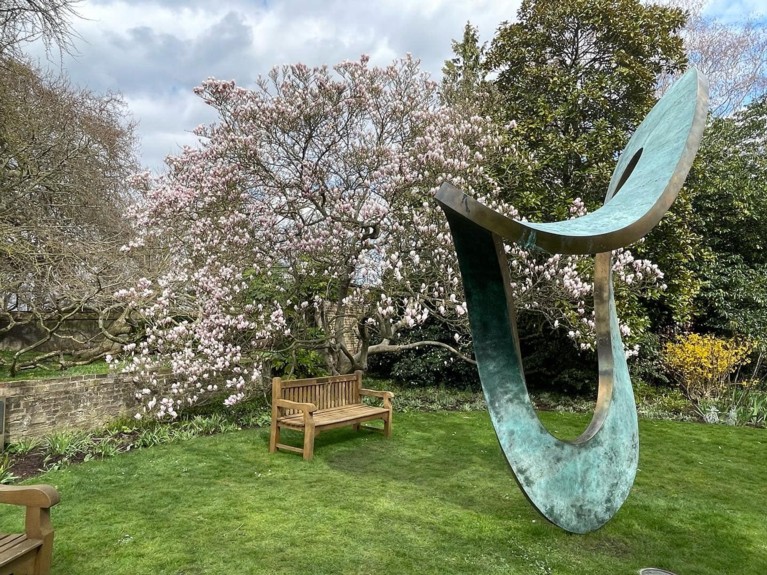
Above: Blossoms form the backdrop for the Jester
Unfortunately, the problems in the new build planting beds are still not resolved and they continue to be waterlogged. I therefore cannot provide the update that I had hoped for at this time. There are still questions to be asked and problems to be resolved, all of which are being dealt with in the background. Hopefully they can be planted sooner rather than later. I hope that everybody can start to enjoy the transitional spaces between the new buildings.
The new reflection pool in New South Court has now been filled with water and the pumps and skimmers tested. It will take a few weeks for the water to clear and settle. There will be an addition of waterlilies to come shortly. This should provide a tranquil water flow, just enough to allow some movement in the water.
The Garden Team has seen some new additions since the last blog entry. We welcome Sally MacKenna and Andrew Luetchford to the department. Sally is an experienced gardener, having worked at Kirtling Towers in Suffolk and also the Cambridge University Botanical Gardens. Andrew is also an experienced gardener, having transferred from Trinity College. Andrew will bring some landscaping knowledge as well and will be able to help us with such tasks as repairing the cobble stones, as the retiring Phil Bland did before him.
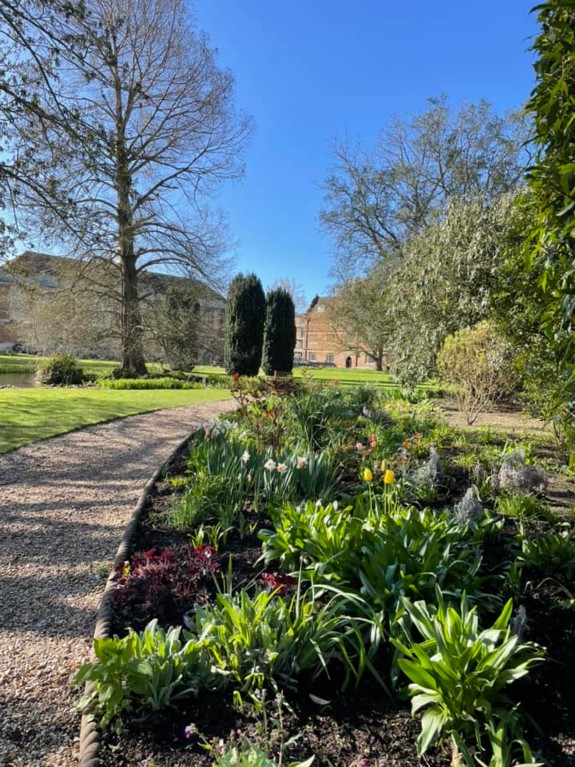
Above: Flower beds line the pathways around college
The Garden Department are currently busy with many seasonal tasks, such as pruning and staking plants as they grow. We have been preparing the site for weddings and conferences, also with one eye on the rapidly approaching Grand Final of the Young Horticulturist of the Year, which the college is proudly holding on behalf of the Institute of Horticulture, the grounds obviously having to look good for that day, as many keen gardening eyes will be looking around.
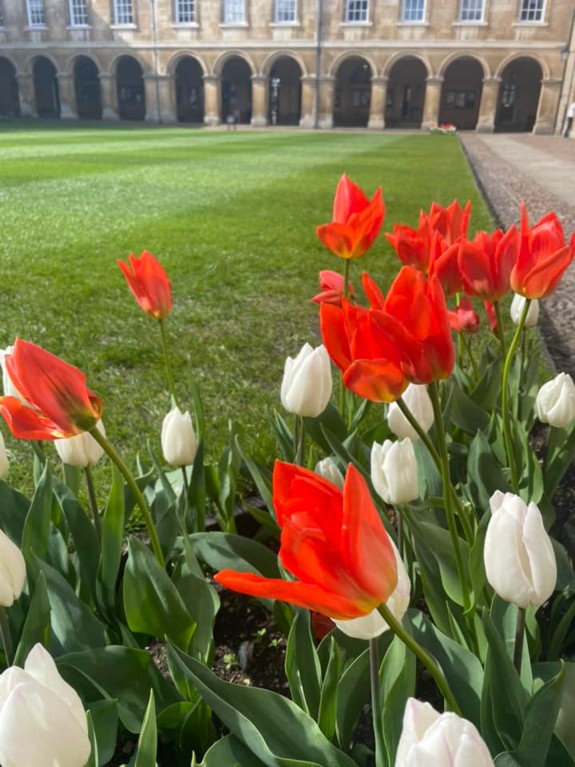
Above: Tulips in Front Court
Highlights of the garden at the moment include the many spring bulbs (various tulips and narcissi in particular). Other plants of special interest include the vivid blue flowers of the brunneras in the Fellows' Garden. The two varieties (brunnera macrophylla and brunnera ‘Jack Frost’) look great in the dappled shade.
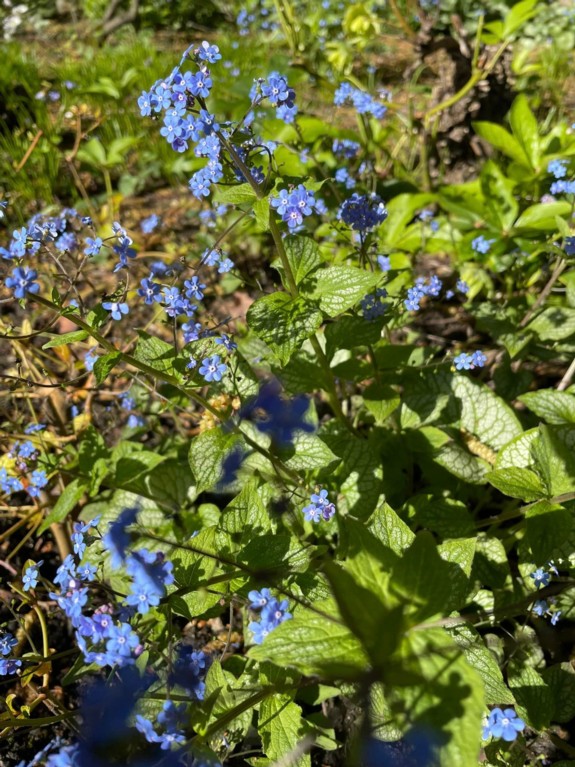
Above: Brunneras in the Fellows' Garden
What are your favourites?
Best wishes,
Brendon Sims (Head Gardener).
20 April 2023
.jpg)
The early years of the Emmanuel Boat Club are largely undocumented, as its minute books only survive from 1843. When Geoffrey Wynne Thomas (EBC captain, 1927) wrote a history of the boat club in 1977, marking its presumed 150th anniversary, he was forced to rely on other sources for the first fifteen years of its existence. Unfortunately, they provided little more than brief details of the inter-collegiate bumping competitions, which were first held in Lent Term 1827. Given the boat club’s important place in Emmanuel’s history (it is our oldest student society), it is pleasing to report that some additional information about its earliest days has recently been noted in the college archives. The parlour wager books, which begin in 1769, record not only bets made between senior members and their guests, but also significant college events. The volume covering 1827 contains no mention of the inaugural Lent bumps, in which an Emmanuel crew competed using a borrowed boat, but the Mays were a different matter.
On 5 May 1827, an entry notes that ‘Holder’ had contributed a bottle of claret to the parlour ‘to celebrate the launching of the Emmanuel Boat “The Sir Walter Mildmay”’. Fourteen other members also donated a bottle or two, and there was keen anticipation of the new boat’s success. John Griffith (Fellow and Tutor) offered ‘2 bottles of Claret if the Sir Walter Mildmay beats all the six-oared boats’. A note on the facing page records that ‘The Sir W Mildmay beat each boat successively & continued first six-oar until the last day when owing to a change in the crew it lost one place, but afterwards with its original crew it retrieved its honour by beating the Challenger of the whole river’. This annotation was made at Holder’s behest, as noted on 19 May: ‘Holder (The Lord High Admiral of the Emmanuel boat club) gives a bottle for the insertion of the note in the preceding page’.
These short entries yield several valuable nuggets of information. They confirm that the boat club had been formally instituted by May 1827, at the latest. As well as providing the name of the first college boat, its complement, and details of its encouraging inaugural performance, they also name the first EBC captain: William Charles Holder, a fellow commoner who had been admitted to Emmanuel in March 1826.
For a few years, the boat races continued to be the subject of wagers. In March 1828, for example, Holder bet John Barr, another fellow commoner, that ‘Provided the Caius Boat Club starts an eight-oar, the Emmanuel Boat will bump it, if it is, on any two days during the next Term, immediately behind it’. The outcome of this wager was not recorded. On 12 May 1829, William Colbeck (scholar, later Fellow) placed a losing bet with Richard Foley (Fellow) that the Jesus boat would bump the Emmanuel boat that evening. After the 1830 Lents, however, regular betting on the races ceased. The novelty had evidently worn off, and the Emmanuel boat was not achieving enough success to sustain the parlour’s interest.
‘Lord High Admiral’ William Charles Holder became a clergyman after graduating. In 1829 he was nominated stipendiary curate of Taynton, Oxfordshire, the village in which his family had been settled since the 1650s, and where he had already inherited property from an uncle. He did not enjoy his good fortune for very long, however, for he was destined to die in 1838. Appointed vicar of Cam, Gloucestershire, in 1834, it was to another Cam, perhaps, that Holder’s thoughts sometimes strayed on balmy spring days.
Amanda Goode, College Archivist
20 April 2023
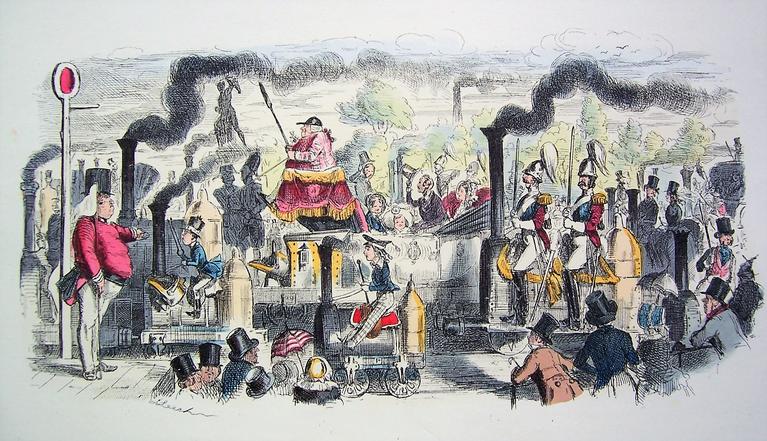
Locomotives belch black smoke into the air of Hyde Park, because everyone is riding an individual locomotive, sitting astride it like a horse. Centre-stage, Queen Victoria is seen riding in the Park in her carriage – except that it is being drawn by a smoky locomotive. Prince Albert doffs his top hat, acknowledging the crowds. Members of the Household Calvary escort the Queen, sitting astride locomotives. In the distance the chimney of some dark satanic mill is smoking …
‘Hyde Park as It Will Be’ is the plate for 1848 in John Leech’s Follies of the Year, a series of coloured etchings from Punch’s Pocket Books for 1844-1864, in Emmanuel’s Graham Watson Collection. Plates for each year present some wry view of contemporary trends and follies and where they might be leading, as in this not very optimistic perspective on the likely impact of the steam engine.
Some plates peer into a perhaps near future where customary order is disrupted.
In ‘A Social Sketch’ (for 1850) is ‘the communistic idea’. Far right, one says to another: ‘They’re as much mine as yours’. A ruffian wielding a stick looms over a lady and says: ‘Now, Ma’am, when you’ve done peelin’ them Pertaters, put on your bonnet and cum out for a walk in Kensington Gardyngs’. Behind, another says: ‘Evin ’elps them wot ’elps themselves, as our Perfessor says’. To the left, a white man and a man of colour appear to be fighting over a lady.
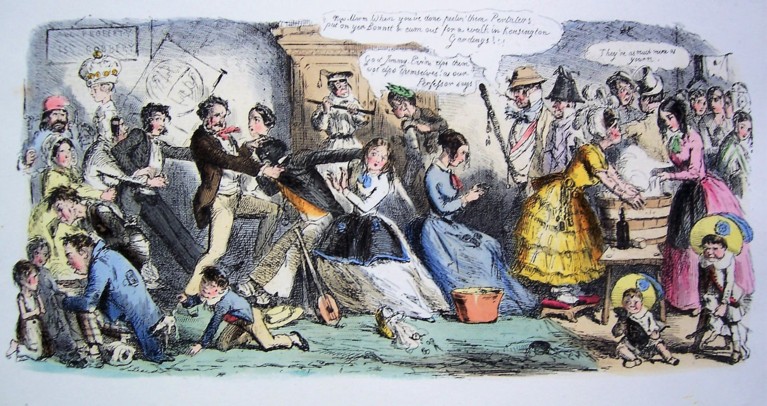
Pl 2. ‘A Social Sketch, or Everything in Common’ (1850)
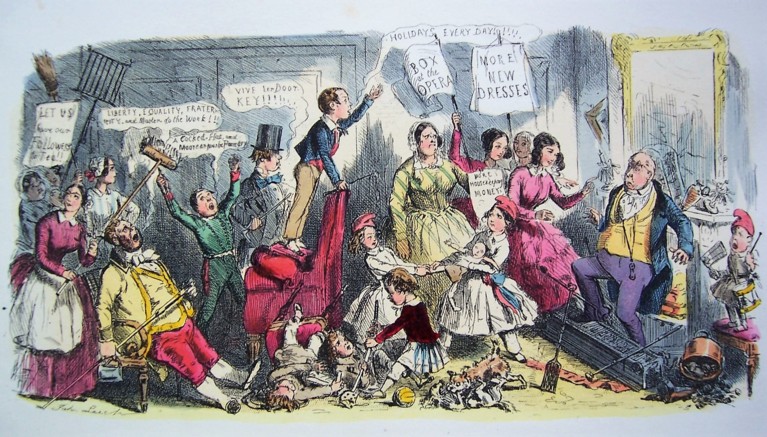
Pl 3. ‘Higgledy-Piggledy, or a Domestic Republic’ (1849)
‘Higgledy-Piggledy’ (1849) shows ‘the idea of general insurrection and socialism’ in the domestic household. The master of the house (as he perhaps fancies himself) finds his household of women and childen in rebellious uproar, waving placards demanding more new dresses, more housekeeping money, a box at the opera, holidays every day, and (in an echo of the French Revolution) ‘Liberty, Equality, Fraternity – and Master to do the work!’
Running through the series of plates is a curiosity about the possible autonomy and independence of women. On the one hand, plates include some of the absurdities of fashion by which women are oppressed, such as the unlikely ‘Sea-Side Fashions’ for 1863 (including one very bad hair day), or a contraption to be worn underneath to support a crinoline, shown here being inflated by bellows.
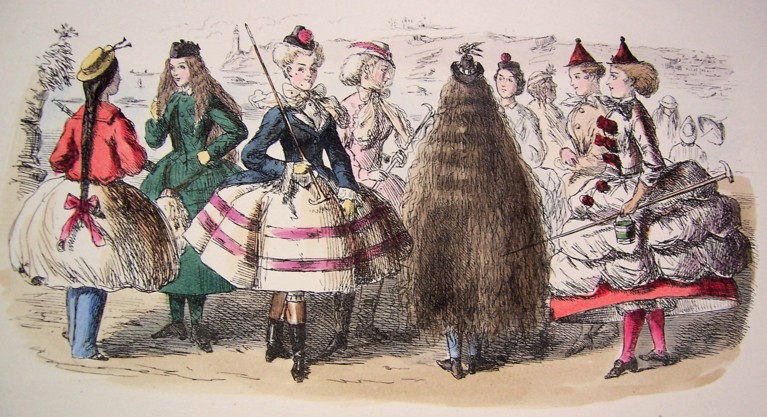
Pl 4. ‘Some Sea-Side Fashions for 1863’
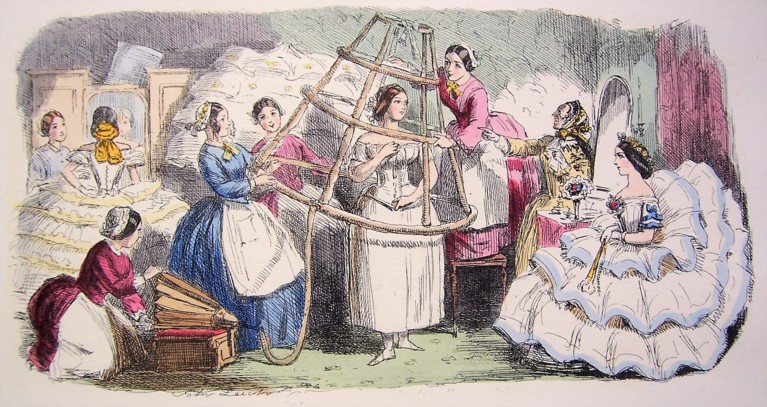
Pl 5. ‘Dressing for the Ball’ (1857)
But fanciful plates imagine a world where women engage hands-on in (as it seemed) unlikely occupations – such as pig farming. In ‘Farming for Ladies’ (1845) several well-dressed ladies attend to their pigs. Liveried footmen pushing one lady in a bath chair look glum as they tread on piglets. Up on a hillside behind a lady is ploughing while a man holds a parasol over her. Some ladies appear to be having tea atop a haystack, which sports a flagpole surmounted by a teapot.
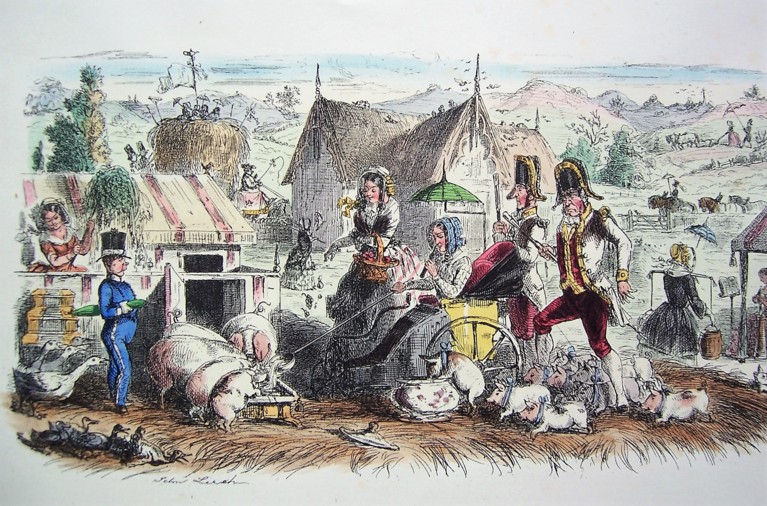
Pl 6. ‘Farming for Ladies’ (1845)
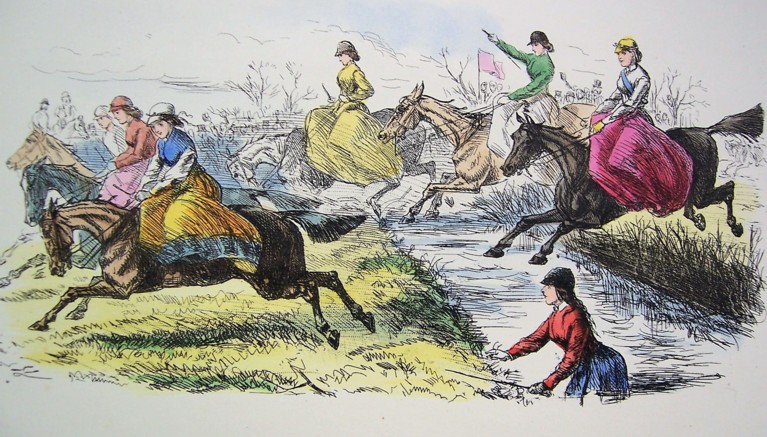
Pl 7. ‘A Rather Fast Steeple Chase’ (1864)
Meanwhile, ‘A Rather Fast Steeple Chase’ (1864) shows an all-women’s horse race, with ladies flying over the obstacles with panache.
Another plate of women-only activity shows ‘Swimming for Ladies’ (1860), where women enjoy the water, albeit fully attired in cumbrous clothing.
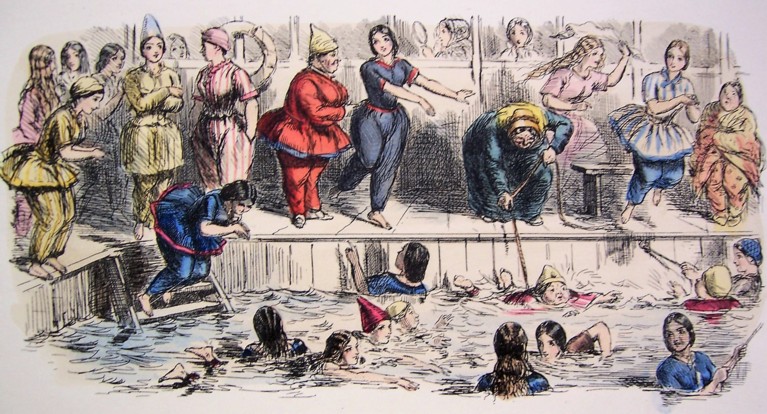
Pl 8. ‘Swimming for Ladies’ (1860)
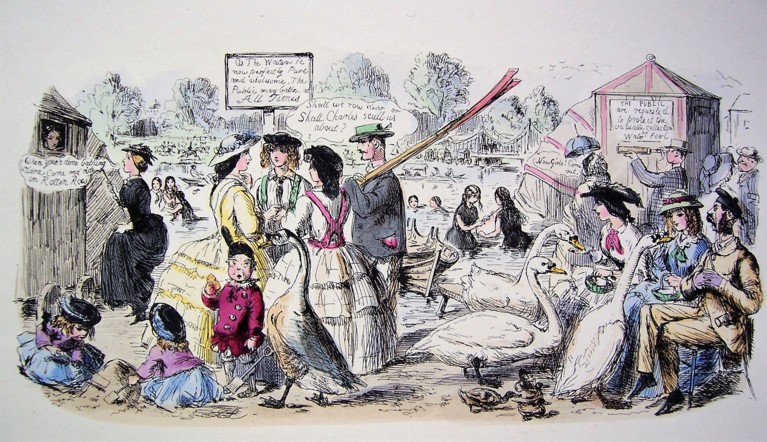
Pl 9. ‘A Substitute for the Sea-Side, or the Serpentine as it might be’ (1858)
Some women are also shown swimming fully clothed in ‘A Substitute for the Sea-Side’ (1858). Here, the Serpentine has become as promiscuously mixed and crowded as a seaside resort. The notices reflect concerns that are still with us: ‘As the Water is now perfectly pure and wholesome, The Public may bathe at All Times’, and ‘The Public are requested to protect the valuable collection of Water Fowl’ (although the burly swans seem to be managing just fine). Three young women are discussing: ‘Shall we row, dear, or shall Charles scull us about?’ (Charles in his boater awaits their decision, sheepishly).
The background to one wry plate almost entirely filled with women is a gold rush in Australia
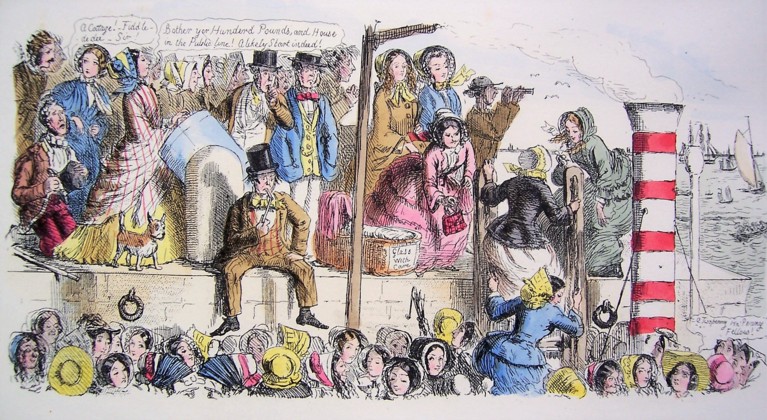
Pl 10. ‘Alarming Prospect: The Single Ladies off to the Diggings’
A quayside is crowded with women who are setting sail from Britain to find themselves wealthy lovers in the gold fields: as the text says, ‘away go all the ladies to the diggings, despising the humble fortunes’ of their homegrown admirers. One lady snaps dismissively to a man: ‘A Cottage! Fiddle-de-dee, Sir!’ Another man kneels as a lady, nose in the air and wielding an enormous hat box, turns her back on him with ‘Bother yer Hunderd Pounds … A likely start indeed!’ A few crestfallen men perch in the middle of the quay, surveying the mass exodus of venturesome women.
Barry Windeatt (Keeper of Rare Books)
Images by Helen Carron (College Librarian)
16 March 2023
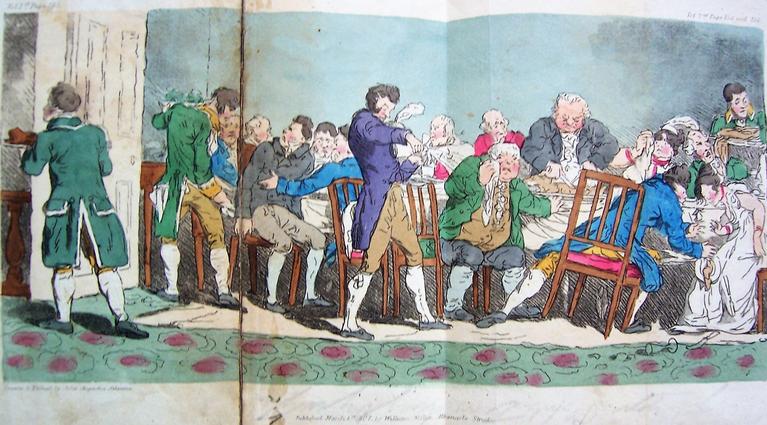
Who can predict a best-seller – the book that catches the moment, not only becoming a minor classic of its day but spawning a crop of illustrated spin-offs? So it was with James Beresford’s satirical The Miseries of Human Life (1806), cast as a dialogue of ‘groans’ between two old carmudgeons, Mr Samuel Sensitive and Mr Timothy Testy, who review the petty outrages, minor humiliations and tiny discomforts ‘that fastidious flesh is heir to, in this dislocated world of ours’ – with Mrs Testy supplying ‘A Few Supplementary Sighs’ from a woman’s perspective.
Illustrators immediately saw potential in the theme of Miseries for cartoon-like depictions of the comic indignities and discomfitures inflicted by human foible, by accident and circumstance. Within a year, two colour-plate books had appeared, of which Emmanuel’s Graham Watson Collection holds copies: Sixteen Scenes Taken from the Miseries of Human Life, By One of the Wretched (actually by J. A. Atkinson, 1807) and Thomas Rowlandson’s Miseries Complete in Twelve Dialogues (1807).
‘Miseries of London’ include ‘chasing your hat (just blown off in a high wind) through a muddy street – a fresh gust always whisking it away at the moment of seizing it’, all this happening ‘amidst the jeers of the populace’. Other miseries of London include being cannoned into by inattentive fellow pedestrians (little changes).
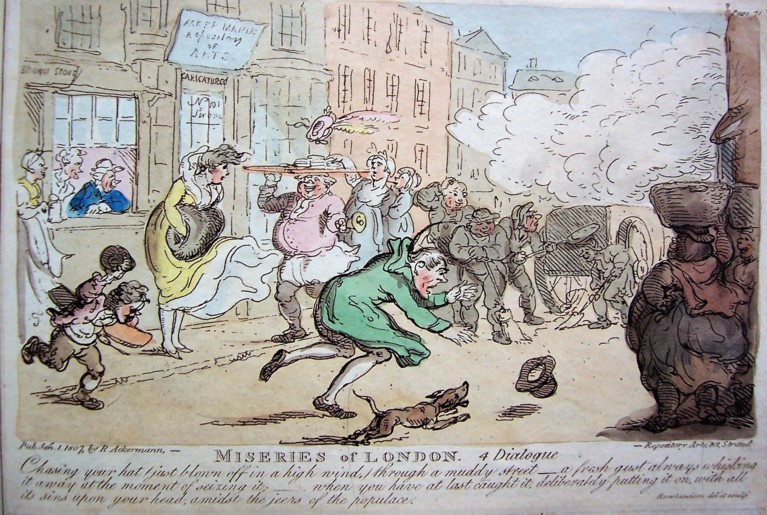
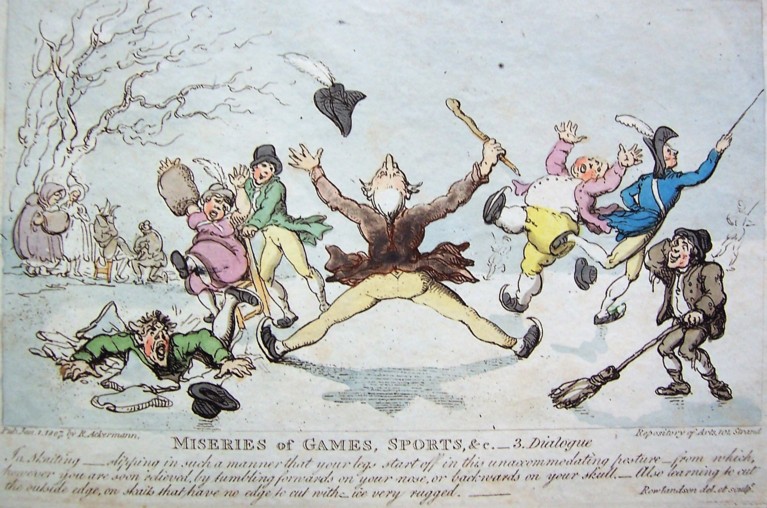
Above; Pl 2: ‘Miseries of London’ (Rowlandson). Below; Pl 3: ‘Miseries of Games and Sports’ (Rowlandson).
‘Miseries of games and sports’ include ‘in skating – slipping in such a manner that your legs start off in this unaccommodating posture – from which however you are soon relieved by tumbling forwards on your nose, or backwards on your skull’.
Miseries of newly-fashionable seaside holidays include: ‘ploughing knee-deep, in sand, shells, or pebbles for a whole morning together, to grub for marine curiosities, which you do not find’. You long for a horse to take you home, but must compromise on a donkey, which then refuses to budge.
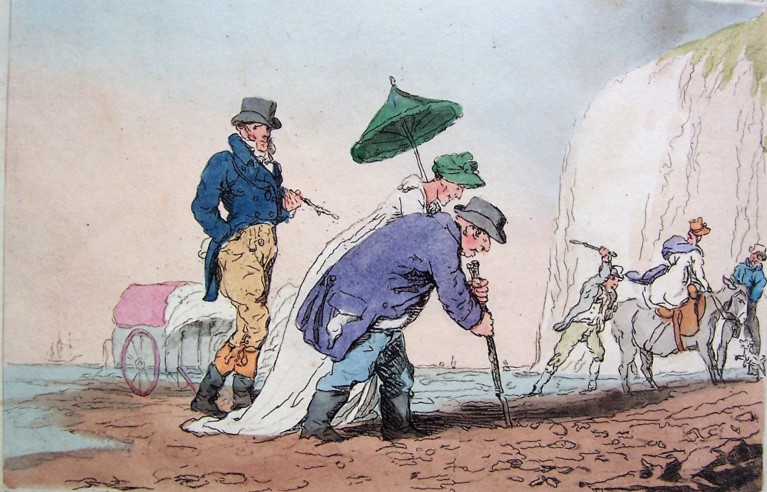
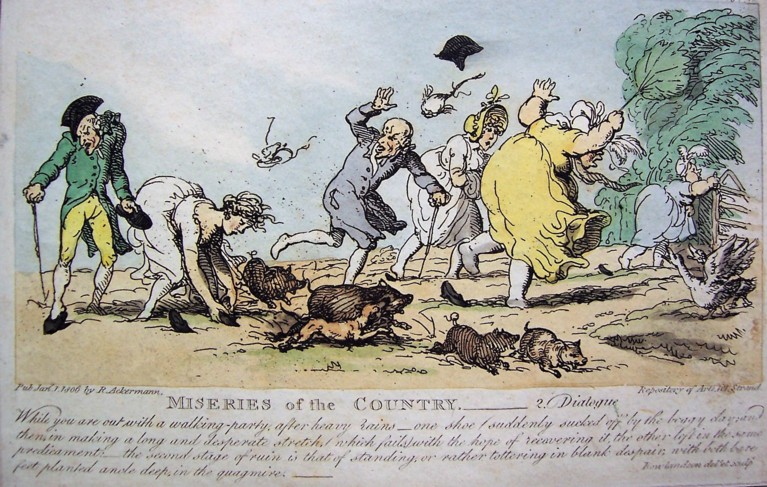
Above; Pl 4: ‘Miseries of Watering Places’ (Atkinson). Below; Pl 5: ‘Miseries of the Country’ (Rowlandson).
Among ‘Miseries of the Country’ is a walk after heavy rain when ‘one shoe suddenly sucked off by the boggy day, and then, in making a long and desperate stretch (which fails) with the hope of recovering it, the other [shoe is] left in the same predicament’. The writer groans: ‘the second stage of ruin is that of standing or rather tottering in blank despair, with both bare feet planted ankle deep in the quagmire’.
Other ‘Miseries of the Country’ stem from male attempts to impress the opposite sex, as when ‘in attempting to spring carelessly, with the help of one hand, over a five-barred gate, by way of shewing your activity to a party of Ladies behind you (whom you affect not to have observed), [and] blundering upon your nose on the other side’.
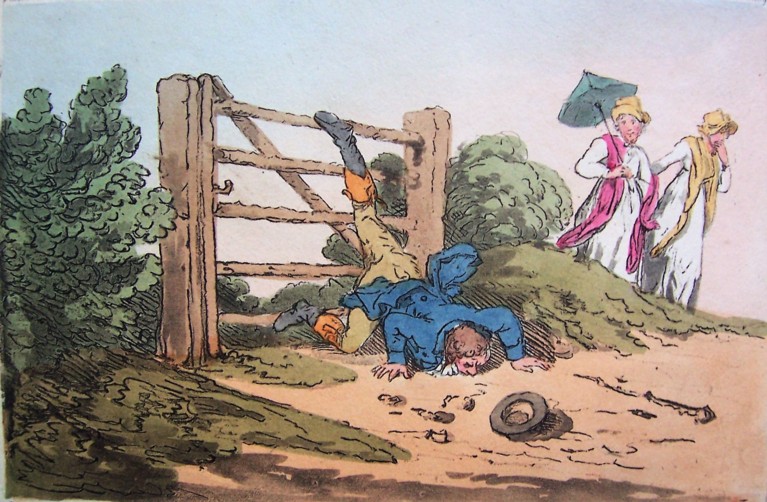
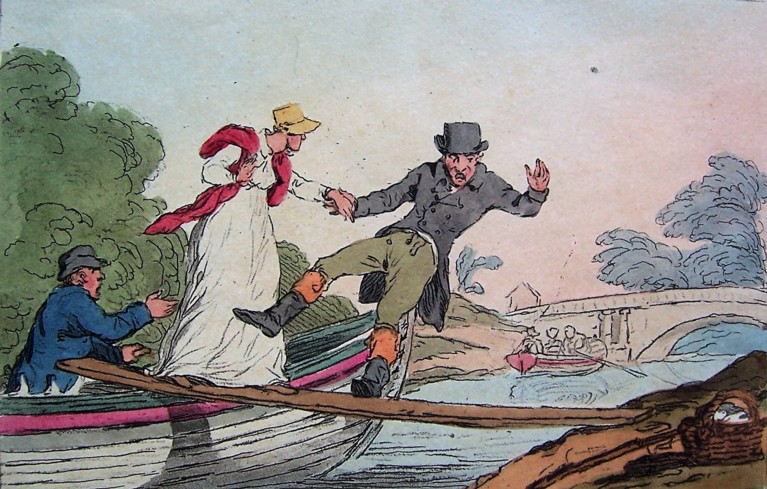
Above and Below; Pls 6 and 7: ‘Miseries Miscellaneous’ (Atkinson).
Another plate shows the misery of ‘handing a Lady out of a boat along a rickety plank – sacrificing your own footing to save hers’, although the text advises unchivalrously ‘Seize, seize the plank thyself, and let her sink…’
But indoors teems with ‘Miseries Domestic’, such as ‘Squatting plump on an unsuspected cat in your chair’, or a servant’s dropping the tea-urn just as he is passing you, breaking your leg while scalding you with boiling tea.
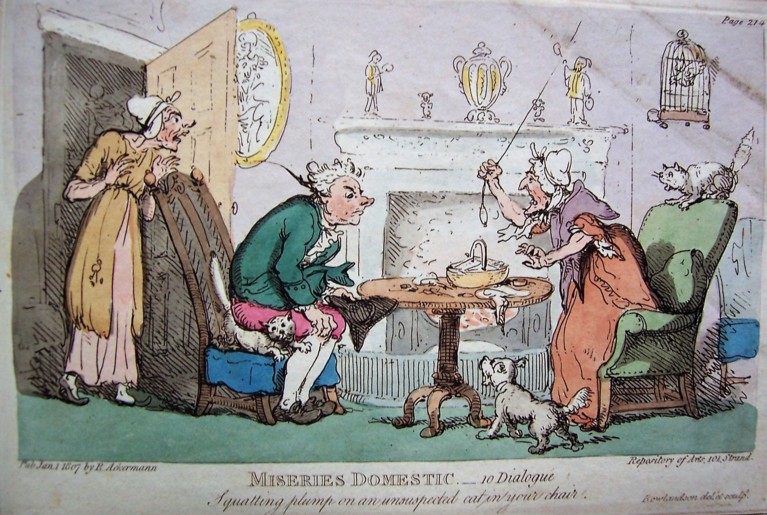
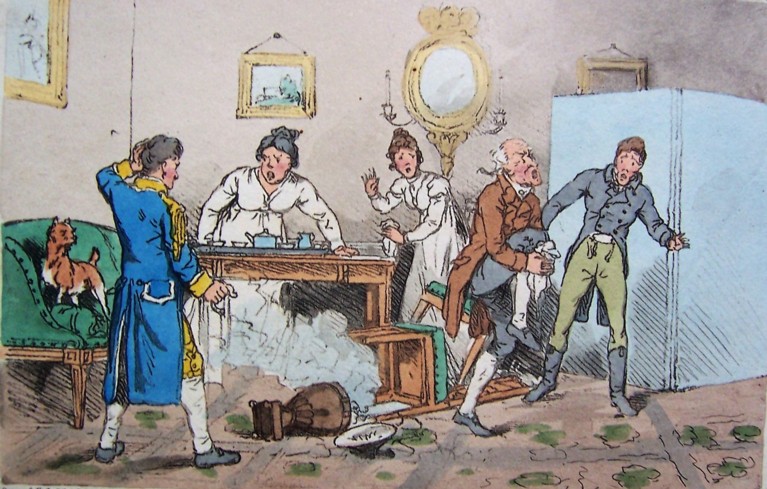
Above and Below; Pls 8 and 9: ‘Miseries Domestic’ (Rowlandson; Atkinson).
‘Miseries of the Table’ include the mortification of inviting friends to ‘partake of a fine hare haunch’ which you judge perfect but which they find rank, and ‘which is no sooner brought in than the whole party, with one nose, order it to be taken out’.
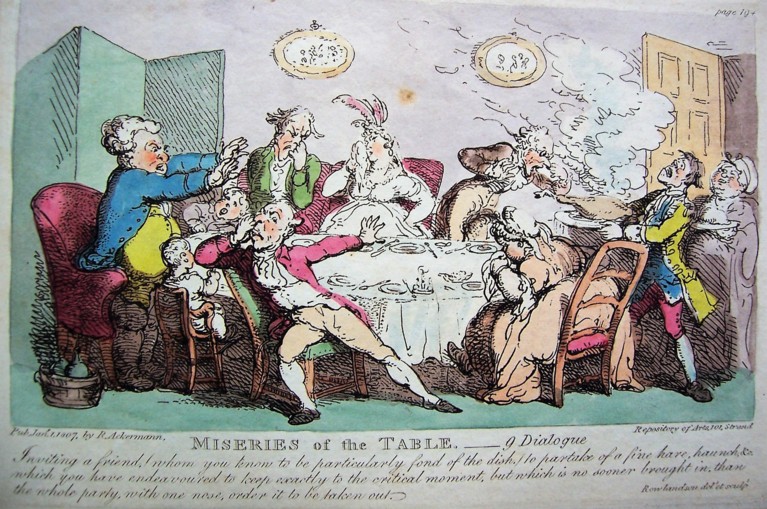
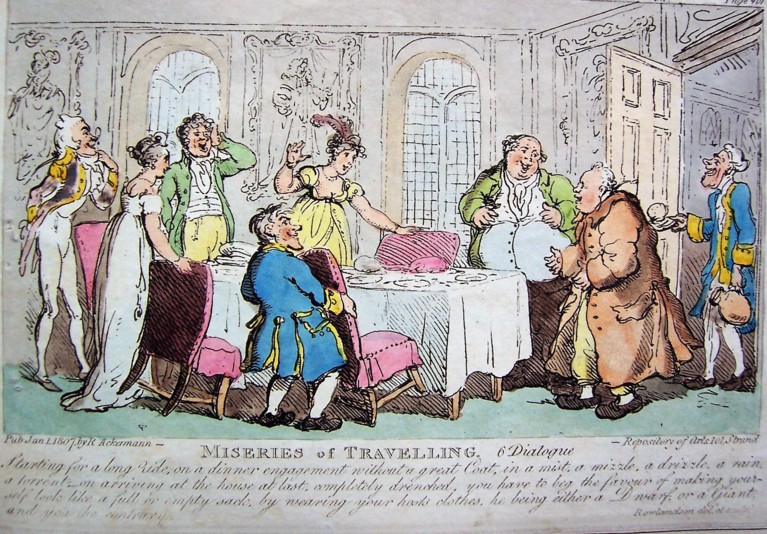
Above and Below; Pls 10 and 11: ‘Miseries of the Table’ and ‘Miseries of Travelling’ (Rowlandson).
‘Miseries of Travelling’ involve getting drenched en route to a dinner engagement and the mortification of ‘looking like a full or empty sack’ in clothes borrowed from one’s host, ‘he being either a Dwarf or a Giant’.
Some miseries voiced by female speakers question the control of their thoughts and lives by men. One is the misery of ‘as you are writing drowsily by the fire, on rousing and recollecting yourself, find your Guardian in possession of your secret thoughts, which he never ceases to upbraid you of’.
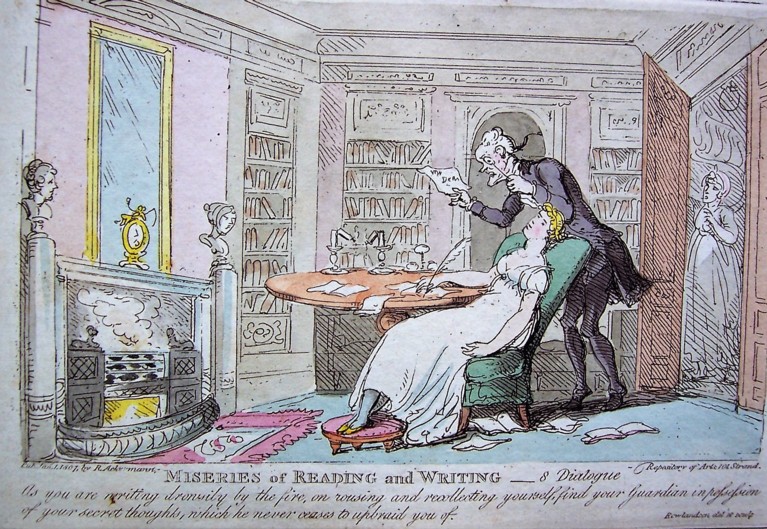
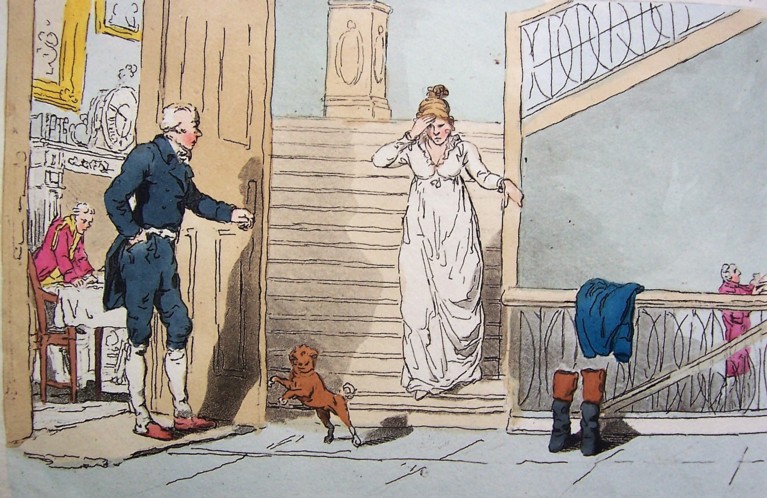
Above; Pl 12: ‘Miseries of Reading and Writing’ (Rowlandson). Below; Pl 13: ‘Miseries of Fashionable Life’ (Atkinson).
‘Miseries of Fashionable Life’ include ‘on crawling down to the breakfast room, with a gambling head-ache upon you already, encountering the figure of your husband’.
The miseries of being a gouty invalid greeted by a strapping naval visitor who unthinkingly squeezes the invalid’s hand in a vice-like grip while treading on his ‘tenderest toe’ is an emblem of the world-view in these illustrated books – so alert to all the insults, agonies and mortifications that the sensitive soul suffers in daily life.
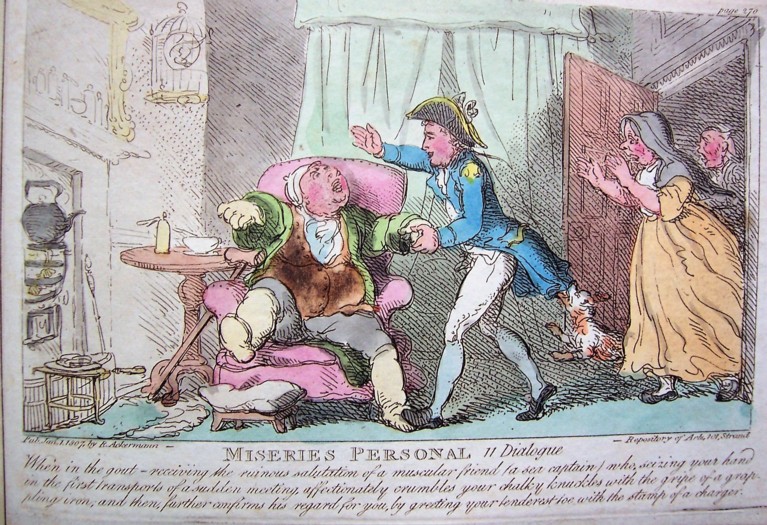
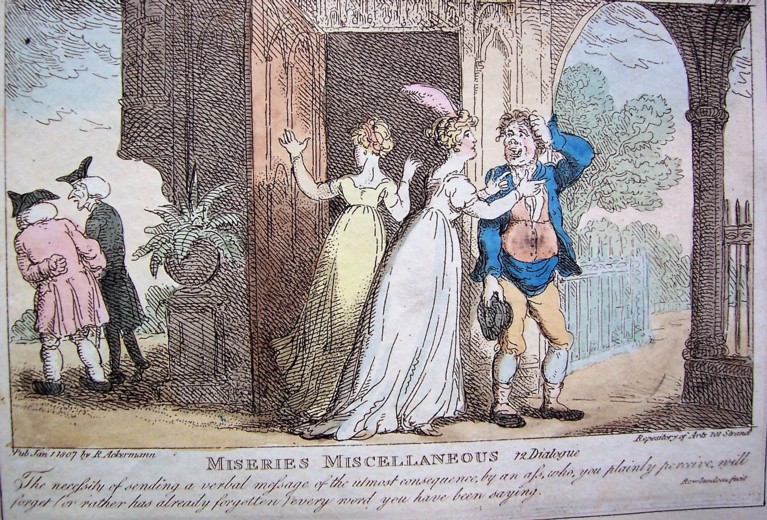
Above and Below; Pls 14 and 15: ‘Miseries Personal’ and ‘Miseries Miscellaneous’ (Rowlandson).
Perhaps the greatest misery is being surrounded by fools, and it is no accident that it is a young woman, possibly on some secret errand of the heart, who has ‘the necessity of sending a verbal message of the utmost consequence by an ass, who, you plainly perceive, will forget (or rather has already forgotten) every word that you have been saying’.
These books may appeal because, while the miseries they record are supposedly minor, we know that such incidents can irritate, humiliate and wound us, and there is a satisfaction in seeing those miseries acknowledged here as inseparable from life.
Barry Windeatt (Keeper of Rare Books)
Images by Helen Carron (College Librarian)
16 March 2023
.jpg)
A new drama series about Lady Jane Grey, the Nine-Days Queen, is promised for later this year. Comedic in tone, it stretches truth to the point of allowing Jane to retain both her head and the throne. Previous dramatisations of her tragic story have not gone this far, although most have certainly had a relaxed attitude towards historical veracity. An early cinematic portrayal was Tudor Rose, a Gainsborough Pictures production of 1936. It boasted a stellar cast and featured a winsome performance from teenage starlet Nova Pilbeam, who made a valiant attempt to inhabit the 1550s, although her coiffure clung determinedly to the 1930s. The name ‘Miles Malleson’ appears twice in the film’s opening credits: firstly, for contributing the ‘Dialogue’, and secondly, as a member of the cast.
With a running time of only 75 minutes, Tudor Rose romps along at a cracking pace and proved popular with audiences. Graham Greene, however, reviewing it in The Spectator, declared that he had ‘seldom listened to more inchoate rubbish’, and considered the film’s inaccuracies and cheap sentiment to embody a ‘Dark Age of scholarship and civilization’. Ouch! It is true that Malleson, faced with the task of compressing six years of history into a screen period of about six months, had been obliged to supply a good deal of stilted expository dialogue, which nevertheless failed to provide an entirely coherent narrative. The most entertaining scenes, perhaps not surprisingly, involve Malleson’s own character, the Duke of Suffolk (Jane’s father), here presented as a bumbling nonentity stoically enduring his snooty wife’s put-downs.
William Miles Malleson was a member of Emmanuel College. He was admitted in 1908 and graduated three years later, having read Music and Part I History. An active member of the college’s Debating, Historical and Mildmay societies, he also sang with the Emmanuel Quartett, who performed with ‘great success’ his own composition, Why so Pale, at the Musical Society’s Lent Term concert in 1909 (an event marred by ‘the rowdiness of a very small portion of an otherwise appreciative audience’). Emmanuel did not have its own dramatic society at that time, but Malleson regularly participated in Cambridge University theatricals, making quite a name for himself.
During his final year, Malleson wrote a short sketch entitled A Curtain Raiser in One Act for Two Men and a Voice, which he read to the Mildmay Club in October 1910. A melodramatic parable involving two aitch-dropping criminals, one of them bent on murderous revenge (the off-stage ‘Voice’ is that of the woman they both love), the playlet was printed in the 1910-11 college Magazine. Malleson must have had hopes of its being performed, as he supplied copious stage directions, but there seems to be no record of its being put on, at least not in college.
.jpg)
Miles Malleson’s signature (middle left) on Mildmay Club dinner menu, 1953
After graduating, Miles Malleson embarked on a highly successful acting career. Indeed, his lengthy list of film credits has been described as reading ‘like a history of British cinema in the first half of the 20th century’. Not possessing a physiognomy that met the requirements of a leading man, he specialised in playing supporting and character roles, particularly comic ones. He also penned many original and adapted screenplays, so Greene’s coruscating review of Tudor Rose clearly did not crush his spirits permanently. Malleson kept in touch with Emmanuel (one of his sons came here) and paid a return visit in February 1953, when he was ‘delighted’ to be guest of honour at the Mildmay Club’s annual dinner. He gave an address on the theme of ‘Truth’, and afterwards related some amusing anecdotes about Dame Edith Evans.
Amanda Goode, College Archivist
16 March 2023
As we speed into March I think it’s fair to say that the garden department are ready for Spring to Spring into action. Although technically February was a reasonably dry month and maybe a little warmer than average, it definitely didn’t feel it. The winds have been cold and the clouds have remained.
The new build, although near completion, due to many delays, is not quite ready for the garden team to complete the planting. All the mature trees and hedges are now in though and certainly give an instant impact to the buildings. Hopefully soon we can gain access to the site as we need it.
The reflective pool in South court will be the last thing to be completed and it will be nice to see the water and plants in the pool once complete.
The garden team have been working their way through the list of late winter pruning and assessing how many plants we have lost due to the heavy and prolonged cold spells towards the end of 2022. We have been busy starting to prepare for this season. Many seeds have been sown in the glasshouse as the shoots that are coming through give us hope of what is to come. We have been busy taking cuttings and potting plants on to the next size.
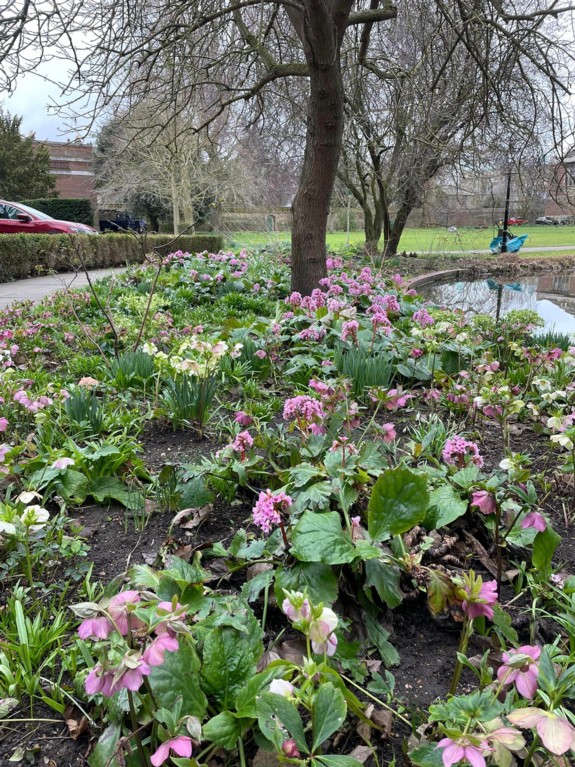
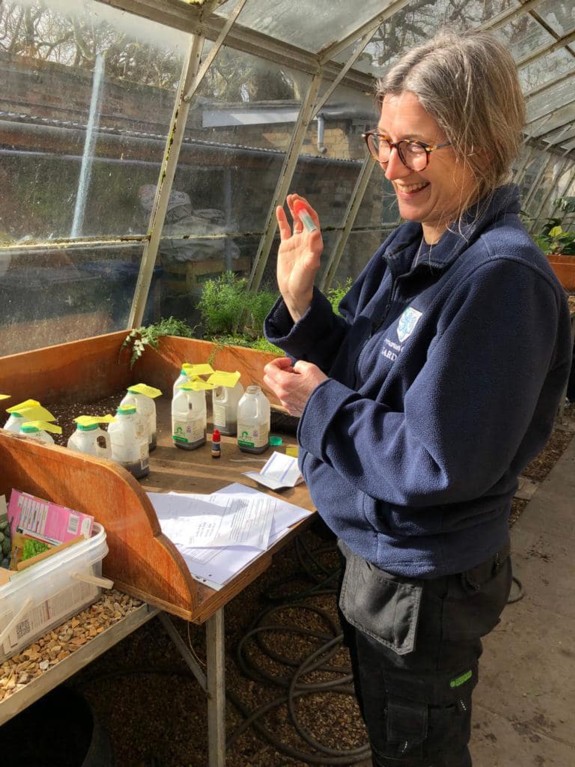
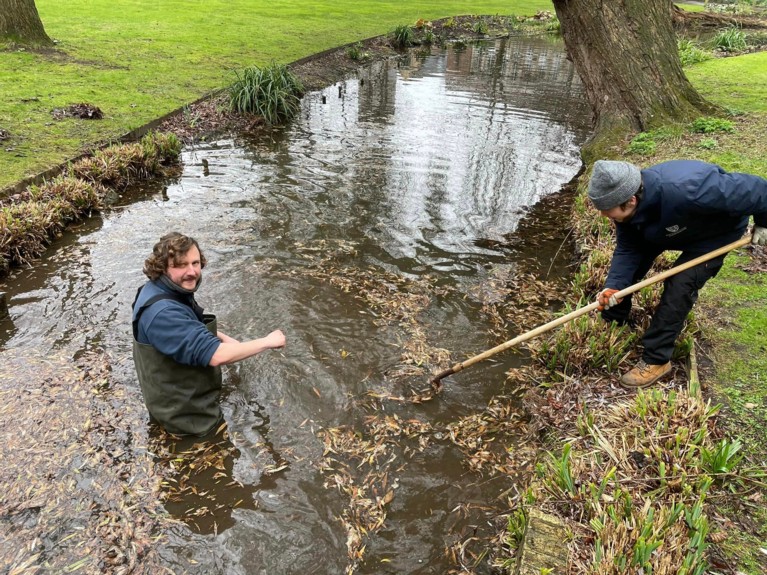
Above left; Planting by the Paddock Pond; Above right; Kate soil testing; Below; Clearing Chapman's Pond
Last week I gave a garden talk to a packed audience for the Cambridge Horticultural Society. I had been invited to give a lecture on Wildflower Gardening and How Emmanuel Manage Wildflower Meadows. The audience was packed with amateur and professional gardeners including other College Head Gardeners. It was good to share with others the experiences that people connected to the college regularly see.
At the end of February, the garden department said goodbye to gardener Jonathan Strauss. Jon has taken the next step in his career to follow a dream to become self-employed and work towards building his own business. Although the department are sad to see Jon go, we wish him well in the future. It has been a pleasure having Jon in the department. Most people will remember Jon for representing Emmanuel College in the Grand Final of the Young Horticulturist of the Year Competition. Obviously Jon will not represent Emma this time around but we congratulate our gardener Douglas Day on reaching a place in the Regional final for the second year running.
This year’s Regional Final will be held at Grimsthorpe Castle in Lincolnshire on Saturday 25th March. The Grand Final is being held at Emmanuel College this year. It will be a privilege to host such a prestigious competition here at Emma.
The Department have successfully recruited two new gardeners who start in April. We needed to replace Jon and also Phil Bland who retired at Christmas. The department now welcome Andrew Luetchford who joins from Trinity College Cambridge and Sally Mackenna who joins from Kirtling Towers Suffolk and the University Botanical Gardens Cambridge. Both applicants bring skill and passion about horticulture to the department and we are exciting to blend then in with our already fantastic team.
Best Wishes
Brendon Sims (Head Gardener)
16 February 2023
The long Winter continues (as least it feels long). The garden is just waiting to spring back to life and not a minute too soon for us in the garden team. After months of cold weather and some really hard frosts, along with snow, we are ready to move forward. There are glimpses of colour with the Winter aconites and snowdrops, coloured stems of the Cornus and Willows and fragrances from the winter flowering Viburnums and Wintersweet trees (Chimonanthus praecox) and Daphne’s.
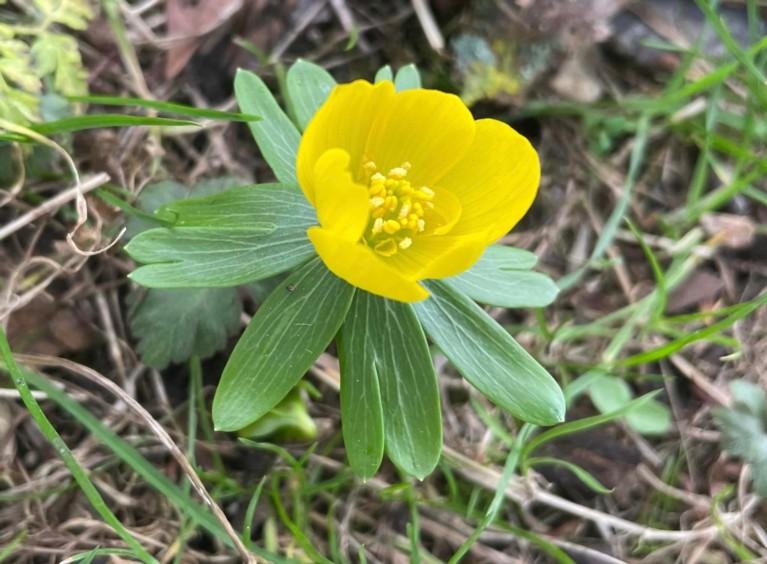
Above; Winter aconite
There will undoubtedly be some casualties to some of our plants given the severity of the frosts. Emmanuel College Gardens are not alone in this either. A trip to the Cambridge University Botanical Gardens at the weekend confirmed this. Many of the other college Head Gardeners are also keeping their fingers crossed for minimal damage.
The dormant season does however give us an opportunity to do some replanting. Last Summer, the large Buxus Topiary Balls in Chapmans Garden had been severely attacked by Box moth caterpillar. It was only a matter of time before those plants succumbed to this devastating pest. Due to the large size of these box plants, treatment was difficult to keep these at bay. We did continue to spray the plants with an organic natural pesticide as well as feed the plants with and organic feed in a hope to keep them healthy, however it was fighting a losing battle.
With every disappointment in gardening there is an opportunity. It was time to remove the sad looking plants and give Chapman’s border a fresh new look. Out went the old plants and in came three new specimen features, the biggest being a mature Turkish hazel tree (Corylus colurna). We also added two Redblud trees (Cercis canadensis ‘Forest Pansy’). These new additions give Chapmans garden a complete new facelift and will add a fresh new look to viewers from Fiona’s (the Hub). There is also a new sundial to look forward to once put in position.
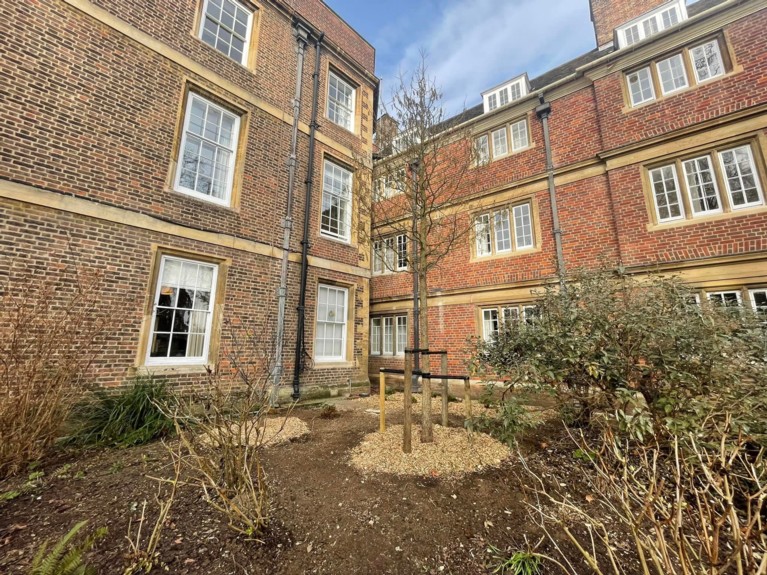
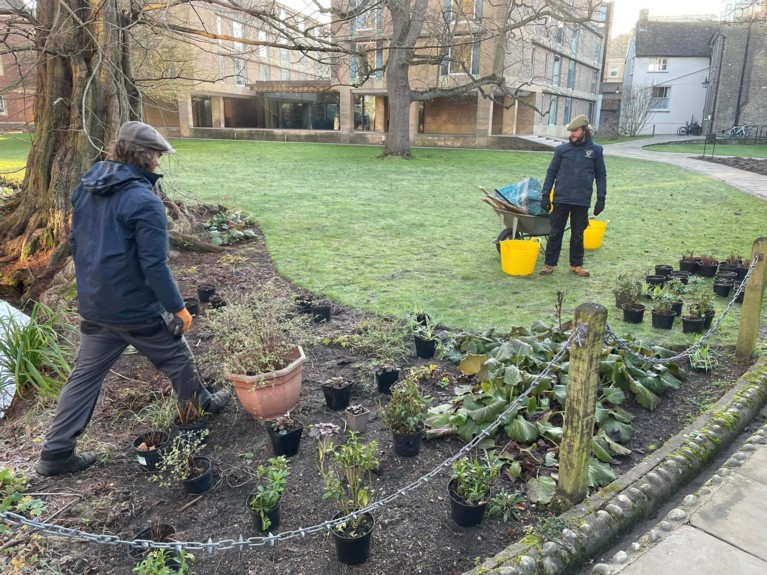
Above; Left to Right; Planting in Chapman's Garden
We have also been taking advantage of the time of year to add some extra planting under the Dawn Redwood tree (Metasequoia glyptostroboides) in Chapmans by adding Sarcococca plants for fragrance as you walk over the bridge.
As Head Gardener, most of my attention is turning to the planting of the new build. The mature trees in South court are just about planted and the planting of the Yew hedges have begun. The site is still under construction but we are just about ready to start planting up the rest of the landscaping around the buildings. It will make a great difference to the ambience of the courtyards and soften the harshness of the buildings.
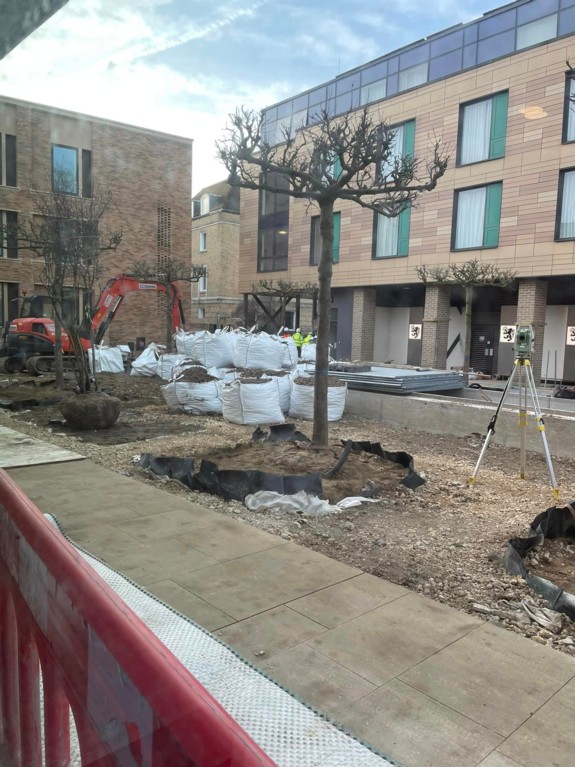
Above; New Plane trees in South Court
The garden department are also looking for a new facelift. At the end of February our gardener Jonathan Strauss will leave the garden team to pursue his dream of working for himself. Although it is sad to lose such a talented gardener, we wish Jonathan every success in the future, and thank him for his contribution to making Emmanuel gardens what they are today. We are currently advertising to replace Jon and Phil who retired in December.
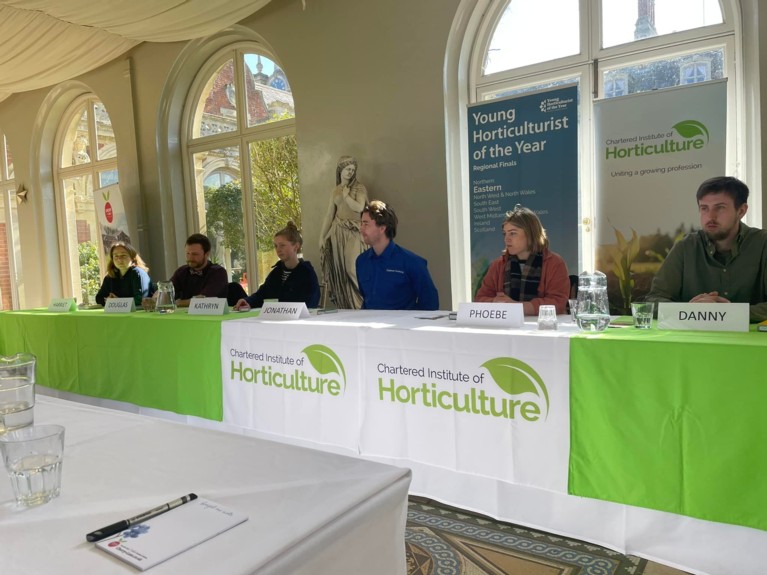
Above; Young Horticulturist of the Year Final 2022
The last piece of news involves the announcement that I have been having to keep secret for some time now. We can now announce the Emmanuel College will host the Young Horticulturist of the Year Grand Final. This is a huge achievement for the college. The national competition will put the Emma gardens in the limelight once again, following on from being announced an unmissable garden by the RHS and Cambridge Gardens Trust last year. It truly feels like a golden age for the gardens.
Best Wishes, Brendon (Head Gardener).
16 February 2023
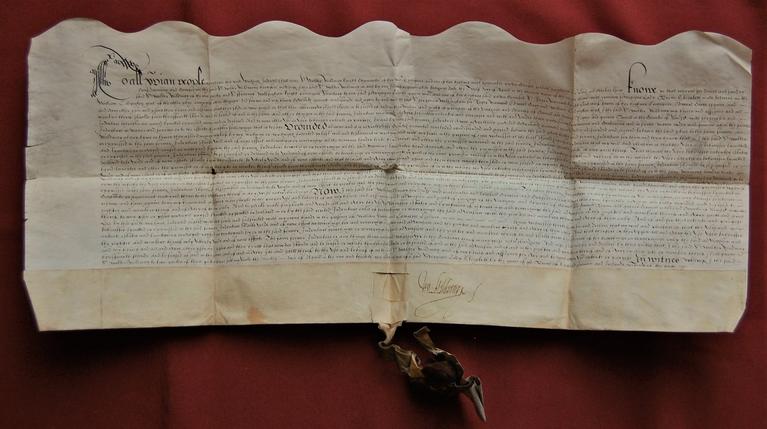
Emmanuel College owns some two dozen advowsons. These incorporeal hereditaments, to use the legal jargon, confer the right to present a clergyman to a parish ‘living’. As the college’s founding ethos was the training and dissemination of a Puritan priesthood, the possession of an adequate number of clerical livings to which it could appoint its own men was of prime importance. Within a few years of its foundation the college had already acquired a dozen advowsons, and it defended its title to these valuable possessions against any challengers. It was not always successful.
The advowson of Puddletown, Dorset, was one of three granted to Emmanuel in 1586 by Henry Hastings, 3rd Earl of Huntingdon, an old crony of the college’s Founder, Sir Walter Mildmay. In 1639 Lord Huntingdon’s great-nephew, the 5th Earl, contested the college’s right of presentation to all three livings, the issue being whether his great-uncle had held them in fee simple, or tail, which would have affected his right to dispose of them. The college managed to hang on to two of the advowsons, but judgement was given against it in respect of Puddletown.
Failure to make a promise watertight was the cause of a bitter dispute about the living of Beckley, Sussex. The incumbent, Emmanuel graduate John Holman, also owned the right of presentation. He told the college in 1657 that he intended to grant it the Beckley advowson, but never sent any legally binding confirmation. The college was later assured by a go-between that a deed of gift had indeed been drawn up and was in safe hands, but when Holman died in 1673 his executors declared that they could find no trace of such a grant. Convinced that Holman’s heir had suppressed it, the college began legal proceedings, but either dropped or lost its case a year later.
A testator’s woolly wording prompted a lawsuit many years after his death. In 1704 Henry Mildmay, a descendant of the Founder, had bequeathed to Emmanuel the next three turns of the advowson of Henstead, Suffolk. The college duly exercised its right, but when the third appointee finally died in 1792, Mildmay’s heirs demanded the reversion. The college disputed this claim, on the grounds that the ‘expression used by the Testator is so inaccurate & defective that it is impossible to say with any certainty what he meant’. Despite receiving mixed advice about the wisdom of taking legal action, the college went ahead, but its cause was unsuccessful.
Perhaps the most galling, and certainly the most embarrassing, case, involved Queen Camel, Somerset. This was one of two advowsons presented to the college in 1588 by Sir Walter Mildmay. He revoked the Queen Camel grant on 9 April 1589, but re-conveyed the living to the college two days later, via a clause in a title deed primarily drawn up to augment the other advowson. The reasons for this rigmarole are uncertain, but close to death and having made his will a few days earlier, Sir Walter may have been anxious to give the college a more secure title to the Queen Camel living. If so, his good intentions had precisely the opposite effect, for the Emmanuel authorities, rather incredibly, overlooked the re-conveyance, and considered the deed of revocation to be the Founder’s last word. Almost two centuries later, having discovered its error, the college sought legal advice about reclaiming the advowson, but was advised that its case was now ‘barred & without Remedy’. The resulting chagrin can only be imagined.
Amanda Goode, College Archivist
19 January 2023
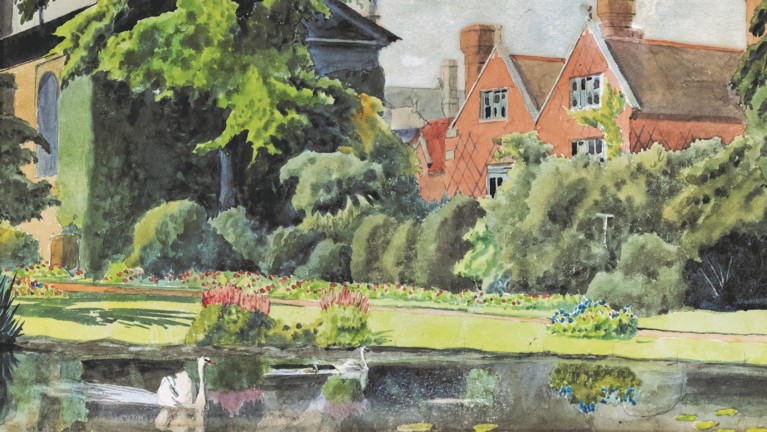
Swans on the Paddock pond, with the Chapel and old Master's Lodge in the background
Thomas Young was, according to his epitaph in Westminster Abbey, ‘a man alike eminent in almost every department of human learning’. It is therefore fitting that the new court at Emmanuel is to bear his name. Young was admitted here in March 1797, ostensibly to study for the M.B., but as he was already a qualified physician he spent his time reading widely and conducting scientific experiments. Some years ago, the late Dr Frank Stubbings, college Fellow and librarian, noted that ‘an attractive tradition has it that [Young] first observed the phenomenon of ‘interference’ in the ripples set up by two swans on the Emmanuel pond. This phenomenon…was important to his arguments for a wave theory of light’. The origin of this ‘tradition’ is obscure; the earliest allusion to it in the college archives seems to be an entry in a student society’s minute book.
In 1929 the college’s Natural Science Club changed its name to the ‘Thomas Young Club’, and proposed that members should have a distinctive new tie. After considering various patterns, it was decided in February 1930 to adopt ‘the original design with swans’. Photographic evidence shows that this tie had a repeating motif of two diagonal parallel lines containing a row of swans. The lines were an allusion to Young’s famous ‘double slits’ experiment, and the swans, clearly, referred to Young’s supposed observations of ‘interference’ on the Paddock pond. By the mid-1940s the design had been modified, with the swans now being much more widely spaced. Perhaps they had been too reminiscent of a row of target ducks in a fairground booth!
(1).jpg)
Thomas Young Club tie, donated by Donald Maxwell (1944)
Clearly, an oral tradition about Young’s swans had existed for some time before 1930, but did it derive from anything other than mere whimsy? One element of the story is certainly dubious, for there is no evidence that Emmanuel had any resident swans until well after Young had gone down. Presumably, though, ducks or moorhens could have produced the same ripple effects. It is also indisputable that Young himself never directly mentioned either of our ponds, or the swimming bath, in any of his writings. The college archives are equally silent; the Parlour wager books, for instance, contain no obliging references to any watery experiments carried out by Young during his three years’ residence.
It seems likely that it was the following famous passage in a pamphlet Young published in 1804 that (probably much later) gave rise to the ‘swans’ tradition: ‘Suppose a number of equal waves of water to move upon the surface of a stagnant lake, with a constant velocity, and to enter a narrow channel leading out of the lake. Suppose then, another similar cause to have excited another equal series of waves, which arrive at the same channel, with the same velocity, and at the same time with the first…Now I maintain that similar effects take place wherever two portions of light are thus mixed, and this I call the general law of the interference of light’.
This description of a still lake with a narrow outfall does sound very much like the Paddock pond, and it is certainly tempting to imagine that Young had it mind when developing his theory. True, he declared, in the same 1804 pamphlet, that it was not until ‘May 1801’ (that is, a year after he went down) that the full revelation of the ‘law’ of interference came to him in a moment of inspiration, but it is possible that he was subconsciously remembering the Emmanuel wildfowl. Whether fact or fiction, however, the ‘swans’ tradition is a charming story.
Amanda Goode, College Archivist
19 January 2023
Returning to work in January is never easy. This coming year we are full of hope as to what might be. The excitement of the new build planting schemes, a major announcement for the College in Feb (more to follow), the longing of Spring days and t shirt weather again.
What we were actually greeted with was the fallout of all the cold, icy, snowy weather that prolonged before the Christmas break. As pretty as the wintery scenes were, it did hang around a little too long. In this country we are not quite used to long spells of cold and snow (at least in the last few decades). Snow is usually here for just a day or two and then quickly melts away. Last year saw temperatures drop below -10c and also with a wind chill factor of well below that. That ice and snow lay on top of our borders for two weeks or more.
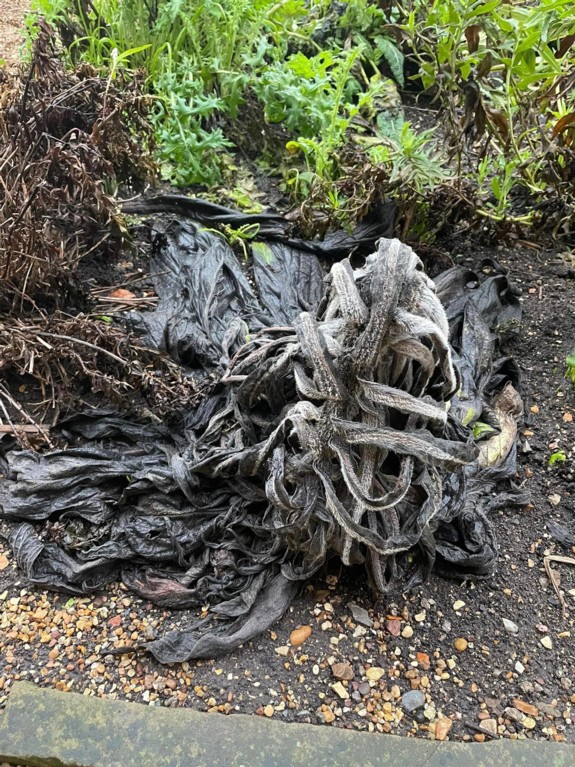
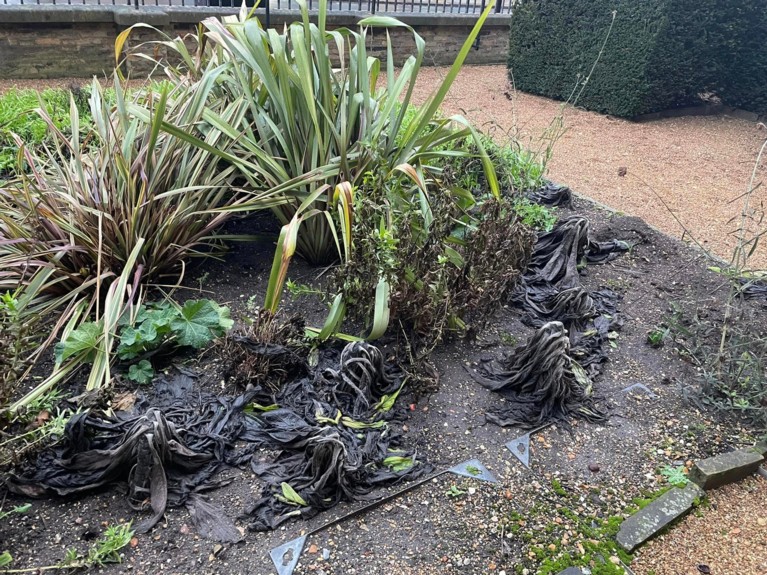
All last season’s planning and growing was taken away from us within just a few weeks, with some plants already struggling from the excessive heat and droughts of the Summer of ’22. The year 2022 will go down as one of the most challenging of my career to date. However, I was not alone. Many of the other College gardens also suffered. For those that know me well will know that I am forever the optimist. That glass is never half full or empty, it has just had a few sips from it. For every disappointment there is an opportunity. A chance to look forward not back. The gardens will look great, one way or another.
One opportunity that we look forward to is welcoming our new apprentice Izzie Hare. Although she technically joined the Emmanuel Garden Team in mid-December ’22, it was a get to know the team period before started with us here in the gardens and also at college studying at King’s College Cambridge. Izzie has fitted into the team very well and we look forward to teaching her new skills and plant knowledge through ’23 and beyond.
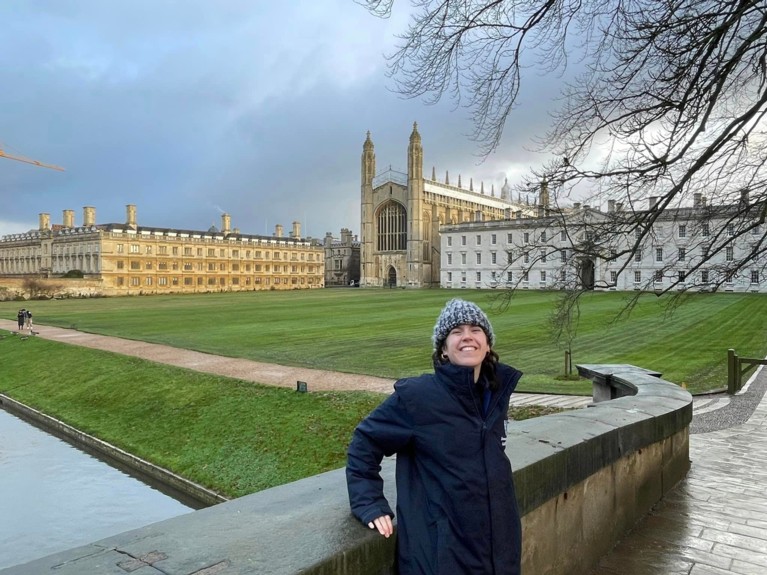
Part of that opportunity will be part of the new Landscaping projects connected with the Emmanuel new build. We get to the part that interests us gardeners the most. The mature trees have been delivered and started to be installed. It starts to give structure to the built environment and softens the otherwise dominating buildings. The connective spaces between these buildings is the most interesting in my mind. The ultra-modern facilities that the buildings offer are amazing and are indeed a very welcome sight to new users. I, however will be more interested in how people use those connective spaces. The mature table pruned Plane trees behind the new Hub look magnificent in their skeletal form. They will provide shade in a hot courtyard and at the same time clean the air. The Plane tree is a superb urban tree, storing carbon at its root source whilst removing carbon dioxide from the atmosphere and releasing oxygen back into the atmosphere. A real pollutant filter.
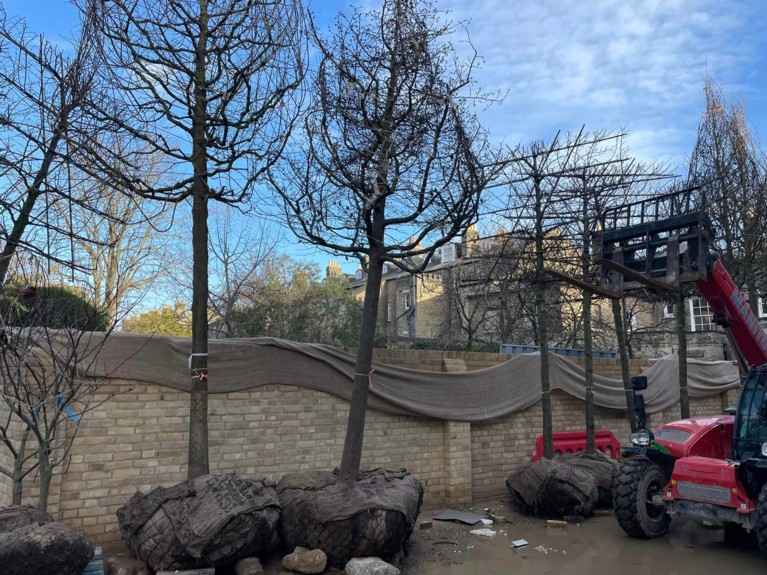
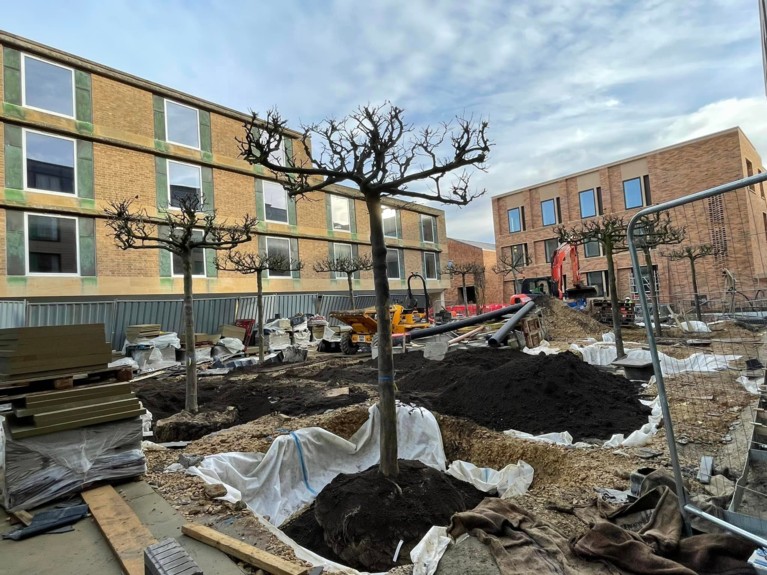
.jpg)
So, as we start to accelerate into ’23 we look at lessons learned from the past but look to the future. A future full of promise and anticipation. I will look forward to sharing this progress with you in future installments of this blog.
Best wishes
Brendon Sims (Head Gardener)
19 January 2023
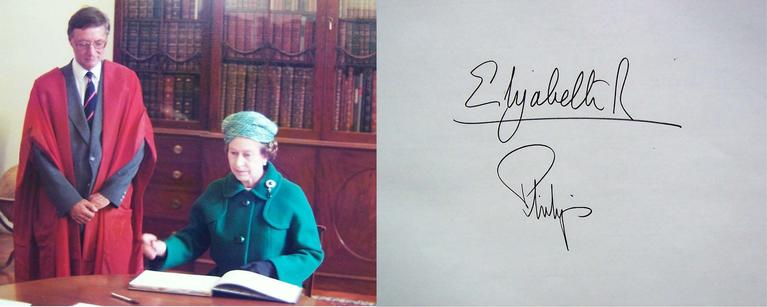
Signatures, mottos and inscriptions, as well as other indications of ownership and association, are especially meaningful aspects of any historic collection; they are also serendipitous, reflecting the operations of chance in what ends up where.
‘And how did this come to be here?’ asked the late Queen, when shown the earliest printed book in Emmanuel Library, a text of Cicero’s De Officiis, during her visit marking Emmanuel’s fourth centenary in 1984. This was apparently a standard question asked by Queen Elizabeth when shown – as she regularly was – items about which she might well wonder why they weren’t still in her collections. Although this text of Cicero may be printed, some of the borders have been exquisitely painted in the manner of a medieval manuscript. Inclusion in the borders of the Prince of Wales feathers and the motto ‘Ich Dien’ (I serve) indicate that the book probably belonged to Prince Arthur, elder brother of Henry VIII. The Queen’s question about how it came to Emmanuel could not be answered, but it was already in the College by 1600.
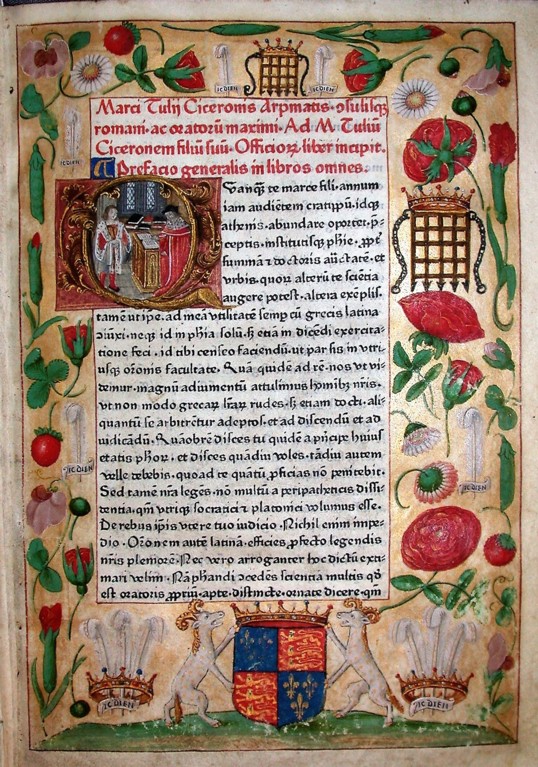
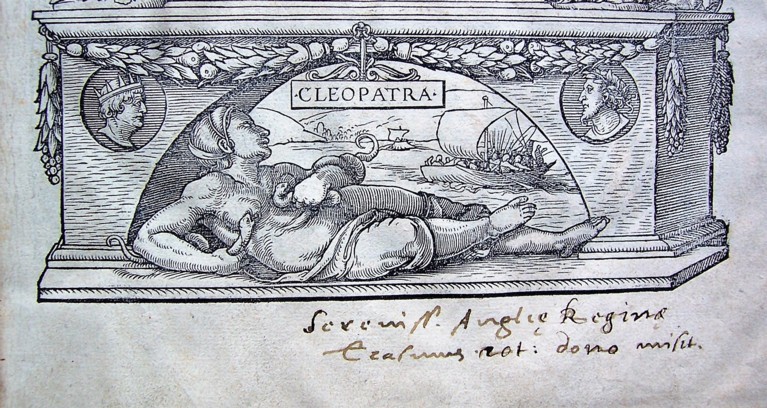
Above, Top; Pl. 3: Cicero, De officiis (Mainz, 1465), Above, Bottom; Pl. 4: Title page of Erasmus, Christiani matrimonii institutio (Basle, 1526), inscribed ‘To the Most Serene Queen of England, Erasmus of Rotterdam presents this as a gift’.
Another unique book of Tudor royal ownership is Emmanuel’s presentation copy of a work about Christian marriage that Queen Katherine of Aragon asked Erasmus – the great Dutch scholar and Christian Humanist – to write for her daughter Mary (the future Queen Mary I, or ‘Bloody Mary’). On the title page is Erasmus’ dedication of his book to Queen Katherine in his own hand. This book will be on display at a major exhibition about the Six Wives of Henry VIII at the re-opened National Portrait Gallery in 2024.
Among the Early Modern books in Emmanuel Library that once belonged to famous people are nine titles from the library of the dramatist and poet Ben Jonson. These can be identified by his inscribed Latin motto ‘tanquam Explorator’ [as it were an explorer], or by the inscription ‘Sum Ben. Jonsonii’ [I am Ben Jonson’s], or both.
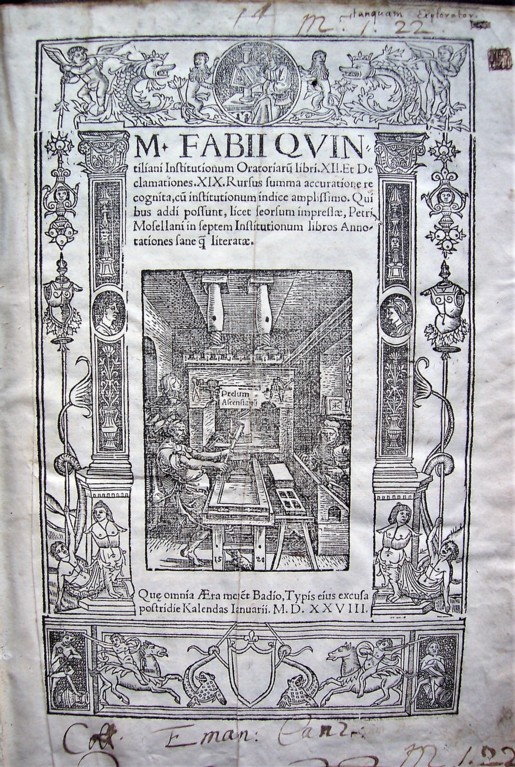
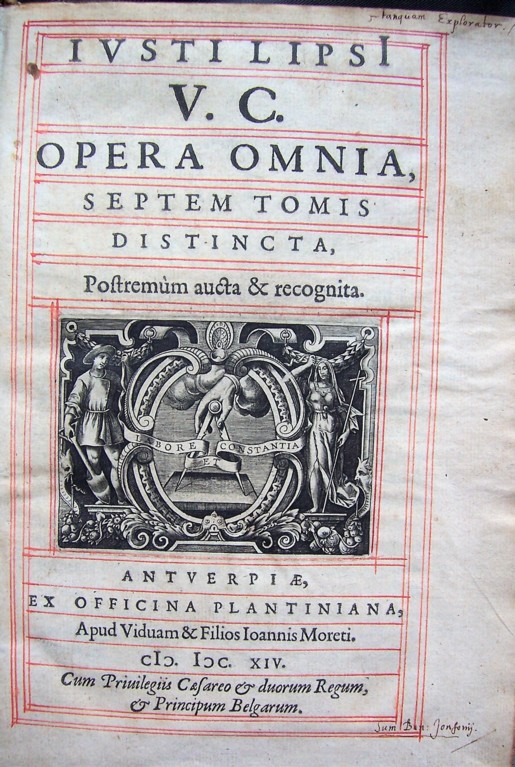
Above, Left; Pl. 5: Title page of Justus Lipsius, Opera omnia (1614-23), with the motto ‘tanquam Explorator’ (at the top) and ‘Sum Ben. Jonsonii’ (near the bottom). Above, Right; Pl.6: Title page of Quintilian, Institutionum oratoriarum (1528), with Jonson’s motto ‘tanquam Explorator’ at the top.
Emmanuel also has seven books that belonged to the ‘Metaphysical’ poet and divine, John Donne, as indicated by his neat signing of his name ‘J. Donne’ on the title pages, and his Italian motto from Petrarch: ‘Per Rachel ho servito & non per Lea’ [I have served Rachel and not Leah – referring to Jacob’s two wives in Genesis, traditionally understood to represent the lives of contemplation and action respectively].
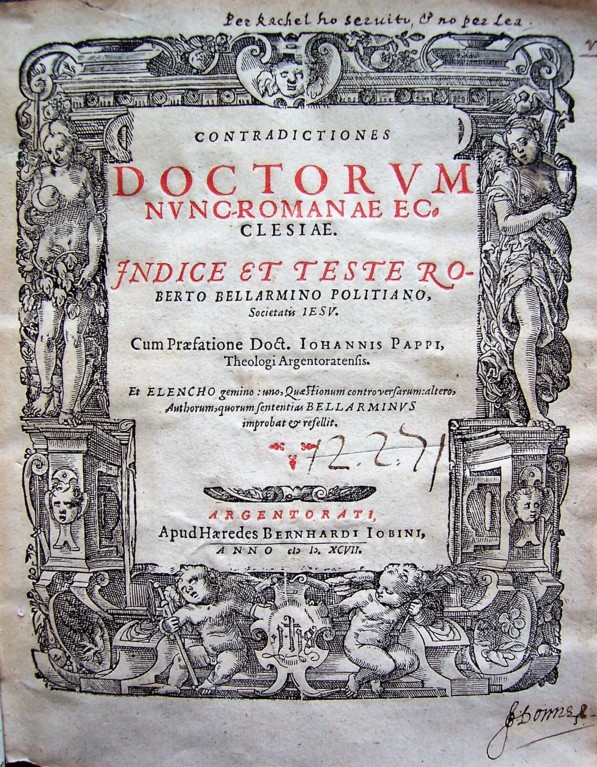
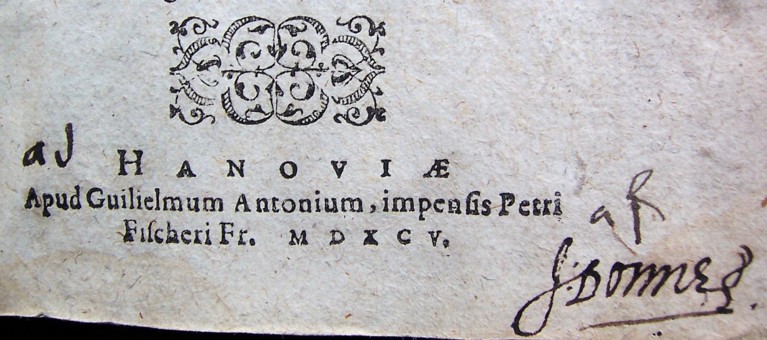
Above, Top; Pl.7: Title page of Bellarmino, Contradictiones doctorum … (Strasbourg, 1597), with Donne’s motto ‘Per Rachel ho servito & non per Lea’ at the top and his signature ‘J. Donne’ near the bottom. Above, Botton; Pl. 8: Detail of John Donne’s signature from the title page of Themis Hebraeo-Romano (Hanau, 1595).
Ownership and associations of books might also be indicated by armorial bindings, where the coat of arms is stamped in gilt on the binding. Emmanuel has a book from the library of Sir Francis Bacon – statesman, philosopher, scientific thinker – with the head of a boar in gilt on the binding, in a play on ‘bacon’. The books donated to Emmanuel in 1659 by Rachel Fane, Countess of Bath (a great-granddaughter of the College’s founder, Sir Walter Mildmay), have both the Countess’s armorial device gold-tooled on the covers and her bookplate inside.
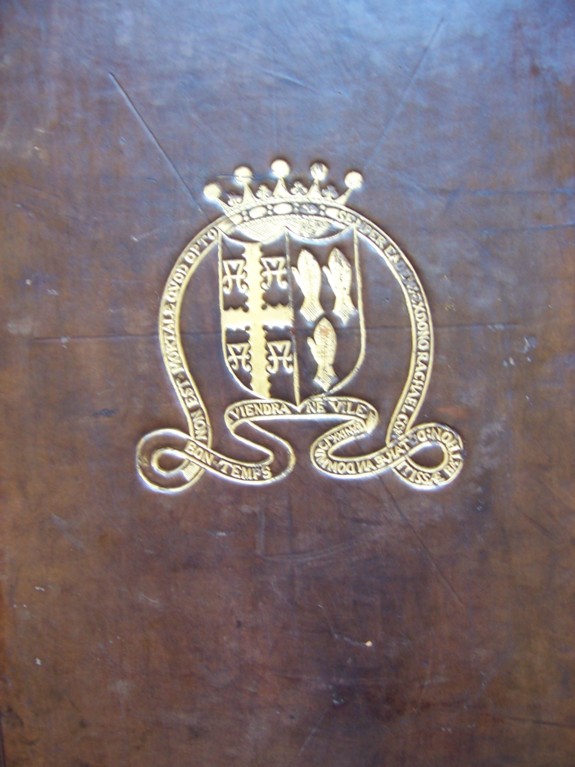
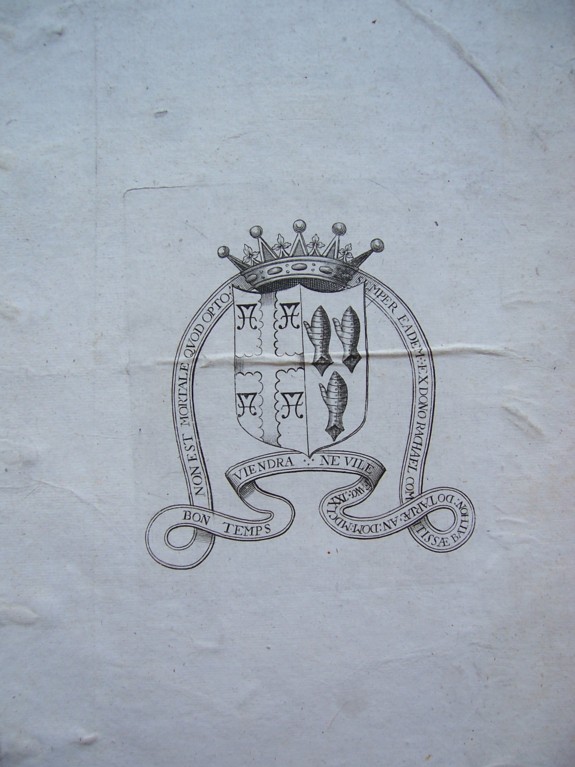
Above, Left; Pl.9: Rachel Fane’s armorial binding with her arms as Countess of Bath. Above, Right; Pl. 10: Rachel Fane’s bookplate.
Nearer to modern times the Library has a very random selection of works signed by known names. On musical themes, there is a copy of the composer Frederick Delius’ atheistical Requiem, ‘To the Memory of All Young Artists, Fallen in the War’ (Leipzig, 1921).
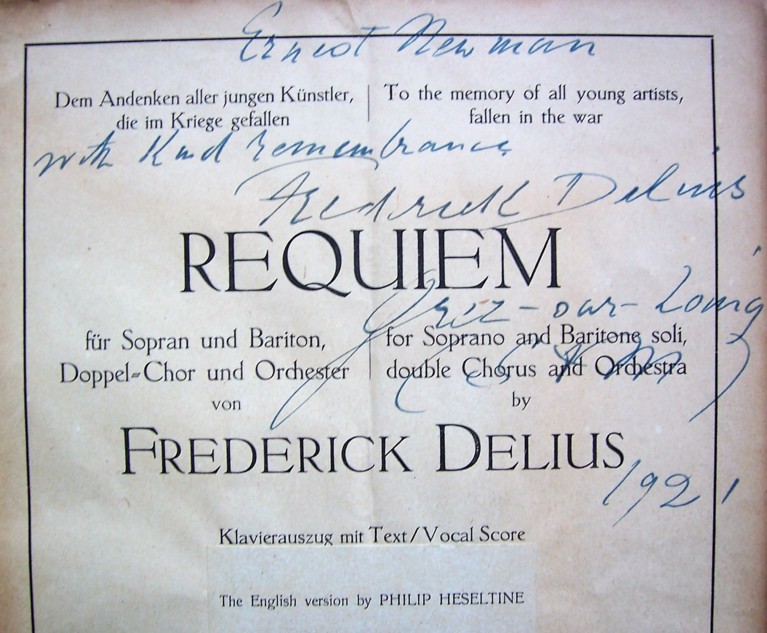
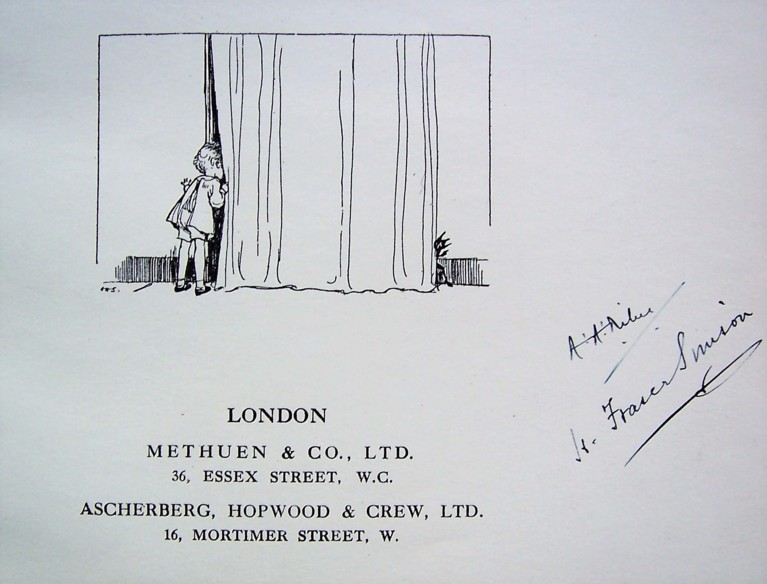
Above, Top; Pl.11: Signed title page of Delius’ Requiem. Above, Bottom; Pl.12: Signed title page of A. A. Milne’s Fourteen Songs.
There is also a copy of Fourteen Songs from ‘When We Were Very Young’ (1924) signed on the title page by A. A. Milne, of Winnie-the-Pooh fame, who wrote the words of the songs, including ‘They’re changing the guard at Buckingham Palace’.
Other inscribed books include an edition of Kipling’s poems signed by the poet, and a book given to Princess Louise as a New Year’s present in 1870 and inscribed by her mother Queen Victoria.
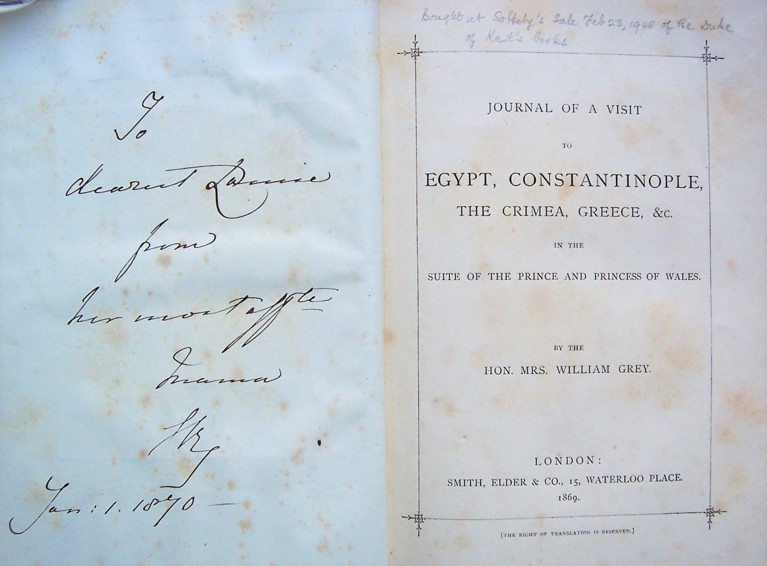
Above; Pl.13: Inscription reads: ‘To dearest Louise from her most affectionate Mama, VR: Jan 1 1870’. (Purchased by Graham Watson at the 1948 sale of the library of Prince George, Duke of Kent).
During the evolution of the Queen’s Building in Lord St John of Fawsley’s time as Master, several photographs that were to hang in the new building received some notable signatures. When she visited to lay the foundation stone, the Princess of Wales signed a photograph of herself, and when they came to officially open the building the Queen and the Duke of Edinburgh also signed photographs.
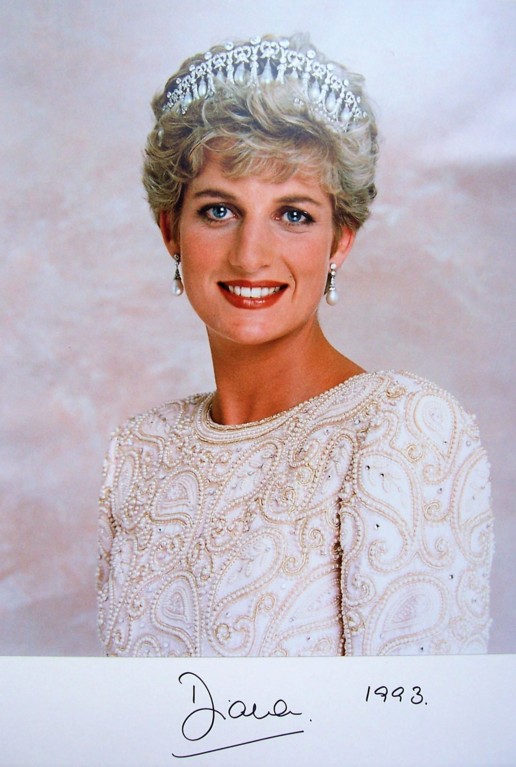
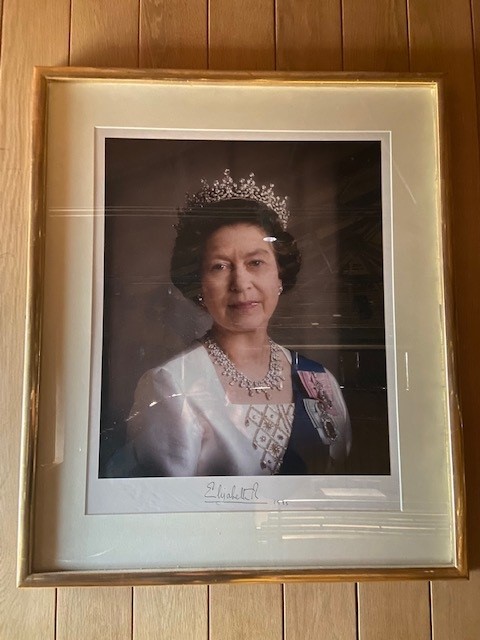
Above, Top; Pl.14: Photograph signed by Diana, Princess of Wales, 11 November 1993. Above, Bottom; Pl. 15: Photograph signed by Queen Elizabeth II, 19 April 1995.
Alas, fountain pens can prove to have minds of their own on these occasions. As the Queen attempted to complete the ‘R’ of ‘Elizabeth R’, the pen temporarily failed to work. ‘Oh Ma’am,’ exclaimed an over-excited Lord St John, ‘do go on to the end of the “R” …!’ A certain hush fell, as the Queen remarked quietly, as if to herself: ‘Now I call that cheeky …’ But no one will be surprised that – notwithstanding the disobliging pen – Queen Elizabeth then gamely pressed on to the end of the ‘R’.
Barry Windeatt (Keeper of Rare Books)
Images by Helen Carron (College Librarian)
15 December 2022
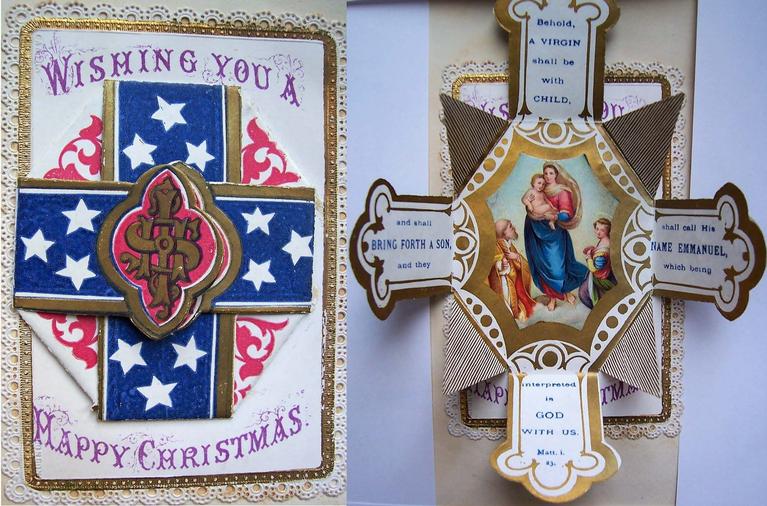
Included in some Victorian scrapbooks kindly presented to Emmanuel Library by Hugh Pearson (1987) is a collection of Victorian Christmas and New Year cards, plus a stray Thanksgiving card signed ‘Chas’ and sent from the US in 1909. Not discarded after the festive season but carefully inserted into the albums, these cards offer some interesting comparisons and contrasts with more recent Christmas card fashions. One constant is some nostalgic construction of the past, from the upstanding Puritan couple on the Thanksgiving card to a Christmas card that fakes the look of a medieval manuscript to say: ‘accept this good old rhyme, | A relic of the olden time’. Here too is the infestation of robins that continues to today’s cards.
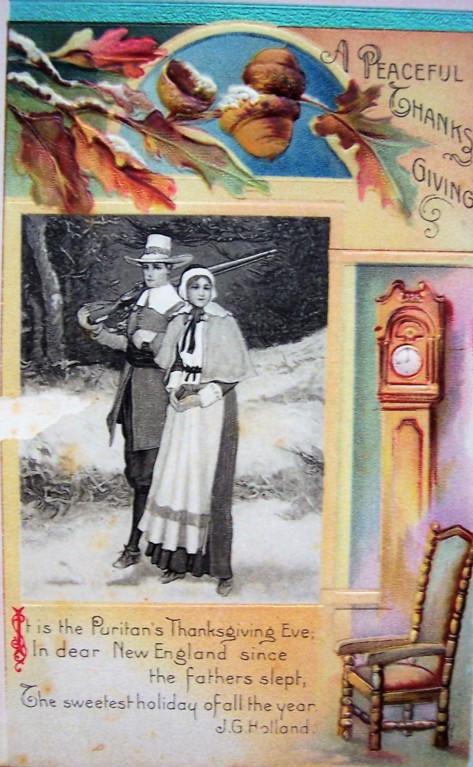
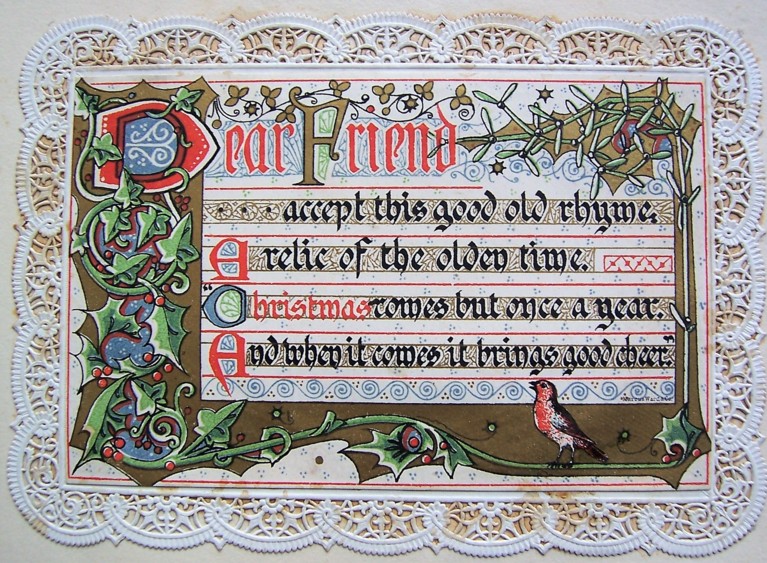
One unusual message for ‘A Merry Christmas’ is in the form of a fan – perhaps for a Christmas dance – with a text declaring ‘Dance beneath the bough … Christmas makes us glad … Who would dare be sad?’
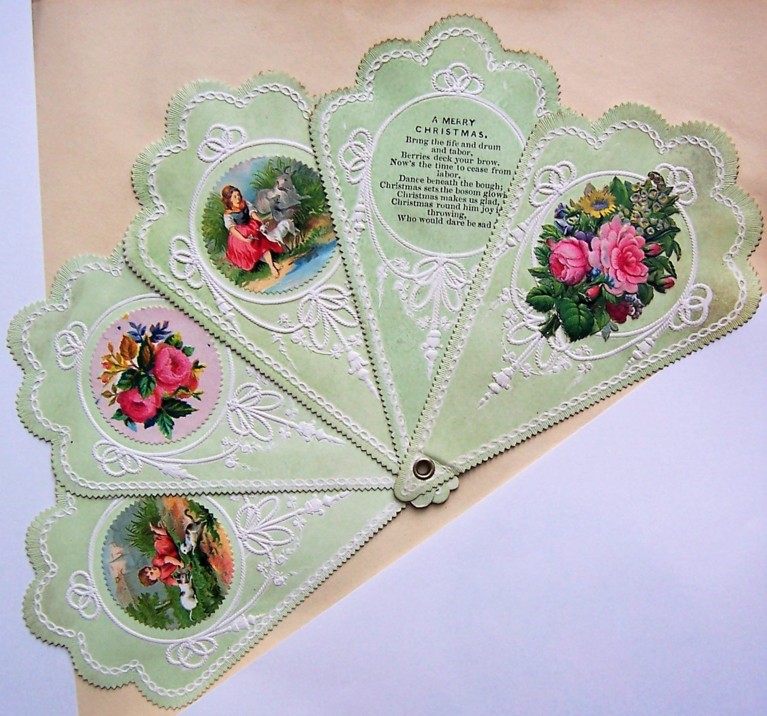
Decoration of the fan, not with holly and snow-scenes, but with the lush flowers of summer and sentimental depictions of small children, is characteristic of the decorative themes of Victorian Christmas and New Year cards.
To a modern eye it appears strange that greeting cards sent at Christmas and New Year should feature roses and other summer flowers hard to find in the middle of a nineteenth-century winter.
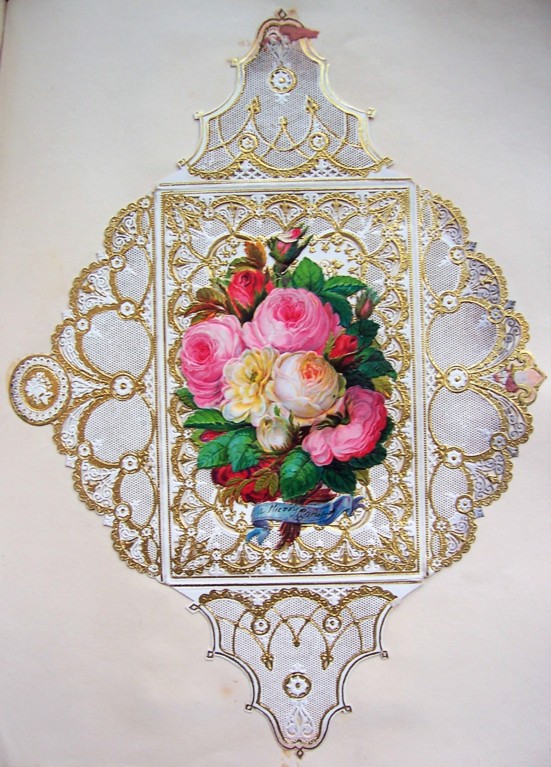
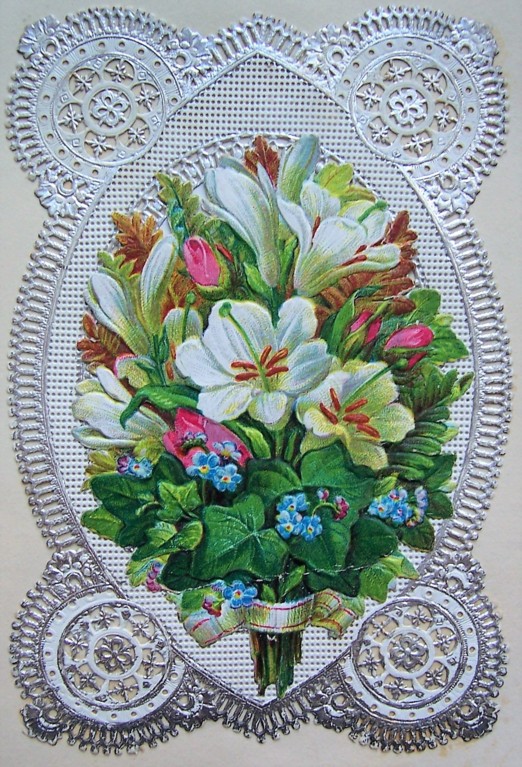
But this, it seems, was precisely the point, as one card in the collection makes explicit.
Rather than dwell on the snows of New Year 1870 as one card does, another card wishes its recipient a Merry Christmas with a picture of exotic orchids, ladybirds and a purple hair-streak butterfly, adding in the text: ‘Our gorgeous early blooms are from a greenhouse home, | Till our own flowers and butterflies shall come’. Bringing cheer at mid-winter is the prospect of summer’s return.
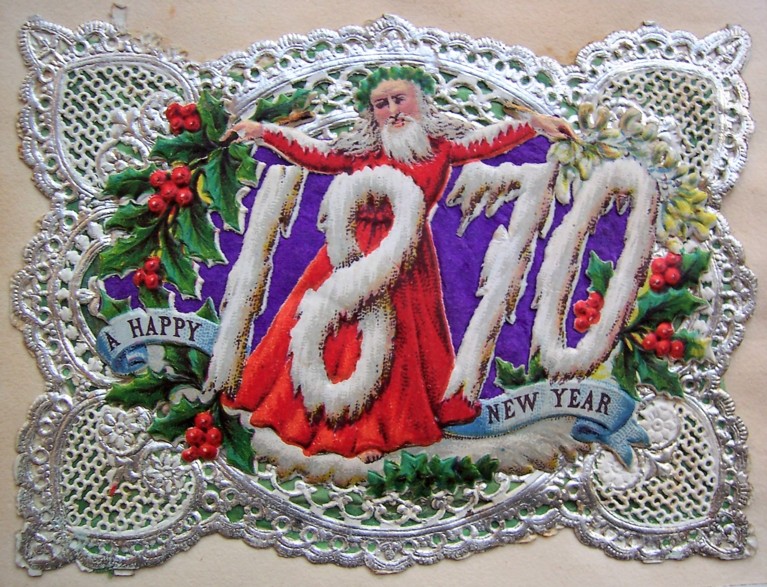
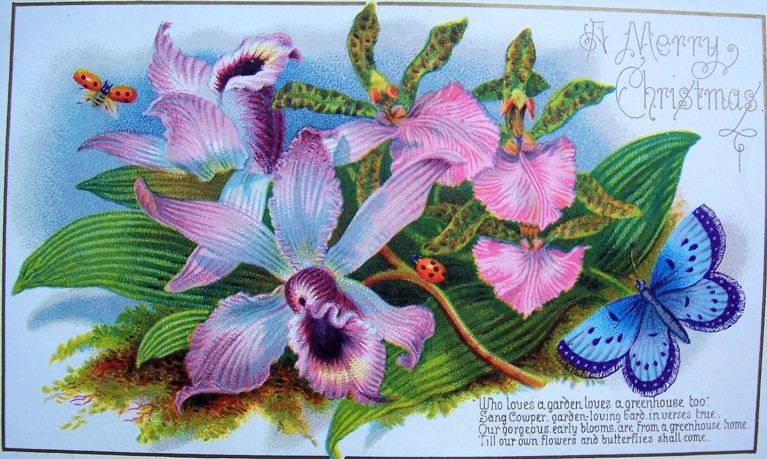
With some cards, the focus is upon a piece of improving text in verse about the season. One New Year message, surrounded by flowers, urges ‘Let us model our spirit to chance and change’, which sounds very distant from our age of health and safety.
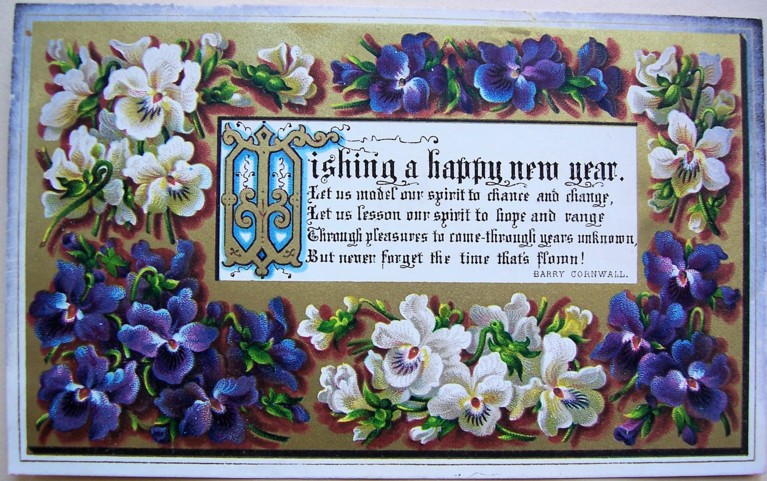
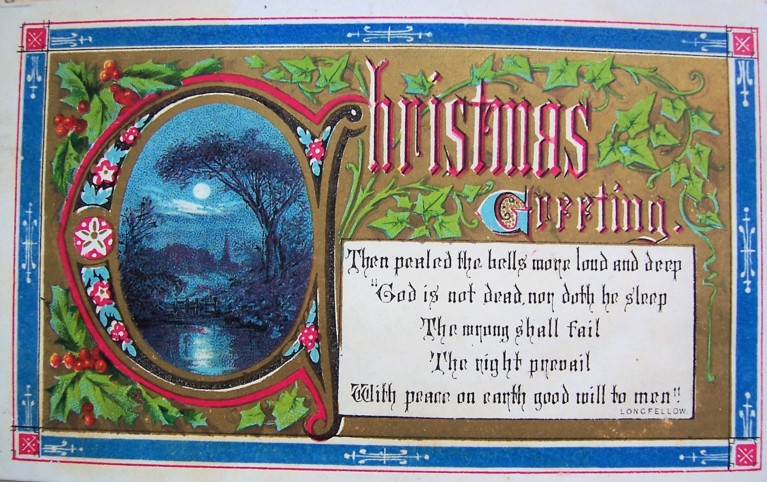
The distinctly un-Christmassy card features stern lines by Longfellow set against a wintry moonlight scene: ‘God is not dead, | Nor doth he sleep. | The wrong shall fail, | The right prevail’. One to tuck behind the aspidistra, perhaps. But, on the whole, the taste of those who sent this particular selection of cards noticeably avoids pious references to the religious significance of Christmas.
Some cards summon up the season with saccharine images of small children at play.
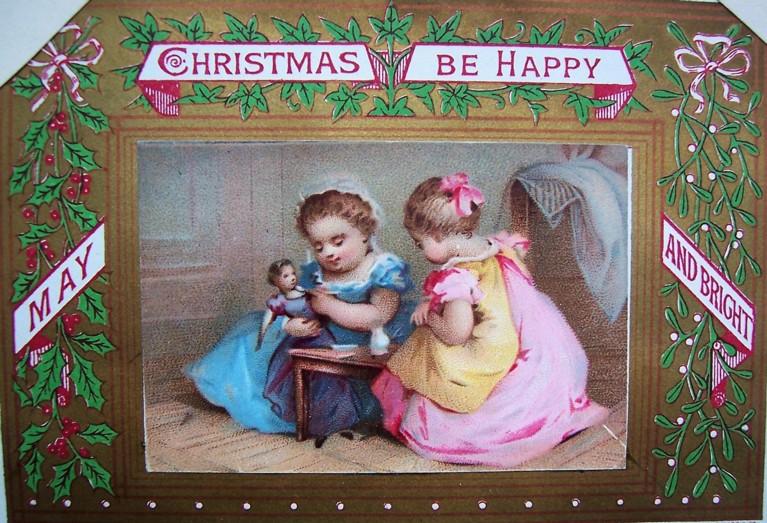
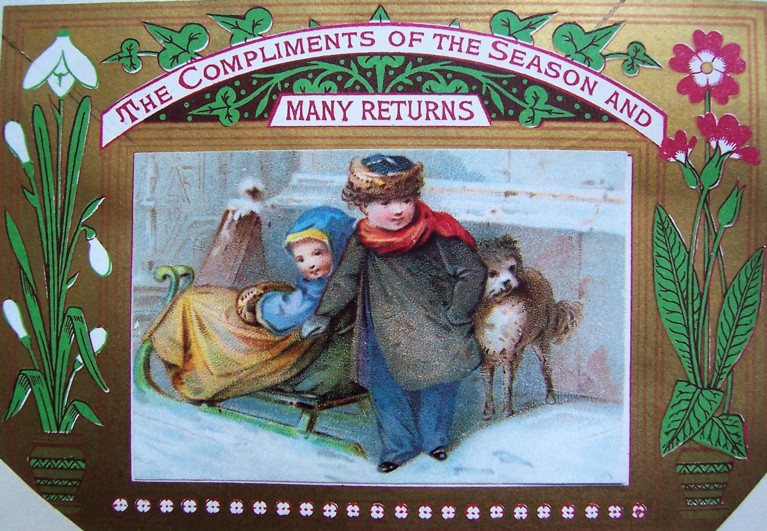
New Year cards often include a wish for ‘Many Happy Returns’, a sentiment later more common on birthday cards.
One New Year’s card shows rather older children gazing seriously out of the picture and into the future, once again framed by a lush wreath of summer flowers.
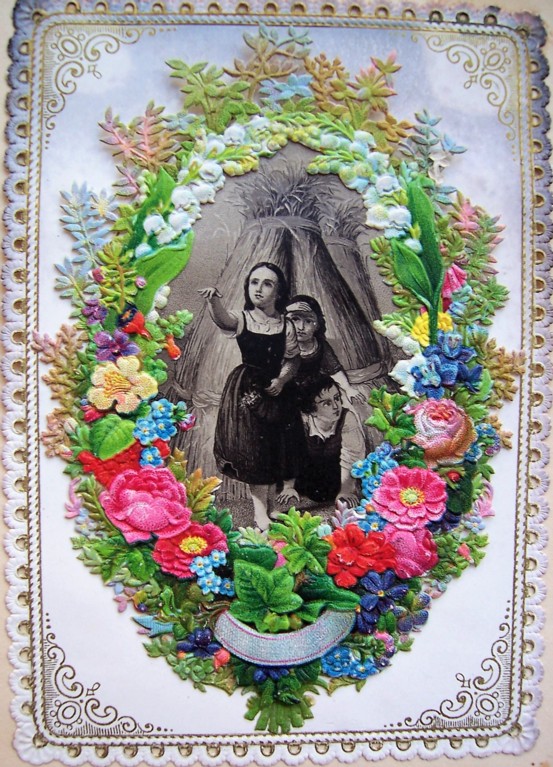
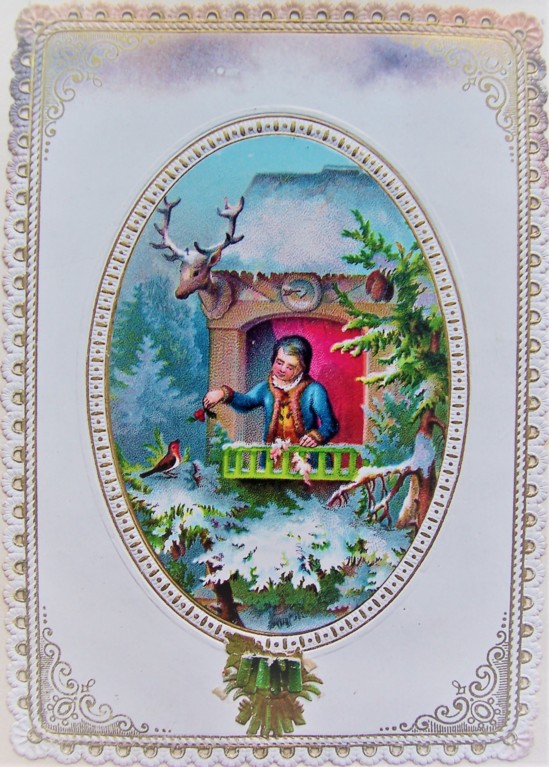
This rather mysterious Christmas card shows a young man on a balcony surrounded by items that probably carry coded meanings. A reindeer’s antlered head is fixed to the outside of the building, and above the man’s head is a small masonry heart pierced by an arrow, while the whole scene is filled with snowy pines, so perhaps ‘the dear – heart – pines’? Pine cones are invested with multiple symbolic meanings, but one possibly meaning is secrecy. Three pine cones hang to the right, and the man holds out three holly berries to a robin, but why? (Victorian postmen wore red uniforms and were known as ‘robins’). This is apparently a Christmas card for a lover to send, where not all may be as it seems.
We wish all our readers a Merry Christmas and a very Happy New Year!
Barry Windeatt (Keeper of Rare Books)
Images by Helen Carron (College Librarian)
15 December 2022
During the First World War, the college’s Acting Senior Tutor, Philip Worsley (‘PW’) Wood, kept in touch with as many serving Emmanuel men as possible. Their letters and greetings cards to him are preserved in the college archives, with other WWI material.
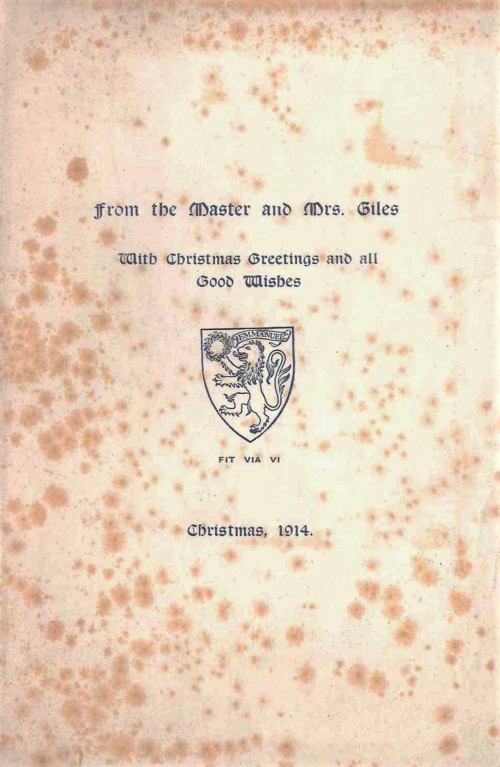
The college Christmas card, 1914
The official 1914 Christmas card sent out by the Master, Dr Peter Giles, and his wife, Mary, included a printed war list of Emma combatants. It was a lengthy list, as there had been a great deal of enthusiastic enlistment, resulting in the college being much emptier by Christmas than it had been at the beginning of Michaelmas term. The Giles’s only son, Alan (not an Emma student), had shot off to London the morning after war was declared, in order to join the army. By December 1914, however, the rising number of casualties and the dawning realisation that the war was not, as predicted, going to be over in a few weeks, had had a profound effect on the nation’s mood. The austere appearance of the Master’s Christmas card reflects this change.
.jpg)
Christmas card sent by Harvey Chrystall in 1915
A year later the mood was even grimmer. Harvey Chrystall (1909), a New Zealander, was attached to the 8th Army Corps, and saw action in Gallipoli. The Christmas card he sent to PW in 1915 had been produced by the map section of the 8th Army Corps, to which he had been attached. A cartoon inside the card alluded to the battles of Krithia and Achi Baba. Shortly after sending the card, Chrystall suffered a severe trauma when ‘a shell burst close to him at Cape Helles’. Invalided to England, his convalescence was agonisingly slow, as detailed in his mother’s letters to PW, but he did eventually recover.
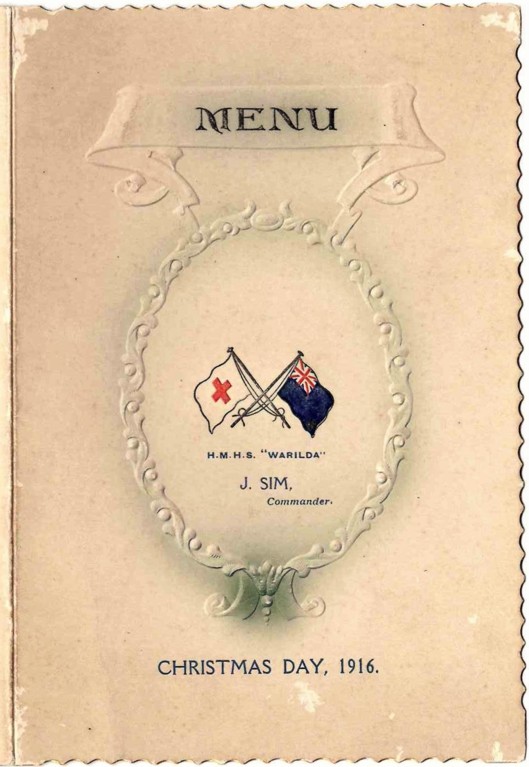
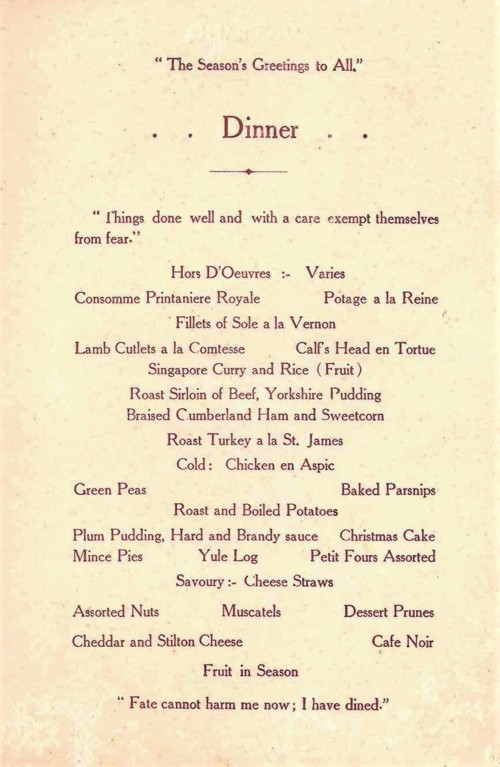
Christmas Dinner menu, HMHS Warilda, 1916
Another of PW’s regular correspondents was Edward Welbourne (1912), later a fellow and master of Emma. After graduating in 1915 he joined the Durham Light Infantry, and in an attack on the German trenches on 26 November 1916, probably near Ypres, his leg was badly wounded. He later received the Military Cross for his part in this action. After a month in a French hospital, Welbourne was invalided home, informing PW that he spent Christmas Day partly on a hospital train, and partly on ‘a boat in Havre, a boat on which I fared sumptuously and yet quietly’. The ‘boat’ was in fact a hospital ship, the ill-fated HMHS Warilda, later torpedoed and sunk by a German submarine. Welbourne preserved the ship’s Christmas dinner menu card. The bill of fare certainly does seem astonishingly lavish, especially bearing in mind that many of the wounded would not have had much of an appetite.
.jpg)
Military Christmas card collected by T S Hele, 1917
Welbourne’s immediate predecessor as master of Emmanuel had been Thomas Shirley Hele, who served in that office 1935-50. A medical student at Emma, Hele had qualified in 1907 and was elected a fellow in 1911. During the war he served with the Royal Army Medical Corps, passing the last two years of the conflict near Salonika. Throughout his overseas service he wrote long, vivid and semi-legible letters to his wife and family, later pasting them into scrapbooks along with other war mementoes. These included postcards, some of which were special ‘military’ ones designed to be sent as Christmas cards. The 1917 postcard shown here had no doubt been enclosed in one of Hele’s letters home, as it does not bear any message.
Amanda Goode, College Archivist
13 December 2022
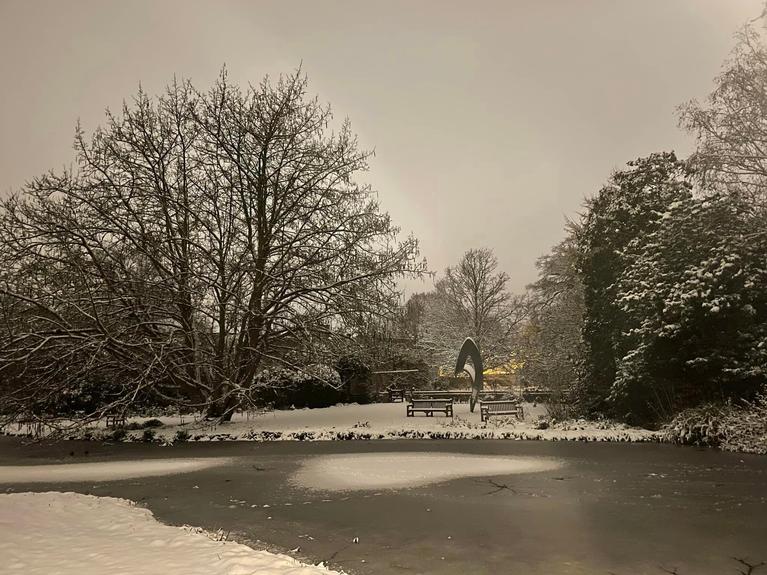
As I write this last blog of the year, I have just arrived at work having cleared about 4 inches of snow from my car. I have arrived at Emmanuel to a wonderful winters landscape. This is perhaps a good way of signing off in 2022.
It has been a pleasant and challenging year but the main theme throughout this year has been the weather. Extremes of heat, drought, extreme winds, large volumes of rain and now to finish it off with a heavy drop of snow. This seems to be the pattern now and something we must all come to terms with.
It was a year packed with content and news for the garden department. In 2022 the former Head Gardener Christoph Keate left his part time role as Gardens Manager to pursue other things. Next came the rounds and finals of the Young Horticulturist of the year competition in which the department had great representation. We appeared in a documentary series about the Hobson’s Conduit and also was chosen by the Royal Horticultural society (RHS) and Cambridge Gardens Trust to feature as a ‘Memorable Garden’ in the Bicycle Boys Exhibition. We leave 2022 with many fabulous memories and hope to create many more in 2023.
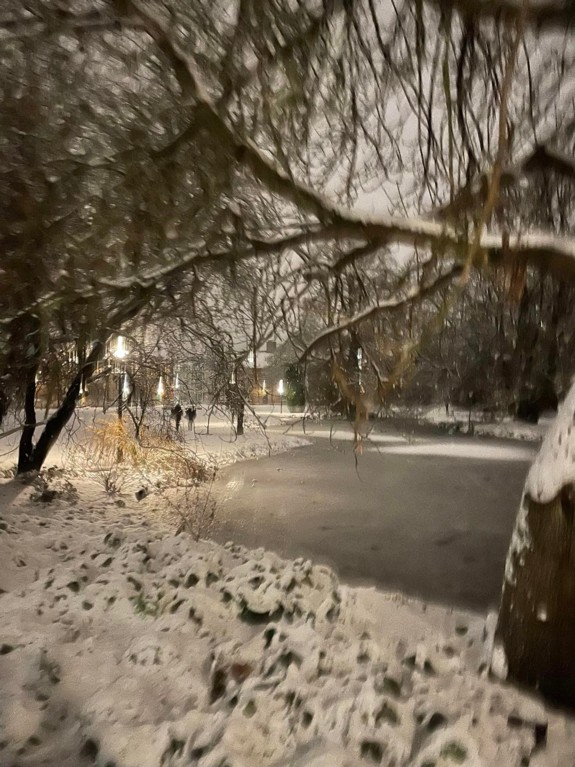
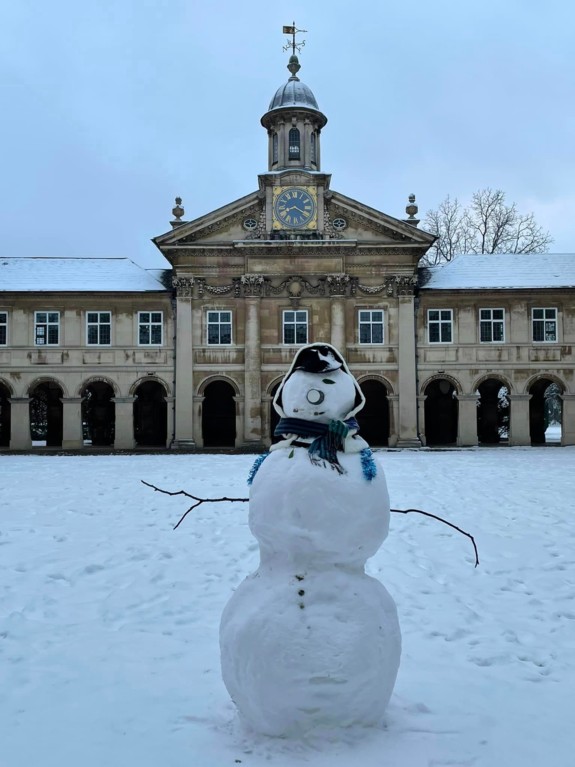
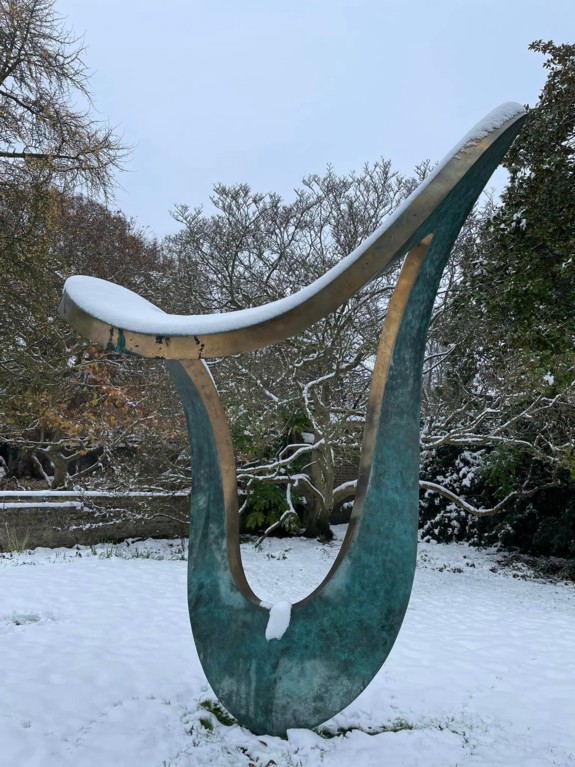
Merry Christmas to all from the Garden Department.
Best wishes
Brendon Sims (Head Gardener)
1 December 2022
Married masters were a rarity at Emma before the mid-eighteenth century. Several masters are known to have been married men at some point in their lives, but not, for certain, during their term of office. Establishing reliable facts about their elusive wives is extremely difficult.
A recent inspection of the Bishops’ Transcripts of the baptism, marriage and burial rolls for the parish of St Andrew the Great, Cambridge, has revealed another hitherto unsuspected, or at any rate unremembered, master’s wife: Elizabeth, consort of Dr John Balderston, Emma’s tenth head of house. Mrs Balderston’s obscurity is unsurprising, given that her husband is generally regarded as one of the most forgettable masters Emma has ever had, despite his long tenure. A search through some of the farther reaches of the college archives reveals that Mrs Balderston does, in fact, make a few appearances in a tenants’ rent-book, but these entries are easily overlooked.
.jpg)
Dr John Balderston, by Thomas Frye, 1732 (posthumously, after an engraving by David Loggan, 1684)
A graduate of Emma, John Balderston was elected Fellow in 1665 and Master in November 1680, at which point matrimony became an option. He may already have had a candidate in mind, as improvements to the master’s lodgings and garden were put in hand soon afterwards, including the new-furnishing of the gallery (then part of the master’s private domain) and the construction of a summer-house. The gallery purchases, costing £17, comprised a set of 30 turkey-work chairs, two Spanish tables and two ‘wrought carpets’. The date of the Balderstons’ wedding is not known, but the St Andrew’s church records show that ‘Elizabeth Balderstone daughter of John, Doc. of Divinity’ was baptised on 14 October 1683. She was very probably the first child born to a serving Master of the college. A second daughter, Susanna, was christened on 15 December 1685.
We get a glimpse of what we may presume to be Mrs B’s taste in soft furnishings, in the accounts for October 1684-April 1685. These record payments of £1.13s for ‘3 yards of Damask for 3 cushions in the lodgings’, and 3s for ‘covering them’. A year later £8 was laid out on ‘dressing the Tapestry Hangings in the Master’s lodgings’ (possibly the ‘8 pieces of hangings’ bought by the college in 1649), followed by purchases of ‘Callico Curtains’ at a cost of £1 13s 4d and a ‘leather Carpet’, priced at 10s. This beautification of the lodgings was approved without any dissent among the fellowship, unlike the 1681 gallery purchases, which had been put to a vote.
.jpg) Entries for Mrs Balderston in the college tenants’ rent book, October 1719
Entries for Mrs Balderston in the college tenants’ rent book, October 1719
Dr Balderston died in August 1719. Two months later a college rent book records that his widow handed over the sum of £157 15s, due from the Dixie, Sudbury and Whichcote estates, that had been in her husband’s hands at the time of his death. It appears that she was able to remain in the lodgings for another year, presumably because the new master, William Savage, was frequently absent on college business (possibly sorting out muddles left by the elderly Balderston). From Michaelmas 1720, however, Mrs Balderston paid an annual rent of £11 for an unidentified, but evidently respectable, college-owned property in Cambridge, which she and Susanna occupied for several years. Her elder daughter, Elizabeth, is not mentioned, so had presumably either died or married during the years 1696-1711, a period for which the Bishops’ Transcripts are defective. On 26 December 1725, ‘Mrs Elizabeth Balderstone widow’ was buried in St Andrew’s parish, but ‘Mrs Sus. Balderston’ remained on the college tenant roll until Michaelmas 1726. At that point she vanishes from sight and, with her mother and sister, from collegiate memory, for nearly three centuries.
Amanda Goode, College Archivist
1 December 2022
As we depart November and leap into December it has been clear that we have regained some of the moisture that the Spring and Summer denied us. It has rained fairly consistently and at times heavily throughout October and November. What we do notice though is that temperatures remain mild for the time of year. We have now the confusion of early spring as some of the spring bulbs are starting to emerge along with some early blossom on the Cherry trees in North Court. Time will tell what the effects of this will be if we receive some harsh frosts, something that we have avoided so far.
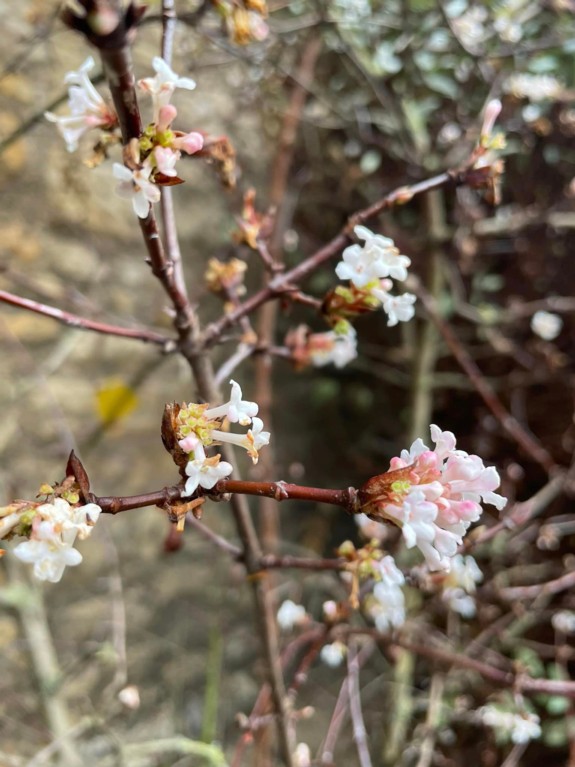
Above; Blossom on the North Court Cherry trees.
October and November has seen the garden team tirelessly clear the leaves around college in-between the heavy showers. As a result of the warm weather, we have also had to continue to cut grass, and weed the borders. This is something that should have slowed down by this time of year but continues to keep us on our toes.
December finds us with a couple of changes of personnel in the garden department. It is a great loss to the gardening department that we will be saying goodbye to long serving team member Philip Bland. Phil has taken the decision to retire at the end of December and will be impossible to replace. Phil has been at the heart of the department for 13 years and has been a critical team member. Many of you will have seen Phil cross legged in the front court, maintaining the cobbles with precision, and an awful lot of patience. His talents are endless, turning his hand to fixing things and problem solving. I personally would like to thank Phil for his service, and his companionship through my time at Emmanuel, and I know he will be sorely missed by the entire team.
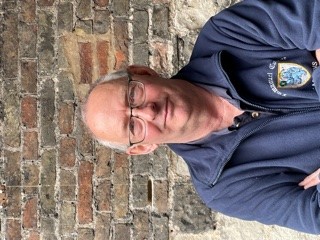
Above; Phil Bland
As Phil leaves at the end of his career, December starts the career of another. Isabel Mare will join the garden team in December, as part of a two year apprenticeship. Izzy will work at Emmanuel for four days a week whilst attending studies at King’s College Cambridge towards her level two Horticulture Apprentice Award. We welcome Izzy into the team and wish her all the best in her exciting opportunity to learn with us.
Other jobs that the garden team have been busy completing is the annual cutting down of the foliage around the pond. For many this symbolizes the start of winter and is usually completed around the time known by the students as Bridgemas. Those last few weeks of term that the college turn their attention to all things Christmassy. This also sees the gardeners erect the Christmas trees around the college, five in total this year. As much as we enjoy putting these up, at least we do not have to decorate each tree too, as we still have a lot of leaves to collect between now and the end of the year.
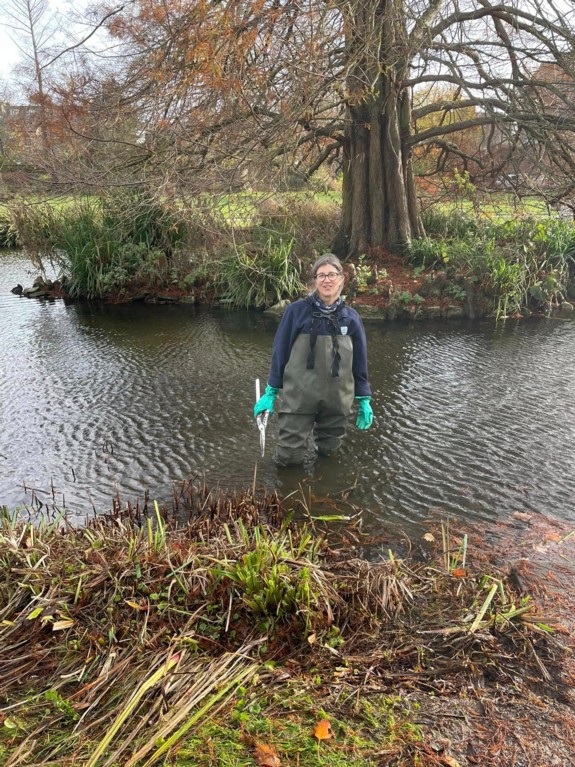
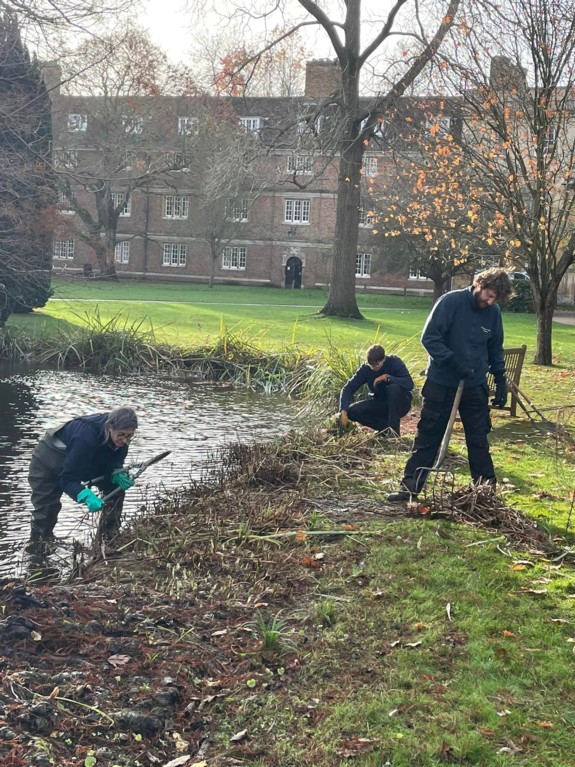
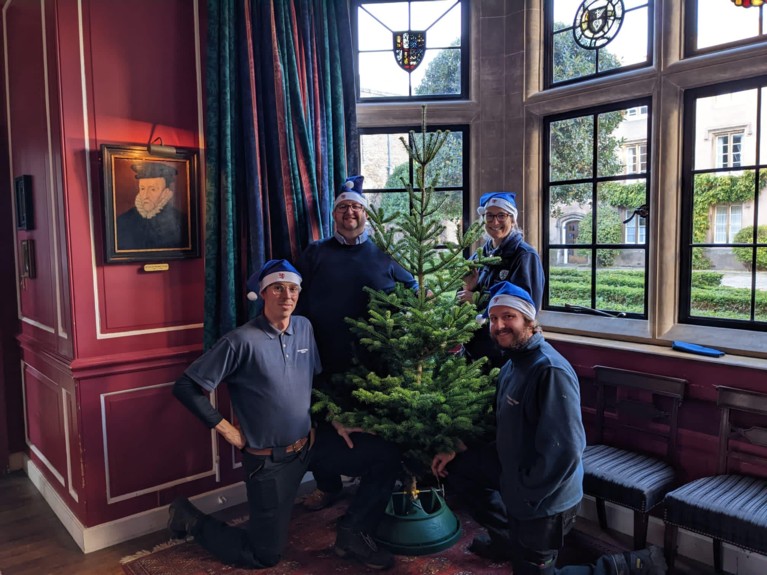
Above left; Kate in the pond; Above right; The team clearing the foliage around the pond
Below; Theo, Brendon, Kate and Doug with the Parlour Christmas Tree
Best wishes
Brendon Sims (Head Gardener)
1 December 2022
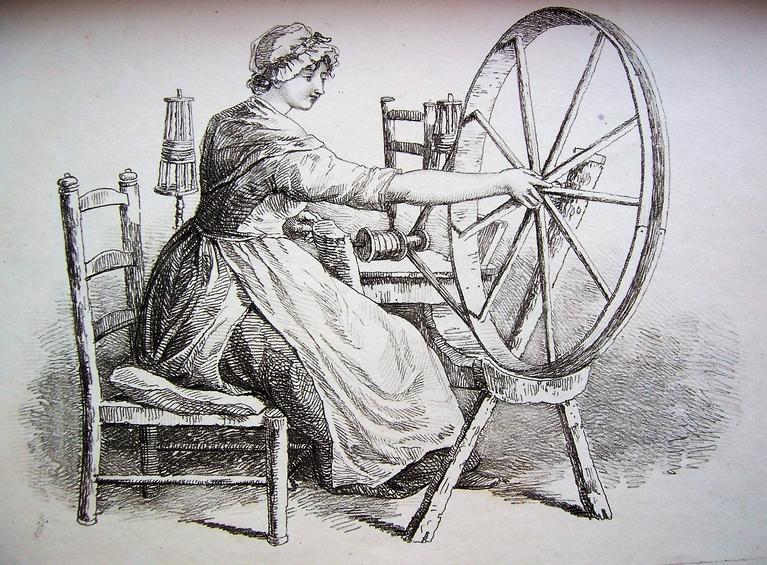
At a time when the cameras in mobile phones enable anyone to record experience and environment with remarkable clarity, it is worth comparing our circumstances with those earlier times when young people were routinely taught to draw. There was no questioning the value of being able to record accurately, hopefully to catch a likeness, but also to frame a composition and so make a picture of what was seen.
Emmanuel’s collections of illustrated books appeal to the taste of users acculturated to value the making of a picture, and quite often with some education themselves in how to do so. One book in Emmanuel’s Graham Watson Collection is a kind of pattern book of studies of the rural poor. These preserve likenesses of people who might never normally be portrayed, but who were drawn to provide models that could be copied by budding young artists to supply the figures in their landscapes.
William Henry Pyne’s Rustic Figures (London, 1817) prints a set of such figures, ‘in Imitation of Chalk’ drawings, none of which is captioned but which illustrate the book’s recommendation to students to seek for nature by viewing the rural poor at their occupations.
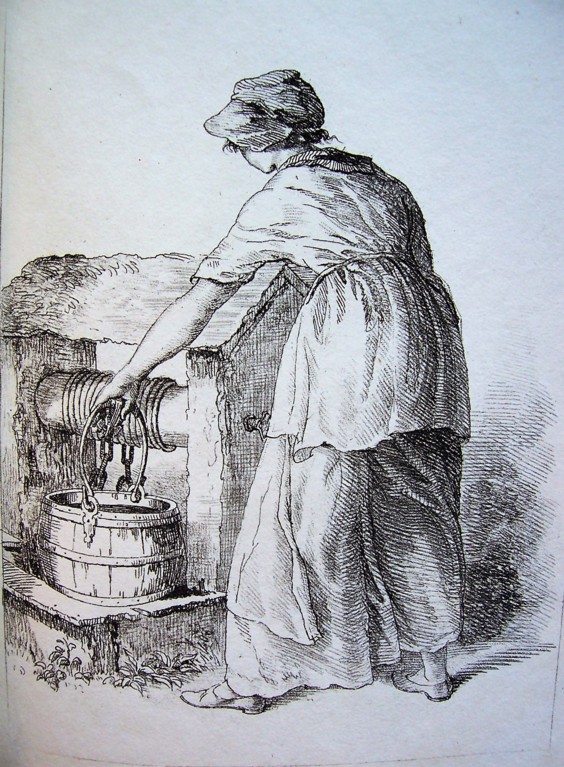
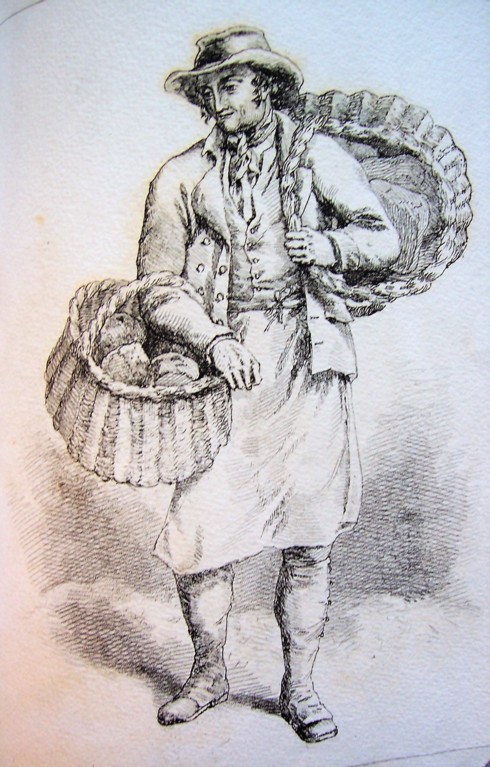
The author’s introduction comments that ‘drawing the characters … of rustic figures’ is as different from drawing ‘the elegant or classic figure’ as the difference in their ‘manners and habits’. But the introduction insists ‘Not that the rustic is always devoid of dignity; but his is a dignity of a peculiar order, existing in nature, without either the elegance or the affectedness which may be derived from education’. A sympathetic eye has sketched the worn figures of the aged poor:
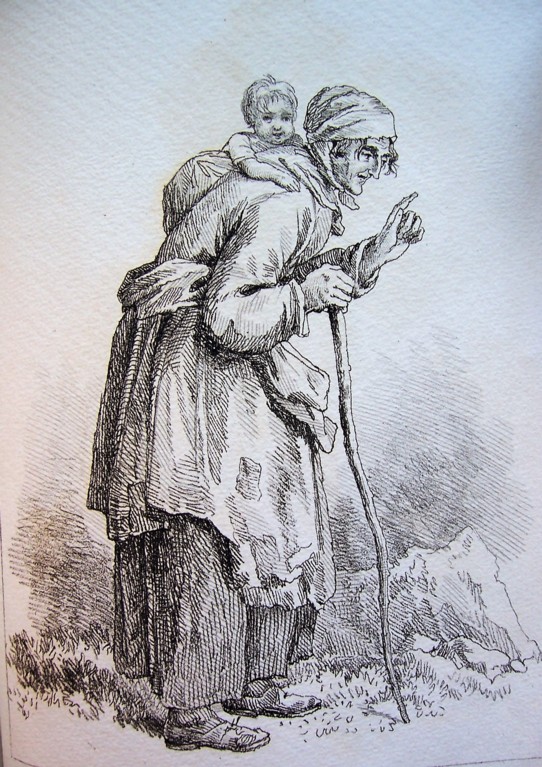
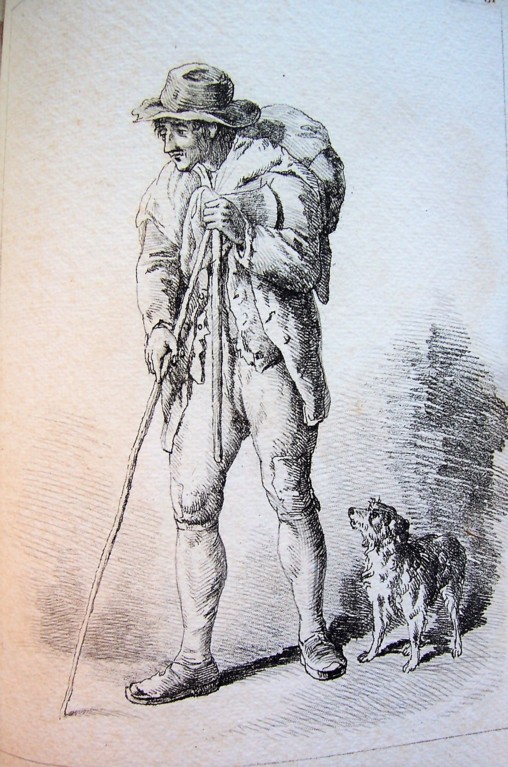
Women young and old look out at the viewer pensively, with little to smile about:
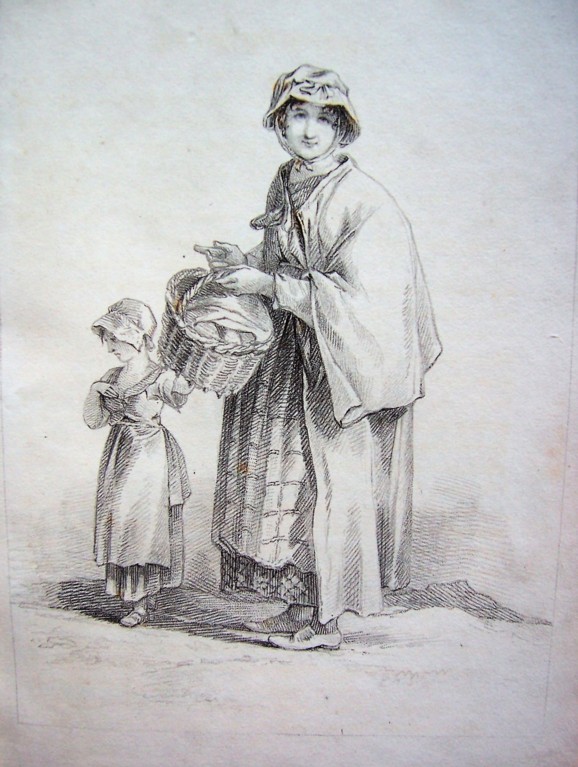
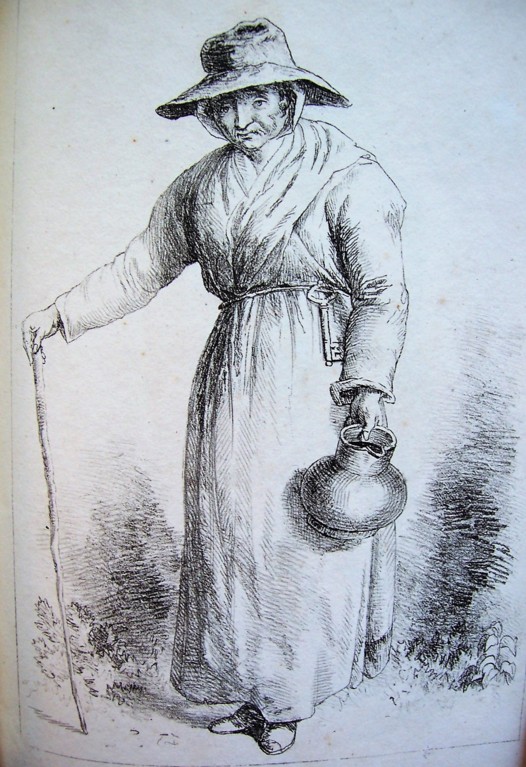
Men young and older meet the viewer’s gaze more bluffly:
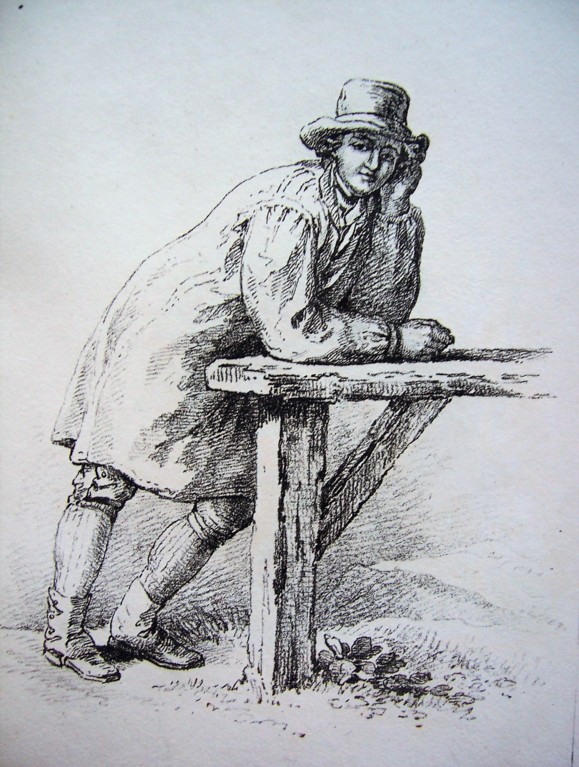
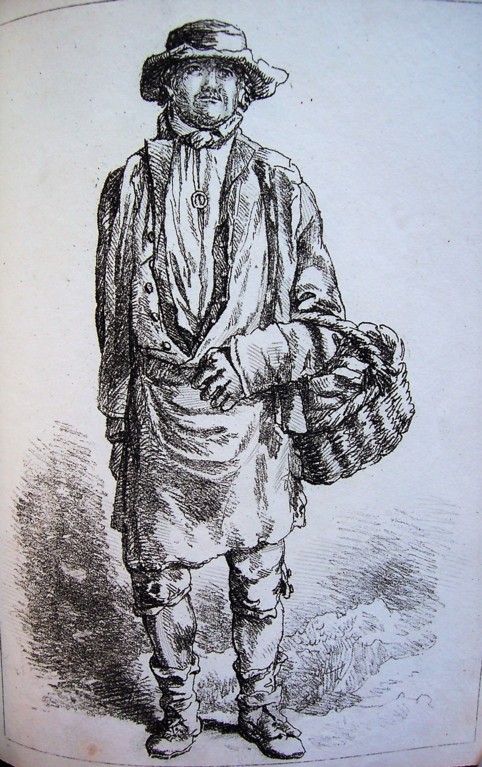
Clothes and footwear are simple and basic, but not generally ragged and tattered. The author sees a distinction between drawing drapery on an elegant figure, which must be ‘so arranged as to fall in studied folds’ and follow the form of the limbs. By contrast, the folds in drapery on rustic figures, ‘being usually made of coarse materials’, may often ‘not indicate the limbs at all’. Some seated figures look conscious of being drawn; perhaps they were just glad to sit down for a while:
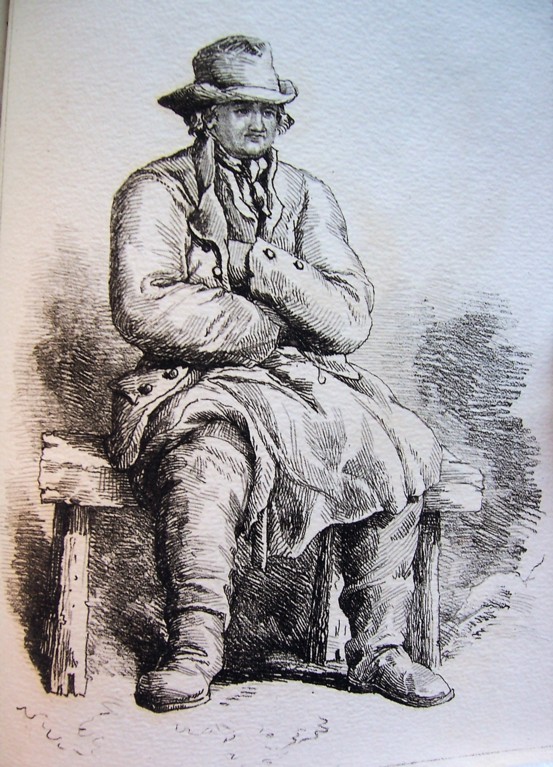
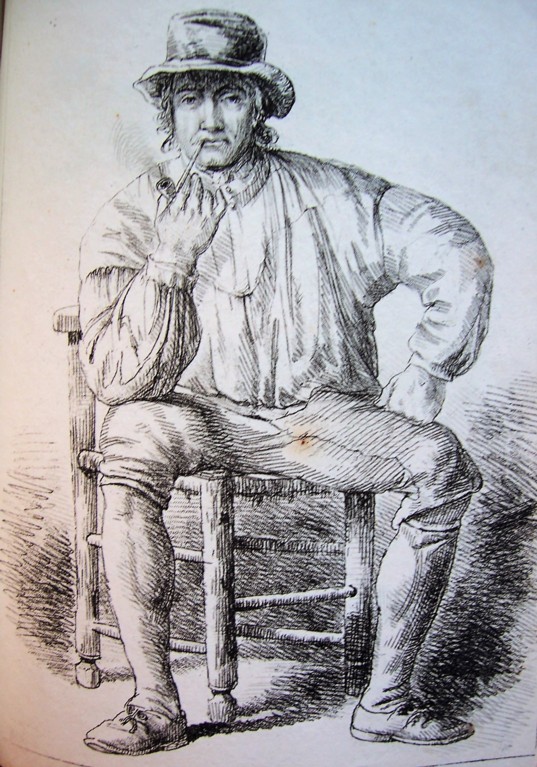
The introduction rules that ‘elegant heads, delicate hands and feet, and … languishing positions … cannot accord with the hardy habits’ of the rural poor. It declares that ‘nothing can be more absurd than to see a race of gods and goddesses with scythes and hay-rakes, attired in waggoners’ frocks and mob-caps’, yet the artist’s keen observation and humanity have actually discerned the dignity of labour in a labourer with a scythe and a girl with a net:
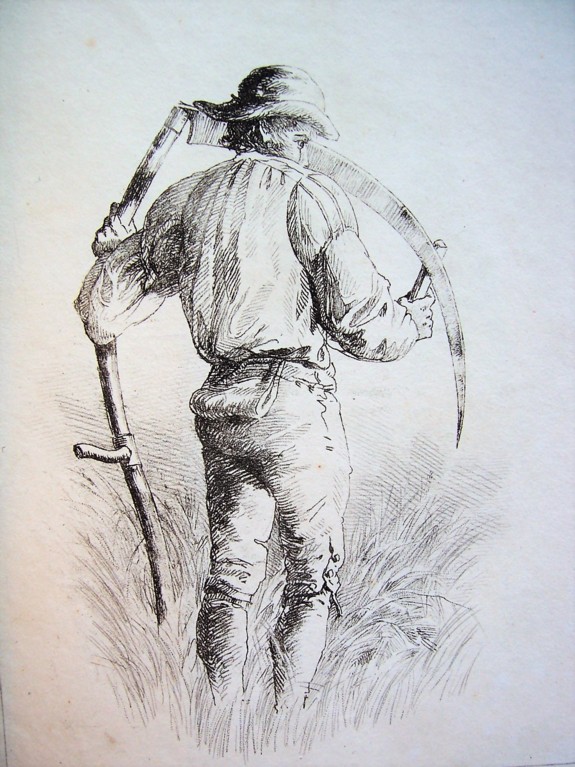
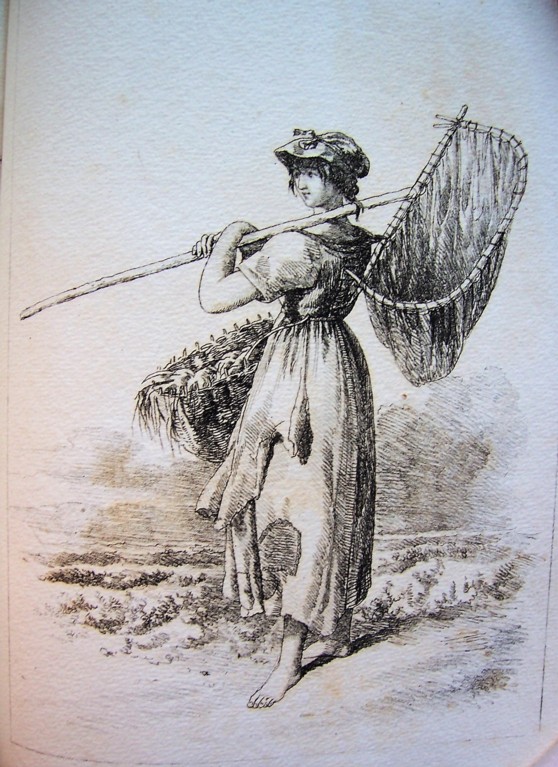
To draw such figures is favourably compared with work ‘long ago from the pencils of the Flemish and Dutch masters, inimitable in their way’ which (in the author’s view) is now being rivalled by English artists’ focus on such rustic figures:
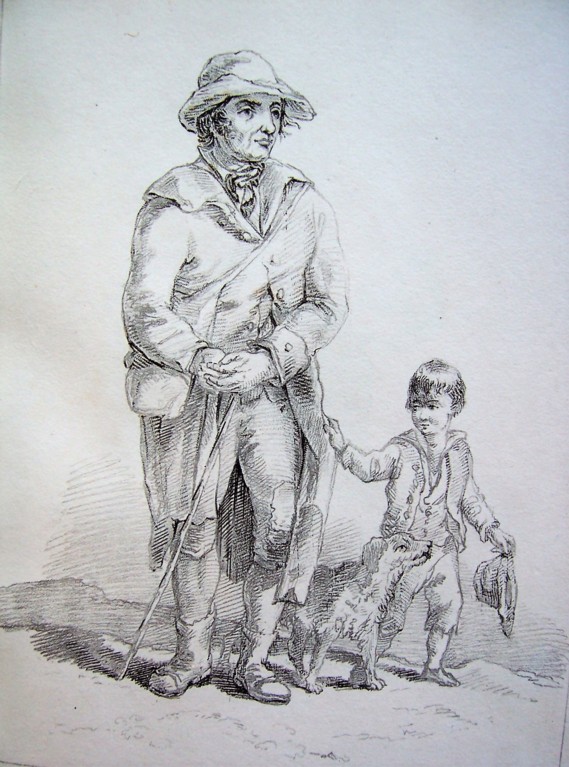
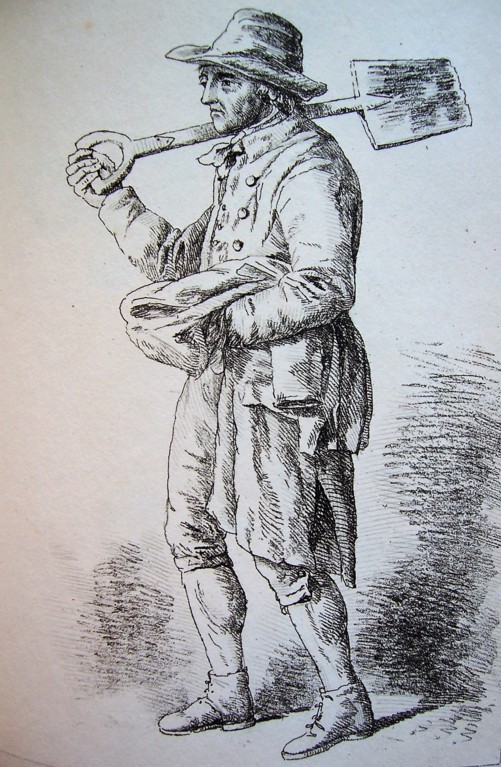
The book’s introduction closes with a sales pitch advertising study aids for budding young artists: ‘To facilitate the study of rustic figures, the author of this work has modelled a number of characters, selected from the English peasantry, on a scale of eight inches in height; from which plaster-casts are taken; for the purpose of assisting young persons in acquiring the art of grouping, and to improve them in the study of light and shadow … These casts may be had at The Repository of Arts, 101 Strand’.
Whether or not any of these plaster models survive, this modest book, with its utilitarian ‘how to draw’ purpose, enables its examples of the rural poor of its day to live on.
Barry Windeatt (Keeper of Rare Books)
Images by Helen Carron (College Librarian)
3 November 2022
October has seen some very mild weather for the time of year, following the trend of month on month increases to average temperatures. We are certainly looking like 2022 will be one of the warmest on record, if not the warmest. What the gardens have been thankful for though is a reasonable amount of rain. This has seen the lawns start to recover well. The gardens still need more moisture though as just below the surface of the soil it is still indeed very dry.
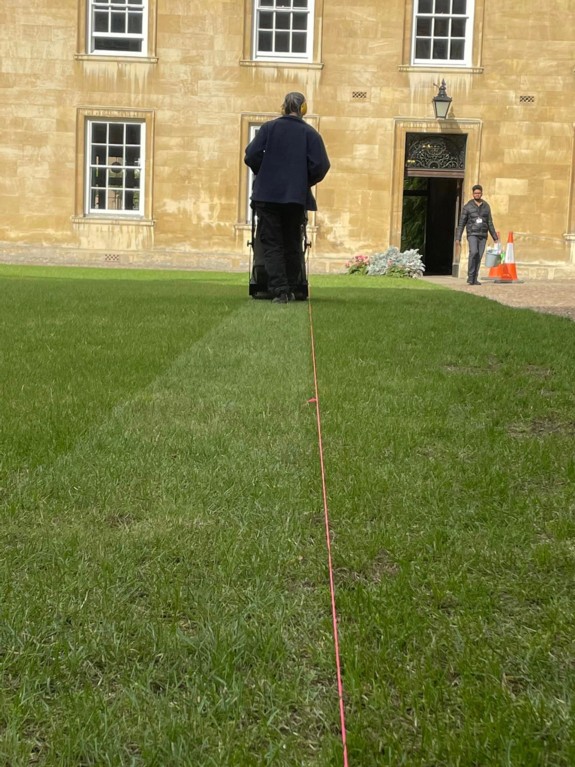
Above; Lawn maintenance
One thing that we do notice about a mild Autumn is the colour of the trees are not quite as brilliant in its tones. To truly get those beautiful colours, the trees need two things to happen. Firstly, we need good moisture retention in the ground (which this year we have had very little), and secondly some colder temperatures. We still have some great tree colours but not as bright as previous years. The garden department are working tirelessly to collect the leaves from the college grounds and retain as much as we can for composting. A valuable resource for the future.
Around the gardens we have been busy harvesting the last of the fruits on the trees for use in the kitchens. The last of the apples, quince and even pomegranates have been passed over to the chefs to create something special with. It is rare in this country to have so many pomegranates grow on a shrub outdoors. Another sign that the hot summer was very hot indeed.
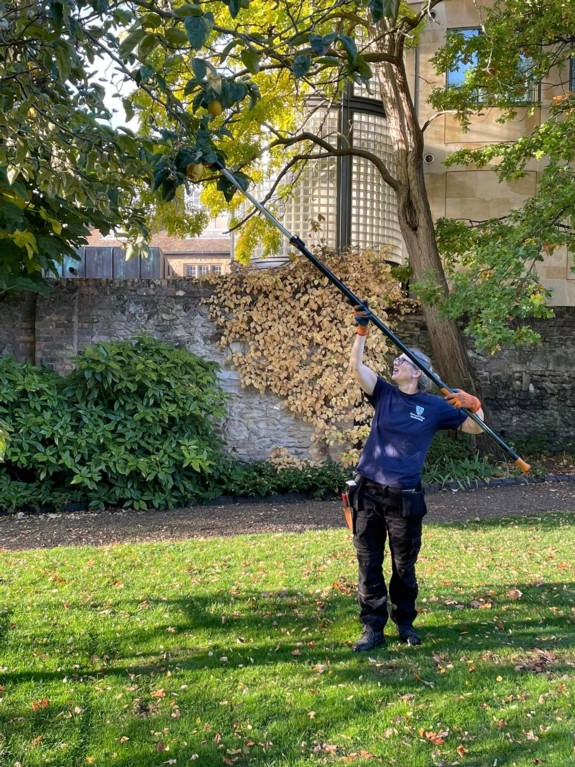
Above; Kate harvesting fruit
Despite the leaves, the garden team have been busy with other additional tasks. October has seen some additional bulb planting. We have planted some Tulips in front court, some Alliums near the chapel borders and some additional Tulips and daffodils in the Fellows garden. Fingers crossed for another colourful display next spring. We have also sown some annual wildflower seeds in the meadows ready for next summer.
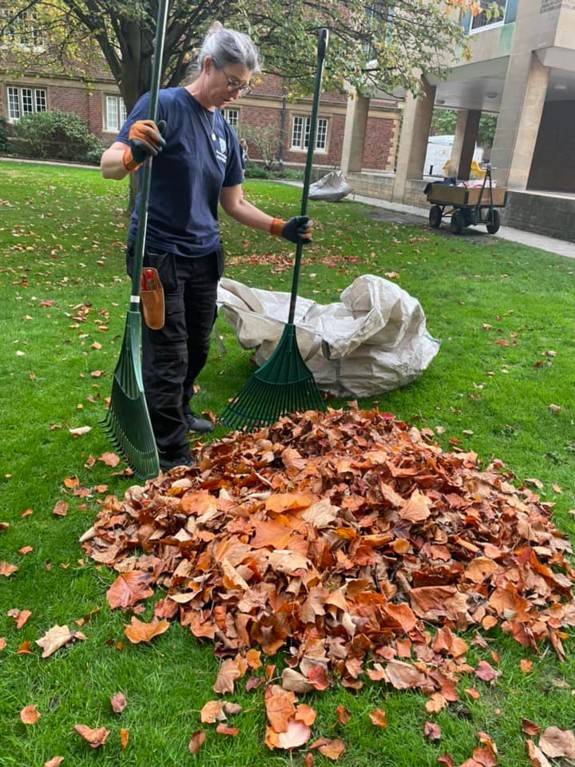
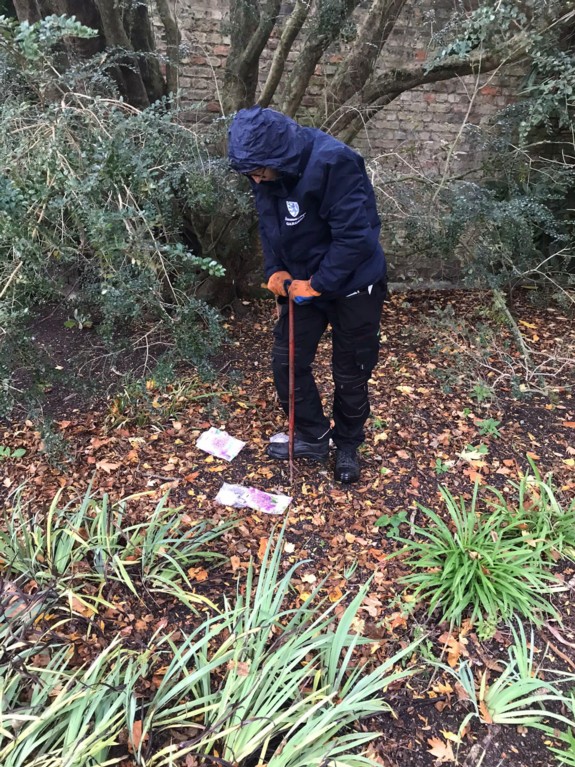
Above: Left; Kate collecting leaves; Right; Blulb planting
The construction work on the new build is now starting to get to the final staging. Over the next few months the garden team will be able to start planting. We are currently finalizing the planting plans and getting prices for the plants. Planting should start early next year with some trees going in this side of Christmas.
The garden department are currently recruiting for an apprentice to join our team. It is very important to pass on the skills our amazing department have so that others can learn. Emmanuel garden department now has an excellent reputation and it is important to maintain those standards. If we lead by example, then others will learn that standard and have a great career going forward.
I continue to be proud of my team who work tirelessly all year, but these months up to Christmas are especially hard work. Well done team Emma.
Best Wishes
Brendon Sims (Head Gardener)
3 November 2022
.jpg)
The original North Court cloister
North Court, completed just before the First World War, may seem to radiate a timeless, unchanging aura, but in fact the western range, comprising the porter’s lodge and attached cloister, was extensively altered in the 1960s.
The changes were not of Emmanuel’s choosing. In 1957 the row of late-Elizabethan tenements in Emmanuel Street, facing New Court, was demolished to accommodate the increasing volume of bus traffic. The rest of the street was widened for the same purpose a decade later, with serious repercussions for North Court. For one thing, it entailed the loss of the garden slip, complete with railings and holly hedge, that formed a barrier between the buildings and Emmanuel Street. The slip had also contained several crab-apple trees, apparently providing a useful source of missiles (to the occasional detriment of nearby fenestration). The high wall constructed on the new boundary line was quickly screened with half a dozen young hornbeam trees. Another consequence of the 1967 road-widening was that the porters’ lodge had to be demolished and rebuilt several yards further back, requiring the demolition of the southernmost cloister arch. The college made the best of the situation by adapting the lodge and cloisters to provide residential accommodation.
.jpg)
The Barnes shield in North Court
The original seven cloister arches and the lodge windows had been surmounted by keystones displaying the coats of arms of early college benefactors. The rebuilding works resulted in two of these heraldic carvings becoming redundant, as not only was there one fewer cloister arch, but the two windows in the original east wall of the lodge had been replaced with a single, larger casement. The shield from the demolished cloister arch, being particularly ornate, was salvaged and mounted above the new lodge window. Described by the Bursar in 1913 as being the only one of the cloister keystones that had ‘much detail upon it’, the carving bears the coat of arms of John Barnes, whose tenements in Threadneedle St, London, came to Emma by bequest in 1588. 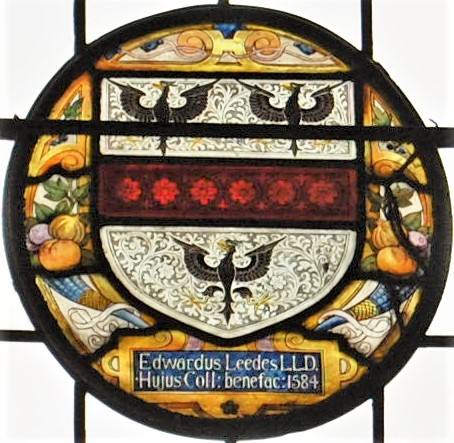
.jpg)
The Leeds (left) and Dixie shields in the Hall windows
The two carvings over the original east windows of the lodge were therefore surplus to requirements. The names of the benefactors they commemorated are not recorded in any college paperwork, but an old photo in the archives shows that the keystone nearer Emmanuel Street almost certainly displayed the arms of Doctor Edward Leeds, while the other bore the shield of Sir Wolstan Dixie. Both of these coats of arms can be seen in the stained-glass windows of Emma’s dining hall, forming part of a set of twelve fine heraldic panels manufactured in 1877. Sir Wolstan Dixie, Master of the Skinners’ Company and Lord Mayor of London, bequeathed the college £600 in 1594 to endow fellowships and scholarships for the study of divinity. Doctor Edward Leeds, a former Master of Clare College, gave Emmanuel many valuable gifts, including, in January 1586, one thousand marks towards the construction costs of the college’s new buildings.
The fate of the redundant Leeds and Dixie carvings is unknown. They may have been given, or taken, away, but it is equally possible that they simply disappeared into storage and have been gathering dust in a forgotten corner of a college cellar for more than five decades. If ever they come to light, perhaps a suitable spot could be found for them in their old home of North Court.
Amanda Goode, College Archivist
3 November 2022
Thomas Young (1773-1829), scientist and polymath, was a member of Emmanuel who is often described as ‘The Last Man Who Knew Everything’ – in the sense that he was familiar with virtually all the contemporary Western academic knowledge at his point in history, before the expansion of knowledge made that an all but impossible feat for any individual.
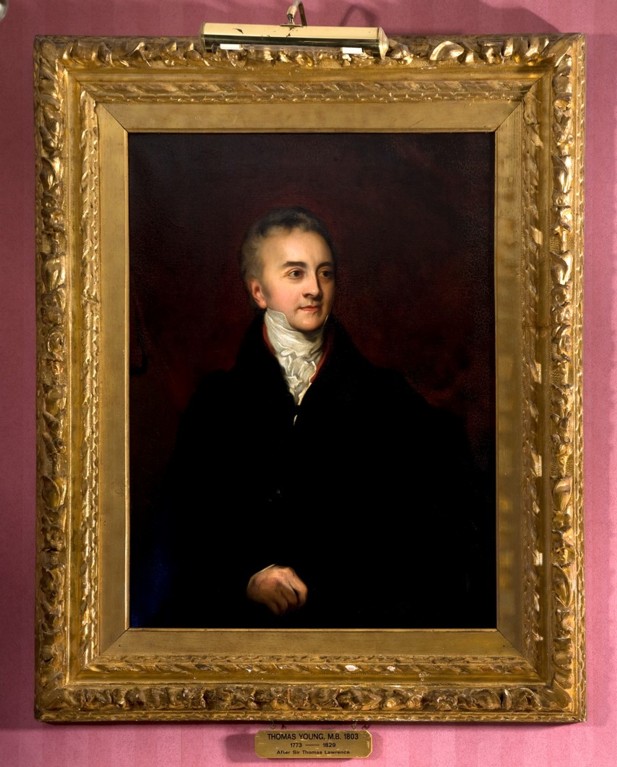
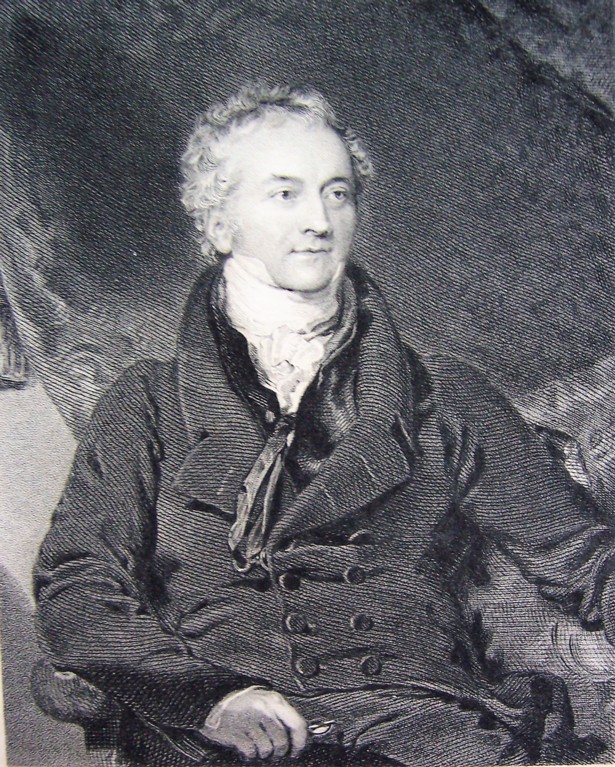 Above; Left to Right; Plate 1: Emmanuel’s portrait of Young, a copy of the 1822 original by Sir Thomas Lawrence; Plate 2: A print of the Lawrence portrait, from the College’s collection.
Above; Left to Right; Plate 1: Emmanuel’s portrait of Young, a copy of the 1822 original by Sir Thomas Lawrence; Plate 2: A print of the Lawrence portrait, from the College’s collection.
Born in Somerset to strict Quaker parents, Thomas Young was an infant prodigy who had read through the Bible twice by the age of four. While a child he learned Greek, Latin and Hebrew, as well as French and Italian – and later Arabic, Persian, Chaldean, Syriac, Samarian, Amharic and Turkish – and this extraordinary aptitude for language would come to fruition later in one of his most celebrated achievements. But it was also every sort of enquiry into theoretical and applied science that engrossed him from an early age.
As a Quaker, Young could not attend Oxford or Cambridge (being unable to take the oaths required), and so he studied medicine for a year at Edinburgh before pursuing his medical studies at Göttingen where he graduated. But once he moved away from home, Young moved away from his Quaker upbringing. He was altogether too fond of dancing, the theatre and playing his flute, and for such abominations he was disowned by the Quakers of Edinburgh. On returning from Göttingen he therefore declared himself an Anglican and matriculated at Emmanuel, ostensibly to study medicine, although he actually pursued his independent researches, having learned enough medicine at Göttingen to graduate at Cambridge. Going to Cambridge was a tactical career-move, since without an Oxbridge degree a Fellowship of the College of Physicians was precluded, and Young had set his sights on a medical career.
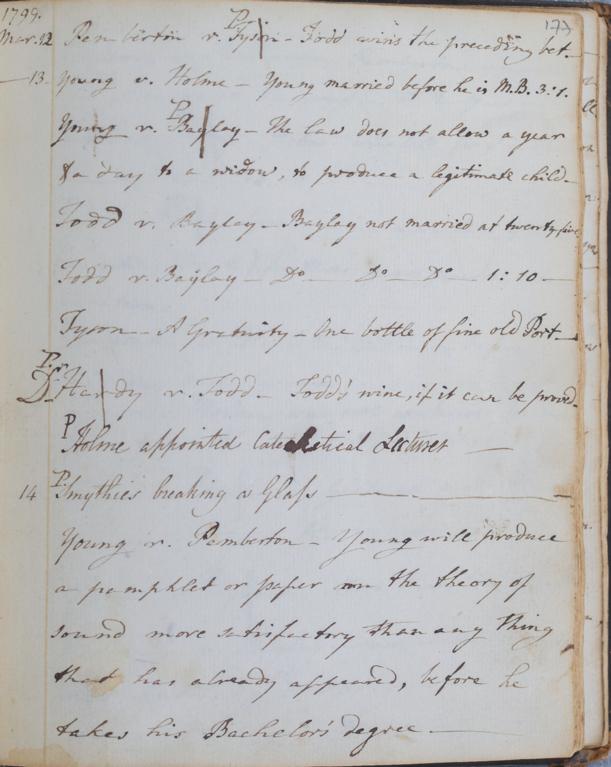
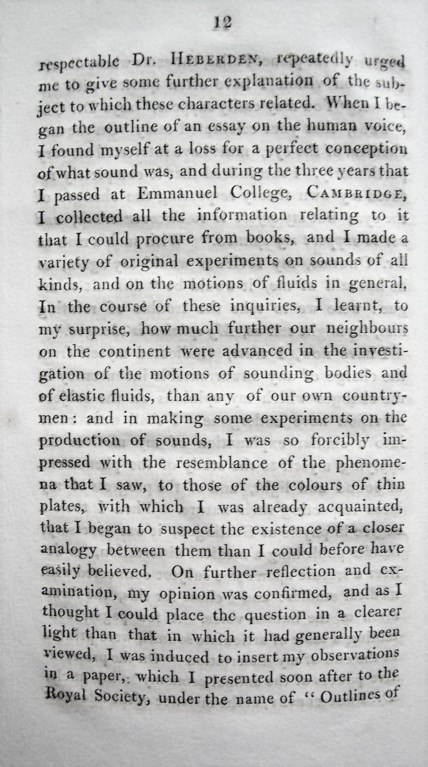
Above; Left to Right; Plate 3: Page from 1799 in the Parlour Wager Book, showing three bets by Young, the last being ‘Young will produce a pamphlet or paper on the theory of sound more satisfactory than anything that has already appeared before he takes his Bachelor’s degree’. The Parlour judged Young to have lost this bet; Plate 4: Page from Young’s A Reply to the Animadversions of the Edinburgh Reviewers (1804), referring to his researches into sound during his years at Emmanuel.
At the age of twenty-four Young inherited from his mother’s uncle, also a physician, a house in Park Lane and a fortune that made him financially secure. He set up his medical practice in Welbeck Street, but there was time for research. Young developed a paper on the accommodation of focus in the eye which he read to the Royal Society in 1793 and was elected a Fellow in 1794 at the age of barely twenty-one. Other important papers to the Royal Society include ‘Sound and Light’ and ‘On the Mechanics of the Eye’ (both in 1800) and ‘On the Theory of Light and Colours’ (1801). Appointed a professor at the newly-founded Royal Institution, Young gave 110 lectures over two years exploring Mechanics, Hydrodynamics, Astronomy and Physics. These were published as A Course of Lectures on Natural Philosophy and the Mechanical Arts (1807).
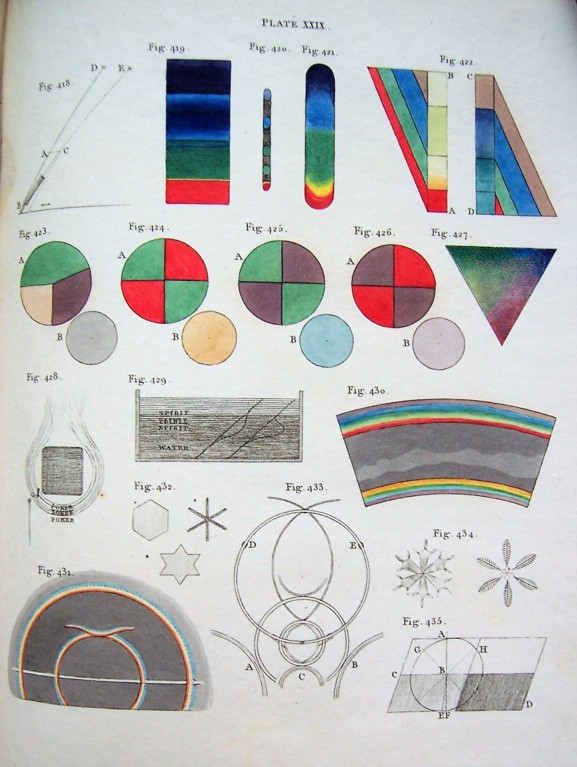
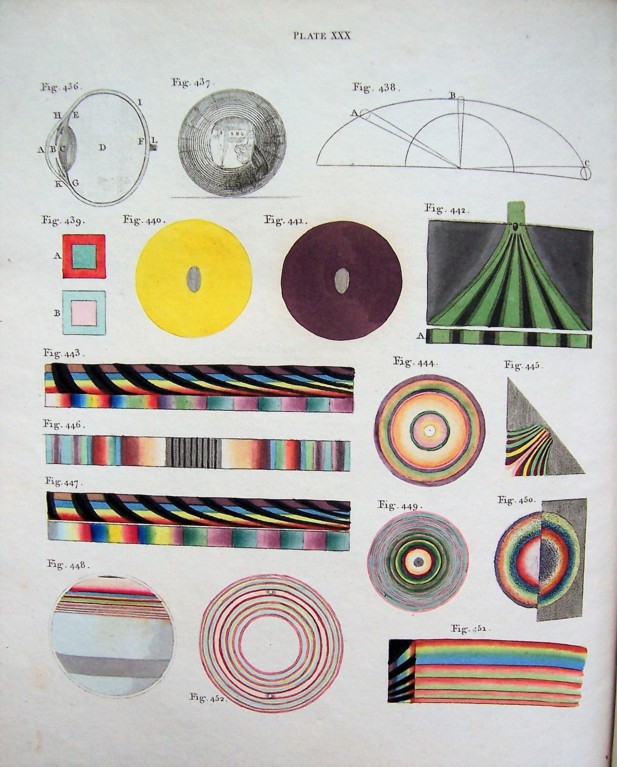
Above; Plates 5 and 6: Plates from Young’s A Course of Lectures, illustrating his lectures on optics and colour.
Young pioneered analogies between the transmission of sound and light, and according to tradition (sadly, there is no evidence) he first observed the phenomenon of ‘interference’ in the ripples set up by two swans on the Emmanuel Paddock pond. This is key to the experiment known as ‘Young’s Slits’ which propounds a wave theory of light (although since this contradicted Newton’s thinking on light it was met with some ridicule at the time). Young also advanced a theory of how the eye detects colour, arguing that the phenomenon of light being a mixture of three primary colours is due to the retina containing three kinds of receptors, sensitive to different frequencies. Among other enquiries, Young developed a theory known as ‘Young’s Modulus’ to quantify elasticity, developed a theory of the tides, and became an expert in life insurance.
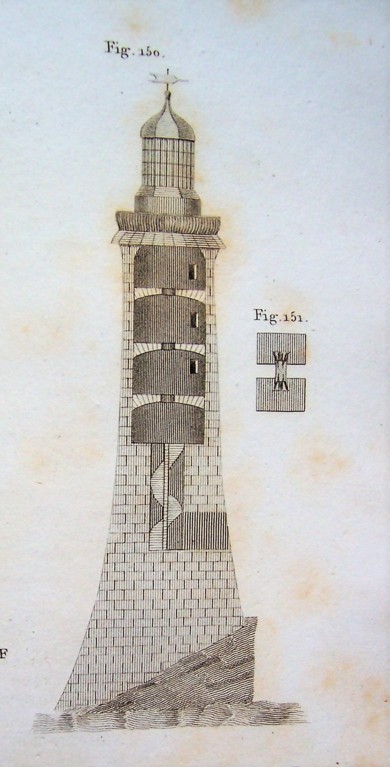
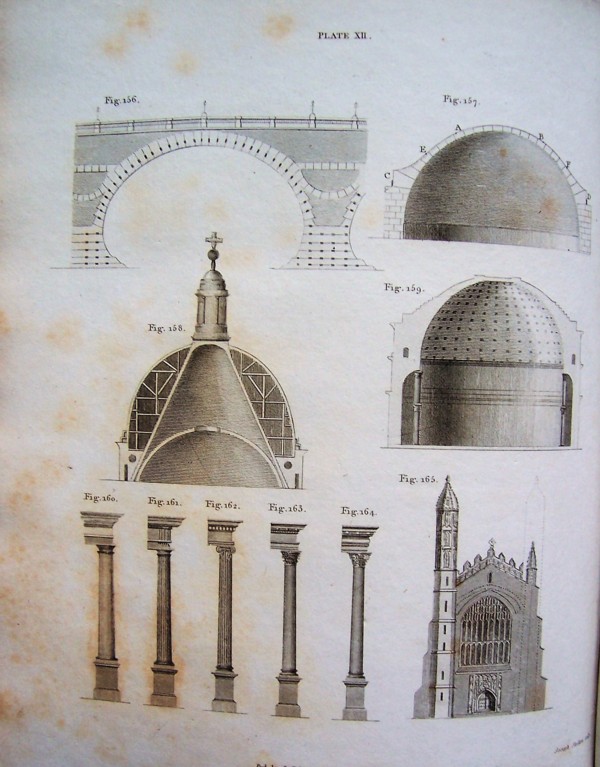
Above; Plates 7 and 8: Plates from A Course of Lectures, illustrating Young’s discussion of: how the Eddystone Lighthouse resists the force of the waves; and of the stresses in the domes of St Paul’s, the Parthenon, various columns, and King’s College Chapel. (Young believed ‘Gothic architects’ superior to the Greeks).
Still to come was the fruition of Young’s lifelong command of languages, in his foundational contribution to the deciphering of Egyptian hieroglyphics on the Rosetta Stone in the British Museum. The stone records a decree of Ptolemy V in 196 BC, written in three scripts: hieroglyphics, an unknown script named ‘demotic’, and Greek. Since the Greek text mentions that all three scripts have the same meaning, the stone held out the prospect of unlocking the other scripts. Greeks and Romans had assumed that hieroglyphics were symbolic not phonetic, and this misconception had stymied decipherment for centuries. Realizing from the Greek that some of the hieroglyphic cartouches must represent the name Ptolemy, Young worked out which symbols had been used phonetically, and published a paper with translations of 218 demotic and 200 hieroglyphic words, plus an alphabet for the demotic script. But a younger French scholar, Jean-François Champollion (1790-1832), was also working at deciphering hieroglyphics. Happening to be in Paris in September 1822, Young had what must have been the extraordinary experience of sitting beside Champollion as he announced to the Academie des Inscriptions his own breakthrough in deciphering hieroglyphics, with no acknowledgement of Young’s prior work. In a sense, Young only had himself to blame in that, always pursuing multiple researches simultaneously, he had not pressed home with his own work on hieroglyphics. Outwardly generous to Champollion, Young was privately stung at the lack of acknowledgement. And indeed, although Young’s monument in Westminster Abbey declares that he ‘first penetrated the obscurity which had veiled for ages the hieroglyphicks of Egypt’, it is usually Champollion who is solely credited by posterity with cracking the code.
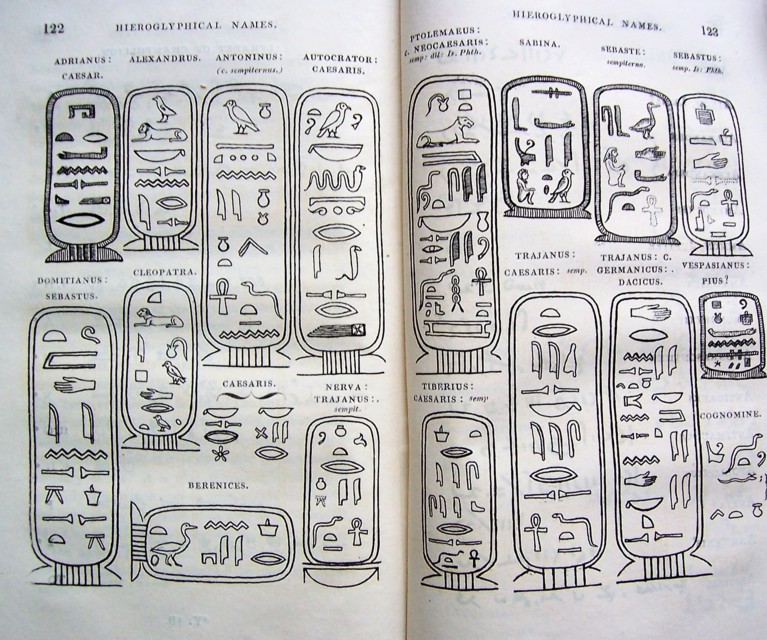 Above; Plate 9: Pages from Young’s An Account of Some Recent Discoveries in Hieroglyphical Literature (1823). The title page declares pointedly that it includes ‘The Author’s Original Alphabet, As Extended by Mr Champollion’.
Above; Plate 9: Pages from Young’s An Account of Some Recent Discoveries in Hieroglyphical Literature (1823). The title page declares pointedly that it includes ‘The Author’s Original Alphabet, As Extended by Mr Champollion’.
If all this, Dear Reader, is making you feel just slightly inadequate, there is some possible consolation in that, among so many accomplishments, what we would now call social skills were not Thomas Young’s strong point. He worked conscientiously at his medical practice, yet this never really took off because, for all his medical knowledge, Young had no bedside manner. His Royal Institution lectures, however original, were not a success with his audience, because he spoke so far over their heads. The Master of Emmanuel, Richard Farmer, introduced Young to the Fellows saying, ‘I have brought you a pupil qualified to give lectures to his tutors’, which must have gone down a storm with his tutors. To be universally known, as he was, by the nickname ‘Phenomenon Young’ may not have made interactions easy, though his private life was fulfilled by an exceptionally happy marriage to Eliza Maxwell. Remember Thomas Young and those ripples when you are next by the Paddock pond.
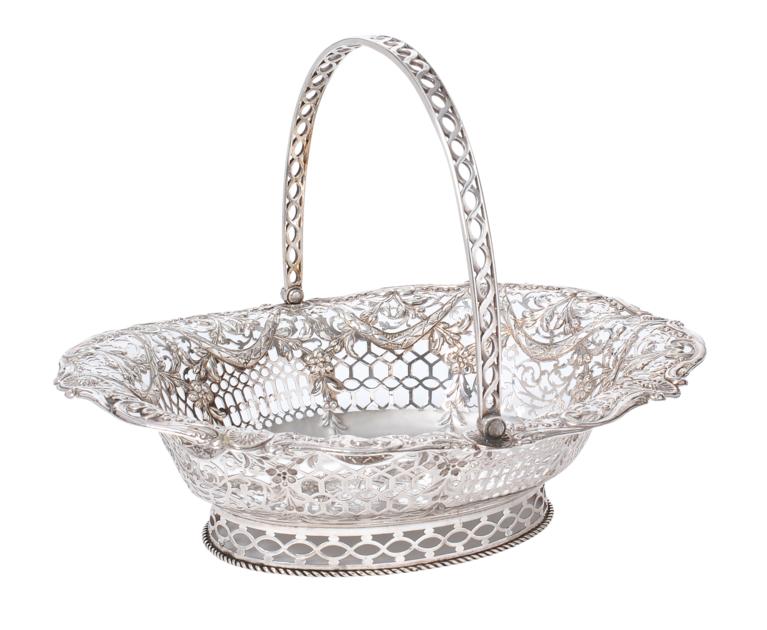
Above; Plate 10: The beautiful silver bread basket presented by Young to Emmanuel.
Barry Windeatt (Keeper of Rare Books)
Images by Helen Carron (College Librarian)
31 October 2022

After completing her BA and MPhil at Emma, Aoife embarked upon a year as a graduate student at Harvard University, focused on environmental policy and climate change, thanks to the support of Emmanuel’s Herchel Smith Scholarship. Below she writes about her year of personal and professional development, which led her to an exciting internship at the UN Environment Program.
From September 2021 to May 2022, I was lucky enough to attend Harvard University as a graduate student focusing on environmental policy and climate change. This year of learning and personal and professional development was only made possible by the generous support of Emmanuel’s Herchel Smith Scholarship. My undergraduate degree which I loved so much at Emma – geography – may not have been as common a discipline in the States, but its composite parts were scattered across the graduate schools, and I took full advantage of this.
I was able to design my own environmental curriculum by taking part in classes at the Law School, School of Public Health, Kennedy School of Government, and some choice classes at the College. This provided me with many new perspectives on the familiar interdisciplinary issues of climate change, environmental degradation, and a just energy transition. I also benefitted from the more applied American educational style which brought together the academic grounding Cambridge has given me with the lessons I learnt working in Local Government afterwards.
Courses on science, economics, and policy challenged me to think critically but also ambitiously. In one class, I was asked to find a pathway to net-zero for the US by 2050 taking all the key emission sectors into account – something which all countries must achieve, but which is much easier said than done! In another, I worked on a smaller and more focused project designing the first steps for a Tribal Nation interested in solar agrivoltaic opportunities and the associated energy independence and food sovereignty co-benefits.
Outside of class, I had a wonderful time on Harvard’s Climate Leadership Program which brought together like-minded students from across the graduate schools for weekly discussion and speakers’ events. A highlight was our trip to Harvard Forest where we got a hands-on tour of the ecological research being undertaken. Here, I had the opportunity to climb up a (very rickety) carbon flux tower to see New England’s Forest canopy in Fall and get a better understanding of the daily carbon monitoring taking place. These towers were something I had read about while tucked away in the Fane Room pouring over Nature articles at who-knows-what-time but seeing them in person and being reminded of the amazing job forests do as a carbon sink was something else.
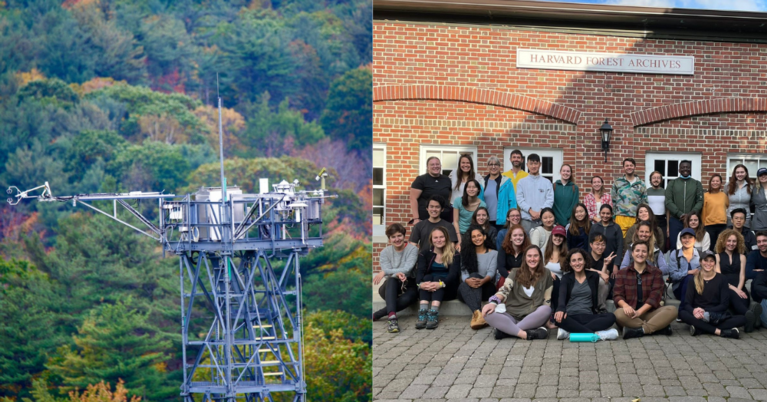 Above: (left) the carbon flux tower in Harvard Forest; (right) Aoife and fellow graduate students at the Harvard Forest Archives
Above: (left) the carbon flux tower in Harvard Forest; (right) Aoife and fellow graduate students at the Harvard Forest Archives
This year has given me the time to grow and has renewed my motivation to find equitable climate solutions across scales from the local to regional and international. I’m incredibly excited to be embarking on the next chapter as an intern at the UN Environment Program where I hope to play a small part in their work to build a more sustainable world. Thank you again to all the donors who help us to help make a difference when we are just setting out and need it most!
Aoife Blanchard
BA Geography, 2015 / MPhil Polar Studies, 2018
6 October 2022
Autumn is officially here and I must say it does come as a welcome relief from the hot dry Summer. September saw the garden teams start to tackle the dry lawns. The lawns had to be scarified to remove so much of the dead grass that had been scorched by the hot sun and extremely warm winds. It was almost like having a thousand hot hairdryers going all at once. It was no wonder they went yellow and dry under so much stress.
The rain has been a welcome sight for the garden and although it was never enough, it was very much needed. It has at least seen the grass green up in places. This is the perfect time for the autumn lawn maintenance whilst there is still some warmth in the ground. Throughout October the lawns will continue to be worked on with the addition of an organic fertilizer to help see it through the winter.
October has seen the window boxes removed from front court as well as the tender plants in pots. These have been removed and placed back in the cold frames and greenhouse for winter protection and to allow us to propagate some more plants for the future. This year we will not place out the window boxes for autumn/winter display as we turn our attention to our planting for the new build landscaping. Activity is starting to accelerate and I have been having meetings with the Landscapes Architects as we finalize the planting plans. This should be happening soon as the optimum time for plant establishment is between October and March. Watch this space.
Late September has seen the garden team continue with the Meadow Management program. A process of removing all of the cut debris was completed. The next phase was to prepare the ground for an Autumn sowing of annual wildflower seeds. These will be in addition to the perennial seeds that will have fallen from last season’s crop. These should start flowering from May next year onwards.
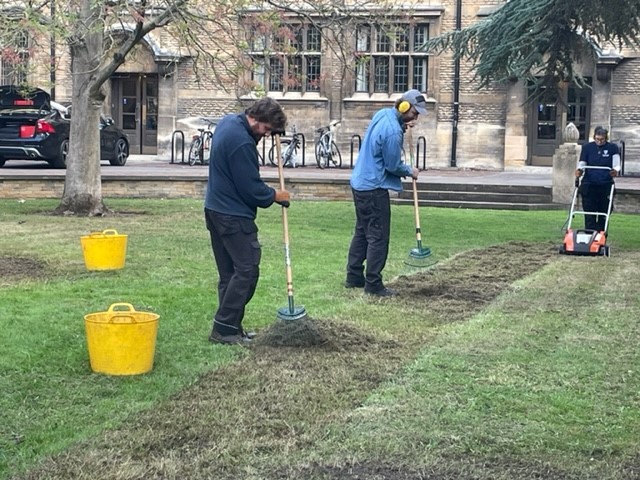
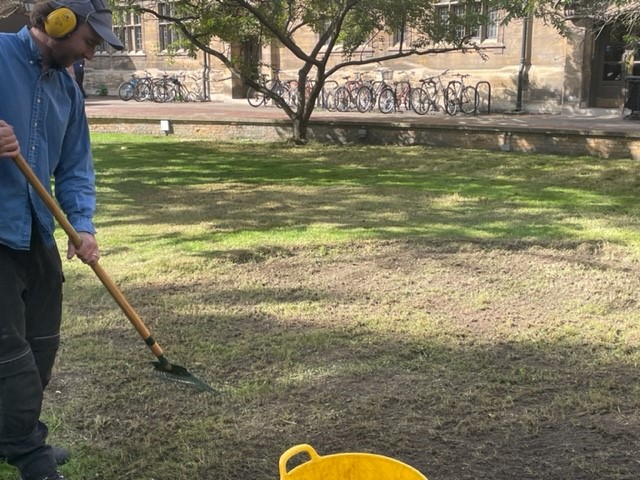
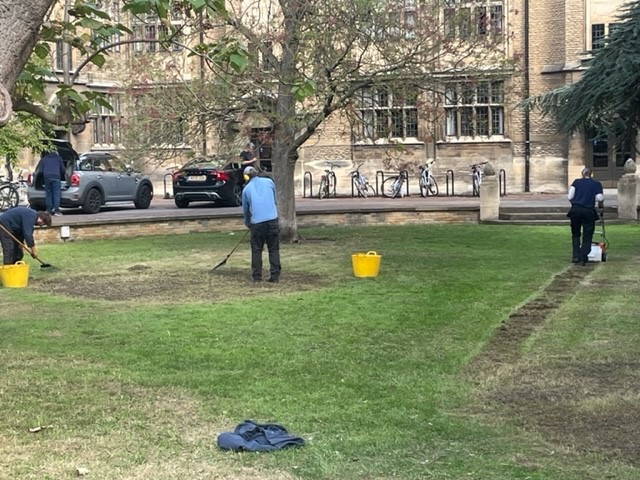
Above; Jon, Kate and Doug continue the Meadow Management Program
Many of you will have noticed that the pond levels dropped towards the end of September. This was due to a problem with the Hobsons Conduit much further back at its source. The flow rate was only one fifth of what it should have been. This has now been rectified but it did give us a chance to carry out essential maintenance on the paddock pond whilst the levels were low. The team worked hard reducing the growth of the marginal plants as they tend to continue spreading from time to time.
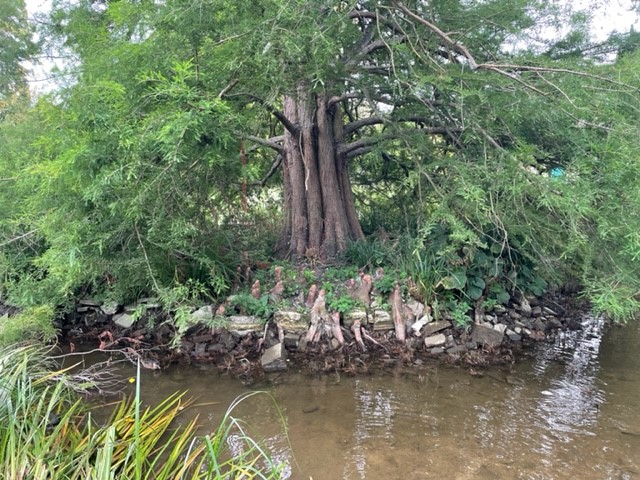
Above; Low pond water levels
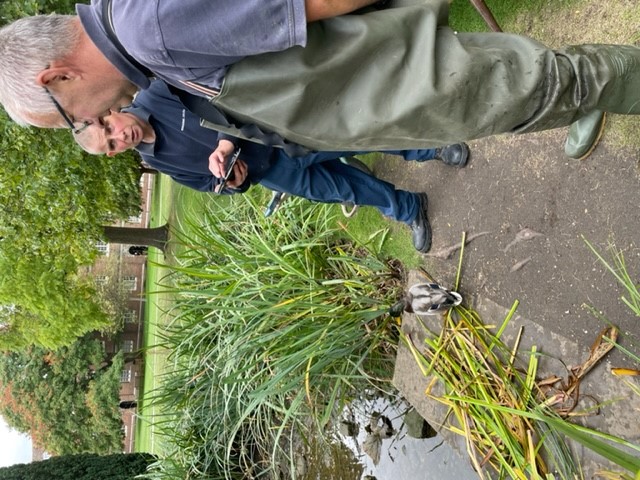
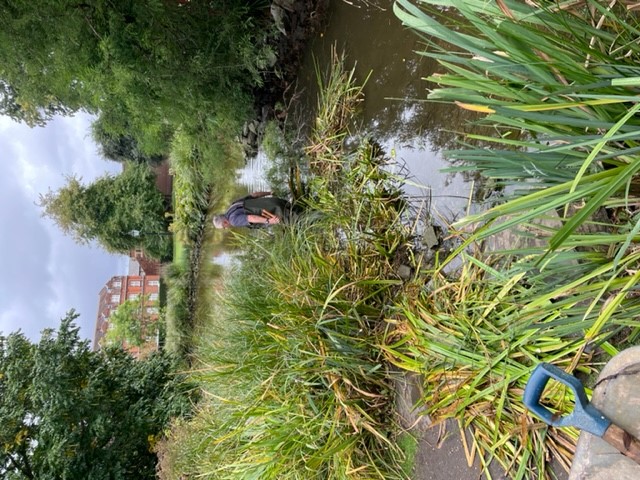
Above; Phil and Rob assessing the growth of the marginal plants
October will see the garden team continue these tasks in order to keep the water ways working correctly. It will also mean that the garden team start the relentless task of clearing the leaves. A process that will take us through to Christmas. Plenty of leaves for composting though so we do look to the positives of the long and arduous task. If you do see any of the garden team working hard clearing leaves just come and say hi. It will probably lift their spirits a little.
Best Wishes
Brendon Sims (Head Gardener)
6 October 2022
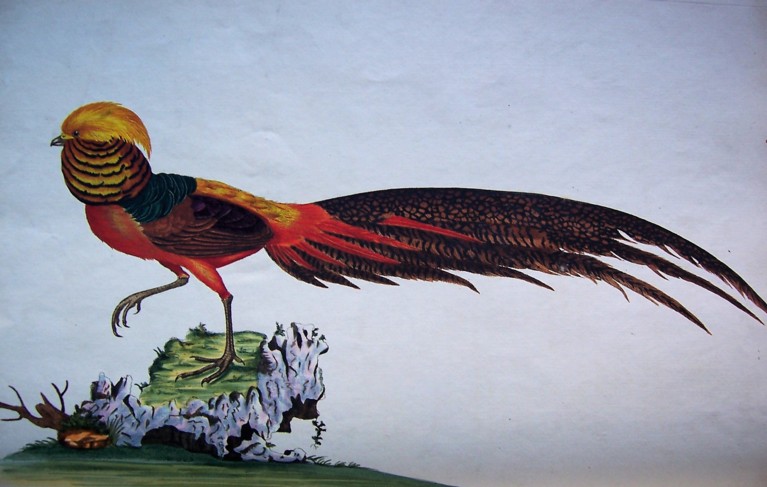
Plate 1. Male Gold Pheasant; William Hayes, A Natural History of British Birds (1775).
Given that the Royal Society for the Protection of Birds is believed to have more members than all the UK political parties put together, it is perhaps not so surprising that birds have been one of the most popular subjects of illustrated books in Britain now for centuries. In Emmanuel’s Graham Watson Collection there are well over a hundred titles about birds, many in multi-volume sets. There are numerous books depicting native birds, but there are also very many illustrating exotic birds that most of these books’ owners would never see in the wild, although some might be seen when stuffed or in aviaries.
One book in Emmanuel’s collection sets out to record the exotic birds in the menagerie at Osterley Park in Middlesex (now a National Trust property).
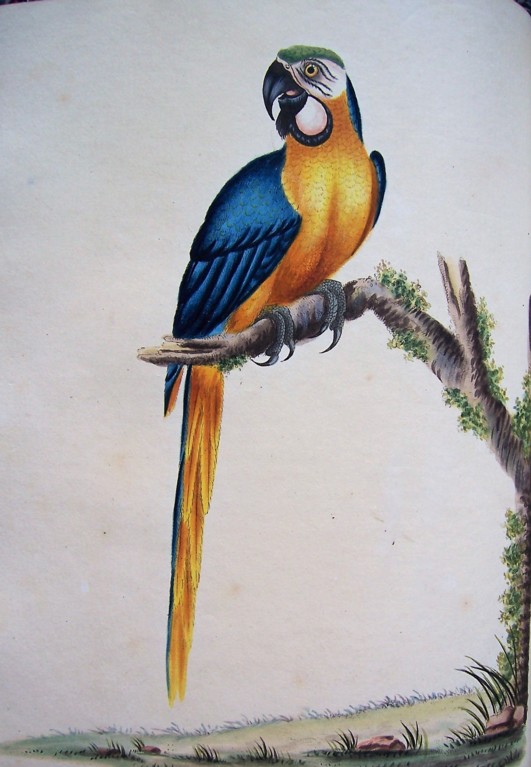
Above; Left to Right; Plate 2. Blue and Yellow Maccaw; Plate 3. Blue Jay; (the latter found ‘at Albany and as far south as Carolina’); William Hayes, Portraits of Rare and Curious Birds … from the Menagery at Osterley Park (1794).
The title-page describes it as by ‘W. Hayes and Family’, and the advertisement reports that Hayes has called on the ‘genius’ of his children to help with illustrations, so that they will have a means of earning a living if he departs this world. It is an intriguing sidelight on how illustrated books of the time may have been coloured by family members as a domestic industry. At a time when so many were instructed in drawing and painting, some of Graham Watson’s volumes are self-help books for the painting of birds, with coloured plates of native birds accompanied by uncoloured versions of the same, ready to be copied and coloured in by the amateur artist.
Early examples of bird picture enthusiasm are the hand-coloured etched plates of George Edwards’s A Natural History of Uncommon Birds (1747).
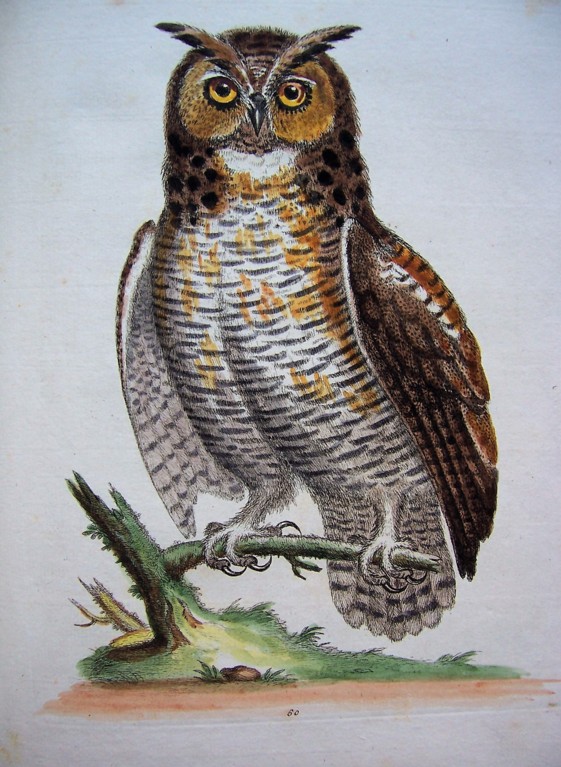
Above; Left to Right; Plate 4. Great-Horned Owl; Plate 5. Crowned African Cranes; George Edwards, A Natural History of Uncommon Birds (1747).
This was considered such a contribution to knowledge that Edwards was awarded the Copley Medal by the Royal Society for his work on the book.
As the eighteenth century progressed, more volumes are published illustrating birds, both native and foreign.
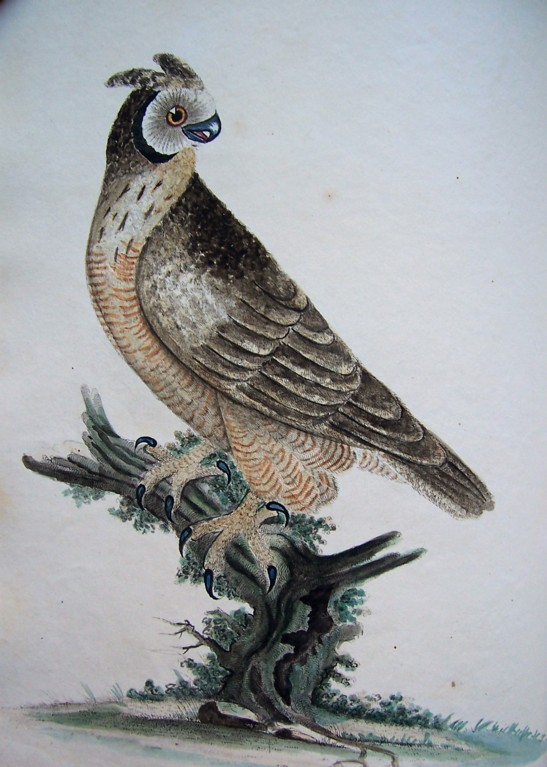
Above; Left to Right; Plate 6. Virginian Eared Owl (Hayes, Portraits); Plate 7. Green Woodpecker and Wryneck (Hayes, Natural History).
The ornithologist John Gould – after starting as a taxidermist or ‘bird-stuffer’ at what is now London Zoo – became something of an entrepreneur of bird books, publishing well over 3,000 plates in various publications, although relatively few were by himself. In his glorious book about toucans, 23 of the 33 hand-coloured lithographs are by Gould and his artist wife Elizabeth, but ten are by Edward Lear, author of nonsense books and limericks.
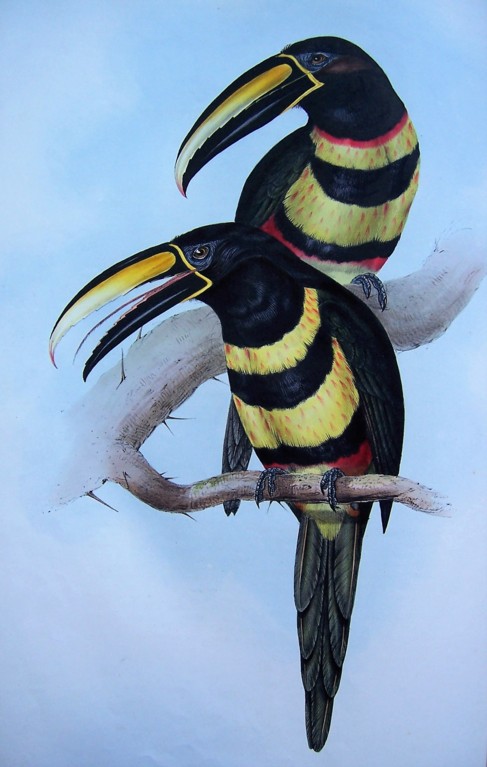
Above; Left to Right; Plate 8. Many-Banded Aracari; Plate 9. Curl-Crested Aracari; John Gould, A Monograph of the Ramphastidae, or Family of Toucans (1834).
The first half of the nineteenth century sees some remarkable illustrations of the birds of very distant places. Emmanuel’s copy of John Lewin’s illustrations of the birds of New South Wales is itself a rare reprint of material that, when previously published, had been the earliest book illustrated with plates engraved and printed in Australia.
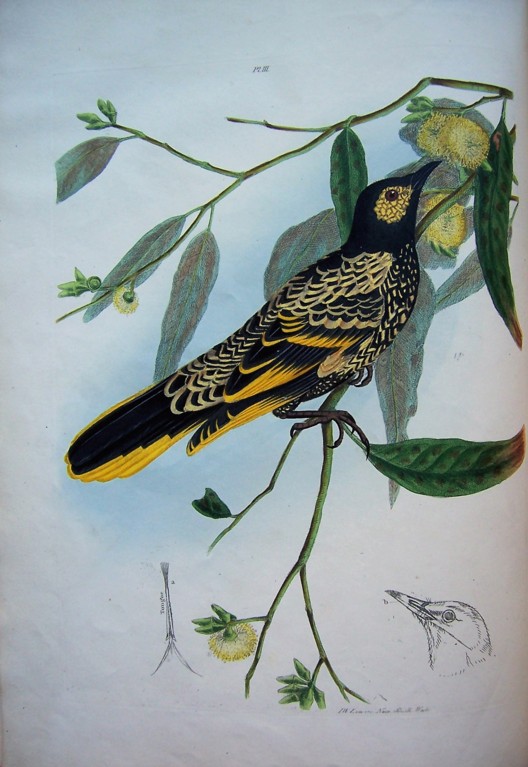
Above; Left to Right; Plate 10. Warty-Faced Honey-Sucker, in John Lewin, A Natural History of the Birds of New South Wales (1838); Plate 11. Male and Female Common Mocking Birds with a Rattle Snake, in John James Audubon, The Birds of America (1840-44).
John James Audubon’s stupendous The Birds of America (1827-38) – with its lifesize images – is only represented in Emmanuel’s collection by its smaller-format octavo edition of 1840-44, although the illustrations, despite their reduced size, can still be dynamic.
The Graham Watson collection testifies both to a nineteenth-century hunger for information about far-flung places (with books about the birds of India and China, South Africa and New Zealand, Brazil and Mexico), but also to local patriotisms, with books about the birds found in particular English counties. The sheer variety also reflects increasingly sophisticated techniques of printing with lithography.
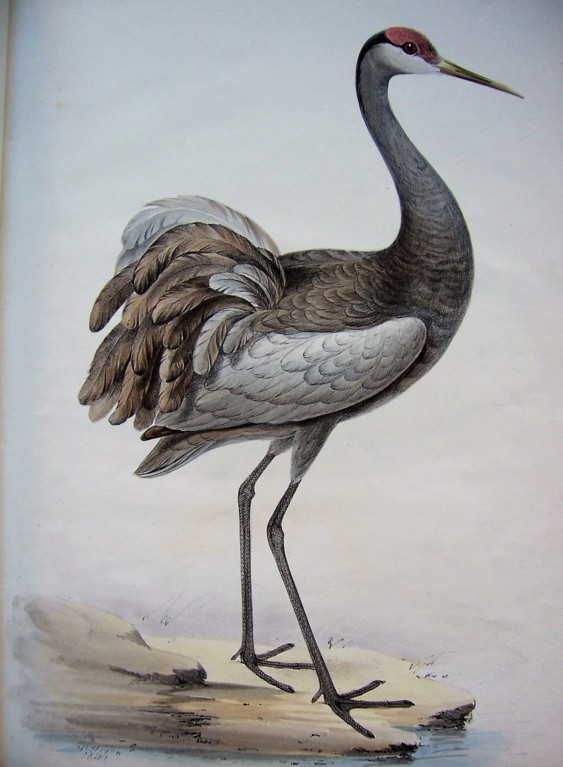
Above; Left to Right; Plate 12. Crane; Plate 13. Hen-Harriers; in Henry Meyer, Illustrations of British Birds (1835); includes rare visitants.
But there can only be one kind of bird with which to conclude:
Above; Plate 14. Mallard, in Meyer, Illustrations.
Barry Windeatt (Keeper of Rare Books)
Images by Helen Carron (College Librarian)
6 October 2022
All the images show carvings on the exterior of Britannic House
During the early summer of 1912 the construction of North Court was in full swing, with the cloister already completed. The architect, Leonard Stokes, intended to furnish the entire building with fine-quality carving, but when the full extent of his schemes became clear, the college authorities were perturbed. Faced with the challenge of trying to rein in the architect, the Bursar tried the tack of emphasising the governing body’s profound ‘dread of ornament’, but Stokes remained determined that the building should be completed to his exact and ‘very carefully considered’ designs.
The original North Court cloister had seven arches (there are now only six, but that is another story…) and Stokes planned to place a highly decorative keystone on each. One carving had been completed, and another was almost finished, when the Master, Peter Giles, made an impromptu inspection of the site. Taken aback by what he found, he immediately interrupted the Bursar’s holiday to inquire ‘who and what the figures are which are being put on the keystones of the Cloister arches in the North Court…I don’t mind the heads, though I have no idea who they are intended to represent, but the extraordinary collections of flowers and fruit from which the heads peep forth seem altogether out of keeping with the rest of the structure and to deteriorate its general effect very much’.
When Stokes learned of the Master’s consternation, he immediately ‘stopped the carver’, but continued to argue passionately for the retention of his ‘essential’ keystones, which were intended to represent the Seven Ages of Man (presumably Shakespeare’s infant, schoolboy, lover, soldier, etc). Stokes pointed out that ‘a certain amount of work, such as models, etc. has already been done…in round figures this amounts to about £50’, but the college, unmoved, insisted that the keystones be either plain, or merely display coats of arms of college benefactors. Stokes grudgingly agreed to the latter, at which point the ‘Seven Ages’ were quietly removed.
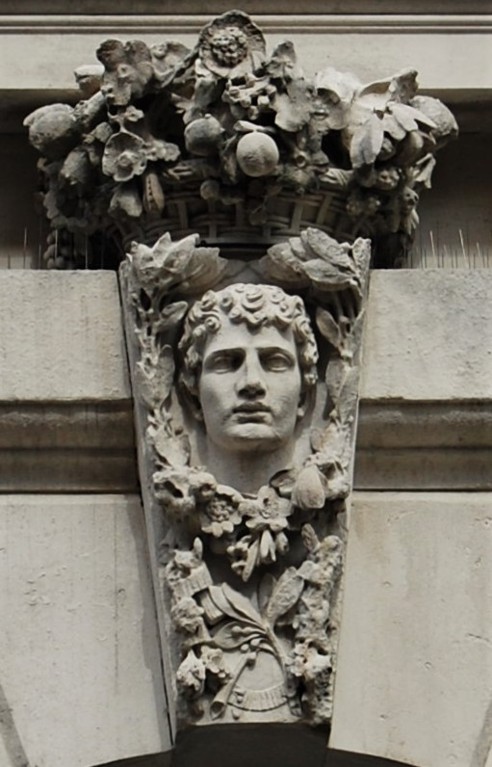
The identity of the carver whose work was so rudely interrupted is unfortunately not recorded in the college archives, but there is a good chance that it was Abraham Broadbent, for he certainly executed the sculptures on the North Court Porters' Lodge (as reported in the Journal of the Royal Society of Arts, Vol. 70, 1921). Born in Shipley, the son of a master carver, Abraham later lived and worked in London. Although he died in 1919, his son Eric continued the family tradition, becoming a fine stone sculptor in his own right. Some marvellous examples of Eric’s work can be seen on Edwin Lutyens’ lavishly decorated 1927 Britannic House in Finsbury Circus, London, near Liverpool Street station. Of particular interest, to us, are the seventeen keystones on the ground floor window and door arches, which show the heads of males of varying ages surrounded by ornate arrangements of fruit and flowers.
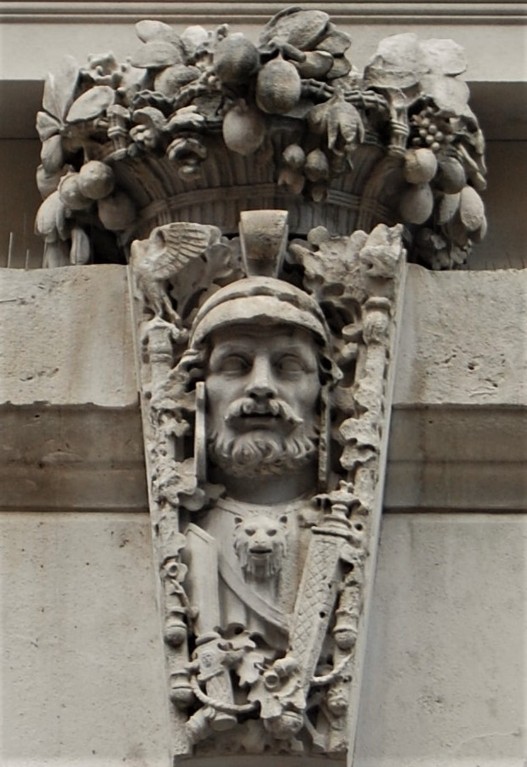
Could some of the Britannic House carvings have been based on (or in two cases, be) the ‘Seven Ages’ models and sculptures intended for Emmanuel, that had so dismayed Peter Giles in 1912? Several incorporate motifs that allude to Shakespeare’s verses, such as mistletoe (lover), sword (soldier) and fasces (judge). If these flamboyant sculptures do indeed include North Court’s ‘lost’ carvings, their rejection by the college can only be regarded as highly regrettable, at least by those of us who share Stokes’ opinion that the exuberant keystones would have ‘added greatly to the interest of the court’.
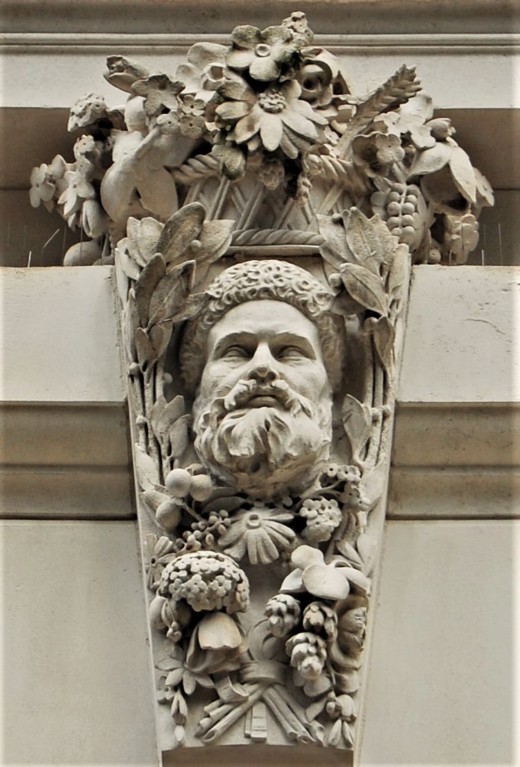
Amanda Goode, Emmanuel College Archivist
8 September 2022
.JPG)
The oil painting reproduced here, soon to be sold at auction, is a portrait of Charles Chadwick, then of Healey Hall, near Rochdale. The artist was John Downman ARA, who also executed a preliminary chalk sketch, now held in the Fitzwilliam Museum in Cambridge.
Charles Chadwick was admitted to Emmanuel in April 1771, although he appears not to have come into residence until Michaelmas Term, when he turned eighteen. He graduated Bachelor of Laws in 1778, paying the college the requisite fee of £4 on March 11. The LL.B degree required six years’ membership of the university, including a residency of at least three years. Charles was still at Emma in October 1774 but had left by the spring of 1775, when he was admitted to the Middle Temple. Although he dabbled in the Law he had no need to practise, as he was heir to the estates of both his father and his minted aunt Dorothy. He could also reasonably expect to marry well and duly did so, bagging the heiress Frances Green of Leventhorpe in 1788. As well as playing a prominent role in local affairs, Charles was a Fellow of the Society of Antiquaries and made significant (if occasionally unreliable) contributions to Shaw’s History of Staffordshire.
In coming to Emma, Charles was following in the footsteps of his great-grandfather and his grandfather, both also called Charles, who had matriculated in 1657 and 1692, respectively. His great-grand-uncle John was also an Emma man, although he was sent down in disgrace in 1664 for (amongst other things) drunkenness, idleness, fighting, insolence and exercising a ‘malign influence’ over his peers, none of which prevented his becoming a clergyman two years later. Other collateral relatives who had come to Emma included yet another Charles Chadwick, appointed one of the first college Fellows in 1584 by Emmanuel’s Founder, Sir Walter Mildmay.
.jpg)
Note in Charles Chadwick’s hand, 1774. © Emmanuel College, Cambridge
The college archives contain a collection of mid-seventeenth century letters and student bills relating to Charles Chadwick and his reprobate brother John. A note pinned to one of Charles’ 1658 bills is in the hand of his great grandson, the Charles Chadwick depicted by Downman. Charles explains his ancestor’s purchase of a ‘Rackett’ by noting that ‘the walls of an old building still remain in the Master’s piece, and join up to the wall of the Fellows’ garden, which building (they say) was formerly a Tennis-Court. C.C. Emm. Coll. 1774’.
‘Portrait’ Charles has left little other trace in the archives, but it is reasonable to infer that he had a warm regard for his college. For one thing, he donated 100 guineas after the fire of 1811 that gutted the Westmorland Building, and for another, he had Downman depict Emmanuel in the background of his portrait. The aspect chosen was the new frontage designed by James Essex, completed in 1775. The northernmost part of that range, referred to initially as ‘The Buttery End’, had already been erected when Charles was admitted to Emma, and it was here – effectively adjacent to a building site - that young Chadwick roomed. At first he occupied the ground floor chamber, but soon moved to the second (top) floor, where he paid an annual study rent of £8.
(2).jpg)
Preparatory sketch of Charles Chadwick, by John Downman, 1778. ©The Fitzwilliam Museum, Cambridge
The Chadwick portrait almost certainly presents the earliest delineation, in a painting, of the new Essex frontage, and is therefore of particular interest to the college. The picture is also, of course, a delightful likeness of a debonair young graduate, proudly sporting his newly-acquired LL.B gown and square, and celebrating his association with Emmanuel, the college where so many of his forebears had studied.
Amanda Goode College Archivist
The portrait of Charles Chadwick is to be sold by Cheffins Fine Art, of Cambridge, on 21 September 2022
8 September 2022
September has already seen some of that rare stuff that we didn’t see for so long……rain.
It has slowly started to green up some areas around college so they look a little more familiar. August continued to see long periods of hot, dry spells and to be honest most of August saw the gardeners simply trying to keep the plants alive. It was a case of daily monitoring and inspection of the plants and watering where necessary. Established plants suffered as much as the new but it was hard trying not to use more water than necessary.
Although not officially with a hosepipe ban in this area, it was still declared a drought and reservoirs were running low. We didn’t want to use more water than was necessary, so things like the lawns looked like straw at times. It is this month that we hope to see some improvement before starting our lawn repairing programs in early October. We aim to scarify the lawns to remove some of that dead grass to enable new grass shoots to emerge.
Late August and into September saw the team turn our attention to the meadow management. It is the time of year to cut down our meadows. We have had good continued success this year in the Emmanuel meadows but like all meadows this summer, they were a little dry. Still worth all the effort as we had a good wildflower display and saw plenty of pollinators, essential for the growing biodiversity of the college grounds. The garden team were fortunate to be able to take part in the management of the meadows at King’s College this year. The team went over to see the display of the cutting down of the meadows, using traditional methods of using the Shire horses. The meadows at King’s are able to be situated in a much vaster area than that of Emmanuel’s. It enables access to allow a horse drawn scythe to cut the meadows. Usually these meadows are cut and bailed by tractor but for the last couple of years the meadows have been cut be the traditional method, making it a greener activity whilst be a great nod to the past. As a result of the Emmanuel College garden team’s involvement, we get to keep some of the bails to extract some seed for our own meadows. This is a great way of sharing and at the same time adding flowers that we do not currently have. A great fun project.
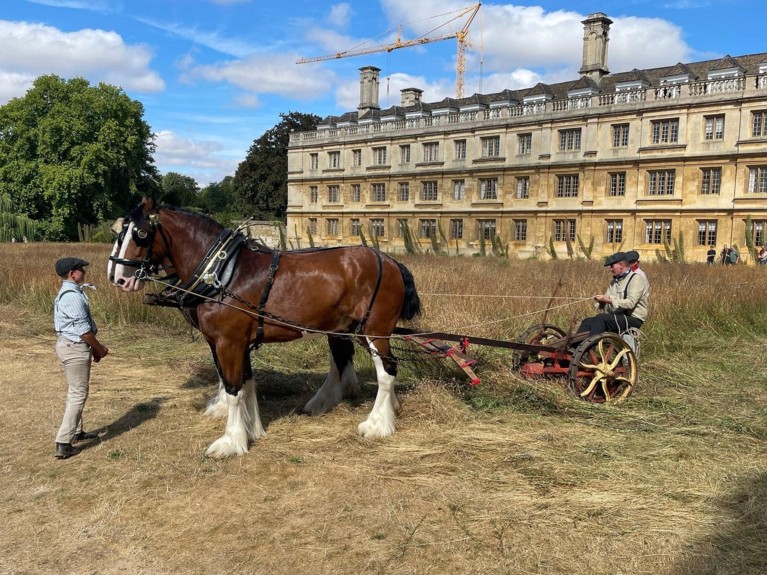
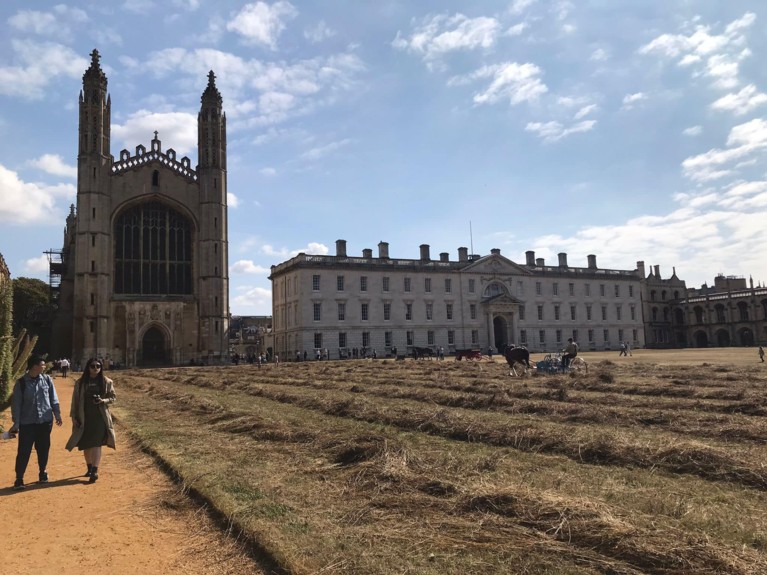
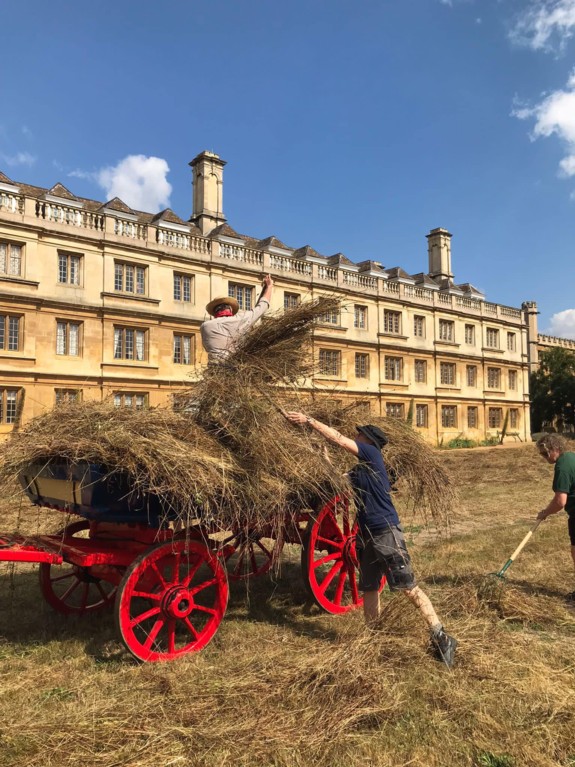
Above; The Emma team assisting with the meadow cutting at King's College
Our own attention in the Emmanuel Garden has been continuing with our composting program. The beds around the college have been lacking nutrition over the years and we are working hard so that we can mulch the beds next spring. This will also help retain some of the moisture into the flower beds, should it be such a dry spell next year too. We have added a wormery to help condense the compost. The worms have been added to break down the compost faster, a very ecological way of compost management.
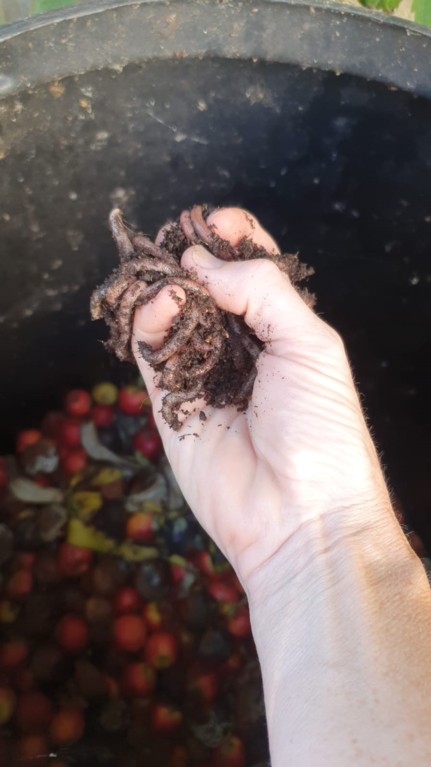
Above; Worms added to the compost
Autumn is officially here now and the early drop of leaves are the telltale signs. Another sign to look for is the lovely Colchicum bulbs under some of the trees. Colchicum (the Latin/ Botanical name) in German is called Herbstzeitlose. It roughly translates to ‘the one that fortells Autumn’. It certainly does exactly that.
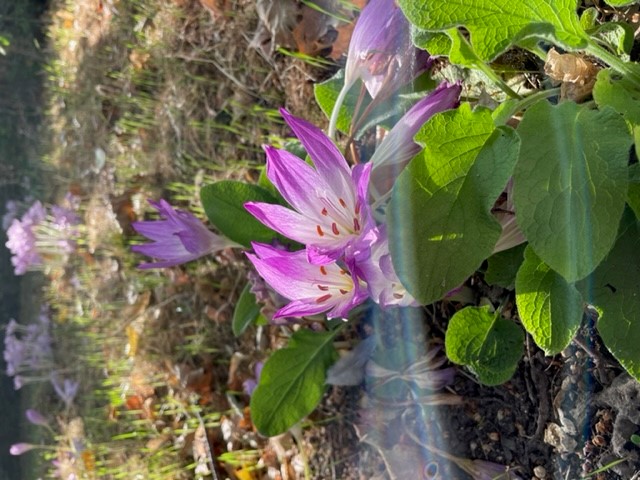
Above; Colchicum
Best Wishes
Brendon Sims ( Head Gardener).
8 September 2022
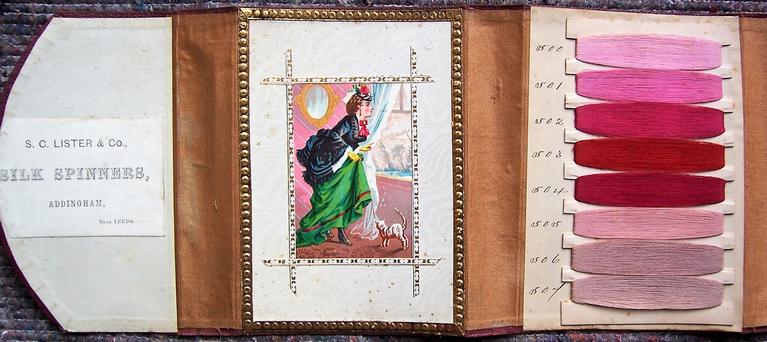
Who was Graham Watson, whose collection of hand-coloured illustrated books has been the source and inspiration of so many of these rare book blogs?
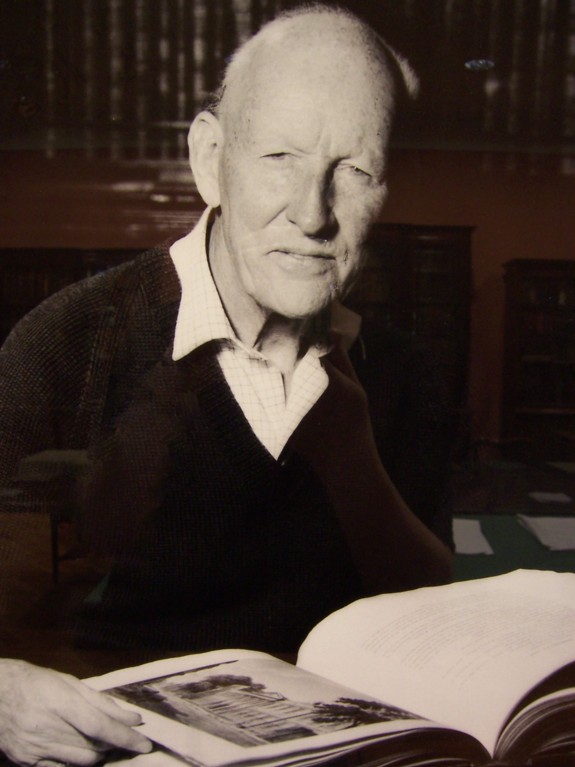
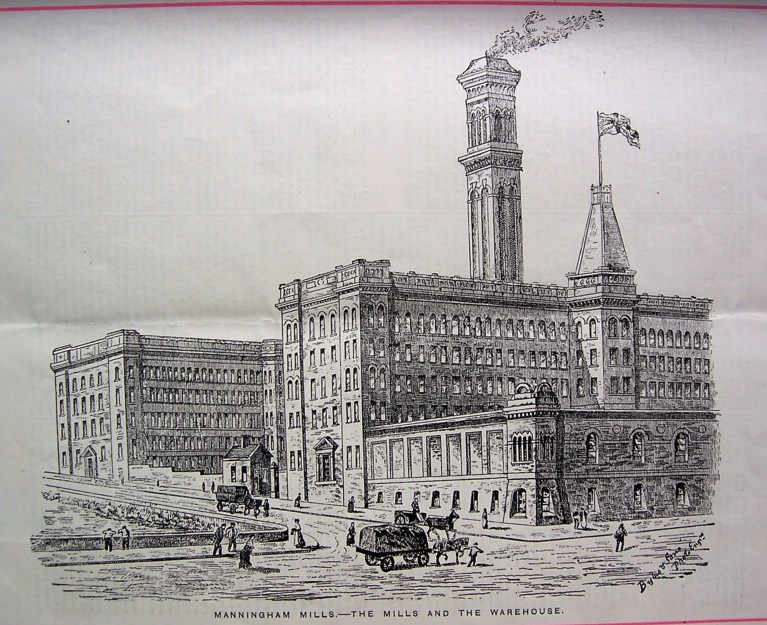
Above; Left to Right; Plate 2. Graham Watson, holding Ackermann’s ‘Cambridge’, open at the entry on Emmanuel; Plate 3. Manningham Mill, Bradford Observer, 6 February 1889.
Graham Watson (1908-2002) came to Emmanuel in 1927 to read Mathematics. In 1865 his great-grandfather had moved from Paisley to manage a worsted spinning mill in Wharfedale for Samuel Cunliffe Lister, the pioneering textile magnate. Listers & Co would become the largest textile business in the country, based at the enormous Manningham Mills in Bradford, employing over 5000 people and specializing in the finest silks and velvets. After Emmanuel, aged 22, Graham joined Listers and by 1947 was Managing Director, as his father and grandfather had been before him. But in 1959 the company was taken over by a consortium of London financiers who – in Graham’s view – were focussed solely on profit and loss and were indifferent to staff welfare. A few months later, Graham left the company with which his family had been associated for nearly a century.
For the rest of his long life Graham Watson devoted himself to good causes and the public good. One of his greatest passions was preserving the landscape of the North of England, particularly the Lake District and Yorkshire Dales, and he was a member simultaneously of both their National Park Authorities. Graham and his brother David began to acquire farms in Upper Wharfedale in order to protect them. Upon David’s death in 1988 Graham presented all of their 5200 acres of Yorkshire Dales landscape to the National Trust, so that they would be safe in perpetuity. It was a munificent gift to future generations.
As a young man, to escape from the tremendous din and strong smells of the mill, Graham would head off on his motorbike at weekends into the Lakes or Dales. So it was that in 1939, at a bookshop in Ambleside, he was shown a copy of Ackermann’s History of the University and Colleges of Cambridge (1815). Graham’s first sight of the aquatint illustrations was, as he described it later, ‘akin to first hearing a Mozart symphony’. Although, as a Yorkshireman, he was shaken to be asked £40 for the two volumes (equivalent to £2000 in today’s prices), he nevertheless bought the books. So began a lifetime’s passion for hand-coloured illustrated books, aquatint and early lithograph, that would amass one of the most significant collections in the world.
As a collector, Graham Watson was meticulous: he only bought books in pristine condition, and they were shelved in contemporary glazed mahogany bookcases in his home in Bradford, now relocated to the Graham Watson Room in the College Library.
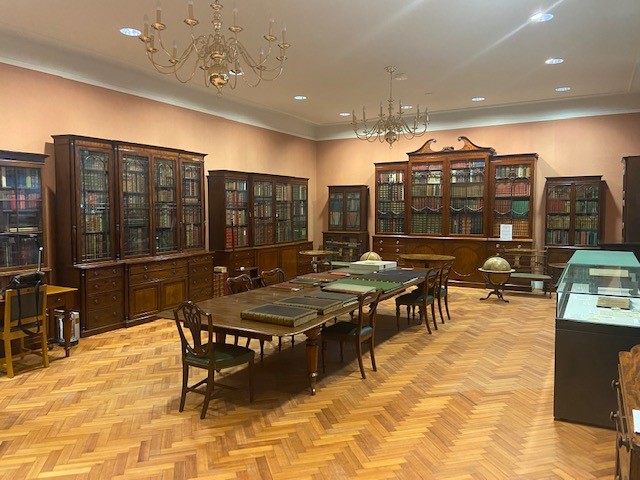
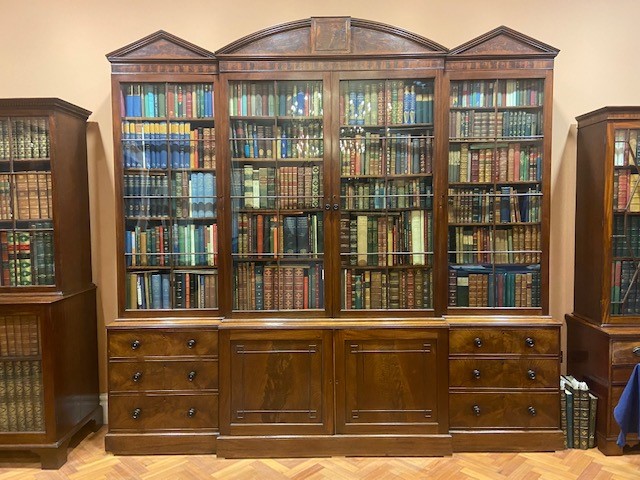
Above; Left to Right; Plate 4. The Graham Watson Room, Emmanuel College Library; Plate 5. Bookcase believed to come from the library at Eshton Hall, Yorkshire, of Frances Mary Richardson Currer (1785-1861), the first major female bibliophile and collector in Britain. Currer supported the Clergy Daughters’ School attended by the Brontes, and Charlotte Bronte’s nom de plume of ‘Currer Bell’ is thought to acknowledge her
Each was carefully catalogued, often with details of when and where purchased and earlier ownership. There are many very rare and some probably unique copies. Each carries his bookplate of the Emmanuel lion against a backdrop of Wastwater in the Lake District, so combining two of his greatest enthusiasms.
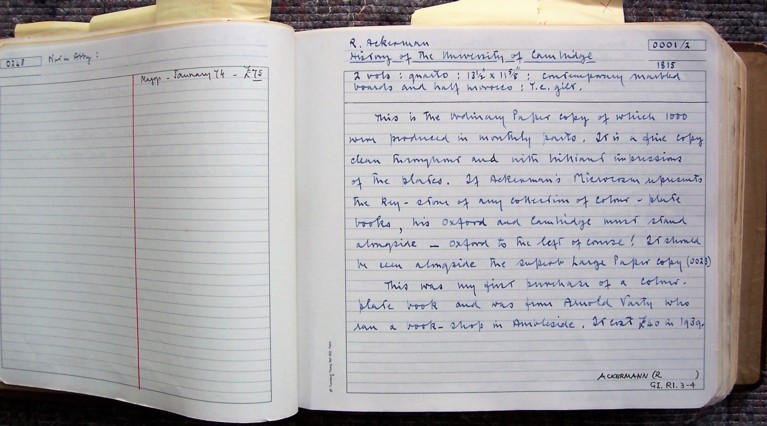

Above; Left to Right; Plate 6. Catalogue, in Graham Watson’s challenging handwriting; Plate 7. Graham Watson’s bookplate.
The subject range of the books is very wide indeed, with a core interest in topography.
There are numerous books on flora and fauna, native and foreign, with a special emphasis on birds.
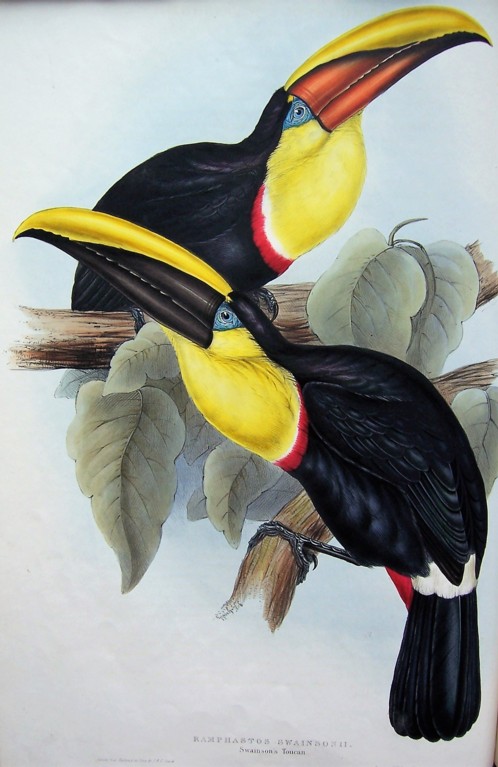
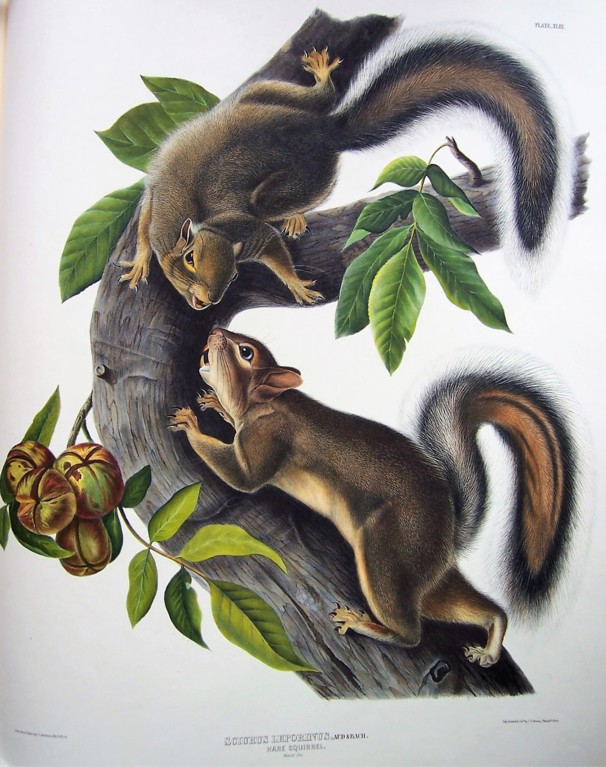
Above; Left to Right; Plate 8. ‘Swainson’s Toucan’, in J. Gould, A Monograph of the Ramphastidae or Family of Toucans (1834); Plate 9. ‘Hare Squirrel’, in John James Audubon, The Viviparous Quadrupeds of North America (1845-8).
There are exquisite flower books, while the picturesque is pursued at home and abroad, and may be found in essentially picturesque depictions of landscape in India or the Americas.
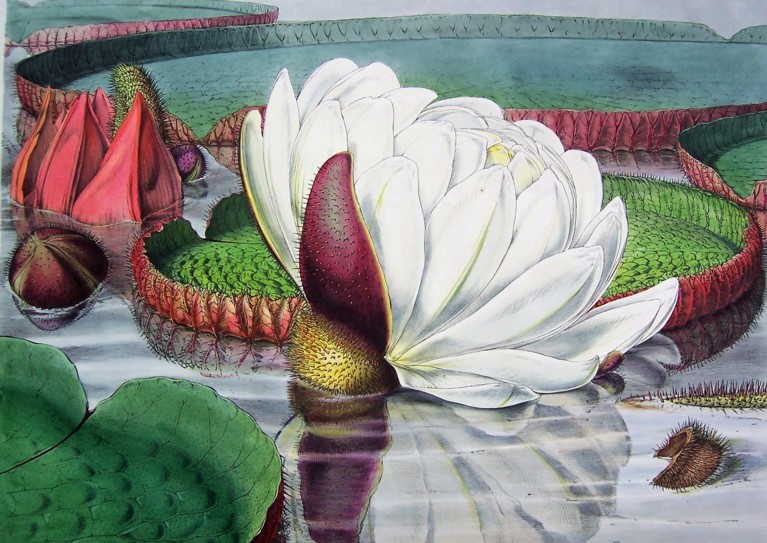
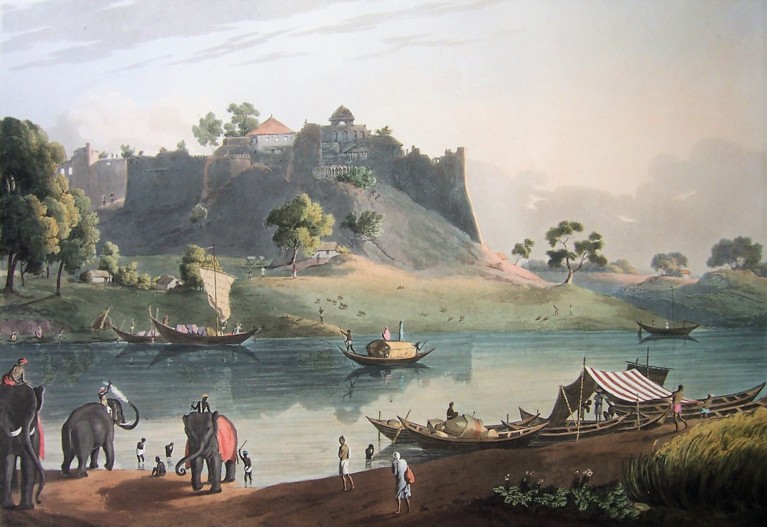
Above; Left to Right; Plate 10. W. Fitch, Victoria Regia: Illustrations of the Royal Water-Lily from Specimens Flowering at Syon and at Kew (1851); Plate 11. ‘Ruins of the Fort at Juanpore on the River Goomtee’, in Henry Salt, Views in St Helena, the Cape, India, Ceylon, Abyssinia and Egypt (1809).
There are books catering to all that might interest armchair travellers in the scenery, architecture and antiquities of not only the British Isles and Europe but also the Middle East and Far East.
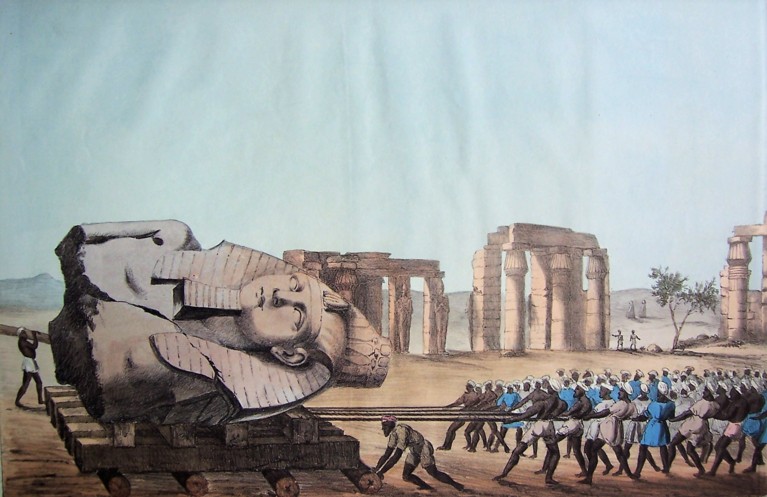
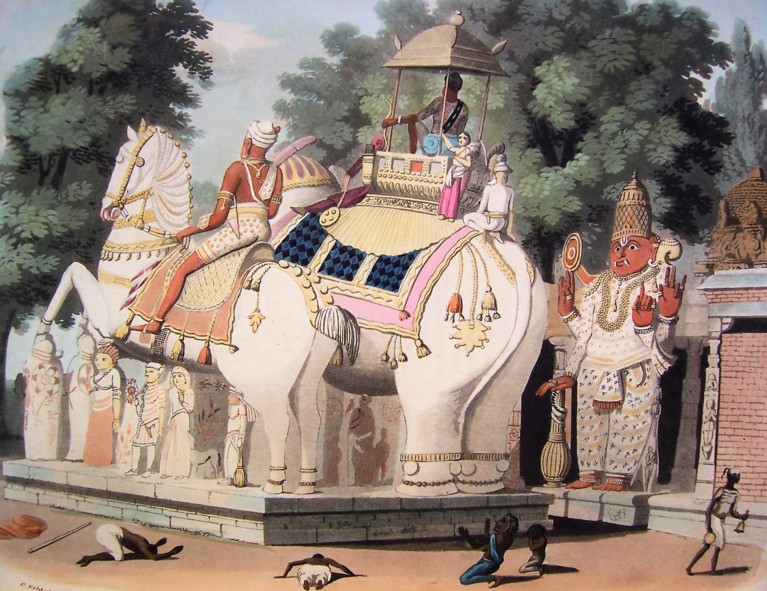
Above; Left to Right; Plate 12.‘Mode in which the Young Memnon’s Head (now in the British Museum) Was Removed by G. Belzoni’, in G. Belzoni, Plates Illustrative of the Researches … in Egypt and Nubia (1821-22); Plate 13.‘Colossal Idols near the Village of Manapar’, in Charles Gold, Oriental Drawings (1806).
Customs and costumes are a great favourite, along with sports and pastimes. Yet this life-long lover of motorbikes, always interested in machines, also found space for a very early exposition of the advantages of gaslighting, with illustrations of the machinery.
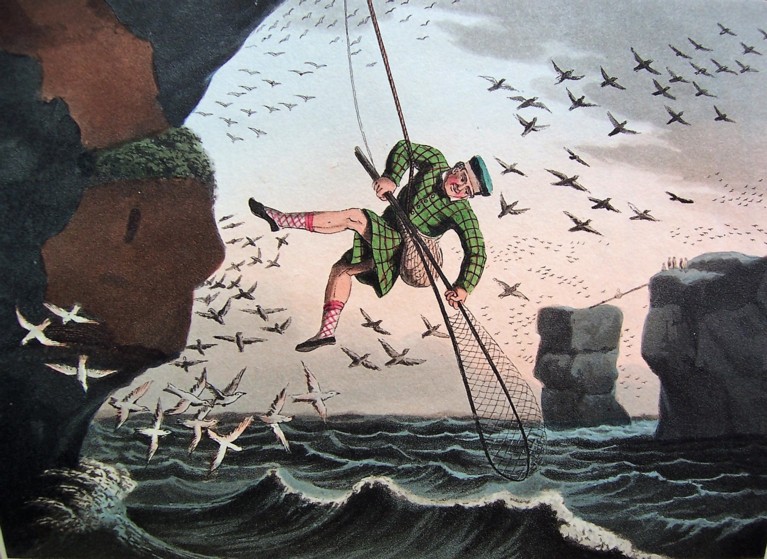
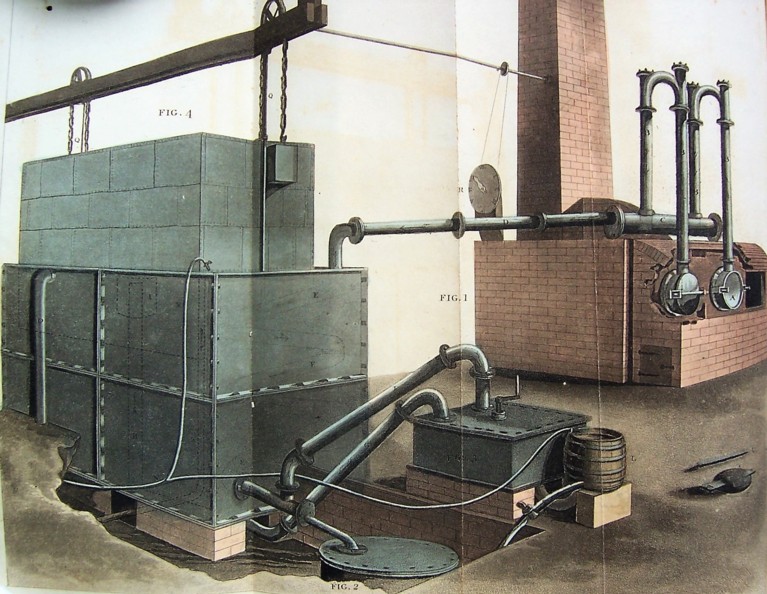
Above; Left to Right; Plate 14. ‘Bird Catching from Above’, in Foreign Field Sports, Fisheries, Sporting Anecdotes (1825); Plate 15. Frederick Accum, A Practical Treatise on Gaslight, exhibiting a summary description of the Apparatus and Machinery Best Calculated for Illuminating Streets, Houses and Manufactories with Carburetted Hydrogen or Coal Gas (1816).
For Graham Watson it was the greatest pleasure to show his books to friends and visitors. But in 1975 he decided to present the collection to Emmanuel, where he felt the books would be enjoyed by more people into the future. Besides, there was no problem in his seeing his books again whenever he felt like it. Until an advanced age, Graham would simply hop on to his powerful motorbike and roar down from Bradford to Cambridge, arriving in Emmanuel in time for breakfast.
Barry Windeatt (Keeper of Rare Books)
With special thanks to Dr Helen Carron (College Librarian), who has curated an exhibition on Graham Watson in the College Library
11 August 2022
August is proving as difficult as July for the Emmanuel Gardens. There is still no sign of rain in the forecast and it feels like months and months since it last rained. July has seen record temperatures and the driest July since records began in the 1800’s. This is the hottest summer since 1976 and the driest summer since the 1930’s. The garden is taking quite a hit.
The plants that should be comfortable with the heat and dry are struggling too. The same can be said for our gardeners. Never before have we been so stretched as far as having to water the beds with such frequency. The water we put down is burned off by the afternoon.
In late July, I continued to work with the Landscapes Architects on the planting for the new build, trying to work out what the best plants to use would be. The problem being that yes, the Summers are longer and drier, but also the weather could be cold with winds (the beast from the east etc.), heavy rains and flooding, and possibly freezing temperatures.
In this weather, it would be tempting to plant a cactus or succulents, but at another time of year these plants would be not suitable. It certainly is a headache for anyone involved in landscape design. I think we are getting close to the right plant choices.
The dry gardens aside, the department is still busy and moving forward. This month has seen an internal promotion, for Theo Giasemidis, one of the garden departments longest serving team members. I was pleased to offer Theo the role of Assistant Head Gardener, and reward Theo for the hard work and dedication, that he has shown the department over the years.

Above: Theo Giasemidis, Assistant Head Gardener
I was also pleased to offer Kate Cook a trainee role under the WRAGs scheme. Kate will be in the department for a year working on Thursday and Friday. She should gain some great knowledge working alongside our talented gardeners for the next 12 months.
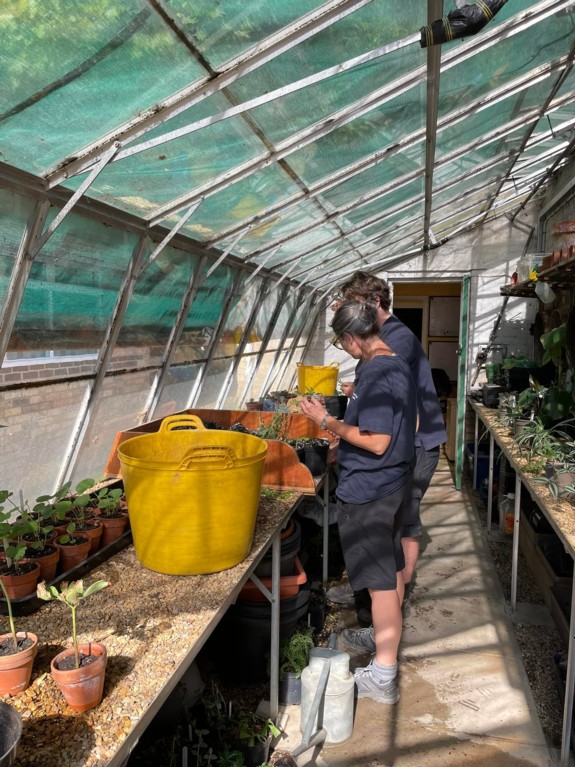
Above: Kate Cook training under the WRAGs scheme
Whilst the grass cutting has slowed, the other work continues. We are taking full advantage of our newly refurbished glasshouse and yards and have been looking to the present and future. In the present we have been producing some tomatoes and chilies for the kitchens. Whilst not trying to supply the kitchens in full, it has been nice to pass some of Emmanuel’s home grown produce for occasional use. Something the myself and Head Chef Nathan Aldous will be working towards in the future. We have also been collecting seeds and taking cuttings from our ornamental plants in preparation for expending the college gardens stock for replenishment of the borders.
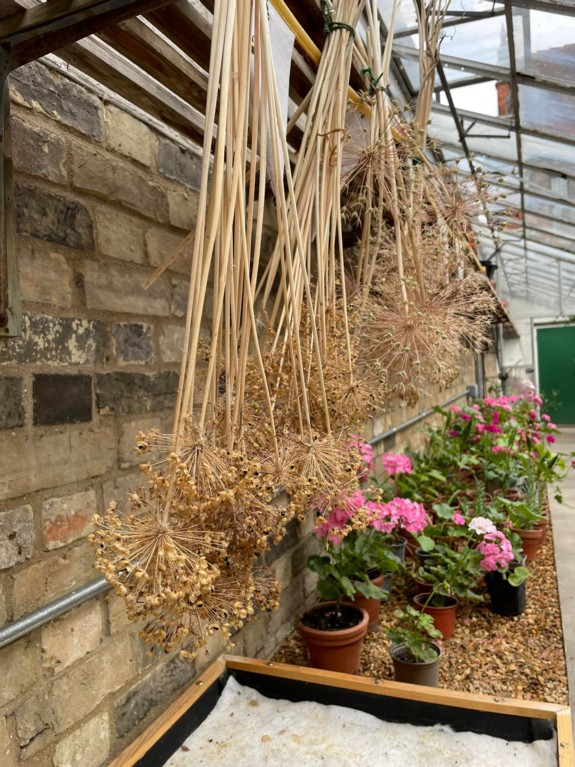

Above: Left; Collecting seeds; Right; Tomatoes in the greenhouse
We continue with our composting regime that should also reduce water loss within the borders. The beds have become dry over years of this not happening and incorporating some good organic matter next spring should help minimize water loss. All things we are preparing now for the future, which I guess is what gardening is all about after all.
Best wishes,
Brendon sims (Head Gardener)
11 August 2022
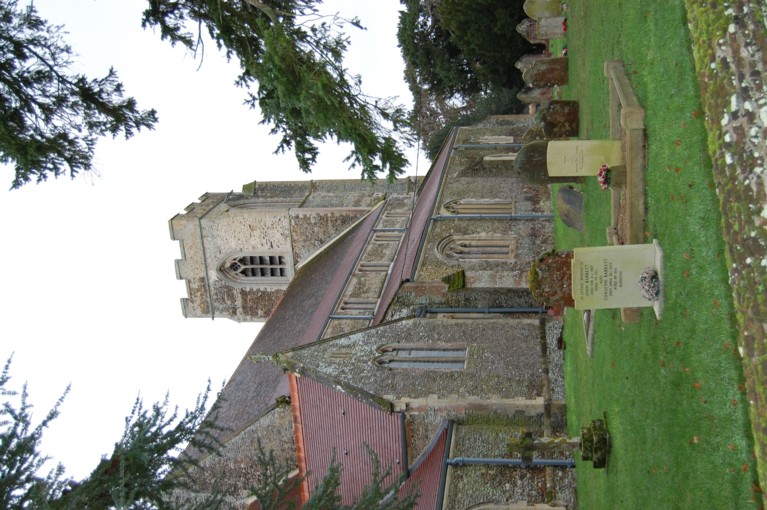
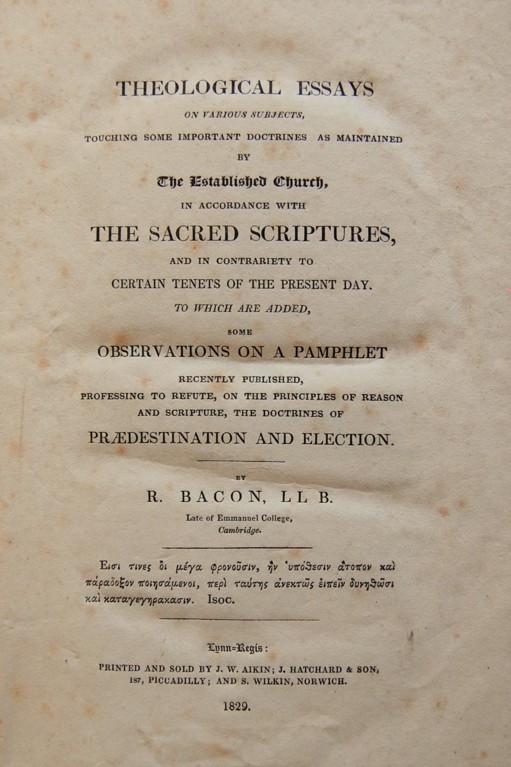
Above Left: Wolferton Church Above Right; Title page of work by Robert Bacon
Entertaining anecdotes about the college’s history abound, some more plausible than others. It is rarely possible to put them to a definitive test, but the case of Robert Bacon is an exception. Admitted to Emmanuel in 1799 when he was in his early 30s, Bacon graduated Bachelor of Laws in 1806. He later styled himself LL.D. Following his ordination in 1802, Bacon amassed a clutch of parochial cures in West Norfolk, including the perpetual curacy of Fring, a small village nestling in a fold of the Norfolk Heights. From 1836 he was also rector of Wolferton, a low-lying parish near the Wash. The two villages are about seven miles apart as the crow flies, but more by road.
Bacon died in 1861, aged 95. During his long career he penned a number of ponderous religious tracts, including True Religion the Glory of a Nation, A due sense of religion productive of civil obedience, Christian Consolation, Strictures on Tractarian Notions and A scriptural view of the ordinance of baptism. A copy of his Theological Essays, printed by subscription in 1829, is held in the library at Emma, for the college was one of the subscribers.
In the archives’ correspondence files is a letter written many years ago by a potential biographer of Bacon, who represented him as a man whose ‘two chief concerns in life were his income, and how to increase it and his personal dignity and importance and how to record it for posterity’. Pluralism must have helped with the first of these ambitions, and crowd-funded publishing with the second; Bacon also apparently noted his pastoral achievements on the flyleaves of his parish registers. It was another sentence in the biographer’s letter, however, that particularly caught my attention: ‘Bacon used to ride to the top of the hill at Fring from which he could see the Wolferton tower and if there was no congregation the verger flew a flag and the Dr returned to Fring Parsonage’.
Knowing the locality reasonably well, this statement struck me as being highly dubious; not because there is now neither a parsonage at Fring nor a flagpole at Wolferton, for such things can pass away, but because of the lie of the land. The only way to be sure, though, was to see for myself by climbing the hill in question, which is crowned with a triangulation pillar. Having now ascended to this vantage point in varying weather conditions, I can confirm that it is impossible to make out Wolferton church, even on a clear day.
There are in any case other reasons to doubt the story. However turgid the Revd Robert’s sermons may have been, it seems unlikely that the complete absence of a congregation was a regular occurrence at Wolferton. We are also asked to accept that the parishioners would have sat patiently in their pews while the elderly rector careered across the intervening acres of countryside. Even if Bacon possessed a steed to rival Roland, he could hardly have made the journey in reasonable time, and if, as seems more likely, his mount was merely a cantering cob, the story becomes wholly implausible. It also ignores the question of how the busy cleric communicated with his other parishes. Whether the anecdote originated with Bacon himself, or one of his parishioners, is unclear, but it has all the hallmarks of a classic after-dinner yarn and is best enjoyed on that level.
Amanda Goode, College Archivist
28 July 2022
As I write this blog the country has just witnessed its two hottest days on record and let me tell you, the lodge was to say the least, stifling. The porters, while suffering like everyone else, maintained the high standards we all expect and happy faces all round. The Pool was unusually busy for obvious reason and at one stage there were over a hundred people lapping up the good weather taking advantage of this unique college perk.
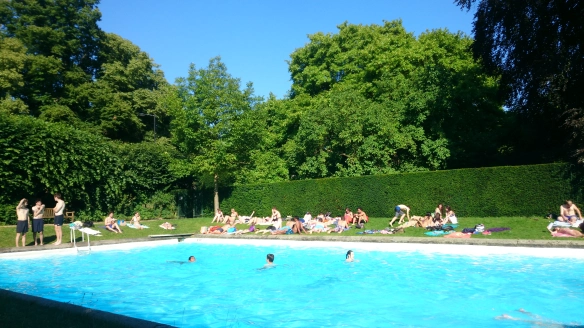
Above: Emma's pool in action
The guys and girls in the lodge have been taking advantage of this relatively quiet period by getting in some well-deserved leave and I wish them all a great time wherever they go for their hols.
At this time of year, the college plays host to various summer schools from across the pond and around Europe. This year, The University of Tennessee, The University of Richmond Law and Davidson University are all visiting the college over the summer period. We also have Ceri, a global group visiting the college this year.
It is particularly poignant regarding Richmond Law, as this year their senior Supervisor is Retiring. Mr. Clark Williams has been bringing his students to Emma for many years and it is with sadness that we have to say goodbye to him. It has been a pleasure to both work with and know him over the years that I have been at Emma.

Above: Mr Clark Williams; Senior Supervisorr, The University of Richmond Law
I will very soon be taking a couple of weeks off and will be traveling up to Scotland to see the outlaws! But seriously, I am looking forward to driving up to Scotland, it is one of my favorite places to visit and this year we are going to be spending time in Oban and Mull. So, the college will be in the very capable hands of our Deputy Head Porter, Paul.
Below: Pictures of Scotland


Love, The Plodge
28 July 2022

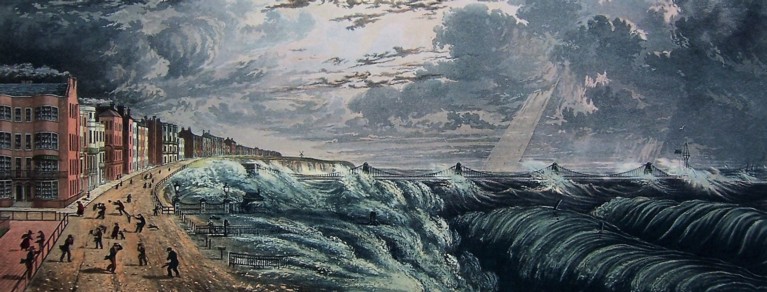 Above: A Nice Day Out: ‘Brighton Chain Pier in a Storm’ (1824); C. & R. Sicklemore, Sickelmore’s Views of Brighton (1827).
Above: A Nice Day Out: ‘Brighton Chain Pier in a Storm’ (1824); C. & R. Sicklemore, Sickelmore’s Views of Brighton (1827).
Jane Austen’s unfinished last novel Sanditon – satirizing society in the new seaside resorts of her era – has spawned a popular historical-drama TV series, witnessing to our two-centuries-old, on-off love-affair with the British seaside resort, which is well-attested in the College’s Graham Watson Collection of illustrated books.
Emmanuel’s collection is rich in hand-coloured illustrations of the various, previously humble fishing villages and small ports that were busily reinventing themselves as fashionably elegant resorts, here depicted with as many picturesque features as possible.
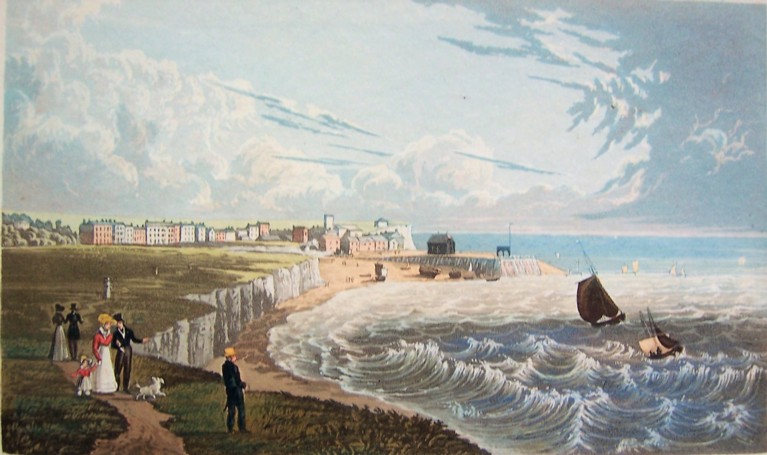
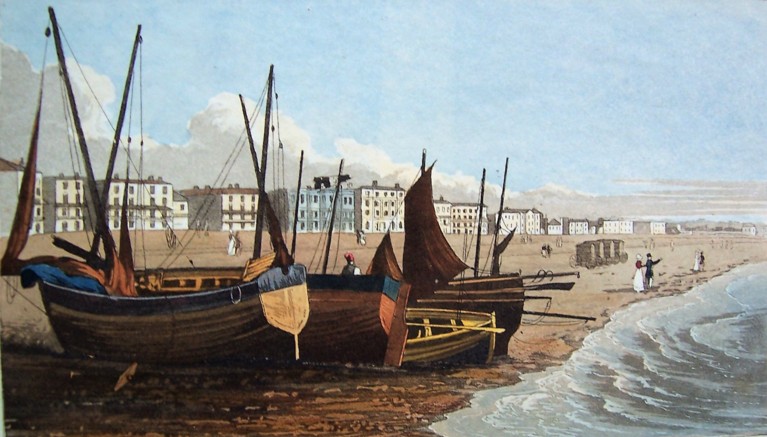
Above: Robert Havell, The Tour or Select Views on the Southern Coast (1827): ‘Broadstairs’ and ‘Worthing’.
Accustomed as today’s visitors are to all the layers of subsequent development, it is striking to see the rawness of new promenades of Classical terraces thrown up between the cliffs and the sea at Hastings, or to observe development spreading back rapidly inland from the sea at Torquay.
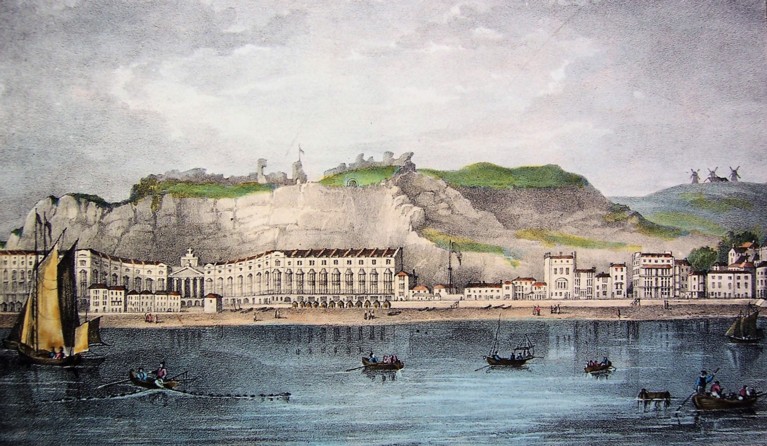
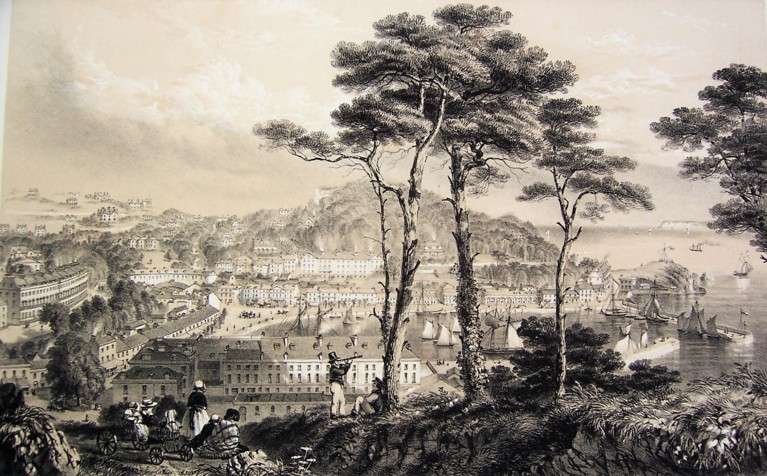
Above: Thomas Ross, Ross’s Views of Hastings and St Leonards (1830), ‘Marine Parade, Hastings’; John Salter,Views of Torquay (c.1850), ‘Torquay from Waldon Hill’.
Part of the seaside’s popularity was the new craze for sea-bathing. But polite persons needed to use a bathing machine. This was a kind of bathing hut on wheels, which was drawn out into the sea by horse, so that the said polite person could then plop into the sea unseen in decent privacy. A book illustrating the delights of Scarborough – rebranding itself as another fashionable new resort – shows bathing huts in operation, with a naked bather entering the sea.
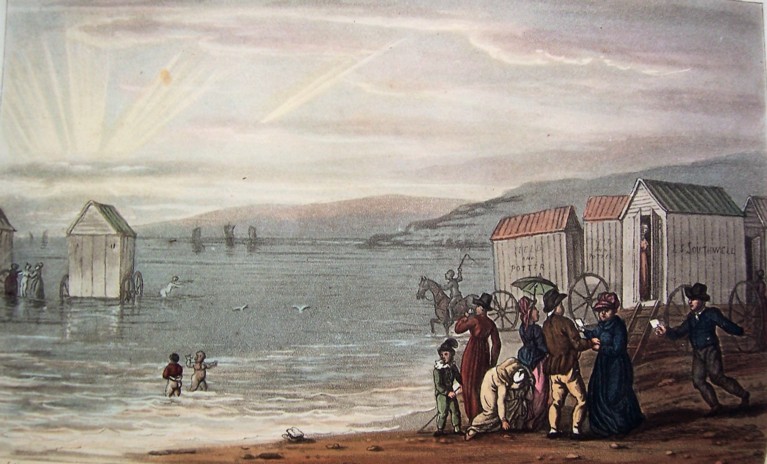
Above: Poetical Sketches of Scarborough: Illustrated with Twenty-One Engravings of Humorous Subjects (1813): ‘Sea Bathing’.
Below: Gallery of Fashion, September 1797.
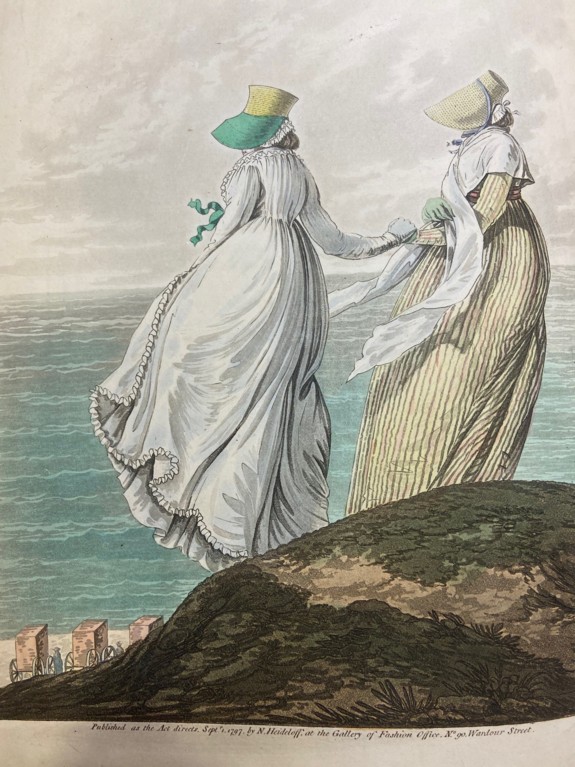
In Nicholaus Heideloff’s Gallery of Fashion two young ladies look down from a cliff top on a beach with rows of bathing machines and their attendants.
Heideloff’s illustrated fashion monthly includes a number of must-have outfits to be worn by the most elegantly-dressed at the seaside.
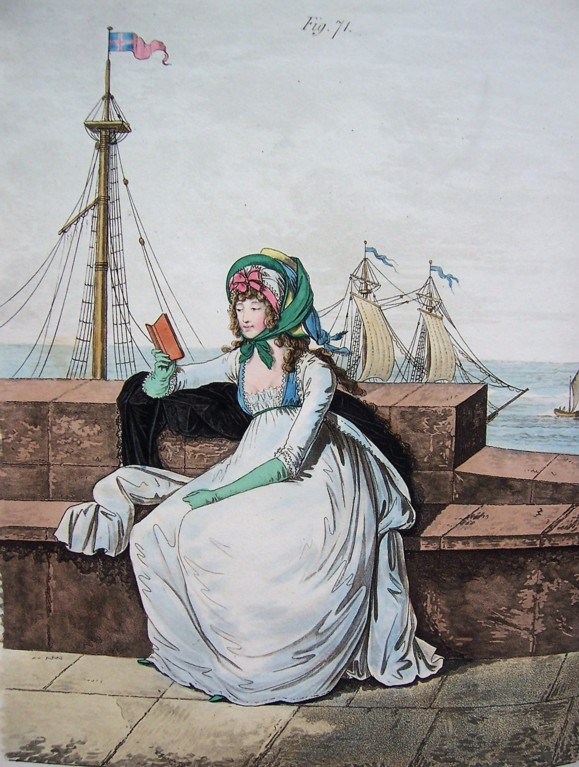
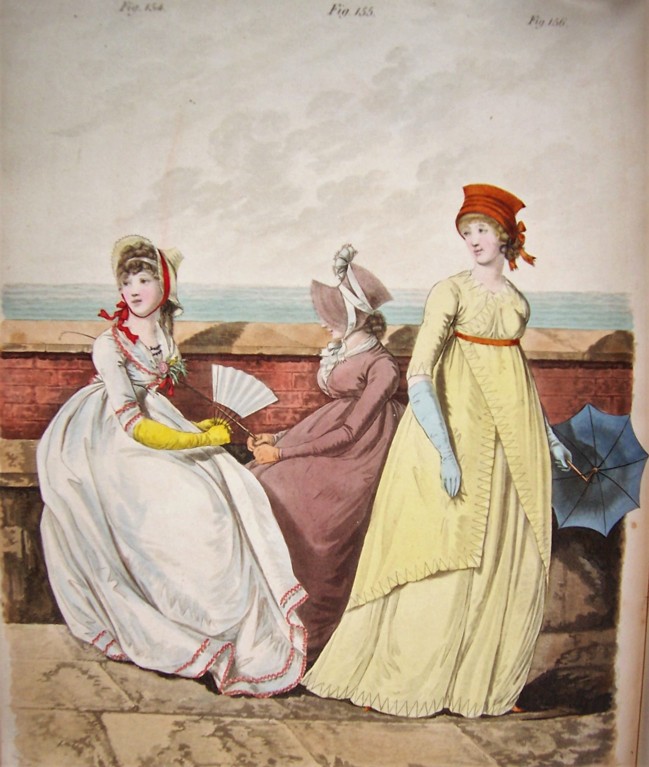

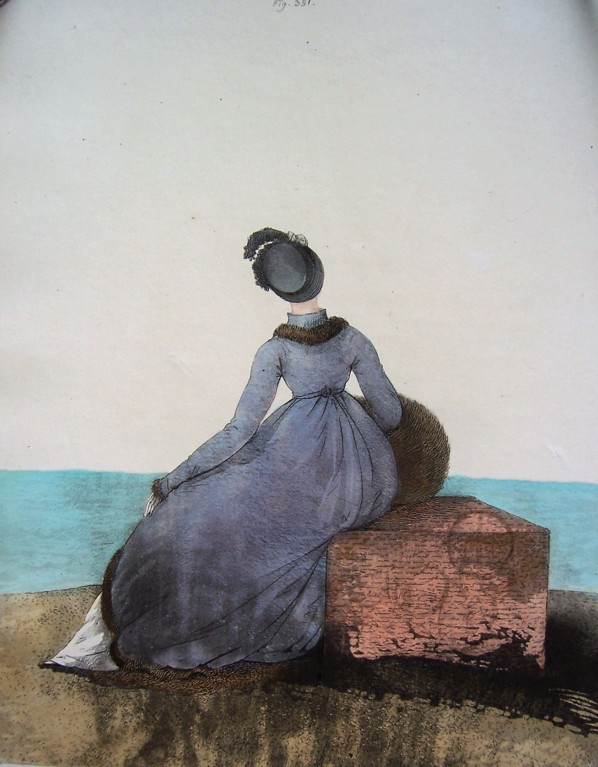
Above: Gallery of Fashion, October, 1795; August 1798; October, 1800; November 1802.
Illustrated books on seaside resorts serve to record the beauty that their times had newly discovered and valued, such as the beautiful location of Sidmouth in East Devon or the picturesque scenery of the Isle of Wight.
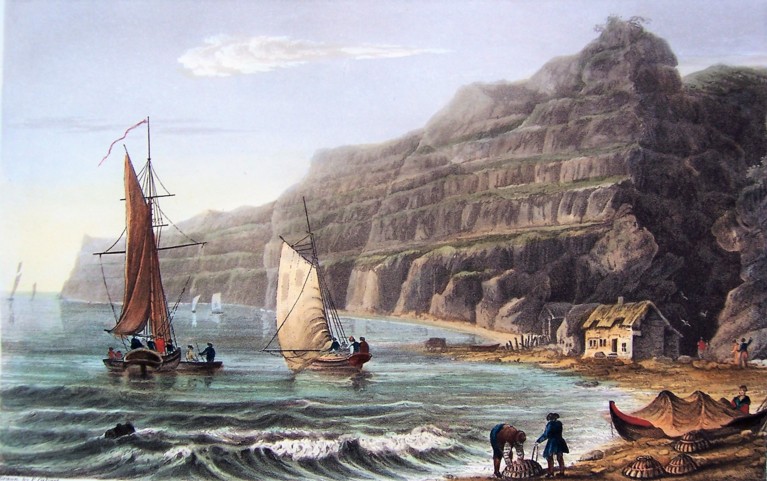
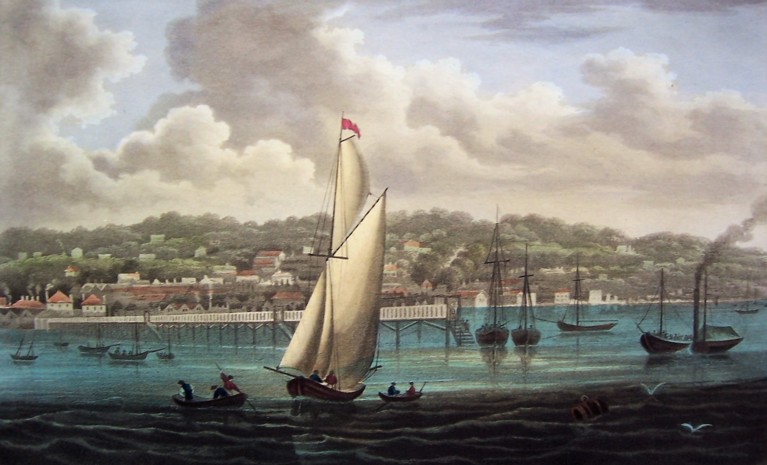
Above: P. Roberts and F. Calvert, The Isle of Wight Illustrated (1846): ‘Shanklin Bay’ and ‘Ryde’.
The attractions of piers (as in this one at Ryde) are often extolled, because they enable healthful promenades out into the sea air, well-provided too with seating and railings.
Alas, the other constant of being beside the sea is the weather. An illustration of the picturesque Allum Bay on the Isle of Wight – a tourist destination from the late eighteenth century – suggests it might turn out to be one of those damp days by the sea.
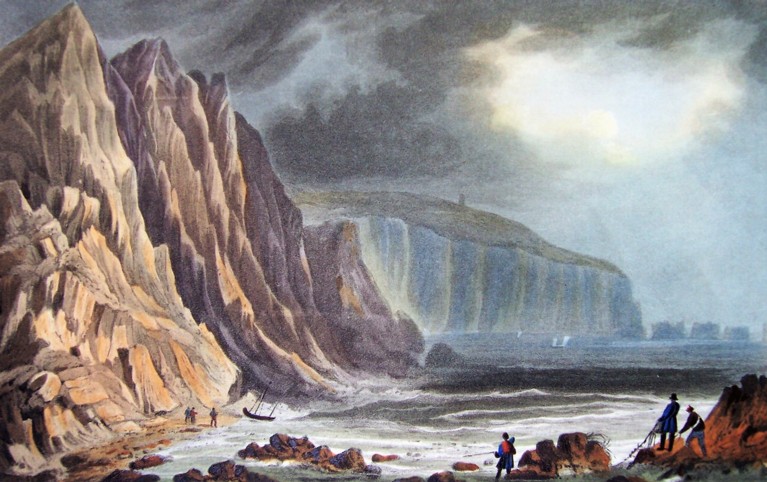
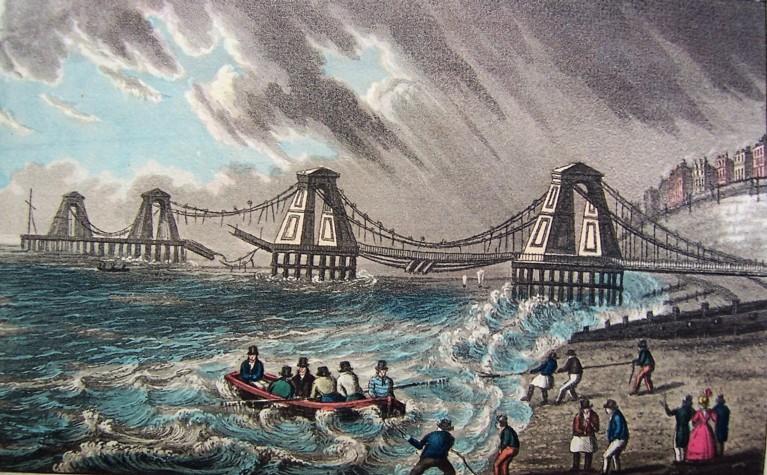
Above: Isle of Wight Illustrated, ‘Allum Bay’; John Bruce, The History of Brighton, with the Latest Improvements to 1834 (1835), ‘Situation of the Chain Pier on the Morning after the Tempest, October 1833’.
The famous Chain Pier at Brighton – painted by both Constable and Turner – was damaged by lightning in a storm in 1833 (as shown here), and eventually swept away by a storm in 1896.
Barry Windeatt (Keeper of Rare Books)
Images by Helen Carron (College Librarian)
14 July 2022
This last month has seen a very busy period for the Emmanuel College garden team. It has been a pressured few weeks of garden party after garden party, May Ball and graduations. This is where our focus has been and continues into July and beyond.
June was a tricky month navigating the management of the gardens through the noise restricted exam periods but with the introduction of our battery equipment and careful management I believe we did well keeping the noise to a minimum whilst trying our best to maintain a very high standard. Our standard levels are very important to us and we tried hard to get the gardens looking as best as possible for the May Ball. As gardeners we wanted the college gardens to be the boast of the May Balls, with many student’s fellows and guests in attendance. I hope we did you proud.
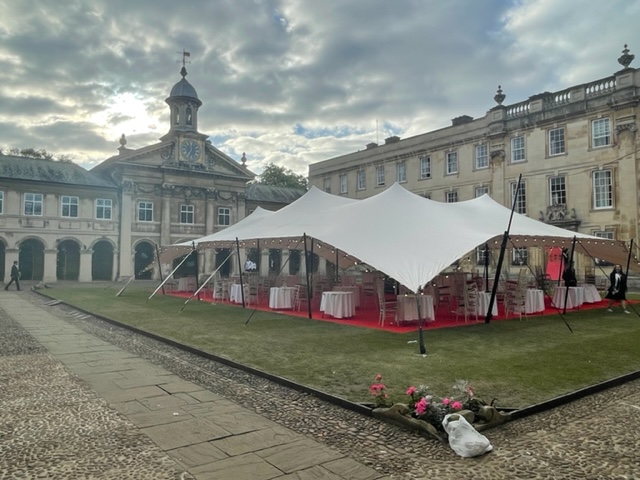
Above; May Ball set up in Front Court
With the preparation of the May Ball, there also comes the aftermath. The lawns took a particular bashing with the placement of attractions and the footfall of hundreds of feet, including stilettos. The garden team set to work quickly to repair the front court lawns in particular. The front court lawns were fertilized with organic lawn feed the very next day, and a brief watering regime soon bought the lawn to looking something like its best in time for the graduation in a weeks’ time, to make those memorable graduation photos look great. The photos will remain in peoples living rooms for years to come, so it’s important that the garden team, take particular pride in this task.
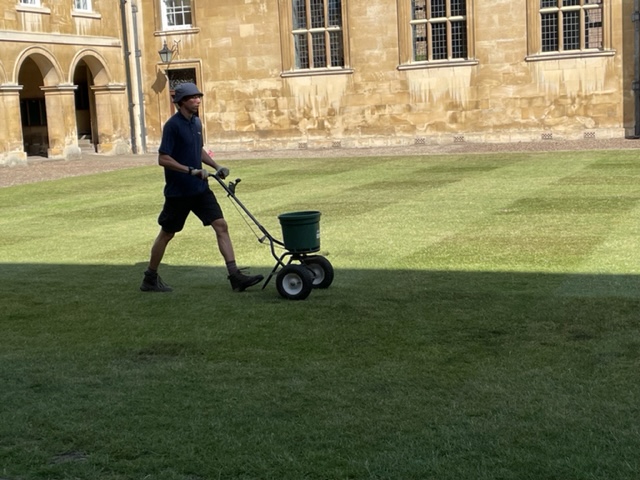
Above Left; Repairs to Front Court Lawn; Above Right; Front Court Lawn after the repairs
Now that student season is beyond us, we turn our attention to keeping the grounds tip top for summer school and wedding seasons, working closely with the conference management team. This month has seen the traditional clipping of the geometric box hedges in New Court. This is a task we take our time over to perfect. The job is done by hand with shears and string lines. A task that takes around three days to complete.
The box hedges in general across the UK are under attack from box moth caterpillar and box blight. They are general a dying species of plant. I fear that in twenty years there will be no box plants in the UK anymore. To help prolong the hedge life and vigor, we do all we can. We clip the hedges using super sharpened shears, dip the shears regularly in biological cleaner to help with sterilization, clear all the debris and dispose of them with care, foliar feed with organic liquid feed, and finally spray with organic insecticide. All in all, extremely hard work but actually, horticultural practice at its finest. Elsewhere on site, we have lost some box plants, along with most gardens in the UK.
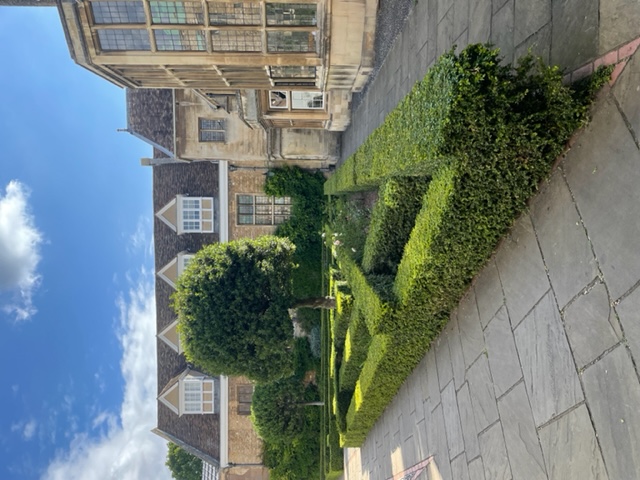
Above: Box Hedges in New Court
The garden department also continue our biodiversity drive working closely with the Emma Green Ducks Society. Together we have installed a bug hotel using recycled equipment. The garden department also continue with a composting regime and wormery that has seen us re-use garden waste and start being used as our organic compost for our greenhouse, reducing buying in and saving plastics, and saving the environment by committing to peat free products.
Best wishes
Brendon Sims (Head Gardener)
14 July 2022
.JPG)
The chapel cloisters at Emma contain many eighteenth and nineteenth century monumental inscriptions, most of them commemorating Masters and Fellows. There are also several memorials to undergraduates, but this may not be immediately apparent, as they are invariably written in Latin (occasionally embellished with Greek) and often record only the date of death, and not the age, of the deceased. The death of an undergraduate was not the shockingly rare event, two or three hundred years ago, that it is today. The burial records of the parish of St Andrew the Great, in which the college lies, record the names of 42 Emma students who died in the period 1600-1800, but the true figure was much higher. For one thing, the burial registers do not always note collegiate membership, and for another, the bodies of many students were conveyed home for burial. Of the remainder, most were laid to rest in the parish church or its graveyard, but a handful were buried in the college.
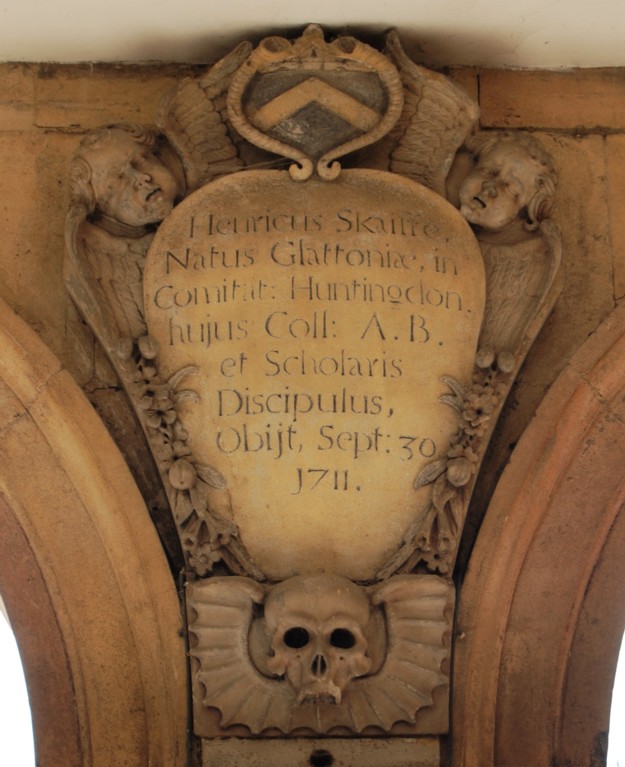
Above; Henry Skaiffe’s monument
The young men interred in Emma’s cloisters are: Henry Skaiffe, Scholar (d.1711, shortly after taking his BA), Anthony Askew (d.1747, in his third year) and James Dusautoy (d.1815, in his second year). There are also monumental inscriptions commemorating Francis Oldershaw and James Mead, two graduates who died in their mid-twenties. The most striking of the student memorials is undoubtedly Henry Skaiffe’s. Its laconic wording contains none of the hyperbole so often present in lapidary inscriptions, but the encircling carving is enjoyably ghoulish. It includes an armorial, two grief-stricken cherubs and a particularly macabre rendering of the skull-and-batwings emblem occasionally found on tombstones of the period. Equally intriguing, to the curious-minded, is the fact that just across the cloister, the stonework between two of the arches bears unmistakable marks of having once supported a plaque of similar dimensions to Skaiffe’s. There are no photographs of this lost memorial, and as the identity of the man it commemorated passed from memory many years ago, its ghostly outline seemed doomed to remain an enigma.
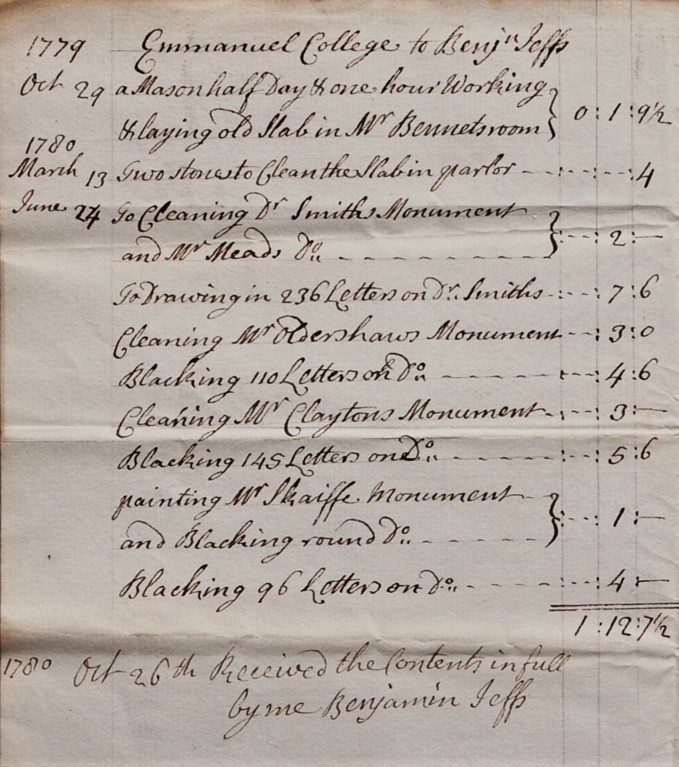
Above; Stonemason’s bill, 1779-80
A recent discovery in the college archives, however, has established that the monument almost certainly commemorated a student who died in the early 1730s. A stonemason’s bill of 1779-80, itemising work carried out on the cloister memorials, includes a charge for the blacking of 145 letters on ‘Mr Claytons Monument’. Since all the other memorials listed on the bill are still in place, it follows that this one must be the missing plaque. The man in question was Humphrey Clayton, who was admitted as a pensioner in June 1730 and matriculated the following year. According to historical notes compiled in the 1770s and 1780s by William Bennet, an Emma Fellow, Humphrey came from Norfolk and was a scholar at the time of his death, which occurred in college. The parish register of St Andrew the Great records Humphrey Clayton’s interment on 3 January 1732.
It seems likely that Humphrey was the son of the Revd Humphrey Clayton, rector of Kenninghall and vicar of Bressingham, Norfolk, who was also an Emma man. He graduated BA in 1703 and later gave £10 towards the rebuilding of the Founder’s Range in Front Court. We will never know what poor young Humphrey’s monument looked like, or be able to read his epitaph, but we can at least now add his name to the select roll of Emma students who lie beneath the flagstones of our chapel cloister.
[Since writing this article, additional information has been found in Charles Henry Cooper’s Memorials of Cambridge (1861). Writing of the monumental inscriptions in Emmanuel’s chapel cloister, Cooper notes: ‘There was also a tablet in memory of Humphrey Clayton, student, son of Humphrey Clayton of Brisingham, Norfolk, clerk, 1731, aet.19. This fell down a few years since, and was thereby broken into so many fragments that it could not be replaced’. ]
Amanda Goode, College Archivist
30 June 2022
It has certainly been a busy time in the lodge this last couple of weeks. Quiet period ended with exams finishing and various students wandering into the college covered in champagne and flour in some cases! Many undergrad students have now left the college for the summer recess, and we all wish them well, in whatever they decide to occupy themselves with over the summer.
The College has survived the May ball (literally in my case) as can be seen on the survivors photo this year. I must say having not had a summer ball since the pandemic this was a real sign that the college is getting back to normal. The May ball committee have done a wonderful job especially regarding the fact that they had no previous experience to draw on. All went well, ably assisted by the college Fire Officer, who deserves a special mention for his patience and advice that made sure the May ball was a great success.

Above:Dave Cook: Fire and H&S Officer
This week we are gearing up for the Graduation taking place on Friday. This year it is especially poignant, as it will be the last Graduation, for our much loved and respected Deputy Head Porter Paul Bass. He has been a main stay in the lodge for so many years and will be sorely missed when he retires at the end of the year. It is no word of a lie to say it has been an honour and a privilege to have worked with Paul over the last thirteen years.




Above: Paul Bass, Deputy Head Porter
But as ever in the Lodge, there is no rest for the wicked, as after the graduation ceremony on Friday the college is literally straight into the summer conference season. We are all looking forward to seeing old friends, with the likes of Richmond Law and Tennessee University, coming back to stay at the college.
Love The Plodge
30 June 2022
William Sancroft (1617-1693) was only quite briefly Master of Emmanuel, but he has left a remarkable legacy in the College. And as one among our Masters who found himself a player at a key turning point in British history, it is fitting that the College now has a number of portraits of Sancroft, although several of these have come by gifts and bequests in modern times.
Sancroft’s life spanned the turbulent years of the English Civil War, the reigns of Charles II, James II, and the accession of William and Mary. From a Suffolk family, Sancroft was admitted to Emmanuel in 1633 and elected a Fellow in 1642. As an ardent royalist, Sancroft spent the years 1657-1660 in self-imposed exile abroad in the Netherlands and Italy. The College’s portraits of a youthful Sancroft and his sister Alice probably date from 1650.
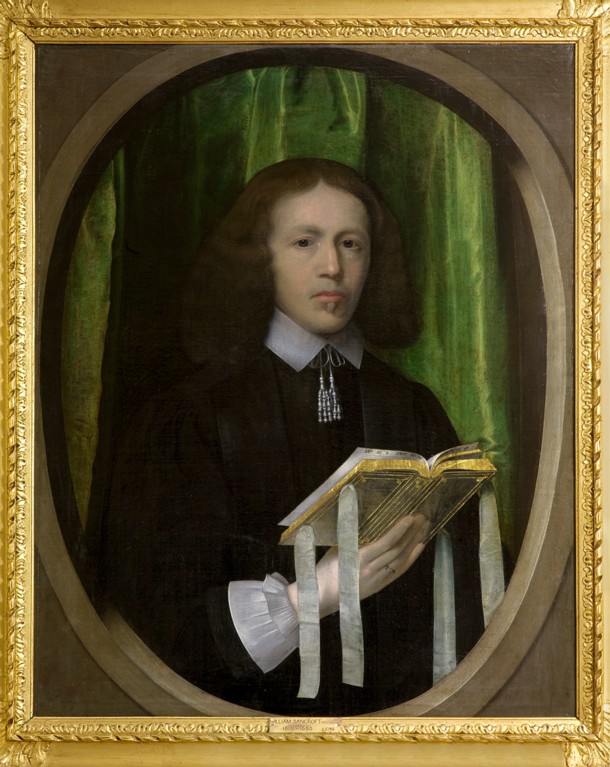
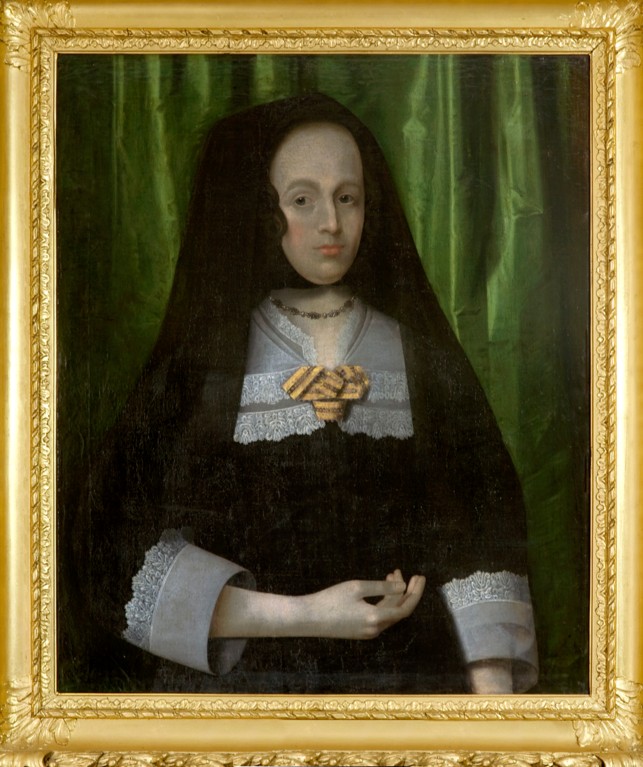
Above Left and Right; William Sancroft and Alice Sancroft, attributed to Bernard Lens. They wear mourning, possibly for their father and/or for the martyred Charles I. Sancroft wears a mourning ring and holds a Hebrew text open at Psalms 20 and 21: ‘The Lord hear thee in the day of trouble’ and ‘The King shall rejoice in thy strength’. Formerly at Gawdy Hall, Suffolk. Presented in 1957 by Mrs Mary Keith, a collateral descendant of Sancroft.
On the accession of Charles II Sancroft returned to England. Enjoying the King’s favour, Sancroft was successively Master of Emmanuel (1662-64), Dean of St Paul’s (1664-77), and Archbishop of Canterbury (1677-90). At Emmanuel, Sancroft commissioned the building of the chapel by Christopher Wren and set about turning the Puritans’ chapel into a library (now the Old Library). At St Paul’s, he initiated the rebuilding after the Great Fire of London – the College Library has the charred remains of a sixteenth-century book of hours that Sancroft found under the Dean’s stall in the the medieval Old St Paul’s after the Great Fire.
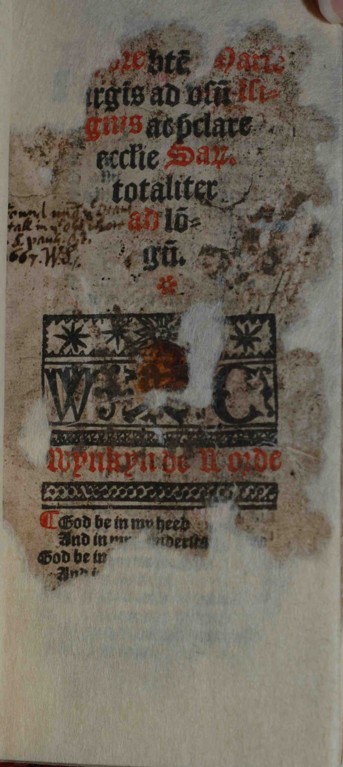
Above; Remains of a mouse-eaten book of hours that was printed by Wynkyn de Worde in 1521 and survived the Great Fire of London.
An enormous posthumous portrait – based on a contemporary sketch – now hangs in the Old Library and reflects the reputation Sancroft would acquire from his reluctant participation in a major constitutional crisis.
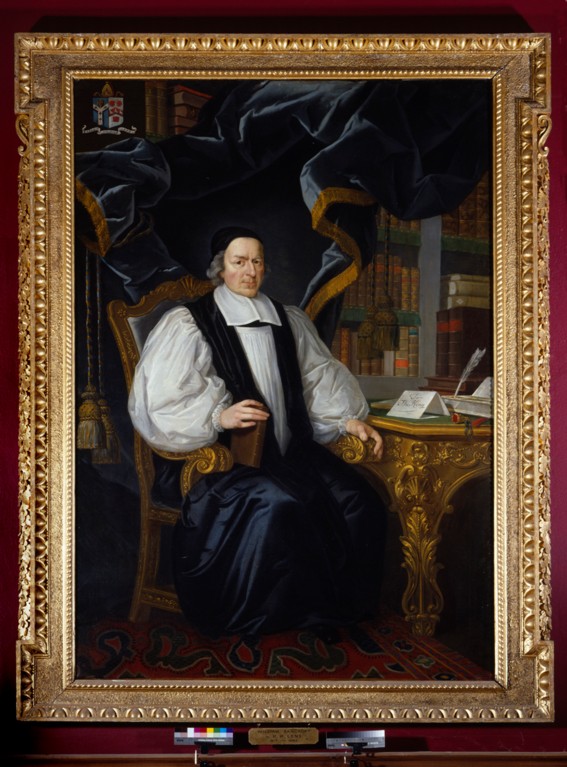
Above; Sancroft as Archbishop; on the table is a paper addressed ‘To the King’ (i.e. his petition against the Declaration of Indulgence’). By Peter Paul Lens, 1754; apparently commissioned by the College.
In 1685 Sancroft visited Charles II on his deathbed, speaking to that Merry Monarch with great freedom, which he said was necessary, since the King was going to be judged by One who was no respecter of persons. Sancroft then duly officiated at the coronation of Charles’ brother, James II, but the new King’s pro-Catholic agenda provoked increasing tensions. In 1688, Sancroft and other bishops petitioned the King against Anglican clergy being required to read out James’ Declaration of Indulgence, which suspended religious and civil restrictions against Roman Catholics and Protestant Dissenters. The point was that, since Parliament had approved these restrictions, the King’s actions were unconstitutional. Sancroft was imprisoned in the Tower of London with six other bishops, brought to trial for seditious libel, and acquitted. The universal rejoicing that greeted the bishops’ acquittal was a potent signal of public repudiation of the King’s policies. The Seven Bishops became popular heroes, and the episode fatally undermined James II’s authority. Medals were struck showing the bishops to commemorate this event, and the College’s group portrait is another example of such memorabilia.
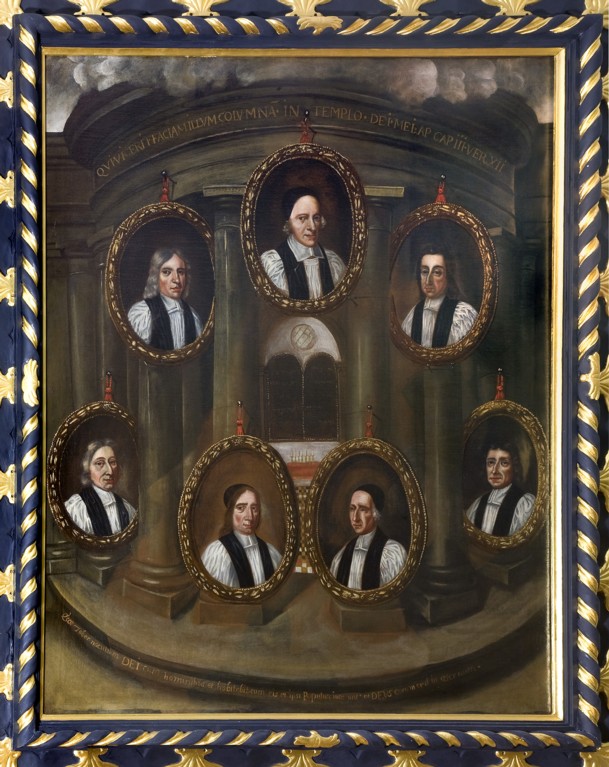
Above; The Seven Bishops in medallions (Sancroft at the top) suspended on the columns of a temple-like structure; the columns are inscribed with the words ‘Columns of Truth’. Behind, an altar with seven candlesticks and tablets with Hebrew inscriptions. Above is inscribed Revelation 21: 3 and below Revelation 3: 12. By an unknown artist.
Bequeathed in 2007 by Mr Bryan Hall, historian of all things Norfolk and Suffolk.
But for Sancroft, the accession of William and Mary in the Glorious Revolution of 1688 brought not relief but further challenges. Having sworn allegiance to James II, and having anointed and crowned him, Sancroft did not believe himself free, in conscience, to transfer his allegiance to James’ daughter Mary and his son-in-law (and nephew) William. Refusing to recognize William and Mary as co-sovereigns, and withdrawing from public life, Sancroft was suspended from office (August 1689), then deprived (February 1690), and eventually expelled with his possessions and books from Lambeth Palace, retiring to his family home at Fressingfield in Suffolk. Here he devoted himself to his books and died praying ‘with great zeal and affection’ for the restoration of James II. The inscription on his tomb in Fressingfield churchyard, composed by himself, expresses absolute resignation to the divine will.
Historians from his own times onward have criticized Sancroft as timorously indecisive and ineffectual at a crucial juncture in English constitutional history. Yet it is hard not to sympathize with his dilemma: William and Mary would guarantee the established religious settlement, but Sancroft could not forsake his sworn loyalty to the legitimate king, even though, if James had not been ousted, Sancroft as chief prelate of the established church would have been on a collision course with the policies of a king who had already shown himself obstinately determined to advance his own agenda.
Shortly before his death, Sancroft gave his library to Emmanuel, rather than to Lambeth as previous seventeenth-century archbishops had done. This chance survival of his personal library – offers a unique opportunity to explore through his books the mind and intellect of a late seventeenth-century scholar, intellectual, and divine. It is twice the size of the library of the diarist Samuel Pepys preserved at Magdalene.
Although theology, church history and liturgical works account for over half the books, there are also classical authors, books on many aspects of history, natural sciences, medicine, mathematics, astronomy, philosophy, law, travel, geography (including some fine atlases), and literature of all kinds, both classical and extensive samplings of French, Italian and Spanish literature, including plays. Included too are recusant devotional works, and printings of scripture in Anglo-Saxon, Irish and Malay. Books from other collections include some books from the library of the poet John Donne. There are sermons and tracts, but there are also books on demonology, magic and exorcism.
At their arrival in Emmanuel in 1693 Sancroft’s books more than doubled the existing holdings of the college library. Initially, Sancroft’s books were classified and shelved separately, but over succeeding years the Sancroft books were absorbed among the college’s other books. It was only in the 1970s that Sancroft’s library was reassembled as an entity, and shelved in its own room in cases that reinstate the earlier shelving of Sancroft’s books. Sancroft’s library is now one of Emmanuel’s great and most distinctive treasures.
Barry Windeatt, Keeper of Rare Books
Helen Carron, College Librarian
16 June 2022
As we officially enter the summer it seems that the weather hasn’t quite got the memo! The end of May, and beginning of June, has seen some heavy rain, much–needed from our very dry early spring warmth. It has resulted in an explosion of growth from the plants in the borders, and genuinely things are looking good around the college grounds, after a slow start to get growing.
It is a tricky period for the gardeners, as we try to juggle the upkeep of the grounds to the highest standard possible, whilst not being able to make much noise due to the exam periods that require quiet throughout the day.
.jpg)
Above: Window Box in Front Court
As a department we are trying our best, and as technology allows, and as we replace our machines, we are buying battery–operated alternatives that are much, much quieter to use. This week has even seen us take delivery of an all–electric lawn tractor.
.jpg)
Above: Theo driving the new tractor
At Emmanuel we care very much about the environment, and made a pledge to use much cleaner energy than the old noisy petrol alternatives. This is a sign that we are putting the welfare and health of our students and staff as a priority as we enter this stage of the 2020s. The next aim is to get the gardens looking as good as possible for the impending May Ball. An event that I am still yet to see, as it has been cancelled in recent years. With many garden parties and garden tours to organize, it really makes you appreciate how important the Emmanuel green spaces are to the College. We are busy maintaining the windowboxes, the new Social Hub & café—Fiona’s—indoor plants, encouraging the flower meadows and maintaining our fine lawns. We are still working with the students' Green Ducks Society to work with encouraging wildlife, and also looking to the future as I meet with Architects and Landscape Architects for the new build and its new spaces.
.jpg)
.jpg)
(L): Oriental Plane Tree & (R) Jester—Credit: Jon Shipp (Porter)
Occasionally, the gardens get the recognition they deserve. The gardens were nominated to take part in an official RHS event as an 'unforgettable garden'. In the 1920’s, two American students travelled the length and breadth of the UK, visiting some of the country’s best gardens. Emmanuel College was one of those visited and recorded. The RHS exhibition tracks the journey of these two cyclists, and looks into the history and present day of the same gardens. Emmanuel’s gardens were nominated by the Cambridge Gardens Trust, and as a result, we were invited to take part in the exhibition. The online exhibition is taking place from Wednesday 8 June from the RHS Lindley Library. It will be covered in the official RHS magazine,s and also from local and national press. This is an enormous coup for the College and the garden department, and will be seen worldwide. I continue to be extremely proud of my gardening staff, and it is nice they will get some recognition as Emmanuel’s unforgettable garden.
Brendon Sims (Head Gardener)
16 June 2022
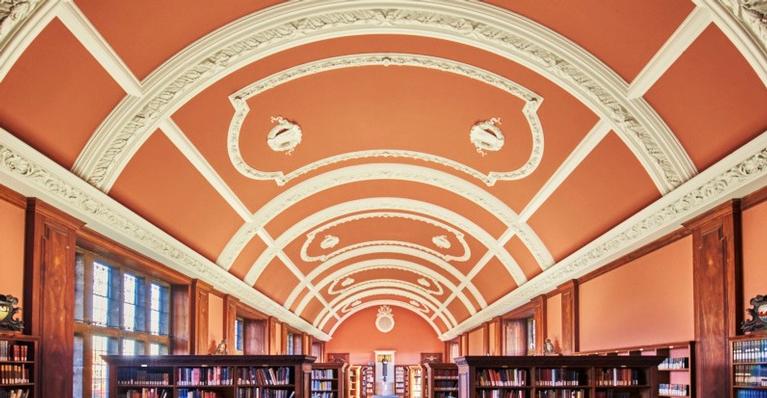
The lofty barrel-vaulted ceiling of the Library’s main reading room, now known as the Fane Room, is divided into five segments: three dating from the original building of 1909, the other two from the 1930 extension. Each section contains a pair of ornate plaster initials enclosed within a cartouche, commemorating distinguished Emma worthies.
They are arranged on the ceiling thus:
Fane Room: Entrance
WL (1909) JW
EC JH
WT FH
---------------------------
TY (1930) JM
WG RD
Some years ago, the late Dr Frank Stubbings, College Fellow and Librarian, in the absence (as he thought) of any surviving documentation, offered the following educated guesses as to the identity of the men in question.
WL: William Law, theologian (1686-1761) JW: John Wallis, mathematician (1616-1703)
EC: Edmund Castell, oriental linguist (1606-1685) JH: Jeremiah Horrox, astronomer (1618-41)
WT: William Temple, man of letters (1628-1699) FH: Fenton Hort, biblical scholar (1828-1892)
………………………………………………………..
TY: Thomas Young, scientist/polymath (1773-1829) JM: John Martyn, botanist (1699-1768)
WG: William Gell, classical historian (1777-1836) RD: Richard Dawes, linguist (1709-1766)
In fact, there is some relevant paperwork in the college archives, but although it largely confirms Dr Stubbings’ identifications, at least in respect of the original segments, it also contains one perplexing anomaly. In June 1909, as building work on the Library neared completion, the Bursar wrote to the architect, Leonard Stokes, as follows: ‘As to something for the ceiling I think monograms of the names of former members of the College whose intellectual interests have given them a name would be suitable…How many would you require?
The answer being ‘six’, the Bursar then submitted various combinations to the Master, who replied: ‘Your names really form two groups: Sir William Temple, Law and Hall are names of considerable importance in English literature; Castell, Dawes and Joshua Barnes are scholars who did something remarkable all of them in their day…Since the decay of Puritanism I suppose Sterry has had no public…and John Smith would I think have more claim; in spite of his contemporary reputation Parr I am afraid was more a blatant political pamphleteer than a scholar…Temple was no scholar though he was the cause of forwarding scholarship in others…’.
Eventually they compromised on a final sextet, which the Bursar passed to Stokes on 14 July, with instructions about the placement: ‘The three representing Science should be on one side and the three representing Literature on the other’. The ‘Science’ men were John Wallis, Jeremiah Horrox and Thomas Young; the ‘Literature’ trio were William Temple, Edmund Castell and William Law. There is, however, a glaring discrepancy between this selection and what we see today: the siting of Thomas Young’s monogram. It is certainly present on the ceiling, but in the 1930 section, and on the ‘Literature’ side, to boot.
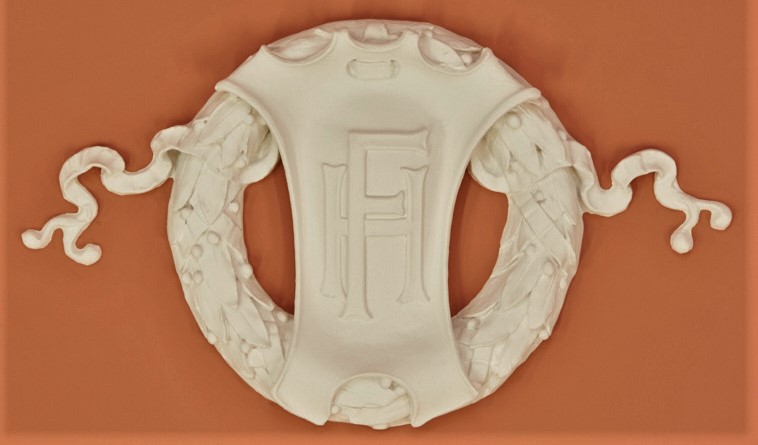
The ‘FH’ monogram (copyright Sara Rawlinson)
The space originally designated for Young contains the initials ‘FH’, for Fenton Hort. Dr Stubbings thought the choice of Hort ‘especially fitting because the lecture-room ceiling in a small way echoed his own scheme for the Chapel’ (Hort had selected the college men commemorated in the chapel windows and on painted wall panels, later covered over). Given the evidence of the 1909 paperwork, though, the presence of ‘FH’ on the original ceiling represents an inexplicable last-minute substitution. As a theologian, Hort’s inclusion among the ‘Science’ worthies upsets the balance of the monograms, and furthermore, he had only died in 1892, far more recently than any of the other men chosen in 1909.
A possible explanation is that Young’s monogram was originally placed as intended, but removed for its own safety when the ceiling was extended, and not put back in the correct position. If the plaques ever need to be taken down for conservation, there would be an opportunity to relocate ‘TY’ among his scientific peers - although Thomas Young himself would probably not concede that he had any peers!
Amanda Goode, College Archivist
1 June 2022
In this Platinum Jubilee year, it is interesting to look back at the two visits made by HM Queen Elizabeth II to our College. On both occasions, she was accompanied by HRH The Duke of Edinburgh, who was Chancellor of the University of Cambridge between 1976 and 2011.
.jpg)
The Royal Party passing through Front Court in 1984
The Queen and Prince Philip first came to Emma on 16 May 1984, their visit being the grandest of the various jamborees put on in 1983–84, to celebrate the quatercentenary of the College’s founding by Sir Walter Mildmay. The itinerary opened with a tour of the Gallery, followed by lunch in Hall, where only the Fellows and Scholars could be accommodated—the rest of the students were billeted on other colleges. The light but appetising menu comprised melon, sole, and champagne sorbet. Afterwards, the party visited the Chapel and the Library, where some of the treasures from the books, manuscripts and archive collections were on display. While there, the Queen and the Duke signed a large formal photograph of themselves. Everyone then moved to a marquee, where students and staff had an opportunity to meet the royal couple.
The visit concluded in the Fellows’ Garden, where the Queen planted an English Oak not far from the wicket gate. Prince Philip planted a Smoke Tree nearby. The Master, Derek Brewer, reported in the annual College Magazine that the royal visit had been ‘marked by its gracious informality and the warmth of feeling it aroused’. Well, informal up to a point, perhaps, but the visit had involved weeks of meticulous planning. It is not surprising that the commemorative photo album shows a certain amount of strain visible, at times, on the faces of those responsible for the day’s smooth running. The Queen’s Private Secretary congratulated the College on the ‘excellent’ day, which the entire royal party had enjoyed ‘enormously’.
When the Queen and the Duke returned to Emmanuel on the afternoon of 19 April 1995, the atmosphere was perceptibly more relaxed. This was due largely to the fact that the Master—Lord St John of Fawsley—was at ease with royalty, and relished being Master of Ceremonies. Some months earlier, the sovereign had accepted the Master’s invitation to open the innovative and prestigious building that was being erected near the Master’s Lodge, concurrently agreeing that it could be named ‘the Queen’s Building’. This exciting news had to be kept secret for a time, even from the College’s Governing Body, and in the face of mounting speculation.
.jpg) On arrival at Emma, the royal party proceeded to the Queen’s Building, where the opening ceremony took place. A tour of the Fellows’ Garden followed, allowing the Queen and Prince Philip to inspect the growth put on by the trees they had planted in 1984. This was followed by a short concert in the Chapel, after which everyone had a chance to meet the royal couple. The visit ended in the Parlour, where the Queen signed the visitors’ book and the inevitable formal photo. The Master then presented Her Majesty with a silver salver, designed to hold Post–Its, with a starter pack of notes!
On arrival at Emma, the royal party proceeded to the Queen’s Building, where the opening ceremony took place. A tour of the Fellows’ Garden followed, allowing the Queen and Prince Philip to inspect the growth put on by the trees they had planted in 1984. This was followed by a short concert in the Chapel, after which everyone had a chance to meet the royal couple. The visit ended in the Parlour, where the Queen signed the visitors’ book and the inevitable formal photo. The Master then presented Her Majesty with a silver salver, designed to hold Post–Its, with a starter pack of notes!
(Above: Lord St John with the Queen & Prince Philip, 1995)
The speech given by the Queen on this visit concluded with these words: ‘In founding this College, Sir Walter claimed to Queen Elizabeth that he was planting an oak tree. In 1984, on the 400th anniversary of the College, I actually did plant a real oak tree in the Fellows’ Garden. Today, I am unveiling the two plaques to mark the occasion of the opening of this fine new building. In doing so, I feel that I have planted an acorn from Sir Walter’s tree.’
The Queen’s ‘real’ oak has already grown to a most impressive height. May it long continue to flourish, as a memorial of our sovereign’s visits, and a representation of the Founder’s vision.
Amanda Goode, College Archivist
1 June 2022
As I write this, the College is well into the annual quiet period. Students are busy revising for exams, the gardeners are rushing around, turning our landscape into a wonderful picture–postcard, and, of course, the swimming pool is finally open this year post–pandemic!
.jpg) The Plodge at this time of year is as busy as ever, and the Porters, along with their daily duties, have also been on standby, should the need arise to support our students over this very stressful exam period. As a matter of course, all College Porters are trained as mental health First Aiders, and are fully trained to react when needed, concerning any student that experiences a mental health crisis. This is an area that I am fully committed to, as I believe mental health in the student population is vitally important.
The Plodge at this time of year is as busy as ever, and the Porters, along with their daily duties, have also been on standby, should the need arise to support our students over this very stressful exam period. As a matter of course, all College Porters are trained as mental health First Aiders, and are fully trained to react when needed, concerning any student that experiences a mental health crisis. This is an area that I am fully committed to, as I believe mental health in the student population is vitally important.
I am, at present, the Head Porters' Association lead within the University focus group looking into student out–of–hours’ support, regarding crisis management. The University has granted three years funding for this initiative, so it is vital that the group come up with a working and successful plan.
Above: Gate Porter Josh (L) and Head Porter Monty (R), in their ceremonial dress.jpg)
In other news, the College has recently held a memorial service for former Master Professor John Ffowcs Williams, in the Chapel. As part of our wider duties, Porters are, at times, ask to provide ceremonial support for the College. I'd also like to welcome Sam Hines (L) into the Lodge family, who started recently as a new Gate Porter.
.jpg) We are also seeing the May Ball Committee feverishly buzzing around, sorting various issues out regarding the upcoming event in June (don’t run out of drink!). This, again, is something that we are very much looking forward to—it has been too long since the College had a proper full–on May Ball!
We are also seeing the May Ball Committee feverishly buzzing around, sorting various issues out regarding the upcoming event in June (don’t run out of drink!). This, again, is something that we are very much looking forward to—it has been too long since the College had a proper full–on May Ball!
1 June 2022
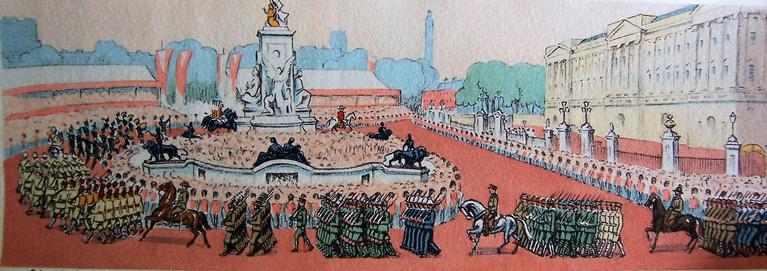
On the eve of the Queen’s extraordinary Platinum Jubilee, two curious items in Emmanuel’s collection of illustrated books come into their own as memorabilia of earlier landmark royal occasions during the Queen’s childhood.
These are two ‘panoramas’ issued to commemorate the Silver Jubilee of King George V and Queen Mary in 1935 and the Coronation of King George VI and Queen Elizabeth in 1937. Both stored in their own bespoke drum containers, the Jubilee panorama unrolls to a length of around 3.5 metres (11.5 feet), and the Coronation panorama is much longer at nearly 5.5 metres (18 feet).
.jpg)
.jpg)
To see them unrolled on a table in the Graham Watson Room gives an idea of their size, as also of how narrow is the illustrated strip at around 11.5 cms (4.5 ins). Printed in collotype and stencil, and then hand-coloured after drawings by Mary McNeile, they were issued in limited editions of 100 for the Jubilee and 125 for the Coronation (with 25 and 30 copies respectively reserved for sale in the USA).
Spoiled as we now are for access to both images and moving images, it is easy to undervalue the attraction of these panoramas in their time as mementoes of one of the characterizing features of these national celebrations: the procession. Queen Victoria’s Diamond Jubilee in 1897 had included a vast six-mile procession from Buckingham Palace to St Paul’s and set a precedent.
The narrow strip proportions of both panoramas are designed to highlight the carriage processions through the streets of London past familiar landmarks. The panorama of the 1935 Jubilee – the first silver jubilee to be celebrated – includes illustrations showing Princess Elizabeth, then nine years old, with her parents, the Duke and Duchess of York, passing Carlton House Terrace on the Mall.
.jpg)
.jpg)
Ahead of them in the procession are King George V and Queen Mary, shown passing Marlborough House, further along the Mall.
As its much greater length suggests, the Coronation panorama of two years later is more ambitious and full of detail. The Jubilee panorama shows the procession headed by the Life Guards marching round the still relatively new Victoria Memorial of 1911.
.jpg)
.jpg)
The Coronation panorama of the same scene has captions detailing the contingents of troops from Burma, Southern Rhodesia, Newfoundland, South Africa, New Zealand and Australia circling the Victoria Memorial, watched by vast crowds. The newly crowned King and Queen are shown passing Westminster Hall in the Gold State Coach.
.jpg)
.jpg)
Carriages carrying members of the Royal Family are shown passing Nelson’s Column in Trafalgar Square.
A procession of ‘Prime Ministers and Empire Representatives’ is depicted about to pass Fortnum and Mason in Piccadilly.
.jpg)
.jpg)
Troops of the Indian Army and the Band and Pipes of the First Highland Light Infantry are shown passing through the Wellington Arch and past Apsley House on Hyde Park Corner.
Another memento of a new reign is Edward Bawden’s The Queen’s Beasts (1953) in Emmanuel’s Chapman Collection of twentieth-century private press books. Very evocative of 1950s design, this book records in striking linocuts the ten six-foot-high heraldic animals – including dragon, unicorn and griffin – that were created out of plaster to stand sentinel at the entrance of Westminster Abbey at the Coronation of 1953. They were inspired by Henry VIII’s King’s Beasts that still stand at the entrance to Hampton Court Palace, but the heraldry was completely recast to represent the lineage of Elizabeth II. The actual Beasts at the Abbey were left as white plaster apart from the brilliantly coloured heraldic shields and badges that they held, but Bawden and his collaborator Cecil Keeling have depicted the beasts in bold colouring as rich as the shields they bear. These included the Lion of England and the Griffin of Edward III, bearing a badge with the Round Tower of Windsor Castle, adopted as the badge of the House of Windsor in 1938.
.jpg)
.jpg)
Also there was the Red Dragon of Wales, adopted by Henry VII as a Tudor emblem, together with the White Horse of Hanover.
.jpg)
.jpg)
The Queen’s Beasts greeted the young Queen as she arrived to be crowned, near the beginning of those seventy years of dedicated service that are being honoured and celebrated this year and this week.
God Save The Queen!
Barry Windeatt (Keeper of Rare Books)
Images by Helen Carron (College Librarian)
18 May 2022
The Emma Catering department consists of thirteen Chefs, five Front of House supervisors, six Kitchen Porters as well as a variety of other staff who work together to make the department run.
.jpg) To get an insight into the department which is at the heart of the College, we spoke to Matt Carter (Executive Head Chef & Head of Catering) and Nathan Aldous (Head Chef) about how the department copes with the inconsistencies of switching from cafeteria meals, to feeding the Royal Family in the Master’s Lodge. We also get to know the department a bit better, by finding out about some of their favourite meals (Above L: Dishes ready for service)
To get an insight into the department which is at the heart of the College, we spoke to Matt Carter (Executive Head Chef & Head of Catering) and Nathan Aldous (Head Chef) about how the department copes with the inconsistencies of switching from cafeteria meals, to feeding the Royal Family in the Master’s Lodge. We also get to know the department a bit better, by finding out about some of their favourite meals (Above L: Dishes ready for service)
What is the process like to create and plan menu ideas?
Planning the menu starts very pragmatically: we’re focused on what the occasion is, the numbers, and the equipment available. Our next priority is seasonality, concentrating on seasonal and local ingredients, so Christmas puddings in December rather than Eton Mess. Following seasonal changes in ingredients allows our dishes to have the best quality, so at the moment we are focusing on foods like lamb, wild garlic, and asparagus, as these foods are at their prime during from April–June. We also look at ookery styles, and try and follow the national trends of cuisines, to ensure authenticity in the meals we serve. Finally, flavour pairings equally play a role when planning new menus. These new dishes are often piloted on Informal Guest Nights, so anyone attending the next dinner can look forward to being guinea pigs!
Why does your department have some of the longest serving members of staff?
The three longest serving members in the department; Mandy Shepard and Lynn Flack (both Front of House Assistants) and Ted Rawlinson, our Silver Assistant, have totalled over 90 years working at the College. The amount of staff that choose to stay at Emmanuel for decades of their careers is all down to having a positive working environment. The chefs are given the flexibility to develop skills that, in a traditional restaurant setting, wouldn’t be possible. If they want to learn the techniques of chocolate making, then Nathan is happy to teach them, or if the chefs wanted to refresh their butchery skills then we can get in a whole pig, break it down, then use the cuts for meals that week. Equally, in the Front of House team, there are opportunities for advancement from a casual level, all the way up to the Butler. The chance for career development, whilst remaining a part of the Emmanuel team, means that people choose to stay with us for years to come.
.jpg)
Above: College Head Chef Nathan Aldous (C) & a selection of his handmade chocolates
What’s the busiest time of year for the department?
The busiest term is definitely Michaelmas, as there are a whole host of welcoming events like Fresher’s dinners and Matriculation. We’re also swarmed with Clubs and Societies, as well as Tutors wanting to welcome their new students with tea, coffee, and dinners, which is followed by a College Calendar event every week, until we reach Christmas Formal Halls. But our busiest day by far is Degree Day, where the team can be serving up to a thousand students and their families! Despite the enormity of the day, the department know what to expect, and has proceedings down to a fine–tuned machine, with the need to have a fast–paced meal, so the students can return to their graduation celebrations, and helping the day run as smoothly as possible.
Below R: Ted, Karoly, Alex & Mandy from our Front of House Team
.jpg) Meet the Team
Meet the Team
What is the best meal you have ever eaten or your favourite food?
- "The best meal I have ever eaten was from Midsummer House, Cambridge everything from the service to each individual course was amazing"—Matt (Executive Head Chef & Head of Catering)
- "My favourite meals are something I haven’t had to make!"—Nathan (Head Chef)
- "Steak, with lots of chips and loads of peppery sauce"—Karen (Pastry Chef)
- "Pesto salmon from our kitchens"—Karoly (Front of House Supervisor)
- "Ugly Duckling, which is duck with uglyfruit (a combination of orange and grapefruit)"—Andrew (Front of House Supervisor)
If you could go to any restaurant in the world where would you go?
- "Tour D’ Argent, to eat the duck which is slowly pressed between two metal plates"—Alex (Fellows' Butler)
- "The Ivy Asia at St Paul’s"—Lizzie (Waitress)
- "Per Se, New York, or The French Laundry (both by Thomas Keller)"—Nathan (Head Chef)
- "Either Noma in Copenhagen, or The French Laundry, California"—Matt (Executive Head Chef & Head of Catering)
What is your favourite restaurant?
- "Le Bistro de la Place in Tremolat always consistently great!"—Jane (Catering Department Administrator)
- "The Fat Duck by Heston, or Fancett’s Bistro in Cambridge"— Damien (Sous Chef)
Lizzie Carter
17 May 2022
As the season progresses into May, there has still not been much sign of rain. This seems to be the normal pattern now for the early and mid–spring weather. We have persisted with the Paddock repair which is still going well, with the gardeners able to give it a light cut. It could do with a week or so with some rainfall!
.jpg) This month we have been busily preparing the windowboxes to return to Front Court, having taken cuttings from last year, and growing them on in our glasshouse. This is a way we can work sustainably, without the need to purchase many plants and reduce the carbon footprint from the air miles.
This month we have been busily preparing the windowboxes to return to Front Court, having taken cuttings from last year, and growing them on in our glasshouse. This is a way we can work sustainably, without the need to purchase many plants and reduce the carbon footprint from the air miles.
We have been trialing a new peat–free compost this year, to commit to our department's reduction in peat compost to preserve the peat bogs. Peat bogs store carbon, so it’s an important environmental factor to reduce our peat use within College.
The greenhouse has been full, but now is the time to plant out the plants grown in the greenhouse. It is great to have the facilities to grow our own plants, which will be planted across the College. Summer bedding will be planted in Front Court, to fit in with the windowboxes and New Court, along with Front Slips, which will benefit from some additional planting.
.jpg) The new Social Hub—Fiona's—is now open, and the garden department supplied some plants from the greenhouse, along with some additional plants to be purchased for the future. This should make the interior feel altogether a calm space to study or meet.
The new Social Hub—Fiona's—is now open, and the garden department supplied some plants from the greenhouse, along with some additional plants to be purchased for the future. This should make the interior feel altogether a calm space to study or meet.
We have been in discussions to use the café's coffee grinds for part of the garden department’s compost programme, using a product that is beneficial to the gardens, whilst being an otherwise wasted product.
The biggest news from the garden department, though, is to congratulate one of the garden team, Jonathan Strauss.
If you had been following his progress, then you will know that Jon reached the Grand Final of the 'Young Horticulturist of the Year' Competition. The Grand Final was held on 7 May at the University of Warwick, and comprised of Jon, plus seven other regional winners. The competition tests the horticultural knowledge through a series of plant idents, directed questions and buzzer rounds.
.jpg)
.jpg)
Jonathan placed third place overall, narrowly missing out on second spot. The eventual winner was Charles Shi, an employee at RHS Kew Gardens. I am very proud of Jonathan, who did extremely well, and represented himself & Emmanuel College with extreme decorum and bravery. The other contestants were from all across the UK, so for Jon to get a podium finish is an incredible achievement. Those eligible from the garden department will have another go at the competition next year, and who knows, maybe a step further next time!
Brendon Sims (Head Gardener)
4 May 2022
Almost every account of Emmanuel’s early history relates the celebrated conversation between our college’s Founder, Sir Walter Mildmay, and Queen Elizabeth I, that supposedly went as follows:
Coming to court after he had founded his Colledge, the Queen told him, Sir Walter, I hear you have erected a Puritan Foundation. No, Madam, saith he, farre be it from me to countenance any thing contrary to your established Lawes, but I have set an Acorn, which when it becomes an Oake, God alone knows what will be the fruit thereof.
The exchange was first recorded in Thomas Fuller’s History of Cambridge University, published in 1655. The most recent history of the college calls the story a ‘pleasant little fiction’, and there are good reasons to regard it as apocryphal. For one thing, it implies that the ethos and perhaps even the existence of Emmanuel had come as a disagreeable surprise to the queen, whereas she had given permission for its establishment. Sir Walter’s religious leanings were no secret, either. Yet the story should not be dismissed out of hand.
Thomas Fuller, a Cambridge graduate, was a prolific and popular author, with a penchant for colourful anecdotes. His sources for the history of Emmanuel are thought to have included several of the college’s senior members, and he may even have met Laurence Chaderton, the first Master, who lived until 1640. He was also familiar with Thomas Ball’s Life of the Renowned Doctor Preston, published 1628, which he thought ‘well written’. John Preston had been appointed Master of Emma in 1622, dying six years later. His biographer, Ball, who was a Fellow of the college, wrote that ‘Sir Walter Mildemay…was wont to say unto his friends that he had set an acorne that might perhaps in tyme become an oake. And, blessed be God, our eyes have seene it not only growne & flourishing, but fruitfull’.
This passage was echoed closely by William Dillingham, Master of Emmanuel during the Protectorate, in his memoir of Chaderton, whom he had known in old age. In this short biography, published posthumously in 1700, Dillingham ends his account of the founding of Emmanuel with the words: ‘Thus was planted that ‘acorn’ by Mildmay (as he used to say himself) which was destined eventually to grow into an oak; by whose shade God’s Church was afterwards refreshed.’ .jpg) Although Dillingham had certainly read Ball’s Life he is unlikely to have repeated the acorn anecdote unless he had also heard it from a more reliable source, as (unlike Fuller) he had a low opinion of Ball, considering him to be a ‘vulgar English writer’ who employed ‘invention or imagination’.
Although Dillingham had certainly read Ball’s Life he is unlikely to have repeated the acorn anecdote unless he had also heard it from a more reliable source, as (unlike Fuller) he had a low opinion of Ball, considering him to be a ‘vulgar English writer’ who employed ‘invention or imagination’.
Confirmation of Sir Walter’s fondness for acorn imagery is afforded by two original copies of the 1585 College Statutes: not their wording, but their binding. Emmanuel’s copy, although later re–covered, retains the original ornate clasps (Above L). It is surely significant that they are engraved, presumably at the Founder’s behest, with tiny acorn motifs. The Founder’s personal copy of the statutes, .jpg) also now held in the college archives, still has its original vellum binding, each corner bearing a gilt–stamped acorn (R).
also now held in the college archives, still has its original vellum binding, each corner bearing a gilt–stamped acorn (R).
That Sir Walter Mildmay did indeed regard, and speak of, his college as a metaphorical acorn, seems beyond doubt. But what of his fabled encounter with Queen Elizabeth? It would have been entirely in keeping with the queen’s character for her to have indulged in a spot of sardonic banter with a senior and—one suspects—rather stuffy courtier. It is equally possible that Thomas Fuller could not resist embellishing the authentic acorn story. All that really matters, though, is that Sir Walter’s ‘oake’ has continued to flourish, scattering some 25,000 acorns of its own in the four and a half centuries since its planting.
Amanda Goode, College Archivist
19 April 2022
April has been and nearly gone in a flash! The weather has been mixed: some sun, some rain and most definitely some more strong winds. On the whole, though, a dry start to the spring. In the garden this month, the gardening team have continued to revive the Paddock to its former glory. It has required watering during the dry spells, but overall is looking quite a bit greener since my last report.
The magnolia looked fabulous by the Jester, but the petals were hit by a succession of frosts, followed by very strong winds, and so its glory was far too short–lived this year. Elsewhere, the blossom has looked amazing. The cherry trees around the Paddock and the Malus ‘Rudolf’ in the Fellows’ Garden has been pretty. The gardeners have been busy dead–heading the daffodils on the Paddock meadows, to ensure things look good this year and provide enough energy for the flowers for next. We were extremely pleased with the daffodil extension around the Medlar tree in the Fellows’ Garden. It worked well for year one.
.jpg)
.jpg) This month’s projects included the planting of three espalier apple trees down at the Boathouse. These were planted and attached to training wires, to help with the formal framework. These should be heavy cropping once established.
This month’s projects included the planting of three espalier apple trees down at the Boathouse. These were planted and attached to training wires, to help with the formal framework. These should be heavy cropping once established.
We also installed a new yew hedge as part of new planting at the Master’s Lodge (L: Jon and Doug planting the hedge). Once established, the neatly clipped hedge should add to the architecture of the house, mirroring its clean and crisp lines. We have also added planting around the Master’s pond, which we reconstructed over the winter. In the recent warmer weather around the bank holiday, bee swarms could be found around the gardens (Above L: Bee swarm in Chapman's Garden). These were dealt with promptly by the local beekeeper.
.jpg) Lastly, we have to talk about some special visitors to the garden. It’s not every day that I am contacted by an RHS gold medal garden designer, TV presenter, model and actress. I had the great pleasure of showing Kate Durr and her family around the gardens, as she was in Cambridge and had heard such wonderful things about the Emmanuel gardens (L: Brendon with Kate). She brought her husband—actor Jason Durr—along for the tour as well. You may know Jason from the theatre, or acting on our television screens in Heartbeat and Casualty. All in all, a pleasant time to be around the garden.
Lastly, we have to talk about some special visitors to the garden. It’s not every day that I am contacted by an RHS gold medal garden designer, TV presenter, model and actress. I had the great pleasure of showing Kate Durr and her family around the gardens, as she was in Cambridge and had heard such wonderful things about the Emmanuel gardens (L: Brendon with Kate). She brought her husband—actor Jason Durr—along for the tour as well. You may know Jason from the theatre, or acting on our television screens in Heartbeat and Casualty. All in all, a pleasant time to be around the garden.
Brendon Sims (Head Gardener)
7 April 2022
On her twenty–first birthday—21 April 1947—Princess Elizabeth was with her parents and younger sister on a tour of South Africa. In a speech broadcast from Cape Town, the Princess dedicated her life to the service of the Commonwealth:“I declare before you all that my whole life whether it be long or short shall be devoted to your service and the service of our great imperial family to which we all belong.”
.jpg)
All too soon afterwards, with the untimely death of King George VI, the young Princess became Queen, and has impeccably delivered on that promise for 70 years. On the seventieth anniversary of The Queen’s accession, in our corner of the Commonwealth, South Australians paid tribute to The Queen’s duty and service at a special Choral Eucharist at St Peter’s Cathedral, Adelaide attended by dignitaries, politicians and other community leaders.
Family Robinson, aka my family, has a special connection here, with the youngest in our family, 11 year–old Joseph (above, with Anthony Hunt), being one of the treble choristers. With my own connections to Cambridge and Emmanuel, and special memories of singing with chapel choirs and the University Chorus, it is wonderful to have the next generation of our family immersed in activities that see the great English sacred choral music tradition preserved.
The St Peter’s Cathedral Choir thrives through the efforts of a dedicated team. Of course, there are the choristers themselves—the adult Lay Clerks and the young trebles, both girls and boys (and the parents who get them to rehearsals and services, there being no cathedral school, meaning that choristers are drawn from the general Adelaide community). We have a highly talented organist David Heah (who also holds down a position a petroleum engineer with a major mining corporate in his ‘spare time’)—his postludes are always eagerly anticipated by the congregation.
Our Director of Music, Anthony Hunt, returned to his hometown Adelaide in 2020 to take up the role, alongside a companion position as Chorus Master for the State Opera of South Australia. Hunt’s musical credentials are impressive. After conservatorium studies in Australia, he studied as a repetiteur on the Royal Academy of Music’s specialist opera course. That saw him serve as Chorus Master for Opera Australia in Sydney for several years, before the postings in Adelaide. His role with the Cathedral Choir is completion of a full circle, as Hunt sang there as a boy treble himself. An Associate of the Royal Academy of Music, Hunt has sympathies for the beautiful Renaissance polyphonic masses and motets, but also ensures that his repertoire choices for the Choir bring in new material that has a good sense of drama and importantly is enjoyable to sing and works the treble’s voices, especially those wonderful top notes. He regularly composes as well—just last week saw the Choir ‘premiere’ his new Communion Service for Trebles.
Under his stewardship, the treble complement is steadily growing, with recruitment through open-access activities such as the annual choir winter school; and once the worst of the COVID–19 restrictions are passed, he has plans to renew the choir’s tradition of touring abroad. The overall ambition, in Hunt’s own words is to simply, “let more kids have the chance enjoy this wonderful and unique experience”.
The other choir ‘pillar’ is Canon Precentor of the Cathedral, Jenny Wilson. In the Robinson household she is known as ‘Cathedral Jenny’, differentiating her from our son’s schoolteacher of the same name! As Precentor, for the past decade, Wilson has played an active role in the music and liturgy of St Peter’s. She has made the role her own, supporting the Friday evening ‘choir suppers’ (a quick meal break for trebles in what is a long 4–hour preparatory rehearsal for the services ahead); and designing a confirmation course especially for trebles, based on the mass setting and evensong canticles and their connection to the confirmation vows, so the young choristers “are infused with, and connect with those special words that they sing every week.”
As ‘Cathedral Jenny’ observes, people engage with cathedral services in different ways—through just sitting quietly within such beautiful and stately architecture, by engaging with the readings, and via the community fellowship. But Wilson knows that many come particularly for the music. As they bring their own joys, sorrows and journeys of life, the music helps them reflect on their story as it interweaves with faith. She observes, “the choir and clergy join together in making a connection with the people who come to the cathedral, and music is the language that they use.”
The musical activities of the Cathedral are supported by the St Peter’s Cathedral Music Foundation, a growing capital fund sustained by philanthropic donations and revenue from annual concert series. The Foundation provides for choral, organ and conducting scholarships for young musicians, contributes to the costs associated with instruments (especially the organ), assists with the purchase of new choral music, and commissions new works for the Choir’s repertoire. As Hunt notes, “the scholarships mean we can nurture a pipeline of future possible cathedral organists, or perhaps open a new door to a professional life in music for a young person.”
Perhaps the final say should be left to young Joseph. When asked for his thoughts on his choral experience, he says, “It is incredibly hard work, but when you get really good fun services with beautiful music, it is all worth it.”
5 April 2022
We have previously followed the fortunes of Emma’s stained glass ‘John of Gaunt’ shield, from its installation in Brancepeth church between 1372 and 1387, to its passing into the hands of Dr Alfred Robinson in 1922.
A Yorkshireman from Leeds, Robinson entered Emmanuel College in 1889. He was a member of the college Musical Society, performing solos at its November Smoking Concerts in 1890 and 1891, singing Balfe’s Killarney in ‘a pretty tenor voice, which sounded well’, and The Lass that loved a Sailor, by Dibdin. After graduating BA in 1892, Robinson completed his medical training at Leeds General Infirmary, becoming a fully–qualified doctor in 1896. For the next few years he was based in Wetherby, according to the Emmanuel College membership lists, but this early part of his career may also have included a stint as a surgeon with the British India Steam Navigation Company. By 1900, Dr Robinson had moved to the coastal town of Redcar, where he is remembered as a physician beloved by his patients, and a man ‘whose interests and public–spirited activities were infectious’. Dr Robinson kept house in Redcar with his widowed sister and his niece, except for a spell during the First World War, when he served as a civil surgeon attached to the Central English Hospital in France, and then in the RAMC, aboard HM Hospital Ship Panama. By 1917, he was back in Redcar as Medical Officer in Charge at the VAD Hospital. An enthusiastic local historian, it was through his good offices that Zetland—the redundant Redcar lifeboat—was preserved and housed in a museum. This vessel was believed to be the world’s oldest surviving rescue boat, and the National Maritime Museum was keen to add it to its collection, but the doctor assured the locals that ‘you can take it from me they won’t get it’.
Alfred Robinson kept in regular touch with Emmanuel, and whenever he returned for a Members’ Gathering his old friends were ‘always glad to see him’. Unbeknown to the College, he had bequeathed it his precious John of Gaunt panel, which he described in his will as ‘the Shield hanging in the window of my room’.
.jpg)
.jpg) The College was to receive the bequest in tragic circumstances, for in the air raid on Redcar that occurred during the evening of 21 October 1941, Dr Robinson was killed. The College believed, at the time, that he had died in his own house, which was badly damaged, but later reports indicate that he perished in the nearby Zetland Club, along with other prominent Redcar citizens (L: Commemorative plaque & Coatham Rd, Redcar Zetland Club memorial garden). During the air raid, the Gaunt shield was ‘blown across the room’ and badly damaged, particularly the section containing the arms of Castile and Leon. The panel was repaired on the orders of the doctor’s executor, but although the conservators did a good job overall, they unaccountably re–inserted the paw of one of the lions upside down!
The College was to receive the bequest in tragic circumstances, for in the air raid on Redcar that occurred during the evening of 21 October 1941, Dr Robinson was killed. The College believed, at the time, that he had died in his own house, which was badly damaged, but later reports indicate that he perished in the nearby Zetland Club, along with other prominent Redcar citizens (L: Commemorative plaque & Coatham Rd, Redcar Zetland Club memorial garden). During the air raid, the Gaunt shield was ‘blown across the room’ and badly damaged, particularly the section containing the arms of Castile and Leon. The panel was repaired on the orders of the doctor’s executor, but although the conservators did a good job overall, they unaccountably re–inserted the paw of one of the lions upside down!
Having evaded certain destruction at the hands of over–enthusiastic church restorers in the mid–nineteenth century, and near–obliteration by the Luftwaffe a century later, the Gaunt glass has enjoyed a tranquil existence at Emmanuel for nearly eighty years, but there is one more twist to its story.
.jpg) Had the shield remained in Brancepeth parish church (R: St Brandon's, Brancepeth, looking towards the Chancel), and escaped the Victorian ‘improvements’, it would still have been destined for annihilation, for it could not have survived the catastrophic fire that engulfed the church in September 1998. At the height of the inferno, all the windows were blown out, and only a few fragments of stained glass were ever recovered. Emma’s jewel–like panel is, then, a remarkable, battle–scarred survivor, rather like the man it represents: the redoubtable John of Gaunt, Duke of Lancaster.
Had the shield remained in Brancepeth parish church (R: St Brandon's, Brancepeth, looking towards the Chancel), and escaped the Victorian ‘improvements’, it would still have been destined for annihilation, for it could not have survived the catastrophic fire that engulfed the church in September 1998. At the height of the inferno, all the windows were blown out, and only a few fragments of stained glass were ever recovered. Emma’s jewel–like panel is, then, a remarkable, battle–scarred survivor, rather like the man it represents: the redoubtable John of Gaunt, Duke of Lancaster.
Amanda Goode, College Archivist
23 March 2022
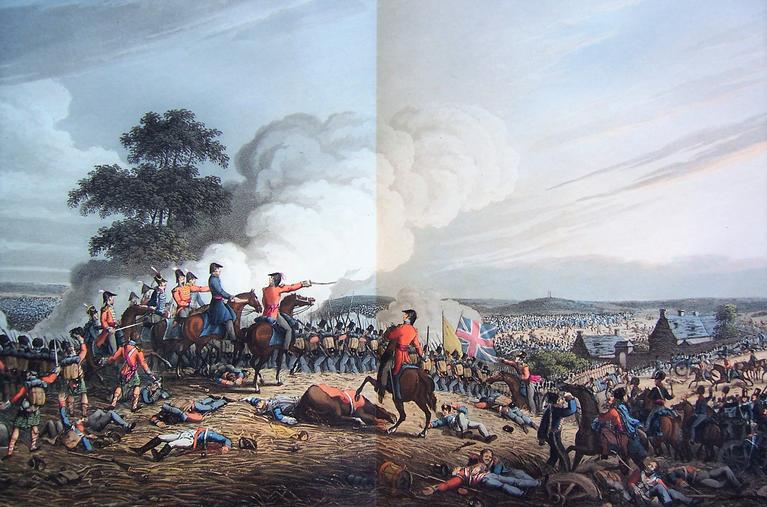
With war in Europe dominating the news, it is topical to look at how Emmanuel’s illustrated book collections depict military themes. Many of the books in the College’s Graham Watson Collection were produced during and after the quarter century of almost continual war that followed the French Revolution, so it is hardly surprising that military subjects are often the focus for illustration. But then, in the 1850s, and exploiting the technique of lithography, a pioneer war artist of genius would bring vivid images of the Crimean War to a wide audience.
Victories of the Duke of Wellington (1819) commemorates each battle with a brief account and an illustration, and reflects the hero-worship of the ‘Iron Duke’ after the Anglo-Prussian defeat of Napoleon at Waterloo. Here are a group of Highlanders centre stage at the Battle of Vimiera (1808) during the Peninsular Wars. Vimiera was a hard-fought battle which, according to the accompanying text, cost the lives of three thousand French and one thousand British troops.
.jpg)
.jpg)
Pl 2: Victories of the Duke of Wellington (1819). ‘The Battle of Vimiera’; Pl 3: Historic, Military and Naval Anecdotes (1818). ‘’Boarding and Taking the American Ship Chesapeake (1813)’;
Historic, Military and Naval Anecdotes (1819) has a similar commemorative function, here recording the boarding and taking in 1813 of the American ship Chesapeake off Boston by HMS Shannon. According to the account it was all over with dispatch in the space of fifteen minutes, but with the loss of seventy American sailors.
Depictions of uniforms evidently had a great fascination to book-collectors at this period, judging by the splendid examples in the College’s collections, and most contemporary books about British costume and customs include examples of regimental uniforms as well.
.jpg)
.jpg)
Pl 4: Richard Cannon, Historical Record of the Eighteenth, or The Royal Irish Regiment of Foot (1848); Pl 5: William Henry Pyne, Microcosm (1806), ‘Army’;
So too William Pyne’s celebrated Microcosm (1806), which includes illustrations of military life alongside its depictions of the nitty gritty of contemporary crafts and trades. Here is a vivid scene of the wagons in a baggage train, characteristically focussing in on the practicalities of logistics. On the left a wagon is seen up close, with the soldiers’ partners and camp-followers, and piled with bedding. The text describes ‘a motley scene’, commenting sniffily on the ‘mixture of meanness and vulgarity in the manners and dresses of the women’. At the far left stands a soldier literally holding the baby. To the right the baggage train winds away into the distance.
Military Discoveries (1819) by Henry Alken, a prolific illustrator of comic books, zooms in on the absurd and ludicrous in contemporary military life. Here the key word is ‘Discoveries’, since each comic plate is explained by a rather lengthy caption that turns on the word ‘DISCOVER’. Here in the first plate is the comedy of anyone caught without their clothes – perhaps especially if they are brandishing swords at the same time (and note the worried female face peering from the tent). The caption reads: ‘Being awoken by a violent noise, and rushing from your quarters, you DISCOVER your Colonel, who commands you immediately to resist a serious and unexpected attack made on the Camp by the Enemy, without waiting for any additional Cloathes’.
.jpg)
.jpg)
Pl 6: Henry Alken, Military Discoveries (1819); Pl 7: Military Discoveries;
The second caption reads: ‘On recovery from a swoon, you DISCOVER it was occasioned by your horse being shot under you, and in the fall broke your Leg; on looking round you see both friend and foe leaving you in the lurch, that your only company are a pack of low-bred things who have actually had the honour to be killed by sword or bullet, while you have happened of nothing more than a commonplace accident’.
William Simpson (1823-1899) was a Scottish artist who recorded the Crimean War. Simpson was in the Crimea for a year, 1854-5, during the siege of Sebastopol, sending back his water-colours to London to be turned into lithographs, later collected in two large volumes of eighty plates, The Seat of War in the East (1855-6).
Here is Sebastopol seen from the deck of HMS Sidon, which was involved in blockading the port.
.jpg)
.jpg)
Pl 8: William Simpson, The Seat of War in the East, ‘Sebastopol from the Sea’; Pl 9: Seat of War, ‘Interior of the Malenkoff in Sebastopol after its Storming’;
Sebastopol was eventually taken, and this plate shows the interior of Fort Malakoff in the city after it was stormed.
Simpson’s illustrations provide a vivid picture of the lives of those manning batteries and fortifications. Here is ‘A Quiet Day in the Diamond Battery’ manned by sailors from HMS Diamond. The sandbags used for such enclosures are carefully depicted.
.jpg)
.jpg)
Pl 10: Seat of War, ‘Quiet Day in the Diamond Battery’; Pl 11: Seat of War, ‘Hot Day in the Batteries’;
By contrast here is ‘A Hot Day in the Batteries’ with men loading and firing the guns. Shells are bursting in all directions and the smoke of answering Russian fire is visible.
Simpson also memorably catches the mens’ lives by night. In ‘A Quiet Night in the Batteries’ some men are shown sleeping, while others chat in the light of a full moon.
.jpg)
.jpg)
Pl 12: Seat of War, ‘Quiet Night in the Batteries’; Pl 13: Seat of War, ‘Hot Night in the Batteries’;
But in ‘A Hot Night in the Batteries’ all is frantic action: guns are shown being fired or prepared for firing, and the night sky is lit up by explosions.
When the Russian forces abandoned the city of Sebastopol they set buildings ablaze, including, as shown here, the Public Library.
.jpg)
.jpg)
Pl 14: Seat of War, ‘Public Library, Sebastopol’; Pl 15: Seat of War: ‘A Ward in the Barrack Hospital at Scutari'
Today the Crimean War is perhaps most remembered because of the landmark achievements of Florence Nightingale in organizing the professionalization of nursing care for the wounded. Here she is shown in a ward of the Barrack Hospital at Scutari, where, as the text notes ‘the rough soldier in his untaught but noble chivalry kissed her shadow on the wall as she passed along’.
Barry Windeatt (Keeper of Rare Books)
Images by Helen Carron (College Librarian)
22 March 2022
After two years of cancelled events, a team of 18 students have been working since the summertime to put on Emmanuel’s annual May Week event. After the challenge of keeping our lips sealed for what seemed like months on end, despite lots of nagging from friends and Porters alike, the time finally came to reveal our theme earlier this term.
.jpg) We dressed up the Old Library in star garlands, feathers and posters tactfully covered with bin bags before showing our launch video that announced the theme for this year’s Ball—Into the Night: Shining a Light on Culture After Dark.
We dressed up the Old Library in star garlands, feathers and posters tactfully covered with bin bags before showing our launch video that announced the theme for this year’s Ball—Into the Night: Shining a Light on Culture After Dark.
With the help of the 20 dedicated members of our decor subcommittee, on the 19 June 2022, the whole College will be transformed into a nocturnal wonderland showcasing some of history’s most iconic night clubs, cafés, and cabarets. Our Ball guests will find themselves transported all over the world from Paris’ Moulin Rouge to Mexico City’s Café de Nadié, the birthplace of the Stridentist art movement. But perhaps most exciting of all, the temporary Bar (read portacabin) fondly known as the 'Master’s Arms' will become an Irish pub for the night. Emma’s very own Cam Millar (2020) has also built a new bridge for the pond on Paddock to continue the tradition of the iconic bridge photo, an Emma May Ball staple.
The existence of Cambridge—wide schemes such as Access—A—Ball and Sustain—A—Ball have been helpful in our work to ensure that this year’s event is as accessible and sustainable as possible, facilitating resource sharing and pitching accessibility & sustainability goals for the Ball. The more of these we complete, such as replacing ruminant meats with more environmentally conscious options, the more we are in with a chance of receiving a gold or even platinum accreditation! This year has also seen the introduction of an extended bursary scheme for both part– and full–time Emmanuel students on a bursary, another exciting step to further accessibility.
.jpg) Now tickets have sold out (in no fewer than a record–breaking four days!) and the Easter vacation is fast approaching, planning is picking up pace. Contracts are being signed from sweet treats to mini golf, site walks are taking place with security & production companies, and student workers are being interviewed. It is certainly shaping up to be a night to remember and we hope some of you will be there to celebrate it with us!
Now tickets have sold out (in no fewer than a record–breaking four days!) and the Easter vacation is fast approaching, planning is picking up pace. Contracts are being signed from sweet treats to mini golf, site walks are taking place with security & production companies, and student workers are being interviewed. It is certainly shaping up to be a night to remember and we hope some of you will be there to celebrate it with us!
Alex Bispham & Philippa Kirby
22 March 2022
As I sit and write this update, the sun is gloriously shining and spring is most definitely here. The spring bulbs are in full bloom, and the herbaceous plants are awakening. The College grounds seem lush and full of life and there is an optimism of what is to come.
It has been an extremely busy time in the garden department: preparing the gardens, and getting things neat and tidy from the winter period. Lawns have been striped, hedges sharpened, edges edged, and seeds sown in the glasshouse.
.png) The major project this month has been the repair and seeding of the Paddock (L). The Paddock had been severely damaged by this winter’s construction work, and the tennis court levels badly affected. Contractors were employed to prepare the vast area, and they expertly worked tirelessly to get the area neat and level once more. It has now been seeded and in the hands of the gods to grow. It shouldn’t take long—if the weather is kind—to be back to grass soon.
The major project this month has been the repair and seeding of the Paddock (L). The Paddock had been severely damaged by this winter’s construction work, and the tennis court levels badly affected. Contractors were employed to prepare the vast area, and they expertly worked tirelessly to get the area neat and level once more. It has now been seeded and in the hands of the gods to grow. It shouldn’t take long—if the weather is kind—to be back to grass soon.
The garden department also has some tremendous news. I encouraged my staff who were eligible to enter the 'Young Horticulturist of the Year' Competition. This is a competition to test the talents of the country’s greatest horticultural minds. Douglas Day and Jonathan Strauss (Below L) both got through to the Eastern Regional Finals held at Somerleyton Hall in Suffolk. This in itself is a huge achievement for the pair, placing them in the top 64 in the country.
.jpg)
.png)
In a final that was packed with extreme talent, Jonathan Strauss went on to win the Eastern region final (Above R). Jonathan now will compete in the Grand Final, held at the University of Warwick on 7 May. The garden department and I are extremely proud of both lads!
.jpg) Finally, the news continues. Last week, Emmanuel had the film crews in. Tony Eva from Cambs Climate is making a documentary film about Hobson’s Conduit. The film crew spent the day in glorious sunshine, interviewing me (R), and filming our wonderful grounds. The film crew were extremely impressed with the beauty that the gardens had to offer. The film is likely to be completed towards the end of the year, and will be released in film festivals and arts cinema releases. There was even talk of Netflix!
Finally, the news continues. Last week, Emmanuel had the film crews in. Tony Eva from Cambs Climate is making a documentary film about Hobson’s Conduit. The film crew spent the day in glorious sunshine, interviewing me (R), and filming our wonderful grounds. The film crew were extremely impressed with the beauty that the gardens had to offer. The film is likely to be completed towards the end of the year, and will be released in film festivals and arts cinema releases. There was even talk of Netflix!
Brendon Sims (Head Gardener)
9 March 2022
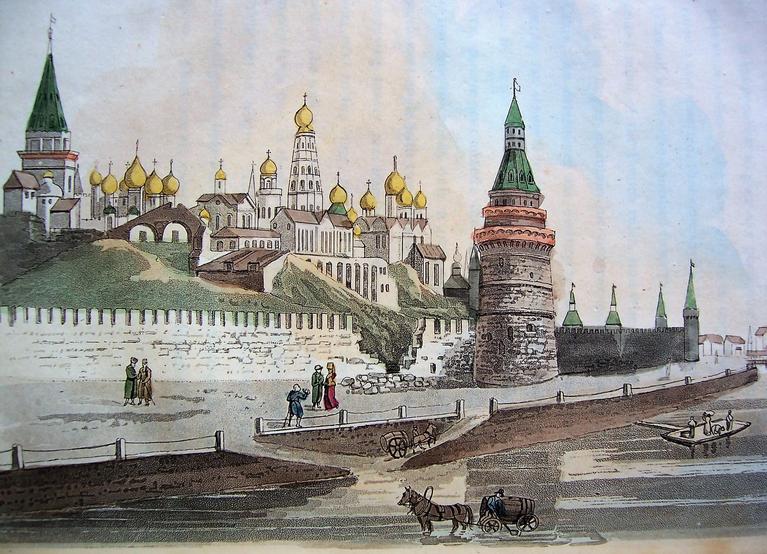
Russia – in its difference, in its vastness – has always been in every century an object of some fascination, and there are far more books about Russia by British authors in Emmanuel’s collection of illustrated books than can be described here. By contrast – since rare books produced in Russia by Russians do not much figure in the College library – it is all the more precious that Emmanuel has possessed since 1749 a copy of the first book on mathematics by a Russian published in Russia, the Arifmetika (Moscow, 1703) by Leontii Magnitskii (1669-1739), who was appointed by Peter the Great to his new School of Mathematics and Navigation in 1701 and ordered to produce a textbook.
.jpg)
.jpg)
Plates 2 and 3: Leontii Magnitskii, Arifmetika (Moscow 1703): Arithmetic enthroned in the Temple of Learning. Addition, Subtraction, Multiplication and Division are inscribed on the steps to the throne;
Emmanuel’s collection includes a whole clutch of early nineteenth-century books illustrating the costumes worn by the Tsar’s racially diverse subjects across his far-flung empire. Not for nothing does the title page of one such book show St Petersburg’s towering bronze equestrian statue of Peter the Great, atop its seventeen-feet-high granite rock.
.jpg)
.jpg)
Plate 4: E. Harding, The Costume of the Russian Empire (1811), Title Page; Plate 5: Harding, The Costume: Inhabitants of the Aleutian Islands;
The Tsar’s vision of a Russian empire is everywhere implicit, and it stretches to the inhabitants of islands at Russia’s far eastern reach, as well as to what are now the Baltic Republics and Finland.
But the vogue for such costume books aims at more than recording clothes, and the accompanying texts use regional and national dress as their way into commenting on wider customs and culture.
.jpg)
.jpg)
Plate 6: W. Miller, The Costume of Russia (1800): A Woman of Estonia; Plate 7: Miller, The Costume: A Khirgiz;
So here is a ‘Woman of Estonia’ in her colourful finery, and a mounted Khirgiz from Central Asia, whose ‘chief employment is robbery and plunder’.
One of Russia’s many ‘extremes’ that made it so interesting was its extreme climate, so that the sub-title of a handsome illustrated book about St Petersburg boasts of its ‘Interesting Views of the City, the Sledges and the People’, and illustrates a range of vehicles for getting about in the snow.
.jpg)
.jpg)
Plate 8: A Picture of St Petersburg (1815): A Winter Travelling Carriage; Plate 9: A Picture: Sledge of a Russian Citizen;
A very ambitious and beautiful illustrated book is J. A. Atkinson’s monumental The Manners, Customs and Amusements of the Russians (1803-4), with soft-ground etchings washed with colour. It includes plates illustrating aspects of the Russian economy, such as the annual frozen meat market in St Petersburg. With the arrival of winter, farmers slaughter all but their breeding stock and place the meat in the open air to freeze. Fish and game are also frozen. The meat is then brought in huge quantities to St Petersburg just before Christmas and sells at 30% cheaper than fresh meat.
.jpg)
.jpg)
Plate 10: J. A. Atkinson, The Manners, Customs and Amusements of the Russians (1803-4): The Market of Frozen Provision; Plate 11: The Manners: Imperial Festival;
Also illustrated are Russian traditions, such as the Imperial Festivals that mark the weddings of members of the Imperial Family. Outside the palace large reservoirs spout red and white wine into basins. Concealed inside crimson damask tents are pyramids of roasted geese, ducks, hams, each surmounted by a whole roast bullock (their horns can be seen peeping through the tops of the tents). The crowds are kept penned until the Imperial Family appears on the balcony, whereupon a signal is given and the assembled mob fall on the mounds of food and carry them off.
Russian pastimes and customs are the subject of other plates. The text observes that ‘Sliding down an artificial hill of ice is a favourite diversion of the Russians in winter … Not a village or hamlet is without them’. The scaffolds are about thirty-five feet high, with steps ascending to a slide of ice at a 45 or 50 degree angle. A ‘guide’ waits at the top seated on a kind of toboggan. The customer then sits on top of the guide(!), who duly pushes off and both slide down together.
.jpg)
.jpg)
Plate 12: The Manners: Ice Hills; Plate 13: The Manners: Steam Baths;
The Russian love and weekly use of steam baths receives careful explanation. In the public baths, found in cities near rivers, ovens heat separate rooms for male and female bathers, and also heat the iron balls and stones on to which water is flung to fill the bathing room with steam. Bathers lie on elevated benches six feet from the ground and two or three feet below the ceiling, where the steam is thickest. The skin is rubbed with bundles of birch twigs before plunging into the river or rolling in snow, passing through extremes of temperature that are ‘a thing hardly credible’ to the British author.
Also illustrated is one of the villages dotting the vastness of the Russian Empire, usually set out as one long street of houses with steeply pitched roofs. Villages that belong to the Crown are reported to fare better than those subject to taxation by the local nobility, where an ‘air of poverty and wretchedness pervades’.
.jpg)
.jpg)
Plate 14: The Manners: A Russian Village; Plate 15: The Manners: Ukrainian Drovers
So few references are to be found to Kyiv and to Ukraine that they were evidently not usually on the trail followed by early nineteenth-century British visitors to Russia, but here in closing is one glimpse of Ukraine in a plate showing Ukrainian drovers, who were accustomed to drive their herds of large cattle all the way to market in Moscow and St Petersburg.
Slava Ukraini! Glory to Ukraine!
Barry Windeatt (Keeper of Rare Books)
Images by Helen Carron (College Librarian)
8 March 2022
Emmanuel College is fortunate in possessing a fine collection of heraldic stained glass panels, the most prominent being the shields set into the bay windows of the Hall.
.jpg) These comprise twelve Victorian roundels commemorating college benefactors, and four Elizabethan oval panels showing the coats of arms of members of the Founder’s (Mildmay) family.
These comprise twelve Victorian roundels commemorating college benefactors, and four Elizabethan oval panels showing the coats of arms of members of the Founder’s (Mildmay) family.
Less familiar, perhaps, are the five smaller glass panels displayed in a nearby room, three of which were collected by an eighteenth–century Master of the college, Richard Farmer, the other two being gifts from old members. Although all five are of antiquarian interest, one is of exceptional historical importance and has had, moreover, a truly adventurous history, having twice (arguably thrice) come within a whisker of annihilation.
.jpg) The panel in question (Plate 1—L: Emmanuel's John of Gaunt glass panel) depicts the escutcheon of John of Gaunt, fourth son of Edward III and founder of the house of Lancaster. The shield shows the royal arms of England (three golden lions passant) quartering those of France (golden fleur–de–lis), impaling the arms of the royal house of Castile and Leon (a golden castle and a purple lion rampant, respectively). This configuration dates the glass to between 1372 and 1387, the period in which Gaunt was laying claim to the kingship of Castile and Leon in right of his wife, Constanza. There are few surviving contemporary representations of this particular version of Gaunt’s arms, especially in stained glass, but Emma’s shield is not quite unique, for another example is held in the Victoria & Albert Museum (Plate 2—Above R: Shield in the V&A, originally from Horace Walpole’s collection at Strawberry Hill). A comparison of the two panels shows that the V&A glass is in rather better condition, but given our shield’s chequered career, this is hardly surprising.
The panel in question (Plate 1—L: Emmanuel's John of Gaunt glass panel) depicts the escutcheon of John of Gaunt, fourth son of Edward III and founder of the house of Lancaster. The shield shows the royal arms of England (three golden lions passant) quartering those of France (golden fleur–de–lis), impaling the arms of the royal house of Castile and Leon (a golden castle and a purple lion rampant, respectively). This configuration dates the glass to between 1372 and 1387, the period in which Gaunt was laying claim to the kingship of Castile and Leon in right of his wife, Constanza. There are few surviving contemporary representations of this particular version of Gaunt’s arms, especially in stained glass, but Emma’s shield is not quite unique, for another example is held in the Victoria & Albert Museum (Plate 2—Above R: Shield in the V&A, originally from Horace Walpole’s collection at Strawberry Hill). A comparison of the two panels shows that the V&A glass is in rather better condition, but given our shield’s chequered career, this is hardly surprising.
.jpg) Emma’s panel was originally made for a window in the parish church of Brancepeth, County Durham (Plate 3—L: St Brandon’s, Brancepeth in 1843, with the chancel in the foreground). It has been suggested that it was set up by John, Lord Neville—owner of Brancepeth Castle—to commemorate the years he served as a soldier with Gaunt in Spain, but it is perhaps more likely that its presence was due to Gaunt’s owning the Brancepeth advowson (the right to appoint a clergyman to a parish) between about 1372 and 1397.
Emma’s panel was originally made for a window in the parish church of Brancepeth, County Durham (Plate 3—L: St Brandon’s, Brancepeth in 1843, with the chancel in the foreground). It has been suggested that it was set up by John, Lord Neville—owner of Brancepeth Castle—to commemorate the years he served as a soldier with Gaunt in Spain, but it is perhaps more likely that its presence was due to Gaunt’s owning the Brancepeth advowson (the right to appoint a clergyman to a parish) between about 1372 and 1397.
If so, the panel could have been installed either on the orders of Gaunt himself, or by a grateful priest who had received the nomination. Having survived unscathed the various bouts of iconoclasm perpetrated in the sixteenth and seventeenth centuries, it is ironic that the shield subsequently faced destruction during a Victorian church restoration scheme. Its near–miraculous survival was due to the quick thinking of a sharp–eyed young man named James Francis Hodgson.
Recalling the event many years later, Hodgson, who was by then a Revd Dr and the vicar of Witton–le–Wear, Co. Durham, wrote: ‘This exceedingly precious, national, historical, and local relic was rescued by myself from [the] vestry floor of Brancepeth Church, about 70 years ago. It was embedded in a thick coat of skinny brown paint and evidently doomed to a swift and thorough destruction’. Dr Hodgson believed that the shield had originally been displayed in one of the northern windows of the chancel, ‘from which the restorers had removed all the tracery’, and if his recollections are accurate, his timely intervention must have occurred in 1850 or thereabouts, for he died in 1922, aged 92.
After extricating the panel from the puddle of membraneous paint, Hodgson treasured it until the end of his long life, at which point it passed to his friend Alfred Skirrow Robinson, a medical practitioner in the seaside town of Redcar. Dr Robinson, a graduate of Emmanuel College, shared Hodgson’s keen interest in the local history of County Durham and North Yorkshire, and he naturally took great care of his precious bequest. On a tragic night in October 1941, however, the ancient glass panel was once again imperiled…
Amanda Goode, College Archivist
3 March 2022

As part of our Giving Day we're fundraising for the Emma experience programme. In this Q&A, member Toby Watts (2007)—who co–founded film production company Far North Film with his brother—talks to us about his career in film: the challenges he's faced, the skills he's had to learn along the way, and why he thinks establishing a programme like the Emma experience will be so beneficial for Emma students.
Q: You graduated from Emma back in 2010. Can you tell us what you’ve been up to since then?
A: Straight after graduation, I began a 2–month internship with a documentary production company based in New Delhi, India. When I got back to the UK I lived at home and began freelance filmmaking, picking up bits of work making videos for youth clubs, churches, community groups, as well as writing and directing my own fiction films with my brother, who was a few years ahead of me into his filmmaking journey. All the while I was building up more and more equipment and developing camera, editing and other filmmaking skills. Within a year of that, my brother and I joined forces and founded our production company, Far North Film, which we still run today, more than 10 years later. Back when we started we were making corporate videos and films in schools, but after 4 or 5 years of this we took the plunge and set about making our first feature length fiction film. In 2020/21 our thriller/horror film Playhouse was released worldwide after an official premiere at London FrightFest, one of the world’s best horror and fantasy film festivals.
Q: Filmmaking is a huge departure from your degree in Natural Sciences. What led you to it?
A: I’d always had a passion for film as a hobby, having grown up in a creative family with an older brother who was really into film. I used to make films with friends for fun in the holidays during school and then later during my time at Cambridge. In fact, I became a bit of a go-to person in college for filming random things and editing videos together. This was just before DSLRs and decent smartphone cameras were around, so back then you had to have a good video camera and a laptop with editing software to do anything, and I happened to have all that when I started at Cambridge.
During my degree and particularly after a Summer internship I did at a biology lab in Glasgow, I began to realise that I was more passionate about film and writing scripts than I was about science. In fact, in my last year of my course I’m pretty sure I spent more time renting movies from Blockbuster than I did writing essays… And so began my journey towards a career in film—whilst wading through the last year of my NatSci course!
Q: As a filmmaker, what challenges have you had to navigate?
A: There are lots of creative, technical and business skills that you need to learn as a filmmaker so you really have to develop an obsessional mindset and become comfortable with failure. For example, you not only need to learn how to tell a story and communicate in visual and emotionally resonant terms, but you also need to learn about cameras, lighting, editing, directing, sound recording, marketing, networking and so on.
I’ve always believed the best way to learn how to make films is to make them and to get things wrong. However, I’m sure like many of the students coming up through Cambridge, failure is not something I am particularly good at dealing with, and so at times starting out it was very hard to find myself in situations where I didn’t know what I was doing.
Becoming an independent filmmaker who worked for myself was a bit like starting an apprenticeship right at the bottom of the ladder but not having any boss or teacher to train and guide me. It was all on me (and later my brother) to figure things out. Nowadays, YouTube has loads of helpful videos on just about everything, but 10 or 15 years ago it didn’t. The kind of tenacity, determination and experimentation I had to develop to progress has been absolutely vital to surviving a career in film so looking back I’m glad it all happened this way. My degree in Natural Sciences trained me in problem solving and persistence of enquiry, and I think these are also really important traits for anyone starting out on a risky venture such as filmmaking.
Q: What, if anything, do you wish you’d had the opportunity to learn about or gain experience in during your time at Emma, that might have helped you in your career?
A: The areas of insight and experience that came later to me (out of necessity!) were the areas of business and entrepreneurship. I wish I had made the connection between these and filmmaking and then sought out training in these whilst at Emma. An opportunity to learn from other entrepreneurs, business people and pioneers would have been incredibly valuable. Also, learning from great storytellers, writers, directors and producers working in film would have been very inspiring and informative.
Q: Why do you think a programme like the Emma experience would be useful? Do you think looking at the needs of the student as a whole person is important?
A: Sometimes as a student I think it’s easy to fail to understand which skills it will take to succeed in your chosen field. This was certainly true for me.
I was driven by passion and interest when I started making films, but pretty soon after University it was clear that wasn’t enough to sustain and develop a career. I needed other skills in business, marketing, networking and so on. Any programme that can help students gain knowledge, insights and experience in their chosen field whilst they have the safety and structure of their degree would be invaluable.
Experts who’ve been working in the field a long time can have a significant impact on a student by helping them to see which skills and training they will need to work on—or at least anticipate—that they would never have considered particularly relevant.
If students can leave University with a greater awareness of what is to come and how to compete well in their field, aware of their weaker areas and the need to work with others with complementary talents, that is undoubtedly a most invaluable gift that a University can give.
Q: Do you have a top tip for students who either want to start their own company or break into the filmmaking industry?
A: I would say the best tip I can give is… to not ask for anyone’s permission to start making films and setting up your own company. In other words, if you want to become a filmmaker, then just start making films, however humble. Just pick up a camera and shoot with some friends, edit it, do whatever it takes. Form a group of committed allies and call yourself a video production company. Make a website and become visible. This is actually what makes you attractive to potential employers of production companies if you want to work for someone else, too. But it’s very easy to get stuck in the system doing a film-related job you never wanted to really do, all because you’re under the impression that you need someone’s permission to get started.
Funding, equipment, affirmation, professional recognition, all these things are great and can help you progress, but they should always come second to you just making films and putting them out there. The work speaks for itself and is what will get you noticed and help you become a better, more confident filmmaker, not waiting for someone to come along and give you an opportunity to make a film or start a company.
3 March 2022
.png)
During her time at Emma, Elsa (MML, 2014) undertook an unpaid internship with legal rights NGO International Bridges to Justice. In this Q&A we asked her to reflect on the value of this internship several years on. As part of our Giving Day, we're fundraising for the Emma experience programme, providing more support for students to take up internships and placements during their time at Emma.
Q: You graduated from Emma back in 2018. What have you been up to since then?
A: I eventually got into journalism, first as a local news reporter and now writing about health and Covid-19 as health correspondent for the Scotsman newspaper, based in Edinburgh.
Q: During your time at Emma, you did a nine-week unpaid placement at International Bridges to Justice. Why did you want to work with IJB in particular at that time?
A: Firstly I wanted to support a charity whose work I really believed in, I watched Karen Tse’s TED talk and it was brilliant to get to meet and work with her. The practices they are trying to prevent have no place in the 21st century and on a tight budget they couldn’t afford to pay interns. But it was also really good career experience for me: I wasn’t sure what I wanted to do, and law, charity work and working abroad were all high on my list.
Q: What do you feel you gained from the internship, that you couldn’t have gained from academic study alone?
A: It was an excellent insight into working in the charity sector, and while it’s not a legal internship it was a good look at what human rights lawyers can do. It was also based in Geneva, and as a MML student it was an opportunity to practise my French and experience living abroad – good preparation for the year abroad. I had also considered working for the UN so it was valuable to be in that atmosphere, with a lot of UN interns and contacts around, and get to visit the headquarters representing IBJ at an event.
Q: Reflecting on the past few years, how has your internship with IJB helped you in your life and career since?
A: In the end I didn’t go into law or charity work, but there was another aspect of my internship which turned out to be invaluable for my career. I had been involved in student journalism and some freelance marketing and web development work already, and IBJ had taken me on as a communications intern. I wrote briefings and articles, and they gave me full control of updating the website and posting on social media. Having this on my CV was brilliant when I was looking for more work experience, internships and eventually jobs in media later on.
Q: Why do you think it’s important that more Emma students are encouraged and supported to take on internships or voluntary/charity work during their time here?
A: Getting out of the bubble, meeting new people and seeing something of the world is always going to be a good thing. The funding I got from Emma (and elsewhere) allowed me to take an unpaid internship, which I wouldn’t have been able to do otherwise, to do something that really interested me, and to work for a charity I believed in. It still amazes me that this resource was available, it was a real privilege.
Read Elsa's original piece about her internship.
24 February 2022
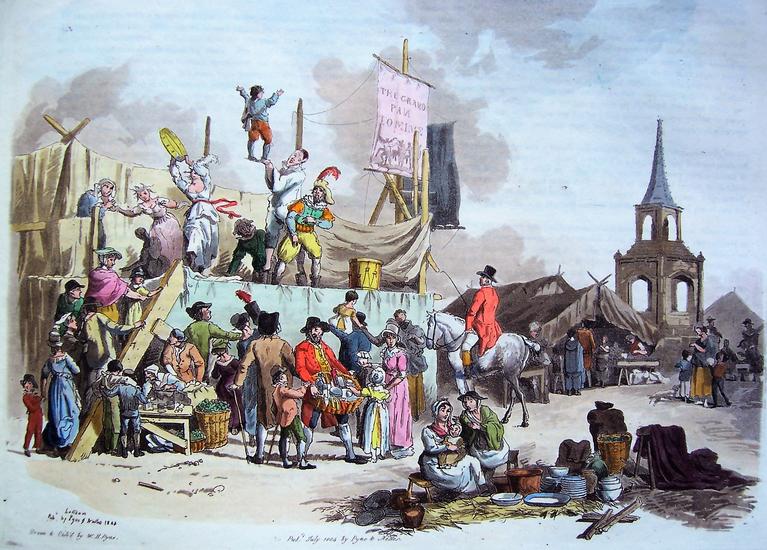
Emmanuel’s copy of William Henry Pyne’s Microcosm, or A Picturesque Delineation of the Arts, Agriculture, Manufactures, etc, of Great Britain (1808) is indeed a microcosm or world in miniature that presents – in over six hundred hand-coloured images – an encyclopaedia of human activity, largely of work and but also some play.
As an artist himself, Pyne complained that artists did not put the same effort into representing human figures as they did into their landscapes that included those figures. Pyne recommended budding artists to study those artists ‘who have most excelled in forming pictures representing the peasantry of our country’ (among others he picks out Gainsborough and Morland). But Pyne also led by example in producing many genre studies, recording the activities of working people for both amateur and professional artists to copy, so creating more lifelike depictions of figures at work. This is why his Microcosm advertises itself as recording figures of people at work ‘for the Embellishment of Landscape’, although it is now prized as a uniquely full and lovingly detailed record of those past lives of toil that might otherwise go unrecorded, along with implements and technologies long superseded.
All kinds of rural economic activities are represented, but the technology that Pyne records is strictly pre-industrial and probably based on sketches made in the south of England: even the colliery that he depicts is working by horse-power, although steam-engines had already been in use in the Northern coal-fields for decades. Here in Plate 2 the two top images show figures working at the weighing of coals, while at the bottom is a machine for raising the coals from the pit.
.jpg)
.jpg)
Plate 2: Collieries; Plate 3: Cranes;
In the plate showing figures operating some enormous cranes, the two cranes at the top are for raising timber; bottom left is a crane operated on a wharf, and bottom right a crane for raising stone.
Another plate shows, top and bottom, the unrelated activities of rope-making and the woodland industry of charcoal burning, a skilled three-day process of charring in turf-sided ovens the wood seen being collected on the left.
.jpg)
.jpg)
Plate 4: Rope-makers and Charcoal-Burners; Plate 5: Iron Foundry;
Much more industrial are the various processes in the iron foundry. The top two images show figures busy with the casting of cannon balls (Britain is engaged in long years of the Napoleonic Wars). The furnace is serviced by great bellows that are being worked by a (not shown) horse-driven machine connected by an axle. Bottom left is a forge with a bellows blown by means of a lever; bottom right, two men work at a forge, with a crane to move heavy items from fire to anvil.
Activities enabled in mills are a favourite subject, as here, where a pump raises buckets by means of a wheel turned by a windlass, and a horse mill is used to grind the flint used in glass-making.
.jpg)
.jpg)
Plate 6: Mills; Plate 7: Wheelwrights;
Wheelwrights were skilled workers in the different woods used for different parts of wheels, and the figures here are shown making cartwheels, adjusting a cartwheel, and also applying their skills to repair mill-machinery, as they traditionally did.
Other mills and their workers depicted by Pyne include mills used by tanners, by potters for grinding clay, for raising water, and for grinding chalk used in lime.
.jpg)
.jpg)
Plate 8: Mills; Plate 9: Coppersmiths;
Pyne’s study of copper smiths shows figures making chimney-tops, polishing copper plate, making a copper, cutting up a sheet of copper with shears, and beating copper with a heavy hammer steadied on a strap.
At a period when beer (and, in western counties, cider) were staples for working people, Pyne shows figures busily engaged in brewing and cider making, with scenes of grinding malt and brewing, and a horse mill for bruising the cider apples that are being collected.
.jpg)
.jpg)
Plate 10: Brewing and cider making; Plate 11: Games;
Pyne also includes plates showing enjoyment of traditional rural sports and pastimes: here, several forms of skittles, a game of quoits, and (top right) a game of bowls – the latter a pastime that (Pyne deplores) is fast falling out of fashion at the time and being replaced by cricket.
Yet one of Pyne’s most striking plates features no towering machinery but simply offers its own tribute to the men who mow the hay.
.jpg)
Plate 12: Mowers
Three rows of six mowers are shown in various attitudes, at work or sharpening their scythes. Traditionally they work in groups of three, and each makes a sweep at the same time. The second cuts what is left by the first, and the third what is left by the second, ‘and they come so near each other … that the beholder is apt to be in a state of continual alarm for their safety – but from the mechanical exactness of the semi-circle which they form, acquired by practice, seldom any accident occurs …’ A figure in the bottom row carries a keg of refreshment. For Pyne, humble skill and toil, or early industrial processes, are worthy of an artist’s attention, and he creates art out of the most ordinary materials, suggesting movement and bustle by recording figures in different stages of work. With its sketch book immediacy, the Microcosm conveys a sense of the dignity of labour, sees grace in drudgery, and in so doing makes the common man visible.
Barry Windeatt (Keeper of Rare Books)
Images by Helen Carron (College Librarian)
9 February 2022
As we enjoy the spectacle of yet another Olympic Games, in this case the Winter variety, it is intriguing to note that almost exactly 400 years ago Cambridgeshire was preparing to host its very own ‘Olympics’. Scheduled for early July, 1620, the games were to be held in the Gog Magog hills, a few miles south–east of Cambridge.
Similar events had been staged there occasionally in the previous half–century, usually at Whitsuntide, to the increasing vexation of the university authorities. On 28 May 1574 the Vice–Chancellor, John Whitgift, informed William Cecil, Lord High Treasurer of England, that for the past two years the Gog Magog Gatherings had been an ‘occasion of moche disorder among the youthe of the universite’, a particular cause of concern being the illicit gaming that had gone on. Appalled by rumours that these ‘infamous’ games were to become an annual fixture, Whitgift entreated Cecil to revoke the licence which a ‘very lewed’ man, Richard Robinson, claimed gave him authority to hold the event.
Without waiting for Cecil’s response, on 29 May the Vice–Chancellor issued a University Order, imposing financial penalties on any students spotted within half a mile of the games. The fines were to be paid by the miscreants’ tutors, who stood to have their goods distrained if they refused: a clever (if unpopular) stratagem aimed at enforcing collegiate cooperation. Whitgift also ordered that the Gog Magogs be patrolled by University Proctors and Bedells for the duration of the games: a kill–joy attitude, perhaps, but Cambridge undergraduates could be as young as fourteen or fifteen, and the games offered many unwholesome temptations. In the ensuing decades the authorities made repeated attempts to suppress the Gog Magog revels, but their allure was such that students continued to defy the prohibition on attendance.
Things finally came to a head in 1620, for the July gathering promised to be a particularly rowdy affair, lasting several weeks and including horse–racing, bull– and bear–baiting, ‘loggattes, ninehoales, ryflinge, dicing & other such unlawefull sportes and games’. On learning of this, the Vice–Chancellor, Robert Scott, immediately rode out to the hills and hauled the event’s convenor, John Adamson, back to Cambridge, where he threatened him with instant imprisonment if the games were not called off. Adamson had no choice but to comply, whereupon the booths were dismantled, the company dispersed, and the ‘sportes and shows were utterlye disappoynted’. This seems to have been the nemesis of the Gog Magog Gatherings, for they are not mentioned again in the University annals.
.jpeg)
.jpg) The cancellation of the games would have pleased Symonds D’Ewes (Plate 1–L), a rather priggish young student at St John’s College, who had noted in his diary for July 1620 that the ‘vain and needless’ entertainments to be held at the Gog Magogs would include bowling, running, jumping, shooting and wrestling, ‘under the designation of the Olympic ames’. This is the only contemporary reference to the games as ‘Olympic’, an adjective surely bestowed by Cambridge students, who would have been familiar with the Ancients. The better–known ‘Cotswold Games’, initiated by Robert Dover at some date after 1611, may well have been inspired by the Gog Magog Gatherings, for Dover had been up at Cambridge in the 1590s. The Cotswold games were also called ‘Olympics’, certainly by 1630 (Plate 2—Above R: Frontispiece to a collection of poems extolling the merits of the Cotswold Games, 1636)
The cancellation of the games would have pleased Symonds D’Ewes (Plate 1–L), a rather priggish young student at St John’s College, who had noted in his diary for July 1620 that the ‘vain and needless’ entertainments to be held at the Gog Magogs would include bowling, running, jumping, shooting and wrestling, ‘under the designation of the Olympic ames’. This is the only contemporary reference to the games as ‘Olympic’, an adjective surely bestowed by Cambridge students, who would have been familiar with the Ancients. The better–known ‘Cotswold Games’, initiated by Robert Dover at some date after 1611, may well have been inspired by the Gog Magog Gatherings, for Dover had been up at Cambridge in the 1590s. The Cotswold games were also called ‘Olympics’, certainly by 1630 (Plate 2—Above R: Frontispiece to a collection of poems extolling the merits of the Cotswold Games, 1636)
.jpg)
.jpg)
Emmanuel College’s Puritan authorities naturally deplored the Gog Magog shindigs, and the students were strictly forbidden to go near them. Nevertheless, on 29 May 1592, two fellow commoners were formally admonished for ‘going to Hogmagog hills contrarie to the Masters commandement’. The lads in question, Dennis Hartridge and George Catesby, were also reprimanded for idleness and neglect of studies, ‘going a–hunting’, being out of college after the gates were locked, abusing the young Earl of Rutland’s sizar, challenging him to a fight, and ‘divers other’ misdemeanors (Plates 3 & 4—Above L &R: the admonition book censuring George Catesby (R) & Dennis Hartridge (L) for various misdemeanours, 29 May 1592). How seriously these two delinquents regarded their verbal warnings is anyone’s guess, but at least they were never caught frequenting the Gog Magogs again.
Amanda Goode, College Archivist
9 February 2022
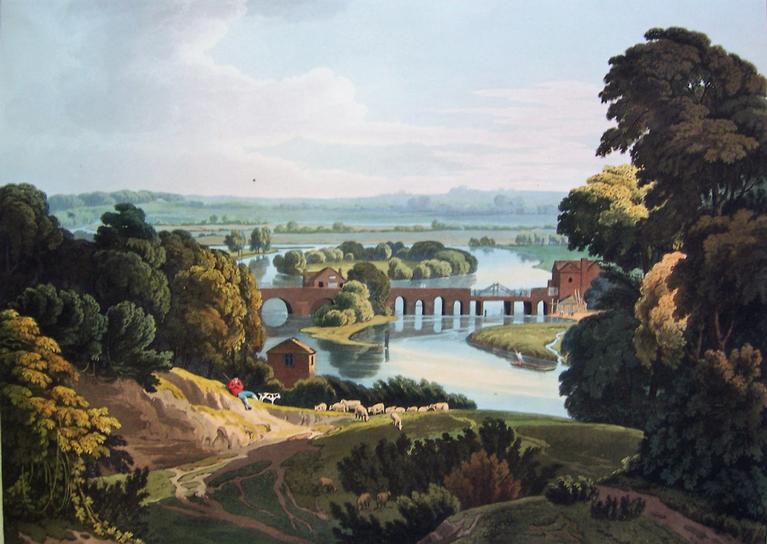
Various illustrated books in Emmanuel’s collections – devoted to recording the scenery and the observations of travellers along the course of certain rivers – remind us how significant has been the idea of rivers as entities with their own distinct character and culture, as also the history of human engagement with such rivers. From accounts of intrepid Victorians exploring to the source of African rivers to the recent spate of gentle TV programmes that transport their viewers down rivers and even along canals, there is an impetus in common.
The earliest and most influential river-tour in Britain was a boat-trip down the River Wye from Ross-on-Wye to Chepstow, past a series of natural features and scenic buildings and ruins. Although the beauties of the Wye valley had been frequented by tourists for some decades before, the whole tour became a fashionable craze after the publication in 1782 of William Gilpin’s Observations on the River Wye and Several Parts of South Wales etc, relative chiefly to Picturesque Beauty. Emmanuel’s copy of T. H. Fielding’s Illustrations of the River Wye (1822) dates from the height of the craze in the early nineteenth century, with aquatints illustrating the whole course of the Wye from its source and highest reaches in picturesquely rugged Welsh scenery down to the sea. As the grand arbiter of what was picturesque, Gilpin had declared the hill-top ruins of Goodrich Castle, towering high over the river, to be ‘correctly Picturesque’.
.JPG)
Plate 2: Fielding, Illustrations of the River Wye: ‘View of the Wye from Rhayader’; Plate 3: Illustrations: ‘Goodrich Castle, from the Ferry’;
At this period eight or ten tourist boats would leave Ross-on-Wye every day, although some tourists walked the banks of the river. Boats were furnished with drawing tables at which the tourists would sketch the most picturesque views.
.JPG)
Plate 4: Illustrations: ‘View down the River at the New Weir’; Plate 5: Illustrations: ‘North View of Tintern Abbey’;
Awnings provided shelter from the inky skies of picturesque sudden storms recorded here as in other views, and one of the tour’s late highlights were the ruins of Tintern Abbey, made even more famous after publication of Wordsworth’s poem Lines Written a Few Miles above Tintern Abbey, on Revisiting the Banks of the Wye during a Tour, July 13, 1798.
Local and regional patriotisms led to publication of ‘tours’ and ‘descriptions’ of more modest rivers. Picturesque Views on the River Exe (1819) was published in Tiverton and brims with local loyalty to the bosky beauties of the Exe valley, while F. C. Lewis’s Scenery of the River Dart (1821) uses etchings that well catch the rock-strewn moorlands and the wooded Devon valleys through which the Dart flows from its source to the sea.
.JPG)
Plate 6: Views on the River Exe: ‘Oakford Bridge on the Exe’; Plate 7: Scenery of the River Dart: ‘Junction of the River Weber with the Dart’;
The Medway and the Warwickshire Avon received similar treatments, as well as some canals.
By contrast, the various ‘histories’ and ‘picturesque views’ of the Thames attempt ambitious syntheses of extensive prospects of landscape with resonantly historic architecture of national significance. In William Havell’s Picturesque Views of the River Thames (1818) panoramas of the Thames valley, sketched from some very elevated vantage-point and under a golden light, show the river moving through an expansive landscape that extends to a distant horizon. Other views showcase riverside views of towns along the Thames or an imposing building, such as the sheer massiveness of Windsor Castle as depicted here.
.JPG)
Plate 8: Havell: ‘View of the Thames at Streatley’; Plate 9: Havell: ‘Windsor Castle’;
Tourism to Europe could open up again after Waterloo, and Baron Johann Isaac von Gerning’s A Picturesque Tour along the Rhine, from Mentz to Cologne (published in London in 1820) accompanies its beautiful plates with information on topography, history and popular traditions, hoping to attract ‘travellers of cultivated minds who may be induced to visit this interesting portion of Germany,’ which it describes impartially as ‘a portion of heaven fallen down to earth’. Emphasis is on the most picturesque views and prospects, with romantic castles perched high on their crags above the river viewed far below.
.JPG)
Plate 10: Gerning: ‘Thurmberg’; Plate 11: Gerning: ‘Liebenstein and Sterrenberg’;
Or there are views nearer to river level, that by contrast give a perspective looking up at the steep-sided valleys through which the Rhine here flows, with buildings ‘reflected in all their melancholy gloom in the crystal stream’.
.JPG)
Plate 12: Gerning: ‘St Goarshausen, St Goar, and Rheinfels’; Plate 13: Gerning: ‘Salmon Fishery at Lurley’;
The Baron’s book is one of a series of such ‘Picturesque Tours’ advertised by the publisher, Ackerman, which additionally promised tours of the Seine and the Ganges. The latter is a sign of a fascinating extension of interest and taste, which seeks out the Picturesque far beyond European scenery. Emmanuel’s collection also includes the advertised A Picturesque Tour along the Rivers Ganges and Jumna (1824), ‘From Original Drawings Made on the Spot’ by Lieutenant Colonel C. R. Forrest, ‘Late on the Staff of His Majesty’s Service in Bengal’.
.JPG)
Plate 14: Forrest: ‘Ancient Tomb at the Confluence of the Boglipore Nulla and the Ganges’; Plate 15: Forrest: ‘Surseya Ghaut, Khanpore’
Emmanuel’s copy is now very rare, in that it is still unbound in the original ‘paperback’ instalments in which it was received by its subscriber.
Barry Windeatt (Keeper of Rare Books)
Images by Helen Carron (College Librarian)
27 January 2022
It’s been 10 years since I first arrived at Emma, and I can still feel the cold I felt when I got down from the bus at the coach station on Parkside!
.png) Ten years, and I can still remember the welcoming faces of the porters at the Lodge and the friendly arrival conversations at Park Lodge, the nice house where I was going to live for the next year. Ten years have gone by, and I still feel that being part of the Emmanuel community was one of the most transformative experiences of my life.
Ten years, and I can still remember the welcoming faces of the porters at the Lodge and the friendly arrival conversations at Park Lodge, the nice house where I was going to live for the next year. Ten years have gone by, and I still feel that being part of the Emmanuel community was one of the most transformative experiences of my life.
From Emmanuel, I cherish not only the opportunities I got to thrive in my career but also the music and social life I was able to live and experience while living there, and of course, the lifelong friendships I made along the way.
.png) My experience in Emmanuel also propelled me to co–fund in 2014 the first personalized genomics company in Mexico called SERENDA. There, and with the mission of transforming genomic information into valuable knowledge for the Mexican population, I worked on the creation of the country’s largest database of genomic and clinical information, the development of a bioinformatics platform for the analysis of the information, the enablement of responsible genomic information–sharing between national and international institutions, and the provision of personalized genomics services. Unfortunately, we had to close SERENDA in 2016 due to the lack of funding, but it is a project I still have in mind for the future.
My experience in Emmanuel also propelled me to co–fund in 2014 the first personalized genomics company in Mexico called SERENDA. There, and with the mission of transforming genomic information into valuable knowledge for the Mexican population, I worked on the creation of the country’s largest database of genomic and clinical information, the development of a bioinformatics platform for the analysis of the information, the enablement of responsible genomic information–sharing between national and international institutions, and the provision of personalized genomics services. Unfortunately, we had to close SERENDA in 2016 due to the lack of funding, but it is a project I still have in mind for the future.
In the future, I would very much like to come back to Emma not only for visiting, but maybe for continuing my career with a Master’s and PhD in Biochemistry. It will be a pleasure to be back!
27 January 2022
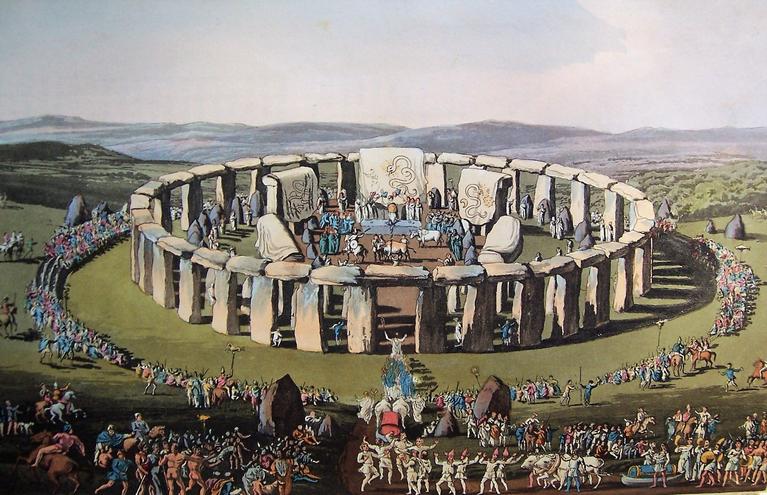
Among the hand-coloured books in Emmanuel’s Graham Watson Collection are a number purporting to illustrate the costumes and customs of earliest times. The Costume of the Original Inhabitants of the British Islands, by Samuel Rush Meyrick and Charles Hamilton Smith (1810), takes the story back to even earlier times than Hamilton Smith’s Selections of the Ancient Costume of Great Britain and Ireland (1814). The illustrations in both books are – by the standards of the time – carefully-researched reconstructions informed by archaeological discoveries, early written sources, and the authors’ sketches copied from manuscript illuminations, seals, coins and tomb effigies.
The striking reconstruction of the ‘Festival of the Britons’ at Stonehenge shows in the innermost enclosure the Druids honouring the sun god. Cattle are ready for sacrifice and the standing stones bear hangings depicting dragons. Outside the stone circle are gathered a general assembly of the people, who were never allowed within the sacred circle, or so it was believed. The accompanying text is a farrago of speculative imaginings about the ritual purposes of these still-mysterious stones.
Pl. 2: Original Inhabitants: Fishing;
A plate illustrating the ancient Britons’ pursuit of agriculture and fisheries depicts our predecessors in a park-like landscape arranged according to a distinctly Picturesque aesthetic, where the naked Britons are employing corracles to fish from.
Pl. 3: Original Inhabitants: An Arch-Druid in his Judicial Habit;
An illustration of an Arch-Druid shows him with various accoutrements and utensils based on items recently excavated in Ireland, including a breast-plate that, according to legend, had the power to squeeze the neck of the wearer who uttered a false judgement. Bottom right, the pet holy snake is helping itself to a holy beverage.
Depiction of the earliest British costume are derived from accounts by Julius Caesar and other Roman witnesses of how the inhabitants of the interior parts of Britain were clothed and armed.
.JPG)
Pl. 4: Original Inhabitants: An Ancient Briton of the Interior; Pl. 5: Original Inhabitants: Caledonians;
So here one ancient Briton is clad in ‘the skin of a brindled or spotted cow’, and carries spear, axe and shield. In the background is an earthwork fortification and at his side is what the text calls ‘his faithful dog, not only the trusty guardian of his hut, but his fierce and steady companion in war’. Roman writers recorded that inhabitants of ‘North Britain’ went about almost naked, sporting abundant tattoos. Depicted here are a pair of tattooed ‘Caledonians’ strolling starkers, but if you’re wondering about those less-than-balmy Highland temperatures, not to mention midges, the text says they are inspecting a cromlech in Cornwall. Everyone deserves a holiday.
.JPG)
Pl. 6: Original Inhabitants: Queen Boadicea; Pl. 7: Original Inhabitants: Anglo-Saxon Women, 750 AD;
The attire of Queen Boadicea – Boudicca, queen of the Iceni people in Norfolk, who led a revolt against Roman rule – is reconstructed from images of Celtic women on the columns of Trajan and Antonine. From other early accounts derive the patterned weave of her dress, the bracelets and rings, and that she was ‘a handsome woman but of stern countenance’. The twin breastplates at the foot of the page record those that had recently been ploughed up in a Somerset field. Among various warlike depictions of much later Anglo-Saxon kings and warriors are several plates recording the dress of Anglo-Saxon women, as here of around 750 AD. Both are dressed in long loose gowns, with long sleeves, and with a linen undergarment; over the head is a hood. One is shown spinning or winding from a bobbin; the other is mounted side-saddle.
Hamilton Smith’s Ancient Costume focusses more on the post-Conquest period and literally gallops through the medieval centuries with more splendid depictions of galloping and charging knights in armour than can be included here.
.JPG)
Pl. 8: Smith, Ancient Costume: Thomas, Earl of Lancaster, 1314; Pl. 9: Ancient Costume: Arthur MacMurroch, King of Leinster, 1399;
This plate of Thomas, Earl of Lancaster – dated to 1314 – must stand to represent the others, as he charges forward: indeed, the man is almost as magnificently turned out as his horse. The text explains that the image has been reconstructed from the Earl’s seal, including the emblazoned surcoat, and the dragon crest on the helmet and the horse’s head. Rather different is the depiction of Arthur MacMurroch, King of Leinster, who twice led resistance to Richard II’s incursions into Ireland in the 1390s. He is shown riding barefoot and without saddle, on a horse for which he reputedly traded four hundred cows – a dynamic image of resistance.
For the later medieval centuries the antiquarian authors could find so much more visual evidence to embolden them to reconstruct portraits of historic figures.
.JPG)
Pl. 10: Ancient Costume: Ralph Neville, Earl of Westmorland, and Joan Beaufort, 1425; Pl. 11: Ancient Costume: Queen Margaret of Anjou;
This double portrait, dated to 1425, attempts to retrieve the costume and likeness of the powerful Northern magnate Ralph Neville and his redoubtable wife Joan Beaufort, daughter of John of Gaunt, who was visited by the early autobiographer Margery Kempe. The splendid armour and lavish dress are copied from the couple’s alabaster effigies. A similarly lavishly-dressed portrait of Margaret of Anjou (formidable consort of the hapless Henry VI), dressed in cloth of gold and with a pearl-edged headdress, is derived from a tapestry.
But other plates are alive to the class distinctions that were inseparable from clothes.
.JPG)
Pl. 12: Ancient Costume: ‘A Sportsman of Rank and Gamekeeper’; Pl. 13: S. R. Meyrick, A Critical Enquiry into Antient Armour (1824): Black Armour;
Here a young sportsman wears a very smart scarlet jacket with the fashionably puffed sleeves that were so much in vogue in the first half of the fifteenth century; he wears black hose, and his modish bonnet has flown off and is in the foreground. Meanwhile his gamekeeper is dressed in an altogether more subdued and serviceable way. Not for him the stylish black armour that was the last word in ostentation by the early sixteenth century.
These books derive from a kind of archaeological impetus to help readers visualize past British costume and custom on the evidence of surviving material culture. Other illustrators might be more light-hearted. Among the many theories advanced to explain the purpose of the standing stones at Stonehenge, the idea that they are the stumps and bails in a form of Druid cricket has not received the attention it deserves. Here, in The Comic History of England (1848), an understandably worried-looking Druid has been put in to bat against Father Time.
Pl. 14. Gilbert Abbot A’Beckett, The Comic History of England (1847-8), ‘Time Bowling Out The Druids’
Barry Windeatt (Keeper of Rare Books)
Images by Helen Carron (College Librarian)
11 January 2022
Some years ago the archives received a query from a correspondent who was convinced that because Jonathan Swift made his immortal hero, Lemuel Gulliver, an Emmanuel man, it followed that Swift himself must have been among our alumni. His absence from our admission register could apparently be explained by the fact that the college had erased all evidence of its connection with the controversial satirist.
.jpg)
.jpg) It was an entertaining, but implausible, theory, for the Emma authorities have never troubled to doctor the college’s admission records, however notorious a member became in later life. In fact, Gulliver’s presence at Emma is believed to have been Swift’s tribute to the celebrated diplomat and man of letters, Sir William Temple (Plate 1—L: title & opening pages of Gulliver’s Travels, Cresset Press 1930, from Emmanuel’s Graham Watson Collection).
It was an entertaining, but implausible, theory, for the Emma authorities have never troubled to doctor the college’s admission records, however notorious a member became in later life. In fact, Gulliver’s presence at Emma is believed to have been Swift’s tribute to the celebrated diplomat and man of letters, Sir William Temple (Plate 1—L: title & opening pages of Gulliver’s Travels, Cresset Press 1930, from Emmanuel’s Graham Watson Collection).
Temple was admitted to Emmanuel as a fellow commoner in August 1644, having been educated at Bishop’s Stortford grammar school. According to his sister Martha, Lady Giffard, who wrote a delightful memoir of her older brother, the family intended that young William should go up to Cambridge immediately after leaving school, but ‘the disorders of that time…hindered his goeing to the university’. Despite this delay, Temple was still only sixteen when he came to Emma, too young and insouciant to appreciate the intellectual opportunities on offer. Lady Giffard recalled that her brother was ‘placed... under the care of Dr Cudworth, who would have engaged him in the harsh studies of logick and phylosophy which his humor was too lively to pursue. Entertainments which agreed better with that & his age, especially Tennis, past most of his time there, soe that I have heard him say, if it had bin possible in the two years time he past there to forgit all he had learn’t before, he must certainely have done it’.
.jpg) It sounds as though Temple thoroughly enjoyed his scholastically indolent sojourn at Emma, and it is pleasing to think of him making good use of the college’s walled tennis court (Plate 2—R: Emmanuel’s Jacobean tennis court; Plate 3—Below L: Temple's 'Caudle' cup, presented to the college in 1677). The only fly in the ointment was his room-mate James Beverley, whom he disliked. Beverley later paid court to Temple’s sweetheart, Dorothy Osborne, an unwise manoeuvre that provoked Temple into telling Dorothy scornfully that his former chamber-fellow was a ‘whelp’, who had forever been importuning their shared tutor. On being informed by Dorothy that she intended to marry Temple, Beverley ranted that she would soon be ‘the misserablest Person upon Earth’, and called his rival ‘the Proudest imperious insulting ilnatured man that ever was’. Relating this outburst to her fiancée, Dorothy commented: ‘Is this not very comfortable? But pray make it no quarrell, I make it none, I can assure you…besides that his Testimony is not of much Valew’.
It sounds as though Temple thoroughly enjoyed his scholastically indolent sojourn at Emma, and it is pleasing to think of him making good use of the college’s walled tennis court (Plate 2—R: Emmanuel’s Jacobean tennis court; Plate 3—Below L: Temple's 'Caudle' cup, presented to the college in 1677). The only fly in the ointment was his room-mate James Beverley, whom he disliked. Beverley later paid court to Temple’s sweetheart, Dorothy Osborne, an unwise manoeuvre that provoked Temple into telling Dorothy scornfully that his former chamber-fellow was a ‘whelp’, who had forever been importuning their shared tutor. On being informed by Dorothy that she intended to marry Temple, Beverley ranted that she would soon be ‘the misserablest Person upon Earth’, and called his rival ‘the Proudest imperious insulting ilnatured man that ever was’. Relating this outburst to her fiancée, Dorothy commented: ‘Is this not very comfortable? But pray make it no quarrell, I make it none, I can assure you…besides that his Testimony is not of much Valew’.
.jpg) After retiring from public affairs, Temple planned to put his unpublished writings into order and some of them into print. To aid him in this task he employed the young Jonathan Swift as his amanuensis, and although their working relationship had its ups and downs, the two men seem to have liked and respected each other. After Temple’s death in January 1699 Swift continued to edit his papers, but his ill-judged publication in 1709 of a memoir written by Temple for family perusal only, containing frank observations about several prominent figures, earned him the undying enmity of Lady Giffard.
After retiring from public affairs, Temple planned to put his unpublished writings into order and some of them into print. To aid him in this task he employed the young Jonathan Swift as his amanuensis, and although their working relationship had its ups and downs, the two men seem to have liked and respected each other. After Temple’s death in January 1699 Swift continued to edit his papers, but his ill-judged publication in 1709 of a memoir written by Temple for family perusal only, containing frank observations about several prominent figures, earned him the undying enmity of Lady Giffard.
As to Swift’s motive in placing Lemuel Gulliver at Emmanuel, there is no reason to suspect any satirical intent. At the time that Gulliver’s Travels was published, in 1726, Emmanuel was neither the puritan seminary it had been, nor yet the favoured resort of the smart set it was to become; in fact, the early eighteenth century was a particularly quiescent period in the college’s history, so hardly the stuff of satire. Gulliver’s residence at Emma may therefore be accepted as an affectionate homage to Temple, of whom Swift wrote: ‘He died at one o’clock in the morning and with him all that was great and good among men’.
Below—L–R: Gulliver’s Travels, illustrated by Rex Whistler; Far L: Gulliver captures the fleet of Lilliput’s equally miniature rivals, the empire of Blefuscu; Centre L: Gulliver is received in state by the Emperor of Lilliput; Centre R: Gulliver narrowly escapes death from gigantic falling apples in Brobdingnag; Far R: Standing on the special case made to house him, Gulliver describes the state of Europe to the King of Brobdingnag. His Majesty is unimpressed, and horrified to learn of the use of guns and cannons
.jpg)
.jpg)
.jpg)
.jpg)
Amanda Goode, College Archivist
15 December 2021
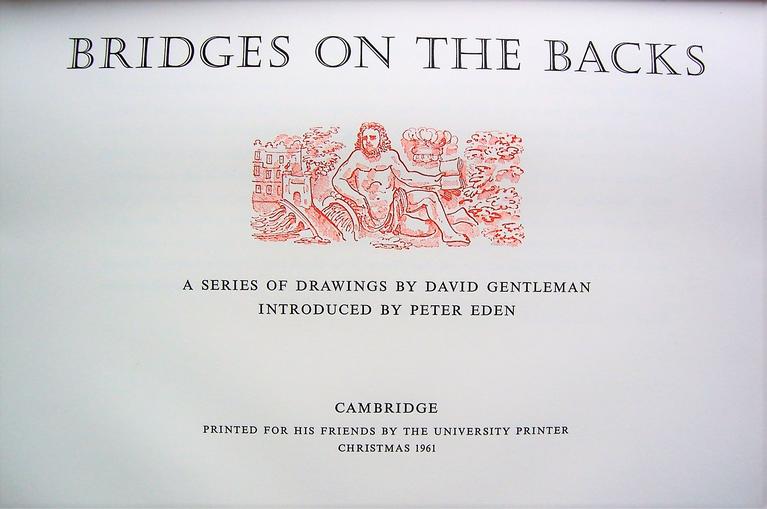
At Christmas in 1961, the University Printer, Brooke Crutchley, commissioned a small book of Bridges on the Backs in a very limited edition to send as a special Christmas gift to his friends. Sixty years later, this seems the season to share with Emmanuel members the copy in the Graham Watson Collection. For the illustrations Crutchley commissioned the young artist David Gentleman (b. 1930).
The book’s design is a homage to the use of illustrations on ‘before’ and ‘after’ paper lift-up flaps by which Humphry Repton – the fashionable garden designer of the Regency period – presented his clients with the contrast between present and future: their dull present garden and the transformed landscape that he undertook to provide. Except that in this little book about Cambridge bridges the movable flaps enable a journey from present to past: each flap turns back to reveal a sketch of an earlier bridge on the site.
So, on the page devoted to the Silver Street bridge, the top flap shows the present bridge, which had only recently been built in 1959, after designs by Sir Edwin Lutyens (d. 1944). Sharp-eyed readers will make out the wavy top edge of the flap as it runs through the trees on the left and over the Anchor Pub. But turn back this first flap to discover a second flap, and sketches of two earlier bridges on this spot.
.jpg)
.jpg)
The second flap shows a cast-iron bridge built in 1841, and underneath that an earlier wooden bridge.
.jpg)
.jpg)
For the page on King’s, the flap is illustrated with the present stone bridge, built in 1819 and designed by William Wilkins, who also designed the screen and entrance on King’s Parade. But when the flap is turned back, it shows a forgotten (and perhaps unregretted) earlier bridge, which was much nearer to Clare Bridge and aligned on the large Classical building next to the Chapel, the Gibbs Building.
.jpg)
.jpg)
The page devoted to Clare Bridge needs no flap since that most beautiful bridge of 1639-40 is the only bridge that has stood on that spot and is now by some way the oldest bridge on the Backs.
.jpg)
By contrast, the top flap for the Garret Hostel Bridge shows the brand-new crossing (just built in 1960). This flap turns back to reveal a second flap depicting the previous Tudoresque bridge, built in cast iron in 1835-7, and underneath this flap is a sketch of the wooden bridge that came before the cast iron one.
.jpg)
.jpg)
.jpg)
At St John’s, Henry Hutchinson’s scheme for New Court (1827-31) on the west side of the Cam required the building of the Bridge of Sighs in a Romantic Perpendicular style. When the flap depicting the Bridge of Sighs is turned back, it reveals that no bridge was needed here before.
.jpg)
.jpg)
Historically, the bridge by Magdalene was always the town’s principal river crossing – this was the ‘bridge’ in Cambridge. In the sketch the flap depicts the present cast iron bridge, built in 1823 and painstakingly restored in recent years (with consequent traffic chaos). Turn back the flap and see one of the many earlier bridges that have stood on this site.
.jpg)
.jpg)
Here was the working river, and below Magdalene Bridge were formerly quays and warehousing for the Cam as a trade and traffic artery: 1824 saw inauguration of a new steamboat service from here to King’s Lynn. Whereas the Backs have changed relatively little, this sketch of 1961 shows the now-demolished chimney of the power station that used to stand on this stretch of river opposite Magdalene.
In its homage to the beauties of Cambridge and of the colour-plate book tradition – albeit in a contemporary style – this unique Christmas gift book is an apt subject for our last blog of the year. We wish all our readers a very Merry Christmas and a Happy New Year.
Barry Windeatt (Keeper of Rare Books)
Images by Helen Carron (College Librarian)
13 December 2021
In the college archives, there is a copy of a curious printed booklet entitled An Account off the Festivation and Jubilee holden at Emanuel Colledge September 29, 1684.
Employing cod–archaic spelling and phraseology, and purporting to be an account of a celebration marking the centenary of the college’s founding, it is actually a satire upon the bicentenary feast held at Emma on Michaelmas day 1784. The booklet opens with a description of the food and drink served, then proceeds to make observations about the musical entertainment (‘that Orpheus mote have ylistened to with envy’) and the distinguished guests.
.jpg) The banquet is represented as an occasion of gastronomic excess, featuring turtle soup as the first course, followed by ducks, geese, game, ‘fatte Bocks’ [venison], beef, pork and ‘the whole store of the sea’. A procession of puddings, including ‘Syllembibs’ and trifles, were succeeded by a delectable dessert course comprising ‘pyne apples’ and a profusion of other fruit and nuts. The wine list included claret, port, madeira and ‘Tokaye from Hongary note to be excelled for sweetness’ (Plate 1—Above: a spread of wine & fruit, similar to the feast's dessert). What do we know about the real feast? It was unquestionably a very lavish affair, with almost 140 guests. Under the convivial mastership of Richard Farmer, 1775–1797, Emmanuel had become the most socially fashionable college in Cambridge, and many prominent men of letters and affairs were present at the bicentenary dinner, including William Pitt the Younger, the new MP for Cambridge University and de facto Prime Minister (the ‘Festivation’ booklet claims Pitt sent his excuses, but the report in the Cambridge Chronicle confirms his attendance).
The banquet is represented as an occasion of gastronomic excess, featuring turtle soup as the first course, followed by ducks, geese, game, ‘fatte Bocks’ [venison], beef, pork and ‘the whole store of the sea’. A procession of puddings, including ‘Syllembibs’ and trifles, were succeeded by a delectable dessert course comprising ‘pyne apples’ and a profusion of other fruit and nuts. The wine list included claret, port, madeira and ‘Tokaye from Hongary note to be excelled for sweetness’ (Plate 1—Above: a spread of wine & fruit, similar to the feast's dessert). What do we know about the real feast? It was unquestionably a very lavish affair, with almost 140 guests. Under the convivial mastership of Richard Farmer, 1775–1797, Emmanuel had become the most socially fashionable college in Cambridge, and many prominent men of letters and affairs were present at the bicentenary dinner, including William Pitt the Younger, the new MP for Cambridge University and de facto Prime Minister (the ‘Festivation’ booklet claims Pitt sent his excuses, but the report in the Cambridge Chronicle confirms his attendance).
.jpg) No menu survives, so we cannot tell to what degree the booklet exaggerates, but we know from suppliers’ bills that venison and other game were served, and a passage in the Reminiscences of Henry Gunning (an undergraduate at Christ’s in 1784) confirms that some unlucky turtles were indeed consumed, for several ‘lively’ specimens were kept in tubs in the Master’s Lodge before the feast, where they were open to inspection by the curious.
No menu survives, so we cannot tell to what degree the booklet exaggerates, but we know from suppliers’ bills that venison and other game were served, and a passage in the Reminiscences of Henry Gunning (an undergraduate at Christ’s in 1784) confirms that some unlucky turtles were indeed consumed, for several ‘lively’ specimens were kept in tubs in the Master’s Lodge before the feast, where they were open to inspection by the curious.
Detailed bills for the dessert course survive, which chime closely with the booklet, for they list pineapples, apples, pears, peaches, melons, nectarines, lemons, grapes, walnuts, cobnuts and filberts. The invoice for wines and spirits (Plate 2—L), suggests that the guests made very merry indeed.
Four copies of the ‘Festivation’ booklet, addressed to the Master and certain of the Fellows, were covertly ‘dropt in the Hall’ at Emma, the only surviving copy being annotated to the effect that since it was so error-ridden, the writer could not have been present at the feast. It may indeed be the case that the anonymous satirist had relied on hearsay, but it is surely also possible that the ‘mistakes’ were a deliberate part of the joke. One of the guests was George Steevens, a well-known writer and critic who had collaborated with Richard Farmer on Shakespearean research. By the 1780s he had become an eccentric and vexatious character given to inflicting hoaxes and anonymous letters upon the academic world, and it is tempting to speculate that he was the author of the booklet, the final page of which is devoted to an ironic appraisal of the supposed improvements Steevens had made to Shakespeare’s texts.
However inaccurate the booklet may have been in respect of the bicentenary celebration, it was wholly so as far as any 1684 centenary jubilee was concerned, for that anniversary had not been marked at Emma. There had been a banquet in 1677 to celebrate the consecration of the new chapel, the construction of which left the college cash-strapped for more than a decade, so the provision of another lavish feast only a few years later would have been an unattractive proposition. It was a very different matter a century later, according to the ‘Festivation’ author, for he claimed that Emmanuel’s fellowship so enjoyed their gourmandising that they hoped to celebrate the jubilee ‘everyche fyftie years in place of everyche hondred’. Those of us unlikely to live to see Emma’s quincentenary in 2084 might find the prospect of a modest celebration in 2034 rather appealing!
Amanda Goode, College Archivist
2 December 2021
When I was at Emmanuel, the Soviet Union occupied Afghanistan. Studying Russian in the Cold War, when the country where it was spoken was so closed, was perhaps a bit odd.
.jpg) Cambridge itself felt odd, struggling between clinging to tradition and embracing modernity, and far from sheltered from the impact of Thatcherism. That was partly why I applied for a British Council scholarship to study in the Soviet Union, in 'the real Russia': the regional city of Voronezh [L: Michael in Moscow, 1960].
Cambridge itself felt odd, struggling between clinging to tradition and embracing modernity, and far from sheltered from the impact of Thatcherism. That was partly why I applied for a British Council scholarship to study in the Soviet Union, in 'the real Russia': the regional city of Voronezh [L: Michael in Moscow, 1960].
I didn’t know that I’d end up spending almost half my adult life in the former Soviet Union, and repay my scholarship by working for the British Council for thirty–five years, with both my first, and my final, postings in Moscow. I didn’t know that I’d witness the biggest country in the world fall apart, and first one, then two, then three revolutions in Ukraine, and have the constant sense of participating in history.
I didn’t know that Vladimir Putin, whom I sent on a familiarisation visit to the UK with his then boss, the first elected Mayor of St Petersburg, would end up as President (after he’d helped me set up the British Council in St Petersburg). I didn’t know that after Cambridge I’d never return to England, avoiding London my entire career, but doing a posting in my home city of Edinburgh, when devolution was creating new opportunities for Scotland to connect with other countries. I didn’t know that I’d spend a quarter of my adult life in Germany and Austria, speaking the other language I studied at Cambridge, and that Berlin would become my second home city. In Vienna, I oversaw the British Council’s operations in South East Europe, then moved to Istanbul, where I led our work in sixteen countries, which collectively we called Wider Europe.
.jpg) I always wanted to return to Russia. Over the last five years, the worse the political relationship with the UK, the more important cultural and education relationships became. The most memorable week of my entire career was spent travelling Russia with Sir Ian McKellen, talking about Shakespeare, but also about equality, in cinemas packed with young Russians [R: Michael in Moscow, 2019].
I always wanted to return to Russia. Over the last five years, the worse the political relationship with the UK, the more important cultural and education relationships became. The most memorable week of my entire career was spent travelling Russia with Sir Ian McKellen, talking about Shakespeare, but also about equality, in cinemas packed with young Russians [R: Michael in Moscow, 2019].
Last time I was in Cambridge was for a gathering of UK alumni of Voronezh State University, including the Masters of two colleges. Cambridge today feels a far happier place, so much more at ease with diversity. What I value now about Emmanuel, less from my studies, more from the overall experience (I remember in particular theological debates in the Dean’s rooms after Chapel), was the opportunity to engage with other people’s views and to form my own—it stood me in good stead in Voronezh, and has continued to do so ever since.
1 December 2021
Emmanuel’s portrait of Sir William Temple (1628–1699) is a copy of a contemporary portrait by Sir Peter Lely, commissioned by the College long afterwards in 1753, to memorialize a distinguished member of Emmanuel.
.jpg) Temple was a much–travelled diplomat, especially informed about the Netherlands, of which he wrote a history (Plate 1—L: Copy of Lely's portrait, now in the Mountbatten collection, Broadlands, Hampshire & Plate 2—R: Miniature by Richard Gibson, c.1660, presented in by Mr Tim Kent, matric. 1950).
Temple was a much–travelled diplomat, especially informed about the Netherlands, of which he wrote a history (Plate 1—L: Copy of Lely's portrait, now in the Mountbatten collection, Broadlands, Hampshire & Plate 2—R: Miniature by Richard Gibson, c.1660, presented in by Mr Tim Kent, matric. 1950). .jpg) Temple negotiated the marriage of Charles II’s niece Mary to his nephew William of Orange, which would prove constitutionally pivotal when the Glorious Revolution of 1688 brought William and Mary to the throne. Tasked by Charles II to reform the system of governance, Temple devised a ‘Privy Council Ministry’ which, if implemented, would have been a forerunner of Cabinet government—but Charles II was suspicious of the implications for exercise of the royal prerogative.
Temple negotiated the marriage of Charles II’s niece Mary to his nephew William of Orange, which would prove constitutionally pivotal when the Glorious Revolution of 1688 brought William and Mary to the throne. Tasked by Charles II to reform the system of governance, Temple devised a ‘Privy Council Ministry’ which, if implemented, would have been a forerunner of Cabinet government—but Charles II was suspicious of the implications for exercise of the royal prerogative.
.jpg) In retrospect, Temple’s life appears that of one who set aside great office in favour of private life, study, and the pleasures of rural retirement and his garden—in 1685, he noted with satisfaction that he had not been to London for five years. His marriage to Dorothy Osborne had been a love match, opposed by both families, and only achieved after a clandestine courtship of seven years, during which Dorothy turned down both a Duke and a son of Cromwell. Seventy–nine of her witty, spirited letters to Temple survive from these years apart. But sorrows lay ahead: seven of their nine children died in infancy, a daughter died at fourteen of smallpox, and their surviving son drowned himself in his twenties, apparently overcome with anxieties a few days after being appointed Secretary–at–War by William III (Plate 3: the College Hall, with furniture donated by Sir William Temple).
In retrospect, Temple’s life appears that of one who set aside great office in favour of private life, study, and the pleasures of rural retirement and his garden—in 1685, he noted with satisfaction that he had not been to London for five years. His marriage to Dorothy Osborne had been a love match, opposed by both families, and only achieved after a clandestine courtship of seven years, during which Dorothy turned down both a Duke and a son of Cromwell. Seventy–nine of her witty, spirited letters to Temple survive from these years apart. But sorrows lay ahead: seven of their nine children died in infancy, a daughter died at fourteen of smallpox, and their surviving son drowned himself in his twenties, apparently overcome with anxieties a few days after being appointed Secretary–at–War by William III (Plate 3: the College Hall, with furniture donated by Sir William Temple).
.jpg) Temple had retired to a house at Farnham in Surrey which he renamed Moor Park, and where he set out to emulate the gardens of the more famous Moor Park in Hertfordshire. In his lengthy essay: ‘Upon the Gardens of Epicurus; or of Gardening in the Year 1685’ (Plate 3—L: Temple’s On the Gardens of Epicurus …’ discussing ‘sharawadgi), Temple briefly discusses what he understands as a Chinese concept of beauty without order, which he reports is termed sharawadgi. At a time when straight lines, regularity and symmetries were in vogue in gardening, Temple shows remarkable openness to this sharawadgi principle of planned naturalness of appearance in
Temple had retired to a house at Farnham in Surrey which he renamed Moor Park, and where he set out to emulate the gardens of the more famous Moor Park in Hertfordshire. In his lengthy essay: ‘Upon the Gardens of Epicurus; or of Gardening in the Year 1685’ (Plate 3—L: Temple’s On the Gardens of Epicurus …’ discussing ‘sharawadgi), Temple briefly discusses what he understands as a Chinese concept of beauty without order, which he reports is termed sharawadgi. At a time when straight lines, regularity and symmetries were in vogue in gardening, Temple shows remarkable openness to this sharawadgi principle of planned naturalness of appearance in .jpg) garden and landscape design, where straight lines are to be avoided, so as to present a more naturalistic appearance (and surviving plans of his garden suggest he may have implemented his interpretation of this). Although Temple’s understanding of sharawadgi in its original cultural context—more probably of Japanese derivation—was partial and inaccurate, he had started something about planned irregularity and naturalness, that later writers took up and developed. In this sense, Temple has some claim to be an originator of what became the English landscape garden and its principles (Plate 4—R: Bindings of inscribed volumes of his writings, presented to the College by Temple).
garden and landscape design, where straight lines are to be avoided, so as to present a more naturalistic appearance (and surviving plans of his garden suggest he may have implemented his interpretation of this). Although Temple’s understanding of sharawadgi in its original cultural context—more probably of Japanese derivation—was partial and inaccurate, he had started something about planned irregularity and naturalness, that later writers took up and developed. In this sense, Temple has some claim to be an originator of what became the English landscape garden and its principles (Plate 4—R: Bindings of inscribed volumes of his writings, presented to the College by Temple).
It was at Moor Park that Temple employed the young Jonathan Swift as his secretary, from 1689 onwards. Swift would later express great admiration for Temple, and it is presumably a kind of homage to his patron that Swift makes the hero of his Gulliver’s Travels (1726) an alumnus of Temple’s old Cambridge college. In the opening lines Lemuel Gulliver writes of himself: "My Father had a small Estate in Nottinghamshire; I was the Third of Five Sons. He sent me to Emanuel Colledge in Cambridge at Fourteen Years, and where I resided three Years and applied my self close to my Studies…"
.jpg)
.jpg)
.jpg)
.jpg)
Plates 6–9—Above L–R: Gulliver’s Travels, illustrated by Rex Whistler; Far L: Gulliver captures the fleet of Lilliput’s equally miniature rivals, the empire of Blefuscu; Centre L: Gulliver is received in state by the Emperor of Lilliput; Centre R: Gulliver narrowly escapes death from gigantic falling apples in Brobdingnag; Far R: Standing on the special case made to house him, Gulliver describes the state of Europe to the King of Brobdingnag. His Majesty is unimpressed, and horrified to learn of the use of guns and cannons
In Emmanuel’s Graham Watson Collection is a beautiful limited edition of Gulliver’s Travels, published by the Cresset Press in 1930 with illustrations by Rex Whistler (1905–1944), an interwar painter, illustrator and designer who was killed in action near Caen in Normandy. Whistler’s plates show incidents in Gulliver’s travels, where he finds himself first a giant visiting a kingdom of tiny people in Lilliput, and then, by a reversal of fortunes, a tiny person visiting a realm of benevolent giants in the kingdom of Brobdingnag. Emma members can be intrepid, but they can hardly hope to surpass the fantastical adventures of this fictitious alumnus of Sir William Temple’s old college.
Barry Windeatt (Keeper of Rare Books)
Images by Helen Carron (College Librarian)
18 November 2021
Makoto Takahashi (2010, Geography) is now a Lecturer in Science & Technology Studies at TU Munich, and an incoming Fulbright–Lloyd’s Fellow at Harvard. He tells us about his exhibition 'Picturing the Invisible' at the Royal Geographical Society, to mark the 10–year anniversary of the Great East Japan earthquake, tsunami, and nuclear disaster.
.jpg) On 11 March 2011, North East Japan was struck by a triple disaster in the form of an earthquake, tsunami, and nuclear disaster. This seismic event—memorialised as '3.11' in Japan—moved the very Earth more than ten centimetres on its axis and shook the nation to its core. The then–Prime Minister of Japan, Naoto Kan, was surely right to describe it as “the most severe crisis that Japan has faced since World War Two.”
On 11 March 2011, North East Japan was struck by a triple disaster in the form of an earthquake, tsunami, and nuclear disaster. This seismic event—memorialised as '3.11' in Japan—moved the very Earth more than ten centimetres on its axis and shook the nation to its core. The then–Prime Minister of Japan, Naoto Kan, was surely right to describe it as “the most severe crisis that Japan has faced since World War Two.”
Ten years later, many would argue that it retains this dubious distinction. Like all nations, Japan now faces the challenge of a global pandemic. Yet it has taken the virus more than 18 months to claim as many Japanese lives as 3.11 took in days. And even as Japan grapples with COVID–19, the struggle to rebuild the Tohoku region continues. Thousands of workers toil at Fukushima Daiichi in the hope of decommissioning the stricken nuclear power plant—a task expected to take until at least 2050. Many more labour to decontaminate the surrounding countryside.
But even today, vast swathes of land remain uninhabitable. More than 35,000 people are unable to return to their homes and many more choose not to, concerned that life in Fukushima may not be as safe as the government claims. For even today, public trust in the Japanese state and its experts remains bruised. The confusion caused by poor crisis communication is still fresh in Japan’s collective memory. So, too, are the findings of independent investigations into the causes of the nuclear disaster, which concluded that it was a crisis 'made in Japan': one which had its roots in a culture of cosy collusion among the government, industry, and regulators, often imagined as forming a 'nuclear village'. The 3.11 crisis is long since over, but the effects of the triple disaster are still with us today.
Picturing the Invisible brings together seven internationally–acclaimed artists, working in the affected territories. Their art makes visible the legacies of 3.11: the ghostly touch of radiation, lingering traumas, and the resilience of those communities rebuilding their lives in its wake. To help visitors place these works in their social and political context, I have chosen to pair these artworks with 14 essays, provided by authors, activists, policymakers, and academics. Essayists range from Emmanuel College’s very-own Professor Robert Macfarlane to former–British Ambassador to Japan Sir David Warren; renowned citizen scientist Hisako Sakiyama to ICRP Vice-Chair Jacques Lochard; Cambridge’s Brigitte Steger, to acclaimed activist Aileen Mioko Smith (whose early professional life was recently dramatized in Andrew Levitas’ Minamata). This project has been made possible through the generous support of TU Munich, and integrated into my teaching at the new Department for Science & Technology Studies. Graduate Students on one of my science communication courses were invited to help curate the exhibition and have been involved at every stage of its organisation.
Yet this project also owes a deep debt to my time at Emmanuel—drawing heavily on my PhD studies into the Fukushima Daiichi disaster. In bringing this project to fruition, I have continued to count on the support and generosity of my PhD supervisor Professor Alex Jeffrey, Professor Robert Macfarlane, our former Master Dame Fiona Reynolds, as well as the many college friends who have chosen to visit the exhibition. (A special mention to Bobby Seagull for helping to promote the exhibition!) I hope to welcome more members of the Emmanuel community to the RGS on future tours.
(Image above © Lieko Shiga, Spiral Shore)
16 November 2021
It can sometimes be impossible to pinpoint the origin of Emma traditions, but in the case of the College’s sporting colours, we know the precise date on which they were adopted.
.jpg)
The historic decision was taken at a meeting of the Emmanuel Boat Club held on 7 February 1851, and although the selection of dark blue and rose seems to have been based on nothing more profound than the personal preferences of the members present—and it wasn’t even their first choice—it was to have a lasting effect on Emma’s history, for the colours have become an indelible part of what might be termed the college’s corporate image. .JPG)
Our Boat Club is thought to have been formed soon after the first inter–collegiate races of 1827, and it is known to have adopted a formal ‘dress’ very early on, although there are no details of its colouring. The earliest surviving Club minute book commences in 1843, and from the beginning contains numerous references to the crews’ kit, for no sartorial detail was deemed too trivial to merit earnest discussion. In December 1850, it was agreed to make ‘certain alterations in the dress of the Club’, the membership eventually deciding that it should henceforth consist of a claret–coloured jersey and neckerchief, and a white straw hat with a ribbon of claret and white stripes. When the Club meetings resumed after the Christmas vacation, however, members learned that the claret jersey had been ‘found impracticable’, a strange choice of words. Perhaps it was felt that the colour was too similar to those already used by some of the other college boat clubs.
.JPG)
.JPG)
The Emma Cricket Club was founded in 1834, the Tennis Club before 1877, and the Athletics, Football, Rugby and Hockey Clubs by the 1880s, and probably earlier. All of these clubs, and those that followed, chose to use the Boat Club colours, with stylistic variations of course; the Hockey Club, for instance, went for a harlequin jersey, while the cricket and athletics clubs added subtle coloured detailing to their mainly white kits, teamed with decidedly less subtle blazers. The footballers opted for contrasting sleeves and collars, while the rugby club chose horizontal stripes. Modifications to all these kits have been introduced from time to time—thick stripes might be all the rage one decade, thin ones the next—but it was not until recently that the colours themselves began to undergo changes, with the dark blue being given a touch of indigo and the rose being nudged much closer to shocking pink. Every generation naturally has its own preferences, but it is to be hoped that the Emma colours will not stray too far from the originals, for our sporting dress has always been one of the most eye–catching and attractive outfits of any Cambridge college team.
Amanda Goode, College Archivist
16 November 2021
It is no accident that Emmanuel’s Graham Watson Collection of hand-coloured books contains a large number of beautifully illustrated ‘tours’ of North Wales for the armchair traveller from the later eighteenth and early nineteenth centuries. Before the invention of the railway brought the Scottish Highlands within easier reach, North Wales was a relatively accessible haunt for those pursuing the craze for the ‘Picturesque’ and seeking their fix of scenic ‘views,’ mountains, and agreeable wildness. And the texts accompanying such views provide information for a readership eager to learn about the customs and costumes of such places – the subject of this bilingual Cambrian Costumes of 1834, illustrating women’s costume in different parts of Wales.
.jpg)
Coincidentally these books can also serve to illustrate the developing technical accomplishment in the hand-coloured aquatint. Emmanuel’s earliest book on Welsh scenery is Paul Sandby’s Twelve Views in Wales (1771), which is an early date for aquatint.
.jpg)
.jpg)
Sandby is a notable artist of the period, but the endeavour to represent by coloured engraving the texture and variation in such complex, broken and wild terrain is still in an early phase, and Sandby is perhaps more at home with picturesquely ruined castles.
Twenty years later, Wood’s Six Views in the Neighbourhood of Llangollen (1793) shows a developing grasp of depicting distance in extensive terrain.
.jpg)
It is dedicated to the ‘Ladies of Llangollen’ – Eleanor Butler and Sarah Ponsonby, two Irishwomen of high birth who fled from their families to avoid unwanted marriages and lived together in Llangollen for 50 years, the object of fascination to contemporaries.
By 1801 Six Picturesque Views in North Wales records much more moodily atmospheric views of wild scenery and of cloudy Welsh skies and weather.
.jpg)
.jpg)
‘From drawings made on the spot’ by Brian Broughton, and then engraved by a member of the talented Alken family of artists, the views are accompanied by Broughton’s ‘Poetical Reflections on Leaving That Country’ and so are set in an elegaic Romantic frame.
Much more informed is Pugh’s A Tour through North Wales, Illustrated with Picturesque Views by a Native Artist (1816), since Pugh was a Welsh-speaker and provided his text with local knowledge and information. Deployment of aquatint technique to convey distance and sublime vastness is increasingly effective, as also in the anonymously published A Picturesque Description of North Wales, Embellished with Twenty Select Views from Nature (1823).
.jpg)
.jpg)
Among the most beautiful aquatints, again accompanied with very full descriptions of the terrain for both tourists and armchair travellers, are those in the two editions of Thomas Compton’s The Northern Cambrian Mountains, or a Tour through North Wales (1817; 1820).
.jpg)
.jpg)
The book bills itself as ‘Describing the Scenery and General Character of that Romantic Country’. Compton describes himself as being ‘of the Royal Military Academy, Woolwich’, one of the many artists trained to record operations and expeditions The earlier edition was based on Compton’s own drawings during two sketching tours in 1814 and 1815. The second edition incorporates other pictures by a clutch of contemporary artists, including Turner.
.jpg)
.jpg)
The next technical development is exemplified in Illustrations of the Natural Scenery of the Snowdonian Mountains (1829), an early work by Harry Longueville Jones, who went on to have a career as a historian of Wales and its antiquities.
.jpg)
.jpg)
In this book Jones provided the original sketches, which were then drawn on the stone by other artists and printed by Charles Hullmandel, the supreme early exponent of the lithograph. The uncoloured plates include some extensive landscapes in astonishing detail, but perhaps the technique is at its most brilliant in these two plates of dashing torrents of water, capturing the beautiful wildness and grandeur of Wales that all these books in their different styles strive to put before our eyes.
Barry Windeatt (Keeper of Rare Books)
Images by Helen Carron (College Librarian)
3 November 2021
Included in Emmanuel’s Graham Watson Collection are some publishing ventures of the mid twentieth century that look back to and anthologize those nineteenth-century colour-plate books that are the focus of the collection. Among these are the short-lived ‘Batsford Colour Books’, of which seven were published 1948-1951, revisiting such nineteenth-century subjects as tropical and American birds, garden flowers, the Romantic ballet, and fashions. Last published is James Laver’s Children’s Fashions of the Nineteenth Century (London, 1951); price, seven shillings and sixpence.
.jpg)
Plate 1: The Cyclopaedia of the British Costumes, from the Metropolitan Repository of Fashion (1832);
It was not before the later eighteenth century that any sustained idea developed that children should have clothes with distinct fashions and different from their parents’ clothes. But the growing constriction and clutter of fashionable clothes for children during the Victorian period rather suggests that this new focus for fashion was not always a gain for children. At least to our eye, the smart fashions for boys’ clothes from the 1830s are simpler, more practical and less confining than later fashions will become, with a bold use of colour. [Plate 1]
.jpg)
Plate 2: The Cyclopaedia of the British Costumes, from the Metropolitan Repository of Fashion (1834);
Collars are still relatively soft and comfortable: the torments of the starched and ‘Eton’ collar are as yet in the future. In the early nineteenth century boys’ fashions allowed the relative freedom of wearing long trousers almost a generation before these were in fashion for adult men, replacing breeches fastened below the knee. [Plate 2]
.jpg)
Plate 3: The Lady’s Magazine and Museum (1837);
In the background of this 1834 plate is a very large country house, complete with lake: the target audience is those who might dream of such a background to their own lives. As with so much fashion, what is worn by the wealthy would then be imitated in adapted form by a broader section of society. A plate from 1837 shows fashionably dressed children at play, with girls’ fashions that are simpler than what will follow, although even young female legs must be covered up. [Plate 3]
.jpg)
Plate 4: Les Modes Parisiennes (1855);
A plate from the 1850s shows how far childrens’ fashions have come in elaboration in twenty years. The young boy is still in petticoats, and children’s fashions match the voluminous decoration of their mother’s outfit. [Plate 4]
.jpg)
Plate 5: Les Modes Parisiennes (1855);
Another plate of the same decade shows both girls and boy in comparably elaborate and fancy fashions. [Plate 5]
.jpg)
Plate 6: ‘Simpler Clothes for the Country’ (c.1856);
But these were clothes for town, and a plate of the 1850s shows the simpler and more comfortable children’s fashions that were suitable for boys and girls while in the country. [Plate 6]
.jpg)
Plate 7: ‘Costumes for Young Children’ (c.1858);
As the Victorian era progresses, successive phases of girls’ fashions entail their wearing as many as seven petticoats, then a shorter version of their mothers’ crinolines to achieve the same effect as the petticoats, and eventually even a child-size version of the fashionable bustle. There was much tightlacing in pursuit of tiny waists. By comparison with the relatively flimsy fashions of the Regency, the fabrics used had become much heavier. The cost of laundering such clothes would be considerable and hence a sign of status in itself. Even for quite young children, fashions by mid-century were elaborate. [Plate 7]
.jpg)
.jpg)
.jpg)
Plate 8: Les Modes Parisiennes (1860); Plate 9: Girls’ Dresses, from The Queen (1876); Plate 10: The Ladies’ Gazette of Fashion (1881);
Later, shifting social customs meant that children accompanied their parents more in public and had to be dressed for display in elaborate fashions. This was a trend that would only gather pace, as these plates from the 1860s, 1870s and 1880s illustrate: [Plates 8, 9, 10].
.jpg)
Plate 11: Le Journal des Enfants (1886)
Also from the 1880s are some children’s fashions for the seaside, and it would be hard to design garments less congenial for the beach: [Plate 11]
The young girl on the right appears to be dressed in a scaled-down version of her mother’s bustle in order to go shrimping. The obsession with slender waists meant that even young girls might wear corsets under beach attire and for bathing. (‘Rustless’ corsets were advertized for this purpose).
Published seventy years ago, this Batsford Book’s retrospect is itself a period piece, adopting an unimpressed, even dismissive view of the Victorians and their fashions for children – some of which were still within living memory – while paying great respect to aquatints and lithographs of the earlier nineteenth century, which it calls nostalgically ‘the period when the art of fine illustration was at its height’.
Barry Windeatt (Keeper of Rare Books)
Images by Helen Carron (College Librarian)
3 November 2021
After graduating in Zoology from Emma in 2001, I spent most of the decade living, studying and working in far–flung exotic places such as Fiji, London, and Bedfordshire (mostly Bedfordshire!)—before finally making my escape to the south west and settling in Cornwall.
I loved the broad spectrum of subjects that I had the chance to learn about during my Natural Sciences/Zoology degree studies, and again when I moved on to study for an MSc Conservation at UCL. But my passion has always been marine conservation, and as time went on, I was particularly fascinated by the challenge of conservation in UK seas: balancing the needs of people and the environment and finding the best solutions for managing activities in our waters.
.png) With my move to the south west, I started working locally for Natural England, the government’s adviser for the natural environment in England. Over the last 9 years, I have delivered advice on marine conservation and protection across Devon, Cornwall and the Isles of Scilly. It’s a fabulous part of the country to live in, and the work is varied and rewarding. I have been involved in a wide range of different projects and work areas, including advice to fisheries managers on how to avoid or mitigate the environmental impacts of fishing activities, introducing a new protected area for seabirds on the Isles of Scilly, and commissioning (and sometimes, if I’m lucky enough, joining in with!) surveys of local reefs, rock pools, saltmarsh, seal populations and many more of our marine and coastal habitats and species.
With my move to the south west, I started working locally for Natural England, the government’s adviser for the natural environment in England. Over the last 9 years, I have delivered advice on marine conservation and protection across Devon, Cornwall and the Isles of Scilly. It’s a fabulous part of the country to live in, and the work is varied and rewarding. I have been involved in a wide range of different projects and work areas, including advice to fisheries managers on how to avoid or mitigate the environmental impacts of fishing activities, introducing a new protected area for seabirds on the Isles of Scilly, and commissioning (and sometimes, if I’m lucky enough, joining in with!) surveys of local reefs, rock pools, saltmarsh, seal populations and many more of our marine and coastal habitats and species.
I am currently working as part of a large–scale, European–funded project focusing on reducing the impacts of recreational activities on our sensitive seabed habitats around the south coast of England: LIFE Recreation ReMEDIES (the acronym stands for Reducing & Mitigating Erosion, and Disturbance Impacts affecting the Seabed). This project is a £2.5 million, four–year marine conservation partnership project to 'Save Our Seabed' at five project sites across southern England: Essex Estuaries, the Solent, Plymouth Sound, the Fal and Helford estuaries, and the Isles of Scilly. (Above L: A flowering seagrass meadow photographed at Little Arthur, Isles of Scilly; credit: Fiona Crouch)
The seabed is vast but mostly hidden, and few people know about its sensitive features, their location, and importance. On a healthy seabed, vital habitats like seagrass can flourish. Our seagrass beds provide nursery grounds for young fish—including many commercially important species such as pollock, plaice and herring—offer food and shelter for protected creatures, help to reduce coastal erosion, clean surrounding seawater, as well as capturing and storing significant amounts of carbon. Seagrass meadows are therefore a vital habitat in the UK—but they are declining. There has been a significant long–term reduction in the area of seagrass that we have around our shores, and in the quality of the seagrass beds that remain. Seagrass is now present in only half of the areas where it was once recorded.
.png) Many factors can impact seagrass habitats—coastal development, declines in water quality, or direct impacts from trawling and dredging are some examples. It is perhaps less obvious that these habitats are also easily damaged by disturbance from recreational activities—for example the impacts of anchoring and mooring associated with recreational boating activity.
Many factors can impact seagrass habitats—coastal development, declines in water quality, or direct impacts from trawling and dredging are some examples. It is perhaps less obvious that these habitats are also easily damaged by disturbance from recreational activities—for example the impacts of anchoring and mooring associated with recreational boating activity.
The ReMEDIES project is taking a blended approach to seabed conservation—with a key part of the project being to raise general awareness of the importance of seabed habitats, like seagrass. We are working hard to protect the existing seagrass meadows, including creating best practice guidance to help recreational boaters minimise impacts on the seabed (R: a voluntary no–anchor zone marker buoy, photographed in the Helford, Cornwall, Jean–Luc Solandt). The project is trialling Advanced Mooring Systems that are both better for the environment, and better for boats, to help build up the evidence base to encourage their use in more areas. Habitat restoration work is also taking place across the 5 project sites, with seagrass seed collection and planting out to recreate the habitat underwater—aiming to restore a total of eight hectares of seagrass meadow by the end of the project.
21 October 2021
Now that we are well into what John Keats, in his ‘Ode to Autumn’, calls the ‘Season of mists and mellow fruitfulness’ – which conspires with the maturing sun
To bend with apples the mossed cottage-trees
And fill all fruit with ripeness to the core –
it is just the moment to look at the hand-coloured books in the College’s Graham Watson Collection that celebrate and document in lavish illustration the fruit grown in nineteenth-century Britain. At a time when fruit was only briefly available in season, illustrators urgently seized the opportunity to catch the transient perfection of prize specimens, and acquatint gave them for the first time a method for doing this. Even so, many of the fruits depicted would not do for Waitrose: they are honestly shown with marks and flaws on the skin, and they can be irregular.
.jpg)
.jpg)
Plate 1: Pomona Britannica, ‘This plate contains eight very good eating apples’; Plate 2: Pomona Britannica, Johnson’s Late Purple Peach: ‘I have eaten it in perfection in the middle of September’; A new peach bred by the King’s Gardener at Hampton Court; Violette Hative: ‘rich flavoured peach, quite a melter …’;
The greatest fruit book – and among a handful of the greatest hand-coloured books – of the period is George Brookshaw’s Pomona Britannica of 1804-12 (Pomona being the Roman goddess of fruit and fruit trees). There are 90 very large plates (each 32 x 41 cms), illustrating 256 varieties of British fruit, in which the richly coloured fruits seem to float against dramatically dark backgrounds, as in these plates of apple and peach varieties. [Plates 1 and 2]
.jpg)
.jpg)
Plate 3: Pomona Londiniensis: The Galande Peach: ‘flesh whitish … of a high flavoured vinous taste’; Plate 4: Pomona Londiniensis: The Chaumontel Pear: ‘The flesh is buttery, melting and excellent … The specimen from which the annexed Plate was taken, grew on a south wall … at Edmonton in 1811’;
But fruit books were in the air, and other preeminent examples were published. William Hooker’s now very rare Pomona Londiniensis (1818) contains 49 quite superlative hand-coloured acquatints ‘of the Most Esteemed Fruits Cultivated in the British Gardens’, including these of a peach and a pear. [Plates 3 and 4]
Anyone who has struggled to paint fruit for a still-life will be in some awe of the skill in depicting that pear, including the dark marks on the skin.
.jpg)
.jpg)
Plate 5: Concise Description: Russett apples; Plate 6: Concise Description: Varieties (clockwise) Striped Juneating, Summer Oslin (of Scottish origin), Kerry Pippin (Irish origin), White Summer Pippin, Tartarian Crab, Duchess of Oldenburg (a Russian apple);
Also skilful, but in the newer technique of lithography, is Hugh Ronald’s A Concise Description of Selected Apples (1831), which depicts 179 different varieties in 42 hand-coloured lithographs ‘Drawn from Nature on the Stone by His Daughter’. Each plate records that Elizabeth Ronalds drew it on the stone and that it was printed by the contemporary genius of lithography, Charles Hullmandel. [Plates 5 and 6]
.jpg)
.jpg)
Plate 7: Pomona Britannica: The Smooth-Leaved Green Antigua Pine: ‘rather a close flesh of a cream colour, with a tinge of green, and very juicy’; Plate 8: Pomona Britannica: Polina Melon: not too much seed ‘and what there is is very eatable’;
The sheer scale of Brookshaw’s Pomona allows it to have encyclopaedic ambition. Different varieties are illustrated of such hothouse exotica as melons and pineapples, with learned text on their good and bad points. [Plates 7 and 8]
.jpg)
.jpg)
Plate 9: Pomona Britannica: Morocco Grape: ‘this specimen came from the vine-house of Dr Lettsom at Camberwell Grove’; Plate 10: Pomona Britannica: Varieties of Figs: top left, from Hampton Court; top right, from a century-old tree in the Archbishop’s garden at Lambeth Palace, reputedly the first fig tree planted in England (but Brookshaw doesn’t believe this);
Keats had written of autumn’s power ‘To load and bless | With fruit the vines that round the thatch-eaves run’, and Brookshaw’s many richly-coloured plates of grapes and figs catch all the completeness of autumn and can make any viewer feel peckish.
[Plates 9 and 10]
.jpg)
.jpg)
Plate 11: Pomona Britannica: (Top): Semiana Plum: ‘I have eaten it in perfection at the beginning of October’; (Left) Coe’s Golden Drop: ‘more of the flavour of a greengage … will keep for six months’; (Right) White Perdrigon: ‘drawn 4 September … will hang on the tree till the latter end of October’; (Bottom) unknown variety, drawn 12 September in a garden at Roehampton; Plate 12: Pomona Britannica: Gooseberries: ‘although it might be possible to enumerate at least a thousand varieties of the Gooseberry, the specimens here given are judged sufficient for any Gentleman’s Garden’;
Some of Brookshaw’s fruit studies are the elegant compositions of someone who also published manuals on how to paint, but even a plate recording sixteen British varieties of gooseberry has its own beauty. [Plates 11 and 12]
.jpg)
Plate 13: Herefordshire Pomona: Plate 29
Very much later, and using different printing technology in two weighty volumes, Robert Hogg and Henry Bull’s The Herefordshire Pomona (Hereford, 1885) documents in 77 chromolithographed plates the more than 400 varieties of apples and pears then grown in Herefordshire. (The plates are ‘drawn and coloured from Nature by Miss Ellis and Miss Bull’). [Plate 13]
Text and plates in all these books sadly underline the dismal disappearance of so many old native varieties of fruit of all kinds, but perhaps apples are especially lamented. The Herefordshire Pomona chronicles (among so many others) ‘Monstrous Pippin’, ‘Jolly Beggar’, ‘Kentish Fill-Basket’, ‘Queen of Sauce’, ‘Hoary Morning’ and ‘Bastard Rough Coat’ – they have been succeeded by ‘Pink Ladies’, ‘Jazz Apples’ and ‘Golden Delicious’. The sheer beauty of these glorious books is a monument to Apple Love, Apple Lore, and a kind of Apple Worship. Pomona would be pleased.
Barry Windeatt (Keeper of Rare Books)
Images by Helen Carron (College Librarian)P
20 October 2021
The recent appointment of Emmanuel’s new Master, Doug Chalmers, generated a query as to whether he was the 28th or 29th person to hold that office, for there is a discrepancy between the official college canon, which regards him as the 28th, and certain other listings.
.jpg) The anomaly arises from the debatable status of Dr Thomas Hill, stated in several printed sources to have been Master of Emmanuel 1644–45. It might well be asked how there could be any doubt in such a case, but the answer lies in the dire effect the Civil War had on institutional record keeping. (L: Signatures of Hill & Tuckney)
The anomaly arises from the debatable status of Dr Thomas Hill, stated in several printed sources to have been Master of Emmanuel 1644–45. It might well be asked how there could be any doubt in such a case, but the answer lies in the dire effect the Civil War had on institutional record keeping. (L: Signatures of Hill & Tuckney)
In the purge of Royalist heads of house and dons at Cambridge University carried out by the Earl of Manchester in the spring of 1644, one casualty was Richard Holdsworth, Master of Emma, who was formally deprived of his office in April, although he had already been in prison for some months. What happened next is unclear. The earliest official history of Emmanuel, written in 1904 by the college librarian and former Fellow, Evelyn Shuckburgh, states that following Holdsworth’s ejectment, Lord Manchester ‘seems to have sent’ the college an official notification of Hill’s appointment; a carefully–worded phrase papering over the fact that no such document is known to exist.
Thomas Hill was a graduate (BA 1622, BD 1633) and sometime Fellow of Emma. A staunch Puritan, he became rector of Titchmarsh, Northants, in 1633, and was a founder member of the Westminster Assembly of Divines, a body set up in 1643 to advise on the reform of the established Church; an ideal candidate, then, in the eyes of Lord Manchester, to take over the headship of Emmanuel. But did he in fact do so? Three sermons Hill preached in London in 1644, in April, August and November, were printed soon afterwards, and in none of them does he call himself Master of Emmanuel. In a later sermon, delivered in 1648, Hill refers to ‘Imanuel–Colledg…where I had both my first Universitie beeing, and wel–beeing’, but, again, does not say he had been its head of house. It is worth noting that after Hill was appointed to the headship of Trinity in April 1645, he invariably styles himself Master of that college in his publications.
.jpg) There is, though, one contemporary piece of evidence suggesting that Thomas Hill was at least considered for the mastership of Emma. The eulogy at Hill’s funeral in December 1653 (Below: Tuckney's eulogy for Thomas Hill) was given by his old friend Dr Anthony Tuckney, who earlier that year had exchanged the Mastership of Emmanuel, to which he had been appointed in April 1645, for that of St John's (Cambridge heads of house were moved around like chessmen during this period). Tuckney (L: Portrait of Anthony Tuckney) recalled that Hill had been ‘ordered to be Master of Emanuel Colledge…which not being a sphere large enough for his activity, he was from thence removed to the Mastership of Trinity Colledge’.
There is, though, one contemporary piece of evidence suggesting that Thomas Hill was at least considered for the mastership of Emma. The eulogy at Hill’s funeral in December 1653 (Below: Tuckney's eulogy for Thomas Hill) was given by his old friend Dr Anthony Tuckney, who earlier that year had exchanged the Mastership of Emmanuel, to which he had been appointed in April 1645, for that of St John's (Cambridge heads of house were moved around like chessmen during this period). Tuckney (L: Portrait of Anthony Tuckney) recalled that Hill had been ‘ordered to be Master of Emanuel Colledge…which not being a sphere large enough for his activity, he was from thence removed to the Mastership of Trinity Colledge’.
.jpg) In view of this statement, it seems pretty certain that Hill was put forward for the Emma mastership, and may have accepted it provisionally. He is most unlikely to have acted in that capacity, though, since he remained in London for much of 1644, as noted above, and he may well have had scruples about intruding himself into his old college, where Holdsworth was still regarded as the rightful head. It is surely significant that a seventeenth–century listing of Emmanuel dons, held in the college archives, shows Tuckney succeeding Holdsworth as Master, with ‘Thomas Hyll’ only described as a Fellow.
In view of this statement, it seems pretty certain that Hill was put forward for the Emma mastership, and may have accepted it provisionally. He is most unlikely to have acted in that capacity, though, since he remained in London for much of 1644, as noted above, and he may well have had scruples about intruding himself into his old college, where Holdsworth was still regarded as the rightful head. It is surely significant that a seventeenth–century listing of Emmanuel dons, held in the college archives, shows Tuckney succeeding Holdsworth as Master, with ‘Thomas Hyll’ only described as a Fellow.
Since Dr Hill’s headship of Emma seems to have been notional, at best, there are no plans to add him to the official roll–call of college masters. A final mystery: given the disruptions to Emma’s mastership in the mid–1640s, it is surprising to see, in the college accounts, the continuing half–yearly payments of £30 to ‘The Master his wages’. One wonders very much to whom (if any), of the various candidates, the money was being paid!
Amanda Goode, College Archivist
7 October 2021
Most of the books from Emmanuel’s Graham Watson Collection featured in these blogs were coloured by hand, but the collection also includes examples of early printing in colour by means of lithography, and an important early exponent was Thomas Shotter Boys (1803-74).
Lithography, invented in Munich in 1798 by Alois Senefelder, was barely used in Britain before 1818, when Charles Hullmandel established his printing shop in London. The essence of the lithography process is that the picture is drawn in a greasy medium on a block of very fine-grained limestone. Before the block is inked it is wetted, so that the ink (also of a greasy texture) adheres only to the lines drawn upon the stone. Paper is then laid on the inked stone and both are run through a press. The great advantage of this tricky and demanding process is that the picture can be drawn directly on the stone by the original artist – whereas in aquatint the picture first needs to be copied and engraved, usually by someone other than the original artist. With lithography the printed image can convey much of the textured effects of pencil or chalk drawings. Although lithographs were at first printed in monochrome and coloured by hand, it became possible to print using successive stones with separate coloured inks, so removing the need for hand-colouring.
.jpg)
.jpg)
Plate 1: Rouen: Rue de la Crosse Horloge (with figures in local costume and picturesque dilapidation, including broken stones in the foreground); Plate 2: Paris: Pavillon de Flore, Tuileries (picturesque moonlit street-scene);
After serving his apprenticeship to an engraver, the young Boys went to Paris, where he became the friend and protégé of the tragically short-lived Anglo-French artist Richard Bonington (1802-1828), whose brilliant essays in watercolour had a deep influence on Boys’s own technique, style and colouring. Boys exhibited many of his watercolours in Paris between 1831 and 1837, contributing to a revival of interest in watercolour in France at this time. It was also during the 1830s that Boys became interested in lithography and began to master the technique. Returned to London, but drawing on his own watercolours of the places depicted, Boys brought out his Picturesque Architecture in Paris, Ghent, Antwerp, Rouen etc (1839) [Plates 1 and 2] Boys’s illustrations were lithographed by Hullmandel, the pioneer exponent of the medium, and the title-page proudly trumpets that the book is ‘printed entirely in colour’. This book must count as one of the most innovative ventures in the history of printmaking and is a major step on the way to production of high-quality colour-pictures printed in multiple copies. Its technical significance was certainly recognised at the time, and King Louis-Phillipe of France (reigned 1830-1848) sent Boys a ring as a token of esteem for his innovation.
Three years later Boys published his London as it is (1842), with twenty-six splendid colour plates both drawn and lithographed by Boys. [Plates 3 and 4]
.jpg)
.jpg)
Plate 3: Ludgate Hill and St Paul’s; Plate 4: Strand;
That ambition to represent a great metropolis as it is has left a fascinating record of London at the beginning of the Victorian era. [Plates 5 and 6]
.jpg)
.jpg)
Plate 5: Pall Mall; Plate 6: Temple Bar;
Through the technique of a gifted watercolourist, the plates depict handsome buildings, spaces and thoroughfares bathed in a luminous soft light, lending a great sense of spaciousness and grand extent to the city. [Plates 7 and 8]
.jpg)
.jpg)
Plate 7: Hyde Park Corner; Plate 8: Regent’s Street;
Boys’s plates seem to catch early Victorian London in a perpetual morning light, with no signs of soot or grime or filth. [Plates 9 and 10]
.jpg)
.jpg)
Plate 9: Charing Cross, looking towards the Strand; Plate 10: Piccadilly Circus;
At the same time, these imposing spaces are filled with a vivacious street-life of people, vehicles, animals, all going about their business, closely observed by the artist. [Plates 11 and 12]
.jpg)
.jpg)
Plate 11: Junction of Old Bond Street and Piccadilly; Plate 12: Fleet Street with St Dunstan’s
But after these early artistic and technical accomplishments in print-making Boys – remaining loyal to Bonington’s style – failed to adjust to shifting Victorian tastes. In later years his fortunes were eclipsed, and he died in obscurity and near-poverty.
Barry Windeatt (Keeper of Rare Books)
Images by Helen Carron (College Librarian)
7 October 2021
After graduating from Emma in 2002 with a degree in English, Kat Sommers (1999) went on to work as a producer at the BBC, before becoming a comedy writer. She tells us about a chance encounter that inspired her to write Charlotte & Lillian, her Radio 4 sitcom:
.jpg) A few years ago, I blithely signed up to a 'befriend the elderly' scheme, with the intention of bringing love and light, and maybe the odd egg sandwich, to an older neighbour. A little old lady, no doubt, who’d be excessively grateful for my visits, and delighted by my dazzling youth (already on the wane), not to mention wowed by the apps on my phone that meant I could hail a cab, or find a man with a line in emoji double entendres within 500 metres of me, at any given moment.
A few years ago, I blithely signed up to a 'befriend the elderly' scheme, with the intention of bringing love and light, and maybe the odd egg sandwich, to an older neighbour. A little old lady, no doubt, who’d be excessively grateful for my visits, and delighted by my dazzling youth (already on the wane), not to mention wowed by the apps on my phone that meant I could hail a cab, or find a man with a line in emoji double entendres within 500 metres of me, at any given moment.
What I got was Lillian. Ok, not 'Lillian'; that’s the name of the character she eventually inspired. But for the sake of changing names to protect the innocent, let’s call her that for now. Lillian was certainly little and old, but that’s the extent to which my expectations were met. She wasn’t remotely grateful to see me. I interrupted her carefully crafted TV schedule, brought her cakes with too much ginger in them, and she couldn’t give a toss about my phone, or its 2–megapixel camera.
With some cajoling, I could get her to talk about her life, but she showed no interest in mine. And she had—how can I put it?—some rather old–fashioned attitudes to life. In short, she wasn’t very nice. Or, in other words, she was a person, and not a caricature. I complained bitterly about my predicament to my friend Holly Walsh, whom I’d met in the Footlights at Cambridge, and had been writing comedy with ever since.
Holly, in turn, found it hilarious. She suggested the whole premise would make a good radio sitcom, so we pitched a comedy about two people from across the generational divide (though both are as selfish as each other) to Radio 4: a charity volunteer keen to show off her 'caring' credentials, and the cranky old bat she’s paired with, who wants nothing more than to impart her hard–won 'wisdom' on a clueless, self-absorbed millennial. Hey! I said. No no, it’s not you, said Holly. Just a millennial in general. Helen Monks brought that character to life, while the inimitable Miriam Margolyes is our Lillian. (Above—L–R: Charotte & Lillian lead actors Helen Monks, Miriam Margolyes, and supporting actor Angie Le Mar, with Kat Sommers)
If the English tripos teaches you anything, it’s that tragedy lurks beneath every comedic surface. You just have to find it. Take a caricature, and turn it back into a person. At Emma, I had the good fortune to have Robert Douglas–Fairhurst as my Director of Studies, who taught me how to drill down through the layers of meaning behind a sentence—sometimes even a single word—until I found the thing that resonated. When it comes to writing, all you’re doing is seeing if it resonates with others.
23 September 2021
The desirability of building a new residential block at Emmanuel was under discussion as early as 1955, for the college was contemplating an increase in student admissions.
There was quick agreement that the only feasible site was the garden of 55 St Andrew’s Street, combined with a degree of encroachment on Chapman’s Garden, but it was to be more than eight years before construction got under way. The problem was the perennial one, of finding a design that reconciled ‘the two building virtues of Architecture and Economy’, as one of the architects involved put it. The Master of Emmanuel, Edward Welbourne, wrote in 1959, that the college was leaning increasingly ‘towards a more orthodox building tho’ it had originally wanted to house as many men as cheaply as possible’, but, in fact, money remained a crucial factor throughout the years of debate.
.jpg) The first architects to be approached were Robert Hurd and Ian Begg, who were at that time working on the new college Kitchen. Hurd suggested that a ten–storey tower block could be a solution, which, while being ‘unorthdox, perhaps’, would not, he avowed, dominate aesthetically the adjacent buildings. The college disagreed, and stipulated that the new block should stand only three, or three and a half, storeys high. Hurd and Begg submitted several designs in 1958 and 1959, frequently changing both the alignment and appearance of the proposed building, in an attempt to meet the requirements of Emma’s Governing Body, but the college was not entirely satisfied with any of the proposals, and the project was shelved for a time. (Above L: Designs by Hurd & Begg, 1958)
The first architects to be approached were Robert Hurd and Ian Begg, who were at that time working on the new college Kitchen. Hurd suggested that a ten–storey tower block could be a solution, which, while being ‘unorthdox, perhaps’, would not, he avowed, dominate aesthetically the adjacent buildings. The college disagreed, and stipulated that the new block should stand only three, or three and a half, storeys high. Hurd and Begg submitted several designs in 1958 and 1959, frequently changing both the alignment and appearance of the proposed building, in an attempt to meet the requirements of Emma’s Governing Body, but the college was not entirely satisfied with any of the proposals, and the project was shelved for a time. (Above L: Designs by Hurd & Begg, 1958)
.jpg) In November 1960, it was decided to commission new drawings from two London–based architects. One of the firms chosen, Gollins Melvin Ward, believed that they could meet the challenge of designing a structure that would not only deliver the required number of rooms, but also ‘harmonize with the existing buildings without introducing a conflicting element and at the same time retain its own individual character’. Perhaps anticipating some scepticism as to whether their proposed Modernist vision would in fact achieve this harmony, they assured the college that the ‘strongly modelled plan shapes of the individual units combine to produce an informal overall plan which, with the broken skyline, would enhance the regularity of the existing buildings’. (Above R: Designs by Gollins Melvin Ward, 1961)
In November 1960, it was decided to commission new drawings from two London–based architects. One of the firms chosen, Gollins Melvin Ward, believed that they could meet the challenge of designing a structure that would not only deliver the required number of rooms, but also ‘harmonize with the existing buildings without introducing a conflicting element and at the same time retain its own individual character’. Perhaps anticipating some scepticism as to whether their proposed Modernist vision would in fact achieve this harmony, they assured the college that the ‘strongly modelled plan shapes of the individual units combine to produce an informal overall plan which, with the broken skyline, would enhance the regularity of the existing buildings’. (Above R: Designs by Gollins Melvin Ward, 1961)
.jpg) The other firm invited to submit designs was McMorran and Whitby, whose trademark style of ‘progressive classicism’, as it has been called, was unfashionable at the time, but now has many admirers. In their view, ‘a successful design should do more than provide the required accommodation in convenient form; it should preserve and enhance the valuable elements in the existing layout and create new features of a quality unquestionable in the future’. Their proposals for a new ‘Library Court’ met with the approval of the Bursar and some of his colleagues, but in the end neither their designs, nor those of Gollins Melvin Ward, were accepted, for it was felt that both schemes represented an unacceptably high expenditure ‘per person housed’. (Above L: Design by McMorran & Whitby)
The other firm invited to submit designs was McMorran and Whitby, whose trademark style of ‘progressive classicism’, as it has been called, was unfashionable at the time, but now has many admirers. In their view, ‘a successful design should do more than provide the required accommodation in convenient form; it should preserve and enhance the valuable elements in the existing layout and create new features of a quality unquestionable in the future’. Their proposals for a new ‘Library Court’ met with the approval of the Bursar and some of his colleagues, but in the end neither their designs, nor those of Gollins Melvin Ward, were accepted, for it was felt that both schemes represented an unacceptably high expenditure ‘per person housed’. (Above L: Design by McMorran & Whitby)
.jpg) A fourth firm of architects was then consulted: Bird and Tyler of Cambridge, who had recently designed Barnwell Hostel. Tyler proposed an irregular U–shaped block featuring an elevated intersecting wing, but his designs, submitted in May 1962, were also rejected as too expensive, the college evidently having decided that where student accommodation was concerned, Economy definitely trumped Architecture. (R: Design by Bird & Tyler)
A fourth firm of architects was then consulted: Bird and Tyler of Cambridge, who had recently designed Barnwell Hostel. Tyler proposed an irregular U–shaped block featuring an elevated intersecting wing, but his designs, submitted in May 1962, were also rejected as too expensive, the college evidently having decided that where student accommodation was concerned, Economy definitely trumped Architecture. (R: Design by Bird & Tyler)
In some desperation, the Governing Body turned next to the architect of the new Master’s Lodge, Tom Hancock, who quickly produced a set of plans which, after some tweaking to satisfy the college’s myriad requirements, received formal approval in the summer of 1963. South Court, as Hancock’s new block was named, certainly has its detractors, but it may be felt, upon considering some of the rejected designs, that while the building could perhaps have been better, it could also have been a lot worse.
Amanda Goode, College Archivist
22 September 2021
The Clans of the Scottish Highlands (1845), a book of hand-coloured lithographs in Emmanuel’s Graham Watson Collection, is a witness to the enduring Romantic fascination with the Highlands’ wild places and their culture. The lithographs each show a figure wearing the tartan of a particular clan, together with a text on the history of the clan. Published on the centenary of the Jacobite rising of 1745, the book is suffused with Jacobite nostalgia for the days of Bonnie Prince Charlie.
The pictures are by Robert Ronald McIan (1803-1856) who started as an actor (Dickens thought one of his performances ‘quite wonderful and most affecting’). McIan often played Highlanders at a time when Sir Walter Scott’s novels had fired enthusiasm for Highland history and culture. But from 1833 onwards McIan concentrated on his career as an artist, painting many scenes from the Highland past. His wife Fanny Wheeler (1814-1896) had eloped to marry him in 1831; she was not only a recognized artist in her own right (teaching McIan to paint) but was also a pioneer of art education for women, the first superintendent of the Female School of Design (1842), founded to teach middle-class girls to design for industry and enlarge the field of employment for women.
.jpg)
.jpg)
Plate 1: The Macdonalds of the Isles; Plate 2: The Chisholms;
The dramatic picture representing the MacDonalds of the Isles imagines one of the medieval Lords of the Isles dispensing justice with his barons around him. [Plate 1] He wears chain mail over a leather jerkin and, under that, tartan garments on his arms and legs. McIan’s depictions are assembled with an antiquarian’s eye for details from surviving artefacts: the skull cap is copied from old Gaelic effigies on Iona; the eagle’s feather is authorised by the supposedly ancient Highland poems of Ossian (actually a forgery). In the picture depicting the Chisholm clan the chief’s enormous out-of-scale pistols faithfully record the proportions of some antique pistols belonging to a Victorian member of the clan. [Plate 2]
.jpg)
.jpg)
.jpg)
Plate 3: Clan Ross; Plate 4: The Gordons; Plate 5: The Sutherlands;
Atmospheric images depict a representative of each clan posed against Highland landscape and weather, whether a forester shooting wildfowl while perched vertiginously on a crag, a Highlander fishing (successfully) for salmon, or a shepherd battling through a snowstorm to locate lost sheep. [Plates 3, 4, 5]
.jpg)
.jpg)
Plate 6: The Lamonds; Plate 7: Clan Drummond;
Only a handful of women are depicted in clan attire: here is a gentlewoman of the Lamonds shown in late eighteenth-century fashions, for McIan’s pictures range over fashions of the past centuries in pursuit of depicting clan tartans. [Plate 6] The splendid representative of Clan Drummond is shown entirely encased in tartan and boasts a whole fitted suit in tartan fabric. [Plate 7]
.jpg)
.jpg)
.jpg)
Plate 8: The Macmillans; Plate 9: The Mackenzies; Plate 10: The MacBains;
Various clan representatives are depicted in battle with the Auld Enemy. A bare-chested Macmillan is shown ‘defending himself with fierce resolution against … one of Cromwell’s soldiers … Highlanders retained the practice of stripping off their plaids when hotly engaged’. [Plate 8] A Mackenzie is depicted as a cornered fugitive from the battlefield of Culloden, still wearing on his bonnet the white cockade of the Stuarts, desperately fending off the Hanoverian soldiers whose weapons bristle below him. [Plate 9] The representative of the MacBains is a historic figure, the heroic Gillies Macbain shown at the moment he was shot by a soldier at Culloden. [Plate 10]
.jpg)
.jpg)
.jpg)
Plate 11: The Mac Cruimins; Plate 12: The Cumins; Plate 13: The Macdonalds of Glencoe;
It follows that other clan figures represent the long aftermath of the sufferings of the Highlands and the clans, lamented by the Mac Cruimins who were hereditary pipers. [Plate 11] A shepherd of the Cumins poses moodily against a tree in what is stressed to be contemporary dress. [Plate 12] Several images show Highlanders posing mournfully by stones inscribed with Gaelic: the figure illustrating the Macdonalds of Glencoe ‘represents a young man plunged in deep and afflictive emotion, beside the sad memorial of the death of his ancestors’. [Plate 13] His costume is of the early eighteenth century, and hence decades after the notorious massacre at Glencoe. The representative of the Logans, muffled in a large plaid, wears the white cockade of the Stuarts, and is shown as if mulling over ‘some curious legend’ about those whose graves are around him. The Gaelic inscription on the stone refers to James Logan who supplied the text for McIan’s pictures. [Plate 14]
.jpg)
Plate 14: The Logans
McIan’s final image is of Bonnie Prince Charlie in the Stuart tartan, accompanied by a fond account of his attempt to retrieve the crown, drawing the book to a close in a fittingly nostalgic spirit. But if McIan was at heart a Jacobite, his publisher Ackerman was a businessman in the present, and so it is Ackerman who dedicates the book to Queen Victoria, whose own mania for all things Scottish would help propel the cult of the Highlands into the future.
Barry Windeatt (Keeper of Rare Books)
Images by Helen Carron (College Librarian)
9 September 2021
In the Hall at Emmanuel, hangs a portrait of one of the College’s earliest benefactors, Mrs Joyce Frankland (1531–87).
.jpg)
This wealthy Elizabethan widow is known to posterity because of the generosity by which she rose above a personal tragedy that befell her, so becoming one of the greatest educational benefactors of her time. Her portraits still hang in the Halls of the three Oxbridge colleges to which she bequeathed them.
Emmanuel’s portrait (Plate 1—A: Portrait of Joyce Frankland from Emmanuel College, Cambridge) shows her in a black gown and cap, with a wide ruff. The lozenge displaying her arms is repeated on the ring on her right hand. Her motto is ‘Suffer and serve’. Emmanuel’s portrait on canvas is copied from the panel portrait of herself that Joyce bequeathed to Gonville & Caius College, Cambridge, along with portraits of her parents, Robert Trappes and his wife Joanna (Plates 2 & 3—B: Portraits of Robert & Johanna Trappes from Brasenose College, Oxford, and Gonville & Caius College, Cambridge). In all her portraits, Joyce holds an open pocket–watch, and wears the jewelled pendant cross that her mother is shown wearing in her portrait.
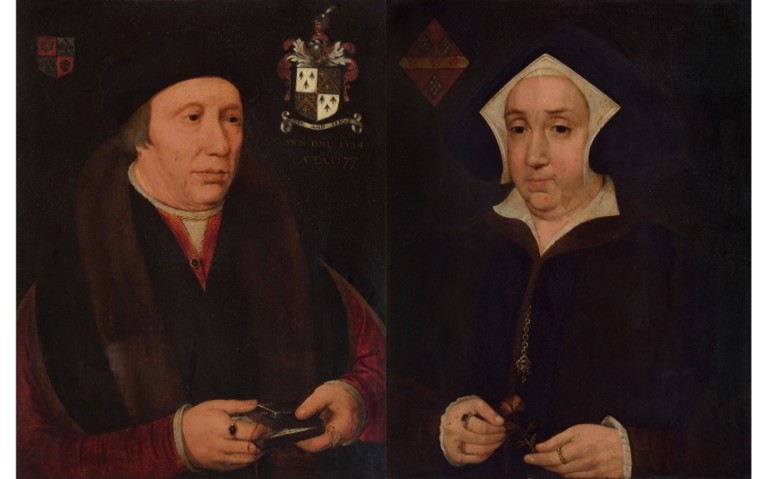
Robert Trappes was a London goldsmith, and Joyce was married successively to two wealthy Londoners. In 1549, at Banstead in Surrey, she married Henry Saxey, and their son William, after studying at Cambridge, was admitted to Gray’s Inn in 1576. After Henry’s death, Joyce married William Frankland (d. 1577), who left her substantial property in Hertfordshire; there were no children of Joyce’s second marriage. But in August 1581, Joyce’s only son William ‘youthfully venturing to ride upon an unbroken young horse, was thrown down and slain’. We know what happened next from a letter to Archbishop Whitgift from Alexander Nowell, the Dean of St Paul’s: "The mother fell into sorrows uncomfortable, whereof I, being of her acquaintance, having intelligence, did with all speed ride to her house near Hoddesdon to comfort her the best I could, and I did find her crying, or rather howling continually, ‘Oh my son, my son!’"
Not for nothing is Nowell, in his fundraising initiatives, described as ‘that notable beggar’ by a recent historian. Nowell’s account continues: "And when I could by no comfortable words stay her from that cry and tearing of her hair, God, I think, put me in mind at last to say: ‘Comfort yourself, good Mrs Frankland, and I will tell you how you shall have 20 good sons to comfort you in these your sorrows which you take for this one son.’ To which words only she gave ear, and looking up asked: ‘How can that be?’ And I said unto her: ‘You are a widow, rich and now childless, and there be in both universities so many poor toward youths that lack exhibition, for whom if you would found certain fellowships and scholarships to be bestowed upon studious young men, who should be called Mrs Frankland’s scholars, they would be in love towards you as dear children…and they and their successors after them, being still Mrs Frankland’s scholars, will honour your memory for ever and ever.’ This being said, ‘I will,’ quoth she, ‘think thereupon earnestly…’"
At her death, six years later, Joyce Frankland’s will left endowments to the value of £2000 to Gonville & Caius College, Cambridge. To Brasenose College, Oxford, she bequeathed property worth £1840, together with valuable plate, and her portrait which still hangs in the Hall there (Plate 3—B: Portrait of Joyce Frankland, from Brasenose College, Oxford).
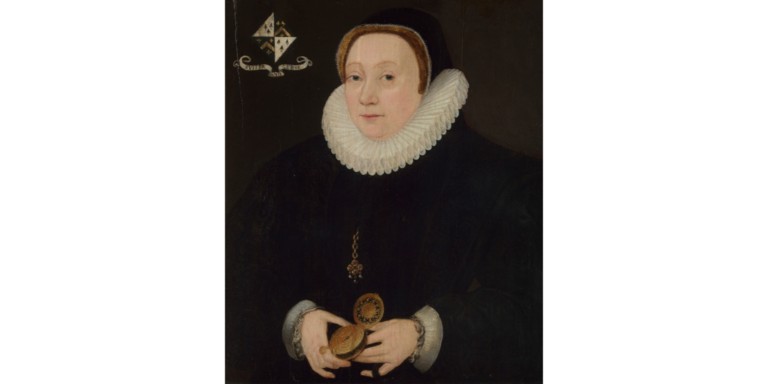 To Emmanuel, Joyce bequeathed £440, sensibly stipulating that it be used to purchase property yielding £20 a year. And Joyce also augmented benefactions that her mother Joanna had already made to Lincoln College, Oxford. A network of connections probably explains Joyce’s choice of colleges. Her mother had been an acquaintance, and possibly a patient, of the physician Dr Caius. Alexander Nowell had been a Fellow of Brasenose, and Emmanuel’s founder, Sir Walter Mildmay, was one of the overseers of her will. Joyce also provided £470 to found a free grammar school at Newport in Essex, which survives as the Joyce Frankland Academy. It has been estimated that during her life, and by her will, Joyce donated the huge sum of £4840 to educational causes.
To Emmanuel, Joyce bequeathed £440, sensibly stipulating that it be used to purchase property yielding £20 a year. And Joyce also augmented benefactions that her mother Joanna had already made to Lincoln College, Oxford. A network of connections probably explains Joyce’s choice of colleges. Her mother had been an acquaintance, and possibly a patient, of the physician Dr Caius. Alexander Nowell had been a Fellow of Brasenose, and Emmanuel’s founder, Sir Walter Mildmay, was one of the overseers of her will. Joyce also provided £470 to found a free grammar school at Newport in Essex, which survives as the Joyce Frankland Academy. It has been estimated that during her life, and by her will, Joyce donated the huge sum of £4840 to educational causes.
The infant Emmanuel College, still in its first decade, used Mrs Frankland’s bequest to buy the Hyde Farm Estate at Mitcham and Clapham, in Surrey, for £500.10s. Sir Walter Mildmay supplemented the Frankland legacy with £60 of his own money, and the College came up with the remaining ten shillings. The Hyde Farm Estate remained farmland, until it was developed for suburban housing in the later nineteenth and early twentieth centuries, and was then sold off piecemeal to tenants, under the provisions of various leasehold reform legislation of the post–war period.
So, out of a tragic accident, and a mother’s consuming grief, generations of students have benefited from Joyce Frankland’s generosity and have been, many times over, the twenty adopted offspring that she was once promised.
Barry Windeatt, Keeper of the College Pictures
9 September 2021
Construction work is progressing apace on the new development behind South Court. Building work is also going on in (Old) South Court itself—the demolition of the JCR, and its replacement with our new Social Hub and café. The original South Court JCR had been redesigned in 1996 under the aegis of the Master, Lord St John of Fawsley, who described its mid–1960s predecessor as ‘Grottsville’.
We have no photographic record of the old bar looking its sordid worst, but we may take the Master’s word for it that it was unloved, for anecdotal evidence suggests that many students held scathing opinions about the architecture of Old South Court in general. Yet at the time the court was planned and built, in the early–to–mid 1960s, it was hoped that its Modernist style would appeal to the hip undergraduates of the post–war era.
.jpg) In the college archives there is a trio of mounted designs, from 1963, for proposed interiors of small (L), medium (below R) and large (below L) South Court sets. The drawings were executed in a deliberately breezy style using chalk and watercolour on iridescent paper, and although unsigned, they were presumably produced by a member of the design team working under the direction of the principal architect of the building, Tom Hancock. It must be admitted that the sketches employ a degree of artistic licence, for they afford all the sets an airy spaciousness somewhat at variance with what was built, despite the incorporation of ingenious space–saving features, such as retractable sofa beds and banquette seating above the central heating conduits. The academic function of the rooms has also been played down by the artist, for although each room has been provided with a desk, it is in the form of a multi–use unit rather than a traditional piece of furniture, while textbooks are entirely absent from the fitted bookshelves.
In the college archives there is a trio of mounted designs, from 1963, for proposed interiors of small (L), medium (below R) and large (below L) South Court sets. The drawings were executed in a deliberately breezy style using chalk and watercolour on iridescent paper, and although unsigned, they were presumably produced by a member of the design team working under the direction of the principal architect of the building, Tom Hancock. It must be admitted that the sketches employ a degree of artistic licence, for they afford all the sets an airy spaciousness somewhat at variance with what was built, despite the incorporation of ingenious space–saving features, such as retractable sofa beds and banquette seating above the central heating conduits. The academic function of the rooms has also been played down by the artist, for although each room has been provided with a desk, it is in the form of a multi–use unit rather than a traditional piece of furniture, while textbooks are entirely absent from the fitted bookshelves.
.jpg) Interesting though the layouts and built–in furniture of the rooms are, it is the depiction of their moveable contents that is particularly fascinating. The inclusion of a record–player in all three sketches is a true sign of the times, reflecting the fact that popular music culture had penetrated even the groves of academe. (The word ‘groovy’, the epitome of 1960s youth–speak, is thought to derive from the spiral grooves on vinyl records.) Other features that the designers evidently thought would appeal are the coffee–making facilities, trendy swivel chairs and wall–mounted angle–poise lamps. The suggested colour–scheme of the furnishings, favouring bold orange and ochre tints accompanied by rather impractical white curtains and bouclé rugs, was certainly snazzy and possibly even groovy, but not necessarily conducive to studying. In fact, any of the rooms could pass for a music–loving teenager’s den, with only the wall–mounted oar in the large set offering a hint that we are looking at a study–bedroom in one of the most prestigious universities in the world.
Interesting though the layouts and built–in furniture of the rooms are, it is the depiction of their moveable contents that is particularly fascinating. The inclusion of a record–player in all three sketches is a true sign of the times, reflecting the fact that popular music culture had penetrated even the groves of academe. (The word ‘groovy’, the epitome of 1960s youth–speak, is thought to derive from the spiral grooves on vinyl records.) Other features that the designers evidently thought would appeal are the coffee–making facilities, trendy swivel chairs and wall–mounted angle–poise lamps. The suggested colour–scheme of the furnishings, favouring bold orange and ochre tints accompanied by rather impractical white curtains and bouclé rugs, was certainly snazzy and possibly even groovy, but not necessarily conducive to studying. In fact, any of the rooms could pass for a music–loving teenager’s den, with only the wall–mounted oar in the large set offering a hint that we are looking at a study–bedroom in one of the most prestigious universities in the world.
.jpg) Early designs for the new South Court Hub, which is promised to be ‘a beautiful light, open, area’, suggest that it will employ a style and colour palette far less consciously ‘with–it’ than those of the preceding JCRs, although future generations may of course judge otherwise. Whatever one’s opinion of Old South Court’s architectural qualities, though, either as an objective observer or as a former resident, there is surely no denying the period charm of the three sketches reproduced above, for they offer an evocative glimpse of Emma’s first encounter with the Swinging Sixties.
Early designs for the new South Court Hub, which is promised to be ‘a beautiful light, open, area’, suggest that it will employ a style and colour palette far less consciously ‘with–it’ than those of the preceding JCRs, although future generations may of course judge otherwise. Whatever one’s opinion of Old South Court’s architectural qualities, though, either as an objective observer or as a former resident, there is surely no denying the period charm of the three sketches reproduced above, for they offer an evocative glimpse of Emma’s first encounter with the Swinging Sixties.
Amanda Goode, Emmanuel College Archivist
17 August 2021
Having studied English at Emma, Ruth Zealey (2003) moved to live in Istanbul for 11 years with husband Mark (Sidney Sussex, 2003). She tells us about Turkish Iznik ceramics, and her journey learning the craft:
.jpg) In the mid–sixteenth century, just before Emma was founded, and while the rose of the Tudors still bloomed in England, it was the noble tulip that emblazoned the Ottoman empire in glazed cobalt glory, and later gave Istanbul’s most famous site its nickname: The Blue Mosque. Traditional blue and white chinaware travelling westwards along the Silk Road had inspired local artisans to create their own çini (chinaware), most famously in the workshops at Iznik (Nicaea). Here, the artists used local clays and pigments to introduce greens, and later an audaciously brilliant coral red, to the palette, depicting forms and flowers from their own frame of reference. Under the eager patronage of Sultan Süleyman, Iznikware became the décor of choice for mosques, palaces and even the mausoleum of Süleyman’s treasured wife, Hürrem [L: Tiles at the Mausoleum of Hürrem Sultan].
In the mid–sixteenth century, just before Emma was founded, and while the rose of the Tudors still bloomed in England, it was the noble tulip that emblazoned the Ottoman empire in glazed cobalt glory, and later gave Istanbul’s most famous site its nickname: The Blue Mosque. Traditional blue and white chinaware travelling westwards along the Silk Road had inspired local artisans to create their own çini (chinaware), most famously in the workshops at Iznik (Nicaea). Here, the artists used local clays and pigments to introduce greens, and later an audaciously brilliant coral red, to the palette, depicting forms and flowers from their own frame of reference. Under the eager patronage of Sultan Süleyman, Iznikware became the décor of choice for mosques, palaces and even the mausoleum of Süleyman’s treasured wife, Hürrem [L: Tiles at the Mausoleum of Hürrem Sultan].
But by the seventeenth century, demand had waned. As workshops closed down, artisans and apprentices moved on. The techniques of the trade, passed down, not written, were gradually lost from collective narrative memory. (Of course, each culture remembers differently. One night a close Turkish friend saw a vivid dream from God. "Write it down," I told her, "you must make a record so you don't forget!" "I am," she said, "I'm telling you!")
.jpg) Over the past 35 years, Turkish artists, historians and scientists have partnered in a multi–disciplinary endeavour to rediscover and reproduce Iznik’s lost formulas and forgotten techniques, and to reintroduce çini to the modern cultural conversation [R: Stylized tulips at the Mausoleum of Hürrem Sultan]. Today, travellers in Istanbul admire the Iznik Foundation’s newly commissioned tile panels, throughout the Istanbul Underground (Metro) Network (https://www.iznik.com/).
Over the past 35 years, Turkish artists, historians and scientists have partnered in a multi–disciplinary endeavour to rediscover and reproduce Iznik’s lost formulas and forgotten techniques, and to reintroduce çini to the modern cultural conversation [R: Stylized tulips at the Mausoleum of Hürrem Sultan]. Today, travellers in Istanbul admire the Iznik Foundation’s newly commissioned tile panels, throughout the Istanbul Underground (Metro) Network (https://www.iznik.com/).
Just after we moved to our first Istanbul flat, a neighbour invited me over. I prised off my shoes, slid into the proffered slippers, and tiptoed into her spotless salon. As we sipped our Turkish coffee, she told me about a free çini course run locally for women by the borough council, to encourage lifelong learning and entrepreneurship. A month or so later, with very rudimentary Turkish, I joined the class, and added lale, gül and at k?ll? f?rça (tulip, rose and horse hair brush) to my vocabulary list. I was the odd foreigner in a group of welcoming, warm Turkish ladies, later moving to study at a private workshop, under the tutelage of a local teacher.
Artistically speaking, the highlight was having my work feature in an exhibition in Istanbul’s historic quarter. Our pieces were fittingly displayed, reverently below the original ?znik tiles which clothe the mosque complex there. But the true privilege was being embraced into the community as an apprentice. Studying a local art form feels like being invited in to the heart and soul of your new home culture. You take off your shoes and humble yourself, leaving behind your old ways, and assuming the new shape and style graciously offered to you. My Istanbul friends gave me the name ‘Gül’ (Rose), but I return to the UK bearing a fond affection for the tulip too.
10 August 2021
The gold medal won by former Emma student Anna Kiesenhofer, in the ‘Tokyo 2020’ Olympics cycling road–race, feels long overdue, for it is more than a century since an Emmanuel member took home an Olympic medal—our solitary medal, until now.
The victor on that occasion was Norman Henry Pownall Whitley, who won a silver at the London Games of 1908. Whitley, who graduated in 1904 with a degree in Medieval & Modern Languages, played hockey for Emma in winter and cricket in summer, but the sport at which he really excelled was lacrosse. This fast–paced ball game, which originated in Canada, and involves the wielding of a stick with a net on the end, has never been much–played anywhere in Britain, with the exception of the grammar schools of the north–west of England, which were a hotbed of lacrosse. It was during his years at two of Manchester’s schools, that Norman Whitley honed his skill at the sport.
.png) There was no lacrosse club at Emma when Whitley matriculated, but there was a fledgling one by the time he left, no doubt the result of the success at university level achieved by both
There was no lacrosse club at Emma when Whitley matriculated, but there was a fledgling one by the time he left, no doubt the result of the success at university level achieved by both .png) Whitley and George Page, who had come up to Emma in 1902. Both men won half–blues and Whitley captained the Cambridge team in the first Varsity lacrosse match ever played, in 1903 (the Light Blues won 19–6). The Emmanuel Lacrosse Club [L: EHC 1902 with Whitley standing far right] was formed in 1904, probably in Lent Term, although a surviving account book shows that during its first three years the club was dormant [R: ELC cash book 1904]. In 1907, however, it paid £5 to the Cambridge University Lacrosse Club—presumably for use of its facilities—and also spent £4 17 6 with Gray & Sons, a Cambridge firm that supplied bats and racquets for various sports. Similar outlays were made in the following two years, but at the end of Easter Term, 1909 the club folded.
Whitley and George Page, who had come up to Emma in 1902. Both men won half–blues and Whitley captained the Cambridge team in the first Varsity lacrosse match ever played, in 1903 (the Light Blues won 19–6). The Emmanuel Lacrosse Club [L: EHC 1902 with Whitley standing far right] was formed in 1904, probably in Lent Term, although a surviving account book shows that during its first three years the club was dormant [R: ELC cash book 1904]. In 1907, however, it paid £5 to the Cambridge University Lacrosse Club—presumably for use of its facilities—and also spent £4 17 6 with Gray & Sons, a Cambridge firm that supplied bats and racquets for various sports. Similar outlays were made in the following two years, but at the end of Easter Term, 1909 the club folded.
.jpg) Norman Whitley continued to play lacrosse after graduating, captaining the All–England team, and he was selected for the British Olympic squad in 1908 [L: Olympic Lacrosse, GB vs. Canada 1908]. The event only attracted two competing teams, the other being the hot favourites: Canada. The match was played on 24 October, an unseasonably cold day during which hail fell at one point, but despite this the official match report described the event as ‘the best exposition of lacrosse ever given in this country, and…the English side was by far the strongest ever put into the field’. Not all the goal–scorers are named in the report, so we do not know whether Whitley, who played at centre, was among them, but he is reported as having ‘got the best of the face’ in the third quarter. The final score was 14–10 to the Canadians, but the British team could feel proud of their performance, for ‘it was the finest effort our own players have yet made against any Canadian team’.
Norman Whitley continued to play lacrosse after graduating, captaining the All–England team, and he was selected for the British Olympic squad in 1908 [L: Olympic Lacrosse, GB vs. Canada 1908]. The event only attracted two competing teams, the other being the hot favourites: Canada. The match was played on 24 October, an unseasonably cold day during which hail fell at one point, but despite this the official match report described the event as ‘the best exposition of lacrosse ever given in this country, and…the English side was by far the strongest ever put into the field’. Not all the goal–scorers are named in the report, so we do not know whether Whitley, who played at centre, was among them, but he is reported as having ‘got the best of the face’ in the third quarter. The final score was 14–10 to the Canadians, but the British team could feel proud of their performance, for ‘it was the finest effort our own players have yet made against any Canadian team’.
Whitley was called to the Bar in 1907, and practised in the Northern Circuit until 1914. During the First World War he fought with the Manchester Regiment, and reportedly met his future wife, Florence Erskine, in romantic circumstances, being nursed by her after his wounding at Gallipoli in 1915. He was awarded the Military Cross in 1916, and his promotion to captain in the same year was noted by Alistair Potter (Emma 1901) in a letter to the Senior Tutor: ‘Young N.H.P. Whitley seems to be doing pretty well for himself. I noticed he recently got a staff appointment out here somewhere, or in Salon or Mesop’. After the war, Whitley entered the colonial legal service and went on to be a Judge and Chief Justice, his postings including Penang, Singapore, the Federated Malay States and Uganda.
In the New Year Honours of 1941, Whitley received a knighthood, and later in the same year he obtained a divorce from his wife. This had repercussions a decade later, when his son Peter married Lady Mary Cambridge, a great–niece and god–daughter of Queen Mary, for the latter’s strict adherence to Court etiquette regarding divorcees prevented her from attending the wedding. The bride did, however, wear the splendid diamond and pearl bow brooch, which was her wedding gift from Queen Mary. Sir Norman Whitley died at Cape Town in the spring of 1957, but his Olympic silver medal presumably remains a cherished family heirloom.
Amanda Goode, College Archivist
10 August 2021
As we look forward to the start of term, and welcoming a new cohort of freshers into the college community, John Newman (1964) has shared with us his memories of joining Emmanuel:
.png)
It was a very fortuitous accident that I came to be a member of Emma. My Headmaster summoned me to his study and said “here is your application to Emmanuel College, Cambridge”. Obedient in those days, I replied “yes, sir” and duly applied. That year (1963) Emmanuel was experimenting with entries based on AL results, and I struck very lucky. This unlikely sequence of events has led to my having been a member of a truly caring community for nearly sixty years now—something I greatly value—and my three years as an undergraduate, and one for PGCE, were glorious.
Emmanuel is rightly a place with a focus on serious study, but it is so much more than that. It is a beautiful place, and I still get a buzz coming through the college gates and especially again seeing Front Court, the Chapel, or the Paddock [Above L: John recently, in Front Court]. There was such a range of activities within the college—in my case including the Chapel and its Choir, the orchestra, the 'Messiah', formal debates, and a little occasional sport. There was also so much that we in Emmanuel did, outside formal college structures—I went punting, learned a little croquet, regularly went singing in a mental hospital, tried to keep my ancient bike roadworthy (indeed even with brakes!), and there was much informal discussion that was so important to me in working out, and being tested on, my beliefs. I met such a range of people in formal hall (and the food was pretty good too). The staff I met were unfailingly kind and helpful [Above R: John in the Paddock 'off to the Laundry' c. 1965].
I went down in 1968, but I love coming back, and my wife was made so welcome that she felt an honorary member of the college. Truly, I am privileged to be a member of such a wonderful community: "floreat Emmanuel!"
13 July 2021
John Venn’s Alumni Cantabrigienses, the multi–volume printed index of Cambridge students and dons compiled in the early twentieth century, contains biographical entries for all known pre–1901 members of the University.
.png) Such a monumental work of scholarship inevitably contains some errors and omissions, but a record of corrections is maintained at the University Archives. It may be that another amendment is required in the case of Thomas Scot(t) [Below R], Parliamentarian and regicide, one of the 59 Commissioners who signed and sealed the death warrant of King Charles I, in January 1649 [L}.
Such a monumental work of scholarship inevitably contains some errors and omissions, but a record of corrections is maintained at the University Archives. It may be that another amendment is required in the case of Thomas Scot(t) [Below R], Parliamentarian and regicide, one of the 59 Commissioners who signed and sealed the death warrant of King Charles I, in January 1649 [L}.
Venn’s entry for the Scot the regicide gives no dates for his matriculation or graduation, nor does it assign any collegiate membership to him, simply recording that he was ‘Said to have been educated at Cambridge’. Venn also contains the following, inconspicuous, entry: Scott, Thomas. Adm. Pens. at EMMANUEL, Apr. 6 1619. Matric. 1619; B.A. 1622–23; M.A. 1626. One of these names R[ector] of St Clement, Ipswich, Suffolk, 1638–40. Venn’s tentative suggestion that Emmanuel’s Scott may have gone on to be a provincial clergyman, appears to have had the effect of forestalling any speculation that he might have been the regicide, but evidence suggesting that indeed he was, has recently come to the college’s notice.
.png) Thomas Scot’s early life is scantily documented, and he only really enters the public sphere in the 1640s. A staunch Parliamentarian, he was elected MP for Aylesbury in 1645. He became a prominent member of the Council of State during the Commonwealth, where he was given particular responsibility for setting up a government intelligence agency. He opposed the establishment of the Protectorate, regarding it as a sell–out, but after its collapse in the spring of 1659, he again wielded considerable political influence.
Thomas Scot’s early life is scantily documented, and he only really enters the public sphere in the 1640s. A staunch Parliamentarian, he was elected MP for Aylesbury in 1645. He became a prominent member of the Council of State during the Commonwealth, where he was given particular responsibility for setting up a government intelligence agency. He opposed the establishment of the Protectorate, regarding it as a sell–out, but after its collapse in the spring of 1659, he again wielded considerable political influence.
The evidence connecting Scot with Emmanuel is to be found in a letter, written on 5 September 1659, by William Mewe, rector of Eastington in Gloucestershire, to his friend Richard Baxter. Both were Puritan clerics who had achieved a degree of prominence during the Civil War and its aftermath, but neither of them had supported the regicides. Mewe was an Emma man, who matriculated in 1618 and graduated MA in 1626, the same year as Emmanuel’s Thomas Scot. In his letter to Baxter, Mewe refers to various ‘Triobulary’ (literally, three ha’pence, i.e. worthless) politicians then governing the country, first mentioning Sir Henry Vane, before continuing: ‘Mr Scott was my Chamberfellow & wee Comenc’d M of Arts together, & many Letters wee have [ex]Chang’d’.
The context of Mewe’s remark makes it clear that he is referring to Thomas Scot, the regicide, who worked closely with Sir Henry Vane on intelligence matters. A recent edition of Richard Baxter’s voluminous correspondence includes Mewe’s letter, and the significance of his comment about Scot had been noted by the editors, who in a footnote gave the substance of the two Venn entries for Thomas Scot, leaving readers to draw for themselves the ineluctable conclusion that they must relate to the same individual.
.jpg) In April 1660, with the return of the King in Exile, Charles II, becoming increasingly inevitable, Scot fled to Brussels, where he was soon recognised and apprehended (or, some sources state, gave himself up following a false promise of mercy). [L: Engraving of 'Cromwell’s cabinet consorting with the Devil']
In April 1660, with the return of the King in Exile, Charles II, becoming increasingly inevitable, Scot fled to Brussels, where he was soon recognised and apprehended (or, some sources state, gave himself up following a false promise of mercy). [L: Engraving of 'Cromwell’s cabinet consorting with the Devil']
During his imprisonment in the Tower of London, he wrote a detailed confession about his time as an intelligencer, but it was not enough to save him. On 17 October 1660, having been found guilty of treason, Scot suffered execution by hanging, drawing and quartering, having first made an uncompromising speech in which he declared that he died ‘in a Cause, not to be Repented of, I Say, Not to be Repented of’.
Thomas Scot was a man of intelligence, ability and influence, and the importance of his contribution to Interregnum politics is not in question. Whether his connection with Emmanuel should be considered a credit to the college, though, or a blot upon its escutcheon, must be a matter of opinion.
Amanda Goode, College Archivist
30 June 2021
May Balls are such a bit part of College life, and the last years have meant that we have not been able to hold our regular commemorations of the end of term.
Here, we look back at the May Ball and May Races from 1921, from an album kept by Broughton (William) Twamley (1919), which was donated to the College Archives in 2018, by his daughter Delia.
%20.jpg)
Emma May Ball, 1921
.jpg)
May Races 1921: the Emmanuel Pagans’ Club Barge, at Morley Gardens
The Pagans’ principal activity was playing cricket, but they also organised a barge every year at the May Races. Their report in the College Magazine from 1920/21 informed readers that: ‘during the May Races the Club Barge performed its usual functions as a grandstand and a café, not to speak of rescuing the shipwrecked and towing the idle’.
30 June 2021
Books in Emmanuel’s Graham Watson Collection bear witness to the fascination of nineteenth-century armchair-travellers with places far beyond the familiar haunts of tourists to the Continent seeking out antiquities and picturesque beauty. There are books on the landscapes, peoples, and flora and fauna of regions from North and South America to China and Australia, and from the polar regions to Africa. Among the last is a rare book of superb lithographs: The Victoria Falls: Zambezi River (London, 1865). [Plate 1]
.jpg)
Plate 1. The ‘Leaping Water’ or Westernmost Cataract;
How astounding must these images have been to their early viewers, depicting with such meticulous detail this recently-discovered natural wonder of the world, known to those who live by them as ‘Mosi-oa-Tunga’ (Smoke that Thunders). Now known to be the most extensive sheet of falling water in the world, the Victoria Falls are nearly twice the height of the Niagara Falls and around half a kilometre wider. The titlepage records that the views were ‘Sketched on the Spot by T. Baines, Fellow of the Royal Geographical Society’. So many published views and tours of picturesque beauty since the eighteenth century had been billed as ‘Sketched on the Spot,’ and these views from Africa bring together a long tradition of admiration for waterfalls and vertiginous landscape views, but now transposed to a much less familiar context. [Plates 2 and 3]
.jpg)
.jpg)
Plate 2. The Falls from the Westernmost End of the Chasm; Plate 3. Great Western or Main Fall;
Dead at 55, Thomas Baines, artist and explorer, was one of those intrepid Victorians who packed enough adventure and experience for a number of lifetimes into his own life. Born in King’s Lynn in 1820 into a family of both amateur and professional artists, he was apprenticed to paint coats-of-arms on the sides of carriages. But not for long. In 1842 he left for Cape Town, where he used his writing and painting to fund his exploring. He served as official artist-draughtsman to British forces in the Cape Frontier War (1851-2) and his work was used in the Illustrated London News. In 1855 he joined an expedition to North-West Australia, where the Baines river is named after him, and where he made a number of paintings. In 1857 he joined Livingstone’s expedition to the Zambezi, and his paintings of the journey were exhibited in London and Dublin. In 1861 he joined an expedition from South-West Africa to the Victoria Falls, and Emmanuel’s collection includes his Explorations in South West Africa (1864) recording this incredible journey. Baines surveyed the whole expedition route, collected botanical specimens for Kew, and made many sketches and paintings, including the originals for his book on the Victoria Falls.
Even today, glutted as we are with images, the draughtsmanship of Baines’s depictions conveys the awe-inspiring scale of the Falls and the sheer immensity of falling water. [Plates 4 and 5]
.jpg)
.jpg)
Plate 4. Herd of Buffalo Driven to the Edge of the Chasm; Plate 5. Centre Rock Fall and the Eastern Cataract;
Relatively little of Baines’s prolific output of paintings and sketches was published in his lifetime, but he was one of the first to describe the regions of the Mashona and Matabele. His concern in these images of the ‘Smoke that Thunders’ to record in six or so views the whole extent of the Falls from the west to the east side shows his scrupulous commitment to truth of record. [Plates 6 and 7]
.jpg)
.jpg)
>Plate 6. The Falls from the East End of the Chasm to Garden Island; Plate 7. The Falls from the Narrow Neck near the Eastern Headland of the Outlet
Thomas Baines died in Durban in 1875 while preparing for another long trip into the interior. He had certainly left those coats-of-arms on carriage-doors very far behind him in every way, and was among the leading topographical artists of the mid-nineteenth century.
Barry Windeatt (Keeper of Rare Books)
Images by Helen Carron (College Librarian)
16 June 2021
At Emma, we take pride in how the College combines centuries of tradition and heritage, with modern innovation. Following our story of the eight–hundred–year–old processes of brick–makers Petersen Tegl, we now look at Constructional Timber Manufacturers (CTM), and their innovative approach to timber structures.
.png) Constructional Timber Manufacturers’ Douglas Fir 'Glulam' is already in place in the roof of the new bar in the extension to Furness Lodge, and another frame for the hub in South Court (L) will be installed soon.
Constructional Timber Manufacturers’ Douglas Fir 'Glulam' is already in place in the roof of the new bar in the extension to Furness Lodge, and another frame for the hub in South Court (L) will be installed soon.
Founded in 1979 in Yorkshire, Constructional Timber Manufacturers have led the way in developing this ‘Glulam’ technique of timber manufacturing. Glulam stands for glue–laminated timber. It is made with multiple layers of solid wood lumber bonded together with high–strength adhesive to form a single structural unit. Since first pioneering this method some decades ago, CTM have continued to work at the forefront of developing and improving the process. Their Hundegger K2 machine has been described as setting new boundaries in the production of timber, because of its efficiency and precision.
.jpg) There are many reasons why Glulam is quickly overtaking the old ‘brick–and–block’ techniques in popularity. For one, it means that buildings can be assembled in a fraction of a time. Indeed, this will be evident to anyone who has been keeping up with the progress of work at the Emma site!
There are many reasons why Glulam is quickly overtaking the old ‘brick–and–block’ techniques in popularity. For one, it means that buildings can be assembled in a fraction of a time. Indeed, this will be evident to anyone who has been keeping up with the progress of work at the Emma site!
It is also very sustainable, something which we are deeply mindful of in the construction of all our new buildings at Emma. All of the wood processed by CTM is FSC–certified and, as with bricks, an additional benefit of the Glulam lamination process means that no other synthetic cladding is required. Not having to install this additional cladding layer is cost–effective and means that the natural aesthetic value of the material itself can be appreciated where it is visible.
We are proud to be supporting a British–based firm who are at the forefront of pioneering the Glulam technique. And we are amongst good company too—CTM have provided timber for a number of stunning projects for high–profile British institutions, including the Old Vic Theatre in Bristol, RSPB’s Sherwood Forest project, and our neighbours at the Perse School in Cambridge. We are excited that our new buildings are sitting amongst these projects as an example of the glulam timber approach!
16 June 2021
Tucked away in the cupboard below one of the bookcases housing the Graham Watson Collection of hand-coloured books in Emmanuel Library is a set of remarkable books from the 1940s.
‘Britain in Pictures’ (BIP), published by Collins, was a series of books appearing between 1941 and 1950 as a significant contribution to wartime propaganda. The blurb on the first dust-jackets declared ‘The English have never been good at describing themselves or their ways, either for their own benefit or the benefit of others’. Designed to boost morale at home, and to represent Britain winningly to potential supporters in the USA and elsewhere, the books set out to record the British way of life, and Britain’s contribution to arts and science. There were BIPs on Britain’s history, institutions, literature, art and crafts, social life, sports and character, as too its plants and animals. The choice of subjects implicitly champions the role of individuals within traditions, with BIPs on British scientists, engineers, botanists, polar explorers, mountaineers, seamen, merchant adventurers, furniture-makers.
Three million copies had been sold by 1951.
The books were the brainchild of Hilda Matheson (1888-1940), a woman of phenomenal energy and intellect who had been recruited for ‘special work’ by the new Ministry of Information after a colourful career in intelligence and the infant BBC (where her tendency to favour Lord Reith with her frank advice had led to an early parting of ways). Matheson’s idea – realised by others after her early death – was to recruit the best of contemporary writers to describe Britain and its people’s achievements. If this was ‘propaganda,’ it was also the most eloquent case for Britain as a free society. Not everyone was tempted by Matheson’s invitation: Virginia Woolf wrote to a friend: ‘she asked me to write some damned book for some damned series. It was to be patriotic; at the same time intellectual; also badly paid’.
.jpg)
Plate 1: John Piper, British Romantic Artists, 1942
The series was eventually published in 126 volumes, each with their uniform trademark covers in block colours and with a strikingly simple jacket illustration (Plate 1). The design of the books and their distinctive covers was the work of a group of Austrian-Jewish refugees in London. These were also approachably slim volumes, usually of around 48 pages including generous illustration. In total, the 126 volumes contained 1040 colour plates and 2869 black-and-white illustrations (which were a nightmare to access in wartime). As such they present a library of what the 1940s valued in British art and illustration both of the past and of the present.
.jpg)
.jpg)
Plate 2: ‘Jockeys at the Start’, from British Sport 1941; Oil painting by Sir Alfred Munnings; Plate 3: ‘Kemp Town, Brighton’, from English Cities and Small Towns, 1943; John Piper, Brighton Aquatints
BIPs can embrace all aspects of British life. The BIP on British Sport (1941) includes the excitement at the start of a horse-race (Plate 2). John Betjeman’s English Cities and Small Towns (1943) has a characteristic John Piper street-scape of the elegance of Brighton (Plate 3). British Weather (1946) includes – how could it not? – a variety of striking pictures (Plate 4), while The English at the Seaside (1947) comments phlegmatically that in the new age of the hydrogen bomb one might as well be at the seaside as anywhere (Plate 5). George Orwell’s remarkable BIP essay on The English People (1947) includes contemporary paintings of soldiers and civilians enjoying a peaceful evening (Plate 6) and the hop-picking in Kent that was the working summer holiday of generations of East Enders (Plate 7).
.jpg)
.jpg)
.jpg)
Plate 4: ‘Sudden Storm’, from British Weather, 1946; Paul Nash, 1918; Plate 5: ‘Cromer Beach, 1946', fromThe English at the Seaside, 1947, Oil painting by Robert Greenham; Plate 6: ‘Evening by the River: Salisbury in Wartime’, fromThe English People, 1947, Watercolour by Edward Ardizzone, 1940
Wartime experience inevitably impinges. English Social Services (1941) is illustrated by a Henry Moore drawing in which some of Moore’s characteristic reclining figures appear to have taken refuge in an air-raid shelter (Plate 8). Aircraft and the skies are a constant presence, whether it is RAF bombers en route to Dunkirk (Plate 9), or a German daytime bombing raid on London, with a red trolley-bus helpless in the centre of the picture (Plate 10). A sketch by Eric Ravilious is uniquely atmospheric in representing clouds seen from a plane (Plate 11). In her BIP on Battlefields in Britain (1944) the Civil War historian Dame Veronica Wedgwood ends her account of the field of Culloden by echoing a poem of Stephen Spender: ‘With it the tale of fighting on British soil comes to an end, to re-open in a different element close on two hundred years later, when those few who, in the skies above this island saved the civilisation of the world, outfought and outmanoeuvred the German attack and “left the quivering air signed with their honour”’ (Plate 12).
.jpg)
.jpg)
.jpg)
.jpg)
.jpg)
Plate 7: ‘In the Country: Hop Picking near Maidstone, Kent’, from The English People, 1947, Watercolour drawing by John Minton, 1945; Plate 8: ‘A London Tube Air Raid Shelter, Sleeping in Bunks’, from English Social Services, 1941, Watercolour and chalk drawing by Henry Moore; Plate 9: ‘Defiants en route to Dunkirk, May 1940’, from Britain in the Air, 1944, Oil painting by Frank Wootton; Plate 10: ‘It Happened to Us: Daylight Raid on London 1941’, from The Londoner, 1944, Oil painting by Carel Wright); Plate 11:‘Clouds above and below: View from the cockpit of a Moth’, from British Weather, 1946, Unfinished sketch by Eric Ravilious, c. 1942; Plate 12:‘Runway Perspective’, from Britain in the Air, 1944, Watercolour by Eric Ravilious, 1941
Yet although the series title ‘Britain in Pictures’ implied picture books, Matheson’s determination to recruit the best writers meant that the text of many of the volumes was exceptionally good. Prominent novelists and poets agreed to write, including Edmund Blunden, Elizabeth Bowen, Graham Greene, Rose Macaulay, Vita Sackville-West and Edith Sitwell. Cecil Beaton wrote on British Photographers and Michael Ayrton on British Drawings. The great Bishop Bell of Chichester wrote on The English Church. The BIP on British Cartoonists, Caricaturists and Comic Artists was written by the wartime cartoonist David Low, who knew he was on the Gestapo’s list for ‘elimination’ in the event of the German conquest of Britain (Plate 13). Experts in all fields were recruited for their ability to write cogently for a mass audience: ‘dumbing down’ is a dismal compromise still many decades in the future.
.jpg)
.jpg)
Plate 13: ‘The Man Who Lit His Cigar Before The Royal Toast’, from British Cartoonists, 1942)—Drawing by H. M. Bateman; Plate 14: Labour Party Poster 1929, from The Labour Party , 1949, Lithograph by G. Spencer Pryse
Circulation figures are intriguing. Any bets on the bestselling volume in this series when Britain’s very existence was at stake? By a wide margin it was The Birds of Britain, although Life among the English, Wild Flowers in Britain and The English Poets were the next best-selling titles. Prizes for the biggest flops go to the three books on The Labour Party (Plate 14), The Liberal Party and The Conservative Party – the third, fourth and sixth worst-selling volumes.
Once a common sight in secondhand bookshops and charity shops, the ‘Britain in Pictures’ series is now collected by enthusiasts. Not ‘rare books’ perhaps, but highly distinctive ones from a unique moment.
Barry Windeatt (Keeper of Rare Books)
Images by Helen Carron (College Librarian)
15 June 2021
Happy Pride Month! As the ECSU LGBT+ Officer, Pride Month is one of the most exciting times of year for me, as it’s a chance for the LGBT+ community at Emma to come together and celebrate with the college. Particularly at the end of what has been a very difficult year to feel connected, it has been lovely to see each other in person again for Pride Month. It seems the light at the end of the tunnel has a rainbow filter this year!
.jpg) We’ve been very lucky that restrictions have been eased for June and have tried to take full advantage of that with as many in-person events as possible. We held an ‘LGBTea and Cake’ on the Paddock, where students enjoy the sun with some suitably rainbow–coloured cake. At the end of the month I’m hoping to hold another social event, after everyone has finished their exams. It’s been lovely to have events with students from all year groups, where we can rekindle connections that might have been lost after spending the last year online.
We’ve been very lucky that restrictions have been eased for June and have tried to take full advantage of that with as many in-person events as possible. We held an ‘LGBTea and Cake’ on the Paddock, where students enjoy the sun with some suitably rainbow–coloured cake. At the end of the month I’m hoping to hold another social event, after everyone has finished their exams. It’s been lovely to have events with students from all year groups, where we can rekindle connections that might have been lost after spending the last year online.
Another major milestone this month has been setting up a ‘Gender Expression and LGBT+ Fund’, so transgender and non–binary students can access specialised financial support from the college.
This term has been a real reminder of the importance of community as a queer person, and the joy that can come from that—particularly at Emma, where there is such a vibrant, diverse and welcoming queer student body. This Pride has, in my mind, really been about reconnecting, and finding community where you might not have seen it before.
I hope any LGBT+ alumni have a wonderful Pride Month, and hope that all members of the Emma community have a restful June!
Dottie Birss ECSU LGBT+ Officer
2 June 2021
The Microcosm of London, published to subscribers between 1808 and 1810, is one of the most beautiful of Emmanuel’s hand-coloured books, but like many such books it derives from a collective effort and does not have a single ‘author’. It was the first major project of Rudolph Ackermann, a German immigrant and canny entrepreneurial publisher who set up business in the Strand. The Microcosm has 104 plates, largely of interior views, engraved from the elegant originals by Auguste Charles Pugin, a French immigrant. But because Ackermann felt Pugin’s architectural views needed something extra, he brought in Thomas Rowlandson – who with James Gillray was the master caricaturist of the period – to populate the views with characterful, even cartoonlike, figures. Pugin was reportedly not best pleased, but their joint work was then etched by Ackerman’s engravers and, once printed, would be parcelled out for hand-colouring, often in piece-work by whole families working from home – no two plates of the same view are quite the same. The text accompanying the plates was also the work of two authors. One thousand copies were produced for subscribers, and in 1810 the three-volume set cost 15 guineas – equivalent to over £1000 today.
.jpg)
.jpg)
Plate 1: ‘Fire in London, 3 March 1791, at the Albion Flour Mill’; Plate 2: ‘The British Institution’;
Ackermann likens the reader’s experience of the Microcosm to learning the language before visiting a country, preparing for visits to London, or substituting if the depicted places are never seen. London is represented as a prosperous, well-regulated city, celebrating the interaction of its culture and its commercial success. The text to a striking plate of a disastrous fire in 1791 in a flour mill south of Blackfriars bridge (Plate 1) – no loss of life but huge damage to property – largely analyses, with tables of figures, the recent boom in the insurance business in London. Many plates focus on national and civic institutions (Parliament, British Museum, Guildhall), finance and commerce (Bank of England, Stock Exchange, Lloyd’s), theatres, law courts and churches. Gestures to diversity include views showing mass at the Roman Catholic chapel in Lincoln’s Inn Fields, and worship in the synagogue in Duke’s Place and in a Quaker meeting house. One very new national institution was the just-founded British Institution (Plate 2), where budding artists might learn by copying Old Masters loaned for the purpose ‘from the collections of the nobility and gentry’. It is an apt image of the Regency enthusiasm for picture-making by both male and female painters.
.jpg)
Plate 3: ‘Bartholomew Fair’;
Less fortunate Londoners come into the Microcosm’s focus through its plates depicting charitable institutions, courts, prisons and such places of popular entertainment as Bartholomew Fair – held near Bart’s Hospital and Smithfield – where the earthy revels – ‘some hugging, some fighting, others dancing’ – take place below Pugin’s ethereal moonlight (Plate 3). Its views of the underside of London life give the Microcosm a special insight and roundedness.
.jpg)
.jpg)
Plate 4: ‘The Asylum, Lambeth’; Plate 5: ‘Bridewell’;
.jpg)
.jpg)
Plate 6: ‘Middlesex Hospital’; Plate 7: ‘The Workhouse, St James’s parish, Westminster’;
.jpg)
Plate 8: ‘St Luke’s Hospital for Lunatics, Old Street’;
Some of Pugin’s interiors show charitable provision for poor women. The ‘Asylum or House of Refuge’ in Lambeth (Plate 4) is intended ‘for the reception of friendless and deserted girls’, where they will be trained for employment in service from 15 and taught to read. The young women are shown in uniform ‘at their repast’, being visited by some well-dressed benefactors. The Pass-Room at Bridewell Prison (Plate 5) shows ‘this room appointed for one class of miserable females’, where paupers were confined before being transferred back to their home parishes. The view inside the Middlesex Hospital (Plate 6) opens an interesting window on to a women’s hospital ward of this period. Pugin’s view inside a workhouse (Plate 7), where men and women inmates were segregated, shows the women’s common-room, peopled with Rowlandson’s caricature figures. Much bleaker still is the interior of St Luke’s Hospital for Lunatics in Old Street (Plate 8), where Pugin’s focus on the palatially grand architecture contrasts with the small figures of the patients and their frantic gestures.
.jpg)
.jpg)
Plate 9: ‘Cold Bath Fields Prison: The Water Engine’; Plate 10: ‘The Pillory at Charing Cross’;
Another group of plates illustrate the legal process through courts and prisons. The scene at Cold Bath Fields Prison (Plate 9) shows the next two prisoners arriving to take the place of the pair who have just completed their hour of hard labour at ‘the water engine’. A rare street scene (Plate 10) depicts two convicts serving their time in the pillory at Charing Cross, where they are at the mercy of the mood of a large crowd. The view inside Newgate Prison (Plate 11) shows the interior of the prison chapel during a service on the Sunday preceding the next hanging of convicted criminals. In the middle of the picture is an enclosure called the Dock. Here those condemned to hang in the coming week, including several women, are obliged to sit round a coffin while ‘a suitable sermon called the condemned sermon’ is being preached.
.jpg)
Plate 11: ‘Newgate: The Prison Chapel’
Barry Windeatt (Keeper of Rare Books)
Images by Helen Carron (College Librarian)
1 June 2021
Faced between having to deploy healthcare professionals abroad, and keeping them locally to help fight the COVID–19 crisis, what do you do? Emma graduate Cristina 'Krees' Castaneda (2015) finds it’s not that easy to draw the line:
.jpg)
Whenever you fly commercially, you often hear of this safety instruction reminding adults: 'In case of emergency, air masks will drop from the ceiling. If you are traveling with a minor, please put on your own mask before helping the minor'. It’s a reminder that for us to effectively care for others, we need to care for ourselves first.
In my two decades working with the Philippine international healthcare recruitment sector—my company deploys an average of a thousand medical professionals to the United Kingdom every year—I find myself having to toe the line countless times. This dilemma reached a critical point at the height of the pandemic, when we were working on deploying some 800 nurses to the National Health Service. As cases multiplied, the Philippine government temporarily suspended the deployment of healthcare workers, citing the shortage of medical professionals locally, and the need to secure their safety.
There is no doubt the local healthcare system needs nurses badly, with 13,000 medical workers going abroad yearly. In many parts of the world, healthcare workers are also needed—globally, we are already short by 7.2 million.
As a business professional and leader, I’m inclined to pay attention to the bottom line. I have a commitment to my clients, and I must deliver. But running a business is not always about profit. Beyond profitability, a leader should also have a sense of accountability and sustainability.
Reflecting on one of the important lessons I learned from Cambridge—to be an effective leader, what codes of conduct am I held to account—a professional code? a moral code? or laws and regulations? —it made me think: Should I prioritize sending nurses abroad when the bigger fight is here in my own backyard? How can we help other countries when we’re also struggling back home?
I wanted to find a win–win solution, that would enable me to help Filipino nurses find employment overseas, but also ensure our local hospitals do not end up crippled in the process.
My team and I started working with hospitals. I arrange for these institutions to hire nurses that can train and gain experience with them for a few years. These nurses get valuable training and experience with a premier hospital, while preparing for the UK NMC registration requirements and, later, getting hired at a UK hospital. Meanwhile, the partner hospitals can fill their vacancies, and are given enough time to train and on–board fresh graduates. This arrangement is well coordinated, so that the hospital’s workforce isn’t impacted, while ensuring that we don’t hinder individuals from finding better opportunities abroad.
Now that the country’s COVID–19 vaccination program has started, there’s an even greater need for healthcare professionals who can help with the vaccination process. We’ve been able to sign up nurses, who are processing their papers for jobs abroad, to volunteer at vaccination centres accredited by the Department of Health, while waiting for their deployment schedule overseas: a win-win approach.
I continue to work with the international healthcare recruitment sector here, and sharing what I learned from Cambridge—a sense of accountability and sustainability, and looking at things beyond maximizing shareholder value.
[Image above: The plan of the government and private sector to convert this bird site (home of migratory birds) to an airport is already in play. The birds are little egrets, and I have captured them as a team looking for fish from a boat. It was heartbreaking to witness that they didn't find anything].
1 June 2021
The origin of the well–known English nursery rhyme Here We Go Round the Mulberry Bush is uncertain, but it may lie in the doomed attempts of James I and James VI to establish an English silk industry in the early seventeenth century.
The objective was to break the near–monopoly on silk production that China had enjoyed for more than a millennium, but despite the nationwide dissemination of cheap seeds and plants, the enterprise failed. This has often been attributed to the fact that only black mulberries were planted, the Chinese having cunningly concealed from Europeans the fact that silkworms only thrive on the white variety. It is much more likely, in fact, that our frosty northern winters were to blame, and an examination of the participation of Cambridge colleges in the scheme—at least four are known to have given it a go—would seem to support this.
The archives of Corpus Christi College, for instance, record that in the year ending Michaelmas 1609 they paid six shillings to ‘the Frenchman for a 100 of white mulbury settes’. At about the same time, Emmanuel (with more spacious gardens) bought 300 ‘mulbyrie plants at the kings appointment’, at a cost of eighteen shillings. Given the coincidence of price and timing, it seems highly likely that we acquired our seedlings from the same source, and that they were also of the white variety. Emmanuel’s young plants probably failed fairly soon, for a few years later the college tried again with more mature specimens, the accounts for April–October 1612 recording the setting of ‘fourtie mulbyrie trees’.
We can only speculate as to exactly where they were planted, for none of them is now standing, unlike the gnarled survivors at Jesus, Christ’s and Corpus Christi colleges. The Parlour Wager Books record that on June 15 1832, James Bunch (Fellow) bet the Master (Robert Towerson Cory), that “the mulberry tree in the Master’s garden is not half as high again as the young mulberry tree in the Fellows’ garden”. Bunch won the bet. Could the older tree have been a Jacobean relic?
.png) Several mulberries are known to have been planted in more recent times. On 31 May 1921 the Prince of Wales, later Edward VIII, visited Cambridge to receive an Honorary Degree, and as the Vice–Chancellor, Dr Peter Giles, happened also to be Master of Emmanuel, the Prince was entertained here. Dr Giles’s daughter Elspeth recorded that the Prince ‘came to our house and…he went into the garden and was introduced to a number of leading undergraduates and after that he planted a mulberry tree for us!’ [L: Left: HRH The Prince of Wales planting a black mulberry tree in May 1921]. Photographs of the ceremony show the Prince smoking throughout the proceedings, so the soil was no doubt enriched with cigarette ash. The mulberry is not marked on a tree plan of the garden made in 1937, so it presumably succumbed to disease within a few years.
Several mulberries are known to have been planted in more recent times. On 31 May 1921 the Prince of Wales, later Edward VIII, visited Cambridge to receive an Honorary Degree, and as the Vice–Chancellor, Dr Peter Giles, happened also to be Master of Emmanuel, the Prince was entertained here. Dr Giles’s daughter Elspeth recorded that the Prince ‘came to our house and…he went into the garden and was introduced to a number of leading undergraduates and after that he planted a mulberry tree for us!’ [L: Left: HRH The Prince of Wales planting a black mulberry tree in May 1921]. Photographs of the ceremony show the Prince smoking throughout the proceedings, so the soil was no doubt enriched with cigarette ash. The mulberry is not marked on a tree plan of the garden made in 1937, so it presumably succumbed to disease within a few years.
.png) Shortly before the installation of the Prince’s ill–fated mulberry, an entry in the Parlour Wager Books records that a ‘new mulberry tree was planted in the Fellows’ Garden early in March 1921’. Leo Greenwood, Classics Fellow, contributed a bottle of wine to the Parlour on this occasion: ‘to congratulate the silk worms’. This tree, a black mulberry, evidently thrived, for the Garden Committee minutes for 25 February 1943 record that permission was to be sought from the Governing Body to remove the old mulberry tree in the Fellows’ Garden: ‘so as to permit proper growth of the young Mulberry’. Presumably the ‘old’ mulberry was the one referred to in the June 1832 entry in the Wager Books.
Shortly before the installation of the Prince’s ill–fated mulberry, an entry in the Parlour Wager Books records that a ‘new mulberry tree was planted in the Fellows’ Garden early in March 1921’. Leo Greenwood, Classics Fellow, contributed a bottle of wine to the Parlour on this occasion: ‘to congratulate the silk worms’. This tree, a black mulberry, evidently thrived, for the Garden Committee minutes for 25 February 1943 record that permission was to be sought from the Governing Body to remove the old mulberry tree in the Fellows’ Garden: ‘so as to permit proper growth of the young Mulberry’. Presumably the ‘old’ mulberry was the one referred to in the June 1832 entry in the Wager Books.
Emma’s surviving 1921 mulberry tree [R: the mulberry tree in the Fellows’ Garden] can be found between the swimming pool and the Oriental Plane tree. Other mature specimens of the tree are growing in the gardens of 14 Park Terrace and Camden House. Mulberries have, in recent years, acquired the status of a ‘superfood’, but even without this fashionable endorsement, the delicious fruit produced by the college’s mulberry trees can be highly recommended.
Amanda Goode, College Archivist
20 May 2021
Since today’s Emma Connects looks ahead to the College’s Appeal for ‘Emma Enables’ and its associated new College buildings, this week’s Rare Book Blog highlights just some of the many books in Emmanuel’s collection that reflect an enthusiasm for new buildings in a range of styles during the period of hand-coloured books.
.jpg)
.jpg)
Plate 1: Humphry Repton, Designs for the Pavilion at Brighton (1808); Plate 2: Humphry Repton, Designs for the Pavilion at Brighton (1808);
At the grandest level there is Humphry Repton’s publication in book form of his proposals for a new summer palace in the ‘oriental taste’ at Brighton. This de luxe volume deploys Repton’s trademark ‘before-and-after’ gimmick, whereby the underlying image of the proposed new building or grounds is overlaid by painted flaps depicting the current state of affairs, usually represented as variously cluttered, drab and dispiriting. So (in Plate 1) dull reality is depicted, but once the flaps have been turned back (Plate 2) – hey presto! – something much more alluring is uncovered to tempt the client. An even more stupendous ‘reveal’ is achieved when flaps painted with some unremarkable townscapes (Plate 3) are lifted to reveal a whole new palace in their place underneath (Plate 4). Even so, despite the presentation, Repton didn’t get the job, although the Brighton Pavilion as we know it was indeed built.
.jpg)
.jpg)
Plate 3: Humphry Repton, Designs for the Pavilion at Brighton (1808); Plate 4: Humphry Repton, Designs for the Pavilion at Brighton (1808);
At another level, a number of books in Emmanuel’s Graham Watson Collection show contemporary architects thinking creatively about much more modest dwellings. There is a clutch of books discussing plans and formats for ‘cottages’. In part, this was caught up with the craze for the Picturesque, in which the tumbledown habitations of working folk – probably leaky, draughty and overgrown – were appreciated aesthetically for their Picturesque irregularity and dilapidation. Jane Austen coolly satirizes this in Sense and Sensibility (1811), when the Dashwoods must downsize: ‘Barton Cottage’ was grievously ‘defective, for the building was regular, the roof was tiled, the window shutters were not painted green, nor were the walls covered with honeysuckles’.
.jpg)
Plate 5: James Malton, An Essay on British Cottage Architecture, Comprising Dwellings for the Peasant and Farmer, and Retreats for the Gentleman (1798);
More seriously, there was promotion to landowners of the merits of constructing convenient cottages for estate workers, often including cost estimates. James Malton’s An Essay on British Cottage Architecture (1798) pioneers estate cottages which supposedly reinterpret vernacular traditions, as in two cottage designs for the same floor-plan (Plate 5). Malton aimed to give Picturesque ideas a practical application, accommodating these with convenience. In his Designs for Cottages (1816) Richard Elsam is also on a mission to improve the lifestyle of working people in the countryside by improving their homes (Plate 6). An outlier is Designs for Cottages (1805) by Joseph Gandy, an assistant to Sir John Soane, whose severely linear and wholly unornamented designs for rural workers’ homes seem to anticipate Modernist design, as in his plan for a cottage that includes a round pigeon-loft (Plate 7) – one of a set of futuristic designs, including schemes for multiple family units grouped together.
.jpg)
.jpg)
Plate 6: Richard Elsam, Designs for Cottages: Including Hints for Improving the Condition of the Peasantry in all parts of the United Kingdom by Promoting Comfort in their Habitations (1816); Plate 7: Joseph Gandy, Designs for Cottages, Cottage Farms and Other Rural Buildings (1805);
But the whole concept of the ‘cottage’ was flexible and becomes imbued with romantic notions – perhaps still influential – of smaller abodes in which people of higher status (like Jane Austen’s Dashwoods) might choose to reside for whatever reason. In his Architectural Sketches for Cottages (1805) Robert Lugar includes designs and plans for thatched cottages which are a model of elegance (Plate 8), using the terms ‘cottage ornée’ and ‘gentleman’s cot’. There is a clue in the title of J. Thomson’s Retreats (1827), as also in the subtitle of Malton’s Cottage Architecture, ‘Comprising Dwellings for the Peasant and Farmer, and Retreats for the Gentleman’. Thomson’s plans for a very elegant ‘Grecian Residence’ (Plate 9) – the floorplan includes ‘Boudoir’ and ‘School’ – is listed among the designs for ‘Cottages’ on his contents page. Here is a beautiful home for persons of some means, who nonetheless cultivate the idea of their home as a ‘retreat’ from the world and, in some (to us) very extended sense, a ‘cottage’.
.jpg)
.jpg)
Plate 8: Robert Lugar, Architectural Sketches for Cottages, Rural Dwellings, and Villas, in the Grecian, Gothic, and Fancy Styles, with Plans; Suitable to Persons of Genteel Life and Moderate Fortune (London, 1805); Plate 9: J. Thomson, Retreats: A Series of Designs Consisting of Plans and Elevations for Cottages, Villas, and Ornamental Buildings (1827);
Contrivances for selling a new building to a client – such as delusional ‘architects’ impressions’ – are somehow eternal. In his plans for Sheringham Hall in North Norfolk, Repton includes two views of the proposed house (now a property of the National Trust). The first is as if painted on a cloudy day and the foreground is bleakly denuded of ‘architects’ trees’ (Plate 10). Repton labels this ‘an Elevation perhaps too plain’. The next plate shows the same house on a sunny day, with some embellishments, in a lushly-planted landscape, and is labelled ‘an Elevation a little richer’ (Plate 11). There is little doubt which way the architect expects his client to jump.
.jpg)
.jpg)
Plate 10: The Red Books of Humphry Repton: Facsimiles (Basilisk Press, 1976); Plate 11. The Red Books of Humphry Repton: Facsimiles (Basilisk Press, 1976)
Barry Windeatt (Keeper of Rare Books)
Images by Helen Carron (College Librarian)
19 May 2021
The great Flemish painter Peter Paul Rubens visited Emmanuel in September 1629. He had come to London to try to broker a Peace between Catholic Spain and Protestant England.
.png) It is extraordinary that a professional oil–painter should think he could manage this—and more extraordinary that the Courts of Flanders (where he was Court Painter), and even of Madrid, supported his initiative. But Rubens was Europe’s foremost artist: he was used to painting princes – and was a persuasive individual. After months of anxious waiting, he was formally accredited, and set out for London.
It is extraordinary that a professional oil–painter should think he could manage this—and more extraordinary that the Courts of Flanders (where he was Court Painter), and even of Madrid, supported his initiative. But Rubens was Europe’s foremost artist: he was used to painting princes – and was a persuasive individual. After months of anxious waiting, he was formally accredited, and set out for London.
As to his motivation, Rubens [L: 1628] knew about war, having grown up in the midst of the atrocity–strewn Cologne War (1583–88): and a painter who loved the human body so warmly would have hated the amputations and slaughter of war. Europe was currently torn by the Thirty Years War (1618–48).
In London also Rubens had to wait, while Charles I debated whether to accept a freelance artist as a diplomat. But negotiations advanced. One good omen was the arrangement made by London for Rubens to receive an honorary Master of Arts Degree in Cambridge.
The Congregation of September 1629 was a festive event, partly because it included the first visit to Cambridge of the new Chancellor, the Earl of Holland. Also receiving an honorary degree then was the new French Ambassador, the Marquis de Chateauneuf. His presence was significant for Rubens because Cardinal Richelieu, watching from Paris, had sent de Chateauneuf to London specifically to frustrate any Anglo–Spanish Peace.
.jpg) Rubens and de Chateauneuf were both present at the celebrations which Cambridge arranged. These included the performance of a Latin comedy, Fraus Honesta, in Trinity, and banquets in Trinity, Christ’s, Peterhouse—and Emmanuel. Since Emmanuel was a Puritan foundation, and still strong in its Puritanism in the 1620s, it is interesting—and illuminating as to what ‘Puritanism’ meant—that Emmanuel was a principal host. Emmanuel paid now a third, now a fourth, part of the theatrical expenses. And our Archivist, Amanda Goode, has found, in the Bursary Accounts of 1629 [Above: Entry in the Grace Book], that the cost of the banquet in Emmanuel was £16 7s 3d (Amanda adds that the Master’s salary then was £60 per annum). So Rubens would have eaten well here, though it is sad that we don’t have the menu, only the bill.
Rubens and de Chateauneuf were both present at the celebrations which Cambridge arranged. These included the performance of a Latin comedy, Fraus Honesta, in Trinity, and banquets in Trinity, Christ’s, Peterhouse—and Emmanuel. Since Emmanuel was a Puritan foundation, and still strong in its Puritanism in the 1620s, it is interesting—and illuminating as to what ‘Puritanism’ meant—that Emmanuel was a principal host. Emmanuel paid now a third, now a fourth, part of the theatrical expenses. And our Archivist, Amanda Goode, has found, in the Bursary Accounts of 1629 [Above: Entry in the Grace Book], that the cost of the banquet in Emmanuel was £16 7s 3d (Amanda adds that the Master’s salary then was £60 per annum). So Rubens would have eaten well here, though it is sad that we don’t have the menu, only the bill.
One wonders what words Rubens and the French Ambassador exchanged, at one High Table or another. Probably both were urbane, though their conversation involved some shadow–boxing, since the war–alliances of Europe hid under the table.
Back in London, de Chateauneuf urged the Puritans of the English Parliament to prevent a Peace with Catholic Spain. But the Peace had its advantages, and Rubens played a conspicuous role in the formal Exchange of Ambassadors in April 1630. That Peace is known now as the Madrid Peace 1630: it last for several decades and outlived both Charles I and Rubens himself, who died in 1640.
.jpg) Rubens’ rich vision of Peace can be seen in the great painting on which he worked throughout his stay in London, and presented to Charles I. It is known as ‘Peace and War’ and hangs in our National Gallery. I have tried to tell the story of Rubens’ English adventure in my recent novel PAX: for more please see my website at john-harvey.co.uk.
Rubens’ rich vision of Peace can be seen in the great painting on which he worked throughout his stay in London, and presented to Charles I. It is known as ‘Peace and War’ and hangs in our National Gallery. I have tried to tell the story of Rubens’ English adventure in my recent novel PAX: for more please see my website at john-harvey.co.uk.
Dr John Harvey, Life Fellow
6 May 2021
Emmanuel’s rare copy of the Caricatures of James Gillray (1756-1815) – published in monthly parts c.1800-1806 – is a kind of selected highlights from the work of the forerunner and originator of the political cartoon, even if Gillray’s political and social satires are often different in form and effect from the cartoons in today’s newspapers.
.jpg)
Plate 1: ‘The Plum-Pudding in Danger: Or, State Epicures Taking Un Petit Souper’;
Many of Gillray’s caricatures – crammed with visual detail, and often with speech bubbles crowded with wordy text – can take a reader some time to digest. But not always. His depiction of Napoleon Bonaparte and the British Prime Minister, William Pitt, carving up the globe between them like some steaming plum-pudding [Plate 1] conveys its meaning almost at a glance, and is said to be one of the most imitated and influential cartoons of all time.
.jpg)
Plate 2: ‘The King of Brobdingnag and Gulliver’;
Although something of a free spirit, who in youth had spent time drifting with a company of strolling players, Gillray had also had a rigorous training at an early age as a letter-engraver and studied at the Royal Academy. His caricatures are hence not only conceptually daring but always highly technically accomplished. Around a thousand have been attributed to him, although he may have produced almost as many again. Gillray’s career as a caricaturist (between 1792 and 1810) happened to coincide with the tumultuous aftermath of the French Revolution and then the Napoleonic Wars – and the ferment of British political life during that period. Gillray could work in a society where – at least compared with most of Europe – there was freedom of speech and expression, and where public figures could be lampooned with unbridled ferocity and venom. Gillray’s deadly cartoons of the Prince of Wales as a profligate and debauched voluptuary have lastingly shaped perceptions of the man who became successively Prince Regent and George IV. Somewhat inconsistently Gillray also satirized George III’s homely frugality and dull domesticity, but perhaps any eccentricity is grist to the cartoonist. Once Gillray began to pursue his relentless mockery of Napoleon’s megalomaniac pretensions, his view of George III softened. Gillray always depicts Bonaparte as a very small man in a very big hat. A famous caricature [Plate 2] shows George III addressing a tiny Napoleon with the same retort as the King of Brobdingnag in Gulliver’s Travels, after Gulliver has vainly attempted to draw a favourable picture of his own society for the gigantic King: ‘I cannot but consider you to be one of the most pernicious little odious reptiles that nature ever suffer’d to crawl upon the surface of the Earth …’ George III was reported to be much pleased with this cartoon.
.jpg)
.jpg)
Plate 3: ‘Tiddy-Doll: The Great French Ginger-Bread Baker, Drawing Out A New Batch of Kings’; Plate 4: ‘Pacific Overtures’;
.jpg)
Plate 5: ‘The Valley of the Shadow of Death’;
Gillray’s other caricatures of Bonaparte ridicule the absurdities of his overweening ambitions. The Emperor’s taste for inventing new satellite regimes, and new puppets to reign over them, is the subject of a cartoon depicting him as a baker of ginger-bread figures, drawing yet another batch of ginger-bread kings out of his French oven [Plate 3]. Another caricature entitled ‘Pacific Overtures’ [Plate 4] – cast as a kind of theatrical performance – shows Bonaparte presenting a long list of absurdly unacceptable peace terms to George III (‘Dismantle your fleet … Reduce your army … Abandon Malta and Gibraltar … Pay £1M a year for seven years …’). ‘Very amusing terms indeed!’ retorts the bluff King, who continues that only ginger-bread kings could accept them. Gillray demands a lot of reading and noticing by an audience for this kind of cartoon, as also with his ‘Valley of the Shadow of Death’ [Plate 5], where old ‘Boney’ at the centre of the composition is beleaguered on all sides by the European powers represented as animals – the British lion, Russian bear, German eagle, Portuguese wolf, Death on a Spanish steed – while the Roman Catholic Church and ‘British Influence’ both radiate down from above.
.jpg)
.jpg)
Plate 6: ‘The Pigs Possessed: Or the Broad-Bottom’d Litter Running Headlong into the Sea of Perdition’; Plate 7: ‘Dido in Despair’;
Meanwhile domestic politicians are excoriated in cartoons like Gillray’s ‘The Pigs Possessed’ [Plate 6] in which an entire Cabinet is shown in the form of Gaderene swine – with human faces recognizable to contemporaries – being driven over a cliff into the sea. Some caricatures are aimed even more personally. ‘Dido in Despair’ [Plate 7] is a very unflattering satire on Nelson’s mistress Lady Hamilton, represented as Dido despairing at the departure of Aeneas (the British fleet is visible through her window). This latterday Dido is no longer young and is exceedingly stout, with enormously plump and puffy arms and legs. A book entitled Studies of Academic Attitudes Taken from the Life lies open at a spreadeagled naked woman, while Antiquities of Herculaneum lies open at naked cavortings. There seem to be figurines of Priapus on the floor; they are discreetly turned away from the viewer but one is helpfully labelled ‘Pri …’
.jpg)
Plate 8: ‘Advantages of Wearing Muslin Dresses: Dedicated to the Serious Attention of the Fashionable Ladies of Great Britain’;
Less remembered now are Gillray’s many satires on fads and fashions, although many achieve an eternal verity. His caricature on the ‘Advantages of Wearing Muslin Dresses’ [Plate 8] ironically highlights the dangers to women of wearing such a flammable material as muslin anywhere near an open fire. Here the old soldier in his epaulettes can do nothing more heroic than spill his tea-cup, the other lady has hysterics and upends the tea-table. The uncouth-looking servant serves no useful purpose. Again, the unlucky victim has a weight problem.
.jpg)
Plate 9: ‘’O! That this too too solid flesh would melt!’
Whatever would Gillray have made of a Britain that today is reportedly the most obese nation in Europe? In a sense he was there already, in his wickedly observant eye for the comedy of fatness. He takes a line from Hamlet – ‘O! That this too too solid flesh would melt …!’ – as the theme of his cruelly funny cartoon of a quite exceptionally rotund and fleshy courting couple, who are clearly not in the first flush of youth [Plate 9]. The grotesquely plump arms and absence of hands … bodies bulging beneath clothes … a snapshot of overweight wooing frozen in time – it is a memorable vision of human absurdity.
Gillray’s eyesight failed from 1806 and, depressed that he could no longer work to his own exacting standards, he drank heavily and became mentally unstable. Throughout his career Gillray lived with his publisher, Miss Hannah Humphrey. It was in the windows of her printseller’s shops (at various times in the Strand, Bond Street and St James’s Street) that Gillray’s latest prints would be displayed for would-be purchasers. Periodically there was talk of marriage, and once they were even on their way to church to get married, when Gillray suddenly said: ‘This is a foolish affair, methinks, Miss Humphrey. We live very comfortably together. We had better let well alone.’ And so they turned round, and went home again.
Barry Windeatt (Keeper of Rare Books)
Images by Helen Carron (College Librarian)
4 May 2021
These pictures from the Archives show the interiors of Raymond Pelly’s set in the Westmorland Building. They are on the 1st floor of the ‘3rd’ staircase, but we can’t be sure which one that was, as this was before staircase letters were assigned!
.jpg)
One image (above) shows Raymond’s outer room, the other shows one of the two inner rooms. He matriculated in 1883, so the photos must have been taken between 1883 and 1886. Typical furnishings of the day, lots of knick–knacks, photos and sentimental paintings.
.jpg)
These images are taken from a photo album loaned to Emmanuel College by Professor Sir Timothy Gowers, via his wife, Dr Julie Barrau (of Emma). Sir Timothy is Raymond Pelly’s great–great grandson.
20 April 2021
Lindsay Lovell (1999) has written this week's blog, giving us a fascinating insight into her life after Emma, and her career in speech and language therapy. Lindsay studied Linguistics at Emmanuel, and is now the Clinical Service Lead at the National Centre for Airway Reconstruction.
.png) After graduating in Linguistics from Emma in 2003, I was lured to the bright lights of London and dabbled in various jobs. It wasn’t until a few years later that I started to consider Speech and Language Therapy as a career option, after hearing how certain people were struggling to access it, for example, after having a stroke. My only (very inauspicious!) brush with speech therapy had been whilst studying at Emma, and being asked to write an essay on how phonetics could be utilised in speech and language therapy—I received a fail and was told to re–write it.
After graduating in Linguistics from Emma in 2003, I was lured to the bright lights of London and dabbled in various jobs. It wasn’t until a few years later that I started to consider Speech and Language Therapy as a career option, after hearing how certain people were struggling to access it, for example, after having a stroke. My only (very inauspicious!) brush with speech therapy had been whilst studying at Emma, and being asked to write an essay on how phonetics could be utilised in speech and language therapy—I received a fail and was told to re–write it.
Nevertheless, after racing through the 2–year postgraduate training, I embarked on a career which opened up so many avenues that I never thought possible when I started. Most people bring to mind lisps or stammering when thinking of speech therapists, or the perennial question ‘Can you help me change my accent?!’ But speech and language therapists are so much more than that. In paediatrics, they will be involved in speech and language delay, cleft palate, learning disabilities, neo–natal feeding, autism, to name just a few. Working with adults, most speech therapists should actually be called ‘swallowing therapists’ as the majority of the work tends to be around ensuring safe eating and drinking following a disruption to the swallowing mechanism, as a result of stroke, neuro–degenerative disorders, head and neck cancer, prolonged ICU admission, dementia and many other acquired diseases. Wherever they work, speech and language therapists are always strong advocates for the patients in their care, fighting for those who may not have a voice (figuratively and literally). Speech therapy very quickly becomes a passion and it is rare that you will find a speech therapist who doesn’t love what they do.
My career has brought me to the Clinical Service Lead role at the National Centre for Airway Reconstruction at Charing Cross Hospital. This is the only centre of its kind in the UK where highly specialist ENT surgeons carry out reconstructive surgery on patients with airway stenosis (a narrowing in the pharynx, larynx or trachea). The speech therapists play a key role in this multidisciplinary team, as most patients will experience difficulties with their swallowing or voice, and the surgeons and speech therapists often need to achieve a fine balancing act between a patient’s breathing, voice and swallowing, that will ultimately provide them with the best possible quality of life.
COVID–19 has changed everyone’s lives in the past year, and speech therapists have been on the front line in ICUs up and down the country, providing their skills and expertise alongside other allied health professionals, doctors and nurses, to give people the best possible chance of a good long–term recovery. Whilst this has been another huge learning curve, it has reinforced why I love my work so much—just as at Emma, where a thirst for knowledge was so expertly encouraged, I still manage to learn something new from my patients, every single day.
20 April 2021
The bricks to be used across the new Emma site are sourced from Petersen Tegl. Tradition and heritage are at the heart of this Danish company, which has been run by the same family since 1791, and is now in the hands of the seventh and eighth generations. More than half of their bricks are made by hand, using the same traditional processes that have been used for centuries at their brickworks at Nybøl Nor.
.jpg) (Above: Samples of brickwork for the College's new buildings)
(Above: Samples of brickwork for the College's new buildings)
With this history, Petersen Tegl bricks are a perfect choice for the Emma site, and the college’s own commitment to continuity with its past. The colours we have chosen mean that these new buildings will fit in well with the heritage and style of the historic Emmanuel site and the existing brick buildings such as Old Court (1634), the Hostel and Emmanuel House (1886–88).
Much like the college itself, Petersen Tegl are committed to not only honouring their rich history, but to combining this with a focus on the future, sustainability and responsibility. Indeed, it is the same age-old techniques of using the simple raw materials of clay, water and fire that make it an incredibly sustainable building material.
Sustainability begins right at the start of the process. During clay extraction, the top layer of ground is set aside to be replaced afterwards, meaning that the soil and groundwater are unaffected by the digging. Petersen use all the clay they extract, with any off-cuts or spare clay recirculated back into production. All the water used in the process is also recirculated, and since 2015 this has allowed them to decrease their water consumption by 75%.
The biggest environmental factor in the production is the need to burn the clay at a temperature of over 1000 degrees, to ensure the durability of the bricks. At Petersen Tegl, the heat from the furnaces is used twice, both to dry and to burn the stones, reducing to a minimum the unavoidable environmental costs of producing such high heat. Finally, because the bricks do not need additional treatments with chemicals, paint or wood protection, these are not introduced into the environment, something which is very important to the new Emma project and maintaining the college grounds.
On Petersen’s website they note ‘There are brick buildings around the world that are 3500 years old. More than 2/3 of the brick churches in Denmark are 700–800 years old’. We believe that this reflects the essence of what we are hoping to achieve in our extension of Emmanuel’s historic site. By using the same techniques and materials that have lasted centuries, we can truly build for the future in a way that is durable and sustainable.
12 April 2021
After exploring various medical specialties early in his career, Dr Alastair Santhouse (1986) found his ‘home’ in psychiatry, a field he’d become interested in as an undergraduate medic at Emma. In his upcoming book, Head First, Alastair draws on experiences and observations from a career straddling medicine and psychiatry, to show how our emotions are inextricably linked to our physical wellbeing..jpg)
Above L: Dr Santhouse now. Above C: the book cover for 'Head First'. Above R: in Front Court at his graduation in 1989 with the then–Master, Professor Derek Brewer.
I arrived as a medical undergraduate at Emmanuel in 1986 with a stack of curly brown hair on top of my head and fashionable turn-ups on my only suit. Coming to Cambridge from anywhere is overwhelming, no less so from provincial Manchester. The soul of academia inhabited the buildings, the timeless learning clung to the fabric of the place. It was etched into the steeply banked anatomy lecture theatre, the wooden floors worn out by generations of students. In the laboratories were the ghosts of great physicians and scientists past. William Harvey, the 17th century physician who discovered the circulation, Hans Krebs who described that iconic staple of our biochemistry textbooks the Kreb’s cycle, Watson and Crick, the discoverers of DNA, all of these, to name only a few, had preceded me, perhaps had even sat in the places I had sat in. I felt, as my late grandmother used to say, like a pimple on cheese, a nobody—a saying that seemed to be unique to her, although perhaps originated in the Russian Pale of Settlement from where our family came some generations previously.
That I was the only medic at Emma in my year interested in psychiatry did not surprise the Director of Studies. His comment when I told him my plan to become a psychiatrist was an enigmatic “that figures,” although it was said with a smile. Yet, I did not immediately enter psychiatry when I qualified. It took me some years of meandering around different medical specialties, wanting to be true to the scientific principles of medicine, before finding my way home. I became a psychiatrist in a general hospital—Guy’s Hospital in London—and here realised how much of medicine is really psychiatry. I saw it in the huge numbers of medically unexplained symptoms, in the reactions to disease and illness, of self–induced symptoms, the how and why people came to see their doctors. I developed an interest in transplant psychiatry, and the psychiatry of obesity. I was drawn into the human interest as well as the medicine, and I came to understand what great physicians of times gone by had been trying to tell us, captured in the quote by Sir William Osler: “Ask not what disease the person has, but rather what person the disease has.”
7 April 2021
John Grant’s The Penny Wedding (London, 1836) is a rare item, and a rather late exercise in aquatint, that records the wedding customs of the Scottish peasantry (Plate 1). As such, it is a nostalgic tribute to vanishing ‘manners and customs,’ since the observance of ‘penny weddings’ had been prohibited by ecclesiastical courts on grounds of disorder and scandal. To the author, this is one of various unwelcome recent changes in the customs and manners of Scotland, and one that destroys a practical and thrifty Scottish peasant tradition. The three or four hundred guests typically attending such a penny wedding expected to pay for their food and entertainment, and the profit on what was supplied would set up the newly-weds with a useful sum upon which to start married life.
.jpg)
It is in the spring of 1810 when he is in his eighteenth year that Johnny Stuart, the son of a small farmer near Elgin (‘a very handsome youth … being naturally of a very bashful disposition’), is smitten with Jeanny Buie, whom he first sees at church. After a year’s courtship they decide to marry the following Martinmas (11 November) to allow for fattening one cow and eight or ten sheep for the wedding. Jeanny, who is in service, gives up her employment and returns to her parental home, so as to devote herself to spinning wool for blankets and lint for sheets, ‘as it was considered a great disgrace to the bride if she was not well provided with these necessary articles before she got married’.
.jpg)
On the evening before the wedding is ‘The Ceremony of the Feet-Washing’ (Plate 2). Invited guests are treated to a good supper and by 10.00 are very merry. A tub with warm water is placed in the middle of the room, and a married woman throws a ring from her finger into the water. Whereupon ‘the bride, deeply suffused in blushes, pulled off her stockings and placed her feet in the tub’. All crowd round to help wash the bride’s feet and hopefully retrieve that ring for themselves, since it will go to the next person to be married. However, the bride’s young brother secretly daubs her legs with candle grease mixed with soot to embarrass her at the moment when she should appear most clean. (This is a sub-theme of the plates, most of which show small boys up to no good on the margins). All ends happily, and Aunty hands round ‘a glass of genuine Glenlivat whiskey’.
.jpg)
On ‘The Wedding Day’ (Plate 3) the bride’s family load a cart with the bride’s possessions – including a chest of drawers, feather bed, and other household articles – and set off for the manse, the house of the Church of Scotland minister, where the marriage ceremony will be performed. Preceded by a bagpiper, they walk three abreast, a woman flanked by two men, a man flanked by two women, and so on. The first person they meet (the ‘First Foot,’ here shown as a Highlander) will be presented with a glass of whiskey with which to toast the bride, and will then walk along with the company for a mile or two. Some pennies and half-pence are scattered for the children to catch. The bridegroom and his party are waiting at the manse, and ‘the clergyman soon tied the indissoluble knot’. The company now proceed towards the couple’s new home, singing, and with the firing of pistols and bag-piping, joined along the way by more and more guests.
.jpg)
At ‘The Bride’s Welcome Home’ (Plate 4) Granny is throwing pieces of wedding cake over the newly-weds’ heads as a token that the bride is ‘welcome to a house with plenty in it’. The winner of ‘the kiles’ will ask the bride for a kiss. (The kiles was a race between the young men over the last two hundred yards to the new bride’s home, with the winner to receive a kiss from the bride).
.jpg)
For ‘The Wedding Dinner’ (Plate 5) the family squeeze into the bride’s home for their meal, while other guests eat in the barn and nearby houses. Fiddlers and bagpipers entertain. The first course is of broth, followed by roast fowl and meat. As the text notes and the plate shows, those who did not come provided with their own cutlery must use their fingers and drink their broth from the bowl. A collection is made and all attending contribute a shilling for their dinner. Proceedings conclude with a glass of whiskey.
.jpg)
In ‘The Shamit Reel’ (Plate 6) the bride and groom and another couple dance the Shamit Reel, so called because calculated to ‘take away the shame and bashfulness which the bride laboured under before so many people’. Dancing is kept up with much spirit all evening. When the fiddlers pause, young men would shout ‘kissing time!’, kiss their partners, and have the tune repeated two or three more times. By this stage, whiskey (‘the exhilarating liquid’) is being passed round in large tin jugs instead of glasses.
.jpg)
Finally comes ‘The Bedding and the Throwing of the Stocking’ (Plate 7). At midnight the bride slips away to her bedroom and is undressed by her bridesmaid. The groom is informed. Soon the bedroom is crowded with as many people of both sexes as can squeeze inside, and the groom ‘stripped to his shirt and drawers in their presence’. The moment the groom gets into bed ‘the bride took off one of her stockings, which had been allowed to remain when she was undressed, and threw it over the heads of the company’. The ensuing scrum might last ten minutes as the company compete for the stocking, which was believed to ensure the early marriage of whoever gained possession of it. The best man – after presenting a glass of whiskey to the bride and groom, and to the whole company – locks the happy couple into the room and pockets the key. The company go off and dance until dawn. Around nine o’clock the bridal chamber is unlocked and the couple are presented – you’ve guessed it – with a glass of whiskey before they get out of bed. Dancing and general merry-making then continue for several more days.
Barry Windeatt (Keeper of Rare Books)
Images by Helen Carron (College Librarian)
6 April 2021
The much–loved Emma lion has served as the embodiment of the college for more than four centuries. The feisty feline can be seen on carvings and painted plaques, etched into windows, and emblazoned on the flag that flies over the main college entrance..jpg)
(Emmanuel College’s grant of arms [L], with [R} detail of the lion device)
It features on mugs, bags, scarves, sweatshirts and blazers, and is even the inspiration for the name of ECSU’s newsletter, ‘ROAR!’. The lion emblem is derived from the college’s coat of arms, as is widely known, but it might well be asked why that particular device had been chosen, and by whom.
Although Emmanuel College opened for business in November 1584, it was not until 1 January 1588 that it was granted a coat of arms, shortly after it had held a formal dedication ceremony. The choice of a blue lion rampant for the arms was almost certainly that of Emmanuel’s Founder, Sir Walter Mildmay; for one thing, he was the founder and it was his prerogative; for another, the device chosen was an adaptation of his own coat of arms, which comprised three blue lions rampant on a silver field. Sir Walter evidently paid for the grant of arms out of his own pocket, since the college accounts record no such outlay.
Sir Walter had only sported the ‘blue lions’ device since 1583. For most of his life he had been content with the arms granted to his father, featuring three greyhounds’ heads, but after four decades of high office and distinguished royal service, he must have felt it was time for something grander and more venerable. He therefore sought authorisation from Robert Cooke, Clarenceux King of Arms, to use the ancient escutcheon of the Mildmays of Gloucestershire, supporting his application with documentation purporting to show his descent from that family. His genealogical claims were, in fact, completely bogus, but Cooke is unlikely to have asked any awkward questions, being notorious for granting arms to any Tom, Dick or Harry, including ‘base and unworthy persons for his private gaine onely’. Not that Sir Walter was base, of course, but he was undoubtedly a shade nouveau riche.
Since Clarenceux had armorial jurisdiction over all counties south of the river Trent, Emmanuel’s coat of arms was also authorised by Robert Cooke. The grant of arms is written in Latin with the exception of the passage describing the device itself, which employs heraldic French, a lingo almost as flowery as its menu cousin: Un Lyon Azur rampant en Champ D’argent Langué et Armé Gueul, supportant en la patte dextre un Chapeau Triumphant de Laurier, et sort de sa bouche ce Dicton EMMANUEL (A blue lion rampant on a silver field, with tongue and claws of red, holding aloft in the right paw a triumphal wreath of laurel and with the word EMMANUEL proceeding from its mouth).
Emmanuel is the only Cambridge college whose name is included on its coat of arms. This was not so much an identifier, though, as a declaration of the college’s character and purpose, for the word Emmanuel, meaning ‘the Lord with us’, was a pious salutation popular at that time among Puritans, and Sir Walter intended his college to be a training ground for godly (i.e. Puritan) clergymen. The laurel wreath flourished by Emma’s lion, another embellishment presumably requested by the Founder, is a symbol of victory or honour frequently associated with seats of learning.
A close inspection of the grant of arms shows the fine detailing and robust characterisation with which the unknown artist has endowed the lion (some Kings of Arms are known to have executed their own heraldic artwork, but Cooke is not one of them). It should be noted that the tail hangs inwards, not outwards; some later representations have been careless in this respect. The field would originally have been bright silver in colour, but over the centuries the precious metal has oxidized and blackened, while a few small areas of blue paint have run, or been abraded. Overall, though, Emma’s lively leo is in fine fettle for a beast who recently celebrated his 433rd birthday!
Amanda Goode, College Archivist
25 March 2021
After the success of his The Costume of Great Britain (1804) – the subject of last time’s blog – which he wrote and illustrated but did not publish, William Henry Pyne embarked on a more lavish and, as it proved, much more risky venture: his The History of the Royal Residences (1816-1819). For this undertaking, Pyne wrote the text, commissioned watercolourists and engravers, hired a printer, and set out to be his own publisher, issuing the work in parts. It was not a success. The first part appeared in June 1816, but by December 1818 Pyne was forced to sell out to another publisher, who duly published the complete three volumes in 1820 (£25.4s.0d for a quarto edition, £37.16s.0d for the large paper edition). Always the true collector, Graham Watson’s collection has both, plus a rare uncoloured version.
Pyne’s was a pioneering project: the first properly illustrated survey of the royal palaces, accurately recording their condition and, with that, recording fashions and tastes, as well as attitudes to the past. It was also hugely ambitious, featuring 100 plates, the work of at least five artists, although with a remarkable uniformity of style.
The focus on recording interior spaces as historic and aesthetic assemblages would have many successors but had few predecessors of its type. One of the special values of Pyne’s work is that he was just in time to record some interiors that were about to change drastically or disappear.
.jpg)
.jpg)
Plate 1: Hampton Court: The Great Hall; Plate 2: Hampton Court: Staircase;
Thankfully, this was not the case at Hampton Court, where time had stopped still sixty years before at the death of George II, the last monarch to live there. Pyne’s plates record both exterior and interior views that will be familiar to visitors today, such as the Tudor Great Hall (Plate 1) and the magnificent staircase leading up to the apartments built for William and Mary (2). By Pyne’s day the palace was home to ‘grace and favour’ residents, royal pensioners and hangers-on – William IV called it ‘the quality poor house’. After Queen Victoria instituted free opening to the public in 1838 there were 115,971 visitors in 1839, and 236,000 in 1882.
.jpg)
.jpg)
Plate 3: Windsor Castle: St George’s Hall; Plate 4: Windsor Castle: Royal Chapel of Charles II;
But at Windsor Castle Pyne’s plates were in time to record the State Rooms – created for Charles II in the 1670s by his architect Hugh May, with painted decoration by Verrio – before these were variously altered and destroyed by Wyatville in the 1820s.
These rooms were the first Baroque interiors designed on this scale in England. We can still see the parade rooms that the Windsor interiors inspired at Chatsworth, Burghley and Boughton, but significant parts of the Windsor original conception survive only in Pyne’s plates. So it is with the grandest parts of Charles II’s palace – recorded by Pyne but now destroyed – the Royal Chapel and Charles II’s St George’s Hall (Plates 3 and 4). The immense painted ceiling of the Hall depicted Charles in his Garter robes enthroned in glory, while the Black Prince returns in triumph to his father Edward III. The Baroque chapel had features modelled on Bernini’s St Peter’s, and visible behind the stalls are large amounts of exquisite carving by Grinling Gibbons, almost all of which would be destroyed a few years later.
.jpg)
Plate 5: St James’s Palace: Kitchen;
Badly damaged by fire in 1809, the fate of St James’s Palace was uncertain in Pyne’s day, only secured later when the Government resisted George IV’s wish to demolish it. Pyne’s plate of the palace kitchen (Plate 5) is typical of the way he includes plates of kitchens and back areas of the palaces, concerned to show the character of these places. Pyne also surveys Buckingham House (bought by George III from the Duke of Buckingham), Frogmore (a satellite residence at Windsor) and the then-dilapidated Kensington Palace.
But perhaps the most striking visual legacy of Pyne’s book is that he devotes 20 of the 100 plates to recording a palace that, although still evolving when Pyne depicted it, would be demolished only a few years after his work appeared. This was Carlton House, the home of George IV while Prince of Wales and Prince Regent, a vanished extravagance of decoration that some contemporaries thought surpassed the palaces of St Petersburg in opulence.
.jpg)
.jpg)
Plate 6: Carlton House: The Hall of Entrance; Plate 7: Carlton House: The Circular Room;
.jpg)
.jpg)
Plate 8: Carlton House: The Crimson Drawing Room; Plate 9: Carlton House: The Blue Velvet Room;
The sumptuously elegant entrance hall (Plate 6) sets the tone for what is to follow, with its magnificent ceiling, siena marble columns and much marbling and use of porphyry. Beyond it lay splendid spaces like the Circular Room (Plate 7) with its scagliola columns and ceiling painted to look as if open to the sky. Astonishingly lavish effects are achieved in spaces like the Crimson Drawing Room (Plate 8), with wall coverings, festoons and valances of crimson satin damask, and the Blue Velvet Room, the Prince’s private audience chamber (Plate 9). In the former room was Rembrandt’s The Jewish Bride and Rubens’s Landscape with St George, painted for Charles I and bought back by the Regent in 1814. In the latter room Rembrandt’s Portrait of a Ship-Builder and his Wife is visible, bought by the Regent in 1811. Indeed, many of the finest paintings now in the Royal Collection were bought to hang in Carlton House – an inventory of 1816 lists 453 paintings in the building. Signs of a new taste are the remarkable cast-iron and stained glass Gothic Conservatory of 1807 (Plate 10), and the Gothic Dining Room by John Nash of 1814 (Plate 11).
.jpg)
.jpg)
Plate 10: Carlton House: The Gothic Conservatory; Plate 11: Carlton House: The Gothic Dining Room;
On his accession in 1820, George IV thought Carlton House would not do, and proposed rebuilding his parents’ relatively modest Buckingham House into a palace. Carlton House was demolished in 1826, replaced by two grand stuccoed terraces – Carlton House Terrace – and the proceeds used to defray the cost of Buckingham Palace. The portico of Carlton House (Plate 12) was re-purposed to become the portico of the new National Gallery in Trafalgar Square.
.jpg)
Plate 12: Carlton House: Portico
Pyne and the genius of the colour-plate artists happened to be on hand to capture this brief, vanished splendour. But none of that splendour rubbed off on Pyne who, after his Royal Residences venture, seems to have lived in serious financial difficulties, was more than once imprisoned for debt, and died in straitened circumstances.
Barry Windeatt (Keeper of Rare Books)
Images by Helen Carron (College Librarian)
11 March 2021
William Henry Pyne’s The Costume of Great Britain (1804) is a very high-quality hand-coloured book on this theme, and characteristic of its type in interpreting its subject of ‘costume’ very broadly, so as to include illustrations of contemporary and traditional life and occupations, both high and low. This is apparent on the opening title page of Emmanuel’s copy in the Graham Watson Collection (Plate 1), where some Beafeaters in their gorgeous costumes are depicted playing a board game below the title, while the facing page illustrates a humble potter working at his wheel to produce traditional pottery ware.
.jpg.png)
.jpg)
Plate 1: Potter, and Title Page;
This is a pattern throughout the book, where depictions of men and women at their trades, both new and age-old, are interspersed with illustrations of individuals in traditional and ceremonial dress and uniform. The latter include a Herald, a Knight of the Garter, the Speaker of the Commons, the Lord Mayor of London and peers in their robes, as well as examples of Highland dress.
.jpg)
Plate 2: Lamplighters;
Examples of the newer occupations illustrated include the depiction of a couple of London lamplighters (Plate 2). Pyne – who produced the text as well as the illustrations – writes with evident satisfaction that the lighting of the streets in London and Westminster is ‘so well conducted as to excite the admiration of all foreigners’ and claims that the English invented city street-lighting on this scale. Regular street-lighting had begun in London in 1736 with a thousand lamps, expanding to 15,000. Lamps were lit at sunset in the cities of London and Westminster on every day of the year, but in the suburbs only between September and March. The lamps were of clear glass, in which oil was burned with cotton wicks, trimmed every morning. During the day the lamplighters worked at cleaning the lamps; in the evening they went round lighting them; and during the night they worked shifts to replenish lamps that were going out. The whole thing was paid for by rates levied on householders, organized by each parish.
.jpg)
Plate 3: Bill Sticker;
Another new trade symptomatic of a faster-paced society was the bill-sticker (Plate 3). Pyne’s text enthuses on how ‘rapid and cheap advertising to the public through the medium of printed bills … can convey information to the inhabitants of a great city within six hours … and throughout the kingdom in four or five days…’ Bills measuring six or eight feet in length had been produced as eye-catchers to get the attention of passers-by, and none were so energetic in competing for the public’s attention as the managers of lotteries.
.jpg)
Plate 4: Dustman;
Other occupations are dirtier, but also driven by modernity. The dustmen who have a contract for the exclusive privilege of carting away people’s rubbish (Plate 4) seem to have operated an early form of recycling. The trade, as Pyne observes, ‘furnishes the means of an honest livelihood for a great number of men and women of the lowest sort, who are employed in separating the different materials’. Once transported to the mountainous dusthills on the edge of the city, cinders were extracted and re-used for brick-making, rags and rope were recycled for paper-making, and other rubbish was re-purposed for road-mending.
.jpg)
Plate 5: Coal-Heavers;
Pyne’s image of coal-blackened coal-heavers is also depicting a relatively new occupation born of the expanding coal-mining industry (Plate 5). The coal-heavers are working at sorting by size the pieces of coal to be sent on to consumers, with Pyne reflecting on the distinction and distance between those who labour in this arduous trade and those who use the product of that labour in their homes.
.jpg)
Plate 6: Worsted-Winding;
Pyne’s illustration of a woman winding worsted upon bobbins, in preparation for its being placed upon the loom to weave into lace, catches a cottage industry that is on the cusp of being transformed into something more industrial (Plate 6). For Pyne the invention of machines for spinning and weaving is a wonderful example of human ingenuity which ‘provides employment for men, women, and children’, whose skills are applied to different kinds of work.
.jpg)
Plate 7: Rabbit-Woman;
Many more traditional occupations are illustrated, such as the street vendors exemplified by the ‘Rabbit Woman’ (Plate 7), who sells the wild fowl and rabbits hung on her pole, together with the pigeons that are kept in her basket. For Pyne, ‘these itinerant traders are of great use to persons of limited income for, being obliged to sell for ready money, they are contented with small profit’. Traders like these have inherited traditional street-cries: ‘each has a particular cry denoting what they sell: some of which are very musical and have most likely been handed down to us as the custom of ancient times…’
.jpg)
Plate 8: Shrimper;
Other foodstuffs to meet the appetite of a growing metropolitan population are caught by women. ‘Shrimps, of which an abundance are daily eaten in London … are principally caught by women on the sea-coast’, and Pyne’s plate illustrates just such a ‘Shrimper’ (Plate 8). Hitching up their skirts, these women wade out into the waves, scooping up the shrimps with their nets and depositing their catch into the baskets around their waists. Great quantities of shrimps arrived at Billingsgate fish market, and nearby were big coppers where the shrimps were boiled with salt before being distributed for sale around London.
.jpg)
Plate 9: Knife-Grinder;
Although many of the trades Pyne illustrates are urban, indeed London-based, he also depicts examples of age-old trades that were itinerant throughout the country, such as the travelling knife-grinder who would arrive with his grinding machine at towns and villages to sharpen all manner of tools (Plate 9).
.jpg)
.jpg)
Plate 10: Country Fair; Plate 11: The Half-Penny Showman;
Also essentially itinerant through the countryside are the fairs and entertainments that are illustrated within Pyne’s distinctly inclusive definition of ‘costume’. His plate of ‘A Country Fair’ (Plate 10) is focussed on the figures in the foreground, who have bells attached to their costumes on which they ring changes to the entertainment of spectators. As with the clowns playing on the booth in the background, Pyne sees these fair traditions going back to medieval and early modern traditions: ‘the minstrels and joculators of old times seem to exist in the pantaloons and jack-puddings of modern wakes and fairs’. Perhaps more modern is the peepshow at which two young boys are peering in Pyne’s plate of ‘The Travelling Halfpenny Showman’ (Plate 11). The text comments that many of these may be seen at country fairs, and ‘they walk all over England with their exhibitions at their backs’.
.jpg)
Plate 12: The Round-About;
Another itinerant entertainment is the ‘Round-About’ (Plate 12), a wooden circular construction mounted with fixed wooden horses and even a carriage. The proprietor charges a half-penny for each passenger and some of these vehicles – Pyne reports – were large enough to carry sixty children. Their ride lasts about a minute and a half, and the roundabout effect is achieved ‘by miserable straggling boys who receive a few half-pence for pushing it swiftly round, by running within the cross bars that connect it together’. Pyne sniffs that as many vehicles are annually employed in transporting fairs around the country as ‘would be sufficient to convey a considerable part of the camp equipage of His Majesty’s land forces’.
.jpg)
Plate 13: Escorting the Lottery Wheel;
A very modern use for the armed forces was in guarding the giant ‘wheels’ containing lottery tickets, and Pyne (Plate 13) shows the Life Guards escorting a heavy lottery wheel as it is dragged on a sledge to Cooper’s Hall, where the winning tickets would be drawn by scholars of Christ’s Hospital. Lotteries had started in the reign of Elizabeth I to raise funds to strengthen harbours round the coast. Almost too popular, and with such licensing of gambling dubious to many minds, they were eventually prohibited by William and Mary, but then revived under stricter regulation and were again very popular by Pyne’s day.
The link here with Pyne’s ‘costume’ theme may seem tenuous but his true focus is always on manners and customs. He includes a plate showing a small boat being rowed out to rescue shipping in stormy seas, celebrating an early philanthropic precursor of today’s Lifeboats. He includes some grim prison ships moored near the Tower of London, in order to discuss the continuing ‘impressment’ of men into the Navy against their will. His focus so often recurs to the community occasion and public attention.
.jpg)
Plate 14: Guido Fawkes;
Such is his plate recording the ‘very general custom for the rabble to burn in effigy Guy Fawkes’ (Plate 14). The effigy is stuffed with straw, with ‘a bundle of matches stuck in his bosom’. Placed on a chair between two poles, he is then carried through the streets by troops of boys begging for money to buy fireworks and crying ‘Pray remember the Fifth of November – Gunpowder, Treason and Plot!’ The effigy is then (as shown in the background) hung on a gibbet and consumed by a large bonfire below.
.jpg)
Plate 15: The Pillory.
Even two centuries after Guy Fawkes, there was common cause in Pyne’s day in celebrating the frustration of what would have been a revolutionary terrorist outrage. Pyne’s illustration of malefactors in the pillory is a public spectacle that was much more ambivalent (Plate 15). Pyne’s text admits that he is here illustrating a practice ‘more generally in use in former times than at present’, though only fifty years before three criminals had been stoned to death in the pillory by an outraged populace. Among ‘the lower orders of the English’ who attend the pillory, Pyne observes a clear scale of values: ‘the perjured informer, who prays upon individuals, finds no mercy; but he whose offence is against the state is allowed to pass his hour unmolested’.
Barry Windeatt (Keeper of Rare Books)
Images by Helen Carron (College Librarian)
9 March 2021
The main residential buildings at Emmanuel are arranged, as in most of the older Cambridge colleges, on the staircase rather than the corridor principle.
.jpg)
Today, each stairway is designated by a letter and the rooms leading off it by numbers, producing ‘addresses’ of D3, Z6, etc, but this handy form of notation was not used until relatively recently; before that, room locations had to be described using very cumbersome terminology. Preserved in Emmanuel’s archives are two volumes listing room occupants for the years 1702–1784, in which individual chambers or sets are identified by tortuous descriptions such as ‘New Brick building second staircase towards the Field: Second story upon the Right hand 3 studys in the Chamber’ or ‘The Old Range of building in the Quadrangle opposite to the Master’s Gallery: the uppermost story in the stone staircase the chamber on the left hand’. No wonder a snappier form of identification was eventually devised!
The exact date at which Emma adopted the alphanumerical system is surprisingly difficult to pinpoint, but it must have been in the mid–1890s or soon afterwards, since the stairway letters of the Hostel (H, J, K) cannot have been assigned before 1894, when the building was extended and the number of its staircases increased from one to three. The new designations had certainly been introduced by 1900, when they make an appearance in a tutor’s admissions notebook. Incidentally, the reason that L and M staircases are located in so recent a building as South Court is that these letters were originally assigned to flights of stairs near the Hall Screens and in the north–west corner of New Court, respectively, for there were a few residential rooms above the Kitchen until it was rebuilt in the 1950s.
As well as providing an important record of chamber occupancy, the eighteenth–century room lists contain other fascinating details, such as the changing nomenclature of various parts of the college. Front Court, for instance, was then known as ‘the Quadrangle’, and the Paddock as ‘the Piece’. In 1749 a chamber on the ground floor of Old Court was designated ‘The Prayer Room’, the provision of which, if we accept the name at face value, is puzzling, for the chapel was only a stone’s throw away.
Two other rooms in Old Court acquired names that were unquestionably fanciful. Directly above the Prayer Room, on the first floor, right hand, of what is now called F staircase, was a set rejoicing in the sobriquet ‘Castle of Otranto’. This name must have been conferred after 1764, the year in which Horace Walpole’s seminal Gothic thriller The Castle of Otranto was published. It is to be hoped that no skeletal apparitions afflicted the occupants of Old Court. The novelist Hugh Walpole, a distant kinsman of Horace, came to Emma in 1903; as a subsizar he would have been allocated a room on the top floor of either F or G staircase—so not in, but perhaps close to, ‘Otranto’.
On the top floor, right hand, of G staircase was a chamber christened ‘Parnassus’. In ancient mythology Mount Parnassus was home to the Muses, and thus associated with the various arts and sciences practiced by those nine goddesses. The room’s name, then, may have been an homage to scholarship, or more mundanely, an allusion to the fact that after ascending three steep flights of stairs the occupants felt they were truly up among the gods. There is a third possibility: Mount Parnassus was also sacred to Dionysus, the god of wine and wine-making, who in his Roman incarnation was the origin of the word ‘bacchanalian'!
The room lists do not indicate how long these two chambers were known by their whimsical names, nor which of their occupants bestowed them, but whoever they were, they clearly had a taste for the fantastical. Gothic horrors and classical Immortals—whatever their inspiration, the names have a far more romantic ring than F3 or G6!
Amanda Goode, College Archivist
25 February 2021
Books on sporting subjects feature largely among the late-eighteenth- and early-nineteenth-century hand-coloured books in Emmanuel’s Graham Watson Collection, and these can be very revealing of contemporary attitudes. Henry Alken’s The National Sports of Great Britain (1823) is a lavish production with many fine plates. Like so many other colour-plate books of this period it is now exceptionally rare, because the large plates were so temptingly suitable to cut out and frame.
In common with other books of this period about sporting subjects, Alken’s definition of ‘sports’ is of course very different from our own. Apart from horse-racing and prize-fighting (a bare-knuckle forerunner of boxing), ‘sports’ for Alken consist largely of the quintessentially rural pastimes of field sports – hunting, shooting and fishing. Written two centuries ago, the text accompanying the plates can hardly be expected to conform to modern preoccupations about cruelty to animals. As a keen practitioner of field sports himself, Alken celebrates these as part of the cultural traditions of the countryside. Yet the text also repeatedly and passionately criticises what it sees as gratuitous cruelty to animals, which forms no part of its concept of sportsmanship.
Some ‘National Sports of Great Britain’, such as hawking and falconry, are evidently included out of an ambition to produce a comprehensive historical record, since the text acknowledges thankfully that this cruel sport is now obsolete, ‘irrevocably doomed to oblivion in this country – a doom which no Sportsman ought to regret, considering the cruelties with which it was attended, in training, and in feeding the hawks upon living birds and animals’. (Alken’s plate on hawking is the only one in the book to show a woman pursuing a sport). Also illustrated with a plate is the hideous pastime of ‘drawing the badger’ – essentially the repeated worrying of a captive badger by dogs – and the text comments on the unpleasant expressions of the human perpetrators and exclaims about the badger: ‘thus he suffers, until the beastly inclinations or cupidity of his torturers and murderers are satiated!’
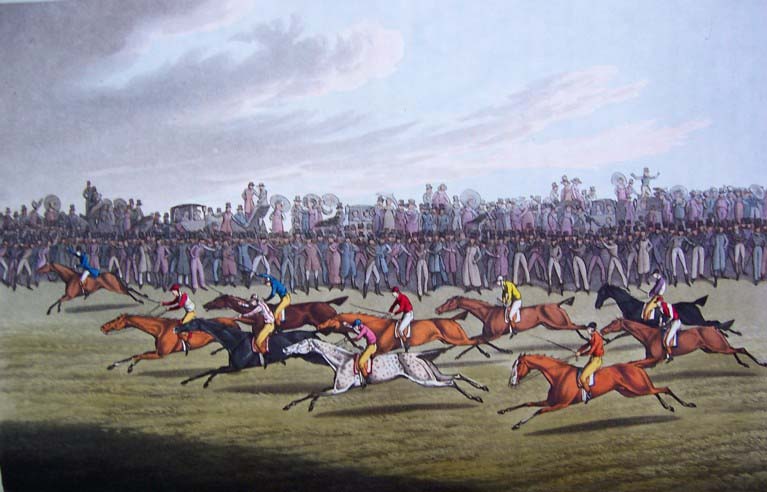
Plate 1. Henry Alken, National Sports of Great Britain (1823), ‘The Race’;
Alken’s National Sports pairs together horse-racing and prize-fighting as the most characteristically English sports, which boast equally long pedigrees. One plate is at least as interesting for showing the human beings at a horse race, with crowds of top-hatted men near the course (no rails at this date), but with ladies watching from behind, some from carriages (Plate 1). Here horse-racing is flat racing, and at this point it is illuminating to include as well Emmanuel’s copy of Alken’s study of The Steeple Chase of 1827 (now a very rare book indeed), where our hero (the rider in all-white colours) wins the race for his patron (Plate 2).
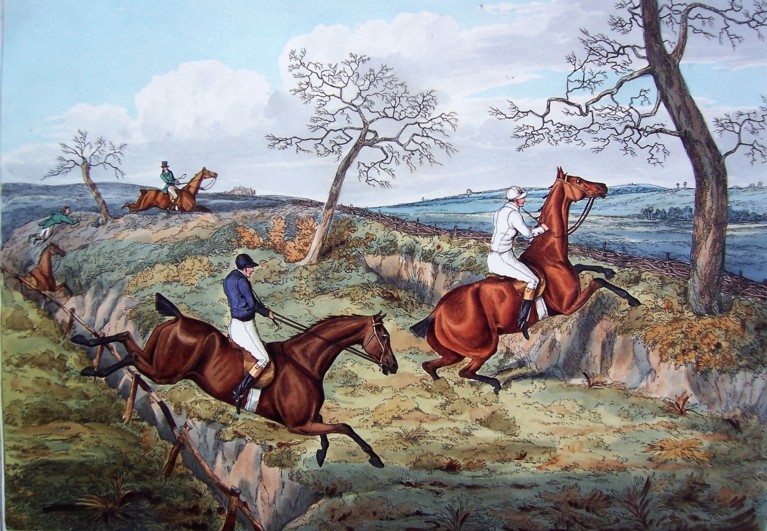
Plate 2. Henry Alken, The Steeple Chase (1827), ‘Crossing a deep ravine, dangerous to pass … With 6 to 2 on White’;
The cruelties of horse-racing are also fully discussed, but with some sense that bad old ways had been gradually abandoned during the previous century. The text sees the strongest objection to horse-racing as that excessive use of a whip that is still questioned to this day: ‘since whipping and spurring with the utmost strength and power of the jockeys has been immemorially the custom, with or without reason or necessity … Even the ladies upon the stand have been accustomed to look upon such a disgusting spectacle, at least without reprobation’. If we now think the writer is too sanguine (‘many or most of the barbarities of the old English Turf, like goblins and ghosts, have vanished before the light of modern humanity and sense of justice’), we should bear in mind that he is comparing with a time not long before when flat races could resemble mounted brawls, with jockeys accustomed to fight while on horse-back during the race, striking both each other and their rivals’ horses with their whips. Such is the writer’s respect for horses that it is in the context of racing that he acknowledges a contemporary shift in his day towards thinking not only that it is right to treat animals fairly, but even that animals have a moral right to expect to be so treated – though he admits sadly that some detractors sneered at any such notion of what they ridiculed as ‘the rights of cattle’.
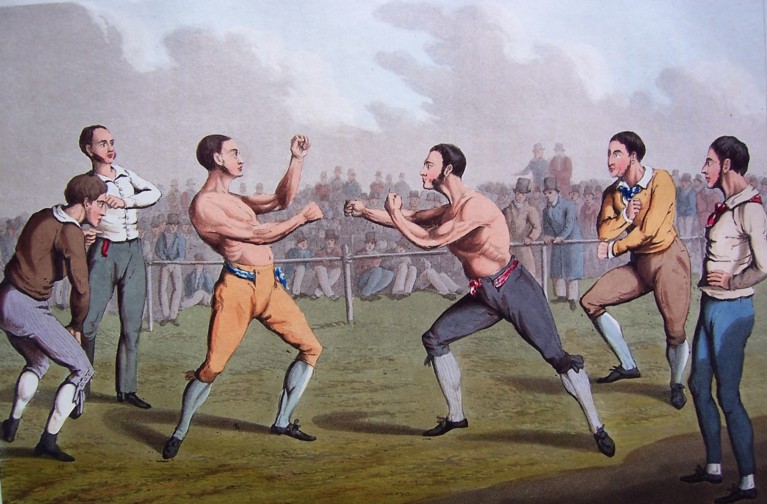
Plate 3. National Sports, ‘Prize-Fighting’;
No such issues affect the text’s glowing account of prize-fighting, which it terms a scientific system of ‘pugilism’ peculiar to England and with beneficial moral and social effects (Plate 3). This is because ‘it has not only afforded a vent for the human passions in a milder form, but it has impressed a superior character on the lower orders of Englishmen’. All the customs and observances of the match – the appointment of umpires and seconds, the opponents’ shaking hands beforehand ‘as much as to say, we mean to contend fairly and like men’, the spectators’ concern to see a fair fight without fouling and with fair treatment for the loser – serve to form ‘so excellent a practical system of ethics as no other country can boast, and has chiefly contributed to form the characteristic humanity of the English nation’.
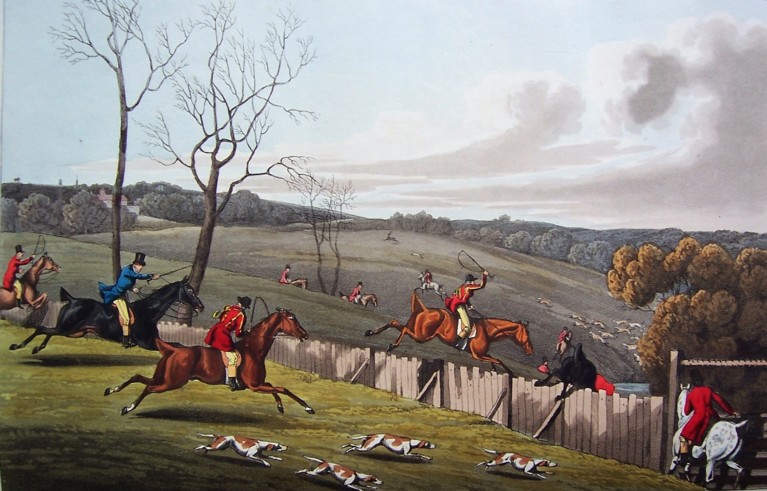
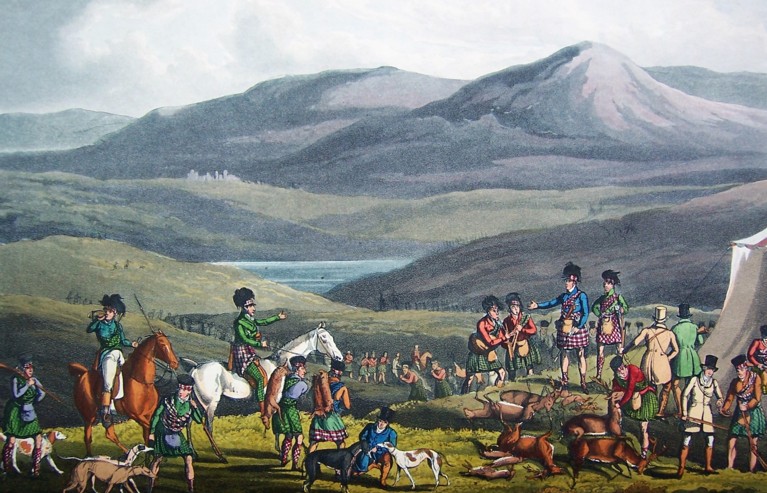
Plate 4. National Sports, ‘Stag Hunting’; Plate 5. National Sports, ‘A Highland Hunt’;
At the time Alken’s Sports illustrated it, stag-hunting had evidently been in decline Plate 4). The text only knows of two packs of stag-hounds in England apart from the one at Windsor, where George III had enjoyed stag-hunting – although at Windsor stag-hunts usually ended with the stag being captured and returned to its habitat rather than killed. In Scotland at this time there were attempts – in what now seems a Romantic and nostalgic spirit – to hold hunt meetings in conscious imitation of what were believed to have been the splendours of ancient hunting in the Highlands. Alken’s plate is evidently a Romantic imagining of the end of such a day’s hunt, which to contemporary English eyes was unusual in mixing hunting and shooting (Plate 5).
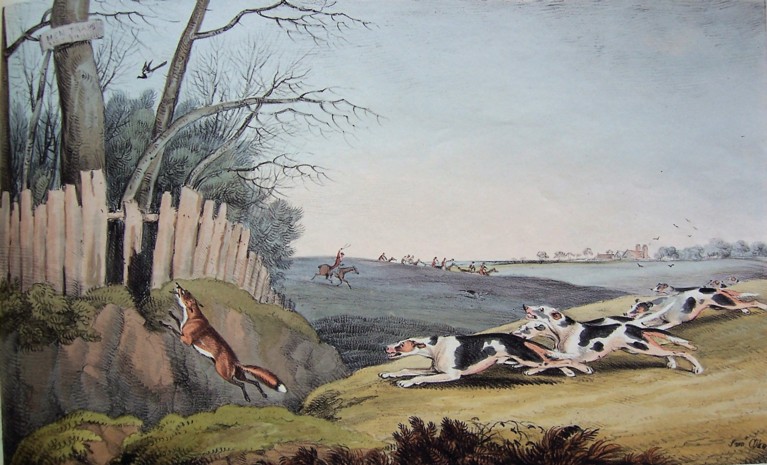
Plate 6. Samuel Alken, Delineations of British Sports (1822), ‘Fox Hunting’;
There is a similar enthusiasm for all the rituals of fox-hunting, which unlike stag-hunting is flourishing and also invested with a unique cultural significance: ‘the Charms of the Chase have, in this country, an almost universal influence, even to fascination … They form one of our grand national lyrical subjects …’ and this fascination is felt from noblemen, squires and parsons to ‘country labourer and mechanic … a hunt is everything’. Here, in a contrasting style, it is illuminating to introduce one of the plates in our very rare copy of Delineations of British Sports (1822) by Samuel Alken, Henry Alken’s brother (Plate 6). Mr Fox is scooting from the hounds towards a gap in the fence to some woodland, where he might soon be pursued by the huntsmen in the distance. But a notice by the fence to the wood reads ‘MEN TRAPS!’
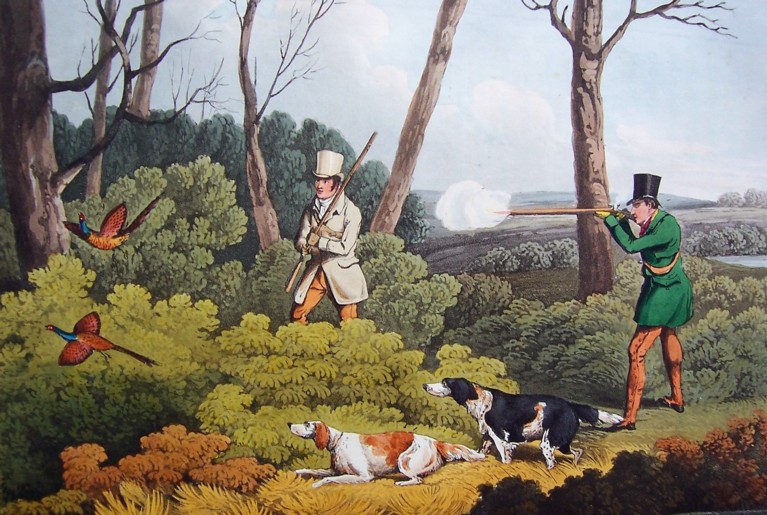
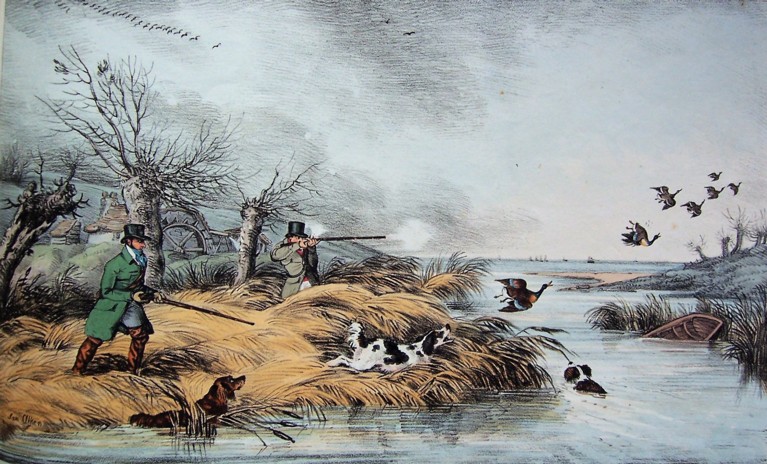
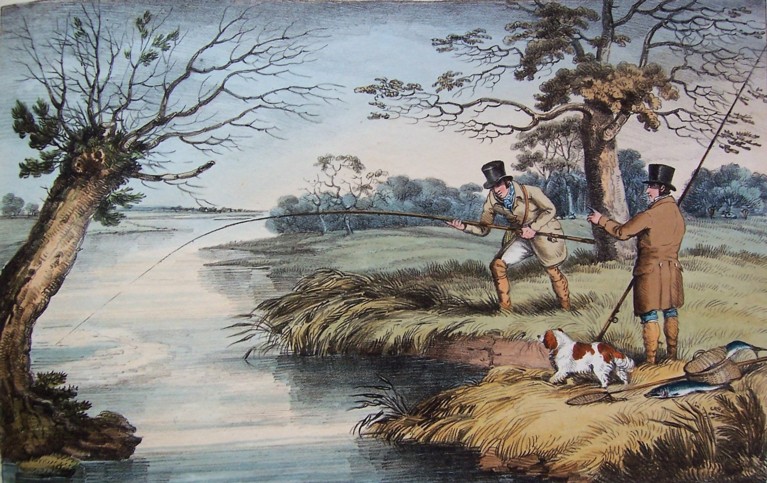
Plate 7. National Sports, ‘Pheasant Shooting’; Plate 7B. Delineations, ‘Shooting Water Fowl’; Plate 8. Delineations, ‘Trout Fishing’;
Both Henry and Samuel Alken have many plates depicting various kinds of shooting and fishing, many being pursued while exceptionally well-dressed in a distinctly gentlemanly fashion (Plates, 7, 7B, 8). But the commentary to one of Henry’s depictions of fishing again distances itself from any avoidable cruelty: ‘we shudder at and abominate the use of living baits; and never, with quiet feelings, tear the hook from the gorge of the captive fish …’
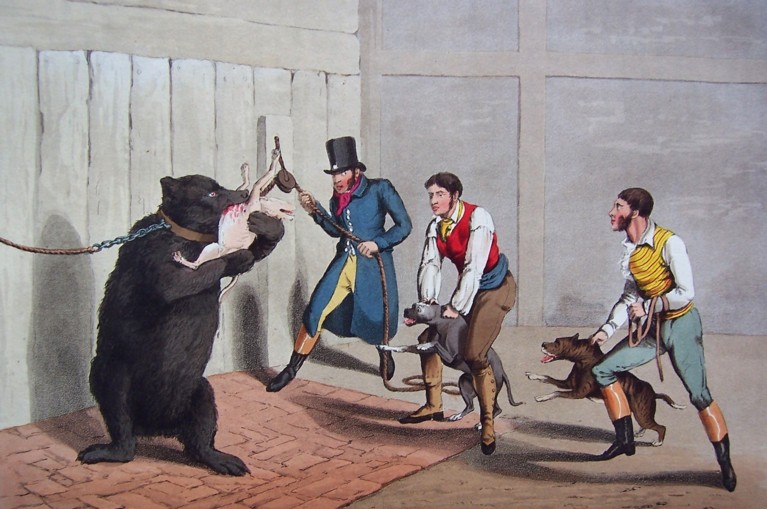
Plate 9. National Sports, ‘Bear-Baiting’;
Also depicted as national sports are the (to us unspeakable) practices of ‘baiting’ or tormenting captive bears and bulls with dogs. The text notes that bear-baiting now rarely happens and ‘is attended only by the lowest and most despicable part of the people’ (Plate 9). In this, it sees some historical progress, recalling that Queens Mary I and Elizabeth I both delighted ‘in viewing these barbarous and bloody spectacles’. The text notes the role of some contemporary clergy, peers and MPs in denouncing animal cruelty, while contrasting a sixteenth-century commentator who observed that ‘If there be a bear or a bull to be baited in the afternoon, the minister hurries the service over in a shameful manner, in order to be present at the show’, and quotes from the seventeenth-century diarist John Evelyn on how an important bill failed to pass in the Commons because members were elsewhere to see a tiger baited by dogs.
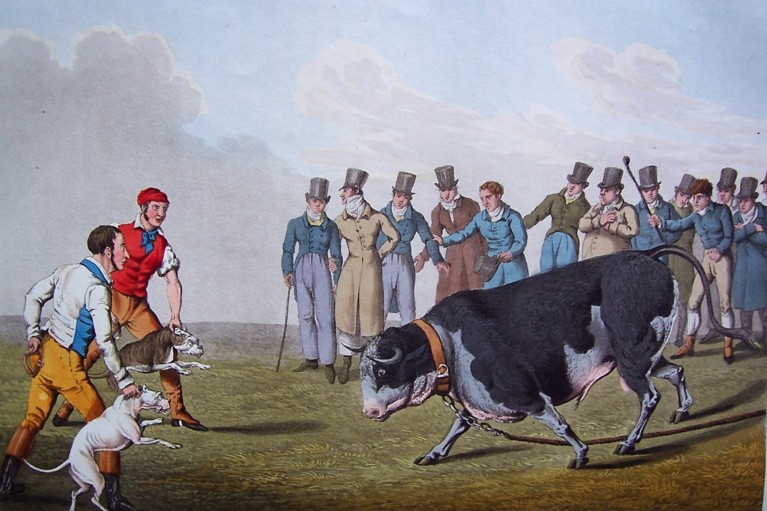
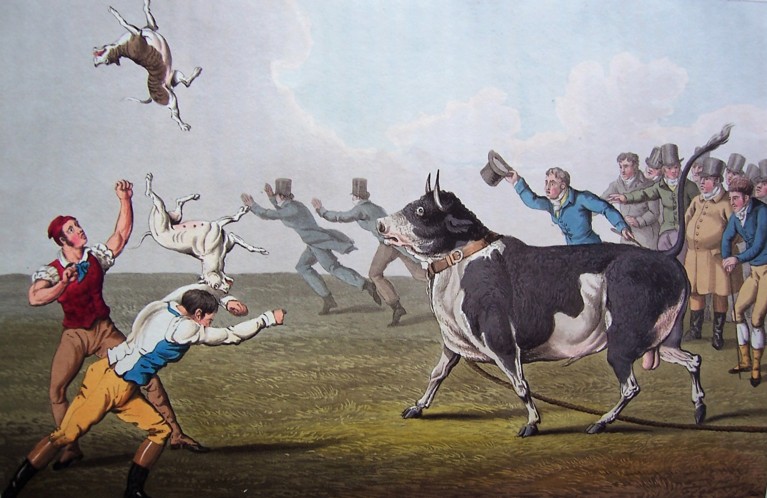
Plate 10. National Sports, ‘Bull-Baiting’; Plate 11. National Sports, ‘Bull-Baiting’;
Alken’s two bull-baiting plates do at least depict the bull getting its own back in goring and hurling away the tormenting dogs (Plates 10, 11). According to the commentary, bull-baiting in England originated in the reign of King John in Stamford in Lincolnshire. The text notes that modern clergy ‘have stood forth to explain the wickedness and infamy of this unnatural and pseudo-diversion [and] the press has taken the part of outraged humanity’. Warming to its theme, the text complains passionately ‘It is utterly unlawful and absurd, or rather insane, to worry out the life of an animal, by slow and horrid tortures, merely because nature has bestowed upon it fierceness and courage. What then must be the dire infatuation of one animal, and that animal pretending to rationality, deriving pleasure and sport from the outraged feelings and tortures of another! – Man, man, complain no more of the injuries and cruelty inflicted upon thyself!’ The failure of Parliament to legislate adequately is lamented, and the bull-fights of Spain and Portugal are duly branded ‘equally atrocious, but far more dangerous and manly than English bull-baits’
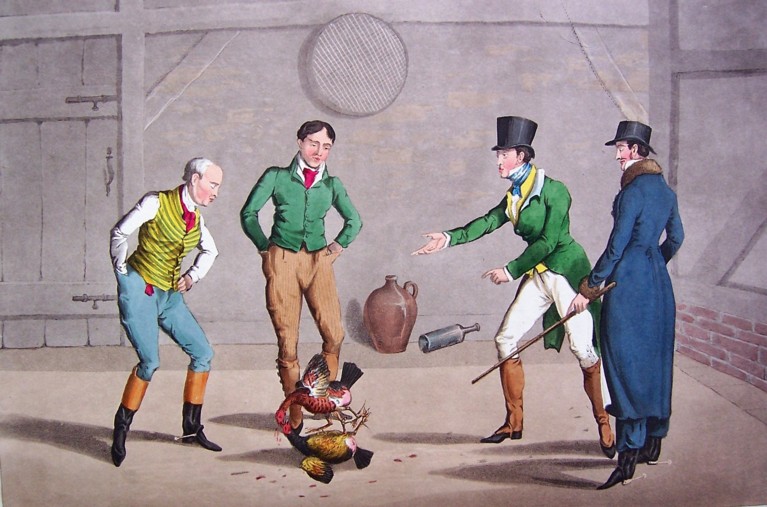
Plate 12. National Sports, ‘Cock-Fighting’;
The enjoyment of cock-fighting, however, is regarded as a different matter, while admitting that ‘This sport has been constantly decried as cruel and immoral by those writers who laudably advocate a due consideration for the feelings of brute animals’ (Plate 12). The distinction from watching animal baiting in this writer’s mind is that only a special breed of cocks is good for cock-fighting, and these birds are instinctively and violently pugnacious with each other. But if it so happens that they won’t fight, no human being can make them do so. So cock-fighting, the argument goes, is ‘void of that cruelty that attends baiting …consisting of the more arbitrary and capricious infliction of torture, which are unmanly, infamous, and detestable, whereas to witness the spectacle of a cock-fight is a legitimate object of curiosity, in which we admire, in their voluntary combats, the fierce courage of these feathered animals …’
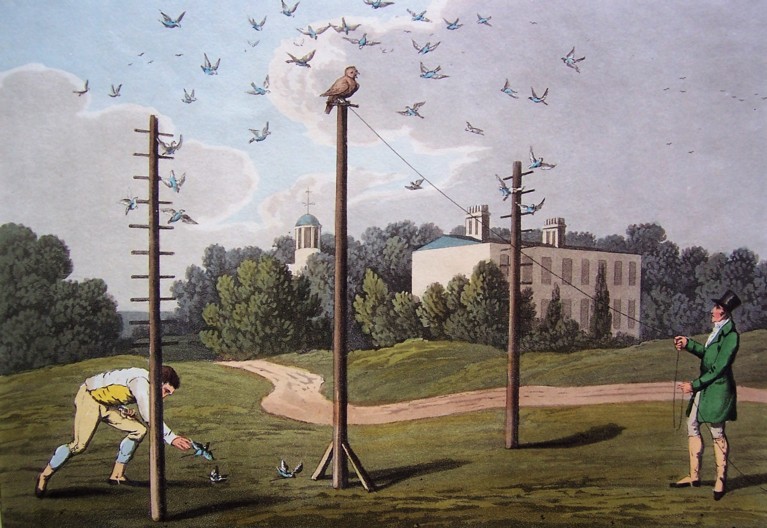
Plate 13. National Sports, ‘Owling’;
The number of plates in National Sports allows Alken to include such quaint and quirky activities as ‘Owling’ (Plate 13). Since any owl that appears in the open in daylight will tend to be mobbed by other birds, the trick was to allow a trained owl on a string to fly to and fro, thus attracting pigeons and other birds that will alight on the limed surfaces of what look to us rather like telegraph-poles, and so be caught for the pot.
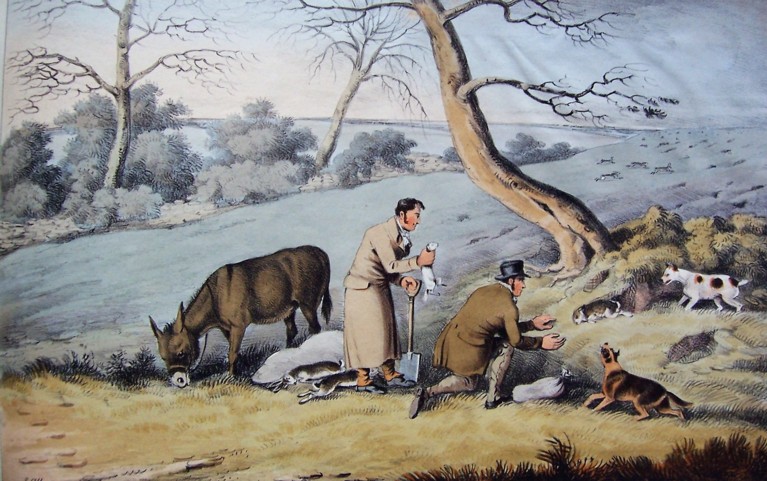
Plate 14. Delineations, ‘Poaching for Rabbits’.
And the final plate in Samuel Alken’s Delineations acknowledges that there is another, illicit, kind of hunting (Plate 14). The plate depicts some poachers taking rabbits, and since Alken shows the next field positively teeming with rabbits, there appear to be enough for everyone.
Barry Windeatt (Keeper of Rare Books)
Images by Helen Carron (College Librarian)
11 February 2021
Among the hand-coloured colour-plate books Emmanuel’s Graham Watson Collection are a number devoted to ‘sports’, by which is often meant what we would now call field sports. These were viewed as part of the illustration of ‘manners and customs’ in such books, and a light-hearted group of these, by artists such as Henry Alken, used sporting subjects as the background for books depicting comic mishaps and pratfalls.
Henry Thomas Alken (1785-1851) was the son of Samuel Alken, himself a sporting artist. Henry’s brother Samuel was also an artist, as were Henry Alken’s sons Sefferien and Samuel Henry, the latter also a sporting artist. So quite a dynasty of artists, with some potential confusions over the attribution of their work.
In his early career, as exemplified in some ten of his colour-plate books in Emmanuel’s collection, Alken produced a stream of paintings, drawings and engravings on sporting activities and field sports, sometimes publishing engravings under the pseudonym of ‘Ben Tally-Ho’. Himself a keen sportsman, many of Alken’s plates take a sardonic, mildly satirical view of what they depict, particularly the comic pitfalls of riding that lie in wait for the inexpert. The incompetence of overconfident but unskilled riders is ready material for Alken’s sense of the ridiculous. It is the human figures in Alken’s pictures that are the object of his humour, and the horses and other animals that have to deal with the consequences of human folly. Shrewd horses refuse to jump the impossible jumps proposed by their foolish riders. The title of one of Emmanuel’s Alken comic sporting books – Qualified Horses and Unqualified Riders – really says it all. This leads Alken to produce several books on the comic misadventures of various ‘Cockneys’ – who seem to represent all townies and urbanites – who presume to think that they, during brief holidays in the country, can master the field sports and other ways of the countryside – with predictably disastrous results.
.jpg)
.jpg)
Plates 1 and 2: Henry Alken, Qualified Horses and Unqualified Riders (1815);
.jpg)
Plate 3: Some Will, and Some Will Not (1821);
Like several of his comic sporting books, the narrative thread of Alken’s Qualified Horses and Unqualified Riders (1815) is essentially that of an accident-strewn outing of a hunt that eventually limps home bruised and retires hurt at the end. One plate from this book (Plate 1) is entitled ‘Topping a Flight of Rails and coming into the next field (but not well)’ and shows the rider in the moment of parting company from his horse and flying forward. A later plate (Plate 2) shows the rider left hanging in a hedgerow tree and is entitled sarcastically ‘From your own timidity and mismanagement, cause the Horse to swerve and at last to Bolt through the only bad place in the Fence, leaving you behind in the elegant attitude of a Spread Eagle’. Plate 3, from Some Will, and Some Will Not, or a Lesson on Hunting (1821) depicts ‘How to stop your horse’ for the truly incompetent rider. The sardonic text weighs up the alternatives – riding your bolting horse into the side of a carriage or at a tree or a fence (all potentially painful or uncomfortable) and advises that riding into another rider would be a softer landing, remarking on ‘self-preservation being a great law in Nature’.
.jpg)
.jpg)
.jpg)
Plates 4, 5, 6: Ideas Accidental and Incidental (1826);
In Alken’s Ideas, Accidental and Incidental to Hunting and Other Sports; Caught in Leicestershire (1826) each of the plates illustrates some ironic ‘Idea’. In Plate 4 two riders are vainly attempting to jump an impossible fence but their horses have other ideas: one of the riders is commenting ‘I have an IDEA that this Fence is either TOO HIGH or that my Horse is TOO SHORT’. In Plate 5 the riders have cleared the fence only to find themselves tumbling down an unseen chasm on the far side: the plate is captioned ‘This is just to give you an IDEA of a STEEPLE CHASE’. Another plate (Plate 6) depicts a carriage apparently pranged on a bollard: the caption records the driver remarking ruefully ‘I begin to have an IDEA that this TANDEM driving is not altogether free from danger …’
.jpg)
.jpg)
Plates 7 and 8: Hunting, or Six Hours’ Sport (1823);
Alken’s Hunting, or Six Hours’ Sport, by Three Real Good Ones, from the East End, and Without Seeing a Hound (1823) is, as the title suggests, a mock-epic about a ludicrously misadvised Cockney foray into the countryside. The first scene (Plate 7, entitled ‘Throwing Off … 9 o’clock … Not So Easy’) shows our three heroes having ominous difficulty in controlling their mounts from the start. Not a good sign that they seem to be riding over a pig … All too soon (Plate 8, ‘In Full Cry … 11 o’clock … Hard Work’) they have just ridden over not only a pig but an old woman with her basket of wares, who lies on the ground under their hooves. The ensuing plates show that the prize porker is no more and depict our ‘Real Good Ones’ paying off the old woman with a large bribe before beating a hasty retreat in a carriage back to the East End.
.jpg)
Plate 9: A Cockney’s Shooting Season in Suffolk (1822);
Another classic in similar vein is Alken’s A Cockney’s Shooting Season in Suffolk (1822), where the plates illustrate a text written in what might be politely called rhyming couplets. Plate 9 (captioned ‘He flies off his charger and the birds fly away’) shows our urban hero coming adrift from his mount while vainly trying to shoot some wisely distant birds that have seemed to him to be jeering at his efforts. Things go from bad to worse when our Cockney hero later takes aim at a sparrow and hits a passing old lady instead:
‘Help! Murder!’ she roar’d. ‘I’m as dead as a herring!’
Help, neighbours, I pray ye, give me Christian burying,
And let justice take place on the rogue that has shot me’.
‘Another day’s rare sport,’ cries Sam, ‘or else rot me!’
.jpg)
Plate 10: Ideas Accidental and Incidental
None of these outings ends well for the human beings. Plate 10 shows a would-be huntsman having his very smelly clothes being wrung out after landing in a stinking ditch (one of the attendants is holding his nose). The fallen hero is captioned as commenting ‘My dear fellows, I should be extremely sorry to speak of any country with disrespect, but I have an IDEA that the Water hereabouts is NOT exceedingly fragrant’.
.jpg)
.jpg)
Plate 11: Ideas Accidental and Incidental; Plate 12: Qualified Horses.
Our last two plates show our sporting heroes being stretchered off the field bloodied and bruised after their days out. One is captioned ‘Returning Home in Triumph: He disdain’d a Slothful Easy Life, so took to Hunting…’
Nor is there any need to worry on behalf of our furry and feathered friends that are in theory being hunted: Alken’s plates are so full of human foible and mayhem that no huntsmen in these comic books ever gets near to their prey.
Barry Windeatt (Keeper of Rare Books)
Images by Helen Carron (College Librarian)
8 February 2021
Jokes about the origin of the duck that features regularly on Emmanuel’s menus are perennial, the inference being, of course, that it is stealthily sourced from within the college precinct.
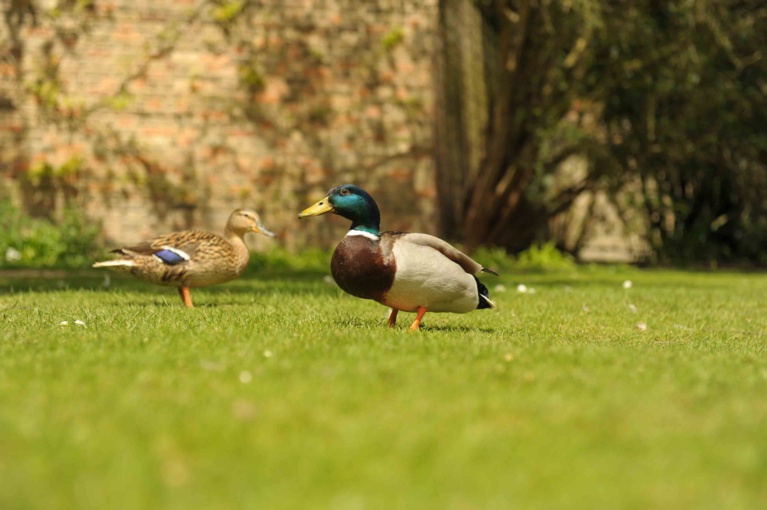 Writing some years ago about the food rationing that followed the Second World War, an Emmanuel Fellow recounted the popular rumour that ‘duck served at High Table around this time was reared very locally’, and similar stories abound. Is there any hard evidence, though, that the college ponds supplied the Kitchen with ducks after the war, or indeed at any other time?
Writing some years ago about the food rationing that followed the Second World War, an Emmanuel Fellow recounted the popular rumour that ‘duck served at High Table around this time was reared very locally’, and similar stories abound. Is there any hard evidence, though, that the college ponds supplied the Kitchen with ducks after the war, or indeed at any other time?
As far as the wartime rationing is concerned, a perusal of the college’s menu books shows that while duck was frequently served at meals before the summer of 1939, it was very seldom on the menu during, or immediately after, the war (although the diners at High Table were occasionally confronted with novelties such as godwit, coot and knot). It was not until the late 1940s that duck once again became easily obtainable, and the Kitchen order books show that the main supplier, both before and after the war, was Pettitts of Reedham Ltd. This family firm, based in the Norfolk Broads, regularly sent the college large consignments of domestic and wild fowl, as well as game. The Paddock pond could never, in reality, have supported enough ducks to make much of a contribution to college meals, although an occasional brace may have been served up. It should be remembered, though, that Emma’s duck population used to be much smaller, because until the mid–1960s the pond was the domain of successive pairs of swans who did not tolerate too many feathered neighbours.
Some readers will have recognised the allusion, in the title of this piece, to the infamous closing scene of the ‘Gourmet Night’ episode of Fawlty Towers. One of Emmanuel’s own most celebrated gourmet nights was the Tercentenary Dinner held on 18 June 1884, on which occasion the showpiece was not duck, but four roast swans. The late Dr Frank Stubbings, college Fellow, speculated that the birds may have been ‘home–grown’, but it seems a little unlikely that the college would have sacrificed its swans to furnish the feast, for they were regarded as pets by the majority of resident members. In more recent times, though, there is evidence that culling was indeed sometimes contemplated. Recalling the period after the Second World War, Dr Stubbings noted that the swans produced an annual ‘bevy of cygnets’, adding the ambiguous comment that ‘the pond was too small for us to retain them into swanhood’. The Garden Committee’s minutes for the 1940s, ‘50s and ‘60s record its recurring exasperation at the fouling and damage to plants perpetrated by the ducks and swans, and on several occasions it recommended drastic action. In July 1946, for example, after the swans had repeatedly destroyed any new waterlily leaves as soon as they appeared, the Committee agreed that ‘the three cygnets should be consumed at High Table as soon as they were large enough’. The menu books contain no record of such a dish being served, however, so it may be that on this occasion, as on one or two others, the Garden Committee’s recommendations in respect of culling were overruled by the Governing Body.
After the pond was re–modelled in 1964 it no longer provided an attractive habitat for swans, and its only permanent avian residents since that time have been ducks and moorhens. For the last two or three years, though, a fecund pair of Canada geese have been regular summer visitors and the resultant besmirching of the Paddock lawns has been so repellent that a humane deterrent was deployed last year. The geese duly departed, only to return a fortnight later, cheekily bringing a couple of friends with them. The deterrent was used again, this time with lasting effect, but it will be interesting to see whether the Canadians come back this year. If they do, it might have to be a case of ‘Gosling’s On!’
Amanda Goode, College Archivist
27 January 2021
The topic of this week’s blog is Emmanuel’s rarely-surviving copy, in the Graham Watson Collection, of Philippe de Loutherbourg’s Picturesque Scenery of Great Britain (1801), with its six superb large aquatints of views on the south coast of England, and the light thrown on the skill and accomplishment of this by a companion volume, De Loutherbourg’s The Romantic and Picturesque Scenery of England and Wales (1805).
Philippe de Loutherbourg (1740-1812), born possibly at Strassbourg, was the son and grandson of artists. He had great early success as a painter in Paris, where his abilities were noted by Diderot. Arriving in London in 1771, he was introduced to the actor-manager, David Garrick, who soon entrusted him with the scenery department at the Drury Lane Theatre, an arrangement that the playwright Sheridan continued when he took over the management of Drury Lane. Here De Loutherbourg won much contemporary acclaim – including from Sir Joshua Reynolds – for the subtle and sophisticated lighting effects in his painted scenery, as well as for more spectacular theatrical effects. But after 1781 he returned to his easel, making tours of the Peak District, Lake District and North Wales and exhibiting many landscape paintings from his tours. He also enjoyed success with paintings of British naval battles (some now in the National Maritime Museum). In later life he became interested in mysticism and the occult, offering faith-healing services through ‘heavenly and divine Influx’.
The large aquatints in Picturesque Scenery (each 51 x 34 cms) are remarkable for their dramatic compositions, bustling with closely-observed detail, and for the subtlety with which stormy skies have been engraved and coloured. They just cry out to be cut out and framed which, of course, is why the book is now so rare. The whole emphasis of the book is on these six plates, with only a page of text at the beginning to comment on the contents.
.png)
‘Ramsgate with a view of the new Lighthouse’ (Plate 1) is typical of De Loutherbourg’s eye for a seascape, with sails straining and human figures dwarfed by the elements. The text notes Ramsgate’s ancient advantage in offering some slight natural shelter for shipping in bad weather, now turned into a safer harbour by the construction of two stone piers and a lighthouse which in all took forty years to build, between 1750 and 1790, in which year 160 ships escaped peril by sheltering there during a terrible gale.
.png)
.png)
‘Margate from the Parade’ and ‘Margate with the Arrival of the Hoy’ (Plates 2 and 3) show calmer scenes befitting one of the new and growing seaside resorts. The text notes that ‘the great concourse of people to this place in the summer for sea-bathing has given rise to a great many new houses … a fine assembly-room … a bookseller’s shop of uncommon magnificence, and a very convenient and spacious theatre’. Trippers came from London on regular passenger vessels called Margate hoys, and with the arrival of each boat, as depicted here, ‘the motley group assembled in the crowded hoys often affords much subject of entertainment’.
.png)
‘Brighthelmstone, Fishermen Returning’ (Plate 4) catches Brighton in its transition from a fishing village into a fashionable resort, as the fishermen return to land their catch. The text duly notes the place’s new popularity which it attributes to the Prince of Wales (i.e. the future Prince Regent, later George IV) ‘who has built here an elegant summer pavilion’, but seems unconvinced the place is going to make it (‘the situation is so open that bathing is only possible in fine weather’). But the writer focusses on the fish market still held on the beach, chiefly for mackerel and sole (‘nine or ten thousand mackerel have been caught here in a net at once’ it notes, in the best tradition of the fisherman’s tale). All fishing is carried on at night and then sold on the beach, the majority for the London market, which it reaches in eight or ten hours.
.png)
‘Fishermen going out at Worthing’ (Plate 5) is similarly alive with the elements – straining sails and restive skies. It records what it calls another ‘insignificant fishing place’ on the cusp of development. A visit in 1798 by George III’s daughter, Princess Amelia, had set a trend, and many new buildings were going up to accommodate fashionable visitors.
.png)
‘Ramsgate in a high gale’ (Plate 6) is especially skilfully composed, and the human figures are full of interest under the towering canvas and rigging, with a foaming sea and high wind. As always in this book, the sky is represented with a remarkable use of colour.
.png)
Comparison with a plate of ‘Entrance of Ramsgate Harbour’ (Plate 7) in Romantic and Picturesque Scenery, however, serves to bring out how much De Loutherbourg, or any other artist, was in the hands of the engravers and colourists who translated their designs into the format of hand-coloured plates. Here in the later book is a plate evidently based on the same or similar original drawing or painting of Ramsgate by De Loutherbourg, but handled by an engraver and a colourist of much more modest talent than those who worked on the earlier book. The later composition, by comparison, lacks tautness and the colouring is routine.
The same is true of the colouring throughout the later book, which is regrettable when De Loutherbourg has selected some important subjects.
.png)
‘Tintern Abbey in Monmouthshire’ (Plate 8) shows a favourite subject for admirers of the Picturesque, which William Gilpin, the great popularizer of Picturesque tourism, had notoriously said might be rendered even more picturesque by the judicious use of a mallet. So it is with this plate, which might be bettered and is very average in execution by the standards of this period.
.png)
.png)
The last two plates ‘Coalbrook Dale in Shropshire’ (Plate 9) and ‘Peak’s Hole in Derbyshire’ (Plate 10) are fascinating for their subjects, if not for the clumsy use of colour. The text declares Coalbrookdale ‘worthy of a visit for the admirer of romantic scenery no less than for the political economist’ and shows this dark satanic mill belching fire and smoke within a still-rural setting near the dawn of the Industrial Revolution. The plate is said to show ‘the middle steam engine in the Dale with surrounding scenery’ as if the two are not in conflict. The plate of Peak’s Hole, here looking back towards the entrance, reflects another contemporary craze for picturesque caves and caverns where one might experience what the caption calls ‘that mingled emotion of fear and pleasure, astonishment and delight, which is one of the most interesting feelings of the mind’.
Barry Windeatt (Keeper of Rare Books)
Images by Helen Carron (College Librarian)
13 January 2021
This week’s rare book is The Gallery of Fashion, one of the earliest English fashion magazines, published in London between 1794 and 1802. Its publisher, Nikolaus von Heideloff (1761-1837), was born in Stuttgart and started his career in Paris. At the outbreak of the French Revolution he fled for safety to London, where he lived until in 1815 he was appointed director of the collection that is now the Mauritshuis in The Hague. In the words of his ‘Advertisement,’ von Heideloff regarded his magazine as not only of interest to ‘Ladies of the highest fashion’ but it was also ‘submitted to the admirers of the fine arts’, so staking an implicit claim that clothes and fashion represent an art form.
The Gallery was published in monthly instalments and Emmanuel’s copy in the Graham Watson Collection is bound in nine volumes for each year of publication. Such a complete set in such a fine state is a very rare survival and differs from some other copies in having an uncoloured plate included alongside the coloured plate in 38 cases – presumably for the use of subscribers in composing their own variations on the colour combinations shown in the plates. The list of subscribers is of the grandest, including daughters of George III, along with Duchesses, Marchionesses and Countesses, but also featuring such surprising subscribers as the Ottoman Embassy in London. Many subscribers are men, presumably on behalf of their wives, and many lady subscribers opt to remain anonymous, like ‘A Lady at Philadelphia’. Although early issues could be purchased individually by non-subscribers, von Heideloff soon went over to subscription only – which meant the latest fashion trends were first known exclusively to subscribers. But it could also be a two-way relationship, with subscribers gaining the kudos of publishing their own fashion-leading innovations: ‘Several Ladies of Rank and Fashion’ have allowed von Heideloff to ‘make drawings of their new dresses’ and ‘thus the credit of the invention of the different dresses will be secured to the Fair Subscribers who contribute to the embellishment of this work’.
Published by an immigrant refugee from the French Revolution in the midst of the long wars with France, this new English magazine of high fashion perhaps inevitably displays some edgy competitiveness with the notion of French leadership in fashion. For von Heideloff ‘This work, so necessary to point out the superior elegance of the English taste, is the first and only one ever published in this country; it surpasses anything of the kind formerly published at Paris …’
The English claim to primacy is that contemporary English fashions emulate the simplicity of Ancient Greek dress: ‘France has given her dresses to the other nations, but it was reserved for the Graces of Great Britain to take the lead in Fashion, and to show that, if they do not surpass, they certainly equal the elegance of the most celebrated Grecian dresses. In short, beauty, shape and taste are nowhere more general, nor anywhere better united, than in England …’
To a modern eye these fashions do often have – at least when seen free of the clutter of accessories – an elegant simplicity of line, with their very high ‘Empire line’ waistlines. The profusion of cloaks, bonnets, gloves and muffs is explained by the fact that dresses at this period tended to be made of quite thin material … brrr! A Grecian inspiration was also suggested by the fashion for wearing white, especially in the evening. To wear white implicitly signalled wealth and leisured status, in that white was so easily soiled and would need cleaning (by someone else).
.png)
.png)
Plate 1: ‘Morning Dresses’ (September, 1794); Plate 2: ‘Morning Dresses’ (September, 1798);
.png)
Plate 3: ‘Two Ladies, en negligé, taking an airing in a phaeton’ (August, 1794);
To a modern viewer the Gallery’s elegant plates will seem like visualizations of scenes from Jane Austen’s novels, particularly when the young women are shown reading novels or letters (Plates 1-3), or at such ladylike diversions as playing the pianoforte (Plate 4) or playing the harp while wearing an elaborately tall headdress of ‘three white ostrich feathers with a bandeau crossed with flowers’ (Plate 5).
.png)
.png)
Plate 4: ‘Morning Dress (left) and Afternoon Dress (right)’ (July, 1796); Plate 5: ‘Lady at Harp’ (April, 1795);
The plates for each month show examples of dresses for the morning (when one might take the air), for afternoons, and for the evening at concerts, the opera and receptions. There is usually an example of Court Dress, which mostly tends to be the very opposite of supposed ‘Grecian’ simplicity (Plate 6). There is much depiction of fashions to be worn during periods of mourning – not only in black but in gradations of grey and white – since mourning, which might be worn even for quite distant relatives, was frequently required. There are some strikingly smart riding habits (Plate 7) , which very much suggest the impact that a self-confidently styled woman might achieve outside in company if dressed to impress in such a way, as in a scarlet one worn with ‘a black beaver hat trimmed with purple velvet riband and two black feathers’ (Plate 8). Backgrounds where included sometimes imply ample gardens and grounds, with some elegant garden furniture, while a few scenes seem to admit that English fashions will need to contend with wind and rain (Plate 9).
.png)
.png)
Plate 6: ‘Court Dress’ (1794); Plate 7: ‘Riding Dress for Hyde Park’ (May, 1797);
.png)
.png)
Plate 8: ‘A Lady going out on horseback’ (June, 1795); Plate 9: ‘Morning Dresses for Hyde Park’ (April, 1797);
The backgrounds to quite a few of the plates acknowledge the fashionable new craze for being at the seaside in new resorts and watering places (Plates 11, 12), as in the plate that shows two young ladies rather perilously perched on a cliff edge with a beach with bathing machines far below (Plate 10), or a lady with a telescope and ‘a black beaver hat trimmed a la militaire’ (Plate 13). One rather revealing plate (Plate 14) depicts two young women breakfasting in their dressing-room before the fashionable day begins, although their nightcaps and dressing gowns are still as elegant as their splendid silver tea-service and richly patterned carpet .
.png)
.png)
Plate 10: ‘Morning Dresses for a Bathing Place’ (September, 1797); Plate 11: ‘Morning Dresses for a Bathing Place’ (1797);
.png)
.png)
Plate 12: ‘Morning Dress for a Watering Place’ (October, 1795); Plate 13: ‘Bathing Place’ (October, 1798);
.png)
Plate 14: ‘Two Ladies at Breakfast, in their Dressing-Room’ ((November, 1794).
The first decades of the nineteenth century – loosely ‘the Regency’ – may now seem synonymous with elegance, and in depicting something of it The Gallery of Fashion is one of the most beautiful books on costume ever published, and certainly the finest example of coloured aquatint as applied to fashion plates.
Barry Windeatt (Keeper of Rare Books)
Images by Helen Carron (College Librarian)
12 January 2021
On a windowsill in the Gallery, surrounded by portraits of stern–faced early college Puritans and Platonists, sits a most incongruous work of art: a large bronze statuette of a rearing mustang, trying to unseat its rider.
.png) The sculpture is a casting of ‘The Bronco Buster’, perhaps the most famous bronze produced by Frederic Remington (1861–1909), an artist celebrated for his evocative paintings, drawings and sculptures on the theme of the American Wild West. Inevitably Remington’s art has been subject to recent revisionism, but there is no denying his surpassing technical skill.
The sculpture is a casting of ‘The Bronco Buster’, perhaps the most famous bronze produced by Frederic Remington (1861–1909), an artist celebrated for his evocative paintings, drawings and sculptures on the theme of the American Wild West. Inevitably Remington’s art has been subject to recent revisionism, but there is no denying his surpassing technical skill.
‘The Bronco Buster’ was a gift to the college from J. Frank Dobie, a convivial Texan who lived at Emmanuel for more than a year after being appointed Visiting Professor of American History in 1943. Dobie was very popular with Fellows and students alike, enduring with good humour the meagre rations and freezing rooms of the wartime college (although he frequently sought refuge, with other dons, in the toasty warmth of The Anchor). After his return to the USA, he looked around for a suitable gift to send Emmanuel in token of his ‘deep and abiding’ gratitude, and chose Remington’s sculpture because, as he explained to the college, the ‘cowboy riding a pitching horse…has plenty of animation and represents something that I belong to and something that belongs to America’. The bronze arrived at London Docks shortly before Christmas 1946, all costs having been pre–paid by Dobie, according to the New York agents who had organized the shipment. The College blithely requested that the statuette be forwarded to Cambridge immediately, but HM Customs & Excise had other ideas, and a lengthy war of words ensued.
The nature of the gift was crucial, for ‘commercial’ products were subject to duty and purchase tax, whereas ‘Works of Art’ and antiques might in some cases be exempt. Emmanuel’s Senior Tutor, Edward Welbourne, made a good case for the bronze’s being considered both a work of art and a museum piece, and threw in for good measure Professor Dobie’s contribution to the War effort and his continuing role in fostering good Anglo–American relations. Even Welbourne’s legendary eloquence, however, could not move the flint–hearted Customs officials, and eventually the college had to concede defeat and fork out not only purchase tax of 100%, but also import duty, port charges and ‘Dock Attention’ fees, which came to a total of £13.14.7, nearly three times the bronze’s estimated value. One of the parties involved observed that ‘the donor would be horrified to know what his present has cost!’, and indeed he was, for although the college would have kept the knowledge from him, matters dragged on for so long that Dobie eventually enquired whether his gift had arrived safely, at which point the college had to come clean. The professor immediately insisted that he should pay all the outstanding charges, but .png) Welbourne replied that it was ‘not at all clear that we shall allow you to remit anything’, and there the matter appears to have rested.
Welbourne replied that it was ‘not at all clear that we shall allow you to remit anything’, and there the matter appears to have rested.
The statuette was finally released by Customs in December 1947, nearly a year after its arrival. There was initially ‘some perplexity’ as to where it should be placed, but a window recess in the Gallery was adjudged suitable, and the bronze has remained there ever since, for is not a piece to be moved lightly. Professor Dobie paid a return visit to Emmanuel in 1949, and maintained warm relations with the college until his death in 1964. By that time memories of the trouble caused by what Welbourne called the ‘loathsome and absurd purchase tax’ had faded, and the mettlesome bronco had become, and remains, a genuinely welcome gift horse.
Amanda Goode, College Archivist
10 December 2020
Emmanuel College, founded by Sir Walter Mildmay, Chancellor of the Exchequer, admitted its first students in November 1584, but it was not until December 1587 that all the necessary building works had been completed and the college could hold a formal dedication ceremony.
.png) The Founder was to be present (L: Sir Walter Mildmay, 1588), and as this was akin to a royal visit, there was a flurry—one might almost say frenzy—of activity to get the place looking its best. In the weeks leading up to the celebrations, the college accounts contain numerous payments for paving, glazing, carpentry, painting, cleaning and general fitting–up; a clock was acquired and housed, a new privy was built, and there was a payment for ‘dressing all rooms against our founders coming’, while the ‘founders chamber’ where Sir Walter was to sleep was whitewashed and furnished with a door. The external appearance of the college must also have been thought to require beautifying, for the street outside the college was paved and ‘clensed’, and the ‘great gates’ at the entrance were taken down and set up in a new position. The inner court of the college was weeded, and ‘quickset’ hedges were planted in the gardens.
The Founder was to be present (L: Sir Walter Mildmay, 1588), and as this was akin to a royal visit, there was a flurry—one might almost say frenzy—of activity to get the place looking its best. In the weeks leading up to the celebrations, the college accounts contain numerous payments for paving, glazing, carpentry, painting, cleaning and general fitting–up; a clock was acquired and housed, a new privy was built, and there was a payment for ‘dressing all rooms against our founders coming’, while the ‘founders chamber’ where Sir Walter was to sleep was whitewashed and furnished with a door. The external appearance of the college must also have been thought to require beautifying, for the street outside the college was paved and ‘clensed’, and the ‘great gates’ at the entrance were taken down and set up in a new position. The inner court of the college was weeded, and ‘quickset’ hedges were planted in the gardens.
The dedication ceremonials included a service in the new chapel, for which two desks had been purchased ‘to lay the bible on’, and a feast in the Hall. This banquet must have been a glittering affair, literally, for a large consignment of new pewter tableware had been sent up from London. Packed in straw, inside baskets secured with cords, were platters, dishes, ‘sawcers’, porringers, salts, candlesticks, trays, pans, pots and kitchen utensils. The food served at the feast was also worthy of the occasion, for the highlights were two does, sourced from nearby Somersham Park, and a ‘cragg of sturgeon’ delivered to the college by the Cambridge carrier Thomas Hobson (of ‘Hobson’s Choice’ fame). As it was winter, the college laid out thirteen shillings ‘on coals at the dedication’.
.png) During the Founder’s visit a new chapter was added to the college’s copy of the foundation statutes, recording Sir Walter’s desire that a particular chamber (now D3) should be reserved in perpetuity for the use of any of his kin who wished to reside at Emmanuel ‘for the purpose of study’. If no Founder’s kin required the room, the Master was permitted to assign it to a student of his choosing, ‘having regard to equity as well as to the dignity and deserts of the person’, but if any kin subsequently claimed the room, the occupant was to vacate it ‘forthwith’. Sir Walter signed off the new chapter with an elaborate flourish and either he, or the chirographer, added the date ‘December 1587’ in the margin. (R: Sir Walter’s signature in the College Statutes, 1587. The decorative flourish contains a monogram of his initials, followed by the letter ‘C’ for Chancellor)
During the Founder’s visit a new chapter was added to the college’s copy of the foundation statutes, recording Sir Walter’s desire that a particular chamber (now D3) should be reserved in perpetuity for the use of any of his kin who wished to reside at Emmanuel ‘for the purpose of study’. If no Founder’s kin required the room, the Master was permitted to assign it to a student of his choosing, ‘having regard to equity as well as to the dignity and deserts of the person’, but if any kin subsequently claimed the room, the occupant was to vacate it ‘forthwith’. Sir Walter signed off the new chapter with an elaborate flourish and either he, or the chirographer, added the date ‘December 1587’ in the margin. (R: Sir Walter’s signature in the College Statutes, 1587. The decorative flourish contains a monogram of his initials, followed by the letter ‘C’ for Chancellor)
The Vice–Chancellor of Cambridge University was an honoured guest at the dedication feast, and he penned a fulsome thank–you letter that Uriah Heep might have admired:
To the Right Honourable Sir Walter Mildmay Knight one of her Majesties most Honourable Privy Councill. What joy and comfort we received at the late dedication of Emanuel College founded by your honour, and brought to perfection in so short a space, I may not seek to express sufficiently by these my letters. As then we joined together in humble prayers that God might bless the same to his honour, and the benefit of his Church and the Common Wealth, so we rejoice not a little that by the insertion of the College, such a beauty and ornament also, is added to the University. Wherefore I thought it my humble duty…not only to give my humble thanks to your Honour for the same, but also to shew our thankfulness in accepting it: and to declare how willing I shall be to show such our favours to the said College as shall lie in my power. I may not trouble your Honour with many words, wherefore humbly taking my leave, I beseech God to continue your Honour to the great benefit, as of the whole realm so of this her Majesty’s University. Your Honours humble to be commanded, Thomas Legge Procon. Cambridge 20 December 1587.
Amanda Goode, College Archivist
10 December 2020
Continuing the theme of books on ‘costumes and customs’ is Graham Walker’s The Costume of Yorkshire (1814), which the title page declares to be ‘Descriptive of the Peculiar Dress, Occupation and Manners of Various Inhabitants of that Extensive and Populous County’. This celebrated book appeared in various contemporary versions, in different sizes and qualities of paper. Graham Watson, a patriotic Yorkshireman, collected four different ‘states’ or versions of the book for his collection, now in Emmanuel Library. Our illustrations are taken from the rarest of these: the ten unbound booklets in which the book was first issued. The plates reflect some of the uneasy changes of the time, with illustrations of working practices in the wool and cloth-making trades, which were being overtaken by mechanization, and newer occupations such as mining alongside depictions of an age-old rural and upland way of life. Especially interesting are the illustrations recording some traditional customs and observances. The accompanying text is printed in both English and French.
.png)
Plate 1: Collier
Here is the new industry of the West Riding. Behind the rather jaunty figure of the collier are the mines and one of the new steam engines which, ‘constantly employed’, can convey waggons of coals from the pits to Leeds, far beyond what horse-power could carry.
.png)
Plate 2: Stone-Breakers
With few sources of gravel in Yorkshire, local roads were made up of broken stones. Large pieces brought from quarries were then broken up at the roadside, and the text laments that there is as yet no mechanization of this backbreaking labour.
.png)
Plate 3: Cranberry Girl
Women foraging for cranberries on the moors. The text extols the Yorkshire cranberries as greatly superior to those found in America or Russia.
.png)
Plate 4: Croppers
After the wetted wool has been combed with teazels it is clipped or cropped, as in the process shown in the plate. This traditional way of working was in the process of being replaced by mechanization in mills, and the contemporary croppers were an anxious and discontented workforce.
.png)
Plate 5: Wensley Dale Knitters
During any activity where the hands were not necessary the frugal inhabitants of Wensleydale engaged in knitting – ‘young and old, male and female, are all adept at this art’ – and the plate indeed shows everyone busily knitting. The text cites the example of a woman who each week walks three miles to market and three miles back, with her family’s weekly knitting to sell in a bag on her head, all the while knitting as she walks, and so producing en route ‘a complete pair of men’s stockings’.
.png)
Plate 6: Woman Spinning
Spinning by a wheel at this date had already been largely overtaken by mechanization, but it was still needed for ‘the warp of woollen stuffs, in which a strong hard twisted thread is required. The demand is even yet sufficient to employ a considerable number of poor people, to whom the low wages of about one halfpenny per pound weight may be an object’.
.png)
Plate 7: Factory Children
The text observes that the West Riding abounds in cotton mills and ‘cloth manufactories’ and that these ‘furnish employment, food and raiment to thousands of poor industrious individuals. It is much however to be lamented that this is too frequently at the expense of health and morals’. As to the illustration: ‘The little blue dirty group in the Plate are painted in their true colours’ and the text laments the lack of youthful colour in their polluted complexions and lack of ‘the pure air necessary for health’.
.png)
Plate 8: The Fool Plough
Plough Monday, the first Monday after the twelve days of Christmas, was the ploughmen’s holiday. The plate represents ‘a ludicrous procession on that day, not unlike that of the Mummers and Morris-Dancers’. The plough-driver is depicted ‘with a blown bladder on the end of a stick by way of a whip,’ along with a fiddler, ‘a huge clown in female attire,’ and ‘Captain Calf Tail … dressed with a cockade and calf’s tail, fantastically crossed with various coloured ribbands’. This last character is both ‘orator and dancer’, while the plough driver hits the others with the bladder ‘with great and sounding effect’.
.png)
Plate 9: Riding the Stang
This is an ‘ancient custom still observed in some parts of Yorkshire’, intended to ridicule domestic abuse where any husband ‘has suffered himself to be beaten by his virago of a partner’. The stang is the pole on which a young man is mounted, riding on the shoulders of others, while beating on an old kettle or pan with a stick and reciting a speech which was known as a nominy, including the lines:
She bang’d him, she bang’d him …
She struck him so hard, and she cut so deep,
Till the blood run down like a new stuck sheep …
The revellers head towards a tavern. The inn sign reads The Good Woman and shows a headless woman (good because speechless?). Inside a man and woman are fighting.
.png)
Plate 10: Rape Threshing
Rape was much grown in Yorkshire, but the seed is so prone to scatter and be lost that it was quickly harvested and threshed in the fields where it grew, with sheets spread on the grown to collect the seed. Hundreds of people gathered to do this, ‘bountifully supplied at short intervals with meat and drink’, and so ‘of all the rural occupations, there is none more cheerful and joyous’. There could be a party atmosphere and to the right two women are avoiding a bundle of rape which is about to be hurled at them, for as the text notes ‘This is one of the long-established jokes upon these riotously merry occasions’.
.png)
Plate 11: Bishop Blaize
St Blaise is the patron saint of wool-combers and – suitably rebadged Bishop Blaize to avoid regrettable Popish associations – the wool-combers held a celebratory procession on his festival, 3 February. This procession on a woolly theme shows the masters and their sons on horseback, followed by apprentices, a marching band, impersonations of the King, the Queen and the Royal Family, their guards and attendants, Jason and the Golden Fleece (on a long pole), bishop and chaplain with attendants, shepherd and shepherdess with crooks on horseback, followed by shepherds with crooks, then wool-sorters and wool-combers, some with wool caps and woolly wigs. It looks like a lot of fun.
.png)
Plate 12: Midsummer Eve
The plate illustrates a ‘custom still observed in some parts of Craven and other districts of Yorkshire’. The custom is that ‘New settlers in a town or village, on the Midsummer Eve immediately succeeding their arrival, set out a plentiful repast before their doors of cold beef, bread, cheese and ale. Those of their neighbours who feel inclined to cultivate their acquaintance sit down and partake of their hospitable fare, and thus eat and drink themselves into intimacy’.
‘Every custom which tends to promote social intercourse and hospitality should be zealously encouraged’ declares the text, and this sentiment of our forebears speaks loud and clear to us across two centuries at the end of this necessarily most unsocial of years.
With thanks to all our loyal readers for their ‘clicks’ during 2020 – we bloggers live for clicks – and with hopes for a better New Year.
Barry Windeatt (Keeper of Rare Books)
Images by Helen Carron (College Librarian)
25 November 2020
Clothes! What a perennial – even obsessive – object of fascination they are, not least in their perplexing insistence in looking so much better on others than on oneself.
Clothes are a significant theme among the hand-coloured books from c.1770-c.1850 in Emmanuel’s Graham Watson Collection. An interest in the ‘costumes and customs’ of foreign lands was an important aspect of that curiosity for armchair travel to which such books catered. But there are also books responding to a taste for the high fashions of the moment, recording fabulous attire that was the last word in elegance in its day. These will be the subject of future blogs.
This week’s rare book, Picturesque Representations of the Dress and Manners of the English (1814) is one of a set by William Alexander (1767-1816) which aims to please the armchair traveller with its plates of the exotic costumes worn by the diverse subjects of the Austrian, Russian, Chinese and Ottoman Empires. Alexander, who became the first Keeper of Prints and Drawings at the British Museum, had been junior draughtsman on Lord Macartney’s embassy to the Emperor of China in 1792-4 and his drawings were engraved for the official record. Alexander had already published The Costumes of the Russian Empire (1802) and The Costumes of China (1805), and this volume devoted to English costume could hardly match the variety of dress in these extensive empires. It is, however, notable for including plates showing the dress of ordinary tradespeople, especially in London, and this week’s blog focusses on these memorials of many humble lives and vanished occupations.
.png)
Plate 1: Farmer’s Boy.
The plate shows ‘The usual dress of the farmers’ servants in the southern parts of the kingdom’. The over-smock is usually stitched or plaited on the front ‘in a fanciful manner’. It is evidently thirsty work since ‘The small keg seen on the ground contains his beverage’. As always, there are regional variations: ‘The peasantry and farmers’ servants in the southern counties of England are far behind their brethren in the more northern parts both in the cleanness and neatness of their dress …’
.png)
Plate 2: Dustman
Dustmen collected ashes from houses and were employed by those who had purchased from each parish the right to remove such ashes. Dustmen announced their presence by ringing a bell; they carried the ashes out in baskets to waiting carts. Since ashes were used in the manufacture of bricks, this collection of ashes became very profitable to parishes.
.png)
Plate 3: Fireman
The first company insuring buildings against fire had been formed in 1698, and other companies followed that insured all kinds of property against fire. Each company maintained engines and firemen on standby to assist their own clients. A company’s firemen wore a badge on their right arm with the company’s device. They wore a cap reinforced to offer protection from falling materials and carried a pick-axe to remove anything preventing water from the engines from reaching the flames.
.png)
Plate 4: Billingsgate Fish-Woman
The text grumbles that an ancient bye-law still requiring all fish in London to be sold through Billingsgate market has created a monopoly, but notes that small quantities of inferior fish are ‘bought by poor persons, chiefly females, who obtain a livelihood by selling them about the streets.’ This fish-wife is perhaps shown with her mouth open because ‘Their manners and language are of the lowest and most brutal kind …’
.png)
Plate 5: Milkmaid
The commentary describes the London milkmaids as ‘a hardy set of women, chiefly Irish or Welsh’ and records their daily rounds. They report to the dairies between 4.00 and 6.00 a.m. to collect the milk which they are then vending from house to house. At noon they go back to the dairies for fresh supplies, which they then sell until 6.00 p.m. Their pails are of tin suspended from a wooden yoke across their shoulders. The text estimates that some 8000 dairy cows were kept around London to supply the trade and that the value of the milk sold stood at £480,000 a year.
.png)
Plate 6: Drover
The text notes how cattle and sheep for Smithfield market are brought as far as Islington on the preceding day and then, early on the following day, driven to Smithfield by ‘a number of men and lads termed drovers’. The text observes: ‘The cruelty with which these people were accustomed to treat the animals … called so loudly for the interference of the legislature, that a regulation was adopted a few years ago by which they are all now compelled to wear a badge with a number upon it, so that any person may give information at the proper office, in cases where they are seen guilty of cruelty or other improper conduct …’
.png)
Plate 7: Chimney-Sweeper on 1st May
‘It is a custom (probably derived from the numerous May-games once prevalent in this country) for little groups of chimney-sweepers to parade the streets of London on 1st May and three or four following days, dressed in the most ludicrous manner, with all the faded tinsel finery they can procure … some accompanied with a drum, others with a fiddle [but sometimes they have nothing to use but their shovels and brushes] … They solicit the donations of the public and, where successful, repay it by a rude kind of dance …’
.png)
Plate 8: Barrow-Woman
The text comments that of all the itinerant traders on the London streets those who sold fruit were probably the most numerous. ‘They are almost all females from the sister kingdom [i.e. Ireland], and generally fix their stand at the corner of a street, or wheel their wares about in a barrow …’
.png)
Plate 9: Postman
Describing arrangements before railways enabled the Victorian invention of a national postal service, the text notes how all letters addressed to London residents are delivered between 10.00 and 12.00, Monday to Saturday, by postmen dressed in their livery. These postmen then go round London between 5.00 and 6.00, sounding a bell and collecting any letters not already ‘put into the various receiving houses’. Mail is then despatched out of London around 8.00 p.m.
.png)
Plate 10: Night Watchman
Each parish maintained night watchmen who patrolled the streets every half hour, proclaiming aloud the time, between 9.00 p.m. and 6.00 a.m. in winter, 10.00 p.m. and 4.00 a.m. in summer. The text grumbles that ‘This species of police is not so efficient’ and implies that watchmen connive in ‘the frequent depredations committed upon property and persons during the night …’
.png)
Plate 11: Welsh Women
The plate depicts ‘the mode in which the Welsh peasantry wash their linen’, rinsing it in a stream, then beating it with a wooden spatula, repeating several more times before spreading it somewhere to dry in the sun. ‘The Scottish peasantry follow the same method with their linen, after first soaking it in water and then treading it with their bare feet …’
.png)
Plate 12: Newsman
The text notes how, in addition to the regular deliveries of newspapers at an early hour each day, ‘there are a number of idle characters who hawk the evening papers about the streets, frequently to a late hour, particularly when they contain any extraordinary news’. On these occasions ‘they place a paper in the front of their hats containing the words ‘Second Edition’, ‘Important Intelligence’, or some equally striking words, while they announce their presence with a tin horn, which they blow with the utmost vehemence, to the no slight annoyance of every person that comes in their way …’
Barry Windeatt (Keeper of Rare Books)
Images by Helen Carron (College Librarian)
10 November 2020
This week, College Archivist Amanda Goode explores the interesting history behind the Front Court weather vane. While the vane may be a familiar sight to many of us, Amanda explains that the vane has had numerous incarnations in its history.
When the winds swirl about Front Court, a glance at the weather vane on top of the chapel bell–turret informs us of their origin. The vane is likely to be more than 200 years old, for it appears identical to the one shown in engravings made in the earliest years of the nineteenth century. Consisting of an arrow backed by a plain gilded oblong, the vane is functional rather than decorative, in marked contrast to its predecessors, which were much more flamboyant affairs.
Some idea of the appearance of the earliest weather vane can be gleaned from entries in the Bursary accounts for 1632, when the vane was taken down for refurbishment. After new iron had been added to it by Willerton the smith, one ‘Wisdome’ was paid 3s, 3d for ‘painting it in oyle with the College & the Founders armes set on it’. Exactly what form this heraldic adornment took is unknown, but it must have featured at least one, and possibly three, lions. Following the repairs and repainting, the carpenter set the vane up again, using a large quantity of lead plate. As to where it was set up, we cannot be sure, but it probably topped one of the two turrets that were formerly on the Hall roof, the smaller of which is thought to have been a clock house.
.png) The original college chapel was housed in the building now known as the Old Library, but in the 1660s the college authorities decided that a new, more orthodox, and frankly more impressive house of worship was needed. An early depiction of the elegant new chapel, the exterior of which was finished in 1673, can be seen in the background of the college’s portrait of John Breton (L), Master of Emmanuel during the period of construction. The building was, as we all know, designed by Christopher Wren, and although his one surviving drawing of the chapel does not furnish it with a weather vane, Breton’s portrait is evidence that such a feature had been set into the carved stone ‘flaming urn’ that crowned the bell–turret’s cupola.
The original college chapel was housed in the building now known as the Old Library, but in the 1660s the college authorities decided that a new, more orthodox, and frankly more impressive house of worship was needed. An early depiction of the elegant new chapel, the exterior of which was finished in 1673, can be seen in the background of the college’s portrait of John Breton (L), Master of Emmanuel during the period of construction. The building was, as we all know, designed by Christopher Wren, and although his one surviving drawing of the chapel does not furnish it with a weather vane, Breton’s portrait is evidence that such a feature had been set into the carved stone ‘flaming urn’ that crowned the bell–turret’s cupola. .png) A more detailed depiction of the new vane can be seen in David Loggan’s engraving of Front Court (Detail: R), which shows it to have comprised several stages of fancy baroque metalwork. The lowest stage may have been a compass pointer, above which were two ‘mirrored’ pieces of ornamental scrollwork. Then came the vane proper, which was, like its predecessor, a representation of the lion rampant from the college’s coat of arms. Above the lion’s head was a crown (a public advertisement of Emmanuel’s loyalty to the restored monarchy), and, for the finial, a cross.
A more detailed depiction of the new vane can be seen in David Loggan’s engraving of Front Court (Detail: R), which shows it to have comprised several stages of fancy baroque metalwork. The lowest stage may have been a compass pointer, above which were two ‘mirrored’ pieces of ornamental scrollwork. Then came the vane proper, which was, like its predecessor, a representation of the lion rampant from the college’s coat of arms. Above the lion’s head was a crown (a public advertisement of Emmanuel’s loyalty to the restored monarchy), and, for the finial, a cross.
The building accounts for the chapel contain several references to the new weather vane. On August 9 1676, the college paid £2, 4s, 8d to ‘Thomas Wiseman the painter for work done long since about the Fane; & Lyon &c’. A few weeks later, on 25 September, John Wardall (a blacksmith) received £9, 5s for, amongst other things, ‘Worke about the Cupula & the new Fane’. Wiseman received a further payment in October for ‘guilding the new Fane’, .png) although the Breton picture shows clearly that only the upper stages—the lion, the crown and the cross—were gilded (Detail: L). The aureate lion held his post above the chapel for less than a century, for at some date before 1775 the bell–turret underwent modifications that included the installation of a clock, the replacement of the leaded windows with louvres (a change happily reversed two centuries later) and, it may be surmised, the removal of the flaming urn and original weather vane.
although the Breton picture shows clearly that only the upper stages—the lion, the crown and the cross—were gilded (Detail: L). The aureate lion held his post above the chapel for less than a century, for at some date before 1775 the bell–turret underwent modifications that included the installation of a clock, the replacement of the leaded windows with louvres (a change happily reversed two centuries later) and, it may be surmised, the removal of the flaming urn and original weather vane.
The urn, a symbol of eternal life, was replaced with a fashionable feature usually, if erroneously, called a ‘pineapple’ (the late Dr Frank Stubbings, college Fellow and classicist, preferred to refer to it as an acanthus bud). Purists may censure the substitution, for the ‘pineapple’ does not match the two flaming urns that had been mounted, in accordance with Wren’s drawing, at the extreme ends of the pediment below the bell–turret. The original ‘pineapple’ was replaced in 1966, and its successor will also eventually weaken. Perhaps, when that time comes, the college might consider reinstating both the flaming urn of Wren’s design, and the glorious golden ‘Lyon’ that once ramped above Front Court.
Amanda Goode, College Archivist
9 November 2020
Having studied English at Emmanuel, Dr Katie Halsey (1995) is now a Senior Lecturer in Eighteenth–Century Literature at the University of Stirling and has published a number of books and articles on Jane Austen and the history of reading. In this blog piece, she tells us about her current project on the history of libraries in Scotland, which looks set to uncover hidden histories of book use and which books are really important to national history.
.png) In June this year, I began a large Arts and Humanities Council (AHRC) funded project, ‘Books and Borrowing: An Analysis of Scottish Borrowers’ Registers, 1750–1830’. The aim of the project is to uncover and reinterpret the history of reading in Scotland in the period 1750 to 1830, via an analysis of the borrowers’ registers (also known as loans books, receipt books, and borrowers’ books) of 17 historic Scottish libraries.
In June this year, I began a large Arts and Humanities Council (AHRC) funded project, ‘Books and Borrowing: An Analysis of Scottish Borrowers’ Registers, 1750–1830’. The aim of the project is to uncover and reinterpret the history of reading in Scotland in the period 1750 to 1830, via an analysis of the borrowers’ registers (also known as loans books, receipt books, and borrowers’ books) of 17 historic Scottish libraries.
These registers (L: the borrowings of Dr Robert Love of Callander in 1796 from the Borrowers’ Register of the Leighton Library, Dunblane) normally record the date of borrowing, author and title of book borrowed, and the name of the borrower. In some cases, they also record the address or occupation of the borrower, and other incidental details. From this, we know that represented in our records are farmers and farm workers, factors, gamekeepers, shepherds, blacksmiths, lay preachers, bolt makers, vagabonds, poachers, merchants, glovers, maidservants, coachmen, soldiers and sailors, as well as schoolchildren and members of the professional and leisured classes. We aim, at the end of the project, to have 150,000 records of borrowing digitised, and to have analysed and interpreted them to identify patterns and trends in the circulation of books across Scotland.
Evidence for the borrowing of a book is not, of course, evidence for the reading of a book (I am sure many of us have borrowed books from libraries that we never got round to reading, or began and didn’t finish, or only skimmed!). But what these records (many of which have never been systematically analysed) do provide is a much firmer evidentiary base of book circulation than has previously existed. From this evidence, we hope to start to challenge (or to confirm) existing narratives about which works were actually influential in our period. Preliminary analysis of our records suggests, for example, that accounts of the Scottish Enlightenment as predominantly secular are likely to be challenged by our data, since the borrowing of sermons, works of practical divinity and other theological works currently account for a very large percentage of our borrowings, well beyond the high Enlightenment period and even on into the 1830s. Similarly, the writers of the literary movement now thought of as Romanticism hardly appear in our records, even in the 1820s and 1830s, while largely forgotten poets of the eighteenth century appear much more frequently. Conversely, existing scholarship, based on publication and sales data, that suggests Lord Byron and Walter Scott were the most popular writers of the late eighteenth and early nineteenth centuries is probably correct.
We are, of course, still in the very earliest stages of the research, and our first few months have been largely dedicated to data collection, rather than to analysis, so these preliminary hypotheses may still be overturned when we are able to analyse and interpret the full body of records by the end of the project in 2023. Nonetheless, we’re confident that our findings will be of interest!
Katie Halsey (1995)
29 October 2020
In A Voyage round Great Britain (1814-1825), with its no fewer than 308 aquatints, William Daniell (1769-1837) created one of the most important of all colour-plate books on British topography and pioneered appreciation of coastal scenery more largely. Many copies have been broken up over the years by dealers in topographical prints, so that Emmanuel’s copy in the Graham Watson Collection is now a rare book, and in remarkably pristine condition.
Orphaned at an early age, William Daniell lived with his uncle, the landscape artist Thomas Daniell (1749-1840), and in 1784 went to India as his uncle’s assistant, travelling and sketching extensively throughout India. Not returning to England until 1794, Daniell then spent seven years working from 6.00 in the morning until midnight to perfect his aquatinting skills. The Daniells’ seminal work Indian Scenery, with 144 coloured aquatints, was published over the years 1795-1808. It was both very successful financially and also very influential in shaping a quintessentially romantic popular vison of India that perhaps still persists.
But Daniell’s greatest venture was his innovative project to record the coastal landscape of the whole island of Great Britain. After decades of the craze for picturesque uplands and rivers, his timing was opportune. As he remarked: ‘while the inland counties of England have been so hackneyed by travellers and quartos, the Coast has hitherto been most unaccountably neglected’. And while Daniell would include plates showing the prosperous coastal cities and calm havens of Britain – and includes the first known depiction of a steamboat, on the Clyde – he also set out ‘to illustrate the grander of its natural scenery … in its wildest parts’. In this, Daniell’s creation of atmospheric effects in the aquatint medium, through his signature cool greys and greens, were exceptionally skilful in promoting a vision of seascape and rugged coastal scenery inseparable from constantly changing weather and shifting light.
Before the advent of railway travel, even to reach the coast of the whole island entailed an immense investment of time and effort. Initial plans to view everything by a sea voyage were abandoned as impractical, and instead Daniell made six long trips each summer between 1813 and 1823, travelling round the coast clockwise and making many risky trips in small boats locally to view coastal scenery from the sea. So in the summer of 1813 Daniell covered the coast from Land’s End to Holyhead, making pencil sketches on the spot of promising views, with notes on colours and textures, and using a ‘camera obscura’ (a mirrored, cloth-shielded box that allowed him to trace the outline of a scene with correct proportions). Back in London each winter, he would create aquatint plates from his sketches.
.png)
.png)
Plate 1: Combe Martin, North Devon; Plate 2: Barmouth;
The number of plates that Daniell devoted to certain parts of the coast reflects an appreciation of the picturesque aspects of coastal scenery that still governs our higher valuation of some sections of the coast rather than others. Thus, Daniell includes a good number of atmospheric views of the coasts of North Devon (Plate 1: Combe Martin) and Wales (Plate 2: Barmouth). The exceptionally fine summer of 1815 allowed him to complete an epic tour in Scotland, sketching the islands of Eigg, Rum, Skye, Raasay, Harris and Lewis, the northern mainland coast, the Orkneys, and then down the east coast as far as Dundee. Daniell’s haul of sketches from this trip led to 139 aquatints and the most visually stunning part of the entire book. By contrast, the whole east coast of Great Britain from Dundee to Southend was felt to merit a mere 28 plates, and the English south coast round to Torquay only 52, yet the south coast of Devon and Cornwall round to Daniell’s starting point at Land’s End is the subject of another 31 plates.
.png)
.png) Plate 3: Loch Duich; Plate 4: Loch Scavig;
Plate 3: Loch Duich; Plate 4: Loch Scavig;
.png)
Plate 5: Loch Coruisk;
This allocation of pictures is probably still in accord with modern taste in coastal scenery, but the preponderance of scenes from the Scottish Highlands and Islands pioneered a romantic way of viewing such landscape, which would once have been dismissed as desolate and uncultivatable wilderness. Daniell’s distinctive aquatint colouring had a genius for representing sombre and moody scenes of mist, water and sky. These included plates of towering mountains reflected in lochs, as in the plates of Loch Duich (Plate 3: ‘a striking union of the sublime with the beautiful’), or Loch Scavig on Skye (Plate 4), recommended to Daniell by Sir Walter Scott himself, or Loch Coruisk (Plate 5: ‘the rugged and sublime features of the surrounding rocks and mountains’). Other plates cultivate a taste for sheer cliffs with wheeling seabirds, as in a sequence depicting Staffa and a striking view outwards from inside Fingal’s Cave (Plate 6: the text rubbishes all previous artists’ efforts to depict the cave), or the soaring heights of the Old Man of Hoy (Plate 7) , or the beetling cliffs of the Shiant Islands (Plate 8: ‘the flocks of seabirds hovering about this mighty precipice were inconceivably numerous …’).
.png)
Plate 6: Fingal’s Cave;
.png)
.png)
Plate 7: The Old Man of Hoy; Plate 8: Shiant Islands;
Above all, Daniell has a genius for depicting the very movement of the sea, as in his plate of the gale-lashed Ardnamurchan (Plate 9), the boiling sea at Land’s End or at Slanes in Aberdeenshire (Plate 10), or near Beachy Head where, with poetic licence, he imagines a wrecked ship breaking up in heavy seas in the foreground (Plate 11).
.png)
.png) Plate 9: Ardnamurchan; Plate 10: Slanes Castle;
Plate 9: Ardnamurchan; Plate 10: Slanes Castle;
.png)
Plate 11: Beachy Head;
The accompanying text on coastal scenery is at best uneven but this was not Daniell’s strong point. At first the text was rather well written by Daniell’s friend Richard Ayton (1786-1823), a bright young author and sailing enthusiast. But Ayton was a social reformer who, for example, noted how the boatmen who took them out on a hair-raising boat trip to view the North Devon coast from the sea regarded the rocks as bread to their families and a bit of roast beef on Sundays (‘if it were not for some such impediments, pilots might starve’). Alongside a plate of the coal workings near Whitehaven Ayton wrote movingly of the exploitation of child labour in the mines. Ayton was sacked. Daniell wrote the rest of the text, rather stolidly.
.png)
Plate 12: Cumaes Head, Pembroke
The curiously uncompleted plate of Cumaes Head in Pembrokeshire (Plate 12) seems to be an accidental survival of an uncoloured engraved plate that was never aquatinted in and, by oversight, offers a revealing insight into how the underlying lines and shadings of a plate were laboriously built up. It will seem bizarre to readers today that in 1822 Daniell was elected to the Royal Academy in preference to John Constable by a margin of 17 votes to 11. Yet Daniell remains one of the finest practitioners of aquatint, and his Voyage is a decisive intervention in how British people came to ‘see’ their coastline, both on the ground and in the mind’s eye.
Barry Windeatt (Keeper of Rare Books)
Images by Helen Carron (College Librarian)
15 October 2020
Among a number of lavish hand-coloured books about India in Emmanuel’s Graham Watson Collection, one of the most striking is Scenery, Costumes and Architecture Chiefly on the Western Side of India (1826-30), with 36 coloured aquatints on thick paper, largely based on sketches by Captain Robert Melville Grindlay (1786-1877).
Grindlay, a self-taught amateur artist, went to India aged 17 in 1803, as a cadet in the army of the East India Company, in which he served until retirement on half-pay in 1820. During his time in the army he travelled widely in India, making many sketches of architecture, antiquities, scenery and customs. Back home in Britain, these sketches were the basis for a series of engravings by some significant contemporary engravers.
Indeed, Graham Watson believed they were among the very finest examples of the art of aquatint in his collection. The plates employ elaborate colouring and use especially deep contrasts; they are full of atmospheric effects, with soft mists and golden sunlight. As images of India they inevitably show Indian scenes and subjects with the Western aesthetic expectations that Grindlay’s audience had about picturesque representation of landscape and architectural space. As images of India they are now inevitably contested – along with most nineteenth-century British images of India – because of their colonialist bias. With the assumptions of his time, Grindlay is not self-conscious about expressing his disapprobation and superiority, though he undoubtedly considered himself an Indophile.
.png)
Plate 1: ‘The Mountains of Aboo’;
Grindlay’s picturesque approach to depicting Indian scenery is illustrated in various plates, as in ‘The Mountains of Aboo, in Guzerat’ [Plate 1]. This expansive view might have been composed for Western connoisseurs both of beautiful mountain scenery (‘This plate represents a Mountain-Torrent … dashing with impetuosity into a small lake’) and of picturesquely mouldering decay: ‘Most of these mountain shrines have escaped the desolating hand of bigotry and display only the slow influence of time under a benign climate, which has rather increased than impaired their beauty’.
.png)
Plate 2: ‘Hermitage in Kurrungalle’;
The same eye for picturesque compositions of rocks and trees is at work in depicting the ‘Hermitage at Kurrungalle, in Ceylon’ [i.e. Sri Lanka; Plate 2], and, as the reader is informed: ‘The interior of Ceylon [is] in the highest degree picturesque and sublime’. Grindlay’s report on the effect of hearing the Buddhist ceremonies in these cave temples recalls those agreeable shudders enjoyed by picturesque travellers: ‘The united voices of at least one hundred men … made the cavern resound and had a fine awful effect, producing a thrill through the system, and a feeling and sentiment not to be described’.
.png)
Plate 3: ‘Aurungabad’;
The wonderfully picturesque composition in the plate ‘Aurungabad: From the Ruins of Aurungzebe’s Palace … From a drawing made on the spot by Captain Grindlay in 1813’ [Plate 3] looks out through an arch into a receding landscape bathed in golden light, where the cupola and minarets of the tomb of the Emperor Aurungzebe’s daughter provide an eye-catcher, centre right in the middle distance: ‘Most of the remains of former splendour have now fallen into decay,’ as Grindlay comments, and a lengthy accompanying text narrates the history of successive rulers and their rise and fall.
.png)
Plate 4: ‘View of Sassour’;
Grindlay’s depictions of major pieces of Indian architecture – temples, tombs and bridges – convey their magnificent scale, as in his ‘View of Sassour in the Deccan … From a sketch taken on the spot by Captain Grindlay’ [Plate 4]. From the temple, he notes, ‘flights of steps lead down from all directions to the water, the true characteristic of Hindoo scenery, for the purpose of the frequent ablutions prescribed by the ritual of that religion, and so grateful and beneficial in their climate’. Such waterside steps figure often in Grindlay’s pictures, augmenting a sense of scale, perspective and distance. Foregrounds and backgrounds are adroitly contrasted, as here with the intriguing crimson feature at bottom right, duly annotated by Grindlay: ‘The covered carriage in the foreground is … used by females of rank; it is drawn by two milk-white bullocks, which will trot from five to eight miles an hour’.
.png)
Plate 5: ‘Tomb of the Vizir’;
The depiction of the luminous domes of the ‘Tomb of the Vizir of Sultan Mahmood … Drawn on the spot by Captain Grindlay’ [Plate 5] prompts him to reflections on different attitudes between East and West: ‘From being places of public resort … the tombs of the illustrious dead in India … lose much of that gloomy and awful grandeur which attaches itself to buildings of the same description in our more northern regions’. Instead, ‘we find them frequently occupied by the gay and busy throng from the adjacent towns and villages’.
.png)
Plate 6: ‘Bridge near Baroda’;
The ‘View of the Bridge near Baroda … from a drawing by Captain Grindlay in 1806’ [Plate 6] is accompanied by text admiring ‘this useful and handsome edifice’, the huge scale of which had been designed by its original engineers to cope with a river that flooded quickly and to very dramatic levels.
.png)
Plate 7: ‘Excavated Temple at Ellora’;
A number of plates based on his sketches register the impression made on Grindlay by the extraordinary cave temples at Ellora and at Elephanta. In the ‘Great excavated temple at Ellora … Drawn on the spot by Captain Grindlay 1813’ [Plate 7], the plate is ‘offered as a faithful portrait of a portion of the most splendid of the cave-temples … undoubtedly amongst the most wonderful monuments of human industry and art’. At the time there was much bemusement over the identity of the builders and many comparisons with Egyptian monuments. When Grindlay writes that ‘Some of the sculptural decorations, and the taste in the ornaments, would do credit to the best period of the Grecian school,’ he makes a comparison that, in his culture, was the highest compliment. But his praise is soon spoiled by another cultural comparison: ‘The design and magnitude of the work indicate a fertility of invention, and ability, energy, and perseverance in the erection, incompatible with the apathy and indolence of the present Hindoos’.
.png)
Plate 8: ‘Temple of Indra Subba’;
In his ‘Interior of the Cave Temple of Indra Subba at Ellora … From a drawing made on the spot’ [Plate 8], Grindlay also enthuses that ‘Of all the wonderful excavations at Ellora, this is perhaps the most remarkable for its elaborate sculpture and profusion of ornament … There is a redundance of figures in this fine cave …and leaves one at a loss whether most to admire the minuteness of parts or the beauty of the whole’.
.png)
Plate 9: ‘Cave Temple of Elephanta’;
In ‘The Great Triad in the Cave Temple of Elephanta near Bombay … Drawn on the spot in 1803 by W. Westall’ [Plate 9], there is a powerful depiction of the gigantic sculpture of some three-headed being – nearly eighteen feet high – in the cave temple at Elephanta, which was an object of fascination to visitors and was taken to represent the Hindu Trinity or ‘Trimurti’ of gods whom Grindlay calls ‘Bramha, Vishnu, and Shiva’.
.png)
Plate 10: ‘Immolation of a Hindoo Widow’.
Some plates also record customs, and ‘Immolation of a Hindoo Widow at Baroda, in Guzerat’ [Plate 10] represents the Hindu practice of a widow’s committing suicide in the flames of her husband’s funeral pyre, an object of fascinated horror to nineteenth-century British observers of India, as Grindlay’s comment suggests: ‘Of all the rites prescribed by the Hindoo religion, or encouraged by the corruption of its principles and institutions, that of the voluntary immolation of the widow upon the funeral pile [sic] of her husband is the most revolting to the feelings of human nature’. After a lengthy anecdotal history of the custom, Grindlay concludes with hopes for ‘the gradual abolition of the practice in the districts immediately under the jurisdiction of the East India Company’. It is striking that the plate is – in keeping with Grindlay’s whole oeuvre – a very elegant, orderly and tidy architectural composition, within which even crowds and horrific incidents are subordinated.
Back in London after his Indian adventure, Grindlay set up an agency, located near the East India Company’s headquarters, which helped secure travel arrangements to India and back, taking care of booking voyages and shipping luggage. The business grew to include banking operations, insurance and encashment of cheques. By Grindlay’s retirement in 1852 the firm was well on the way to being bankers to the business community and the army in India. Grindlay’s Bank eventually grew to have branches and business across the Indian subcontinent, the Middle East, and parts of Africa and Southeast Asia. In 2000, after many mergers and changes of name, ANZ Grindlays was acquired for $1.3 billion by Standard Chartered and, after well over one hundred and fifty years, Robert Grindlay’s name finally disappeared.
Barry Windeatt (Keeper of Rare Books)
Images by Helen Carron (College Librarian)
14 October 2020
In 1587, Emmanuel College received a bequest of £440 in the will of Joyce Frankland, a friend of the college’s Founder, Sir Walter Mildmay. The college invested the money in agricultural land in Surrey, including a property then called Hyde Field Farm, near Balham.
.png) By 1900, the farm was almost completely surrounded by housing (with the exception of its southern boundary, which adjoined Tooting Common) and shortly afterwards was itself leased by the college to builders, who developed it as a residential neighbourhood. Although the new estate contained several shops and a school, it was not furnished with a public house or an off–licence, and there appears to be a widely–held belief that the college insisted the estate be ‘dry’, because of its Puritan ethos. Given that Emmanuel had shed its last vestiges of Puritanism well before the nineteenth century, this explanation might seem somewhat improbable—but could there be any truth in the story?
By 1900, the farm was almost completely surrounded by housing (with the exception of its southern boundary, which adjoined Tooting Common) and shortly afterwards was itself leased by the college to builders, who developed it as a residential neighbourhood. Although the new estate contained several shops and a school, it was not furnished with a public house or an off–licence, and there appears to be a widely–held belief that the college insisted the estate be ‘dry’, because of its Puritan ethos. Given that Emmanuel had shed its last vestiges of Puritanism well before the nineteenth century, this explanation might seem somewhat improbable—but could there be any truth in the story?
To find out, we must turn to the Bursary correspondence files. (Above L: Hyde Farm in 1860s, with annotations 1900) In 1900, when the development of Hyde Farm was in the early stages of planning, Emmanuel was approached by a company of brewers who wished to erect a public house on the land. The brewers’ solicitor assured the college that ‘a respectable fully licensed house…would be a great boon to pleasure seekers and others using Tooting Bec common’. The proposed site for the pub was on Emmanuel Road, facing the north–eastern corner of the common. The college cautiously agreed that it was indeed ‘desirable that some provision of the kind should be made having regard to the large number of houses which will ultimately be built’; nevertheless, the Bursar, J B Peace, was mindful of the college’s responsibilities and reputation as freeholder, and was anxious to avoid the premises getting ‘a bad name through improper control’. He therefore stipulated that the brewers’ lease should contain a clause prohibiting gaming and rioting, and an agreement that the tenancy would be forfeit if a complaint of any nature were made to the police. The brewers’ solicitor, in high dudgeon, replied: ‘Anything more unreasonable we cannot conceive and of course no Builder or Brewer could dream of entering into such a covenant’. Since neither side was prepared to give ground the matter dragged on fitfully for several years, ending with a final burst of acrimony in 1905, when the brewers’ solicitor accused Emmanuel of behaving like a ‘bargaining butterman and not a historical college’. The Bursar retorted that he much regretted having been ‘misled by your personal assurance into urging the College to reopen the matter’.
No further negotiations were possible after this exchange, but all was not lost as far as local would–be tipplers were concerned, for in 1907 the college agreed that one of the shops that had been built near the junction of Emmanuel Road and Radbourne Road could be converted to an off–licence. This plan never came to fruition, though, because the tenant got cold feet when he learned that the promised temperance legislation in the next Sessions of Parliament made it likely that ‘no fresh licenses will be granted whatever’. So that was that, as far as the sale of alcohol on the Hyde Farm Estate (as it is still known) was concerned. Although the surviving correspondence makes it clear that the college had no objection to a public house per se, its insistence on strict conditions meant that the idea never got off the ground, and to that extent there is a kernel of truth in the story of Emmanuel’s ‘dry’ estate.
Amanda Goode, College Archivist
7 October 2020
Jenny Kartupelis (1979) previously wrote a blog post for Emmanuel about her upcoming book:Making Relational Care Work for Older People. Here, she tells us more about the topics covered by her now–published book which feels extremely relevant amidst the pandemic.
.png) A couple of months ago, I wrote for this blog about the effect of the pandemic on older people in care environments, and the tally of mounting deaths. After some respite, it is more than worrying that elderly citizens may be facing the same threats again this winter, even as Amnesty have just reported on their serious concerns about processes followed during the first wave.
A couple of months ago, I wrote for this blog about the effect of the pandemic on older people in care environments, and the tally of mounting deaths. After some respite, it is more than worrying that elderly citizens may be facing the same threats again this winter, even as Amnesty have just reported on their serious concerns about processes followed during the first wave.
It bears repeating that one of the factors in this tragedy may be an unspoken—even unconscious—attitude that older people are somehow less valuable to society. This is an attitude that spills over into a similar dismissal of care workers as ‘unskilled’ or easily replaceable. As I wrote previously: ‘The stand–out finding of my research [extensive interviews with older people, carers and relatives] was that the best outcomes for all concerned are achieved by ‘relational care’—that is, the building of trust and mutual knowledge over a period of time, creating a supportive network and ‘family’ of wellbeing.’ These bonds of understanding defy ageism by enabling perceptions of common humanity and fostering mutual affection that grows with time.
The book based on this research has now been published by Routledge. Making Relational Care Work for Older People is not only a commentary on the policy and history of elder care, but also offers a great deal of practical advice on creating environments that favour supportive relationships. For example, the physical design of a care home has a significant impact, with factors such as quiet communal rooms, the arrangement of chairs, ‘porous’ but safe access to kitchens, use of residents’ own artworks, positioning of the TV, being just some examples of ensuring a building is a ‘home’ and not a ‘hotel’.
Another section explores innovative approaches such as introducing Montessori principles into dementia care, thus restoring agency and a greater recognition of individuality; developing intergenerational models; and re–assessing ways of measuring the rather slippery concept of ‘wellbeing’. There is also a chapter devoted to the question ‘Technology: Friend or Foe?’, written by Dr Lorraine Morley, Lead for the Cambridge–based AgeTech Accelerator project. She reviews a host of technical advances, some of which have spun out of the University, and what they might offer in the future to improved relational care.
7 October 2020
After graduating from Emma in 1987 with a degree in Maths, David Collinson (1984) went on to qualify as an Actuary, become a partner with consulting firm Watson Wyatt, and then found Pension Insurance Corporation in 2006. In 2017, however, David took on a completely different sort of challenge, founding the Wild Wheelchairs Project, as he tells us about below:
.png) Three years ago I was introduced to Alex Lewis. We had both just returned from the Artic having separately completed canoeing expeditions through the icy waters of the North. This wasn’t a particularly remarkable achievement on my part but, given that Alex is a quadruple amputee, was a somewhat extraordinary feat for him. Alex and I immediately got engaged in a discussion about what we could do next, and the Wild Wheelchairs Project was born.
Three years ago I was introduced to Alex Lewis. We had both just returned from the Artic having separately completed canoeing expeditions through the icy waters of the North. This wasn’t a particularly remarkable achievement on my part but, given that Alex is a quadruple amputee, was a somewhat extraordinary feat for him. Alex and I immediately got engaged in a discussion about what we could do next, and the Wild Wheelchairs Project was born.
We devised a three–pronged project:
- Climb a Mountain: Alex and I would try and climb Ethiopia’s tallest mountain, the 4550m peak Ras Dashen, situated in Ethiopia’s Simien Mountains. We recruited local double amputee (and champion wheelchair basketball star) Emebet Ale Dires to join us on the expedition.
- Build a Factory: We would fund and manage a project to build a wheelchair manufacturing facility in Bahir Dar, providing badly needed mobility support for the disabled people of that region.
- Make a Film: In conjunction with good friend and award-winning commercials Director Simon Ratigan, we would make a film of the project.
The slight hiccup was that in order to ascend the mountain Alex and Emebet would need some additional kit to help them get up the steep mountain paths, so we commissioned a group of students to design and build a unique, solar powered, battery assisted, four–wheeled, off–road handcycle. This amazing vehicle could be fully steered and driven by someone with no arms and no legs!
My time at Emma spent grappling with the complexities of the Mathematics Tripos taught me that even if you find something difficult, that is no reason not to give it a go! So armed with this philosophy, Alex and I pursued our Wild Wheelchairs Project.
I am delighted to say that exactly a year ago we reached the summit of Ras Dashen, and in addition the building of wheelchair facility was completed, and it is now busy making a whole variety of mobility aids. Simon captured some fantastic footage on the trip and is busy working on the documentary which we hope to release in 2021.
I think the overall spirit of the project was beautifully captured by Emebet, who when asked whether she was worried at the prospect of having to climb Ras Dashen, simply said “Anything is possible!”
5 October 2020
Dr Steven Berger (1984) is a former fellow of Emmanuel. The start–ups he currently works with, in his role at Asahi Kasei, could provide much-needed technology during the COVIDc19 crisis and beyond, as he tells us here:
After spending 16 years in basic research, first at the Cavendish and then at Bell Labs in the US, I took the plunge and entered the world of venture-backed start-ups and small companies—25 years later, and I’m still there! At the last start–up, Crystal IS, we developed an ultraviolet (UV) LED operating at 265nm, designed to destroy human pathogens in water, on surfaces and in the air. Since being acquired by a Japanese conglomerate, Asahi Kasei, the technology has continued to evolve into something with great potential.
.png) With the advent of COVID–19, and a global need for new approaches to virus protection, I suggested we reach out beyond our normal customer-base to see what new ideas might be brewing in this space, but not necessarily on our radar-screen; thus was born our UV Accelerator.
With the advent of COVID–19, and a global need for new approaches to virus protection, I suggested we reach out beyond our normal customer-base to see what new ideas might be brewing in this space, but not necessarily on our radar-screen; thus was born our UV Accelerator.
We announced, via various PR and social media, that we wanted to hear from start–ups and small companies who had new ideas for surface and air disinfection products using UV LEDs. Our goal is to provide some seed–funding and LED–specific expertise to bring the most promising product ideas to market as soon as possible. The result has been very encouraging with applications coming in from across the spectrum of uses, and multiple countries.
One of the really interesting questions emerging from this activity is how to judge what kind of products will be truly helpful in a post–COVID world, rather than just focusing on the immediate issues. Maybe using UV light to rapidly 'wash' our hands without singing 'Happy Birthday' twice, or consuming litres of water? Maybe having a miniaturized gadget in our pocket that allows us to quickly disinfect common–touch surfaces such as cash machine key pads or door handles before or after we use them? Maybe!
What’s your idea?
1 October 2020
When the COVID–19 epidemic forced the closure of Cambridge University in March 2020, it was the first time that such a drastic measure had been enacted since the spring of 1815, when an outbreak of a malady known locally as ‘Cambridge fever’ resulted in the suspension of normal academic life for most of the Easter Term.
The disease was probably typhoid, resulting from the contamination of Cambridge’s water supply, and it claimed the lives of a number of townspeople as well as at least nine members of the University. Given that most of the student fatalities were Emmanuel men, we have more reason than most to remember the events of that year, yet none of the printed annals of the college mentions the episode, and even contemporary references in the college archives are extremely hard to find. There is a solitary entry in the Order Book, for 25 April, deferring the half–yearly audit on account of the ‘malignant fever…prevalent in the University and Town, which has been fatal in some Colleges and particularly in our own’.
The first Emma casualty, a third–year fellow commoner named Francis Millward, died on 18 March, followed the next day by Charles Wade–Gery, a second–year scholar. Charles was buried in the chancel of All Saints Church, Little Staughton, Bedfordshire, where his gravestone records that he died ‘in the fever that prevailed in the university’. A fortnight later, there was a double calamity, for Edward Burroughes died on 1 April, to be followed two days later by his elder brother James. A memorial plaque in North Burlingham Church, Norfolk, describes the brothers as having died of an ‘infectious Fever which they caught whilst pursuing their studies at Cambridge’.
The.png) fifth victim was James Dusautoy, a second–year student, who succumbed on 3 May. As it was impracticable to convey his body to his family home in Totnes, Devon, he was interred in the chapel cloister at Emmanuel. Three days after his death, the college paid £2 6s 11d for ‘Brick work to Grave by Chaple’. The epitaph on Dusautoy’s memorial tablet (as translated from the original Latin) relates that he had been attacked by an epidemic disease, and died in his nineteenth year, having ‘already won honour as a young man of singular ability and holiness of life’. A sixth Emmanuel casualty may have been Edward Staunton, a first–year fellow commoner, who died in Cambridge of unknown causes before the middle of March. In other colleges, the disease claimed the lives of two undergraduates and a Fellow at Jesus, and one student at Christ’s.
fifth victim was James Dusautoy, a second–year student, who succumbed on 3 May. As it was impracticable to convey his body to his family home in Totnes, Devon, he was interred in the chapel cloister at Emmanuel. Three days after his death, the college paid £2 6s 11d for ‘Brick work to Grave by Chaple’. The epitaph on Dusautoy’s memorial tablet (as translated from the original Latin) relates that he had been attacked by an epidemic disease, and died in his nineteenth year, having ‘already won honour as a young man of singular ability and holiness of life’. A sixth Emmanuel casualty may have been Edward Staunton, a first–year fellow commoner, who died in Cambridge of unknown causes before the middle of March. In other colleges, the disease claimed the lives of two undergraduates and a Fellow at Jesus, and one student at Christ’s.
Nearly all Cambridge students, and many dons, had fled the town by the end of March, and edicts issued by the University in April & May effectively wrote off the remainder of the Easter Term. Life returned to normal after the Long Vac, and memories of the epidemic seem to have soon faded. Even at Emmanuel its effects were fleeting, for although the number of new admissions dipped in 1816, this was only a temporary blip. James Dusautoy’s marble plaque was to be the sole enduring reminder of the tragedy that unfolded here in the spring of 1815.
Amanda Goode, College Archivist
1 October 2020
Concluding our mini–series on women artists and illustrators in Emmanuel’s Graham Watson Collection, this week’s blog highlights a work by Maria Cosway published in 1800, described on the title–page as ‘Progress of Female Virtue: Engraved by A. Cardon: From Original Drawings by Mrs Cosway: Thus Woman makes her entrance and her exit’.
.png) The work consists of sepia aquatints on buff–coloured paper, touched up with sepia and Chinese white. Sadly, a companion volume, A Progress of Female Dissipation, is not in Emmanuel’s collection.
The work consists of sepia aquatints on buff–coloured paper, touched up with sepia and Chinese white. Sadly, a companion volume, A Progress of Female Dissipation, is not in Emmanuel’s collection.
Maria Cosway, nee Hadfield (1760–1838) was born at Florence, where her English father was an innkeeper, putting up British tourists on the Grand Tour trail. All her elder siblings had been murdered by a deranged nursemaid who believed she was sending them to heaven, and this shocking event hung over Maria’s life, underlying her Roman Catholicism and her eventual commitment as an educationalist. Growing up in Florence, she was a pupil of the artist Johann Zoffany, spent much time copying artworks in the Uffizi and also in Rome, and came to know many contemporary artists who passed through Florence, such as Henry Fuseli and John Northcote, who described her as ‘active, ambitious, proud and restless’. After her father’s death in 1776, her mother took her family back to England, determined to make her daughter the successor to the successful woman artist Angelica Kauffman.
Having turned down rather better offers, Maria was eventually obliged to accept Richard Cosway (1742–1821), a very fashionable miniaturist, who was eighteen years her senior and looked rather like a monkey. Cosway was repeatedly and openly unfaithful, and the couple lived much apart. Perhaps jealous of his wife’s talents, Cosway refused to let her sell her paintings, but in the 1780s they were a glamorous couple in fashionable London society. During a visit to Paris in 1786, and again in 1787, Maria became an intimate friend and lifelong correspondent of the widowed Thomas Jefferson, then American minister in Paris. Although this is inevitably now seen as ‘an affair,’ both Jefferson and Cosway were so discreet that it is impossible to say from their correspondence how far matters went.
Maria Cosway exhibited portraits and history paintings at the Royal Academy throughout the 1780s. Her most original portrait is her dramatic Georgiana, Duchess of Devonshire as Cynthia (1782: at Chatsworth), but various biblical and mythological paintings received a more mixed reception from the critics, as in the 1786 caricature Maria Costive at her Studies. Maria Cosway is thought to have commissioned the first painting of Napoleon painted in England (now in the Sir John Soane Museum). While staying in Paris 1801–1803 she became intimate with members of Napoleon’s family, and was introduced to the Emperor by her friend, the painter Jacques–Louis David. Napoleon’s uncle, Cardinal Fesch, invited Cosway to establish a girls’ school at Lyons, which she ran between 1803–1809. Cosway subsequently re–established the school from 1812 at Lodi, near Milan, and pioneered the cause of education for girls in Italy. The great novelist Alessandro Manzoni sent his daughter to the school, and, after a visit to the school by the Emperor and Empress of Austria in 1834, Cosway was created an Austrian baroness.
It had been an extraordinary life’s journey for the innkeeper’s daughter. But Maria Cosway was a quite exceptionally versatile talent: an accomplished musician, she also became something of an artistic successor to Angelica Kauffman, and went on to become a pioneering educationalist for girls. Her international network of friends and correspondents was so remarkable that it does not seem so surprising that the godmother to her only child Louisa was Princess Louisa of Stolberg, widow of Bonnie Prince Charlie. Perhaps the sad story of Louisa lay behind Maria Cosway’s creation of A Progress of Female Virtue. After her daughter’s difficult birth in 1790 Maria—possibly suffering postnatal depression—left England without her daughter, travelling in Italy and not returning until 1794. Two years later Louisa died, leaving both parents distraught.
.png) Maria’s images for the Progress dwell
Maria’s images for the Progress dwell .png) touchingly on the bonds between mothers and daughters, and on what is learned and taught through these bonds. The first image (L) shows the mother teaching the child to pray (‘How blest the duty, and how sweet the care, | To teach the infant lips th’unconscious prayer’). The second illustration (Above R) seems especially meaningful in the light of Cosway’s future commitment to education in showing a small girl engrossed in a book, her doll cast aside (‘The moral tale, to sage reflections join’d, | At once amuses and instructs the mind’).
touchingly on the bonds between mothers and daughters, and on what is learned and taught through these bonds. The first image (L) shows the mother teaching the child to pray (‘How blest the duty, and how sweet the care, | To teach the infant lips th’unconscious prayer’). The second illustration (Above R) seems especially meaningful in the light of Cosway’s future commitment to education in showing a small girl engrossed in a book, her doll cast aside (‘The moral tale, to sage reflections join’d, | At once amuses and instructs the mind’).
.png) The third image (L) depicts the little girl’s charity to a blind girl as again the fruition of maternal moral education (‘To cheerless want th’allotted mite to spare, | Marks the kind precept of a mother’s care’).
The third image (L) depicts the little girl’s charity to a blind girl as again the fruition of maternal moral education (‘To cheerless want th’allotted mite to spare, | Marks the kind precept of a mother’s care’). .png) The fourth illustration (R) shows the grown young woman as an artist, modestly unaware that she is lovelier than what she is painting (‘While Nature’s beauties her free lines pourtray, | She knows not that she’s fairer far than they’).
The fourth illustration (R) shows the grown young woman as an artist, modestly unaware that she is lovelier than what she is painting (‘While Nature’s beauties her free lines pourtray, | She knows not that she’s fairer far than they’).
The fifth illustration (L), .png) of marriage,
of marriage, .png) is duly followed (Below R) by one of motherhood as a fulfilment of what had been received as a daughter (‘The tender care her mother gave, she gives, | The heartfelt joys she caus’d, she now receives’).
is duly followed (Below R) by one of motherhood as a fulfilment of what had been received as a daughter (‘The tender care her mother gave, she gives, | The heartfelt joys she caus’d, she now receives’)..png)
The seventh illustration (L), of a mother with her growing family, has a caption which seems very poignant in view of the artist Cosway’s absence from her own daughter .png) (‘In search of painted Joys let others roam, | These are the blessings of her happy home’). The final illustration (R) sees the small girl of the opening now as a grandmother, her grandson with a picture book of Lord Nelson’s victory (lots of explosions and smoke), her granddaughter with a doll.
(‘In search of painted Joys let others roam, | These are the blessings of her happy home’). The final illustration (R) sees the small girl of the opening now as a grandmother, her grandson with a picture book of Lord Nelson’s victory (lots of explosions and smoke), her granddaughter with a doll.
How strange can be the vagaries of fame: Richard Cosway’s name is now more familiar not for his beautiful miniatures of Regency figures, but for the ‘Cosway bindings’ invented well after his death. Such lavish bindings incorporate miniatures into the covers, and Graham Watson’s collection includes a particularly stunning example in L. S. Costello’s The Falls, Lakes and Mountains of North Wales (1845), where five delicate watercolour miniatures of Welsh landscapes are set into both the front and back covers.
Barry Windeatt (Keeper of Rare Books)
Images by Helen Carron (College Librarian)
17 September 2020
This week’s blog continues the theme of great women illustrators represented in Emmanuel’s Graham Watson Collection. Emmanuel’s rare copy of The Freshwater Fishes of Great Britain, ‘Drawn and Described by Mrs T. Edward Bowdich’ (1828), is the work of a woman illustrator of natural history remarkable not only for the quality of its painting from life but also for the prodigious industry that it involved.
That, however, was wholly characteristic of this most intrepid Victorian woman.
Sarah Bowdich or Sarah Lee, née Wallis (1791-1856), was the daughter of a grocer and linen-draper in Colchester, where she grew up loving the countryside, riding and fishing. Her parents were well-to-do, property-owning non-conformists, but her father went bankrupt in 1802 and the family moved to London. Here Sarah met and married Thomas Edward Bowdich (1791-1824), who was to become a celebrated, if short-lived, African explorer. Appointed to the Royal African Company, he sailed in 1815 for Cape Coast Castle (a slave-trade depot, now in Ghana), and Sarah followed in 1816 with their new-born daughter. During the voyage she caught a shark and helped put down a mutiny, but she arrived only to find that in the meantime her husband had returned briefly to England. While she waited for him to re-join her, Sarah studied the local culture and natural history, but her baby died of fever. Her husband then secured his reputation with an expedition inland to the Ashanti kingdom, and by the time of their return to England Sarah was the first European woman to have collected plants systematically in West Africa.
To prepare for another African expedition the Bowdichs settled in Paris in 1819 to study natural science and were kindly treated like family members by the celebrated savant, Baron Georges Cuvier. To support themselves the Bowdichs published English translations of French works, illustrated by Sarah. In 1822 the Bowdichs embarked on their second African expedition, pausing for fifteen months in Madeira to study its natural history. But soon after reaching Bathurst in Gambia, Thomas Edward Bowdich died of fever in 1824.
Penniless, and by now with three young children with her in Africa to support, Sarah Bowdich set herself to make a career of her art in natural history; she was to become a popularizer of natural history much read in her time. Back in London, she published in 1825 her husband’s last work on Madeira with additions of her own. Her descriptions of new species and genera of fish, birds and plants established her as the first woman known to have discovered whole genera of plants.
In 1826 Sarah Bowdich began the work for which she is now best known, The Freshwater Fishes of Great Britain. This included 48 plates depicting fishes, with accompanying text. The work had 50 subscribers, headed by the Duke of Sussex (sixth son of George III), and appeared in twelve fascicles of four plates each between 1828 and 1838. What is remarkable, however, is that each of the 48 illustrations in each of the 50 copies is an original watercolour by Sarah Bowdich, not a hand-coloured print, meaning that she had to produce some 2,400 watercolour illustrations for the project. It was a vast labour that drew on her command of natural history and art, not least because she worked from just-caught specimens. Her preface comments: ‘Every Drawing has been taken from the living Fish immediately it came from the water it inhabited, so that no tint has been lost or deadened, either by changing the quality of that element, or by exposure to the atmosphere’. As she remarks: ‘The colours of the Trout are remarkably brilliant, but so fleeting, that in two minutes after they leave the water they are lost or changed …’. Accordingly ‘I was lucky enough to avail myself of the skill of a friend, who supplied me with a succession of them as I sat on the bank, and by which I secured the tints in all their delicacy and brightness’. (Many an angler will envy both this friend’s skill and his consistency). The consequent fidelity and lifelike quality of Bowdich’s illustrations were unique for her times and much prized. The book is now rare, and the particular ‘state’ represented by Graham Watson’s copy is rarer still. As well as his complete copy, Graham Watson also cleverly collected a stray copy of one fascicle dated 1838, ten years after the project’s start. This enables us to compare two of Bowdich’s depictions of a bull trout, and the comparison perhaps suggests the toll taken by completing thousands of watercolours for this project.
.png)
.png)
Mrs T. Edward Bowdich, The Freshwater Fishes of Great Britain (London, 1828); Plate 1: Stockbridge Trout; Plate 2: Roach
.png)
.png)
Mrs T. Edward Bowdich, The Freshwater Fishes of Great Britain (London, 1828); Plate 3: Perch; Plate 4: Barbel
.png)
.png)
Mrs T. Edward Bowdich, The Freshwater Fishes of Great Britain (London, 1828); Plate 5: Rickmansworth Trout; Plate 6: Bream
.png)
.png)
Mrs T. Edward Bowdich, The Freshwater Fishes of Great Britain (London, 1828); Plate 7: Rudd; Plate 8: Lamprey
.png)
.png)
Plate 9: Bull Trout (1828); Plate 10: Bull Trout (1838)
Sarah Bowdich or Sarah Lee (she married an assize clerk, Robert Lee, in 1826) published during her career 21 books and 22 short stories. Her Taxidermy (1820), Elements of Natural History (1844) and Anecdotes of the Habits and Instinct of Animals (1852) were on the Privy Council list of class books for national education, and in 1854 her achievements as a popularizer of natural history were recognized by the award of a Civil List pension of £50.
Barry Windeatt (Keeper of Rare Books)
Images by Helen Carron (College Librarian)
15 September 2020
Francis Newman is a recent Emmanuel graduate who has just completed an MPhil in the History & Philosophy of Science and Medicine. His research, for which he won the McConnell Prize from his Department, focusses on cross–cultural interactions between scientists and scientific traditions, especially between Britain, China, and India. Here, he tells us about the work of former Emmanuel Master, Sir Gordon Sutherland.
.png) On 4 October 1962, Sir Gordon Sutherland—a distinguished British physicist who was shortly to become Master of Emmanuel College—delivered a lecture to a 300–strong crowd at the Physics Institute of the Chinese Academy of Sciences in Beijing. In his report to the Royal Society, which had arranged the visit, he recalled that “the room was packed to capacity and people were standing out into the corridors.” He was impressed with “numerous and intelligent” questions, and praised his audience as “the best to which I have ever lectured.”
On 4 October 1962, Sir Gordon Sutherland—a distinguished British physicist who was shortly to become Master of Emmanuel College—delivered a lecture to a 300–strong crowd at the Physics Institute of the Chinese Academy of Sciences in Beijing. In his report to the Royal Society, which had arranged the visit, he recalled that “the room was packed to capacity and people were standing out into the corridors.” He was impressed with “numerous and intelligent” questions, and praised his audience as “the best to which I have ever lectured.”
Sutherland—at the time director of the UK’s National Physics Laboratory—was in Beijing as a member of the first British scientific delegation that the Royal Society sent to the People’s Republic of China after its formation in 1949. Coming amidst deep–running Cold War tensions, and while the PRC was emerging from the famine and economic disaster of the Great Leap Forward, he and his fellow delegates were impressed and surprised by what they saw of Chinese science. Sutherland reported that the Chinese had selected particular fields of research to concentrate on “with great care so that their limited effort can be used to the best advantage…. In these chosen areas it seemed to me that they had virtually caught up with the West but had not yet made any significant new advances. I shall be surprised if they do not begin to make important original contributions within the next 5 years.”
With these positive impressions, Sutherland and the Royal Society began an exchange programme whereby young Chinese researchers—at approximately postdoc level—would be placed in British research institutes for periods of a year or two. Between 1964 and 1966, thirty–three such scientists and engineers came to Britain. Several of them were invited to the National Physics Laboratory by Sutherland; many others came to Cambridge. There were high hopes for such international scientific cooperation, and how it might help diplomatic relations between the two sides of the so–called ‘Bamboo Curtain’. Now at Emmanuel, Sutherland signed up to be Treasurer of the new Society for Anglo-Chinese Understanding (SACU), which had just been established by two other Cambridge academics, Joseph Needham and Joan Robinson.
Ultimately, however, political suspicions ran deep. The British government believed that some of the researchers were spying. The Chinese authorities were outraged when the Royal Society asked several of them to return home, citing “academic and temperamental incompatibilities” rather than the real security reasons. Then the Cultural Revolution took hold in China, and the remaining researchers abruptly departed home, leaving British scientists both disappointed and, in some cases, angry. Sutherland resigned from SACU, suspicious of what he saw as left–wing involvement in the organisation. There would be no further scientific relations between the two countries for several years.
But this window of relative calm in the turbulent relations between Britain and China is important to study. The story of Sutherland’s visit is not merely one of scientists acting as unofficial diplomats. It hints towards how ideologies of science—and especially value judgements of what counts as ‘good’ or valid science—can shape international co–operation. Today, as elements in the West blame China for the spread of COVID–19, and suspicion over the Chinese government’s involvement in organisations like Huawei runs rife, it’s important to remember the formative years of Western scientific relations with the PRC, and to try to understand how and why such suspicions came about—and how they came to play a more public role. Sutherland’s interest in China is a pivotal part of that story.
3 September 2020
An old friend, who had not been in touch for years, emails you out of the blue and suggests a chat on Zoom.
.png) That’ll be nice, you think, and it’s maybe not so surprising, since this lockdown has resulted in a lot of renewed contacts.
That’ll be nice, you think, and it’s maybe not so surprising, since this lockdown has resulted in a lot of renewed contacts.
But as the conversation develops it becomes clear that there is something this person wants from you, something they need you to do: but they don’t want you to find out why.
Provide the Zoom transcript of your conversation.
3 September 2020
We continue to celebrate the women who have come to Emma over the last 40 years with a piece from Dr Karen Attar (1988), Curator of Rare Books & University Art at the University of London—below (with her dog Milu). She speaks about how her time at Emma contributed to her career, but also to her life more broadly, and about the responsibility of our members to use their education in the wider world.
.png) After doing a doctorate on Old Norse chivalric romances at Emma, I became, by circuitous means, an academic librarian. As the Curator of Rare Books & University Art at the central library for the University of London, I love the privilege of regularly handling old books, examining their make–up, learning from annotations about their former owners, and, on the side, becoming the Librarian’s unofficial historian. In 2016, I edited a reference work, the third edition of the 'Directory of Rare Book and Special Collections in the United Kingdom and Republic of Ireland'.
After doing a doctorate on Old Norse chivalric romances at Emma, I became, by circuitous means, an academic librarian. As the Curator of Rare Books & University Art at the central library for the University of London, I love the privilege of regularly handling old books, examining their make–up, learning from annotations about their former owners, and, on the side, becoming the Librarian’s unofficial historian. In 2016, I edited a reference work, the third edition of the 'Directory of Rare Book and Special Collections in the United Kingdom and Republic of Ireland'.
Emma was very good to me, among other things, allowing me to stay in the same room in Park Lodge for all three of my years. The College invests in us and has faith in us. I continue to write academically (albeit on library history, not Old Norse), and although I’d be motivated to do so whatever my background, I think that a sense of the extreme excellence and exclusiveness of my education fuels the desire, as the most appropriate way of saying 'thank you'.
The degree has made it easy to build bridges quickly with pure academics with whom I liaise, providing as it does an instant point of sympathy. I particularly enjoy contacts with Emmanuel people: for example, as reviews editor of the journal Library & Information History, having relevant Emmanueleans both as authors & reviewers. Some of my dealings are with former Emmanueleans, such as Richard Farmer (Master) as a Shakespearean scholar, and Thomas Hawes (MA 1687), who became a vicar, and who owned a number of books in a parish library under my care. Continued access to the University Library is invaluable!
Yet, the main way Emma has enriched my life has not, in fact, been academic. As part of my job, I give conference papers, and I provide displays to support conferences for the School of Advanced Study. After I had sent in a proposal for a paper on 'The Evidence of Reading', the organiser emailed, commenting: “I think I recognise your name … are you an Emmanuelean?” She clearly was, we met up, and have been firm friends ever since.
I’d love to work in Cambridge, but simultaneously see a Cambridge education as rendering us 'blessed to be a blessing': to go out further. The most direct way of thanking the College may well be via a Library treasures volume.
1 September 2020
This week’s blog is the first of several devoted to great women illustrators. The splendid copy of A Selection of Hexandrian Plants, by Mrs Edward Bury (1834) in Emmanuel’s Graham Watson Collection is the work of a remarkable woman botanical artist and one of the greatest flower books of the nineteenth century.
Priscilla Bury, née Falkner (1799-1872), was the daughter of a wealthy Liverpool trader and his wife, herself the daughter of another wealthy Liverpool merchant and shipowner. Priscilla grew up sketching the plants raised in the hothouse of her family home at Fairfield, near Liverpool. In the 1820s she was drawing the flowers of the lily family that were blooming in the Liverpool Botanical Garden. The notes to her book record what must have been the exciting sense of occasion when some of these plants from Brazil and Australia first opened their exotic blooms in Liverpool. For Hexandrian Plants, fifty-one plates appeared in ten fascicles between 1831 and 1834, produced for some eighty subscribers (mostly from Liverpool and nearby), and dedicated to the young Princess Victoria. Not a large number of subscribers, but it still meant (80 x 51) the production of 4080 plates. These are fine-grained aquatints, partly printed in colour and then retouched by hand. It seems likely that each plate would be pulled and coloured by the celebrated contemporary engraver, Robert Havell, or under his supervision. The collaboration between Priscilla Bury and Robert Havell was evidently a cordial one, for they share equal prominence on the title-page (‘From Drawings by Mrs Edward Bury, Liverpool, Engraved by R. Havell’), although it is Havell who signs the dedication. In her Preface Mrs Bury politely recognizes how ‘the labours of the pencil have been skilfully seconded by the Engraver’, although one can wonder about that ‘seconded’. Of her illustrations she writes ‘an endeavour to preserve some memorial of the brilliant and fugitive beauties of a particularly splendid and elegant tribe of plants first gave rise to the work’, and she has certainly succeeded in creating an astonishing memorial. The accompanying text, if it is by her, seems less confident and more defensive: she pleads ignorance, noting that ‘any attempt at lengthened technical descriptions is purposely avoided … she has merely aimed at writing common sense in plain English … truth does not require hard words’.
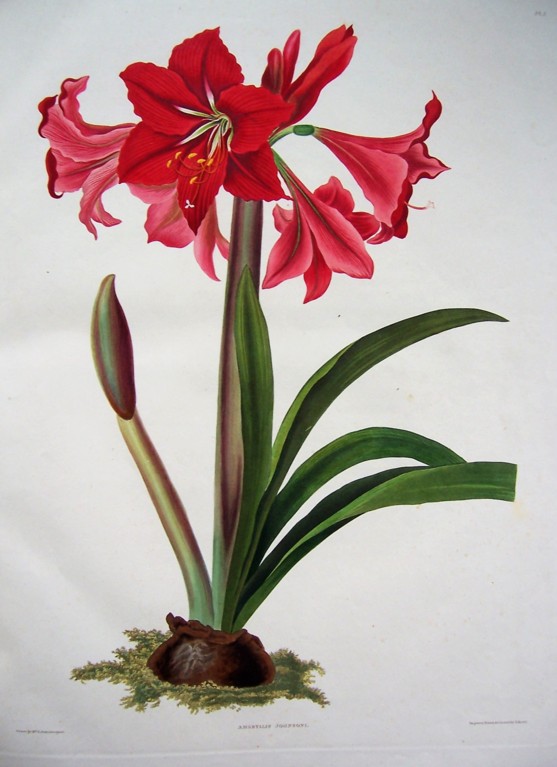
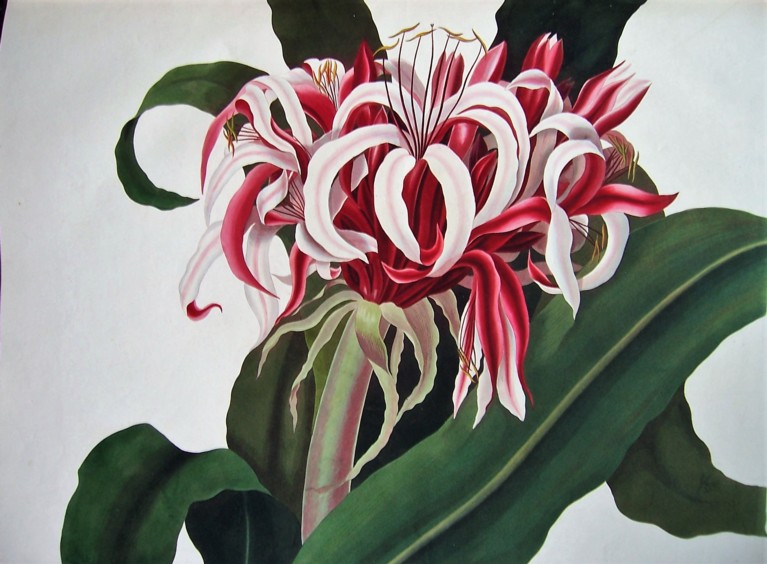
Plate 1: Amaryllis Johnsoni (‘the first hybrid amaryllis on record’); Plate 2: Crinum augustum (‘in flower in the Liverpool Botanic Garden on 15 May 1829’
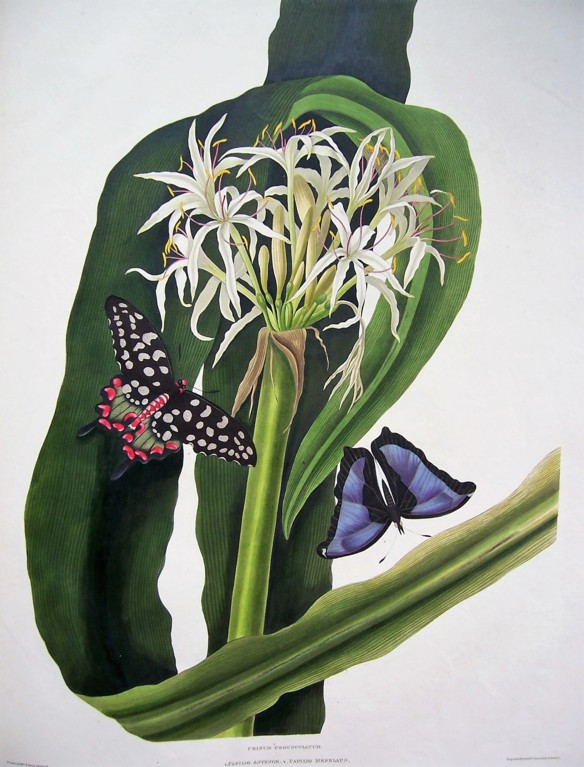
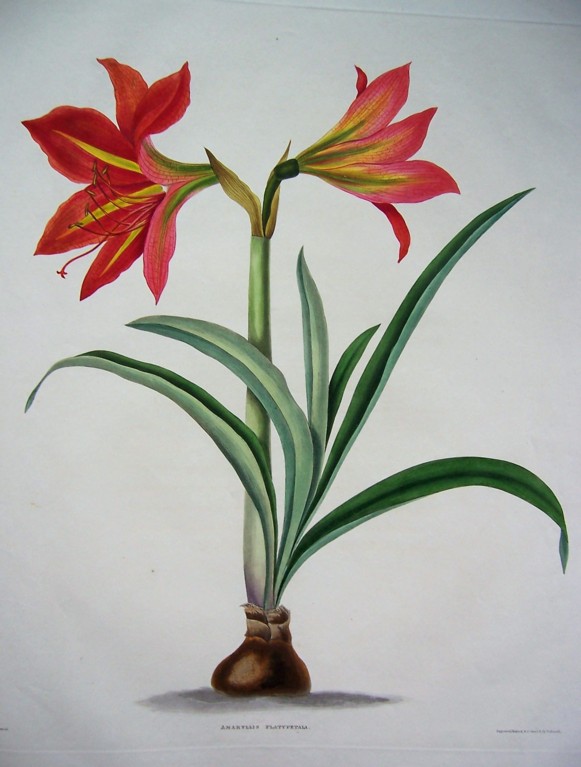
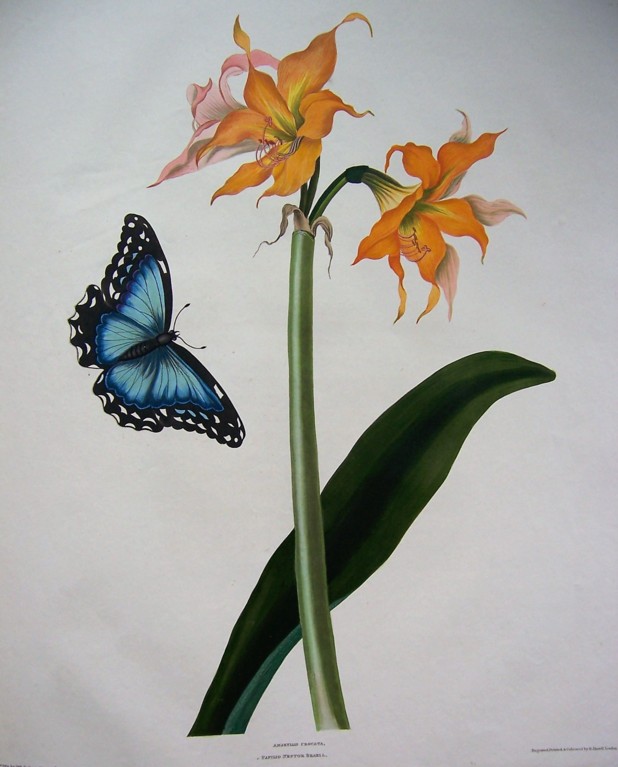
Plate 3: Crinum pedunculatum (‘a plant of magnificent growth … 5 feet high … Flowers freely in the Liverpool Botanic Garden every summer … Native of New Holland [i.e. Australia]’; Plate 4: Amaryllis platypetalia (‘sent from Rio … and flowered as here represented on 28 November 1828’); Plate 5: Amaryllis crocata (‘Drawn at the Liverpool Botanic Garden on 5 February 1826, from a bulb received in 1810 from Sao Paulo in Brazil’)
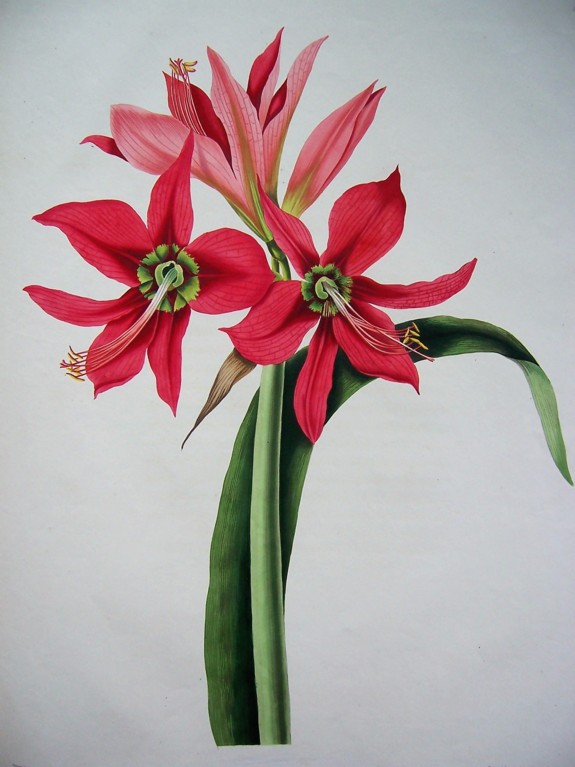
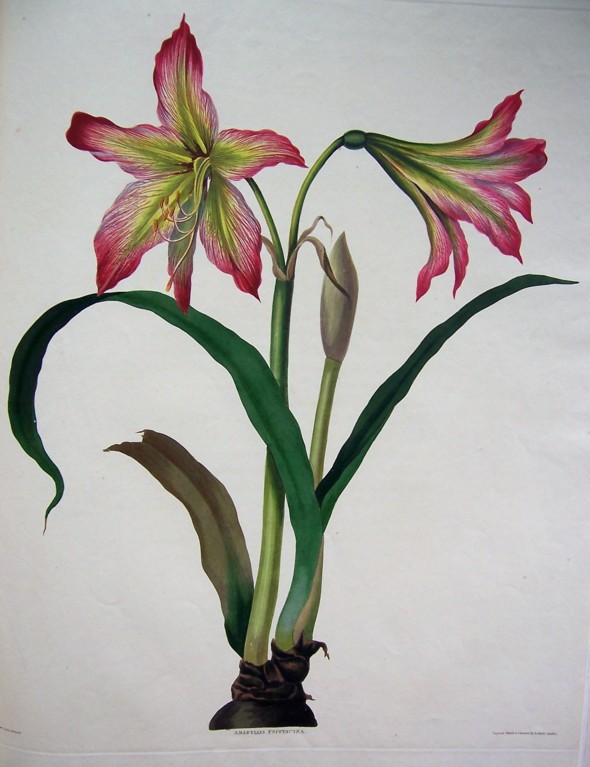
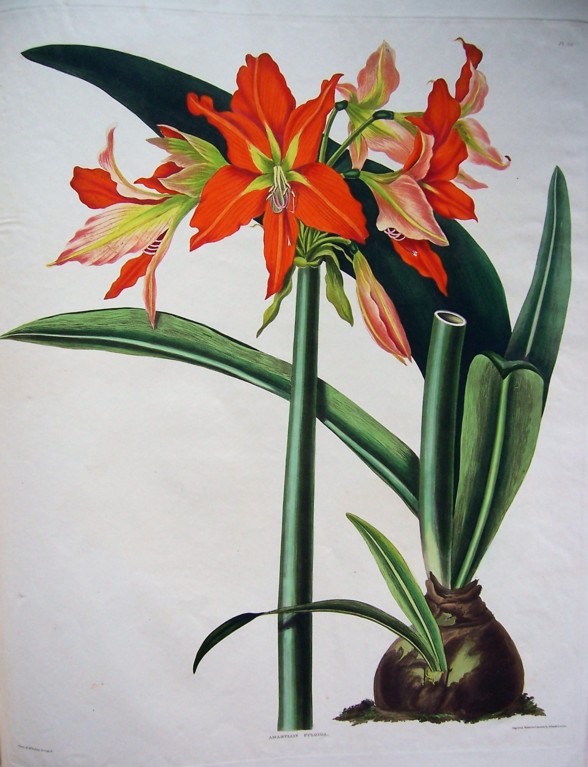
Plate 6: Amaryllis aulica (‘Another of the recent importations from Brazil’); Plate 7: Amaryllis psitticina (also from Sao Paulo; flowered at the Liverpool Botanic Garden ‘in great perfection’ in 1813); Plate 8: Amaryllis fulgida (also from Brazil)
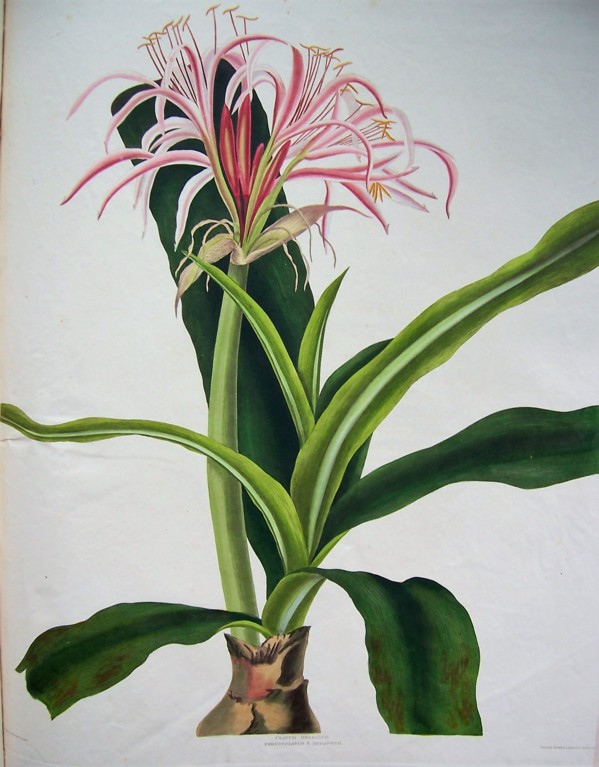
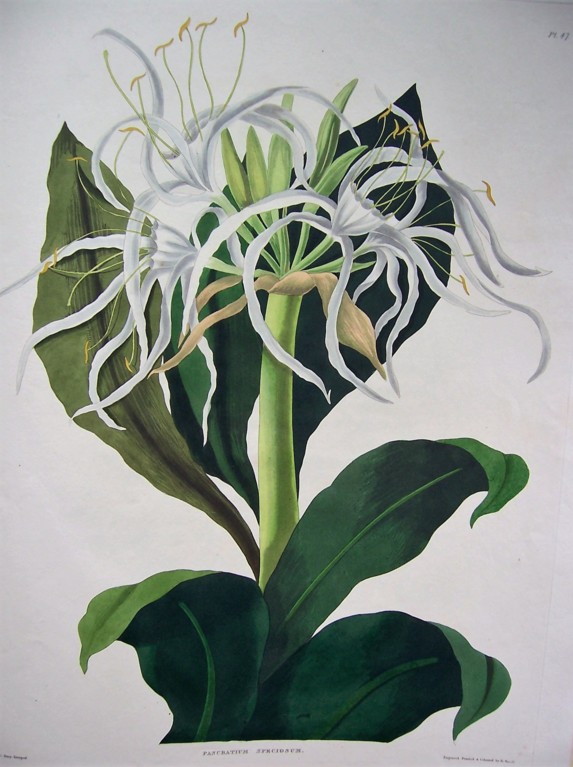
Plate 9: Crinum pedunculato-zeylanicum (‘It is here represented as it flowered [in the hothouse of a local enthusiast] in August 1828’); Plate 10: Pancraticum speciosum (‘The balsamic fragrance which it emits gratifies the sense of smelling, but the scent is too powerful to be inhaled long without causing headache … Drawn from a plant in the stove [hothouse] of the Liverpool Botanic Garden, where it flowers very luxuriantly several times each year’).
In 1830 Priscilla Falkner married a railway engineer, Edward Bury (1794-1858). His life’s work very much lay behind the pioneering railways whose literature featured in our last blog. Bury supplied many of the first engines used on the Liverpool and Manchester and London and Birmingham Railways, and was responsible for the locomotive department of the London and Birmingham Railway from its opening in 1838. His important paper on locomotive engines (1840) was of significance in the history of locomotive traction, and for his innovations he was elected a Fellow of the Royal Society in 1844. Priscilla Falkner’s marriage to a wealthy man meant that she could afford the best in the engraving of her work, and she continued to publish botanical illustrations. Her original sketches for Hexandrian Plants are now at Dumbarton Oaks in Washington DC.
Barry Windeatt (Keeper of Rare Books)
Images by Helen Carron (College Librarian)
20 August 2020
‘Amongst all the changes of the civilised and commercial world, there has never been one so eventful and prodigious as that effected by the agency of the Steam Engine. This superhuman power has superseded many long-established practices and confirmed customs … Like other great novelties and innovations, it has had to encounter much prejudice and enmity, much opposition and vexatious hostility’.
So declares Drawings of the London and Birmingham Railway (1839), one of a number of colour-plate books in Emmanuel’s Graham Watson Collection that record the earliest railways. Most of these books are now exceedingly rare. Their plates – which are usually insisted to derive from drawings made on the spot – depict the pioneering days of railway construction and travel, and the accompanying texts brim with excitement and pride in these ultra-modern developments.
.png)
.png)
Six Coloured Views on the Liverpool and Manchester Railway (London, 1831): [Plate 1]: ‘Excavation of Olive Mount, 4 miles from Liverpool’.
Five Views of the Dublin and Kingstown Railway (Dublin, 1834): [Plate 2]: ‘The Tunnel from the Excavation, looking towards Dublin’.
.png)
.png)
Six Coloured Views on the London and Birmingham Railway (London, 1837): [Plate 3]: ‘The Station at Euston Square’, and [Plate 4] ‘Viaduct at Watford’.
Six Coloured Views on the Liverpool and Manchester Railway (1831), ‘From Drawings Made on the Spot by Mr T. T. Bury,’ include a dramatic plate (Plate 1 above) depicting what the text describes as ‘a ravine cut though the solid rock to a depth of 70 feet … This cutting is nearly two miles in length and one of the most remarkable portions of the undertaking’. The text explains that the material excavated was then used to construct an embankment, and the writer revels in the traveller’s excitingly contrasting experience: being at one moment in the cutting ‘walled in with solid rock rising almost perpendicularly on either side’ and at the next being sped along an embankment ‘above the tops of the trees’. The main impetus for building the railway was moving goods and raw materials, rather than scenery-minded passengers, between the two booming towns, but by 1831 a train drawing five carriages of passengers went from Manchester to Liverpool in 67 minutes, halving the time taken only the previous year, thanks to an improved locomotive. The writer comments with satisfaction that shares in the company are ‘already selling, as we are assured, at a premium of nearly one hundred per cent’.
Five Views of the Dublin and Kingstown Railway (1834), by A. Nicholl, ‘From Drawings Taken on the Spot … with a Description of this Important National Work’, contains beautiful coloured aquatints of what was the first railway in Ireland, which covered a distance of six miles. The first train of eight carriages ‘crowded with ladies and gentlemen, proceeded the entire length of the line’ on 9 October 1834 in fifteen and a half minutes. There was one first-class carriage, three second-class and four third-class. It continued as a separate company until 1925. Emmanuel’s copy is a very rare and beautiful example of early railway literature, and depicts (Plate 2 above) a locomotive passing through a deep and rocky excavation.
Six years after his book of views on the Liverpool and Manchester, Bury published Six Coloured Views on the London and Birmingham Railway (1837), ‘From Drawings Made on the Line with the Sanction of the Company,’ now one of the rarest of English colour-plate books. It includes (Plate 3 above) a remarkable depiction of the platforms and interior of the station at Euston, with its vast canopy on numerous columns, an iron cathedral for steam. Numerous top-hatted gentlemen and ladies in their best bonnets are seated in what appear to be boxes on wheels, open to the elements and presumably to the smuts from the locomotive. Another ‘View’ (Plate 4) – of the viaduct at Watford – brings home what must have seemed the extraordinary scale and modernity of the new railways as civil engineering projects slicing through the landscape. An embankment dwarfs the adjacent houses, and the brickwork and stone of the viaduct are gleamingly clean and new. In the foreground a top-hatted gentleman pays court to a bonneted lady, in a designedly picturesque depiction of this new dimension to a rural landscape.
.png)
Drawings of the London and Birmingham Railway (London, 1839): [Plate 5] ‘Building Retaining Wall near Park Street, Camden Town. September 17, 1836’
Drawings of the London and Birmingham Railway (1839), by John C. Bourne, is a magnificent example of lithographed illustration. Versions with sepia or black-and-white illustrations are rare enough, but Graham Watson’s copy with hand-coloured plates is rarer still. The plates are accompanied with a text by John Britton that breathlessly chronicles the facts and figures of all the feats of engineering – cuttings, embankments, viaducts, tunnels – that enabled the line to be built. Plate 5 above illustrates the scale of the earthworks needed to bring the line into London.
.png)
Drawings of the London and Birmingham Railway (London, 1839): [Plate 6] ‘Building the Stationary Engine House, Camden Town. April 26, 1837’
Plate 6 shows construction of a vast underground vault beside the railway tracks in the Camden Town goods yard. The Camden depot was originally to have been the London terminus of the London and Birmingham Railway, and when in 1839 Parliament allowed the line to be extended to a new terminus at Euston it was discovered that the gradient between Euston and Camden was too steep for the current locomotives. Nothing daunted, Robert Stephenson constructed a system whereby trains were hauled up from Euston to Camden by huge steam-powered winches on a mile-long ‘endless rope’, 7 inches in circumference and weighing almost 12 tons.
The two 60-horsepower engines were housed in an underground cavern constructed at Camden, which was 100 feet long and 63 feet wide, and on the surface was marked by two 130-feet chimneys. Signals were conveyed between Euston and Camden by a ‘Pneumatic Telegraph’ (‘it consists of a tube underground, through which the air is forced, so as to produce a shrill whistle … The time occupied in the passage of the signal is less than four seconds’). Once at Camden, the carriages were attached to a steam engine and continued to Birmingham. Yet only a few years later, by as soon as 1844, Stephenson had developed locomotives that could manage the incline and the whole vast scheme was obsolete. The engines were sold off to a mine in Russia and the cathedral-like vaults were abandoned. They were rediscovered, flooded, in 1993.
.png)
Drawings of the London and Birmingham Railway (London, 1839): [Plate 7] ‘Tring Cutting. June 17, 1837’
Plate 7, showing construction of the cutting near Tring, witnesses to the immense labour that went into such a deep excavation by manual labour. On one side of the cutting, as far as the eye can see, men are guiding wheelbarrows of earth, which are being drawn up the side of the cutting by a system of ropes and pulleys powered by horses on the top of the bank. The text confirms that between 30 and 40 such ‘horse-runs’ were constantly working for many months, and comments: ‘This is a dangerous occupation, for the man rather hangs to, than supports the barrow, which is rendered unmanageable by the least irregularity in the horse’s motion’. However, ‘such was their surefootedness that only one fatal accident occurred’. Attempts to introduce safer methods were actively resisted by workers: ‘A moving platform was invented by the engineer to supersede the necessity of thus risking life and limb, but the workmen, who considered it was designed to lessen their labour and wages, broke it’.
.png)
.png)
Drawings of the London and Birmingham Railway (London, 1839): [Plate 8] ‘Working Shaft, Kilsby Tunnel’; [Plate 9] ‘Great Ventilation Shaft, Kilsby Tunnel. July 8, 1837’
Plates 8 and 9 show both a working shaft and a ventilation shaft in the tunnel at Kilsby near Rugby. This tunnel was a vast undertaking, using thirty million bricks and, because of its length, requiring two immense ventilation shafts, both 60 feet in diameter, with the deeper shaft 130 feet deep and requiring one million bricks. The plate of one of the eighteen working shafts shows a ‘skip’ or box being hauled up laden with earth in the very humid atmosphere. There was a constant need to pump water up out of the tunnel. 1300 men toiled on the tunnel and twelve steam engines worked night and day.
Passengers began their journey from London to Birmingham by passing through what the railway builders designed to be the most impressive entrance to anywhere in London (Plate 10). This was the remarkable structure now remembered as the ‘Euston Arch’, but Britton calls it more grandly the ‘Propylaeum or architectural gateway’ and enthuses about how it is ‘remarkable for magnitude … the massiveness and boldness of its design [being] on a grander scale than anything of the kind yet attempted in this country’ and so disproving any idea that ‘the English are too parsimonious and calculating’ to produce grandeur in public buildings. The plate shows the huge arch dwarfing the figures and coaches of the approaching passengers, for the columns of the arch were claimed to be higher than those of any other building in London at the time. Even in the Victorian age, the Arch had its critics for being too large, too grandiose. Yet its demolition in the early 1960s has become an iconic instance of the barbarous cultural vandalism of that most tawdry of decades. Once itself an emblem of modernity’s ambitions, the Euston Arch was destroyed to enable ‘modernization’ of Euston into what we see today.
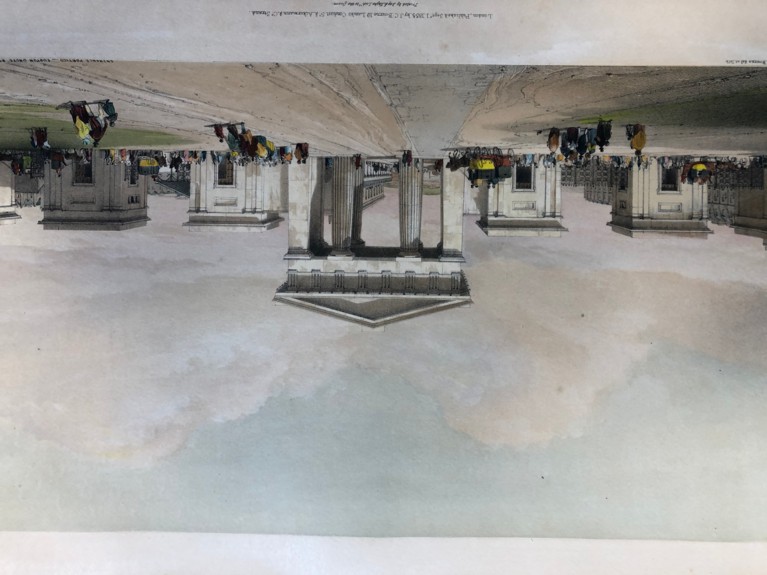
Drawings of the London and Birmingham Railway (London, 1839): [Plate 10] ‘Entrance Portico, Euston Grove Station’
Barry Windeatt (Keeper of Rare Books)
19 August 2020
At the beginning of lockdown swimming pools across the country were closed, Emmanuel’s being no exception. The bath here (below, August 2020) reverted to a state of nature, its pellucid turquoise waters gradually turning a soupy green, and it was not long before an opportunistic quartet of ducks took up residence.
.png) Older members of the college will doubtless recall—fondly or otherwise—that when they were up at Emma the pool always looked like this. The first college swimming bath was created in 1745, by converting the ornamental pond in the north–east corner of the Fellows’ Garden. Completely re–bricked in 1855, the Victorian bath (known to many generations of Emma students as ‘the Tank’) was fed, like its predecessor, from the branch channel leading off Hobson’s Conduit, that had been laid across the college grounds in the 1630s. This ran from Chapman’s Garden to the Paddock pond, and thence into the bath, without much in the way of intervening filtration. Although this state of affairs was deemed acceptable for more than two centuries, in 1959, the college authorities decided that the pool was so dirty they would have to close it ‘lest epidemic should result or…install some kind of filtration plant’. It was agreed that the bath should be kept in use, but henceforth be supplied with mains water and purification equipment.
Older members of the college will doubtless recall—fondly or otherwise—that when they were up at Emma the pool always looked like this. The first college swimming bath was created in 1745, by converting the ornamental pond in the north–east corner of the Fellows’ Garden. Completely re–bricked in 1855, the Victorian bath (known to many generations of Emma students as ‘the Tank’) was fed, like its predecessor, from the branch channel leading off Hobson’s Conduit, that had been laid across the college grounds in the 1630s. This ran from Chapman’s Garden to the Paddock pond, and thence into the bath, without much in the way of intervening filtration. Although this state of affairs was deemed acceptable for more than two centuries, in 1959, the college authorities decided that the pool was so dirty they would have to close it ‘lest epidemic should result or…install some kind of filtration plant’. It was agreed that the bath should be kept in use, but henceforth be supplied with mains water and purification equipment.
.png) An alumnus of Emmanuel happened to run a business that manufactured filtration apparatus, so the college placed an order with him, only to cancel it when it received a much lower quotation from Gilliam & Co, Ltd (R: Letterhead of Gilliam & Co, Ltd). This was not only embarrassing but also, as it turned out, perhaps a false economy: the equipment supplied by Gilliam was initially unsatisfactory and caused many a headache for the Domestic Bursar, Ken Roscoe. There was difficulty getting the plant to work: the water was soon ‘full of algae’ & large amounts of chemicals were necessary to clear it. The filter clogged up (not helped by two storms that washed soil into the bath from nearby flowerbeds), and the underwater vacuum cleaner was inadequate for its purpose. The shed housing the filtration machinery, erected by a local sub–contractor, was such a jerry–built eyesore that the college demolished it, and refused to pay the bill. To cap it all, the Cambridge Water Company complained about the amount of leakage, and demanded that a different valve be fitted to the mains supply to avert the risk of ‘water hammer’.
An alumnus of Emmanuel happened to run a business that manufactured filtration apparatus, so the college placed an order with him, only to cancel it when it received a much lower quotation from Gilliam & Co, Ltd (R: Letterhead of Gilliam & Co, Ltd). This was not only embarrassing but also, as it turned out, perhaps a false economy: the equipment supplied by Gilliam was initially unsatisfactory and caused many a headache for the Domestic Bursar, Ken Roscoe. There was difficulty getting the plant to work: the water was soon ‘full of algae’ & large amounts of chemicals were necessary to clear it. The filter clogged up (not helped by two storms that washed soil into the bath from nearby flowerbeds), and the underwater vacuum cleaner was inadequate for its purpose. The shed housing the filtration machinery, erected by a local sub–contractor, was such a jerry–built eyesore that the college demolished it, and refused to pay the bill. To cap it all, the Cambridge Water Company complained about the amount of leakage, and demanded that a different valve be fitted to the mains supply to avert the risk of ‘water hammer’.
Eventually, of course, all the problems were resolved and the pool was ready for use by the Easter Term of 1961. The College Magazine for that year informed its readers that the swimming bath had been ‘transformed’ by the installation of circulating and filtration apparatus, and that ‘it now presents on sunny days a cool seductive blueness’.
Amanda Goode, College Archivist
13 August 2020
A Place for Everything, written by Anna Wilson (1988), is a searing account of a mother's late diagnosis of Aspergers, and its effects on a whole family. Speaking about the book on BBC Radio 4 Women's Hour, Jane Garvey said, 'You don't have to have a connection to autism to find much that you can relate to in this book'. Anna's family story raises questions about the need for greater support of women with autism, and what it means to care for our parents in their final years. Below, Anna has kindly given us an insight into this story, which began at Emmanuel in the 1960s:.png)
I went up to Emma in 1988, twenty–six years after my parents had met there. Neither of them was at the college—Dad went to Trinity, & Mum to Newnham. They were both Classicists, so it was appropriate that they should fall in love while performing The Frogs by Aristophanes in Emma’s Old Library.
Image (L): Anna in 2020, A Place for Everything, Anna's parents at the 1963 Cambridge Union Ball
Dad instilled in me a lifelong love of language and storytelling. At bedtime, he would weave tales from Greek myths, the Iliad and Odyssey. Years later, it would come to feel as though Dad’s beloved myths had become a reality, as we set off on our own 'odyssey' into the nightmarish lands of sickness, ageing and death. My memoir about Mum’s diagnosis of autism at the age of 72, A Place for Everything, is the tale of what happened en route.
Looking back, the signs of Mum being on the spectrum were hiding in plain sight. Her obsession over time–keeping should alone have been a red flag. Like Alice’s White Rabbit, Mum would pace, checking her watch, the carriage clock and the grandfather clock, muttering, ‘We’re going to be late!’. Time was Mum’s enemy: it’s uncontrollable and slippery, whether or not we are neurotypical, and our desire to control it is bound up in our fear of it running out. It’s perhaps no wonder that time caused Mum so much anxiety.
The day Dad died, time was of the essence. Mum was under section on a mental health ward, locked in, unable to get anywhere, on time or not. I was in Thailand in a different time zone. My sister called from the UK to say that Dad had only thirty–six hours left to live. I would need every last second of that time to make it back to see Dad before he kept his appointment with death. Thirty–six hours is not long. A day and a night and a day. Time that is easily wasted.
In the end, it did take exactly thirty–six hours for me to get to his bedside. Thirty–six hours of excruciating minutes that crawled across the face of every clock I checked. Minutes in which I couldn’t move fast enough, as though under a curse. I should have been used to this feeling. Caring for Mum had sent me spinning down the rabbit hole into a mad, mad world long before Dad’s cancer had crashed in, ripping me apart.
I wasn’t too late in the end. I walked into the darkened room where Dad lay, and exactly one hour later, he drew his last breath. It’s been five whole years without him. Two and a half without Mum. Yet it’s not five years. It’s a nanosecond. And if I can hold them still in my mind’s eye—that beautiful couple who met at Emma in 1962—they will always be here, Mum and Dad. Together. Time without end.
6 August 2020
Jenny Kartupelis (1979) is an author, who has recently written about relational care. Here, she tells us about outcomes of her research into care for older people, and how COVID–19 has brought this discussion into wider focus.
.jpg) Like a kaleidoscope, the pandemic has taken all the fragments of our lives and thrown them into new patterns. One of the issues that has risen to the top, and caught the light of publicity at last, is the whole question of how we treat & value older people in this country. Discharged from hospital without testing, to free up beds for COVID–19 patients, some may have brought the infection into care homes; while locum carers may also have unwittingly carried it. Whatever the process, the result has been tens of thousands of elderly deaths in care environments.
Like a kaleidoscope, the pandemic has taken all the fragments of our lives and thrown them into new patterns. One of the issues that has risen to the top, and caught the light of publicity at last, is the whole question of how we treat & value older people in this country. Discharged from hospital without testing, to free up beds for COVID–19 patients, some may have brought the infection into care homes; while locum carers may also have unwittingly carried it. Whatever the process, the result has been tens of thousands of elderly deaths in care environments.
As a result of a survey that I was commissioned to do by Abbeyfield—a charity which owns numerous care homes in the UK and abroad—I have been writing on relationships between elderly people, carers & society for some years now. The stand–out finding of my research was that the best outcomes for all concerned are achieved by ‘relational care’—that is, the building of trust and mutual knowledge over a period of time, creating a supportive network and ‘family’ of wellbeing.
My next book, Making Relational Care Work for Older People was published in autumn 2020, and offers practical advice on how to create environments that favour good care. For instance, quite a few of us have rediscovered during lockdown, the pleasures of cooking & sharing food, but may not until now have thought much about the great variety of impacts that good nutrition can have on our lives. Getting everything right about serving meals in care settings can have a massive impact, not only on physical health, but also on mental & emotional wellbeing. This is just one example: the rather obvious & more subtle factors that influence relationships will be the subject of another blog.
6 August 2020
The Graham Watson Collection in Emmanuel Library includes a copy of Robert Thornton’s Temple of Flora (1799-1807), the most stunningly sumptuous achievement of botanical illustration, which, however, proved personally ruinous for Thornton.
Thornton (1768-1837) studied at Cambridge and was inspired by the teaching of John Martyn, Professor of Botany, and by the work of the Swedish scientist Carl von Linnaeus (1707-78), who had formalized the system of binomial nomenclature for living things (the first part being the name of the genus, and the second the name of the species within the genus – thus, ‘homo sapiens’). The deaths of his parents and elder brother left Thornton with a considerable fortune, which he devoted to publishing his New Illustration of the Sexual System of Carl von Linnaeus. The first two parts were expositions of the sex of plants, but the third, The Temple of Flora, was to have a lavish series of plates depicting flowers. Each plate is accompanied by descriptions in suitably flowery prose, selections of flower-poetry, accounts of flower lore and symbolism, and other information.
In each plate the flower is depicted against a background of scenery designed to represent its habitat, whether that be Egypt with distant pyramids, the Cape of Good Hope, or a Dutch landscape with windmills behind an image of tulips. As Thornton put it, ‘each scenery is appropriated to its subject’. So of the auricula he remarks: ‘Being a native of the Alps, hence, in our Picture, it is seated near a chain of tremendous mountains’. Or of Cactus grandiflorens, ‘Thus, in the night-blowing Cereus you have the moon playing on the dimpled water, and the turret clock points XII, the hour at night when this flower is in its full expanse’. And so a very English-looking church tower with clockface, and with some fashionably Picturesque decay, is depicted behind this most exotic and exuberant Jamaican plant. Inevitably, Thornton’s book is now valued not for what he hoped was its scientific worth but as testimony to a Romantic vision of nature, landscape and flowers.
.png)
.png)
.png)
.png)
.png)
.png)
Although Thornton originally envisaged over 70 illustrations, 31 were produced, engraved in aquatint, stipple and line engraving by Thomas Medland. The impressions were printed in colour but finished by hand, and because most of the plates were altered and added to during production, each plate can be a different ‘state’ of that particular image, and each copy of the book is distinct. Graham Watson purchased his copy at the sale of the library of the Society of Herbalists, and his notes record several Sotheby’s experts assuring him that the copy now in Emmanuel was the finest they had ever seen. The plates were issued to subscribers in parts over the years 1799-1807 and published in book form in 1807. It is an ‘elephant folio’ of enormous size (55 x 44 cms). But subscriptions were always disappointing. After long years of war with revolutionary France, high taxation to finance that war, and generally hard times, it was scarcely the moment for marketing such a luxurious book. To raise funds to rescue the scheme – which he saw as a national undertaking and dedicated to Queen Charlotte, herself a botany enthusiast – Thornton was allowed by Parliament in 1811 to hold a public lottery, with the original paintings for the plates as first prize, and various plates as other prizes. But the lottery failed to sell sufficient tickets, and at the time of his death Thornton was destitute.
Barry Windeatt (Keeper of Rare Books)
Images by Helen Carron (College Librarian)
23 July 2020
Emma member Greg Spiro (1966)'s poem—Swannet—was recently shortlisted for the Fish Publishing Lockdown Poetry Prize, which asked for poetic personal responses to the lockdown in no more than 19 lines. Here, he kindly shares his successful poem with us, as well as explaining the inspiration behind it.
It was a sad March day when London Wildlife Trust announced the temporary closure of Woodberry Wetlands. The path was deemed too narrow for social distancing, and its popular Coal Café also had to close its doors. In 2016, Sir David Attenborough had opened the old reservoir, closed for 200 years, as a Wetlands Centre between Finsbury Park & Stoke Newington. Hackney Council and Berkeley Homes are pursuing London’s largest regeneration project, building flats alongside an urban wildlife corridor. Yes, this is gentrification on a massive scale, yet we have a diverse community and an enviable experience of a natural world instead of more traffic and shops. Look at a map and you’ll see our watery doorsteps: two vast reservoirs, a sailing lake to the West and a haven for waterfowl in a reedy environment to the east.
We had recently relocat.png) ed to a ground–floor flat overlooking the Wetlands Reserve. Our disappointment at closure was mitigated by the path that borders the narrow River New, just metres away from the reservoir. We could walk our dog and join the community of swan, coot, moorhen, duck & geese watchers for whom the breeding season this year has aroused intense interest, perhaps as consolation for having our own wings clipped for lockdown.
ed to a ground–floor flat overlooking the Wetlands Reserve. Our disappointment at closure was mitigated by the path that borders the narrow River New, just metres away from the reservoir. We could walk our dog and join the community of swan, coot, moorhen, duck & geese watchers for whom the breeding season this year has aroused intense interest, perhaps as consolation for having our own wings clipped for lockdown.
Wildlife has largely thrived and the daily activity of water birds creating and feeding their young has been informative and emotional. These creatures are extraordinarily diligent in attending to their families. It has helped us to suspend our own anxieties, providing a living experience of functioning nature in an open–air classroom for parents, grandparents, and their curious children. Of course, there have been moments when seven cygnets become six, and only nine of twelve ducklings can be counted ‘today’: a salutary reminder that nature favours safety in numbers, and comes with harsh realities. Happily, the Wetlands reopened on 15 July following a community fundraiser.
All this has been the inspiration for my poem Swannet:
Throned on last years nest, eggs descended,
Her neck charmed by the reeds to coil
Among them while her cob forages a few feet away,
Refurbishment the task from which they do not stray.
We onlookers on the pilgrim-punctuated path
Cast peas, potato peels and too much bread.
Clicking like well-intentioned paparazzi
Marshalled by an eight year old, “Two metres please.”
Her sibling pleads indignantly, “Why can’t I play football on the grass!”
Brushed by sweating runners as if speed defies effect
We shuffle nervously to adjust our line.
Suddenly, she’s fending off a rat attack, wings raised,
A gasp till eggs all counted and regained,
Their living has become our life-sustaining aim.
©Greg Spiro, London, June 2020
23 July 2020
In the grounds of Emmanuel College there can be found a most remarkable tree. Next to the pond in Chapman’s Garden, is a tall, alien–looking conifer with a deeply fissured trunk: its branches bearing soft green needles that turn a beautiful shade of reddish–brown in autumn.
.png) Planted in the late 1940s, it is a majestic representative of the species Metasequoia glyptostroboides, whose common name, the Dawn Redwood, reflects its ancient origins. Once a familiar sight throughout the northern hemisphere, Metasequoias were thought to have become extinct about five million years ago. Then, in 1941, a few living examples were discovered in a remote part of China. Nothing more could be done until after the Second World War, but in the autumn of 1947 a large quantity of seeds was collected from the trees. Most were sent to the USA, but a small cache came into the hands of Dr Ronald Silow, a botanist who had worked in Cambridge before going out to China in 1947. He forwarded the seeds to Frederick Brooks, a graduate & Fellow of Emmanuel College, and Professor of Botany at Cambridge University.
Planted in the late 1940s, it is a majestic representative of the species Metasequoia glyptostroboides, whose common name, the Dawn Redwood, reflects its ancient origins. Once a familiar sight throughout the northern hemisphere, Metasequoias were thought to have become extinct about five million years ago. Then, in 1941, a few living examples were discovered in a remote part of China. Nothing more could be done until after the Second World War, but in the autumn of 1947 a large quantity of seeds was collected from the trees. Most were sent to the USA, but a small cache came into the hands of Dr Ronald Silow, a botanist who had worked in Cambridge before going out to China in 1947. He forwarded the seeds to Frederick Brooks, a graduate & Fellow of Emmanuel College, and Professor of Botany at Cambridge University.
Professor Brooks took the seeds to the Cambridge Botanic Garden early in March 1948. They ‘germinated freely’ and in January 1949, the Botanic Garden planted out three seedlings in their grounds, one of which survives. This tree is said to have been the first specimen of Metasequoia glyptostroboides planted on British soil, and as such, it features in several books on famous trees. It could be argued, though, that Emmanuel’s two Dawn Redwood trees are almost equally venerable, for they too were grown from Professor Brooks’ batch of seeds, as was the Metasequoia in the Fellows’ Garden at Clare College. (Above: Dawn Redwood tree in Chapman's Garden)
.png) Emma’s trees were probably planted out in March 1949; not by Professor Brooks himself, but by his colleague James Line, who was also an Emmanuel Fellow & a botanist. The College Magazine issued in the summer of 1950 informed members that ‘two specimens of the newly discovered Chinese conifer Metasequoia glyptostroboides, which were obtained by Professor Brooks, are now rapidly shooting up by the pond in Chapman’s Garden’. In the autumn of 1953, the smaller of the two trees was moved to a new site in the Paddock, near the Squash Court. (R: Dawn Redwood close–up)
Emma’s trees were probably planted out in March 1949; not by Professor Brooks himself, but by his colleague James Line, who was also an Emmanuel Fellow & a botanist. The College Magazine issued in the summer of 1950 informed members that ‘two specimens of the newly discovered Chinese conifer Metasequoia glyptostroboides, which were obtained by Professor Brooks, are now rapidly shooting up by the pond in Chapman’s Garden’. In the autumn of 1953, the smaller of the two trees was moved to a new site in the Paddock, near the Squash Court. (R: Dawn Redwood close–up)
.png) In its natural habitat, the Dawn Redwood is a critically endangered species, so we are privileged to be able to view two fine specimens in the college gardens. Professor Brooks did not live to see his trees grow to maturity, as he died in 1952, but his arboreal legacy will surely enthrall many future generations of Emmanuelians.
In its natural habitat, the Dawn Redwood is a critically endangered species, so we are privileged to be able to view two fine specimens in the college gardens. Professor Brooks did not live to see his trees grow to maturity, as he died in 1952, but his arboreal legacy will surely enthrall many future generations of Emmanuelians.
(L: Emma Fellows, taken in Front Court in 1941, Professor Frederick Brooks far right & James Line far left)
Amanda Goode, College Archivist
23 July 2020
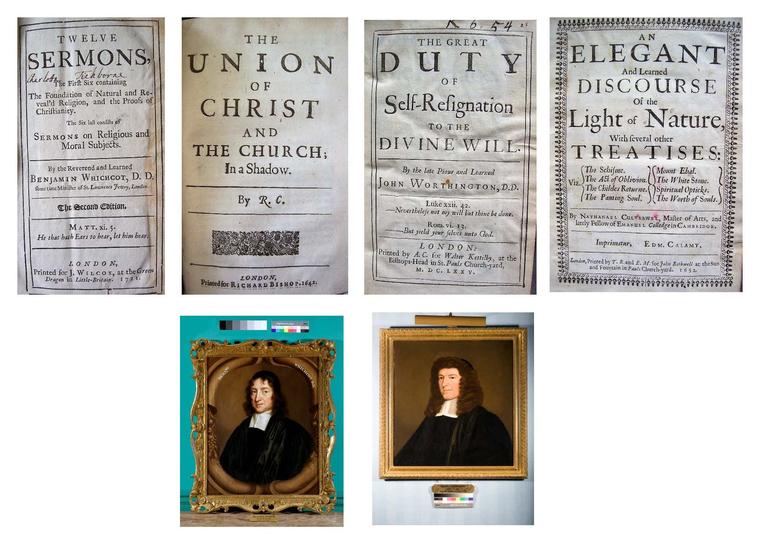
The group of seventeenth-century thinkers now called ‘The Cambridge Platonists’ might equally well have been called ‘The Emmanuel Platonists’ since all but one of its principal figures were students and Fellows at Emmanuel. In their lifetimes they did not think of themselves as a group or movement, did not call themselves Platonists, and much of their work was only published posthumously. But by the eighteenth century they had been christened the ‘Cambridge Platonists’, and their contribution to moral philosophy is a major source for modern ethical theory and ideas of tolerance. They were the first philosophers to write primarily and consistently in the English language, and they coined such terms as ‘materialism’ and ‘consciousness’. Their views were developed in reaction to the stern Calvinistic scholasticism prevailing at Cambridge in their formative years. They held Plato and Plotinus in great regard, and their respect for ancient philosophy convinced them of the eternal existence of moral principles and truth. They were very up-to-date with developments in philosophy, reading Descartes and Spinoza, but rejecting the new mechanistic natural philosophy and repudiating Hobbes. They were convinced of the compatibility of reason and faith, and did not accept that ritual, church government, or detailed dogma were essentials of Christianity. They did not live apart from their times. Two of the Emmanuel Platonists, Whichcote and Cudworth, were on the committee of sixteen divines with whose advice Cromwell decided on the readmission of the Jews to England in 1655. Protestant Emmanuel was a source of substitutes when Royalist heads of Cambridge colleges were ejected by the Cromwellians: Whichcote and Worthington were appointed at King’s and Jesus (and were then in turn ejected at the restoration of Charles II); Cudworth was appointed at Clare but resigned early, allegedly because Clare would not pay him.
Benjamin Whichcote (1609-1683) was the earliest of the ‘Platonists’, but the main source for his tolerant, optimistic and rational philosophical views are his posthumously published sermons, which amount to a consistent body of ethical teachings. For Whichcote, human nature is rational and perfectible, and God communicates with man as much through reason as through revelation. Like other Emmanuel Platonists, Whichcote emphasises interior spirituality over the externals of religion (which, of course, offended those who prized the latter). Whichcote’s Emmanuel pupil John Worthington (1618-1671) was an active translator and editor of philosophical works.
Ralph Cudworth (1617-1688) was perhaps the most significant of the group, publishing major work in his lifetime, although important material remains unpublished in manuscript. For Cudworth, as for Plato, soul is ontologically prior to the physical world. Mind precedes the world, and ideas and moral principles are eternal and self-subsistent things. Since our minds mirror the mind of God we are furnished with the ability to reason, and Cudworth posits a ‘Plastic Nature’ that acts as an intermediary between the divine and the natural world, through which God makes his wisdom and goodness intelligible through created nature. Much to his disgust, Cudworth’s refutations of atheism in his The True Intellectual System of the Universe (1678) were criticised for showing too much tolerance, with a supposedly crypto-atheistic intent. His daughter Damaris Cudworth (1659-1708) may be seen as one of the early women writers of philosophy in England. She was a friend of John Locke, corresponded with Leibniz, and, despite chronic eyesight problems, published two books: A Discourse concerning the Love of God (1696) and Thoughts in reference to a Vertuous or Christian Life (1705). Her thinking is a mix of her father’s Platonism, Lockean theories and arguments, and her own proto-feminist advocacy of education for women and a life of reason.
The short life of another Emmanuel Platonist, Nathaniel Culverwell (1619-1651) meant that his important Discourse was published posthumously. The Discourse resonates with the humanist spirit and liberal theological outlook of Whichcote. Culverwell conceives of God as an intellectual being who communicates with man through reason which is the ‘light of nature’, an ‘intellectual lamp’ placed by God in the human soul. Culverwell is optimistic about human capacities, seeing all human minds as furnished with ‘clear and indelible’ principles of reason and morality, such that we become more like God through the exercise of reason. The College Library’s copy of Culverwell’s Discourse has been dedicated by its donor in an inscription to the Master ‘and to the Fellows of that religious and happy foundation’.
Barry Windeatt (Keeper of Rare Books)
Images by Helen Carron (College Librarian)
9 July 2020
Over the past 12 weeks, the lower levels of traffic, aircraft and other human noise has made many of us more attentive than usual to the sound of birdsong.
.png) But the rich texture and variety of the dawn chorus is notoriously difficult to reduce to words.
But the rich texture and variety of the dawn chorus is notoriously difficult to reduce to words.
Browning wisely didn’t try—he left the thrush to do his own recapturing—but every morning at 05:58 or thereabouts on BBC Radio 4’s ‘Tweet of the Day’ some brave naturalist, broadcaster or writer has a go at describing the churrings and chatterings of their chosen species. Some attempt phonetic rendition, while others resort to metaphor, from the mundane to the fanciful. Here is nature writer Mark Cocker comparing the song of the wood warbler to a coin spinning round on a metal top: www.bbc.co.uk/sounds/play/b09wswn8
So here’s your writing exercise: choose the song of a common bird and try to find ways of describing the sound: www.rspb.org.uk/birds-and-wildlife/bird-songs/what-bird-is-that/
9 July 2020
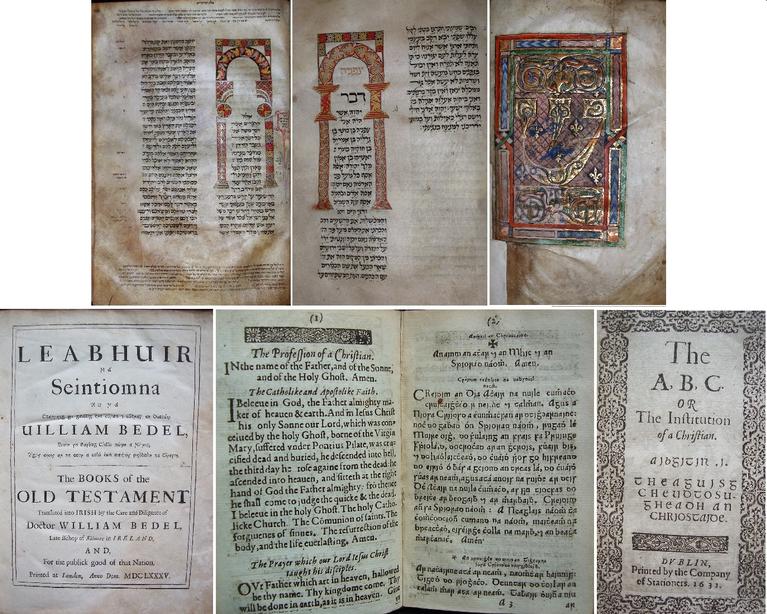
Three rare books in Emmanuel Library witness to the legacy of a life that represents a remarkable openness to other cultures.
William Bedell (1571-1641) came to Emmanuel as a student in the year of its foundation, 1584. He was partially deaf. By 1592 he was a Fellow and by 1597 ordained; he later left, as the Founder intended, to take up the ministry. By 1607 he was chaplain to the English ambassador to Venice. It was an exciting time for an English Protestant to be in Venice, since the Serene Republic’s decidedly unserene relations with the Papacy at this period made Protestants dare to hope that Venice too would throw off the shackles of papal authority. Bedell much admired the beautiful Venetian churches and spectacular ecclesiastical ceremonies, and his affection for Venice always moderated his staunchly Protestant criticisms of Roman Catholicism. It was in Venice that Bedell took Hebrew lessons from a prominent rabbi of the Venetian ghetto, Rabbi Leo da Modena, and at this time that Bedell acquired – reputedly for its weight in silver – the splendid thirteenth-century Hebrew Bible that he would later bequeath to Emmanuel.
After returning to his parish duties near Bury St Edmunds, Bedell reluctantly accepted appointment in 1627 as Provost of Trinity College Dublin. Here he controversially instituted frequent lectures in the Irish language and began his own study of Irish, intent on bringing the reformed faith to the Irish in their own tongue. Neither Bedell nor his wife had wanted to leave the safety and comfort of Suffolk for Ireland – and there was no financial incentive – but Bedell felt it was his duty. In 1629 he was appointed Bishop of Kilmore in Co. Cavan, a predominantly Gaelic-speaking area. Bedell published a bilingual catechism with parallel English and Irish texts (Dublin, 1631), and Emmanuel possesses in Archbishop Sancroft’s library one of the only two known copies surviving of this little book. Bedell also worked on a translation of the Old Testament into Irish, the bulk of which was prepared under his direction and with his assistance. It was published posthumously in 1685 and long remained the only translation.
Although so staunchly Protestant, Bedell was comparatively liberal in Ireland: he believed souls should be won by persuasion, and was respected by both Protestants and Roman Catholics for his opposition to corruption in the Church of Ireland and his concern for the spiritual welfare of Irish people. At a time when most Protestants thought the Irish language should be stamped out, Bedell’s catechism and Old Testament show him respecting, accepting and adapting to the culture in which he found himself.
In the Irish rising of 1641 Bedell was evicted from Kilmore by the rebels and his library and effects were burned (his Hebrew Bible being saved by a grateful admirer). During an unusually severe winter he was confined for several weeks on the derelict island-fortress of Clough Oughter. This broke his health and he died soon afterwards. As a sign of respect the rebels provided a military escort for his funeral cortege and fired a volley over the grave, pronouncing the ambivalent epitaph:
‘Requiescat in pace ultimus Anglorum’
[Rest in peace, ultimate – best? last? – of the English].
(Bedell’s Hebrew Bible has recently been digitized as part of an ambitious project by The National Library of Israel to digitize all Hebrew manuscripts).
Barry Windeatt (Keeper of Rare Books)
Images by Helen Carron (College Librarian)
9 July 2020
Anthony Newman (1991) is the founder of Ape2o, a business with an environmental focus. Here, he tells us about what inspired him to tackle the planet's plastic problem, and how Ape2o is aiming to provide the solution.
I have fond memories of my time at Emma studying Economics. We were all blessed with great tutors (thank you Mike Gross!), a great location and beautiful gardens. When I left Cambridge it’s safe to say I took the path less travelled. A ski season, followed by 10 years in the music industry releasing records (some hits, some misses), 5 years in marketing and advertising ventures learning about brands, then starting my own businesses in drinks (a functional soft drinks co themed on extreme sports and then a craft microbrewery in Tropical North Queensland).
.png) It was in Australia, where the rainforest meets the Great Barrier Reef, that I saw at first hand the plight of turtles & sea life, due to plastic waste in all its forms and resolved to do something about it (having admittedly been part of the problem up until then). I spent the next 3 years, after moving back to London in 2015, devising a plan to eradicate single use plastic water bottles, with the help of a great team.
It was in Australia, where the rainforest meets the Great Barrier Reef, that I saw at first hand the plight of turtles & sea life, due to plastic waste in all its forms and resolved to do something about it (having admittedly been part of the problem up until then). I spent the next 3 years, after moving back to London in 2015, devising a plan to eradicate single use plastic water bottles, with the help of a great team.
Ape2o was born: the anti–plastic–bottle Water Company. It’s a pun of H2O, with a proud Silverback Gorilla logo. The thinking being we should all GO APE about this situation and do something about it, each being our own Guerillas in the fight for change. But how? Or more importantly, why?
So the 'How' is a network of public water vending machines that use micro–filtration and UV light to purify mains water (removing organic/inorganic impurities & microplastics, but keeping natural minerals), and that offer chilled and sparkling options for 25p contactless. Also a range of 100% plastic-free, steel refillable bottles and a 10% promise to use 10% of all topline sales to transparently fund ocean, beach & river clean ups and anti–plastic education projects. We currently have 4 locations: London Zoo, New Street Square & One New Change in the City, and Hampton Court.
We plan to use a tech platform for good, with maps to find our 'Big Ape' machines, for easy ordering of our 'Silverback' bottles, and to relay the personal & company environmental milestones that we’re all about i.e. plastic saved from landfill/oceans, resources saved from not making single–use bottles, clean up projects and their achievements.
The 'Why' is that it takes a lot to change entrenched consumer behaviours, and people buy plastic bottled water because it’s damn convenient, with trusted purity. But paying twice the price of petrol for it is madness! So we focus on the 'Why': BE a part of the solution not the problem, get swept up in this movement for change, see the results of your simple action every day multiplied by millions, and how that empowers you to evangelise & tell others. Make re–use cool. Use incredible imagery of the natural world all over the Big Apes, and in our socials, to inspire people and connect them to good decisions & outcomes.
That’s how we go about change and building back better—the carrot can be better than the stick. I sincerely hope this 'global reset' moment is not wasted . And I have to say, it makes me feel great to wake up to this mission every morning! It’s incredibly inspiring and humbling. A long way to go, but I know it’s worth it.
24 June 2020
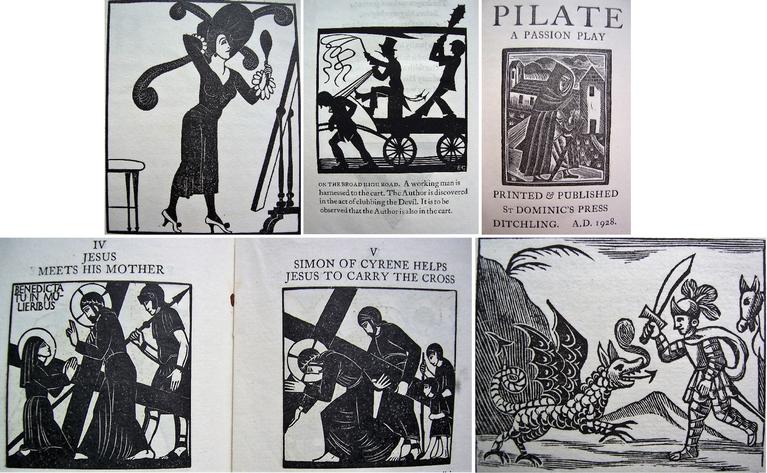
As a result of the donation of the Chapman Collection of twentieth-century material, Emmanuel Library has interesting items from Saint Dominic’s Press, which was founded in 1916 in the East Sussex village of Ditchling by Hilary Pepler (1878-1951), with Eric Gill (1882-1940) providing wood engravings. This press became part of the Guild of St Joseph and St Dominic, an artists’ colony established at Ditchling in 1921 by Pepler, Gill and Desmond Chute (though Gill left the community in 1924). The Guild espoused a communal life and self-sufficiency, based around work and faith, and their idea of a medieval guild. Their core principles were a devout Roman Catholicism, resistance to industrialization and urbanization, and a commitment to Distributism, a political movement that championed individual land ownership in rural communities and whose contemporary proponents included G. K. Chesterton and Hilaire Belloc. The community had grown to 41 members by 1922 and eventually occupied a cluster of communal buildings, workshops, family homes and a chapel on the edge of Ditchling Common. The Guild was part of the Arts and Crafts Movement, and among the artists and craftsmen drawn to join were wood engravers, weavers, silversmiths, calligraphers, and artists and illustrators. A plaque produced in the community bears the self-description ‘Men rich in virtue studying beautifulness living in peace in their houses’. Men? Yes, there were no women members until the 1970s. The Guild was finally disbanded in 1989, and is now commemorated by a small museum at Ditchling.
Key to the community was its private press of Saint Domenic’s, which printed a variety of pamphlets and books, many on religious themes, or propounding the philosophies of the artists and their theories about craftsmanship, or the failings of modernity. A pamphlet entitled In Petra produced by Gill and Pepler in 1923 has some wood engravings by David Jones (1895-1974), and the verse that accompanies a woodcut by Jones of an aspidistra – the once-ubiquitous house-plant – perhaps can serve to catch the pietistic tone:
God made the Aspidistra,
A bold and bulbous weed,
To grace the ground of Eden
And flourish without seed.
When Man became respectable,
He stole it from the field
To hide his utter nakedness
Behind its leafy shield …
He had an Aspidistra,
Green in a marble bowl,
Brass candlesticks on either side –
By then he’d lost his soul …
So burn your Aspidistras,
And vase and candlesticks,
Return your lace to Nottingham,
And make a Crucifix.
Something of the same tone figures in Gill’s 1921 pamphlet Dress: Being an Essay in Masculine Vanity and an Exposure of the Un-Christian Apparel Favoured by Females (No 7 in the bracingly-entitled ‘Welfare Handbooks’ published by the Press), which includes a woodcut by Gill on the theme ‘She outshines the Peacock’s excess above his mate’, showing a woman admiring herself in a piece of millinery worthy of Royal Ascot. Another striking woodcut by Gill shows the Devil seated in a cart being drawn by a working man, while the artist strikes at the Devil from behind with a club so large that it breaks out of the frame of the picture.
Pepler had a contemporary reputation as the author of mimes, and when the Press published a Sussex Mummer’s Play, King George and the Turkish Knight: Old Sussex Play (1921) it was because this was seen as ‘genuine folk drama played by the peasantry’ that was ‘undoubtedly an offshoot’ of the miracle plays put on by medieval guilds. But this was heritage that was fast disappearing and had been taken down from someone who had last participated in a performance in a Sussex village in the early 1890s. The notes stress the play’s distance from any contemporary ideas of dramatic verisimilitude: the actors, forming a semi-circle, should each ‘march forward three paces to deliver his oration’, almost chanting their words in a monotonous sing-song with little or no expression. The Valiant Soldier can have a soldier’s red jacket, but ‘in modern representations the tunic would probably be in khaki’. The Turkish Knight is to have ‘black face and beard’ (oh dear …).
A tiny pamphlet Concerning Dragons (1916), by Pepler and Gill, is made for child-size hands. On the left-hand page of one opening, beneath a woodcut of a worried-looking child in bed, with an adult peeping through the bedroom door, is the rhyme:
CHILD:
When Michael’s angels fought
The dragon, was it caught?
Did it jump and roar?
Oh! Nurse, don’t shut the door.
And did it try to bite?
Nurse, don’t blow out the light.
NURSE:
Hush, thou knowest what I said,
Saints and dragons all are dead.
On the right-hand page, beneath a woodcut of a child holding a crucifix towards a very large devil with claws, is the rhyme:
FATHER (to himself)
O child, Nurse lies to thee,
For dragons thou shalt see.
And dragons shalt thou smite –
Let Nurse blow out the light!
Please God that on that day
Thou may’st a dragon slay.
And if thou dost not faint,
God shall not want a saint.
Barry Windeatt (Keeper of Rare Books)
Images by Helen Carron (College Librarian)
24 June 2020
Happy Pride Month everyone! As ECSU LGBT+ Officer, one of my favourite memories from first year was being able to attend the first ever Cambridge Pride celebration on Jesus Green with other members of Emmanuel College.
.png) It was my first time at a Pride parade (L), and it was so nice to see students & locals from across the city coming together to celebrate being open and proud of our identities.
It was my first time at a Pride parade (L), and it was so nice to see students & locals from across the city coming together to celebrate being open and proud of our identities.
Sadly, this year because of COVID–19 most Pride parades have been cancelled, but we’re still finding ways to keep in touch! We students will be having an drop–in Zoom call before the end of the month to celebrate Pride together, and I’ve been keeping in touch with many of my LGBT+ friends through video calls & social media, and even making new ones through a CUSU LGBT+ penpal scheme.
Although it would have been nice to celebrate in the streets & parks of Cambridge once again, lockdown has been an important reminder that being LGBT+ brings a sense of community that remains just as strong, even when I’m far apart from my friends. It’s also allowed me to keep in mind that Pride isn’t just a public thing, but it’s also about self–love, and about gradually learning to be confident & happy with who we are as queer people: whether we’re alone, with friends, with family, or anywhere in between. I hope any LGBT+ alumni have had a lovely month!
Louis
23 June 2020
Reams have been written about the novel coronavirus SARS–CoV–2, which causes the disease known as COVID-19, but what about the word ‘coronavirus’ itself, which was officially coined in 1968?
It has been stated many times that the name comes from the Latin word corona, meaning ‘crown’—despite the fact that the now-familiar images of the spiky, spherical virus particles, do not look remotely like crowns. The true story is a fascinating one, and involves a former Emmanuel Fellow, Professor Anthony Waterson.
.png) Tony Waterson (L) was admitted to Emmanuel in 1941, where he achieved a double First in the Natural Sciences Tripos. When he became liable for military service in 1943, the college fought hard, and successfully, to keep him, arguing that he was one of the ‘very best’ students and should be allowed to complete his scientific studies. Tony qualified as a doctor in 1947, and became M.D. in 1954, the same year that he returned to Emmanuel take up a Research Fellowship. He went on to become a lecturer in the Pathology Department at Cambridge, where his interest in virology was kindled.
Tony Waterson (L) was admitted to Emmanuel in 1941, where he achieved a double First in the Natural Sciences Tripos. When he became liable for military service in 1943, the college fought hard, and successfully, to keep him, arguing that he was one of the ‘very best’ students and should be allowed to complete his scientific studies. Tony qualified as a doctor in 1947, and became M.D. in 1954, the same year that he returned to Emmanuel take up a Research Fellowship. He went on to become a lecturer in the Pathology Department at Cambridge, where his interest in virology was kindled.
Tony was appointed to the Chair of Medical Microbiology at St Thomas’ Hospital, London, in 1964, where one of his first acts was to headhunt a brilliant young electronmicroscopist, June Almeida, to help his team’s research into viruses. Born in Scotland, June had been working in Canada for ten years when Tony met her, and he immediately recognised the value of the techniques she had devised for identifying sub–microscopic virus particles. While working as a member of Professor Waterson’s research team, June examined under an electron microscope a sample of nasal ‘washings’ sent to her by another scientist, David Tyrell, and found it to contain a novel virus, variants of which she had come across before, although her findings had not then been widely accepted.
Now that June was sure they had indeed identified something new, she, David and Tony met in the Professor’s office, to discuss what this family of viruses should be called. As they later explained, the virus particles had a fringe of ‘rounded or petal shaped’ projections ‘recalling the solar corona’. They therefore decided that the most appropriate name would be coronavirus, to reflect this ‘characteristic appearance’. The name of the virus, then, refers to its resemblance to the aura of plasma that surrounds the sun, and has nothing to do with royal headwear.
June, David, and a small group of colleagues published their findings soon afterwards, but still needed to get formal approval for the new name from the appropriate sub–committee of the International Committee for the Nomenclature of Viruses. This did not present any difficulties, though, because the Chairman of the sub-committee was none other than Professor Anthony Waterson!
Amanda Goode, College Archivist
23 June 2020
Taking advantage of the absence of undergraduates currently in residence, the College has been undertaking renovation work to some of its student accommodation.
.png)
Carpenters, replacing worn floorboards in a set on the top floor of Old Court, discover hidden beneath the floor an old tobacco tin (or perhaps a Tupperware box, or leather pouch, depending on your choice of timeframe), placed there by some past resident of the room, and containing—what?
Why was it placed there, and why was it never recovered?
10 June 2020
We are not the first age to respond to pestilence and pandemic, nor will we be the last.
.png)
The word 'quarantine' comes from the Italian 'quaranta', and refers to the forty–day period of isolation that was imposed on ships arriving into European ports during medieval times of plague (originally the time period was thirty days, and the term was 'trentina').
Your prompt is to write about 'quarantine' and isolation in some way; now, or historically, or in an imagined future; personally or hypothetically; in a poem, a short story, an essay, or any form that seems fit to you.
10 June 2020
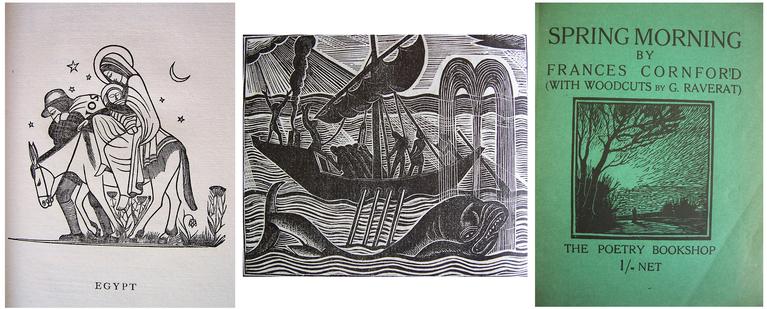
Complementing its collections of earlier rare books, Emmanuel Library is fortunate to have the Chapman Collection of twentieth-century items, donated by John Chapman and his wife Enfys. John Chapman (matric. 1943; died 2002) came to Emmanuel from the Leys School Cambridge, read Modern and Medieval Languages and stayed on to do a certificate in education. He sold antiquarian books and built up a personal collection of items published, some in very limited editions, by such private presses as the Golden Cockerel Press (1920-1961), the Cresset Press (1927-1966), the Rampant Lions Press (1924-2008), the Enitharmon Press (since 1967) and the Gregynog Press, together with publications about twentieth-century British artists, illustrators and engravers including Eric Gill, David Jones, Reynolds Stone, Keith Vaughan, Ivon Hitchens and Michael Ayrton.
A prevailing presence in the collection is the work as an engraver of Eric Gill (1882-1940) and those influenced by him. There are copies of Gill’s The Four Gospels of the Lord Jesus Christ (1931), Canticus canticorum (1931), The Passion of Our Lord Jesus Christ according to the Four Gospels (1934), along with Twenty-Five Nudes (1938), and copies of Gill’s own characteristic manifestos: The Devil’s Devices: or Control versus Service (1915), or Printing and Piety: An Essay on Life and Work in the England of 1931, and particularly Typography (1931). There is also a copy of Aldous Huxley’s Leda (1929), engraved by Gill.
The collection includes a copy of the splendid Book of Jonah (1926) with wood engravings by David Jones (1895-1974), one of the major illustrated works by someone remarkable as both poet and artist. There is also a copy of the limited edition of Jones’s The Tribune’s Visitation (1969), signed by Jones, and a first edition of his great poem In Parenthesis: seinnyessit e gledyf ym penn mameu (1937).
There are various editions of poems by Frances Cornford (1886-1960), grand-daughter of Charles Darwin and mother of the poet John Cornford (1915-1936) who was killed fighting in the Spanish Civil War. Her Spring Morning (1915) and Mountains and Molehills (1934) have woodcuts by by her cousin Gwen Raverat, and her Autumn Midnight (1923) has engraving by Eric Gill. The latter was published by the Saint Dominic’s Press which is strongly represented in the collection, including a 1926 pamphlet featuring woodcuts based on Gill’s designs for his Stations of the Cross in Westminster Cathedral. Later items, including works illustrated by John Piper, Michael Ayrton and Ceri Richards, mean that, thanks to John and Enfys Chapman, Emmanuel Library has strong holdings in choice twentieth-century items to set alongside its rare books from the sixteenth to the nineteenth centuries.
Barry Windeatt (Keeper of Rare Books)
Images by Helen Carron (College Librarian)
10 June 2020
Jonathan Spencer MBE, former Head of Environment for Forestry England, spent a term as a Derek Brewer Visiting Fellow at Emma in 2017. The benefits for research into the future of our forests were clear.
For t.png) hose of us at the 'distal' end of their career, opportunities to study at our ancient Universities are really rather limited. I had searched on and off, though not very systematically, but as a result of a stroke of good fortune I heard of the Derek Brewer Fellowship at Emmanuel from an old friend, the writer Richard Mabey. He encouraged me to write to the Master (application being something of a mystery—he had held the Fellowship in 2015). So, I did!
hose of us at the 'distal' end of their career, opportunities to study at our ancient Universities are really rather limited. I had searched on and off, though not very systematically, but as a result of a stroke of good fortune I heard of the Derek Brewer Fellowship at Emmanuel from an old friend, the writer Richard Mabey. He encouraged me to write to the Master (application being something of a mystery—he had held the Fellowship in 2015). So, I did!
In 2016, I received an email from Emmanuel informing me that “The Committee had resolved in my favour”—very Cambridge—and I joined Emmanuel in 2017 for the Easter term. The term fled past but was an immensely satisfying time. The practical benefits were obvious: the opportunity to read & write without distraction from work and home, to stay up late or skip lunch if engrossed in a paper or book, and essentially have no obligations beyond the task one has set oneself. The other benefits, though, far outweighed these. The gardens in spring & the ancient Plane Tree, the exceptionally friendly and supportive Fellows, staff & students, and of course the opportunities for engagement with researchers, and others of direct relevance to the future of forests and biodiversity. I was really fortunate in being hosted in Cambridge, not just by Emmanuel College, but by the Conservation Science Group in the David Attenborough Building.
Working as Head of Environment for Forestry England, the land management arm responsible for Forestry Commission forests and woodlands across England, was a huge and full-time job: from beavers & martens to forest soils & fungi, forest certification, the impact of tree diseases, via the conservation of rare and beautiful species of all manner of plants and animals to the intricacies of deer & venison management. Working with so much expertise left one with a tremendous insight into a whole raft of land management issues and challenges. but virtually no time to read, write or think! Given the tremendous privilege of working with so much expertise, over the whole of the country and over so many years, I was looking for an opportunity to take time out from the fascinating but furious whirl of work and catch up with the academic research into the pressing issue of 'forest resilience': the capacity of our woods & forests to cope with, and recover from, the twin challenges of rapid climate change and the spread of new, and often devastating, pests and diseases. The latter were arriving in ever increasing numbers as a result of the globalisation of trade, welcomed into our forests of limited species diversity and stressed by environmental challenges such as drought and warming winters. Bringing together academic insight and the practical experience of so many skilled forestry and conservation colleagues seemed like an important task, and a suitable way to acknowledge both their support, and the rich array of opportunities I had been blessed with, throughout a career working in nature conservation and forestry.
Since my time with Emmanuel, I have retired from the Forestry Commission, freeing up time for many other projects. I have a book to write (which seemed like such a good idea at the time!), I teach and lecture on conservation & forest ecology issues, continue to support several rewilding projects across the country, and, with a team of others, continue to hold the Field Studies Council course on Woodland Ecology & History at Flatford Mill in Essex, run for many years by the late Prof Oliver Rackham. And in a most exciting development, I support my wife Alison in her work to support the farmers & landowners of West Hampshire in their ambitions to revitalise the wildlife and ecology of both their farmland and the River Test.
The work undertaken at Emmanuel led directly to the publication of a quartet of four papers in the Quarterly Journal of Forestry, on the nature and importance of forest resilience and the policy challenges that we now have to tackle, with growing urgency, to embrace resilience measures to sustain the role of our forests as 'Natural Capital Assets'. The first of many key discussions on forest resilience was held at Emmanuel, with a daylong workshop held for Forestry Commission staff in Spring 2018. The workshop members were welcomed by words taken directly from the Emmanuel's Founder, Walter Mildmay. On being asked about the establishment of the College by Queen Elizabeth I, he responded using the oak as a metaphor:
“I have set an acorn, which when it becomes an oak, God alone knows what will be the fruit thereof".
What could have been more appropriate? I hope that the relationship now established between the College and the future our forests can be sustained into the future.
28 May 2020
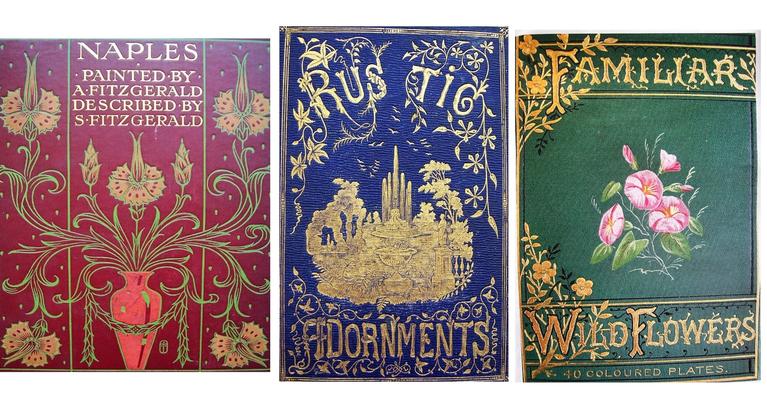
Readers of this blog are likely to have seen – whether in the libraries of country houses or educational foundations – libraries with walls lined with leather-bound books, sometimes with lavish gilt decoration. The bindings of early books are much studied by historians of the book, and Emmanuel has some choice examples. These begin with a copy of Theodore Beza’s theological treatises (Geneva, 1573), dedicated by him to Emmanuel’s founder, Sir Walter Mildmay, who presented it to the College – it is sumptuously bound by Jean de Planche. In 1659 Rachel, Countess of Bath, a great-granddaughter of Sir Walter and one of the College’s early women benefactors, bequeathed books to the value of £200, most of which are still in our library and with her armorial device gold-tooled on the covers.
But by what developments did the book as a bound item move from the leather-bound books of former centuries towards the utilitarian hardback of today? One of the nineteenth century’s most influential legacies to the history of book production is the cloth case. Ever since the Middle Ages, textiles had been used to cover bindings of manuscripts and books, but the velvets and silks used for this purpose were expensive and de luxe items, as with the Latin Bible in Emmanuel Library, bound in crimson velvet, which belonged to Edward VI. By contrast, the cloth coverings of the Victorian period were developed for their utility and cheapness, and lent themselves to the increasing mechanization of the book trade.
By the later eighteenth century, some types of coarse canvas were being used to cover school-book bindings since these items were subject to heavy use. But it was not until 1823 that a purpose-made, filled and glazed bookcloth was developed for covering cased-in books. It soon became the binding of choice, used ubiquitously by Victorian publishers. Bookcloth was much cheaper than leather, and much more durable than a paper covering. It could be produced in a wide range of colours and embossed finishes. It was also capable of taking detailed blocked impressions, stamped with a blocking press rather than being built up by hand with individual tools.
The early decades of the nineteenth century saw new developments in the mechanization of the printing process. Developments of machines to speed up the binding process soon followed, making books much cheaper to produce. The cloth case was the ideal binding for use on such books, because the sewn textblocks and the cases could be prepared in separate processes and then simply pasted together at the end of the production line.
Such case bindings were certainly less robust than books from earlier centuries bound traditionally ‘in boards’ (that is, with the boards attached to the textblock before the book was covered in leather). But books in case bindings were affordable to a much wider range of people. So it was that a form of book binding that started as a mere temporary cover – designed to be replaced after purchase by wealthy customers with a smarter binding of their own choice – came to be accepted as a permanent form of binding. With this development, some bindings in bookcloth become lavishly decorated with gold and blind blocking, colour-printed designs, embossed patterns in the cloth, and elaborately shaped boards (as the two illustrated examples from Emmanuel Library’s collections demonstrate). The forerunner of today’s hardback books had been born.
Barry Windeatt (Keeper of Rare Books)
Images by Helen Carron (College Librarian)
20 May 2020
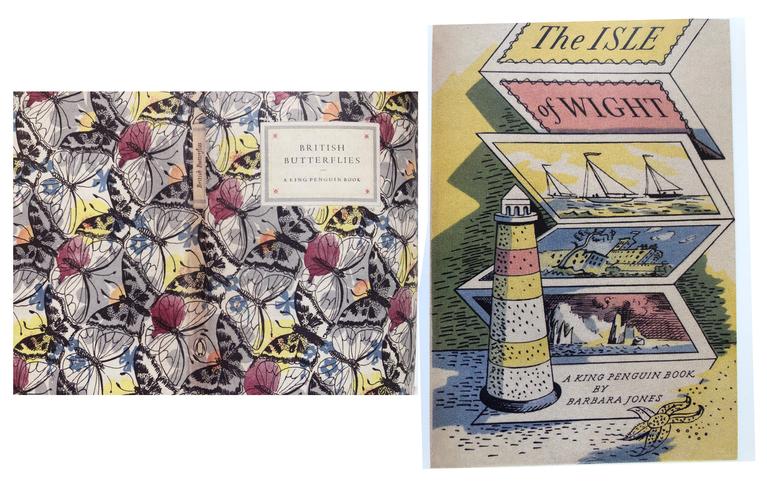
In the Graham Watson Collection, now in Emmanuel Library, is a complete set of the King Penguin series: some 76 slim hardback Penguins published between 1939 and 1959. Although hardly qualifying as ‘rare books,’ it is not surprising that Graham Watson, with his keen eye for book design and illustration, would collect this series. The King Penguins were shrewdly marketed as collectibles, aiming to appeal to what Penguin saw as the public’s ‘liking for illustrated keepsakes’. Soon overtaken by an era of total war, the King Penguins continued to appear nonetheless.
Contemporary Penguin publicity emphasized their role ‘at a time when so many of our galleries and museums are closed’ and presented the series as fulfilling ‘a useful purpose in promoting an appreciation of art and as a reminder of the pursuits of peace’. They were never exactly cheap: earliest editions cost one shilling (twice the price of a normal Penguin paperback or a packet of Woodbines), and by 1951 they cost five shillings, no trivial outlay for most people at the time. Their format was typically an essay-length text of 30 pages, followed by 16 plates, because subject-matter and illustration were interdependent, inviting the literary-minded to look and the visually-alert to read. The first editor, Elizabeth Senior, a Keeper at the British Museum, lost her life in the Blitz in 1941, to be succeeded by Nikolaus Pevsner, newly released from an internment camp, who then edited the series until its demise. Some of the texts were penned by Pevsner’s friends among the staff of the South Kensington museums. They did so out of a love for their subjects, since financial rewards for the authors were minimal.
The remarkable range of titles is a tribute to the public’s wartime craving for education and information as this lived on for a while into the immediate post-war period. The series provided a serious but not over-demanding text for the intellect and a small feast for the eye, all attractively packaged (but by the late 1950s no longer commercially viable). Typical print-runs were 20,000 copies, but A Book of Toys, with its appeal to readers of all ages, ran to 55,000. Penguin publicity in 1950 boasted of King Penguins on ‘anything from the Bayeux Tapestry to Balloons, from Heraldry to Highland Dress’ (and there are excellent King Penguins on those subjects), but amid the variousness there are some predominant themes. There is a strong emphasis on natural history and botany, including: A Book of Roses (1939), Edible Fungi (1944), A Book of Lilies (1944), Poisonous Fungi (1945), Flowers of Marsh and Stream (1946), Flowers of the Woods (1947), Tulipomania (1950), and A Book of Mosses (1950). Those observant gardeners and walkers in the British countryside who enjoyed such books might also like the noticeably large number of King Penguins about birds, including: British Birds on Lake, River and Stream (1939), Garden Birds (1945) and A Book of Ducks (1951). There were also Some British Moths (1944), British Butterflies (1951; with a ravishing cover), and Some British Beetles (1948), although A Book of Spiders (1947) sadly suffered the indignity of being remaindered.
Another various theme is British heritage and applied and popular arts, with King Penguins on English Ballet (1944), A History of English Clocks (1947), The English Tradition in Design (1947), The Crown Jewels (1951), and Animals in Staffordshire Pottery (1953). There is an enterprising Children as Artists (1944) and the excellent Popular Art in Britain (1945), with its focus on samplers and smocks, carts and caravans, fairground roundabouts and pub interiors. There was also The Picture of Cricket (1955) by John Arlott.
Pevsner’s own interests are reflected in King Penguins on medieval sculpture and artefacts such as Medieval Carvings in Exeter Cathedral (1953), Misericords (1954), Monumental Brasses (1957), all preceded by Pevsner’s own classic essay on the exquisite carved foliage in Southwell Minster, The Leaves of Southwell (1945).
A few topographical King Penguins – Romney Marsh (1950) ‘illustrated and described by’ John Piper, and The Isle of Wight (1950) by the illustrator Barbara Jones – are fascinating records of how things were visualized at the time. As these suggest, some of the leading illustrators and artists of the period were involved: Life in the English Village (1949) had sixteen lithographs by Edward Bawden. The book- and cover-designs of King Penguins rather contradict our lazy current orthodoxy – that this was a drab and colourless epoch – through the sheer stylishness and elegance of their design.
Barry Windeatt (Keeper of Rare Books)
Images by Helen Carron (College Librarian)
19 May 2020
Today, we're very aware of climate change, deforestation and other environmental issues. Here, Rev'd Bob Short (1967) tells us about working with local communities in the rainforests of Mexico, who had already identified signs of climate change due to the destruction of the forests, over 50 years ago.
.png) In June 1970, I packed my bags for the last time to leave Emma, and take my next step in life. I also had to hang up my cricket boots as well, sadly a month before the Varsity match in which I should have been playing. But my future life & work was beckoning, and I realised that sport would not be a major part of my life in the future. I had studied the 3 As—Agriculture, Archaeology and Anthropology—and was on my way to join Wycliffe Bible Translators as an Agricultural Missionary.
In June 1970, I packed my bags for the last time to leave Emma, and take my next step in life. I also had to hang up my cricket boots as well, sadly a month before the Varsity match in which I should have been playing. But my future life & work was beckoning, and I realised that sport would not be a major part of my life in the future. I had studied the 3 As—Agriculture, Archaeology and Anthropology—and was on my way to join Wycliffe Bible Translators as an Agricultural Missionary.
I was assigned to work with a group of Tzeltal Maya Indians in South-East Mexico, who were suffering devastating ecological destruction of their environment, due to hundreds of years of slash–and–burn farming. We were to try & help them develop sustainable ways of working their land, and try to break the cycle of people leaving the region to move down to the Rainforest, which in turn was disappearing at an increasing rate as the same slash–and–burn process took its toll on the fragile rainforest soils. Even at that stage, the old men and women of the villages were talking about local climate change as the rainforest disappeared, with longer dry seasons & less predictable rains.
My senior colleague, who later became my father–in–law, had, in 1969, set up a small Agricultural Centre from where we worked out to the local communities, and further afield to the rainforest area. Hundreds of families helped us to develop a zero tillage system, allowing all the organic matter to rot down. With the help of a little NPK & green manures, they have been able to multiply their crops enormously, to become self-sufficient in maize, beans & pumpkins, and to conserve God’s creation.
Today I am visiting the Centre again (above), which is still there and being run by the local Tzeltal Indians as a registered charity! They still have excellent demonstrations of maize, beans, vegetables, small greenhouses, and two coffee groves, producing eco coffee cultivated under the shade of Leguminous trees which fix nitrogen, and provide tons of leaf mould. They continue to reach out to communities as much as they can, trying to mitigate the effects of environmental destruction.
14 May 2020
A theme of Emmanuel Library’s Graham Watson Collection, as of the times when its hand-coloured books were created, are books illustrating travels in search of the picturesque. But what was the picturesque?
In 1782 William Gilpin published his Observations on the River Wye and several parts of South Wales, relative to Picturesque Beauty, illustrated with plates based on Gilpin’s sketches. Later publications focussed on the Lake District and West of England. These are not conventional guidebooks: they are guides to reading real landscapes in terms of ‘that peculiar kind of beauty which is agreeable in a picture’. The principles of picturesque beauty in landscape derived from interpretations of landscape painting (as in the plate above depicting a sunset from a guide to painting scenery).
It is sometimes suggested that a simplifying Western misreading of Chinese and Japanese landscape-painting and garden-design had prepared the way for the taste for the picturesque. This may go back to the writings of Emmanuel’s Sir William Temple (1628-99), who gave the College the furniture still in use in the Hall. It is the perception of a tastefully asymmetrical disorder, a contrived and artful irregularity in Chinese landscape art.
For Gilpin, nature excelled in providing colour and texture, but nature did not create picturesque compositions on its own. These had to be selected by the viewer, and an artistic eye might well improve on nature by adding some components and modifying others. A ruined abbey or castle would add implication and consequence to the composition, and Gilpin famously remarked that the judicious use of a mallet might make the ruins of Tintern Abbey more picturesque than they actually were.
.png)
Another trick was that the chosen viewpoint tended to be low down, which emphasizes the drama in differences of height represented within the composition.
Textures should preferably be rough and broken, structures dilapidated, and any straight lines were to be shunned. Objects possessing the requisite roughness and irregularity include ruins, Gothic architecture, hovels, broken stretches of water, shattered trees, worn-out and shaggy beasts, and the sorts of gypsies, beggars and bandits then familiar from the paintings of Salvator Rosa. Anything in efficient working order was in theory excluded. Appreciation of the picturesque is implicitly a symptom of special cultivation, almost a connoisseurship, and is to be acquired by discerning acquaintance with paintings.
In the 1790s, with travel on the Continent disrupted by the French Revolution, there was a growth in domestic tourism by those travelling to take pleasure in scenes and views, with a growing appreciation of uncultivated scenery in such upland places as the Lake District, the Highlands and North Wales. Many tourists were sketching, relating what they viewed and drew to what they knew of landscape painting, and striving to identify the viewpoint from which scenery becomes picturesque and accommodated to the rules of picture-making. Discerning tourists of the Picturesque peered at the landscape by means of ‘Claude glasses’ – named after the French artist Claude Lorrain, whose landscape paintings were an inspiration for the picturesque. Claude glasses were pocket-size convex mirrors, often tinted, which both framed and darkened the view. The glass’s convexity modified features of the reflected landscape – it might tend to distort foreground trees so that they appeared to curve inwards slightly, so framing the middle distance. The glass was often backed with a coloured foil which gave the composition a consistent tonality. The Claude glass could reduce a sprawling view to a compact composition but, to use one, you had to turn your back on what you were pictorializing. Scenic places became congested with view-junkies turning their backs on the view in order to frame it in their new-fangled device (does this sound familiar?). Falls, sprains and broken bones ensued, and pursuit of the picturesque became an object of satire, as in The tour of Dr Syntax, in search of the picturesque (1812), where Dr Syntax, a would-be connoisseur of the picturesque, is depicted falling backwards into a lake while sketching a picturesque ruin.
.png)
Yet the picturesque exerted too powerful a hold on the imagination not to continue to develop long into the nineteenth century and still to shape our own expectations of a ‘view’. After Waterloo ended twenty-five years of war, foreign travels in search of picturesque scenes and views were again a possibility. Books in the Graham Watson Collection reflect this taste, with tours not only of picturesque Europe – the Alps, the Rhine, and Italy – but also the Ottoman Empire, India, the Americas and other far flung places. As late as 1870, while visiting Italy, the novelist Henry James could remark: ‘I have talked of the picturesque all my life, and now at last I see it’.
Barry Windeatt (Keeper of Rare Books)
Images by Helen Carron (College Librarian)
7 May 2020
In case you missed it, Emma member Claire Thompson (2005) is designing short mindfulness activities each week for us, to share with the college community during this difficult time. To see last week's exercise, click here or join in with the new activity below.
.png) Labyrinth
Labyrinth
This week's mindfulness practice aims to complement the leaflet shared by Jeremy Caddick relating to the labyrinth in the Fellow's Garden. Because of the lockdown, I know that many of you may not be able to get to the labyrinthso guess what? I've done my best to bring the labyrinth to you instead!
A labyrinth is an ancient symbol that relates to wholeness. It combines the imagery of the circle and the spiral, into a meandering path, but one that can be walked with intention. The labyrinth represents both a journey to our centre and back out again into the world, as well as a metaphor for the path we walk throughout our lives. It's a perfect opportunity for mindfulness & reflection.
Unlike a maze, which involves making choices and solving a puzzle, a labyrinth removes choice. There is only a single path to the centre. We simply allow the path to guide us, step by step. Walking in & out of the labyrinth is thus an exercise in trusting the path itself,and to pause, reconnect & to receive whatever this moment may have to offer. We can then take whatever we receive back out into our lives. The magical little haven of the Fellow's Garden is indeed a perfect setting for a labyrinth.
Using two videos I took to set the scene, and some audio guidance from me—I invite you to find a quiet, comfortable spot to sit or lie down at home and immerse yourself in this visualisation.
Where might the path lead you today? Wherever that is, don't forget to enjoy the journey. And like perhaps some of us are sensing during this lockdown, the way forwards in times of uncertainty is always: one step at a time!
7 May 2020
Continuing from last week’s theme of learning to paint landscape in watercolour brings us to some books in Graham Watson’s collection published by someone who built a successful career out of selling clients the landscapes he painted – turned into reality in their own gardens.
In 1788, five years after the death of Capability Brown, Humphry Repton (1752-1818) launched himself as a landscape designer, after several unsuccessful previous ventures. He was 36, with four children and no secure income. He had no previous experience at garden design, but one thing he was good at was sketching. Repton set up business as what we would now call a consultancy. He presented his clients with a portfolio of his watercolours depicting their park or garden. His stroke of genius was to present these watercolours with a series of hinged flaps. On the flaps was painted the boring and unsatisfactory current state of the property. When clients lifted up these flaps they could see the temptingly beautiful transformations of their landscapes that Repton proposed. Repton had these flapped watercolours and his handwritten proposals bound in red leather for presentation to his clients. These ‘Red Books’ became his trademark: each was a unique artwork and many survive.
.png)
.png)
The two plates from Repton’s Fragments on the theory and practice of landscape gardening (London, 1816) show ‘Before’ and (after lifting the flap) ‘After’ at Beaudesert in Staffordshire, demolished in 1932.
By the time Repton started in business the fashion for Capability Brown landscapes was fading, and although Repton initially positioned himself as Brown’s successor he soon moved to distance himself. Like Brown, Repton often advised felling trees to open up vistas. But Brown’s formula for great expanses of lawn sweeping right up to the house had had its day. Repton’s solutions involved bringing back a garden and flowers close to the house, with gravel walks and formal terraces and balustrades. In this, Repton is in the business of restoring a sense of foreground to the Brownian wide landscape. What he recommends for that foreground can seem a little cluttered and even fussy to a modern eye, but he proved to be the forerunner of long-running Victorian gardening fashions.
Brown had the grandest clients, but although Repton had some grand clients too, his client base was more mixed socially, and he advised on some distinctly modest properties. Repton could rarely work on Brown’s scale, and his business model was different. Brown sold a total service to his clients, implementing his designs himself on the basis of plans and maps provided to the client, and never publishing any account of his work. Repton charged a fee for the designs in his Red Books, but it was for the client to implement those designs, and inevitably many were only partially implemented or not at all. Yet Repton’s Red Books – and the illustrations from them that Repton recycled in engraved form in the books he published promoting his ideas on gardens and landscape – enable us to know much more of Repton’s work than remains on the ground. So it is with Repton’s fruitless aspirations to royal patronage: he drew up plans for a summer palace at Brighton in the Indian taste, but his rival John Nash got the job and built the Brighton Pavilion. Nothing daunted, Repton then published his own ideas in a lavish hand-coloured book (included in the Graham Watson collection), with all Repton’s usual techniques of hinged overlays to show the magical transformations that Repton might have provided.
30 April 2020
In case you missed it, Emma member Claire Thompson (2005) is designing short mindfulness activities each week for us, to share with the college community during this difficult time. To see last week's exercise, click here or join in with the new activity below.
.png) Nature memories from Emma
Nature memories from Emma
Aside from all being part of the natural world (like every other human being!), what else do we all have in common across the lovely Emma community? Well, the wonderful Emma, of course!
This week, I suggest we all spend a little bit of time reflecting on any 'nature memories' we have of times spent in the beautiful college gardens that we've all had the privilege to experience. This could be as simple as having lunch in the Paddock (above) with friends in the sunshine—or an 'aww' moment with the ducklings on your way to a lecture!
I've recorded a guided 'visualisation' practice to support you all in bringing a special "Emma nature memory" to mind.
It may be a nice opportunity to connect over this exercise, and if you feel inspired, please share a few words about your memories in the comments on YouTube!
30 April 2020
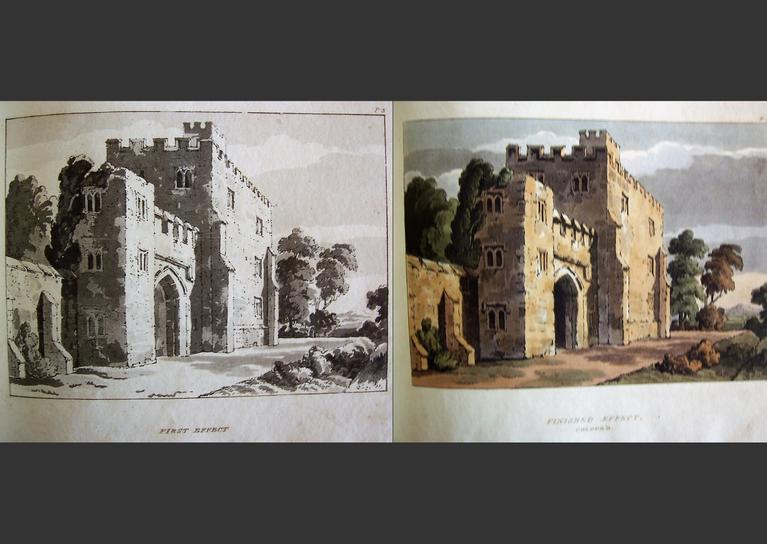
Continuing last week’s theme of combinations of print and painting: Emmanuel is very fortunate that Graham Watson presented his collection of colour-plate books to his old college in 1975. This is a library of around 1,700 books illustrated with hand-coloured engravings, mostly created between 1770 and 1840, before the invention of colour printing.
Book illustrations printed from woodcuts or copper plates and subsequently coloured by hand had appeared from the early days of printing. But in the aquatint process, used in many Graham Watson books, not just simple lines but graduated tones could be etched on to the copper plate. Over the black and white image printed from this plate, water-colour washes could then be applied, with the graduated tones in the underlying print producing subtle effects in the hand-coloured final product.
The fashion for such colour-plate books was a particularly British enthusiasm, and went hand in hand with a very British taste for water-colours which was developing over the same period. So it is very appropriate that the Graham Watson Collection includes many hand-coloured books that were published with the aim of teaching the amateur artist those arts of water-colour painting which were on display in colour-plate books generally.
.png)
.png)
A good example is the plates shown from William Pyne’s Rudiments of Landscape Drawing, In a Series of Easy Examples (London, 1812). These are the fourth and fifth in a series of five stages that begins by guiding the pupil in first drawing a bare outline with correct perspective. The second stage is the ‘Improved Outline’ which ‘must be firmly drawn with a black-lead pencil’ and adds in most of the detail of masonry and foliage. Third comes the ‘First Effect’ which is much concerned with supplying the shadows of differing depths. The fourth plate shown here is the ‘Finished Effect’ which applies the final degrees of shading, with spaces of white paper left to receive the colouring. For both the shading and colouring stages, detailed instructions are provided on which paints to mix for which effects. Another contemporary manual provides examples of no fewer than 436 tints for the pupil to match.
The authors of these guides promise instruction in composition, perspective, light and shade, the mixing and harmony of colours, and sketching from nature. They are addressed to an audience of ‘young persons’ and ‘the young artist,’ and often imply an audience of young ladies: in 1818 George Brookshaw published A New Treatise on Flower Painting, or Every Lady Her Own Drawing Master. Many such books have the format of two facing plates: one beautifully coloured, the other a black-and-white line drawing, not for ‘colouring in’ but as a guide to starting afresh. Emmanuel’s collection has a beautiful Studies of Flowers from Nature ‘Printed for and sold by Miss Smith, Adwick Hall near Doncaster’ (1818) which presents each flower ‘painted after Nature with a correct outline of each and instructions for producing a facsimile of the finished drawing by Miss Smith’. It is a reminder of the generations of amateur artists schooled in water-colour that were to follow.
Barry Windeatt (Keeper of Rare Books)
Images by Helen Carron (College Librarian)
21 April 2020
In case you missed it, Emma member Claire Thompson (2005) is designing short mindfulness activities each week for us, to share with the college community during this difficult time See last week's exercise or join in with the new activity below:
.png) An 'Interview' with Nature
An 'Interview' with Nature
How might the rest of the natural world around us be experiencing life? Of course, we’ll never know the answer, but that's not the point. This week's suggested practice is merely about asking the question.
Connecting with non–human parts of the natural world can be a powerful way to feel our innate belonging in nature—especially in these times of social isolation. This week's exercise is an invitation to nurture curiosity and compassion towards the rest of the natural world we share the planet with by 'interviewing' a mineral, a plant or an animal. Find a description of the 'Interview with Nature' exercise here.
It's important to clarify that engaging with nature in this way does not equate to anthropomorphism. In fact, it’s the opposite. Anthropomorphism is the attribution of human characteristics or behaviours to other living things. Instead, this exercise is an invitation to let go of our human perspective and wonder what the world may be like from another perspective—like we perhaps used to when we were children.
As AA Milne writes in Winnie the Pooh: "Some people talk to animals. Not many listen though, that's the problem". What if we could be humble enough to learn from the natural world? What if we paid more attention to minerals, plants and animals with an open mind and heart?
21 April 2020
The most beautiful of Emmanuel’s older rare books is also one that prompts many questions. It is a copy of Cicero’s De Officiis, that was printed on vellum at Mainz in Germany in 1465, but at some point the borders on its title-page and three other pages were richly illuminated. It is the earliest printed book in the Emmanuel library, yet it has also been given the appearance of a late-medieval manuscript. As a book, it looks both forward to the new world of printed copies and also back to the world of manuscripts as hand-painted artefacts.
%5B1of4%5D.jpg)
%5B3of4%5D.jpg)
But who was it made for? All four borders are so liberally bespattered with Tudor royal badges that the book appears to proclaim its royal ownership with some emphasis. Borders and initials display the red rose of Lancaster, the coroneted portcullis, and shields of the arms of France quartering England (on one page contained inside the Garter) and supported by yales (fabulous horned beasts). But what leaps out is the profusion of triple and single ostrich feathers in a coronet with scrolls bearing the motto ‘ic dien’ (‘I serve’) – the emblems of Princes of Wales.
The consensus is that this book was made for the short-lived Prince Arthur (1486-1502), elder son of Henry VII and elder brother of Henry VIII. The initial on the title page depicts a young man in a richly ermine-trimmed gown, evidently with a tutor. But why the borders were apparently painted so long after the pages were printed is another unanswerable question.
%5B4of4%5D.jpg)
%5B2of4%5D.jpg)
The borders display beautifully-painted forget-me-nots, red roses, wild strawberries, sweet peas, daisies and acanthus scrolls, along with several doves and a small dog. The daisy was a favourite flower badge of Arthur’s pious and learned grandmother, the formidable Lady Margaret Beaufort (1443-1509), foundress of both Christ’s and St John’s Colleges. But daisies are ubiquitous in the borders of late-medieval manuscripts, so what could be another pointer to ownership might be, well, just a daisy.
HM The Queen, when shown the book during her 1984 visit to mark Emmanuel’s Quatercentenary, immediately asked ‘How did this get here?’ It is an excellent question, but unfortunately unanswerable. It is unlikely that it can ever be known how this book left royal ownership, but it is recorded to have been in Emmanuel before the end of the sixteenth century. So many things are unknowable about this book, but one thing at least is certain: this thing of beauty has been in the College for almost the whole of Emmanuel’s history.
16 April 2020
In case you missed it, Emma member Claire Thompson (2005) is designing short mindfulness activities each week for us, to share with the college community during this difficult time. See Claire's ongoing series of activities.
.png) Permission To Rest
Permission To Rest
There can be a huge pressure, even in these times of 'lockdown', to feel like that we should be seizing this moment by taking up exciting new hobbies, projects and being productive with this newfound free time. Of course, if we feel this drive, we can go with that flow and embrace it! But what if it were okay if we didn't? What if we gave ourselves permission not to if we don't feel like it?
Let's remember that whatever our circumstances at the moment, this is a really difficult and traumatic time for many. Our lives have completely changed almost overnight, and our bodies & minds may have been consequently shocked into perhaps not having the same resources and energy as they used to.
So what if it were necessary to be kind & gentle with ourselves, to take the pressure off and take time to simply rest—in the company of nature? And what if it were enough for a while? Just being and belonging—alive and part of the natural world? Could there be a simple sense of peace and comfort in that?
To support you with this, here's a 20 minute audio guidance for a mindfulness practice called "In Touch with the Earth". It's a guided resting meditation—with a reading of one of my favourite Mary Oliver poems at the end. So this week, find a quiet spot by a window, in your garden or in a local park, lie back and enjoy!
If you'd like to find out more about Claire or expand your practice of mindfulness in nature, join the free 'Sit Spot' initiative she has set up for people to connect with nature with others during this challenging time.
16 April 2020
Dr Wu Lien–Teh matriculated at Emma in 1896, and was the first Chinese person to graduate from Cambridge in Medicine. He was posted to Harbin in north Manchuria in 1910 by the Ministry of Foreign Affairs, to lead a medical team to tackle an outbreak of pneumonic plague in the area.
.png)
Dr Wu realised that the disease was transmitted directly between humans in an airborne manner, overturning the theory that the disease was spread by rats and their fleas (C. Lynteris: ‘Plague Masks: The Visual Emergence of Anti–Epidemic Personal Protection Equipment’; Medical Anthropology 2018).
Thus he promoted the development of a face mask, which he claimed was his own invention, and the first time such an epidemic containment measure was attempted.
Dr Wu’s mask was similar to surgical masks, but had more protective layers, and a more complex tying process, so that it didn’t slip while operating outside in winter–time Manchuria: ‘This consists of two layers of gauze enclosing a flat oblong piece of absorbent cotton 6 inches by 4 inches. It can be easily made by cutting the usual surgical gauze (9 inches wide), as supplied from the shops, into strips, each measuring 3 feet in length. Each strip is then doubled lengthwise so as to contain in the middle a flat piece of cotton wool measuring 4 inches by 6 inches. At either end of the gauze two cuts, each measuring 15 inches, are made. Thus turning the pad into a three-tail gauze bandage, with the central piece of wool for covering the respiratory entrance. The upper tail of one side should be passed round the side of the head above the ear and tied to the other corresponding tail. The lowermost tail should in a similar manner be passed under the ear and tied to the one on the other side, while the middle tail should be passed over the crown of the head, so as to fix the pad and prevent it from slipping down the neck (Wu, L–T 1926 Treatise on Pneumonic Plague. Geneva, Switzerland: League of Nations, 393–394).’
Above is a bead panel in traditional Peranakan style, made by Dr Wu's mother while he was a student at Emmanuel. The design was based on the Emmanuel lion emblem, becoming a Chinese Foo dog, with a flaming pearl. This can be seen in the Peranakan Museum in Singapore.
7 April 2020
In case you missed it last week, Emma member Claire Thompson (2005) is designing short mindfulness activities each week for us, to share with the College community during this difficult time.
.png)
Radio Nature
Last week Mindfulness (Week I), we explored using our breath as an anchor to the present moment, and to our innate belonging in nature.
This week, I invite you to explore your experience of sounds by 'tuning in' to radio nature, and drawing a sound map!
Find a quiet spot outdoors, by a window or in the paddock if you're in college—and take an A4 sheet of paper & pen with you. Begin by settling down into your surroundings, noticing the physical sensations of your breath in your body. Notice what's going on in your mind, and whatever that is, remind yourself that it's okay. Let it be, and fade your attention back into your breathing. Allow yourself time to settle, there's no rush. When you're ready, start to tune into all the different sounds you can hear around you.
What sounds can you hear nearby? Further away? From ahead? From behind? From above? Tune into the quality of the sounds. Are they soft? Harsh? Loud? Quiet? Tuneful? Are they pleasant, unpleasant, or neutral? Imagine that you are immersing yourself in the soundscape, like a soft satellite dish on the earth—just receiving all the sounds. Let go of any effort to label, identify or explain. If you notice your mind labelling, just notice that it's happened, and if possible, come back into your direct experience of the sounds.
Next, take your A4 piece of paper and draw a cross in the middle. The cross represents you spatially. Next, with your eyes open or closed, begin drawing a visual representation of the sounds you can hear all around you: a sound map. You can draw lines & squiggles to represent the quality of the sounds—or you can use whatever visual representation works for you. See where your creativity takes you! How does turning sounds into a visual map change your experience of the sounds?
If you don't have a suitable outside place to do this exercise, you can use this video of the Emma duck pond instead!
If you'd like to find out more about Claire, or expand your practice of mindfulness in nature, join the free "Sit Spot" initiative she has set up, for people to connect with nature with others during this challenging time.
7 April 2020
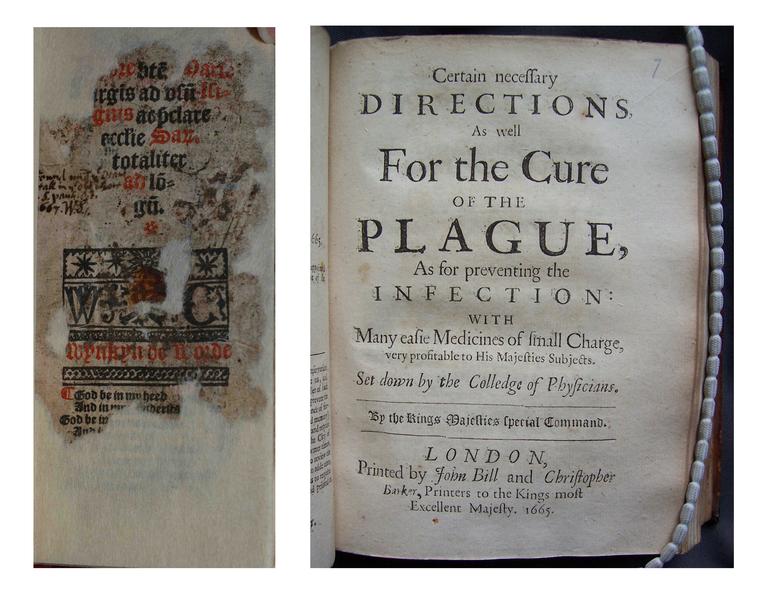
One of the great treasures of Emmanuel Library is the library of William Sancroft (1617-93), successively Master of Emmanuel (1662-64), Dean of St Paul’s (1664-77), and Archbishop of Canterbury (1677-90). Twice as large as the better-known library of Samuel Pepys, now at Magdalene College, Sancroft’s diverse book collection of 7000 items in 5000 volumes is one of the few personal libraries of the seventeenth century to survive intact.
Among its curiosities – and a moving emblem of survival and continuity – are the tattered remains of a Book of Hours printed in 1521, which Sancroft found under the Dean’s stall in the charred remains of Old St Paul’s after the Great Fire of London in 1666. That disaster had been preceded the previous year by a catastrophic outbreak of plague, and Sancroft’s library includes a topical book published in 1665 and entitled
Certain necessary Directions,
As well for the Cure of the PLAGUE,
As for Preventing the INFECTION:
With many easie Medicines of small Charge,
very profitable to His Majesties Subjects.
Set down by the Colledge of Physicians.
This book includes the instruction: ‘It is advisable that all needless Concourses of People be prohibited; that the Poor be relieved and set at work, and Beggars not suffered to go about; that all sale of corrupt Provision for Food be restrained; that Streets and Houses be as diligently and carefully as may be, kept clean …’
The book also shrewdly observes: ‘It is to be presumed, because everyone desireth his own liberty, that none will give notice of any suspicion of the Plague against themselves; wherefore that must be the Overseers’ care, upon any notice or suspicion of Infection, by the help of the Doctours, Surgeons, Keepers… to find out the truth thereof, and so to proceed accordingly…’
Barry Windeatt (Keeper of Rare Books)
Images by Helen Carron (College Librarian)
1 April 2020
During this strange and difficult time of the COVID–19 pandemic, we are having to adapt to new ways of living and working. Many of us are working from home for the first time, others find themselves working on the frontline delivering essential services to society, and some are unable to work at all during the pandemic.
.png) To help members of the Emma community during this time, author, workshop facilitator & founder of Mindfulness of Nature, Claire Thompson (2005), will kindly be creating short 5–10 minute mindfulness activities each week for us to slot into our daily routines and improve our wellbeing.
To help members of the Emma community during this time, author, workshop facilitator & founder of Mindfulness of Nature, Claire Thompson (2005), will kindly be creating short 5–10 minute mindfulness activities each week for us to slot into our daily routines and improve our wellbeing.
Claire has recorded a brief introductory video, and this week's first exercise is below.
Breathing Nature...
In times of uncertainty, a helpful approach to life can be by taking one moment, one day or one week at a time.
Our breath is one of our simplest anchors to the present moment — and also an accessible connection to our sense of belonging in nature. This belonging can be very supportive in times of social distancing and isolation. Why not try this simple exercise once a day this week?
Step outside (into your garden, your doorstep, open a window) and bring your attention to your breathing. Where do you feel the air coming in and out of your body? Feel into the direct physical sensations involved in breathing in and out — as if you were noticing your breath for the first time. Allow your breath to breathe itself, there's no need to control it. Just be curious about your experience of this natural phenomenon we call "breathing". Is your mind wandering? That's normal, it's what our minds do all the time. It's what they've evolved to do, to keep us safe. When you notice this, it's okay, just kindly bring your attention back to your breathing. As you breathe in the fresh air from the natural world, remind yourself that trees release the oxygen we inhale and absorb the carbon dioxide we exhale. As we breathe in and out, we're borrowing air before returning it to nature. We share this air with each other and with the rest of the natural world — as it flows through all living things. Repeat this practice frequently for 5–10 minutes a day throughout your week. How does this make you feel?
If you'd like to find out more about Claire or expand your practice of mindfulness in nature, join the free "Sit Spot" initiative she has set up for people to connect with nature with others during this challenging time.
25 March 2020
We’ve all become significantly more home–based over the past few weeks as a result of COVID–19. This is having far–reaching effects on how we live and work. Emmanuel member & productivity coach Karen Eyre–White (2003) explores its impact on our working lives, and how we can all find new ways of working which help us to stay productive.
.png) These are times of great change in how we spend our time. In a matter of weeks, COVID–19 has overturned our daily routines, changed our social fabric, and fundamentally altered our working lives. Many of us are now working from home indefinitely, doing the daily battle with server connections, virtual meetings & our burgeoning inboxes! This is often alongside our spouse & children, and against the backdrop of the wider impact of COVID–19 on our relatives, friends & society.
These are times of great change in how we spend our time. In a matter of weeks, COVID–19 has overturned our daily routines, changed our social fabric, and fundamentally altered our working lives. Many of us are now working from home indefinitely, doing the daily battle with server connections, virtual meetings & our burgeoning inboxes! This is often alongside our spouse & children, and against the backdrop of the wider impact of COVID–19 on our relatives, friends & society.
If that’s you & your team, and you’re feeling overwhelmed, I can tell you that you are certainly not alone. Having graduated from Emma in 2006, I joined the Civil Service and worked my way up to be Chief Executive of a safety regulator. But after the birth of my daughter I wanted to do something I was truly passionate about, so I took the plunge and set up a productivity coaching business: Go Do. The businesses & individuals I work with are all grappling with a challenge that’s unique in its scale and impact, with significant implications for productivity, motivation and wellbeing.
We’re all different, and we each need to find our own ways of working which help us to navigate this new and unfamiliar territory. There is no one–size–fits–all solution, but here are three steps which can help us to feel more in control of our working lives when we’re at home:
- Creating strong boundaries between home and work helps our brain switch gears more easily. Working in a specific place away from distractions, creating a sustainable schedule (and keeping to it), and having a daily ritual when you start work can all help. Experiment and see what works for you.
- Being realistic about what we can achieve each day helps us to feel positive about what we’ve achieved rather than disappointed about what we haven’t. A short list of 3–5 priorities can keep us focused on and on track amidst all the distractions of home.
- Connecting virtually with colleagues can be crucial to both our productivity and our mental health. We all need different levels of engagement to feel connected and supported, so consider what the right balance is for you.
When we emerge from this outbreak, society will have changed in ways it’s not possible to predict now.
In the realm of work, I believe we’ll look back and see this as a turning point. We can approach the situation proactively, supporting people to find new ways of working that work for them. From this, there can be positive outcomes for individuals & the organisations they work for: increased flexible working, greater equality, and improved productivity for all.
20 March 2020
With global health at the forefront of everybody's minds, we asked one of our members who works in this field to tell us about her career. Dr Kate Tulenko (1993) is a physician & health workforce expert focused on scaling up physician and nursing education to ensure that all people have access to health workers.
.png) The World Health Organization estimates that 1 billion people alive today will never see a health worker their entire life. The world does not have enough health workers to meet its needs, especially with the aging of populations. As a physician and health workforce expert, I have the privilege of serving at the forefront of global efforts to train, support, and retain more health workers.
The World Health Organization estimates that 1 billion people alive today will never see a health worker their entire life. The world does not have enough health workers to meet its needs, especially with the aging of populations. As a physician and health workforce expert, I have the privilege of serving at the forefront of global efforts to train, support, and retain more health workers.
I served in the World Bank as Coordinator of the Africa Health Workforce Program, and worked with Ministries of Finance, Health, & Education to train and retain more doctors, nurses, and other health workers. I served as the Director of the US Government’s Global Health Workforce Program. This was a six–year, $60 million program that worked in Latin America, Africa, and Asia to train more health workers. It made noted advances & innovations in the way health professional schools are designed & managed, in how health workers are retained in under–served communities, and how they are supported to provide high quality care. I co–led the World Health Organization’s team that calculated that there would be shortage of 18 million health workers globally by 2030.
In 2017, I founded Corvus Health, a social enterprise aimed at ensuring every person has access to high quality health workers. I am currently working on an initiative with Operation Smile, to start dozens of surgical training programs and nursing schools in low income countries. We are pursuing a bold vision to build a single online training program for nurses, accessible to all nursing schools, that will be coupled with mentored clinical training in local hospitals.
Only by combining high-tech with high–touch will we be able to train enough health workers to meet the needs of every community.
6 February 2020
As we sit in our offices at Emmanuel, feeling the February cold, Emma member Charles Hope (1960) shared the following story with us, about a much colder winter in the college!
[Below: Ducks on frozen Paddock Pond, 1962]
.png) The Winter of 1962–63 was one of the coldest on record and certainly the coldest in my life. With the winds blowing across East Anglia, all of us wore pyjamas or tracksuits, or even both, under our trousers for week after week.
The Winter of 1962–63 was one of the coldest on record and certainly the coldest in my life. With the winds blowing across East Anglia, all of us wore pyjamas or tracksuits, or even both, under our trousers for week after week.
One morning as I was coming down the stairs from my room at the top of North Block, I met my Bedmaker on the way up. She said she just had to tell me something, and what follows is her story, (virtually word for word) as my memory of it remains vivid:
"I came in this morning and as I passed our washroom, I saw Gladys [the other Bedmaker on my Staircase[ standing in front of the sink. She was holding something under a running tap and being a bit coy about it. I asked her what she was doing, and she said she was thawing out her teeth. She had put them in a glass of water in the bathroom last night and it was all frozen solid in the morning. I asked why she hadn't thawed them out at home and she said 'All the taps were frozen too, throughout the house. The only water was what was left in the kettle! I was going to use that and then put it back in the kettle to make my husband's thermos flask of tea that he takes to work. He refused to let me. He was not having his tea made with water that my teeth had been swimming about in, so I wrapped it all up in a tea–towel and brought it in here."
4 February 2020
Alice Strang (1992) is an Emmanuel Woman through & through, and has made her name as a Curator of Modern and Contemporary Art celebrating the achievements of women artists. Here she discusses her journey from undergraduate to National Gallery, which culminates in appearing in a work of art to celebrate the 40th anniversary of the admittance of women undergraduates to Emma, by—you’ve guessed it —a woman artist.
.png) My father & maternal uncle studied at Emmanuel in the 1960s, my parents were married in the college chapel in 1966 and I arrived there in 1992, two years after my sister, Faith Archer (1990). I had spent a Gap Year as an au pair in Florence, and thought I would scream if I saw another Madonna and Child painting! Thus began my love of modern art. I read History with Italian Part I, followed by a blissful History of Art Part II. This involved reading lists consisting entirely of books I would have chosen to read for pleasure. There were no modern, let alone contemporary, art papers available, so I got my fix by volunteering at the magical Kettle’s Yard.
My father & maternal uncle studied at Emmanuel in the 1960s, my parents were married in the college chapel in 1966 and I arrived there in 1992, two years after my sister, Faith Archer (1990). I had spent a Gap Year as an au pair in Florence, and thought I would scream if I saw another Madonna and Child painting! Thus began my love of modern art. I read History with Italian Part I, followed by a blissful History of Art Part II. This involved reading lists consisting entirely of books I would have chosen to read for pleasure. There were no modern, let alone contemporary, art papers available, so I got my fix by volunteering at the magical Kettle’s Yard.
After completing my degree, I joined Christie’s Graduating Training Scheme. Stints on the Front Counter,and in the British Paintings & Jewellery Departments, led to becoming a Junior Specialist in Modern & Impressionist Art. Promotion, and time in the Twentieth–Century & Contemporary Art departments, secured me the position of Junior Curator at the Scottish National Gallery of Modern Art. I left King’s Cross with my duvet & pillow in a bag in one hand, and an Edinburgh A-Z in the other, planning to give it two years before trying to get to Tate.
Twenty years later, now complete with a Glaswegian husband & two sons with Scottish accents, I am a Senior Curator at the National Galleries of Scotland. I’ve curated exhibitions of women artists from Winifred Nicholson (1893-1981) to co–curating the current Paula Rego: Obedience and Defiance show, which ran at the Scottish National Gallery of Modern Art II in early 2020. Much as a parent shouldn’t have a favourite child, nor should a curator have a favourite show, I can’t help having a soft spot for the Modern Scottish Women: Painters and Sculptors 1885-1965 exhibition & book. This revealed a new chapter in Scottish art history, and for which I was made a Saltire Society Outstanding Woman of Scotland.
When women graduates of Emmanuel were asked recently to send in photos of their time at College, I nostalgically went through my albums & sent in a few. It was a delightful surprise to find (the least flattering!) one featured lower left in Women & New Court 2019 [above] by Matilda Schwefel (2017), which was created to celebrate the 40th anniversary of Emma’s admittance of women undergraduates. Hat on head & hands on hips, I was mucking about in the Porters’ Lodge! Little did I know that the resultant photo would end up summing up, not only my time at University, but also my professional life thereafter.
4 December 2019
It is 40 years since the admission of the first undergraduate women to Emmanuel, but ensuring equality across the college community has involved many more firsts. Former Emma Research Fellow, Dr Rachel Polonsky, tells her story.
.png) My years as a Research Fellow at Emmanuel from 1994 to 1998 were essential to establishing my scholarly career. At Emmanuel I wrote my first book, English Literature and the Russian Aesthetic Renaissance (Cambridge 1998) and found inspiration for my second, Molotov’s Magic Lantern (Faber, 2010). After Emmanuel, I spent ten years in Moscow, Russia, working as a writer and independent scholar, before returning to academic life in Cambridge. I am now an Affiliated Lecturer in the Department of Slavonic Studies & a Fellow of Murray Edwards College, where I took up office as Vice President in Michaelmas 2019. I treasure my continuing involvement with Modern Linguists at Emmanuel as Director of Studies for Russianists.
My years as a Research Fellow at Emmanuel from 1994 to 1998 were essential to establishing my scholarly career. At Emmanuel I wrote my first book, English Literature and the Russian Aesthetic Renaissance (Cambridge 1998) and found inspiration for my second, Molotov’s Magic Lantern (Faber, 2010). After Emmanuel, I spent ten years in Moscow, Russia, working as a writer and independent scholar, before returning to academic life in Cambridge. I am now an Affiliated Lecturer in the Department of Slavonic Studies & a Fellow of Murray Edwards College, where I took up office as Vice President in Michaelmas 2019. I treasure my continuing involvement with Modern Linguists at Emmanuel as Director of Studies for Russianists.
During my time at Emmanuel, I gave birth to my third daughter, Cecily. She was the first baby born to a woman Fellow of the College. Her advent in 1997 prompted the Governing Body to create a maternity leave policy for Research & College Teaching Fellows. The Governing Body deliberations set in motion by Cecily’s arrival painstakingly ironed out various complications over the interpretation & implementation of this policy. It culminated in February 1999 in a new Statute (XVI.4), which guarantees that women Research Fellows will not be disadvantaged if they become mothers.
This summer, Cecily graduated from Princeton in Comparative Literature, and began work as a first–grade teacher in Brooklyn. (Above: Rachel [R] & Cecily [L] at her graduation). I am proud of Emmanuel’s respect for tradition and openness to change, and lastingly grateful for my happy years at the College.
26 September 2019
Thomas Vellacott (1996) is CEO of WWF Switzerland. WWF‘s mission is to stop the degradation of the planet's natural environment, and to build a future in which humans live in harmony with nature. Thomas is passionate about nature and has supported WWF since he was eight years old. Before joining WWF professionally, he worked for Citibank and McKinsey & Co. Here, he discusses what success in his role means.
.png) After 100 days in office, chief executive officers are expected to present their first breakthrough achievements. I have now been CEO of WWF Switzerland for about 2,500 days, so, by the same logic, I should have a lot to show. But the reality is more complex. In nature conservation, success is achieved in partnership with others. It’s impossible to distil, for example, WWF’s precise contribution to the growing population of lynx in the wild, or to sinking CO2 emissions. Attribution of success is not that relevant: often it amounts to little more than a vanity indicator.
After 100 days in office, chief executive officers are expected to present their first breakthrough achievements. I have now been CEO of WWF Switzerland for about 2,500 days, so, by the same logic, I should have a lot to show. But the reality is more complex. In nature conservation, success is achieved in partnership with others. It’s impossible to distil, for example, WWF’s precise contribution to the growing population of lynx in the wild, or to sinking CO2 emissions. Attribution of success is not that relevant: often it amounts to little more than a vanity indicator.
What does count is that the alliance fighting for our planet is growing. The number of volunteers working with us has tripled in the last five years. Meanwhile, over 600 companies have signed commitments to reduce their greenhouse gas emissions in line with the Paris Climate Accord. Investors have become an important driving force for sustainability, with the share of sustainably managed assets growing fast and accounting for over a quarter of the overall market.
The current transformation of our economies towards greater sustainability is faster and goes deeper than any transition since the industrial revolution. Nevertheless, we are far from being on track to limiting global heating to under 1.5 degrees. Nor have we succeeded in reversing the global extinction crisis. Securing a living planet for us and for our children is the ultimate achievement to aim for. A collective success story that each of us will only ever make a small contribution to individually—but a success story we need to write together, even if it takes longer than 100 days.

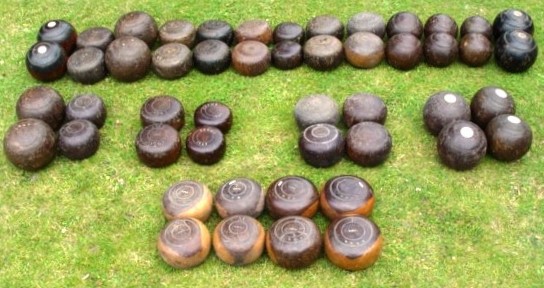
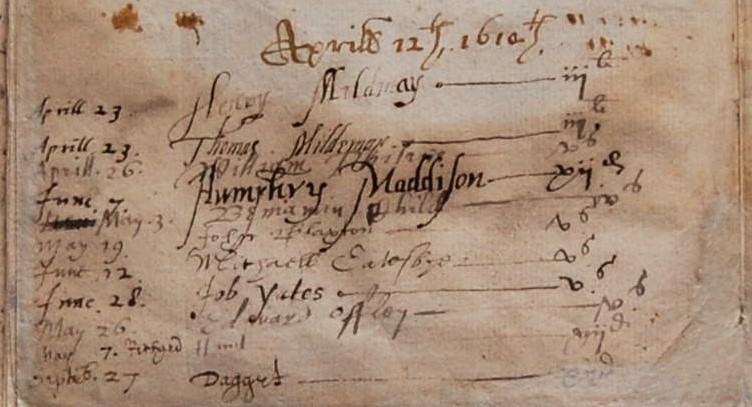
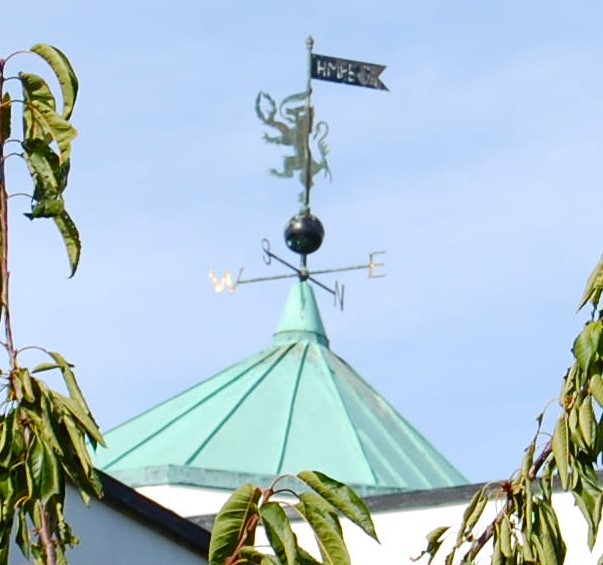
.JPG)
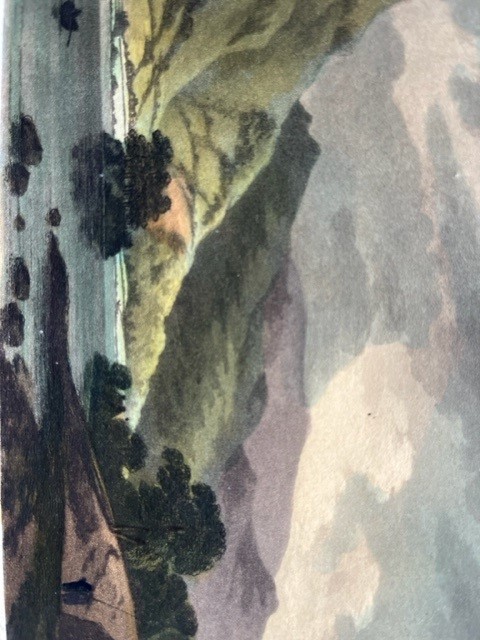
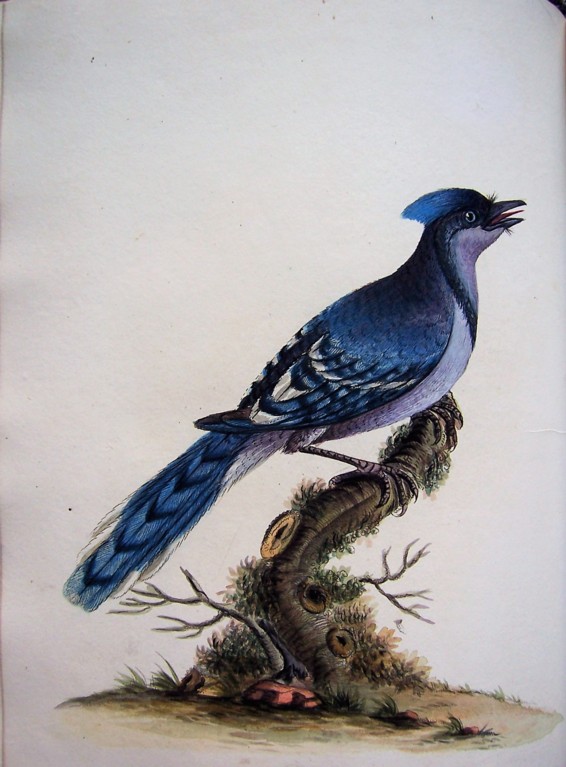
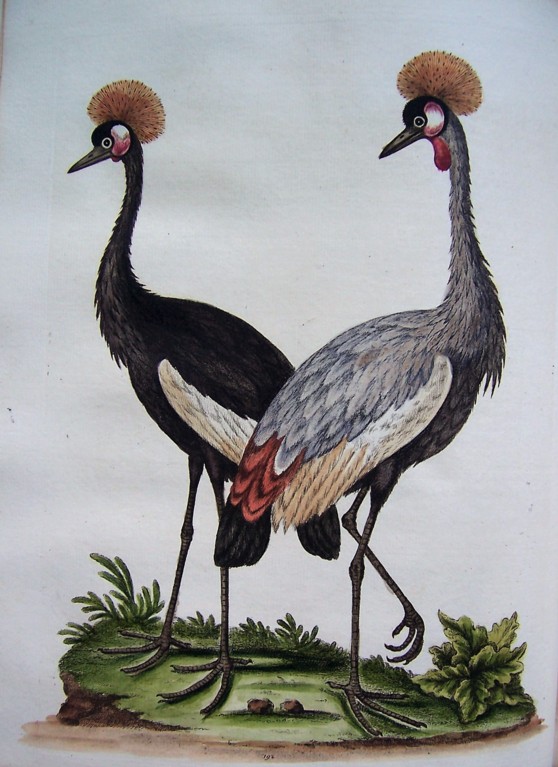
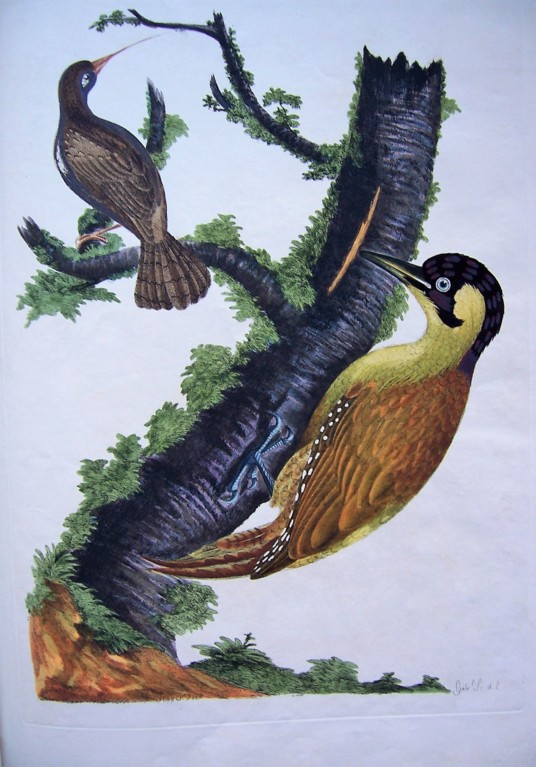
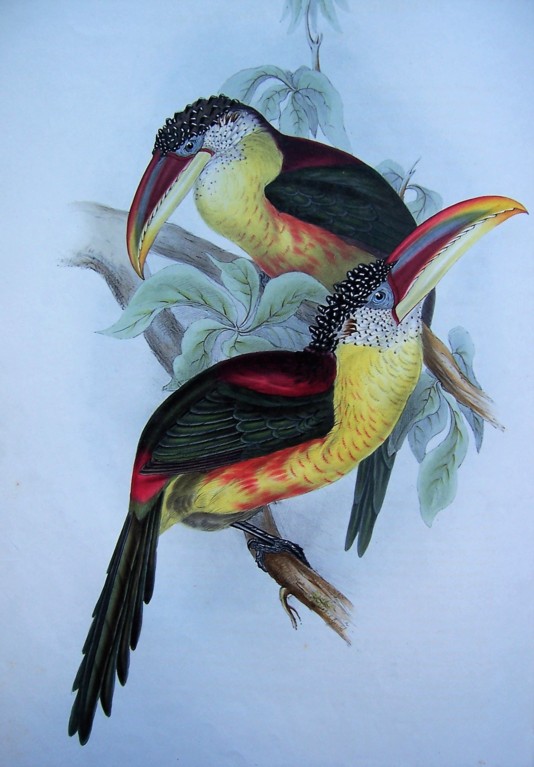
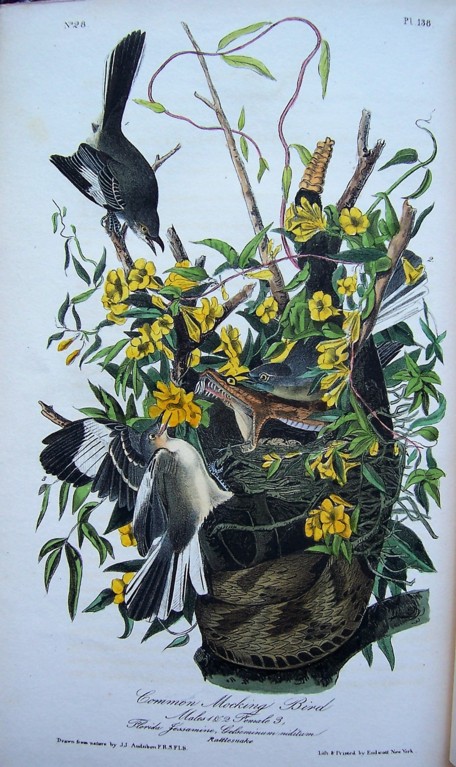
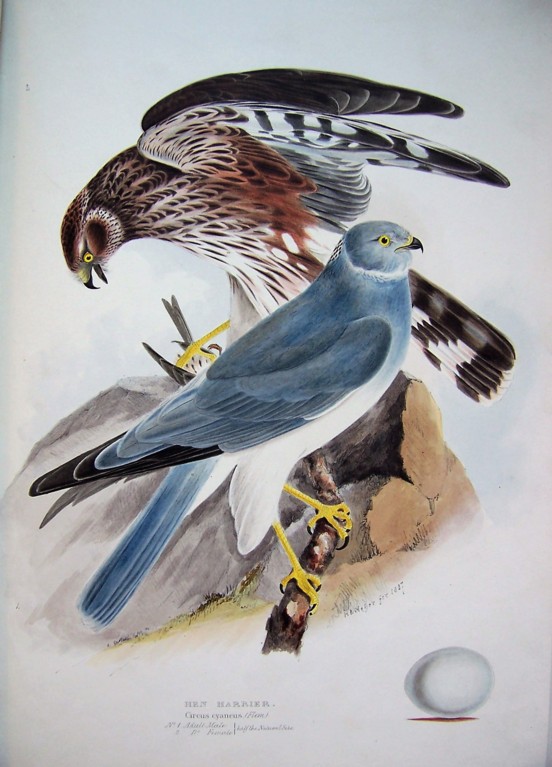
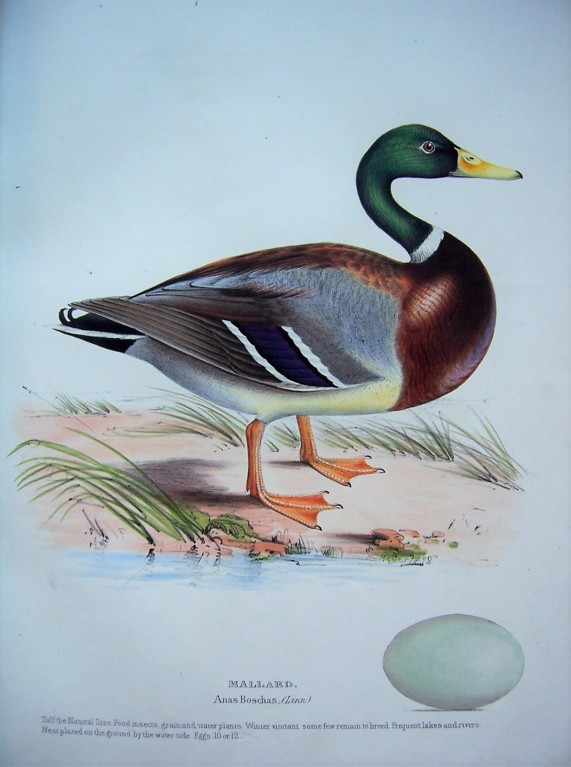
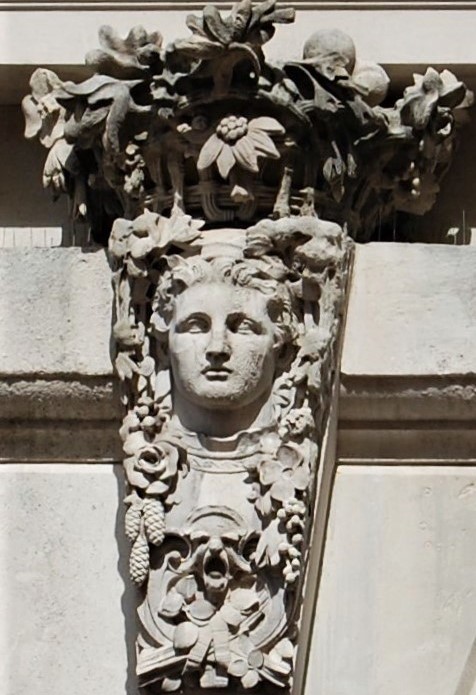
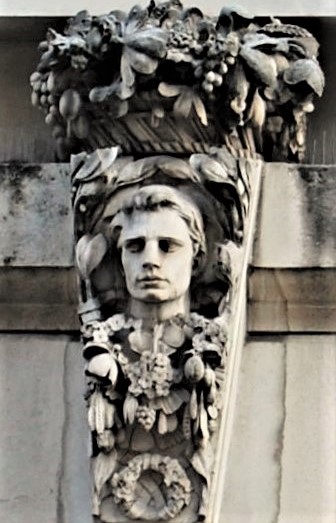
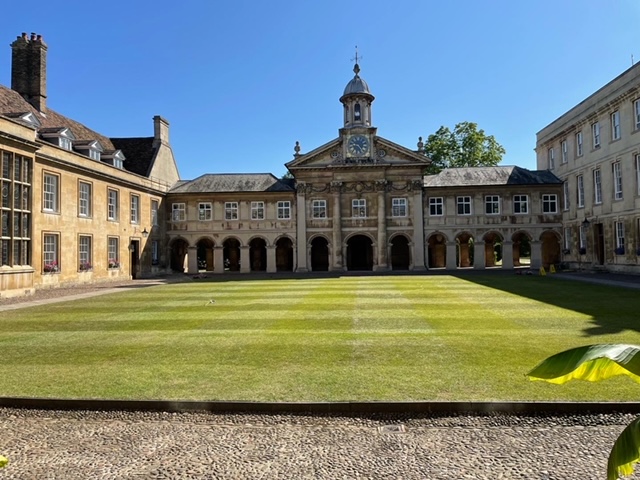
.JPG)
.JPG)
.JPG)
.JPG)
.JPG)
.JPG)
.JPG)
.JPG)
.JPG)
.JPG)
.JPG)
.JPG)
.JPG)
.JPG)
.JPG)
.JPG)
.JPG)